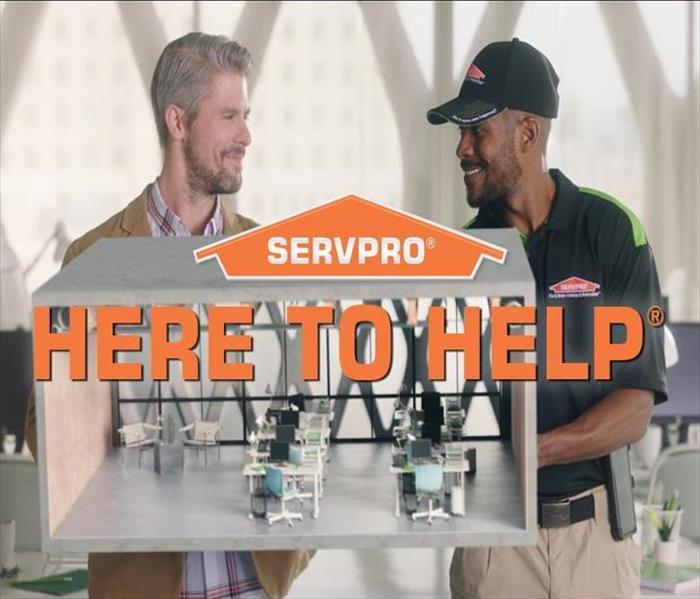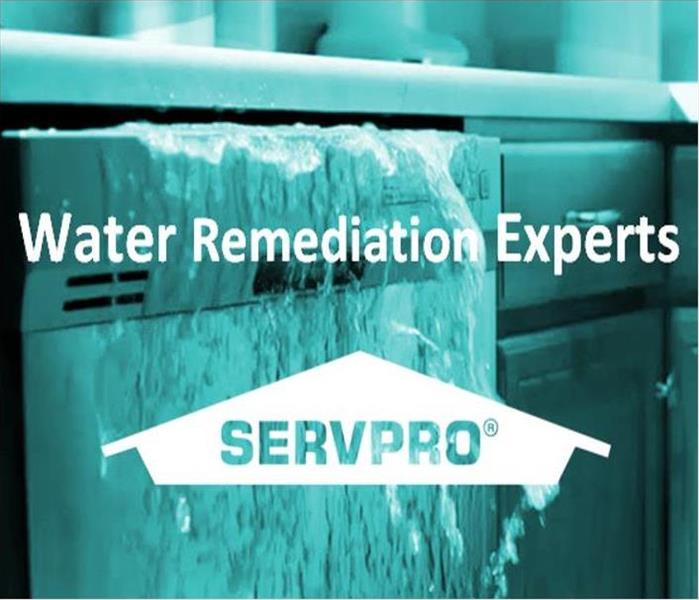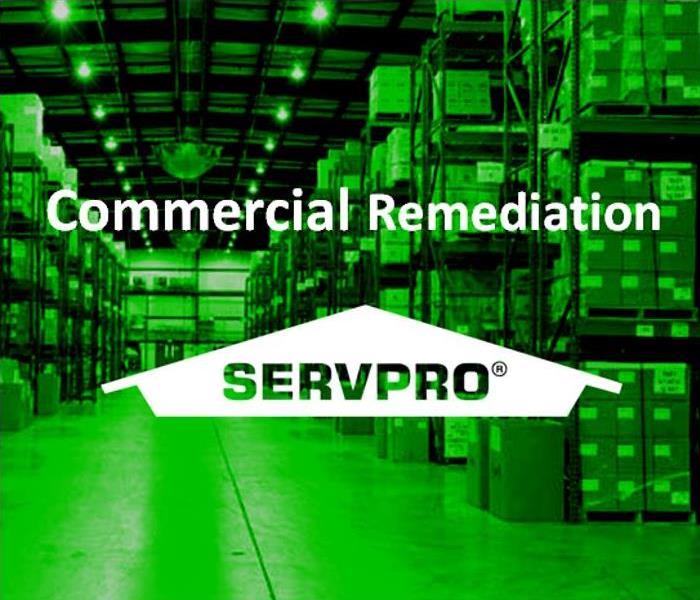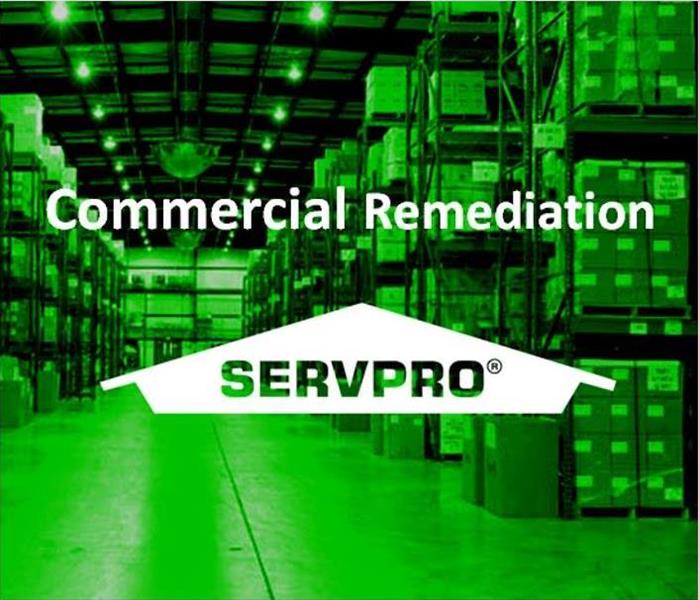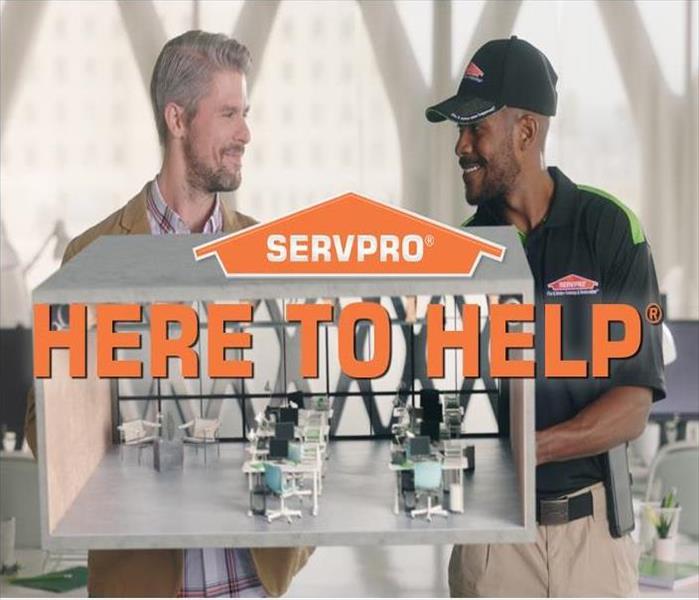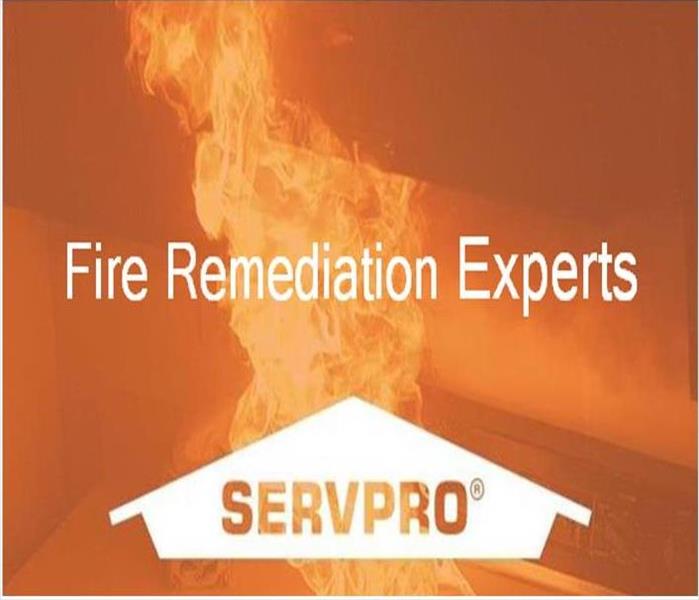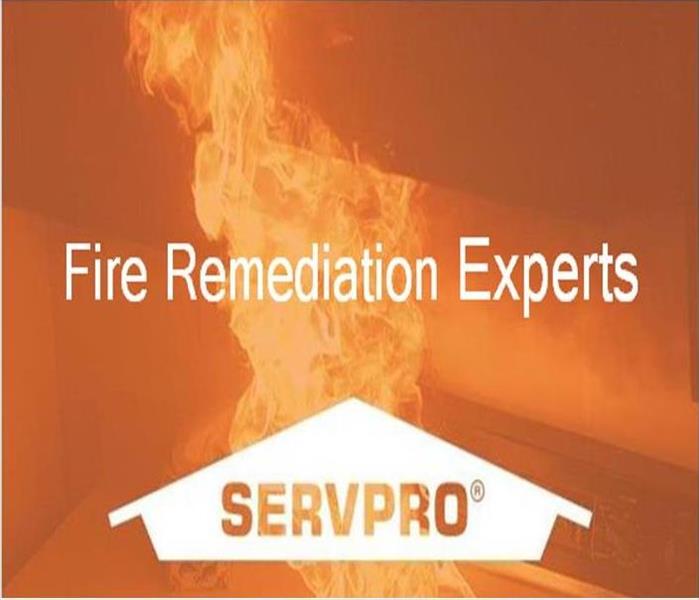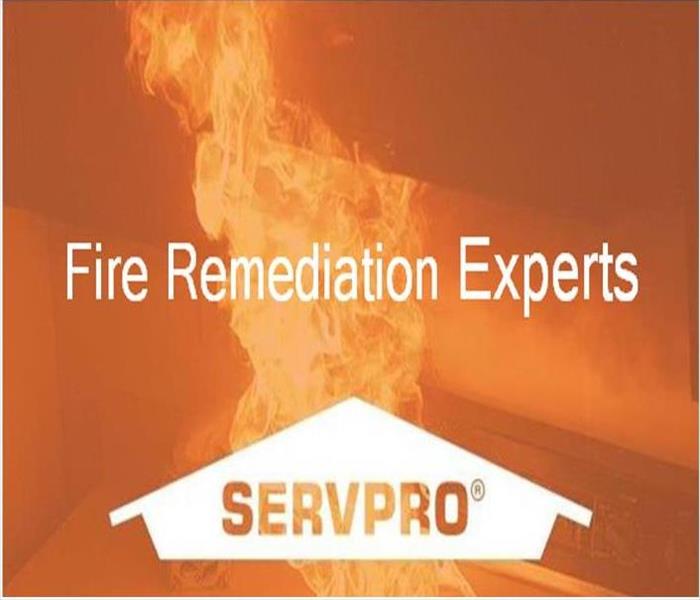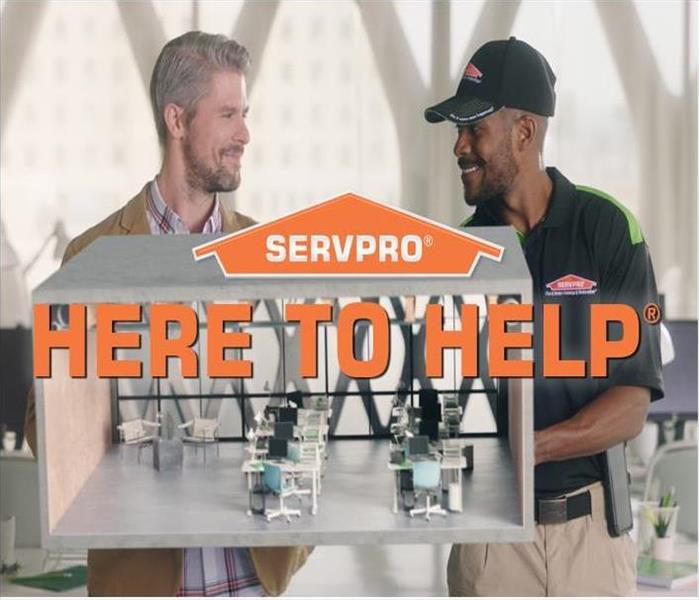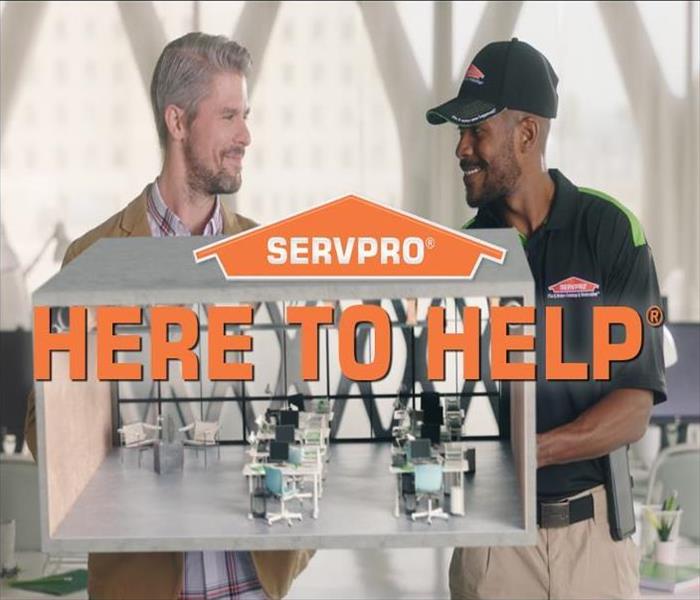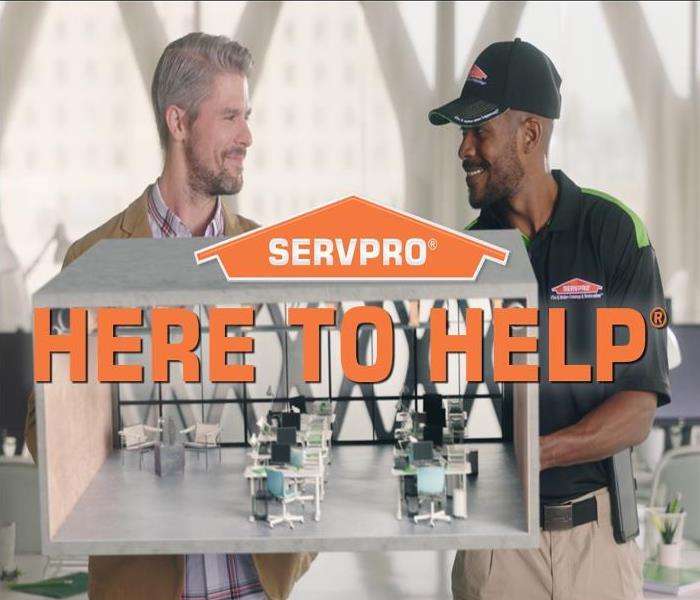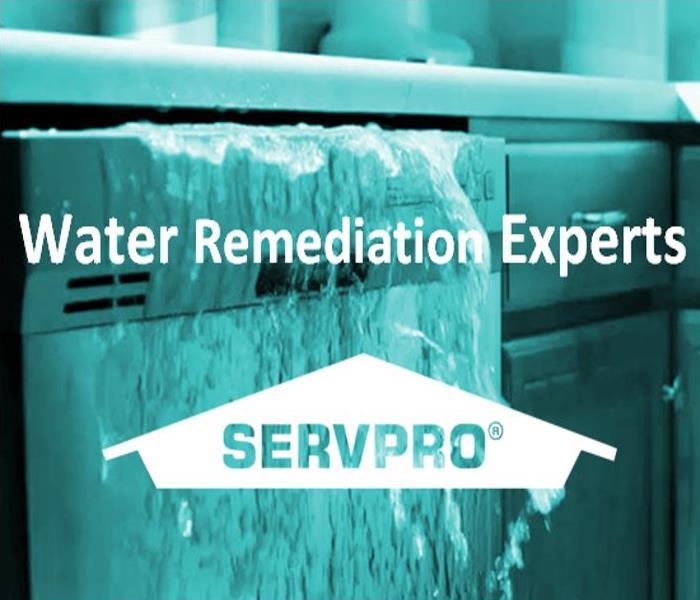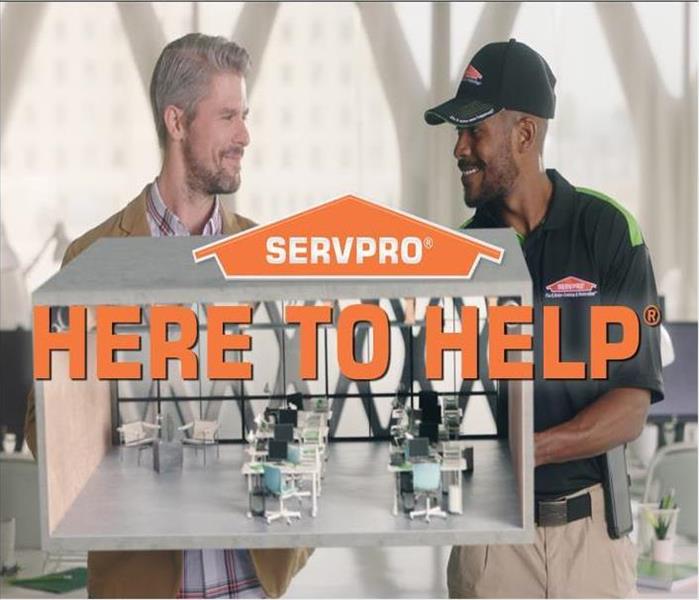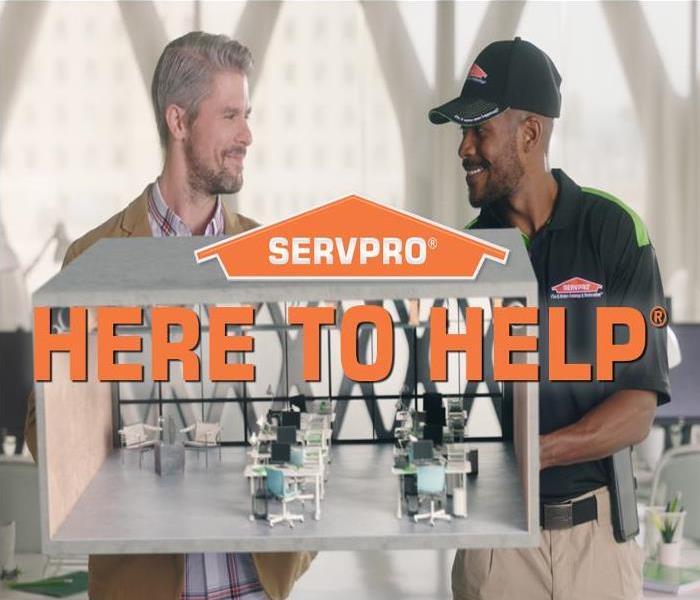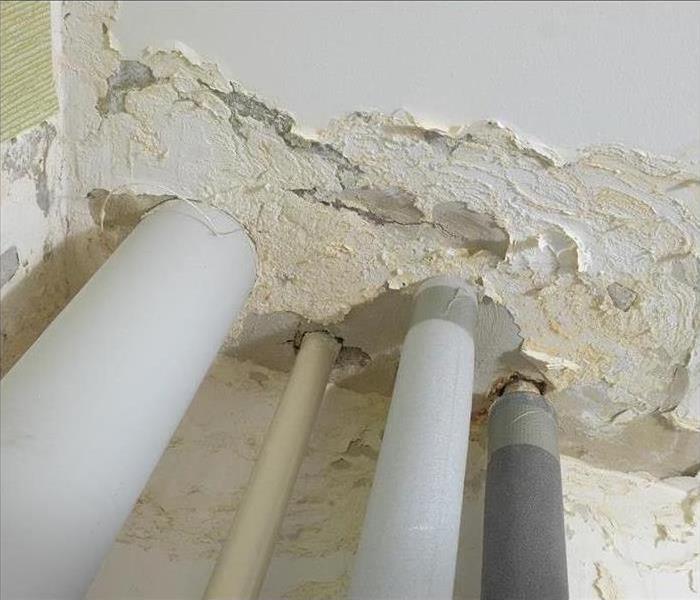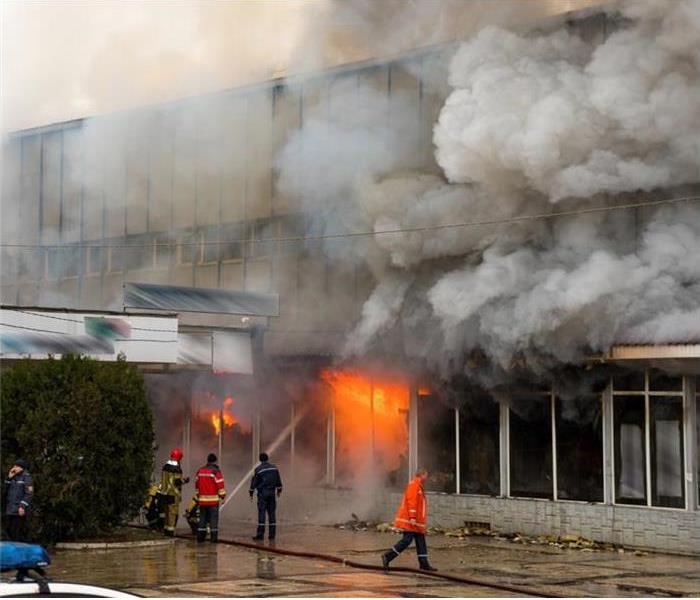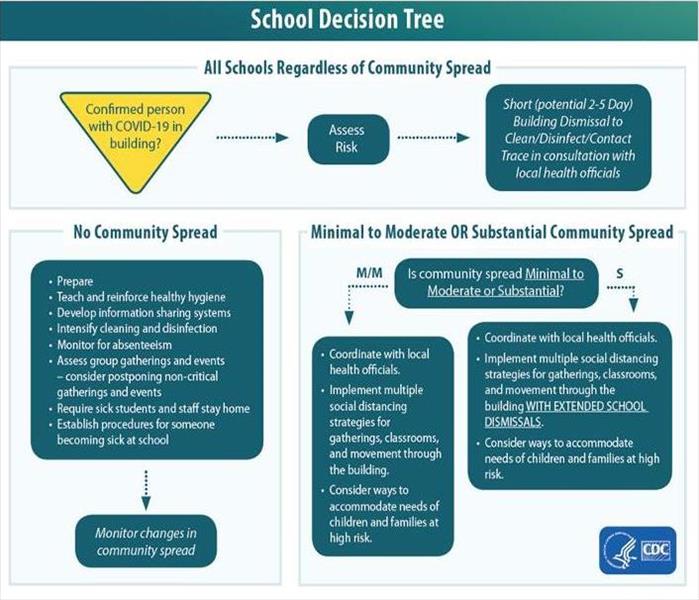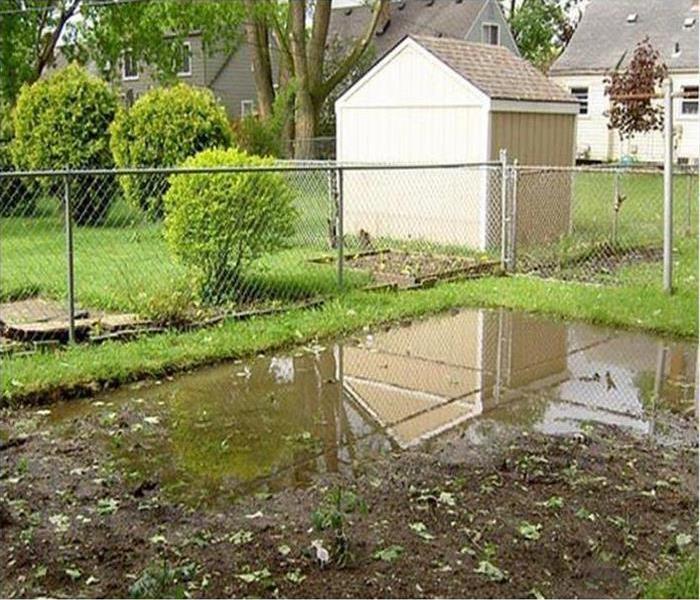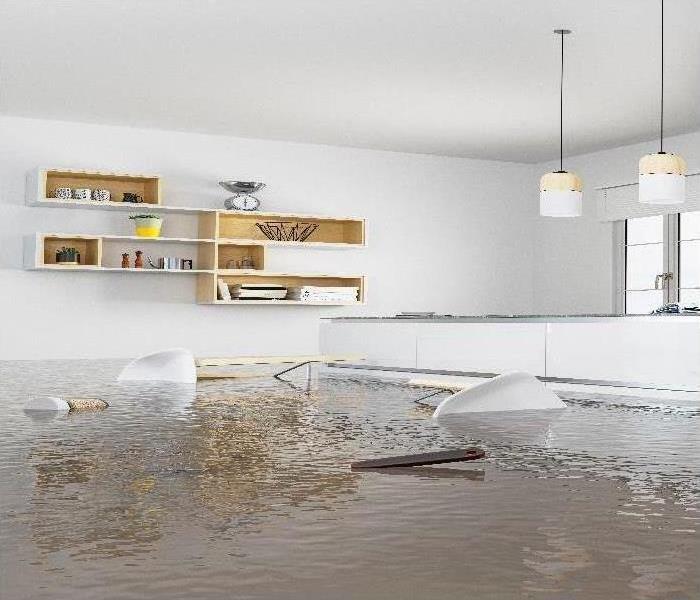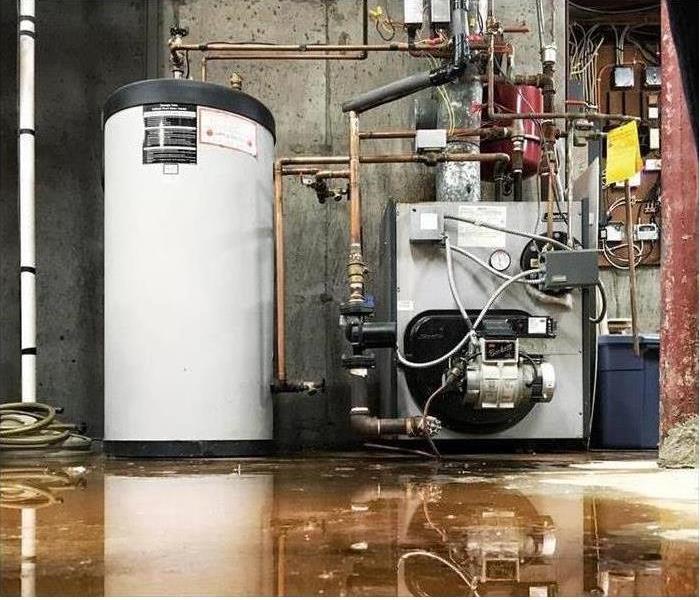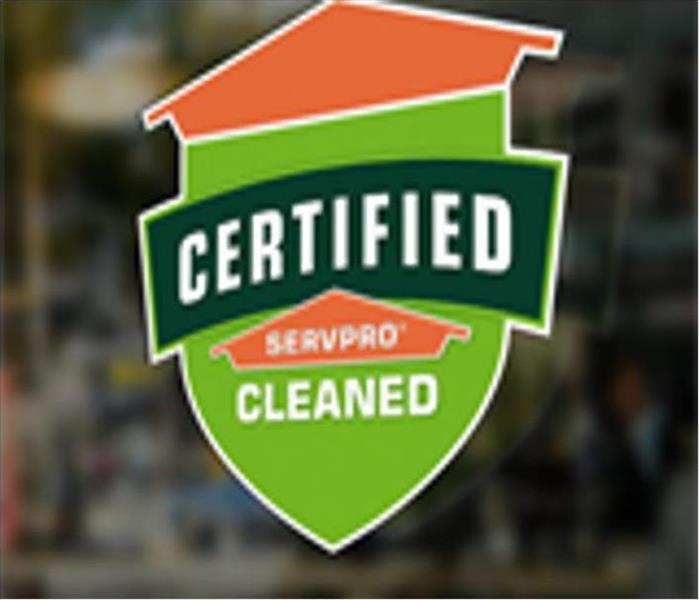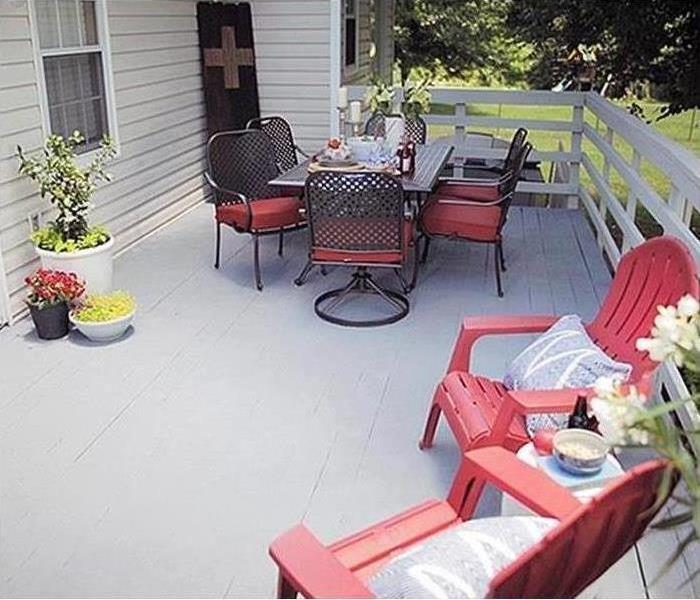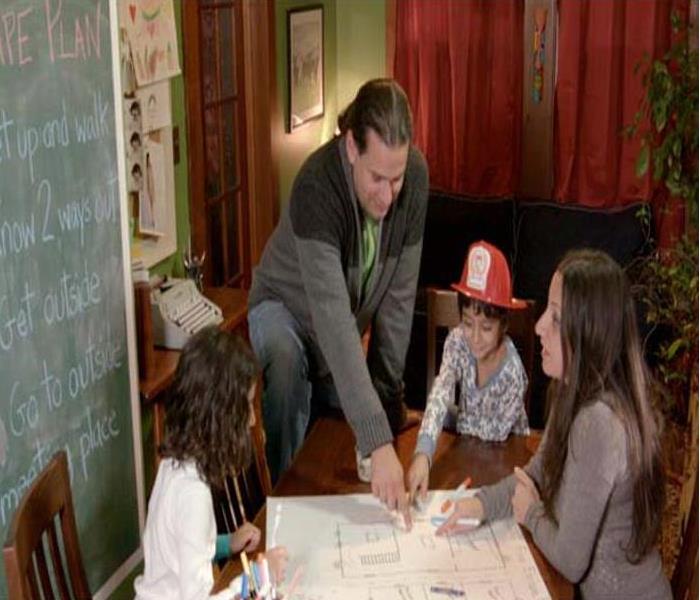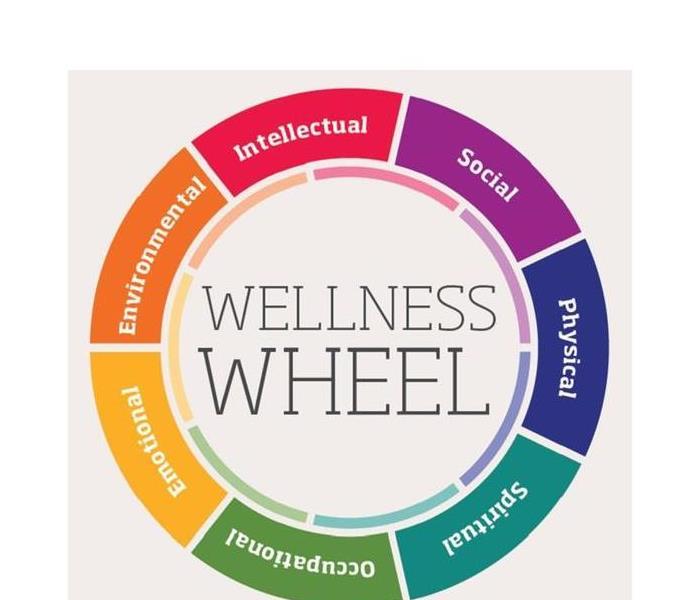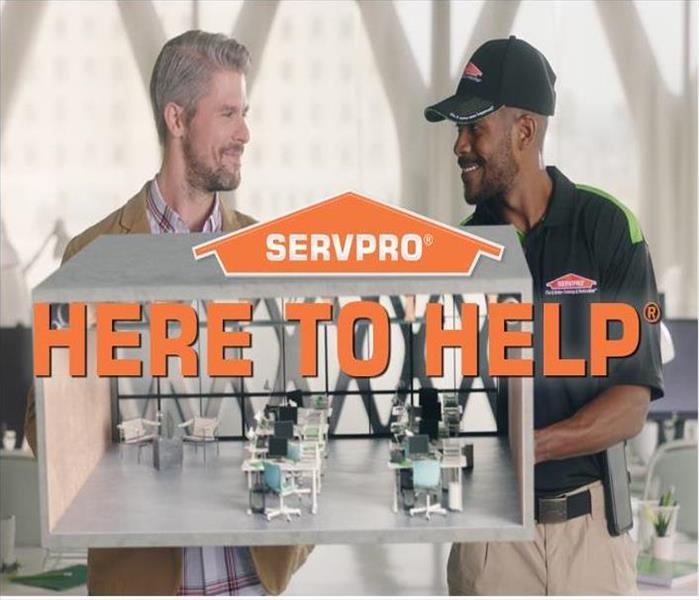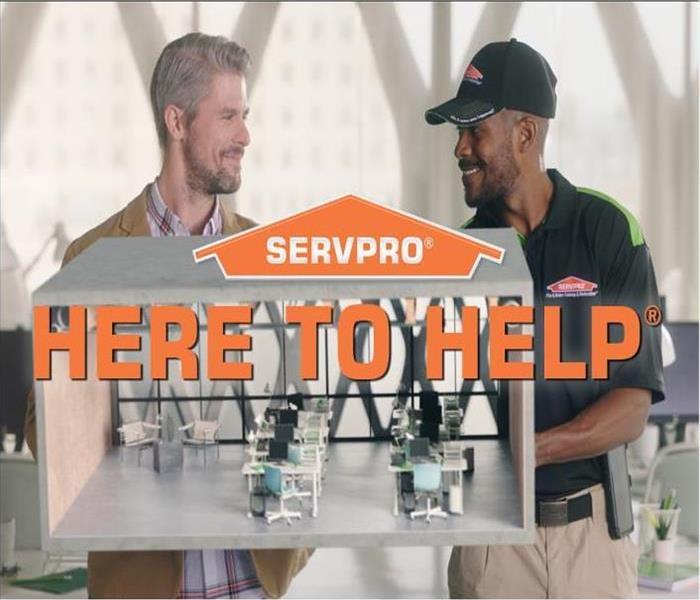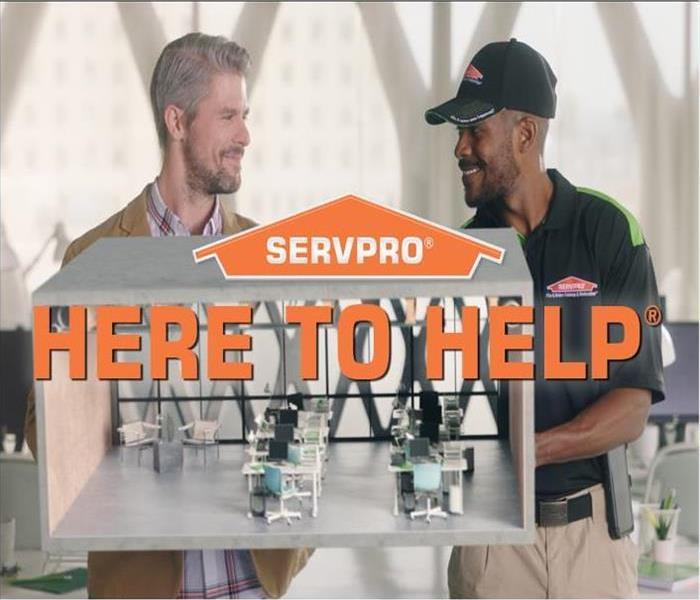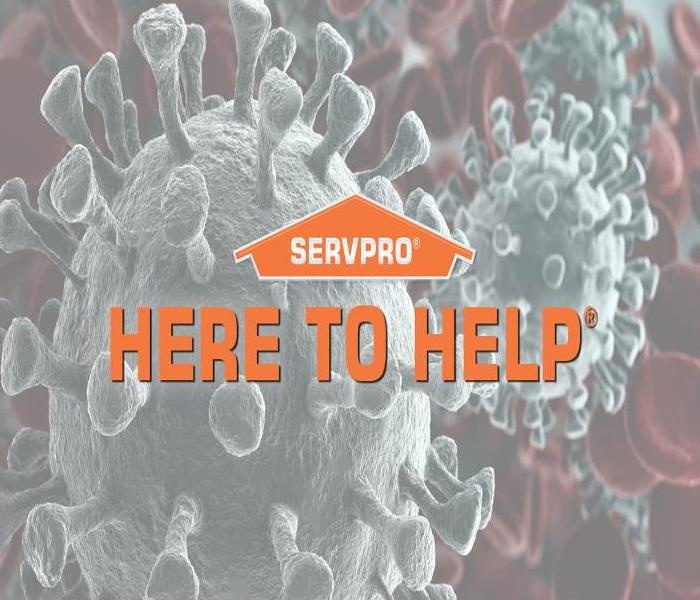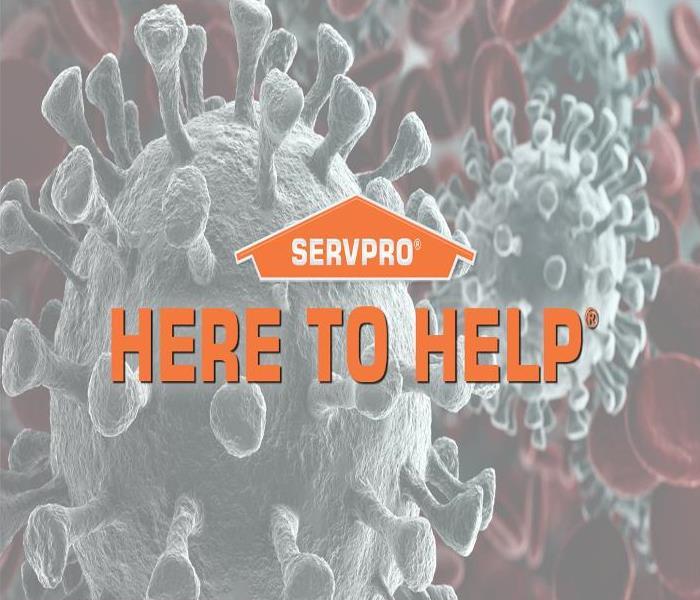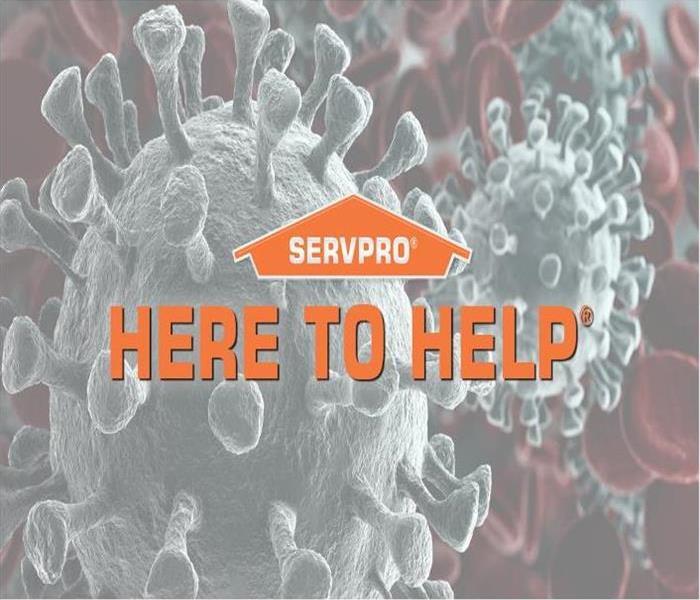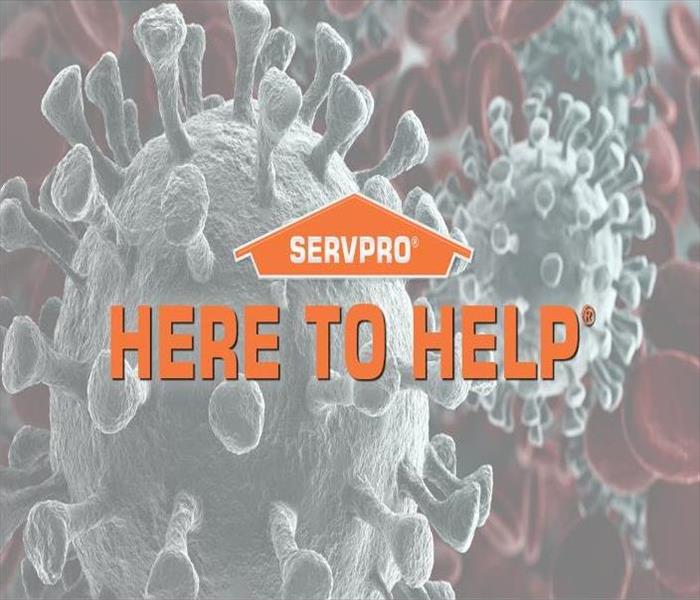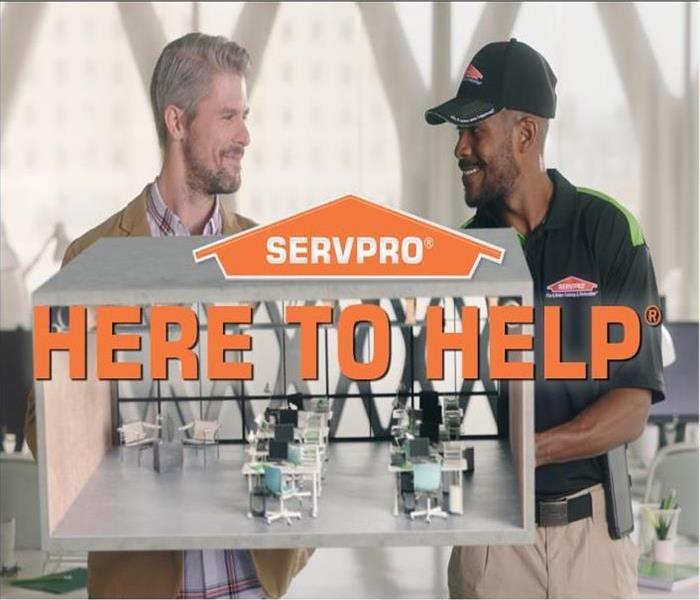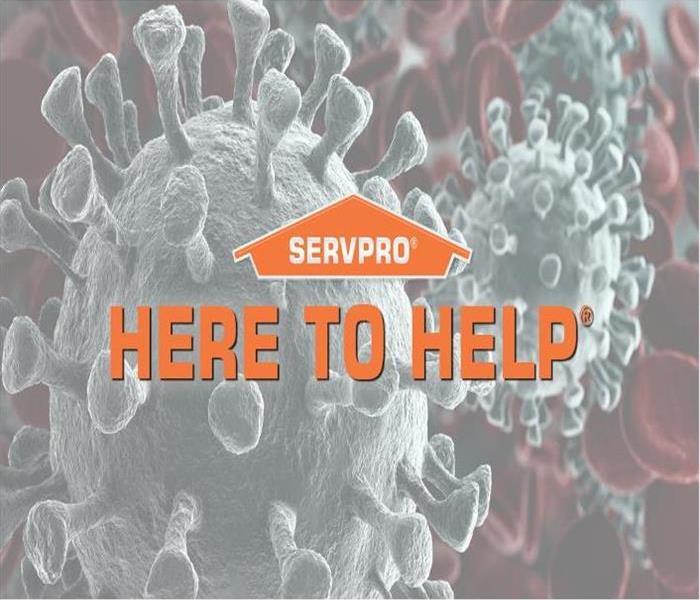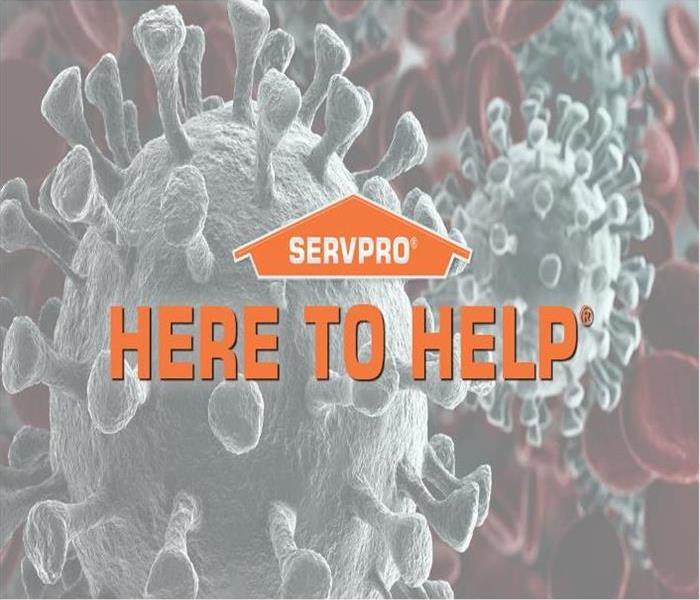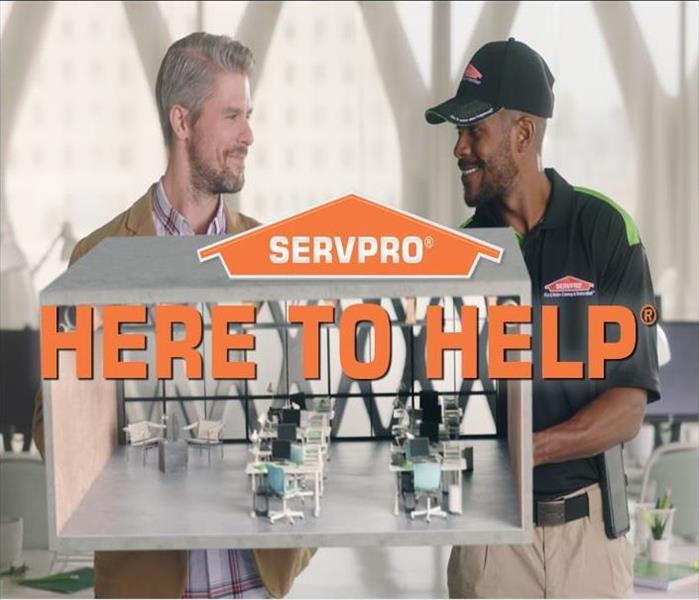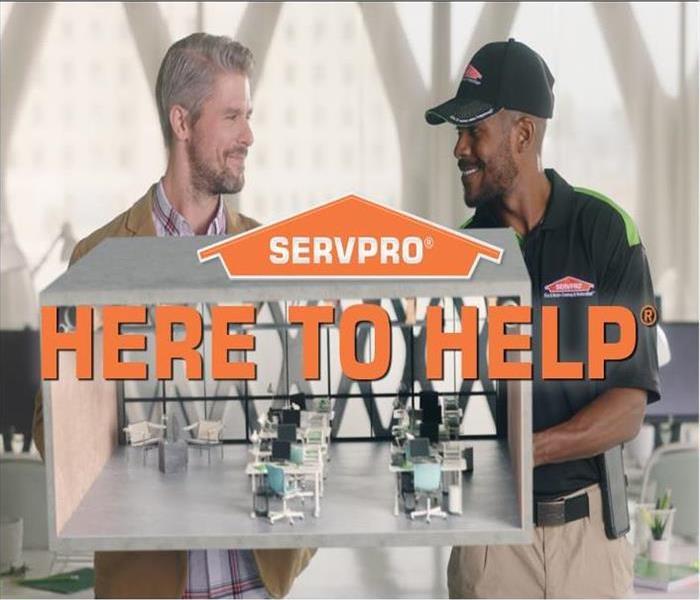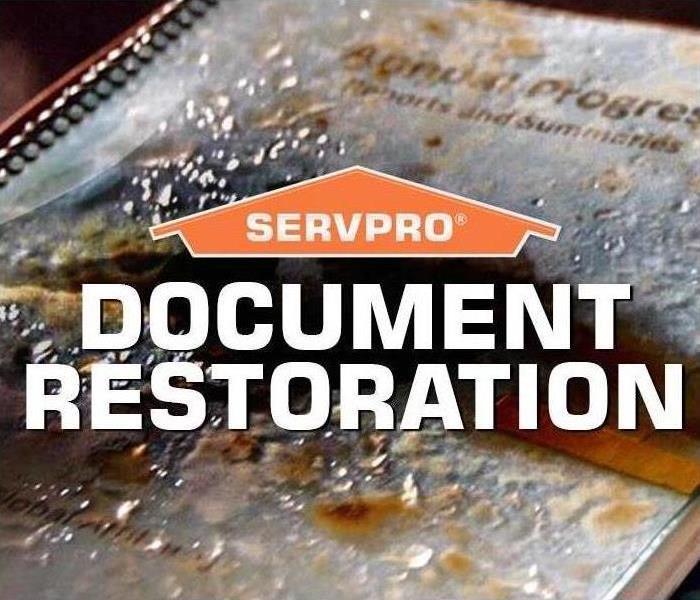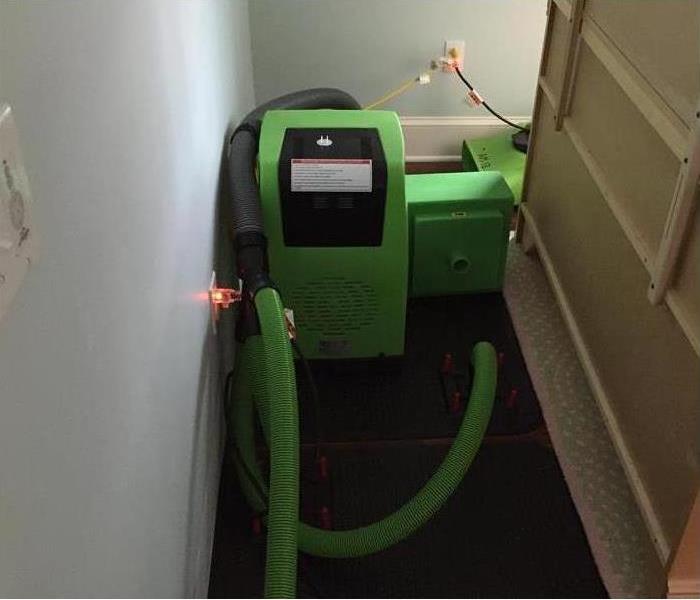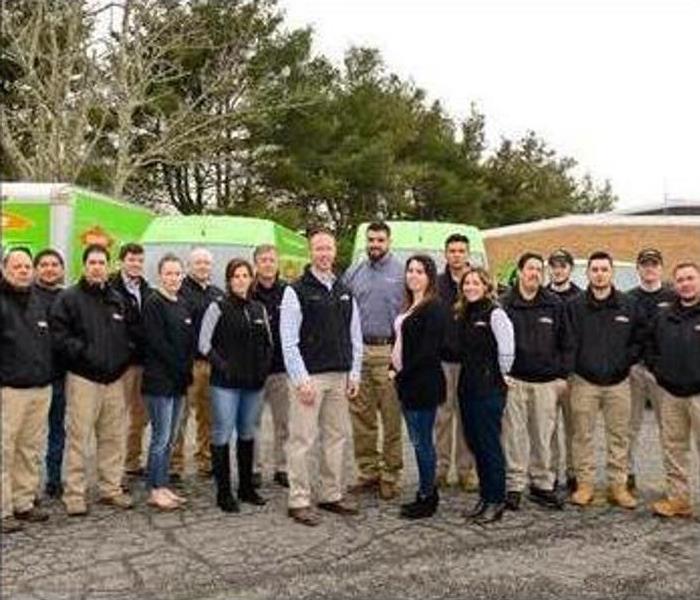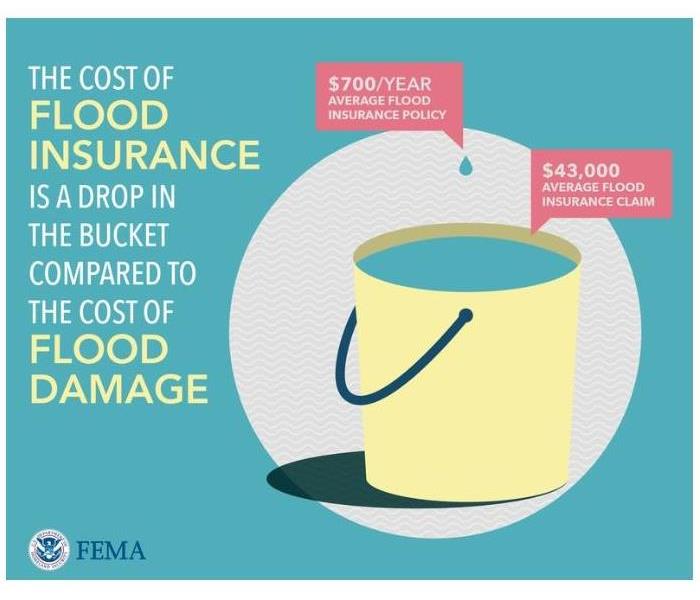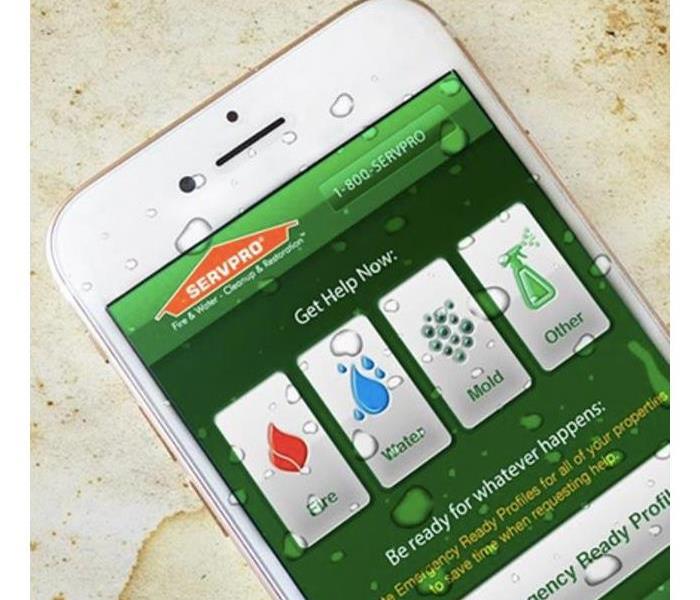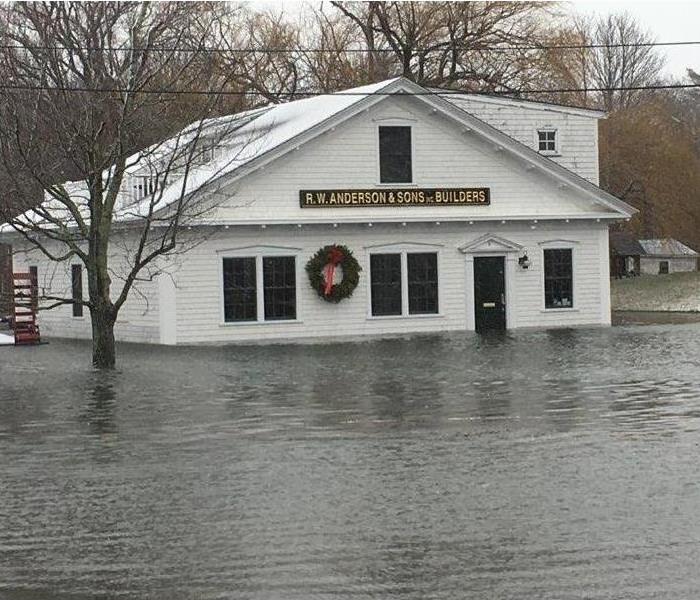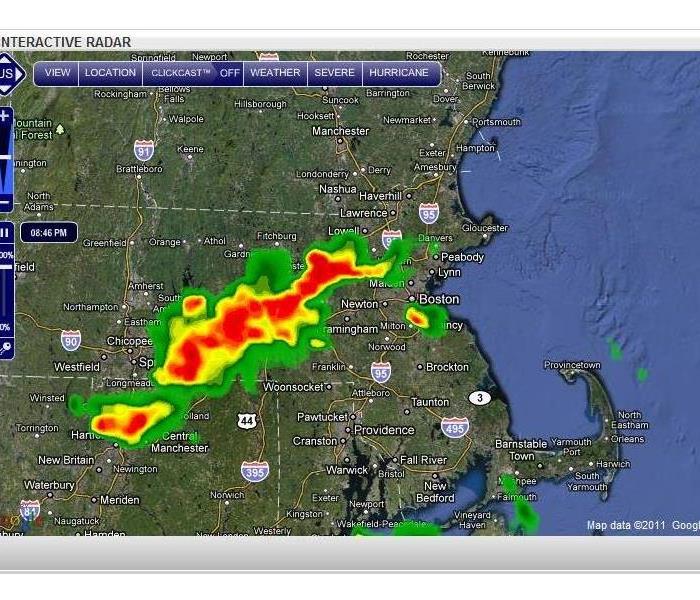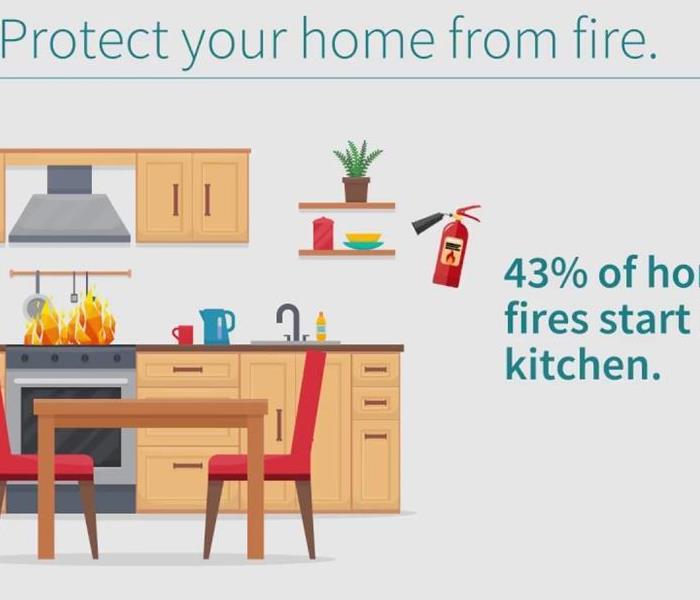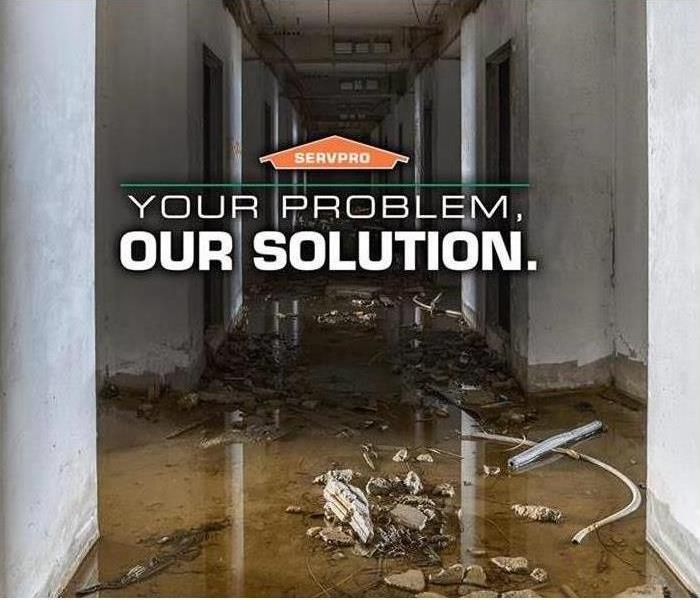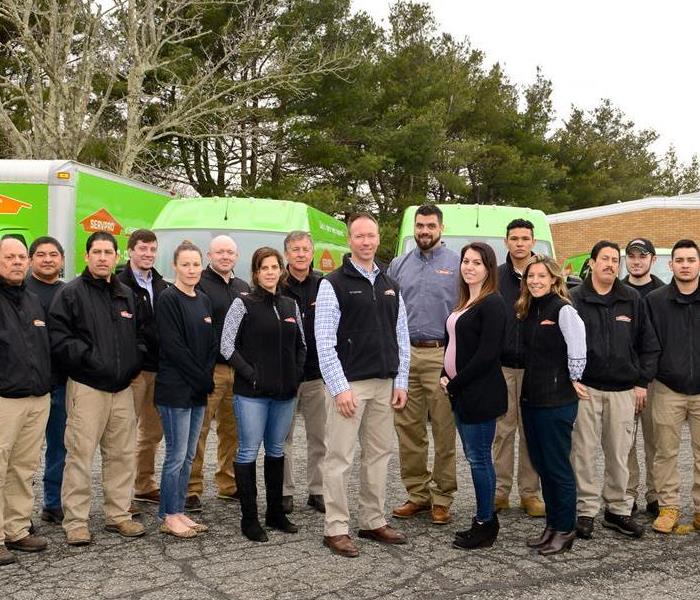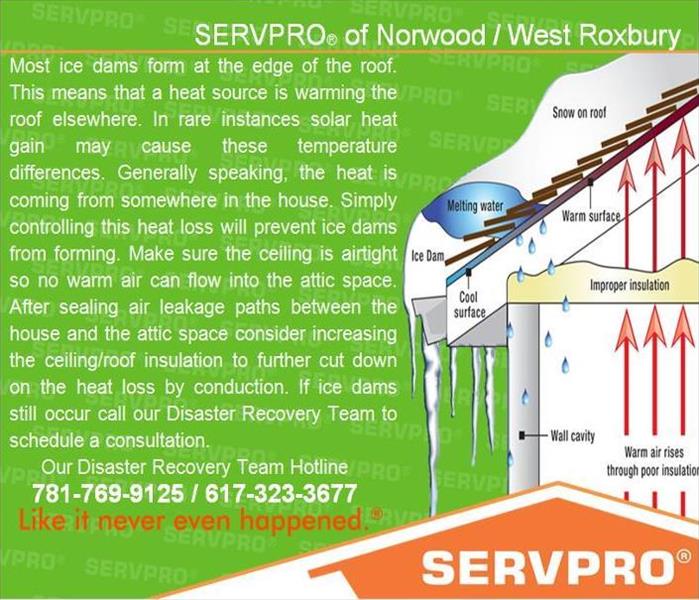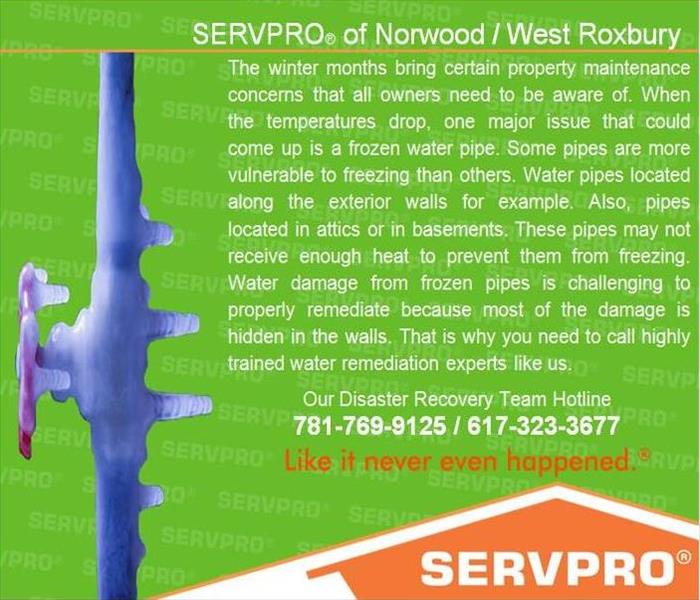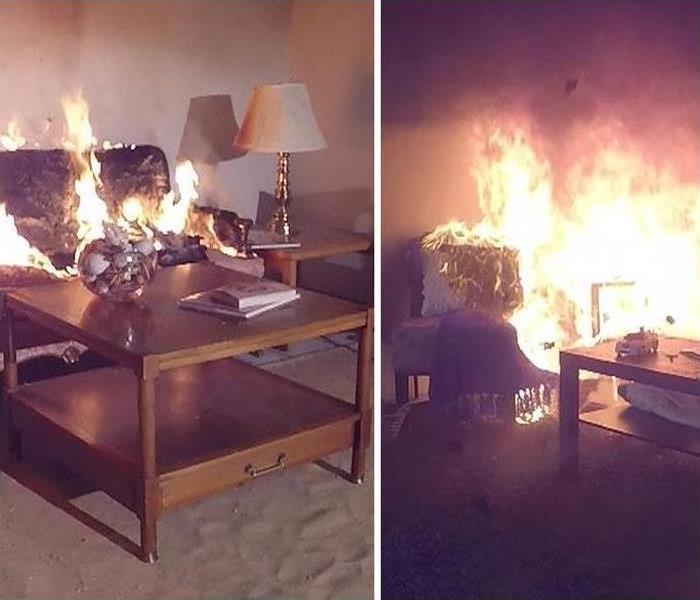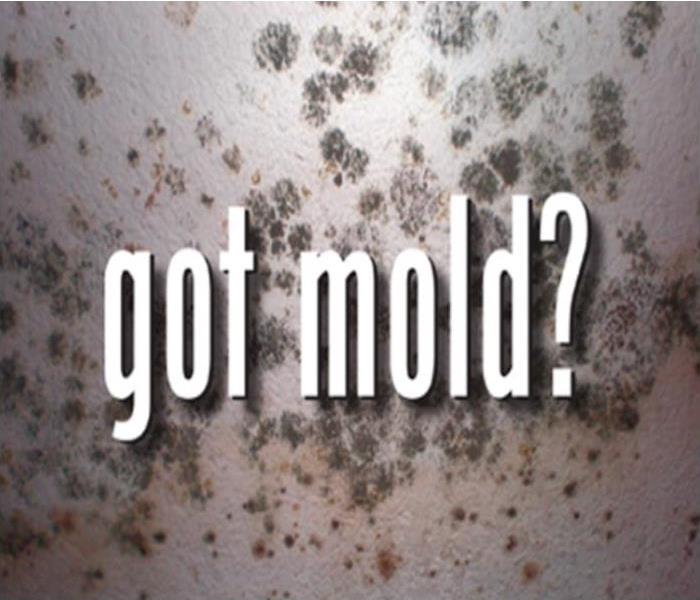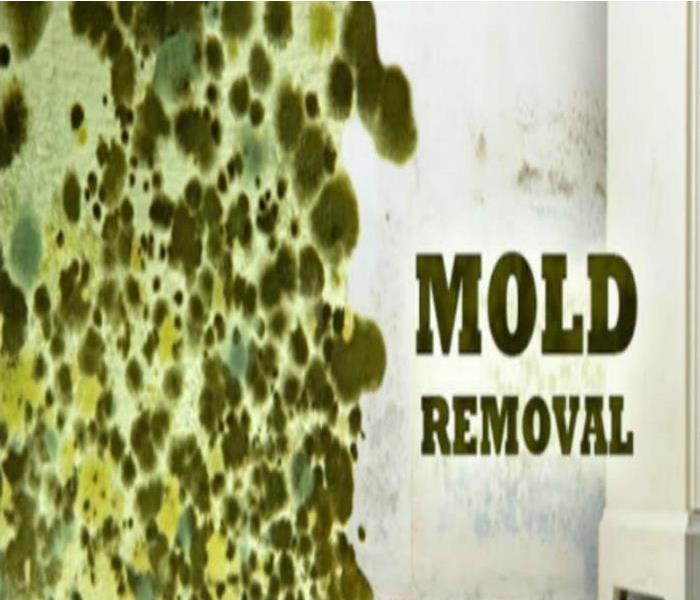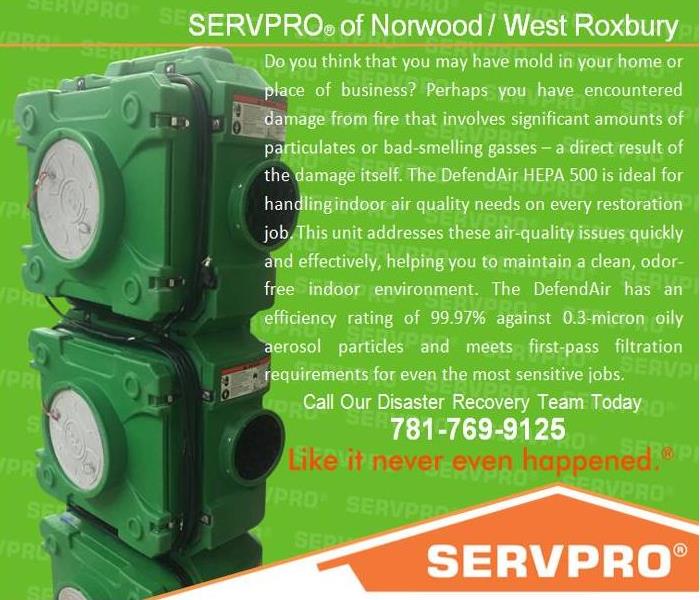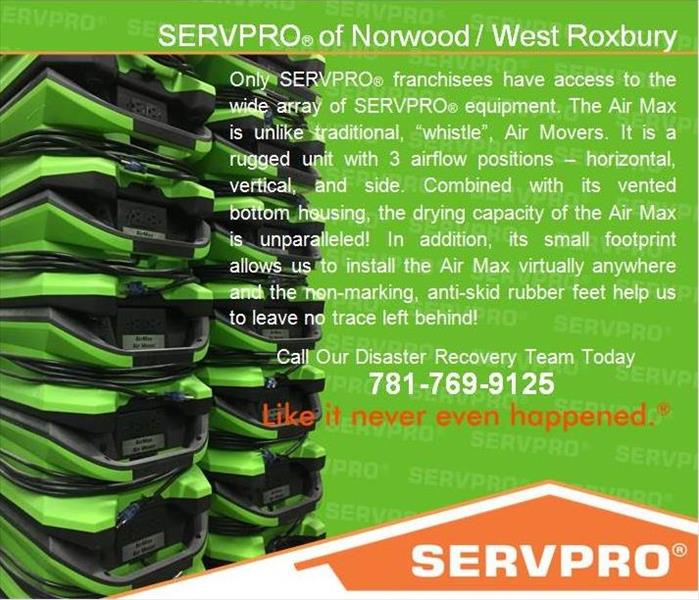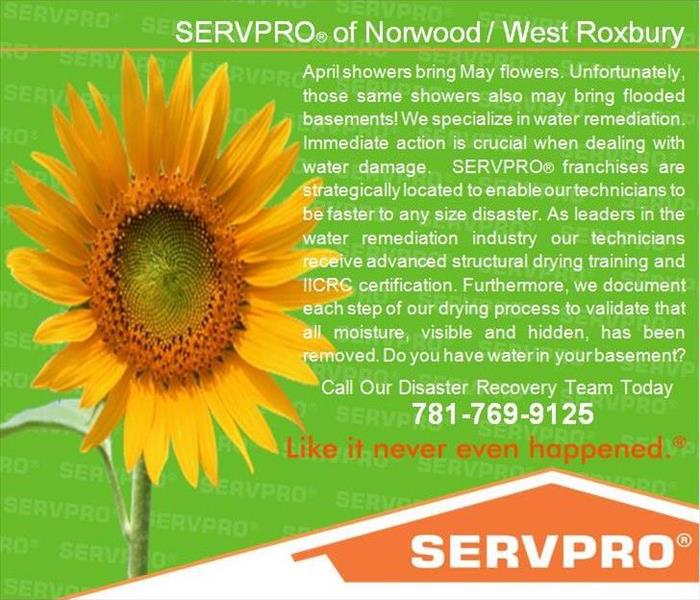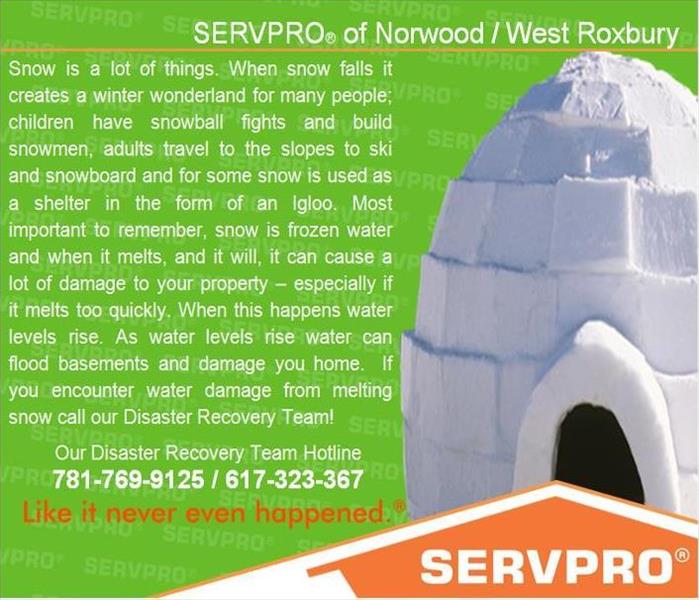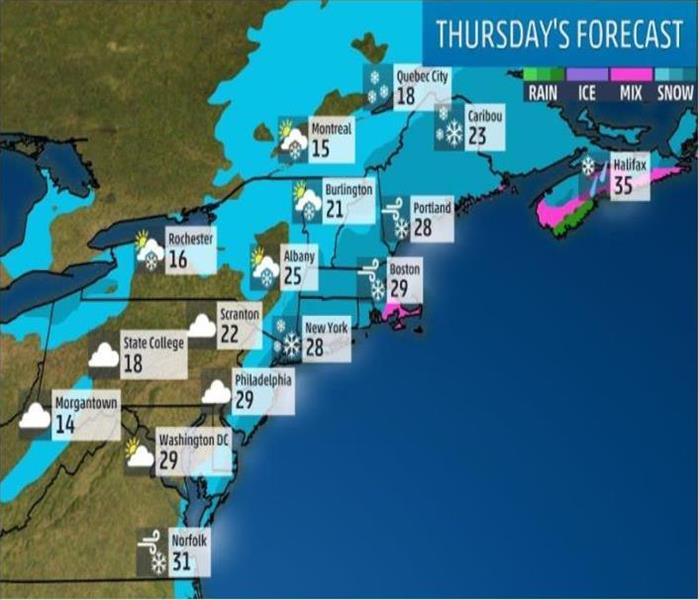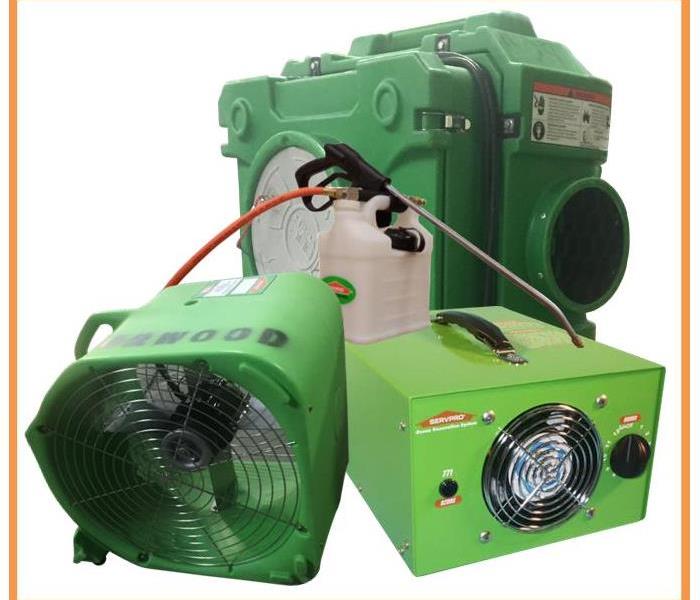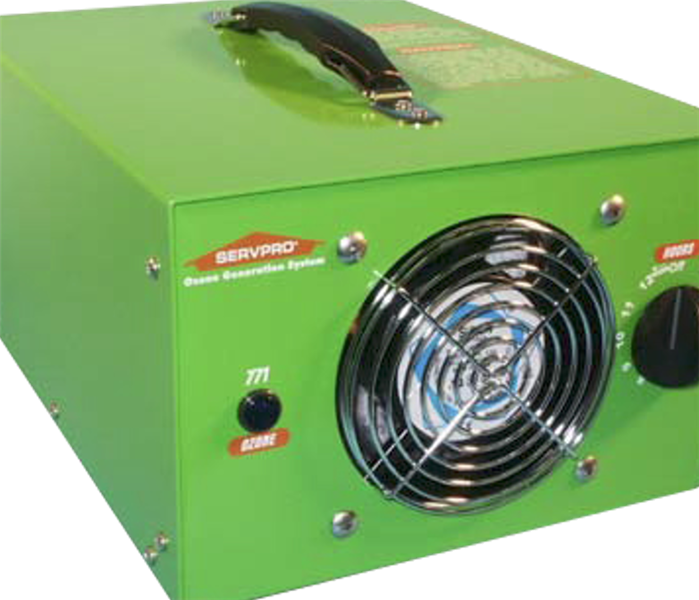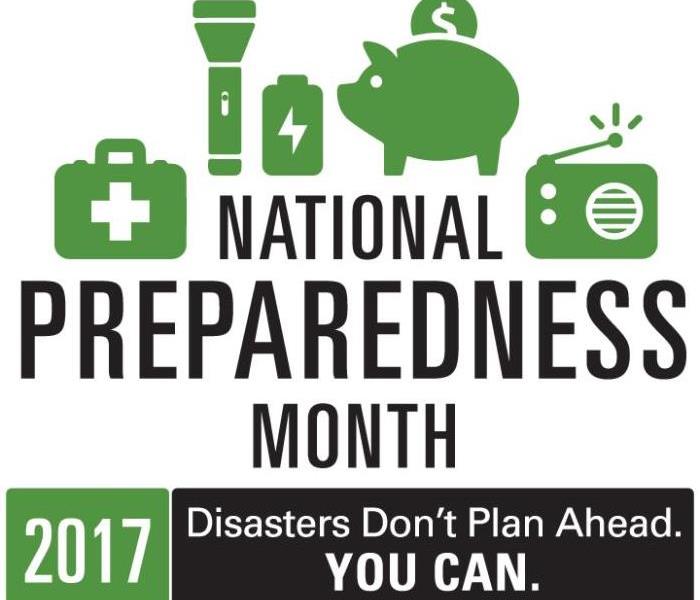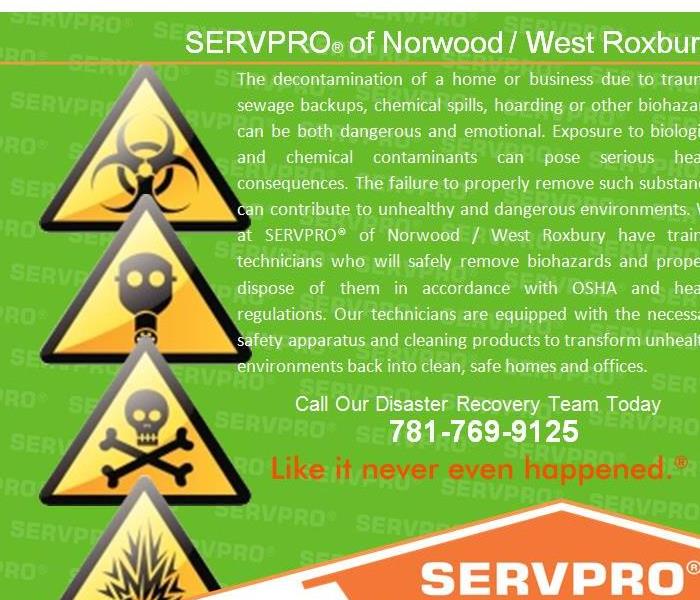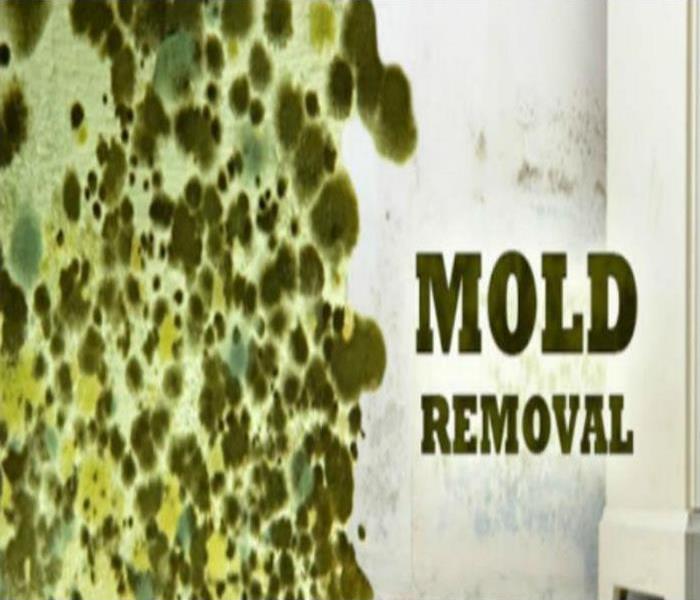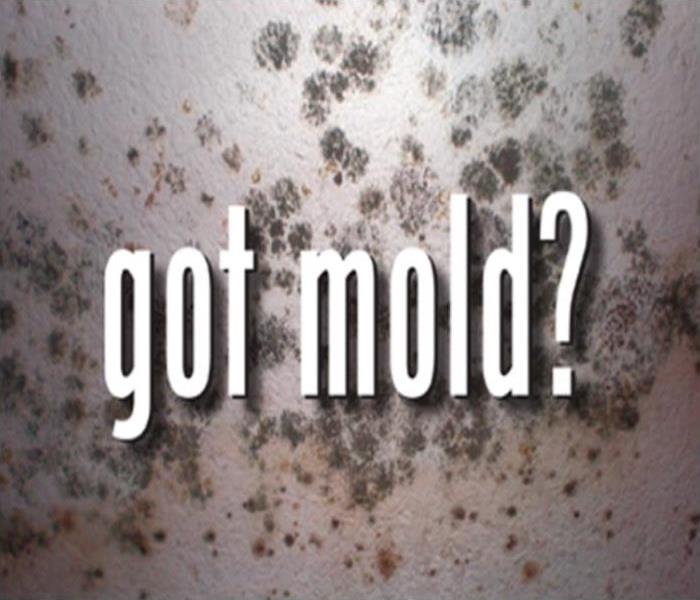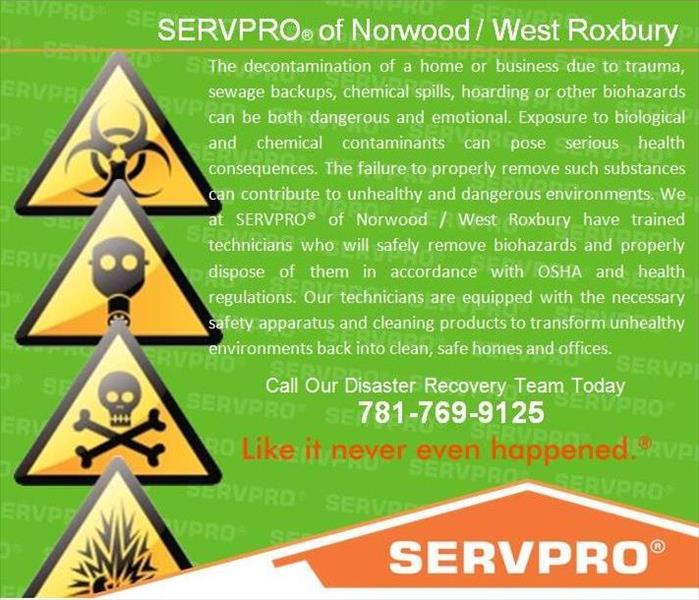Archived Blog Posts
Rebuilding Dreams: Fire and Water Restoration Specialists at Your Service in Norwood West Roxbury.
2/26/2024 (Permalink)
 From immediate response to emotional support, trust in the expertise of these specialists to begin the journey of rebuilding dreams
From immediate response to emotional support, trust in the expertise of these specialists to begin the journey of rebuilding dreams
When disaster strikes, whether in the form of fire or water damage, the aftermath can be overwhelming, leaving homes and businesses in disarray and dreams seemingly shattered. Yet, amidst these challenges, there is hope. Fire and water restoration specialists emerge as unsung heroes, stepping in to rebuild not just properties, but the hopes and aspirations of those affected in Norwood West Roxbury.
- Facing the Dual Threat: The Impact of Fire and Water Damage: Dealing with both fire and water damage presents a unique challenge that demands a comprehensive restoration approach. Specialists in fire and water restoration understand these complexities and are adept at addressing both simultaneously.
- Immediate Response and Damage Mitigation: Acting swiftly in the aftermath of a fire or water incident is crucial to prevent further damage. Restoration specialists prioritize immediate response to mitigate secondary issues such as mold growth or structural deterioration.
- Tailored Restoration Plans: Recognizing that each case of fire and water damage is unique, specialists conduct thorough assessments and devise customized plans that address all aspects of restoration, from water extraction to structural repairs.
- Employing Advanced Equipment and Techniques: Utilizing state-of-the-art equipment and techniques, restoration specialists expedite the restoration process. Industrial-strength water extractors, drying equipment, and specialized tools ensure efficient and effective restoration.
- Holistic Fire Damage Restoration: Fire damage extends beyond visible destruction. Specialists are trained to handle smoke and soot removal, structural repairs, content restoration, and odor elimination, leaving no facet of fire damage unaddressed.
- Expert Water Damage Mitigation: Water damage can lead to various issues, including mold growth and structural instability. Restoration specialists excel in water extraction, drying, and mold remediation, ensuring thorough restoration to a safe and habitable condition.
- Facilitating Insurance Claims: Coordinating with insurance providers, documenting damage, and providing accurate assessments, restoration specialists streamline the claims process, alleviating additional stress for those affected.
- Restoring Emotional Well-being: Recognizing the emotional toll of disasters, specialists offer more than technical expertise. They provide compassion, guidance, and a reassuring presence to help rebuild not just homes, but lives.
In the face of fire and water damage, restoration specialists play a heroic role, offering hope amidst chaos by rebuilding dreams and restoring a sense of normalcy. From immediate response to emotional support, trust in the expertise of these specialists to begin the journey of rebuilding dreams in Norwood West Roxbury.
SERVPRO Of Norwood West Roxbury stands as the premier choice in cleanup and restoration for residential and commercial buildings affected by fire, mold, water, and storm damage.
Smoke Signals: Professional Restoration for a Smoke-Free Environment in Norwood West Roxbury
2/20/2024 (Permalink)
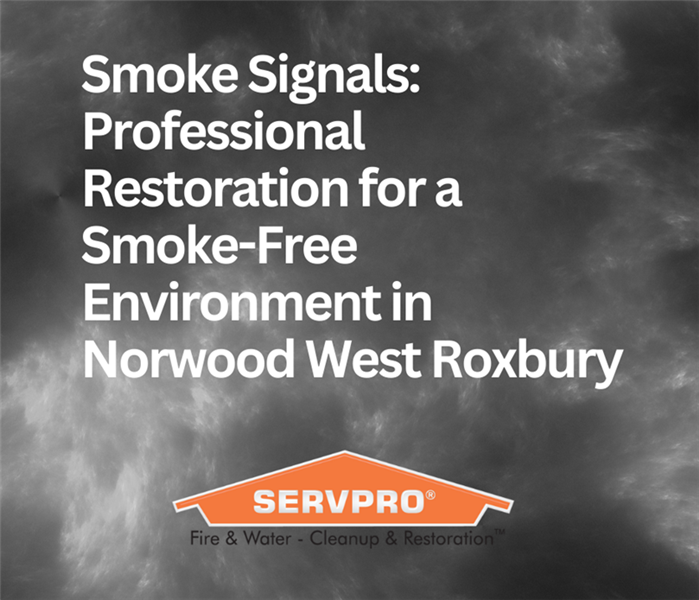 When smoke casts a shadow, entrust in the proficiency of smoke restoration experts
When smoke casts a shadow, entrust in the proficiency of smoke restoration experts
Smoke damage can infiltrate every nook and cranny of a property, leaving behind not just visible stains but also persistent odors. Whether stemming from a fire, tobacco use, or other sources, the effects of smoke on indoor spaces can be profound. Discover the significance of professional smoke restoration services in cultivating a smoke-free environment and rejuvenating indoor spaces in Norwood West Roxbury.
- Grasping the Complexity of Smoke Damage: Smoke damage encompasses more than surface-level blemishes; it involves intricate interactions between various particles and surfaces. Seasoned smoke restoration services possess a profound understanding of the scientific intricacies behind smoke damage, enabling them to tackle not only visible manifestations but also hidden issues like odor permeation and residue buildup.
- Thorough Evaluation of Smoke Damage: Prior to commencing restoration endeavors, specialists conduct a meticulous assessment to gauge the extent of smoke damage. This entails pinpointing affected surfaces, materials, and the specific nature of smoke residue present. This comprehensive analysis serves as the bedrock for crafting a focused and efficacious restoration strategy.
- Specialized Cleaning Methods: Smoke restoration professionals deploy specialized cleaning methodologies to eradicate smoke residues from surfaces. This may encompass dry cleaning, wet cleaning, or abrasive techniques tailored to suit the materials involved. The aim is to revive surfaces to their pre-damage state sans exacerbating existing issues.
- Strategies for Odor Neutralization: Lingering smoke odors can persist long after visible damage is remediated. Expert restoration services leverage advanced odor-neutralization tactics such as ozone treatments, thermal fogging, and specialized deodorizers. These approaches neutralize and eliminate odors at a molecular level, ensuring a genuinely smoke-free ambiance.
- HVAC System Sanitization: Smoke particles can infiltrate HVAC systems, disseminating odors and contaminants throughout a property. Smoke restoration experts extend their services to encompass thorough cleansing of ventilation systems, ductwork, and HVAC components. This guarantees that the entire indoor milieu is devoid of smoke-related residues.
- Prevention of Cross-Contamination: Throughout the restoration process, professionals take precautions to forestall cross-contamination to unaffected zones. This involves isolating damaged areas, implementing containment barriers, and employing air filtration systems to capture and remove airborne smoke particles. Such measures are pivotal for averting the spread of residues to other sections of the property.
- Enhancement of Indoor Air Quality: A pivotal facet of fostering a smoke-free environment is enhancing indoor air quality. Professional restoration services prioritize not only visible damage but also ameliorating air quality by expunging airborne pollutants and ensuring optimal ventilation.
- Post-Restoration Examination and Testing: To ascertain the efficacy of restoration endeavors, specialists conduct post-restoration examinations and testing. This encompasses assessing surfaces, conducting air quality analyses, and verifying that all smoke-related issues have been effectively remedied. The final step entails furnishing clients with the assurance of a thoroughly restored and smoke-free environment.
For individuals and businesses grappling with the aftermath of smoke damage, professional smoke restoration services serve as a beacon of optimism. By addressing the multifaceted nature of smoke damage, employing specialized cleaning techniques, and implementing comprehensive odor-elimination strategies, these professionals play an indispensable role in fostering a genuinely smoke-free indoor environment. When smoke casts a shadow, entrust in the proficiency of smoke restoration experts to revive the clarity and purity of your indoor spaces in Norwood West Roxbury.
SERVPRO Of Norwood West Roxbury remains the premier choice in Cleanup and Restoration for residential and commercial buildings afflicted by fire, mold, water, and storm damage.
Flames Extinguished, Hopes Rekindled: Top-notch Fire Restoration Services in Norwood West Roxbury
2/12/2024 (Permalink)
 The expertise, efficiency, and compassion of professional fire restoration experts play a pivotal role.
The expertise, efficiency, and compassion of professional fire restoration experts play a pivotal role.
A fire can leave behind devastation and despair, but once the flames are extinguished, the journey of rebuilding begins. In the aftermath of such a catastrophic event, the importance of exceptional fire restoration services cannot be overstated. Let's delve into the crucial role that professional fire restoration experts play in aiding individuals and businesses to rise from the ashes and reignite their hopes.
- Immediate Response for Damage Control: The aftermath of a fire demands swift attention to prevent further damage. Professional fire restoration services understand this urgency and respond promptly. Their rapid actions not only mitigate existing damage but also forestall secondary issues like water damage resulting from firefighting efforts.
- Thorough Assessment of Fire Damage: Fire damage is multifaceted, impacting structures, belongings, and overall property safety. Seasoned fire restoration teams conduct a meticulous assessment to gauge the extent of the damage. This evaluation serves as the foundation for crafting a comprehensive restoration plan tailored to each unique case's needs.
- Smoke and Soot Removal: In addition to visible fire damage, smoke and soot residues can infiltrate every corner of a property. Professional restoration services employ specialized equipment and techniques to eradicate smoke and soot, ensuring a pristine and safe environment for restoration endeavors.
- Structural Repairs and Reconstruction: Fires can compromise a building's structural integrity. Proficient restoration experts are equipped to handle structural repairs and reconstruction, ensuring that the property not only regains its aesthetic appeal but also meets safety standards.
- Content Restoration and Cleaning: Items affected by fire and smoke necessitate meticulous restoration. Fire restoration professionals utilize advanced cleaning and restoration methods to salvage personal belongings, furniture, and valuables. This can significantly alleviate the emotional toll on individuals who have lost cherished possessions.
- Odor Elimination: Lingering odors from smoke and fire can persist long after the flames are extinguished. Fire restoration services employ specialized deodorization techniques to effectively eliminate odors, providing a fresh and clean living or working environment.
- Insurance Coordination and Documentation: Navigating insurance claims post-fire can be intricate. Fire restoration experts often assist in coordinating with insurance providers, documenting the damage, and providing accurate assessments. This streamlined process expedites the insurance claims process for a swifter recovery.
- Emotional Support and Guidance: Recovering from a fire entails not only physical restoration but also emotional healing. Professional fire restoration teams offer support and guidance, aiding individuals and families in navigating the challenges of rebuilding and reigniting hopes for the future.
In the face of fire, the road to recovery may appear daunting, but with top-tier fire restoration services, flames can be extinguished, and hopes can be rekindled. The expertise, efficiency, and compassion of professional fire restoration experts play a pivotal role in assisting individuals and businesses in rising from the ashes and rebuilding their lives. When confronted with the aftermath of a fire, trust in the capabilities of fire restoration professionals to lead the way to a brighter and restored future in Norwood West Roxbury.
SERVPRO Of Norwood West Roxbury remains the premier choice in Cleanup and Restoration for residential and commercial buildings afflicted by fire, mold, water, and storm damage.
Drowning in Damage in Norwood West Roxbury? Trust Our Water Restoration Experts to Save the Day
2/7/2024 (Permalink)
 Water damage may present a formidable challenge, but with the right team of water restoration experts, recovery is not only feasible but efficient.
Water damage may present a formidable challenge, but with the right team of water restoration experts, recovery is not only feasible but efficient.
Water damage can strike suddenly, wreaking havoc on homes and businesses alike. Whether caused by a burst pipe, flooding, or a leaky roof, the aftermath of water damage can be overwhelming. In such times of crisis, having a dependable team of water restoration experts is crucial to salvage your property and restore it to its former state. Let’s delve into the significance of professional water restoration services and why entrusting experts is key to turning the tide.
- Swift Response to Mitigate Further Damage: Time is of the essence when water damage occurs. Professional water restoration experts understand this urgency and act swiftly to mitigate further damage. Their prompt intervention can prevent mold growth, structural issues, and other long-term consequences by swiftly removing standing water and initiating the drying process.
- Thorough Assessment and Planning: Water damage restoration isn't a one-size-fits-all endeavor. Each case is unique, necessitating a comprehensive assessment of the damage. Experts meticulously inspect affected areas, identify potential hazards, and devise a tailored restoration plan. This ensures that every facet of the damage is addressed effectively.
- State-of-the-Art Equipment and Techniques: Equipped with cutting-edge tools and techniques, professional water restoration teams efficiently handle water damage. They utilize industrial-strength water extractors, dehumidifiers, and drying equipment to eliminate excess water and moisture swiftly. This advanced equipment expedites the drying process and minimizes the risk of secondary damage.
- Mold Remediation: Mold growth is a significant risk associated with water damage, with mold colonies potentially forming within 24-48 hours in damp environments. Water restoration experts possess the expertise to identify and eradicate mold, ensuring a safe and healthy living or working environment.
- Insurance Liaison and Documentation: Dealing with insurance companies post-water damage can be complex and time-consuming. Water restoration professionals often have experience liaising with insurance providers. They can aid in documenting the damage, providing accurate assessments, and facilitating a smoother claims process.
- Comprehensive Restoration Services: Professional restoration services extend beyond water extraction and drying. They encompass a wide array of tasks including repairing structural damage, restoring damaged belongings, and ensuring overall safety and functionality of the property. This comprehensive approach leaves no stone unturned in the restoration process.
- Peace of Mind for Homeowners and Business Owners: Facing water damage can be emotionally taxing. Hiring water restoration experts offers peace of mind, knowing that trained professionals are handling the situation. This allows homeowners and business owners to focus on rebuilding and moving forward confidently.
Water damage may present a formidable challenge, but with the right team of water restoration experts, recovery is not only feasible but efficient. Relying on professionals to manage the restoration process ensures a thorough and effective response, providing the best chance to salvage your property and move beyond the damage. When submerged in distress, don't hesitate to call on the expertise of water restoration professionals to turn the tide in Norwood West Roxbury.
SERVPRO Of Norwood West Roxbury stands as the premier choice in Cleanup and Restoration for residential and commercial buildings afflicted by fire, mold, water, and storm damage.
Is Mold a Winter Worry? Exploring Cold-Weather Mold Concerns In Norwood West Roxbury, MA.
1/29/2024 (Permalink)
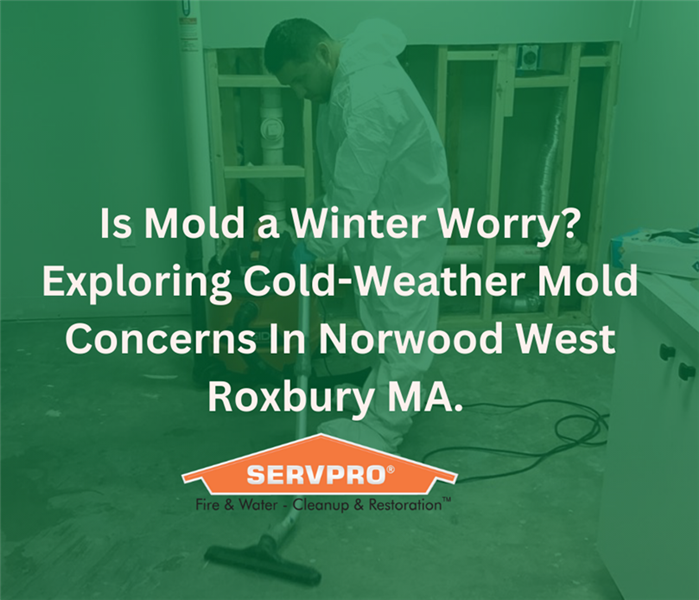 Although mold concerns may not be as conspicuous in winter as during warmer seasons, the cold weather brings its own challenges conducive to mold grow
Although mold concerns may not be as conspicuous in winter as during warmer seasons, the cold weather brings its own challenges conducive to mold grow
When contemplating mold growth, the common association is with damp and warm conditions, often attributed to the summer season.
Nevertheless, mold-related issues are not confined to warmer months, as winter introduces its own set of circumstances that foster mold growth in unexpected areas. Explore the relevance of mold as a concern during winter and delve into the specific cold-weather challenges that homeowners and businesses in Norwood West Roxbury should be mindful of.
Condensation and Indoor Humidity:
- Cold-Weather Concern: In winter, temperature differentials between outdoor and indoor environments can result in condensation on surfaces like windows and walls. This moisture, coupled with indoor humidity, establishes an environment conducive to mold growth.
- Preventive Measures: Maintain indoor humidity levels below 60%, employ exhaust fans in moisture-prone areas like bathrooms and kitchens, and ensure proper ventilation to minimize window condensation.
Ice Dams and Roof Leaks:
- Cold-Weather Concern: Ice dams, formed by snow melting and refreezing on roofs, can lead to water infiltration and roof leaks. If not promptly addressed, this moisture creates favorable conditions for mold growth in attics and ceilings.
- Preventive Measures: Properly insulate and ventilate attics to prevent ice dams. Regularly inspect roofs for leaks and promptly address any issues to prevent water damage.
Mold in Heating Systems:
- Cold-Weather Concern: Mold can thrive in heating systems, particularly in ductwork and on heating coils. As warm air circulates through the system, mold spores can be disseminated throughout the building.
- Preventive Measures: Conduct regular inspections and cleanings of HVAC systems, including ductwork and coils. Use high-quality air filters and consider professional HVAC maintenance.
Basement Moisture Issues:
- Cold-Weather Concern: Cold temperatures may cause condensation on basement walls and floors, while melting snow and frozen ground can contribute to moisture entering basements.
- Preventive Measures: Seal cracks in basement walls, ensure proper drainage away from the foundation, and utilize dehumidifiers to control indoor humidity levels.
Firewood Storage:
- Cold-Weather Concern: Storing firewood indoors for winter heating can introduce moisture into the home, providing a suitable environment for mold growth.
- Preventive Measures: Store firewood outdoors in a dry, covered area, bringing in only small amounts at a time. Keep firewood away from walls and above ground level.
Although mold concerns may not be as conspicuous in winter as during warmer seasons, the cold weather brings its own challenges conducive to mold growth. By comprehending these cold-weather mold concerns and implementing preventive measures such as regular maintenance, proper ventilation, and moisture control, homeowners and businesses can foster a healthy and mold-free indoor environment throughout the winter months in Norwood West Roxbury.
Understanding the Different Types of Fire and Smoke Damage In Norwood West Roxbury, MA.
1/24/2024 (Permalink)
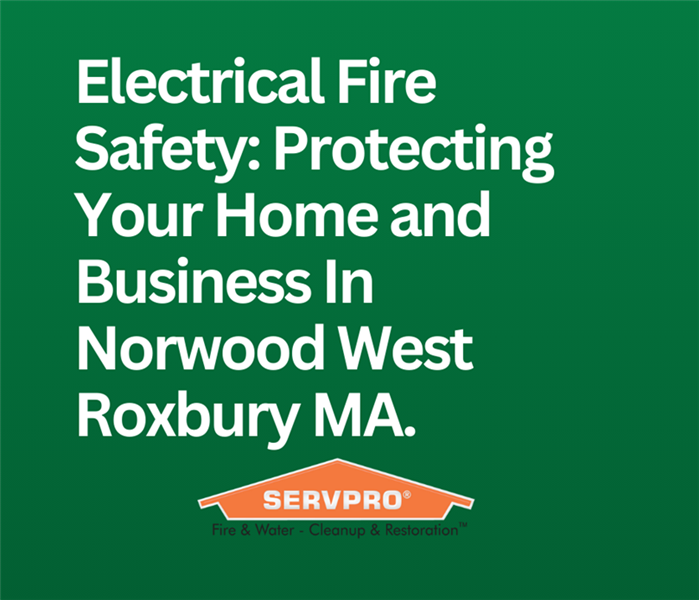 A nuanced understanding of the different types of fire and smoke damage is a fundamental step in the restoration process
A nuanced understanding of the different types of fire and smoke damage is a fundamental step in the restoration process
Confronting a fire is an emotionally wrenching experience, and the aftermath encompasses not only the evident destruction caused by flames but also the far-reaching consequences of smoke.
Fire and smoke damage exhibit diverse characteristics, and grasping these distinctions is vital for a successful restoration and recovery process. Here, we delve into the various types of fire and smoke damage, along with the challenges inherent in each category.
Structural Damage:
- Description: Structural damage is the most conspicuous outcome of a fire, impacting walls, floors, ceilings, and other integral building elements.
- Causes: Direct exposure to flames, elevated temperatures, and the compromise of material integrity during the fire.
- Challenges: Evaluating and rectifying structural damage often necessitates collaboration among structural engineers, contractors, and restoration specialists.
Soot Damage:
- Description: Soot is a fine, black residue comprised of carbon particles generated by incomplete combustion. It can coat surfaces and possessions, leaving behind a distinctive odor and stains.
- Causes: Incomplete combustion of organic materials during a fire, releasing fine particles that settle on surfaces.
- Challenges: Cleaning soot demands specialized techniques and equipment to prevent smearing and further damage.
Smoke Damage:
- Description: Smoke damage encompasses the repercussions of smoke on surfaces, belongings, and indoor air quality, typically manifesting as discoloration, odors, and corrosive residues.
- Causes: The intricate mixture of gases, chemicals, and particles released during a fire that adhere to surfaces and materials.
- Challenges: Addressing smoke damage comprehensively requires proper ventilation, air purification, and targeted cleaning.
Water Damage:
- Description: Water damage is a secondary consequence of firefighting efforts, arising from the use of water to extinguish flames. It can lead to issues such as mold growth and structural deterioration.
- Causes: Firefighters' use of water or other suppressants to extinguish the fire.
- Challenges: Swift water extraction, drying, and dehumidification are crucial to prevent further damage and mitigate the risk of mold growth.
Corrosion Damage:
- Description: Corrosion occurs when acidic byproducts of combustion react with metals, resulting in deterioration and discoloration.
- Causes: Interaction between acidic residues in smoke and metal surfaces.
- Challenges: Immediate cleaning and treatment of metal surfaces are necessary to prevent irreversible corrosion damage.
Odor Damage:
- Description: Lingering odors are a common post-fire issue, stemming from the combustion of various materials.
- Causes: Absorption of smoke particles into porous surfaces, making odors challenging to eliminate.
- Challenges: Effective odor removal necessitates specialized techniques such as ozone treatment or thermal fogging to neutralize and eliminate persistent smells.
Coping with the aftermath of a fire entails addressing various types of damage, each requiring specific expertise and techniques. Restoration professionals play a pivotal role in evaluating and mitigating these damages, aiding individuals and businesses in rebuilding and recovering from the devastating effects of fire and smoke.
A nuanced understanding of the different types of fire and smoke damage is a fundamental step in the restoration process, ensuring a comprehensive and effective approach to recovery in Norwood West Roxbury.
Electrical Fire Safety: Protecting Your Home and Business In Norwood West Roxbury, MA.
1/22/2024 (Permalink)
 Stay informed, stay safe, and empower others with the knowledge needed to prevent electrical fires in Norwood West Roxbury.
Stay informed, stay safe, and empower others with the knowledge needed to prevent electrical fires in Norwood West Roxbury.
Electricity plays a pivotal role in our daily lives, powering our homes and businesses.
However, its use comes with inherent risks, and the threat of electrical fires poses serious dangers to both life and property. A comprehensive understanding of electrical fire safety is essential for mitigating these risks and ensuring the safety of occupants. Let's explore key measures to enhance electrical fire safety both at home and in the workplace.
Common Causes of Electrical Fires:
- Faulty Wiring: Aging or improperly installed wiring can be a source of electrical fires. Regular inspections and maintenance are crucial to identifying and addressing potential issues.
- Overloaded Circuits: Plugging numerous devices into a single outlet or overloading circuits can generate excessive heat, leading to sparks and fires. Distributing electrical loads evenly and avoiding the daisy-chaining of multiple power strips is essential.
- Malfunctioning Appliances: Appliances with damaged cords or internal components can become fire hazards. Regular inspection and timely replacement of damaged cords, following manufacturer guidelines for maintenance, are imperative.
- Electrical Equipment Issues: Faulty electrical equipment, such as circuit breakers or outlets, can contribute to electrical fires. Regular checks to ensure all electrical components are in good working condition are necessary.
- Flammable Materials Near Outlets: Placing flammable materials close to electrical outlets or equipment increases the risk of fire. Keeping these areas clear minimizes potential hazards.
Electrical Fire Safety Tips for Homes and Businesses:
- Regular Inspections and Maintenance: Schedule periodic inspections of the electrical system, especially in older structures. Look for signs of wear, exposed wires, or scorch marks. Promptly address any issues with the help of a qualified electrician.
- Avoid Overloading Circuits: Be mindful of the number of devices plugged into outlets and avoid overloading circuits. Use power strips with built-in surge protection to safeguard against voltage spikes.
- Proper Use of Extension Cords: Limit the use of extension cords to temporary solutions. Avoid daisy-chaining multiple extension cords together.
- Upgrade Wiring and Electrical Panels: Consider upgrading outdated wiring or electrical panels to meet current safety standards, significantly reducing the risk of electrical fires.
- Appliance Safety: Regularly check appliances for signs of damage, replace frayed or worn-out cords, and follow manufacturer guidelines for maintenance. Avoid leaving appliances unattended when in use.
- Install Smoke Alarms: Ensure smoke alarms are strategically placed in key areas. Regularly test and replace batteries to guarantee functionality.
- Emergency Response Plan: Develop and communicate an emergency response plan that includes procedures for dealing with electrical fires. Ensure all occupants are aware of evacuation routes and the location of fire extinguishers.
Electrical fire safety is a collective responsibility that requires vigilance and proactive measures. By staying informed, conducting regular inspections, and implementing safety measures, the risk of electrical fires can be significantly reduced at home and in the workplace. Prioritizing electrical safety not only protects property but, more importantly, ensures the safety and well-being of individuals. Stay informed, stay safe, and empower others with the knowledge needed to prevent electrical fires in Norwood West Roxbury.
Does Your Business Have a Fire Evacuation Plan In Norwood West Roxbury, MA?
1/10/2024 (Permalink)
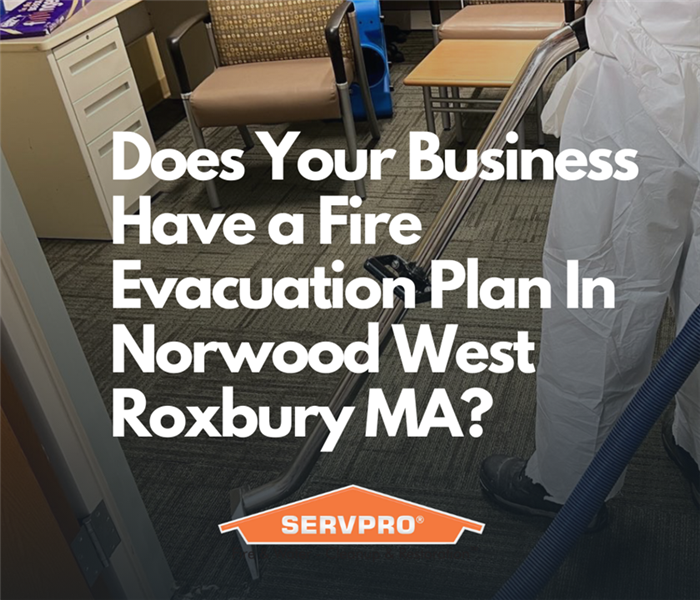 Safety should always be at the forefront of your business priorities in Norwood West Roxbury.
Safety should always be at the forefront of your business priorities in Norwood West Roxbury.
In the fast-paced realm of business, amidst the daily hustle, one crucial aspect that often takes a backseat is a comprehensive fire evacuation plan.
While the hope is to never face disasters, preparedness for the worst can significantly impact safeguarding employees, clients, and assets. Understanding the importance of a fire evacuation plan for your business and taking proactive steps can make a substantial difference in ensuring the safety of everyone involved.
The Importance of a Fire Evacuation Plan:
- Protecting Lives and Assets: The primary purpose is to ensure swift and safe evacuation during a fire, minimizing the risk of injuries or fatalities. Safeguards valuable assets and sensitive information crucial for business continuity.
- Legal Compliance: Many jurisdictions mandate businesses to have a fire evacuation plan, not just as a legal requirement but as a moral obligation to prioritize well-being. Non-compliance may lead to severe consequences, including fines and legal actions
- Maintaining Business Continuity: Contributes to the quick resumption of essential operations after a fire incident, minimizing disruptions and potential financial losses.
Steps to Develop an Effective Fire Evacuation Plan:
- Conduct a Risk Assessment: Identify potential fire hazards within the premises, such as electrical equipment or flammable materials. Understanding risks is crucial for developing a targeted evacuation plan.
- Establish Clear Evacuation Routes:Designate primary and alternative evacuation routes that are well-lit, unobstructed, and easily accessible. Consider the needs of individuals with disabilities and make provisions for their assistance.
- Implement an Emergency Communication System: Establish a robust communication system, including fire alarms, intercoms, or other notification methods. Regularly test and maintain these systems to ensure proper functionality.
- Assign Responsibilities: Clearly define the roles and responsibilities of designated personnel during a fire evacuation. Responsibilities may include sounding alarms, guiding occupants to safety, and conducting headcounts at assembly points.
- Conduct Regular Drills and Training: Practice fire evacuation drills regularly to familiarize employees with procedures and exit routes. Provide training on fire safety, including the proper use of firefighting equipment, to empower individuals to respond effectively in an emergency.
A fire evacuation plan is not just a document; it's a dynamic and living strategy that can make a significant difference during a crisis. Prioritizing the safety of employees and visitors through a well-executed plan fulfills legal obligations and reflects a commitment to their well-being.
Regularly review and update your fire evacuation plan, ensuring everyone in the organization is prepared to respond swiftly and decisively in case of a fire emergency. Remember, safety should always be at the forefront of your business priorities in Norwood West Roxbury.
What to Do in the Event of a Fire in Norwood West Roxbury.
12/7/2023 (Permalink)
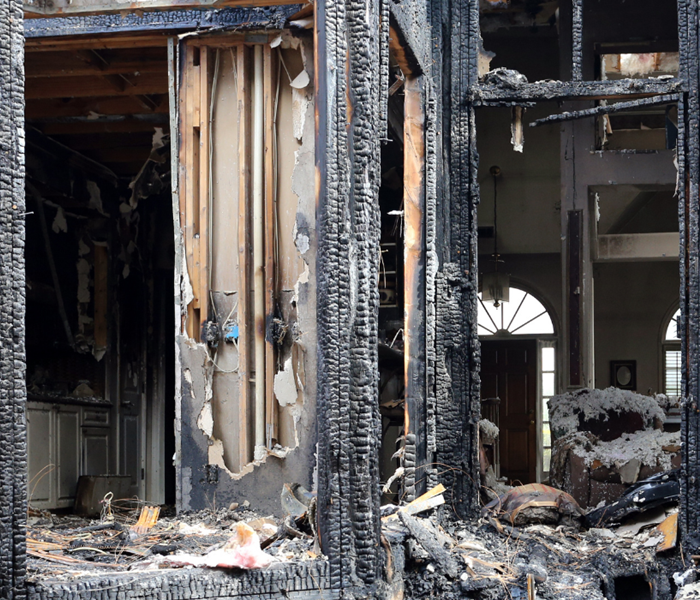 Preparation for fire emergencies involves education, awareness, and practice.
Preparation for fire emergencies involves education, awareness, and practice.
Fires can be highly unpredictable, escalating swiftly and posing grave threats to both life and property.
Whether at home, work, or in public spaces, the key to minimizing risks lies in preparedness and understanding how to respond when faced with a fire emergency in Norwood West Roxbury.
Maintain Composure and Stay Alert:
In any emergency, maintaining a calm demeanor is paramount. Panic can impede clear thinking and swift decision-making. If you come across a fire or hear a fire alarm, stay composed and alert those around you. Time is critical in fire emergencies, and a collected mindset facilitates prompt and effective action.
Immediate Evacuation is Essential:
Prioritize your safety and that of others. If the fire is small and manageable, attempt to control it with a suitable fire extinguisher. However, if the fire is spreading or you feel unsafe, evacuate the area immediately. Do not waste time gathering belongings; prioritize swift evacuation.
Follow Designated Exit Routes:
In public spaces or buildings, acquaint yourself with exit routes and emergency exits. During a fire, calmly follow these routes and assist others, especially those with mobility challenges. Avoid using elevators during a fire; opt for stairwells instead.
Crawl Low in Smoky Conditions:
Smoke inhalation is a significant risk during fires. If there's smoke, stay close to the ground where the air is clearer. By crawling low, you can minimize the risk of inhaling harmful gases, increasing your chances of reaching safety.
Promptly Call for Assistance:
Once outside the building safely, immediately contact emergency services. Furnish accurate information about the fire's location and nature. Refrain from re-entering the building unless instructed by emergency personnel.
Gather at a Designated Meeting Point:
In residential or workplace settings, establish a meeting point at a safe distance from the building. This ensures quick accountability and provides emergency responders with accurate information about who may still be inside.
No Re-entry into Burning Buildings:
Under no circumstances should you re-enter a burning building. Allow trained firefighters to handle the situation. Re-entering poses extreme danger and may result in severe injuries or loss of life.
Adhere to Fire Prevention Measures:
Preventing fires is as crucial as knowing how to respond to them. Regularly check smoke detectors, electrical systems, and heating appliances. Avoid overloading electrical outlets and practice safe cooking habits. Proactive fire prevention significantly reduces the risk of fire incidents.
Preparation for fire emergencies involves education, awareness, and practice. By remaining calm, evacuating promptly, and adhering to safety procedures, you safeguard yourself and others. Regularly reviewing and practicing these steps ensures effective response readiness, contributing significantly to overall community safety.
SERVPRO Of Norwood West Roxbury is The #1 Choice in Cleanup and Restoration for residential and commercial buildings’ fire damage.
Understanding Water and Mold Damage from Winter Pipe Breaks in Norwood West Roxbury.
12/7/2023 (Permalink)
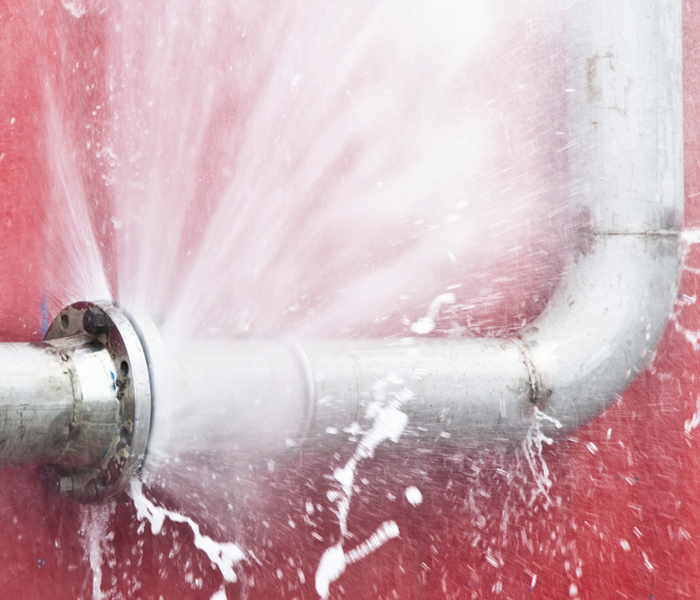 Winter pipe breaks and the ensuing water and mold damage can be a homeowner's nightmare.
Winter pipe breaks and the ensuing water and mold damage can be a homeowner's nightmare.
As winter envelops the world in a tranquil blanket of snow, it ushers in the potential for a less picturesque yet all too common problem: frozen pipes.
The plummeting temperatures can wreak havoc on plumbing systems, resulting in pipe breaks that lead to water damage and, subsequently, the growth of mold. Discover the causes of winter pipe breaks, the repercussions of water damage, and effective measures to prevent and address the aftermath in Norwood West Roxbury.
Understanding Winter Pipe Breaks:
- Frigid Temperatures: The primary culprit behind winter pipe breaks is the freezing of water within the pipes. As water freezes, it expands, exerting substantial pressure on the pipe walls. This heightened pressure can result in cracks, bursts, or complete ruptures in the plumbing system.
- Inadequate Insulation: Insufficient insulation around pipes elevates the risk of freezing, with exposed pipes in attics, basements, or crawl spaces being particularly vulnerable. Proper insulation ensures a consistent temperature, shielding pipes from the harsh winter cold.
Consequences of Winter Pipe Breaks:
- Water Damage: A ruptured pipe can unleash a significant volume of water into your home or business, causing extensive damage to walls, floors, and personal belongings. Swift intervention is essential to prevent further harm and minimize repair costs.
- Mold Growth: The introduction of water significantly raises the likelihood of mold growth. Thriving in damp, humid environments, mold finds an ideal breeding ground in the aftermath of a pipe break.
Preventing and Addressing Water Damage:
- Insulate Pipes: Ensure proper insulation for all pipes, especially those in vulnerable areas, to maintain a consistent temperature and reduce the risk of freezing.
- Maintain Interior Warmth: Sustain a warm environment within your home or business, especially in areas with exposed pipes, through effective heating and insulation.
- Faucet Dripping: On exceptionally cold nights, let faucets drip slowly to keep water flowing, diminishing the chances of pipes freezing.
- Leak Sealing: Regularly inspect and seal any leaks in your home's structure, as even minor leaks can escalate into significant issues in freezing temperatures.
- Emergency Preparedness: Establish an emergency plan, familiarizing yourself with the main water shut-off valve's location and how to quickly turn it off. This proactive step can minimize damage in the event of a pipe break.
Winter pipe breaks and the ensuing water and mold damage can be a homeowner's nightmare. However, with vigilant precautions and a proactive maintenance approach, you can substantially reduce the risk of such incidents. Prevention remains paramount, but in the unfortunate event of a pipe break, swift action is vital to mitigate the damage and shield your home from the harsh consequences of winter's icy grasp.
SERVPRO Of Norwood West Roxbury is The #1 Choice in Cleanup and Restoration for residential and commercial buildings’ water damage.
Commercial Water Damage Restoration Specialists in Norwood West Roxbury.
12/7/2023 (Permalink)
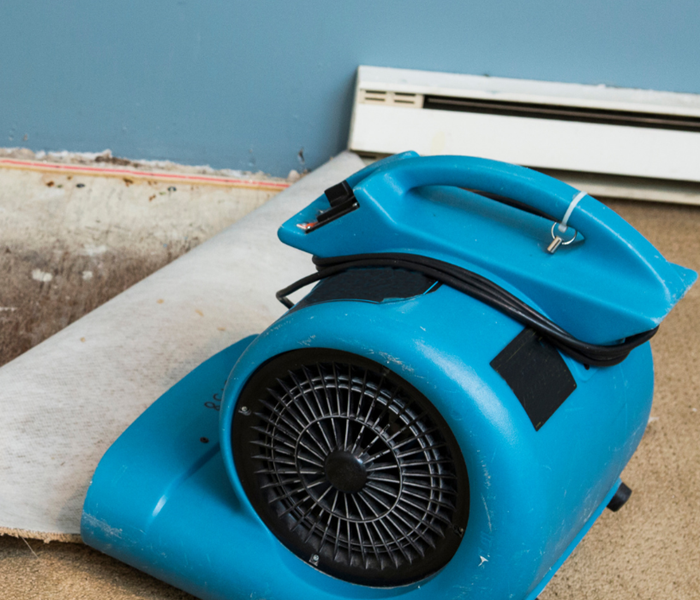 Commercial water damage restoration specialists are the unsung heroes navigating the aftermath of water-related disasters.
Commercial water damage restoration specialists are the unsung heroes navigating the aftermath of water-related disasters.
Water damage poses a quiet but formidable threat to commercial properties, causing not only physical harm but also significant financial and operational setbacks.
In times of crisis, commercial water damage restoration specialists emerge as the unsung heroes, diligently working behind the scenes to restore normalcy. Let's delve into the essential role these specialists play and why their expertise is paramount in addressing water-related emergencies in Norwood West Roxbury.
The Stealthy Adversary: Water damage, stemming from sources like burst pipes, flooding, leaks, or natural disasters, is a pervasive issue with far-reaching consequences for commercial properties. Beyond visible destruction, the aftermath may include mold growth, structural compromise, and damage to valuable assets, leading to substantial financial losses if not promptly and effectively managed.
The Function of Commercial Water Damage Restoration Specialists:
- Prompt Response and Assessment: Recognizing the time-sensitive nature of mitigating water-related disasters, these specialists respond swiftly to assess the damage's extent and devise an effective restoration plan. Timely intervention prevents secondary damage and minimizes the overall impact on the property.
- State-of-the-Art Equipment and Techniques: Equipped with cutting-edge tools and technology, these specialists efficiently extract water, dehumidify affected areas, and restore the property to its pre-damage condition. Utilizing powerful water pumps and industrial-grade dehumidifiers, they leverage advanced equipment to expedite the restoration process.
- Thorough Restoration Planning: Acknowledging the uniqueness of each water damage scenario, commercial water damage restoration specialists meticulously evaluate the situation, identifying the most suitable course of action. This planning includes considerations for structural integrity, potential mold growth, and the preservation of valuable assets.
- Proficiency in Mold Remediation: Following water damage, the looming risk of mold growth is a major concern. Specialists in commercial water damage restoration possess expertise in mold remediation techniques, ensuring thorough cleaning and treatment of affected areas to prevent future infestations. This expertise is vital for maintaining a safe and healthy working environment.
- Coordination with Stakeholders: Effective communication and coordination with property owners, insurance providers, and other stakeholders are integral to the restoration process. Serving as liaisons, commercial water damage restoration specialists provide transparent updates, ensuring all involved parties are informed about progress and next steps.
Commercial water damage restoration specialists are the unsung heroes navigating the aftermath of water-related disasters. Their expertise, coupled with advanced equipment and a commitment to swift, efficient restoration, plays a pivotal role in minimizing the impact on businesses and communities. Recognizing and appreciating the invaluable work of these specialists enhances our understanding of the value they bring and underscores the importance of their role in protecting commercial properties from the subtle threat of water damage in Norwood West Roxbury.
SERVPRO Of Norwood West Roxbury is The #1 Choice in Cleanup and Restoration of commercial buildings’ fire damage.
Critical Questions to Ask Before Hiring a Home Restoration Professional in Norwood West Roxbury.
12/7/2023 (Permalink)
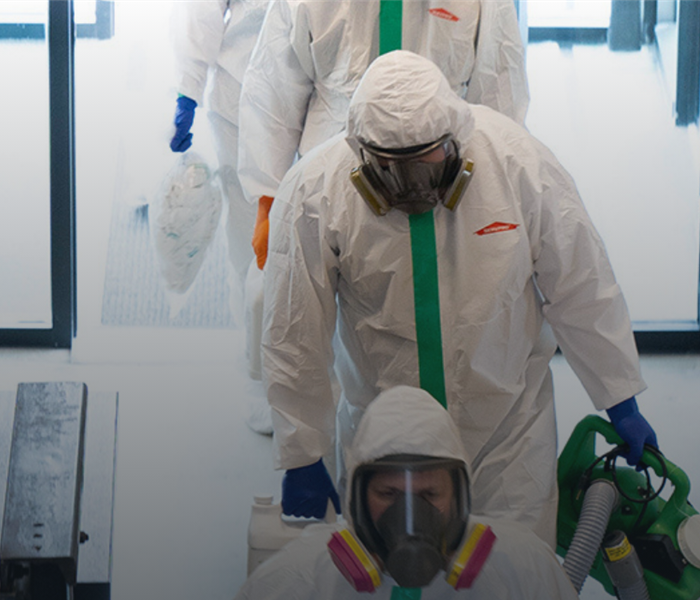 Selecting the right home restoration professional entails thorough research and targeted inquiries.
Selecting the right home restoration professional entails thorough research and targeted inquiries.
Embarking on home restoration projects can evoke a mix of excitement and stress.
Whether grappling with the aftermath of a natural disaster, fire damage, or simply aiming to enhance and modernize your living space, selecting the appropriate home restoration professional is paramount. Opting for the wrong contractor may result in delays, exceeding budget limits, and substandard outcomes. To ensure a smooth and successful restoration process in Norwood West Roxbury, it's crucial to pose pertinent questions before finalizing your decision. Here are key inquiries to make when hiring a home restoration professional.
- Are you licensed and insured? It's imperative that the home restoration professional possesses a valid license and insurance. A valid license signifies compliance with requisite standards, while insurance safeguards both you and the workers in case of accidents or damages during the project.
- What experience do you have in home restoration? Experience holds significant weight. Inquire about the contractor's specific experience in projects akin to your home restoration needs. Seasoned professionals are better equipped to navigate unforeseen challenges and deliver quality workmanship.
- Can you provide references from past clients? A reputable professional should willingly share references from previous clients. Contacting these references allows you to glean insights into the contractor's work ethic, reliability, and the overall satisfaction of past customers.
- What is the estimated timeline for the project? Clearly defining the project's timeline is crucial to avoid frustration and unforeseen costs. Obtain a detailed timeline from the contractor, encompassing milestones and potential challenges, to ensure alignment.
- How do you handle permits and regulatory approvals? Home restoration projects often necessitate permits and adherence to local regulations. Ensure the contractor is well-versed in obtaining necessary permits and approvals to preempt legal complications.
- What is the total cost and payment schedule? Discussing costs upfront is essential to avert surprises. Request a detailed breakdown of estimated costs, covering materials and labor. Additionally, establish a transparent payment schedule tied to project milestones.
- Do you provide a written contract? A written contract is non-negotiable. It should encompass all discussed details, such as the scope of work, timeline, costs, and warranties. This contract serves as a reference point in case of disputes.
- What safety measures do you have in place during the project? Safety is paramount. Inquire about the contractor's safety protocols, particularly measures to protect your property and the workers involved, especially in hazardous restoration scenarios.
- How do you communicate with clients throughout the project? Effective communication is pivotal. Inquire about the contractor's preferred communication channels, frequency of updates, and identify the primary point of contact.
- What warranties do you offer on your work? A reputable professional should offer warranties or guarantees on materials and labor. This ensures coverage in the event of any post-completion issues.
Selecting the right home restoration professional entails thorough research and targeted inquiries. By delving into qualifications, experience, and project approach, you can make an informed decision, laying the groundwork for a successful and stress-free home restoration experience in Norwood West Roxbury.
SERVPRO Of Norwood West Roxbury is The #1 Choice in Cleanup and Restoration for residential buildings’ fire damage.
Sump Pump Failure and the Importance of Preparedness
11/11/2023 (Permalink)
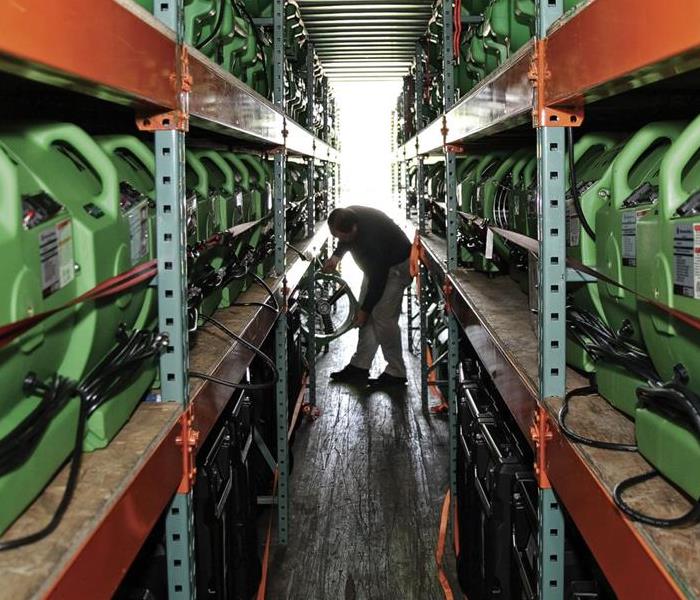 Sump pump failure, often underestimated, poses a significant threat to the safety and integrity of your home.
Sump pump failure, often underestimated, poses a significant threat to the safety and integrity of your home.
In the realm of safeguarding homes from potential water damage, there exists an unsung hero typically concealed in basements and crawl spaces—the sump pump. While quietly performing its duty, diligently preventing basement flooding, its malfunction can result in catastrophic consequences. This overview delves into the causes behind sump pump failure, the indicators to be attentive to, and essential steps to guarantee your home's ongoing protection.
The Unseen Protector: The unassuming sump pump plays a crucial role in averting basement flooding. Nestled in a specially constructed pit, it senses rising water levels and expels excess water from your home's foundation. This uncomplicated yet efficient system serves as a homeowner's initial defense against water damage triggered by heavy rainfall, snowmelt, or ascending groundwater.
Common Causes of Sump Pump Failure:
- Power Outages: In the absence of electricity, the pump remains inoperative, leaving your basement susceptible to flooding.
- Lack of Maintenance: Similar to any mechanical system, regular upkeep is imperative for sump pumps. Over time, debris and sediment accumulation can compromise the pump's efficiency.
- Float Switch Issues: Responsible for activating the pump during rising water levels, mechanical failures or obstructions can impede the float switch's proper functioning, resulting in pump failure.
- Frozen Discharge Pipe: In colder climates, a frozen discharge pipe can hinder the pump's expulsion of water, leading to water backflow into the basement.
- Pump Overwhelm: During intense rainfall or rapid snowmelt, the sump pump may struggle with the volume of water, exerting excessive effort and potentially failing.
Recognizing the Signs:
To preclude being caught off guard by a sump pump failure, it's vital to remain vigilant for warning signs and unusual noises. Grinding or clanking sounds may indicate mechanical issues within the pump.
- Visible Rust or Corrosion: Rust or corrosion on the pump or its components may signal wear and tear, potentially resulting in failure.
- Frequent Cycling: Unusual on-off cycling may indicate problems with the float switch or other components.
- Foul Odors: Unpleasant smells may suggest stagnant water in the sump pit, a consequence of the pump not effectively removing water.
- Schedule regular maintenance to clear debris, test the float switch, and ensure all components are functioning correctly. Additionally, install a battery backup system to maintain sump pump functionality during power outages.
Sump pump failure, often underestimated, poses a significant threat to the safety and integrity of your home. By comprehending common causes, recognizing warning signs, and taking proactive measures, you can minimize the risk of basement flooding and shield your property from the potential ramifications of sump pump failure.
SERVPRO Of Norwood West Roxbury is The #1 Choice in Cleanup and Restoration for residential and commercial buildings’ fire, mold, water, and storm damage. Call us today at (781) 769-9125
A Guide to Christmas Fire Safety in Norwood West Roxbury MA.
11/8/2023 (Permalink)
 By taking simple precautions and being mindful of fire safety, you can ensure that the holiday season remains merry and bright for everyone.
By taking simple precautions and being mindful of fire safety, you can ensure that the holiday season remains merry and bright for everyone.
As the holiday season draws near, families come together, homes are adorned with shimmering lights and decorations, and the enticing scent of delectable meals permeates the air. Yet, amid the festivities, prioritizing safety—especially concerning fire safety—is of paramount importance for a joyous and secure Christmas celebration. Here are some indispensable tips to ensure a Merry and safe Christmas for you and your loved ones.
Thoughtful Decoration Placement:
Embracing the tradition of decking the halls with festive decorations is a beloved Christmas ritual. However, it's crucial to exercise mindfulness in where and how these adornments are placed. Keep flammable materials, such as curtains, tablecloths, and other decorations, at a safe distance from heat sources like candles and fireplaces. Opt for decorations that are flame-resistant or flame-retardant whenever possible.
Candle Safety:
While candles contribute to a warm and inviting atmosphere, they also pose a notable fire hazard. If you appreciate the glow of candlelight, consider using flameless LED candles as a safer alternative. If traditional candles are your preference, never leave them unattended, ensure they are kept away from children and pets, and place them in stable holders on a flat surface.
Inspect Christmas Lights:
Before adorning your space with Christmas lights, carefully inspect them for any signs of damage, such as frayed wires, broken bulbs, or exposed wiring. Discard and replace any compromised lights, and adhere to the manufacturer's guidelines for proper usage. Consider the use of LED lights, as they generate less heat and are more energy-efficient compared to traditional incandescent lights.
Thoughtful Tree Care:
For those with live Christmas trees, maintaining proper hydration is crucial for fire prevention. Dry trees are highly flammable, so be diligent about watering your tree regularly and position it away from heat sources. If an artificial tree is your choice, ensure it is labeled as flame-resistant.
Cooking Safety:
The Christmas feast is a central element of the celebration, but it also coincides with a higher risk of kitchen fires. Stay vigilant while cooking, use timers to prevent overcooking, and keep flammable items like kitchen towels and oven mitts at a safe distance from the stove. If deep-frying is on the menu, do so outdoors and away from structures.
Have an Escape Plan:
In the unfortunate event of a fire, having a well-thought-out escape plan is critical. Ensure that everyone in the household is familiar with the plan, including designated meeting points outside the home. Regularly practice fire drills, especially if you have guests staying with you over the holidays.
Christmas is a time for joy, warmth, and togetherness. By taking simple precautions and being mindful of fire safety, you can ensure that the holiday season remains merry and bright for everyone. SERVPRO Of Norwood West Roxbury is The #1 Choice in Cleanup of residential and commercial buildings’ fire damage. Call us today at (781) 769-9125
A Guide to Thanksgiving Fire Safety in Norwood West Roxbury MA.
11/3/2023 (Permalink)
 Prioritizing safety is paramount, particularly concerning potential fire hazards.
Prioritizing safety is paramount, particularly concerning potential fire hazards.
Indulge in the enticing fragrance of roasted turkey, the comforting warmth of pumpkin pie, and the joyous gathering of loved ones that collectively craft a festive atmosphere. Amidst the revelry, it is imperative to prioritize safety, particularly concerning potential fire hazards. Explore Thanksgiving fire safety tips to safeguard your holiday, ensuring it remains a time of gratitude and joy.
Kitchen Safety: The epicenter of Thanksgiving is undeniably the kitchen, where the enchantment of the feast unfolds.
- Never leave the stove unattended, especially during oil-based or frying activities.
- Keep flammable items, such as kitchen towels and oven mitts, away from the stovetop.
- Verify the proper functioning of smoke alarms and have a readily accessible fire extinguisher.
Turkey Fryer Safety: Deep-frying turkeys has evolved into a popular Thanksgiving tradition, accompanied by inherent risks.
- Set up the fryer outdoors, maintaining a safe distance from the house, deck, or any flammable materials.
- Thoroughly thaw the turkey before frying to prevent oil splatters.
- Monitor the oil temperature closely and avoid overfilling the fryer.
- Candle Caution: While candles contribute to a warm and cozy ambiance at your Thanksgiving dinner, they also pose a fire risk.
- Keep candles away from flammable decorations and other items.
- Place candles in stable, non-tip candle holders.
- Never leave lit candles unattended; extinguish them before leaving the room.
Electrical Safety: Thanksgiving often involves a plethora of electrical appliances and devices.
- Avoid overloading electrical outlets and use surge protectors when necessary.
- Inspect cords for frays or damage, replacing them as needed.
- Turn off appliances when not in use, and if possible, unplug them.
- Keep an Eye on Children: While children enhance the festive spirit, their curiosity can lead to unawareness of potential dangers.
- Designate a kid-free zone in the kitchen.
- Educate children about fire safety and stress the importance of staying away from hot surfaces.
- Assign a responsible adult to supervise young children during festivities.
Prioritizing safety is paramount, particularly concerning potential fire hazards. SERVPRO Of Norwood West Roxbury is The #1 Choice in Cleanup and Restoration for residential and commercial buildings’ fire damage. Call us today at (781) 769-9125
Join Our SERVPRO Patriots Toy Drive!
10/29/2023 (Permalink)
 The Patriots Toy Drive is a wonderful opportunity to make a positive impact on the holiday season
The Patriots Toy Drive is a wonderful opportunity to make a positive impact on the holiday season
The holiday season is a time of giving, and our SERVPRO franchise is thrilled to be a part of the Patriots Toy Drive this year. We invite you to join us in making a difference in the lives of children by contributing to this heartwarming initiative. Here's how you can get involved!
Event Details:
What: Patriots Toy Drive
Where: SERVPRO Office, 90 Elm Street, Hopkinton, MA 01748
How: Drop off new toys in our office lobby
When: Monday – Friday, 9 AM – 5 PM
How to Participate:
- Donate a New Toy: We welcome any new, unwrapped toys that you'd like to contribute to the Patriots Toy Drive. Simply drop them off at our SERVPRO office, and look for the collection box in our lobby.
- Visit Our Office: Stop by our office during our regular business hours to deliver your donation. Our team will be on hand to receive your heartfelt contributions.
- Spread the Word: Help us make a bigger impact by sharing this information with your friends, family, and colleagues. Encourage them to join us in spreading joy to children in need.
- Get a Toy Box for Your Office: Want to involve your workplace in this heartwarming cause? We're happy to provide a toy collection box for your office. Reach out to Tom in our sales office at triley@SERVPROframingham.com to coordinate the details.
- Have Questions or Need Assistance? If you have any questions, need more information, or would like assistance in any way, feel free to reach out to Tom at the provided email address. He'll be more than happy to help make your participation in the Patriots Toy Drive seamless and enjoyable.
At SERVPRO, we believe in the power of community and the joy that comes from giving back. The Patriots Toy Drive is a wonderful opportunity to make a positive impact on the holiday season for children who could use a little extra cheer. Join us in spreading the warmth and magic of the holidays by contributing to this meaningful cause. Together, we can make a difference, one toy at a time. Thank you for your generosity and for being a part of this incredible journey!
How Does Water Damage Start in Norwood West Roxbury?
10/27/2023 (Permalink)
 How Does Water Damage Start in Norwood West Roxbury? Water doesn't stand a chance against SERVPRO Of Norwood West Roxbury
How Does Water Damage Start in Norwood West Roxbury? Water doesn't stand a chance against SERVPRO Of Norwood West Roxbury
Understanding how water damage starts is crucial for prevention and timely intervention. Here are various ways water damage can initiate and explore the ripple effect it can have on our homes.
- Leaky Roofs and Damaged Shingles: Leaky roofs, often caused by damaged or missing shingles, allow water to seep into the attic and other structural components of the house. Over time, this infiltration can lead to rotting wood, weakened ceilings, and eventually, water stains on interior walls.
- Faulty Plumbing: Leaky pipes, burst hoses, and faulty plumbing fixtures are notorious for initiating water damage. A small, unnoticed leak can quickly escalate, causing damage to walls, flooring, and even the foundation of the house. Regular inspections and prompt repairs are essential to mitigate the risks associated with plumbing-related water damage.
- Clogged Gutters and Downspouts: Gutters and downspouts play a crucial role in directing rainwater away from the house. When they become clogged with debris such as leaves, twigs, and dirt, water can overflow and saturate the exterior walls. This can lead to structural damage, mold growth, and erosion around the foundation.
- Poorly Sealed Windows and Doors: Inadequately sealed windows and doors provide an entry point for water, especially during heavy rain or storms. Over time, water infiltration can lead to rotting frames, damaged drywall, and compromised structural integrity. Regularly inspecting and resealing these entry points can help prevent water damage.
- Basement Flooding: Basements are particularly vulnerable to water damage due to their location below ground level. Heavy rainfall, poor drainage, or a high water table can result in basement flooding. This can cause extensive damage to walls, flooring, and valuable possessions stored in the basement.
- Appliance Leaks: Household appliances, such as washing machines, dishwashers, and water heaters, can be sources of water damage if they develop leaks. A malfunctioning appliance or a worn-out hose can release water into the surrounding areas, leading to damage to floors, walls, and nearby possessions.
Recognizing the signs and addressing the root causes promptly is essential for preventing extensive and costly damage. Regular maintenance, timely repairs, and a proactive approach to potential water entry points can safeguard your home from the silent threat of water damage. By understanding how water damage starts, we empower ourselves to protect our homes and ensure a dry and secure living environment for years to come.
Water doesn't stand a chance against SERVPRO Of Norwood West Roxbury commercial and residential remediation services. We're not just another remediation company; we're your partners in ensuring a safe, healthy environment. So, if you're facing a water problem, don't hesitate. You can reach a member of our team 24/7/365.
Mold FAQ: Your Comprehensive Guide to Understanding Mold
10/24/2023 (Permalink)
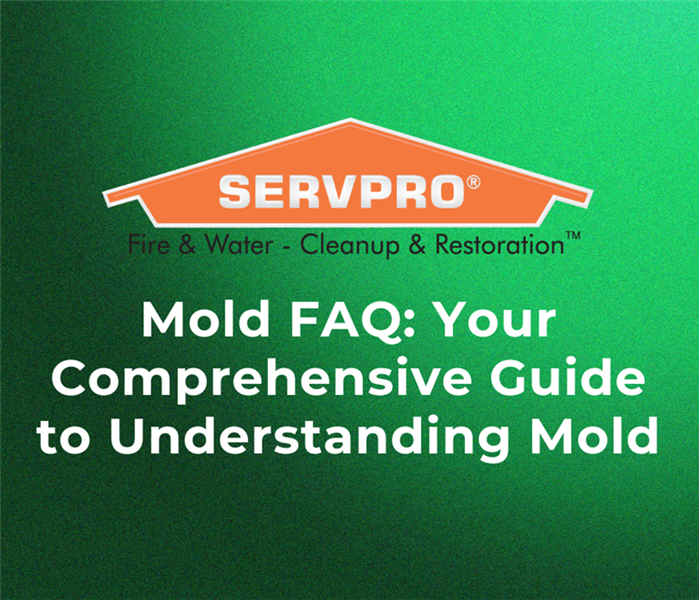 You can effectively manage and mitigate mold problems in your home in Walpole, MA.
You can effectively manage and mitigate mold problems in your home in Walpole, MA.
Mold is a common household problem that can lead to various health issues and property damage in Norwood West Roxbury MA. Many people have questions about mold. Here are answers to some frequently asked questions (FAQ) about mold to help you better understand this issue and how to deal with it effectively.
What is Mold?
Mold is a type of fungus that grows in the form of multicellular filaments called hyphae. It thrives in damp, humid conditions and can appear in various colors and textures. While some molds are harmless, others can produce mycotoxins, which can be harmful to human health.
What Causes Mold Growth?
Mold requires moisture, warmth, and organic material to grow. Common causes of mold growth in homes include water leaks, high humidity, poor ventilation, and damp building materials. Areas like bathrooms, basements, and kitchens are particularly susceptible to mold infestations.
Is Mold Dangerous to Health?
Yes, mold can be harmful to health, especially if it produces mycotoxins. Exposure to mold spores and mycotoxins can lead to a range of health issues, including allergies, respiratory problems, skin irritation, and more severe conditions in individuals with compromised immune systems. It's essential to address mold problems promptly to protect your health.
How Can I Prevent Mold Growth?
To prevent mold growth, you can take several proactive steps:
- Control indoor humidity levels (ideally between 30-50%).
- Fix any leaks or water damage promptly.
- Ensure proper ventilation in high-moisture areas.
- Use exhaust fans in bathrooms and kitchens.
- Clean and dry wet or damp materials and surfaces promptly.
- How Do I Identify Mold in My Home?
Mold is often visually identifiable by its fuzzy or slimy appearance and can come in various colors like black, green, white, or brown. You may also notice a musty odor in mold-infested areas. If you suspect mold, it's a good idea to consult a professional for a thorough inspection in Walpole, MA.
Can I Remove Mold Myself?
For small, surface-level mold problems (less than 10 square feet), you can attempt to clean it yourself using appropriate protective gear, such as gloves, a mask, and eye protection. Use a mixture of soap and water or a specialized mold cleaner. However, for extensive mold infestations, it's best to consult a professional mold remediation service.
How Can I Prevent Mold Recurrence?
To prevent mold from returning, continue to maintain a dry, well-ventilated environment in your home. Regularly inspect for leaks and address any moisture issues promptly. Consider using dehumidifiers in damp areas and ensuring your HVAC system is clean and well-maintained.
Do Home Insurance Policies Cover Mold Damage?
Home insurance policies may cover mold damage, but the coverage can vary widely. It typically depends on the cause of the mold and the specific terms of your policy. To ensure you're adequately covered, review your policy and consult with your insurance provider if necessary.
Understanding mold and how to deal with it is essential for maintaining a healthy and safe living environment. By following preventive measures, promptly addressing moisture issues, and seeking professional help when needed, you can effectively manage and mitigate mold problems in your home in Walpole, MA. If you have concerns about mold in your living space, it's always wise to consult with experts who can provide guidance and remediation services to keep your home mold-free and safe for your family's well-being.
SERVPRO® Of Norwood West Roxbury is The #1 Choice in Cleanup and Restoration for residential and commercial buildings’ fire, mold, water, and storm damage. Call us today at (781) 769-9125
Preventing Ice Dams: A Guide to Protecting Your Home in Norwood West Roxbury
10/18/2023 (Permalink)
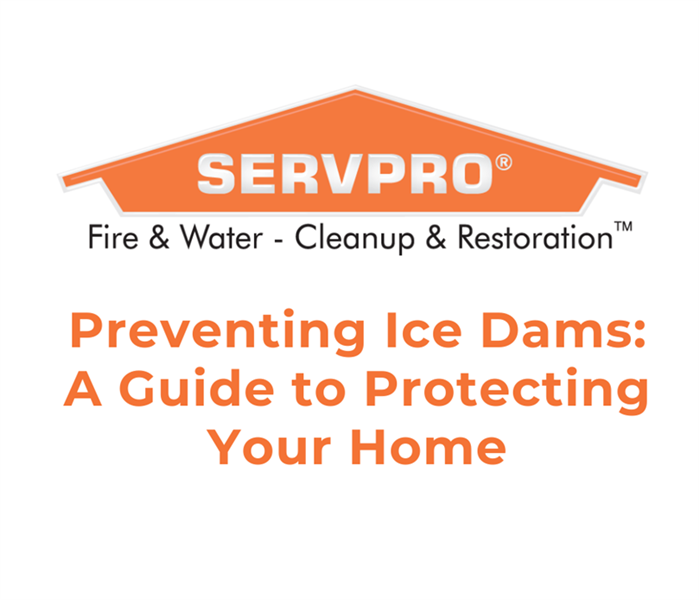 Preventing ice dams not only preserves your home's structural integrity but also keeps your energy bills in check and ensures a cozy winter.
Preventing ice dams not only preserves your home's structural integrity but also keeps your energy bills in check and ensures a cozy winter.
Winter can be a magical time of year, but it also brings its fair share of challenges, especially for homeowners in Norwood West Roxbury, MA.
One of the most common and potentially damaging issues during the winter months is the formation of ice dams on your roof. You can prevent ice dams from forming and protect your home. Learn what ice dams are, why they occur, and most importantly, how to prevent them.
Understanding Ice Dams
Ice dams are ridge-like accumulations of ice that form at the edge of your roof. They prevent melting snow and ice from draining off your roof, leading to water backing up and potentially seeping into your home. The process typically unfolds as follows:
- Snow Accumulation: A layer of snow blankets your roof.
- Heat Loss: Heat from your home escapes through the roof, causing the snow on the upper section to melt.
- Freezing Point: As the melted water reaches the lower, colder portion of the roof (usually near the eaves), it refreezes, forming a dam of ice.
- Water Backup: More snow continues to melt and flow toward the ice dam, eventually creating a pool of water that can find its way into your home through gaps in your roof or siding.
Why Preventing Ice Dams is Crucial
Ice dams can wreak havoc on your home in several ways:
- Roof Damage: The weight of ice dams can damage your roof's structure and shingles, leading to costly repairs.
- Water Damage: As the ice dams trap water on your roof, it can find its way into your home through ceilings, walls, and insulation, causing extensive interior damage.
- Mold and Mildew: Moisture infiltration can foster the growth of mold and mildew, which can pose health risks to your family.
- Energy Loss: Ice dams often form as a result of heat escaping from your home. This means you're losing valuable energy and driving up your heating bills.
Preventing Ice Dams: Tips and Techniques
Now that you understand the potential risks, let's explore some practical steps to prevent ice dams:
- Proper Insulation: Ensure your attic is well-insulated to prevent heat from escaping through the roof. Adequate insulation will keep the roof temperature uniform, reducing the chances of ice dam formation.
- Ventilation: Install roof and soffit vents to allow cool air to circulate through the attic. This helps maintain a consistent roof temperature, preventing snowmelt.
- Seal Gaps and Leaks: Seal any gaps, cracks, or openings in your roof, walls, and attic to minimize warm air leakage.
- Attic Air Sealing: Air sealing your attic can prevent warm air from escaping into the attic space.
- Roof Raking: After a heavy snowfall, use a roof rake to remove excess snow from the lower sections of your roof. This reduces the amount of snow available for melting and ice dam formation.
- Ice Dam Membranes: Consider installing an ice and water shield membrane under your roofing material, especially near the eaves, to prevent water infiltration.
- Gutter Maintenance: Keep your gutters clean and free of debris, allowing for proper water drainage. Consider installing heated gutter cables to prevent ice buildup.
- Professional Inspection: Schedule regular inspections with a roofing professional to identify and address potential issues before they become major problems.
By taking proactive steps to insulate your home, improve ventilation, and practice regular maintenance, you can significantly reduce the risk of ice dam formation. Preventing ice dams not only preserves your home's structural integrity but also keeps your energy bills in check and ensures a cozy, dry winter season indoors. Remember, a little prevention now can save you a lot of trouble and expense down the road. Stay warm, stay dry, and enjoy the winter season to the fullest in East Dedham, MA!
SERVPRO® Of Norwood West Roxbury is The #1 Choice in Cleanup and Restoration for residential and commercial buildings’ fire, mold, water, and storm damage. Call us today at (781) 769-9125
Protecting Your Home: A Comprehensive Guide to Fire Prevention
10/4/2023 (Permalink)
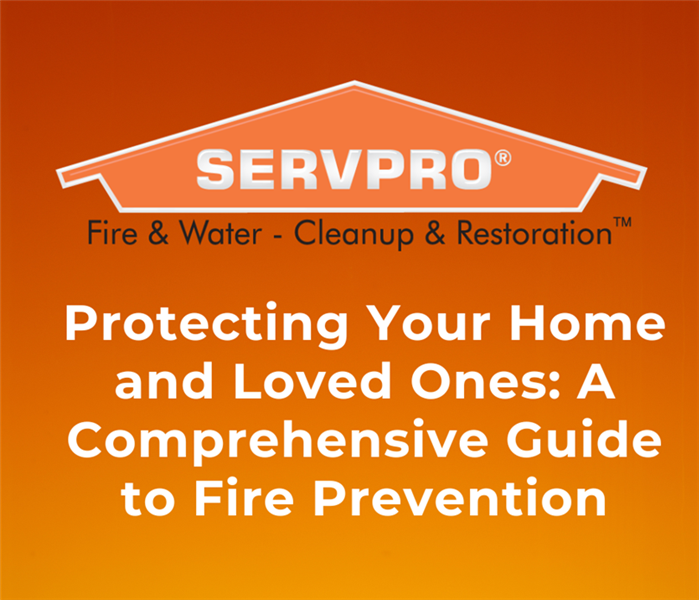 Stay safe, and prepared, and prevent fires to your home in Dedham, MA.
Stay safe, and prepared, and prevent fires to your home in Dedham, MA.
Many fires can be prevented with proper awareness, precautions, and responsible behavior.
Here are essential tips and strategies for fire prevention.
- Install Smoke Alarms: Ensure you have smoke alarms installed in key areas like bedrooms, hallways, and the kitchen. Regularly test them to make sure they are working correctly and replace their batteries at least once a year.
- Create a Fire Escape Plan: Make sure everyone in your household knows the plan, including multiple escape routes, a designated meeting point outside, and how to call 911. Practice fire drills regularly to ensure everyone is familiar with the process.
- Fire-Resistant Building Materials: If you're building a new home or renovating, consider using fire-resistant materials like fire-resistant roofing, siding, and insulation. These materials can slow the spread of flames and increase the chances of containing a fire until help arrives.
- Properly Store Flammable Materials: Store flammable materials, such as gasoline, propane, and paints, in a well-ventilated area away from heat sources and open flames. Use appropriate containers and follow safety guidelines to prevent leaks or spills.
- Maintain Heating Equipment: Heating equipment, including fireplaces, wood stoves, and furnaces, should be regularly inspected and maintained by professionals. Keep flammable materials at a safe distance and use protective barriers like screens to prevent sparks from escaping.
- Safe Cooking Practices: Never leave the kitchen unattended while cooking, and keep flammable objects like dish towels and curtains away from the stove. Install a fire extinguisher in or near the kitchen and know how to use it.
- Electrical Safety: Faulty electrical systems or appliances can trigger fires. Inspect electrical cords and outlets for damage and replace them if necessary. Avoid overloading electrical outlets and use surge protectors when needed.
- Candle Safety: Keep candles away from flammable materials and never leave them unattended. Consider using flameless LED candles as a safer alternative.
- Smoking Safety: If you smoke, do so outside and use a sturdy, deep ashtray. Ensure cigarettes are completely extinguished before disposing of them. Never smoke in bed, as falling asleep with a lit cigarette can lead to a deadly fire.
- Teach Fire Safety to Children: Children should be educated about fire safety from a young age. Teach them about the dangers of fire, how to respond in case of a fire, and the importance of not playing with matches or lighters.
Preventing fires is a shared responsibility that requires diligence and awareness. By following these fire prevention tips and fostering a culture of safety in your household, you can significantly reduce the risk of fires and protect your home and loved ones from this destructive force in Norwood West Roxbury. Remember, when it comes to fire prevention, an ounce of prevention is worth a pound of cure. Stay safe, and prepared, and prevent fires to your home in Dedham, MA.
SERVPRO® Of Norwood West Roxbury is The #1 Choice in Cleanup and Restoration for residential and commercial buildings’ fire, mold, water, and storm damage. Call us today at (781) 769-9125
The Dangers of Fall Leaves and Weather: Staying Safe and Prepared
9/20/2023 (Permalink)
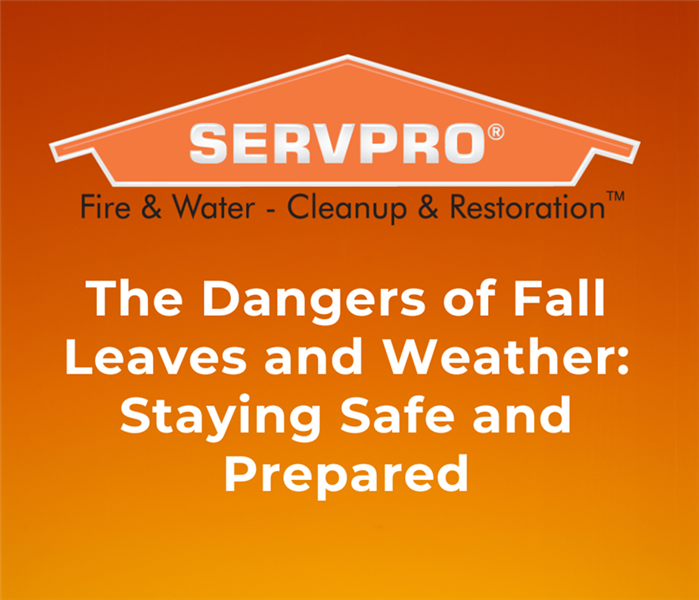 While fall is a beautiful and enjoyable season, it's essential to be aware of the potential dangers associated with falling leaves
While fall is a beautiful and enjoyable season, it's essential to be aware of the potential dangers associated with falling leaves
Fall is a magical season, with its vibrant foliage and cooler temperatures making it a favorite for many. Here are potential hazards associated with fall leaves and weather.
- Slippery Leaves: While the sight of colorful leaves blanketing the ground is picturesque, it can also be treacherous. Fallen leaves can become wet and create slippery surfaces, posing a significant risk for slips and falls. This is especially true in areas with heavy foot traffic, such as sidewalks and driveways.
Keep walkways clear of leaves and debris, and use a leaf blower or rake to prevent accumulation.
- Reduced Visibility: The shorter days of fall mean less daylight, which can affect visibility for both pedestrians and drivers. Leaves can obstruct sidewalks and roadways, making it challenging to see potential hazards.
Wear bright clothing or reflective accessories when walking or biking in low-light conditions. Ensure your vehicle's headlights and taillights are in working order.
- Wet and Slippery Roads: As fall progresses, rainy and stormy weather becomes more frequent. Wet leaves on the road can create slippery conditions for drivers, leading to accidents.
Slow down when driving on wet roads covered with leaves and maintain a safe following distance from other vehicles. Ensure your tires are in good condition to provide proper traction.
- Increased Allergens: Fall leaves can trigger allergies for some individuals, as they release mold spores and other allergens into the air. This can lead to symptoms such as sneezing, congestion, and itchy eyes.
If you have allergies, consider using air purifiers in your home and keeping windows closed on windy days. Consult with an allergist for advice on managing your allergies during the fall season.
- Temperature Fluctuations: Fall is a season of temperature fluctuations, with chilly mornings and warm afternoons. Sudden drops in temperature can catch people off guard, potentially leading to cold-related illnesses.
Dress in layers to stay warm in the morning and shed layers as the day warms up. Carry a light jacket or sweater for unexpected temperature changes.
- Fallen Branches and Trees: Strong winds and storms can cause trees and branches to fall. This poses a significant danger to people, vehicles, and property.
Inspect trees on your property for signs of damage or weakness, and trim branches that could potentially fall. During windy weather, avoid standing under trees and park your car away from large trees.
While fall is a beautiful and enjoyable season, it's essential to be aware of the potential dangers associated with falling leaves and changing weather. By taking precautionary measures and staying informed about weather conditions, you can ensure a safe and pleasant autumn for yourself and your loved ones.
SERVPRO Of Norwood West Roxbury is The #1 Choice in Cleanup and Restoration for residential and commercial buildings’ fire, mold, water, and storm damage. If you are looking for assistance, just click on the contact us page, and someone will be in touch shortly.
Dealing with Mold: Your Comprehensive Guide to Mold Remediation
9/6/2023 (Permalink)
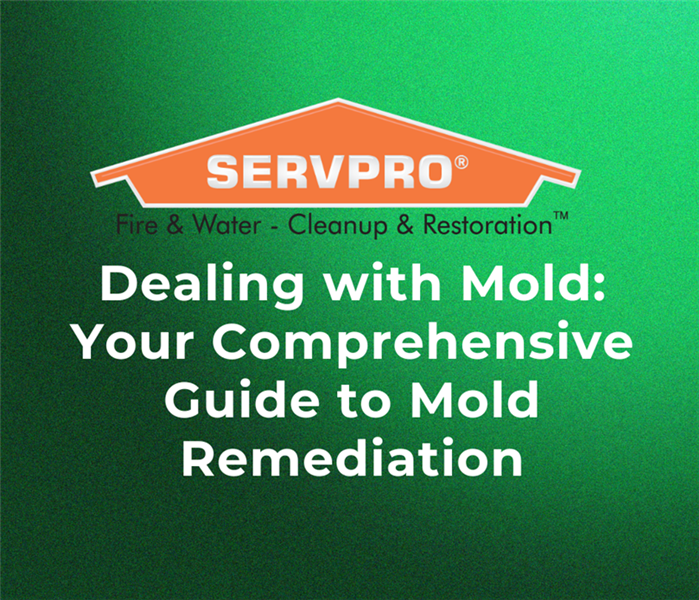 Here is what to do if you discover mold in your home and how to effectively tackle this issue.
Here is what to do if you discover mold in your home and how to effectively tackle this issue.
Mold thrives in damp, dark, and humid environments, making basements, bathrooms, and kitchens susceptible areas. Here is what to do if you discover mold in your home and how to effectively tackle this issue.
- Identify the Mold: Before you can effectively deal with mold, you need to identify the type and extent of the infestation. There are various types of mold, with some being more harmful than others. Common indoor molds include black mold (Stachybotrys chartarum), green mold (Aspergillus), and white mold (Penicillium). If you are unsure about the type of mold you are dealing with, consider hiring a professional mold inspector who can provide an accurate assessment.
- Safety First: When dealing with mold, safety should be your top priority. Mold can release harmful spores and mycotoxins into the air, which can be dangerous when inhaled. To protect yourself, follow these safety precautions:
- Wear protective gear, including an N95 respirator, gloves, and eye protection.
- Isolate the contaminated area to prevent mold spores from spreading to other parts of your home.
- Ensure proper ventilation by opening windows and doors to allow fresh air to circulate.
- Remove Moisture Sources: Mold thrives in moist environments, so the first step in mold remediation is to identify and eliminate the source of moisture. Fix any leaks, repair roof damage, and improve ventilation in damp areas like basements and bathrooms. A dehumidifier can also help reduce humidity levels in your home.
- Cleaning and Mold Removal: The method of mold removal depends on the extent of the infestation and the affected materials. Here are some general steps to follow:
- For small surface mold growth, clean the affected area with a mixture of soap and water or a commercial mold cleaner.
- For larger infestations, you may need to remove and replace contaminated materials, such as drywall, insulation, or carpet. Be cautious not to disturb the mold, as this can release more spores into the air.
- Consider Professional Help: If the mold problem is extensive, toxic mold is suspected, or you have health concerns, it's advisable to hire a professional mold remediation service. These experts have the necessary equipment and expertise to safely and effectively remove mold from your home.
After you have successfully removed the mold, take steps to prevent it from returning:
- Maintain proper ventilation and humidity levels in your home.
- Regularly inspect and repair any leaks or water damage.
- Clean and dry damp areas promptly.
- Use mold-resistant materials in areas prone to moisture.
Dealing with mold can be a daunting task, but with the right knowledge and precautions, you can effectively address the issue and protect your home and health. Remember that safety should always come first, and when in doubt, seek professional assistance. By identifying and addressing the source of the problem and following proper remediation procedures, you can create a healthier living environment for you and your family.
SERVPRO Of Norwood West Roxbury is The #1 Choice in Cleanup and Restoration for residential and commercial buildings’ fire, mold, water, and storm damage. If you are looking for assistance, just click on the contact us page, and someone will be in touch shortly.
Dealing with Water Damage: A Comprehensive Guide
9/6/2023 (Permalink)
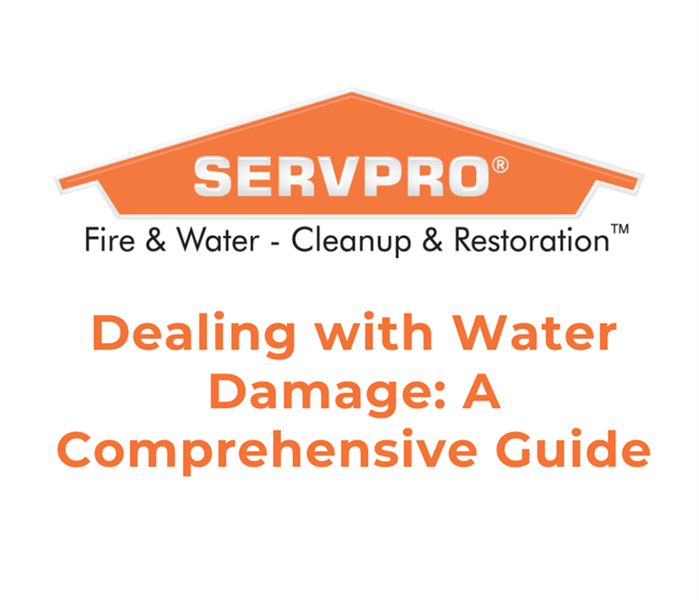 Whether it's from a burst pipe, a leaky roof, a flood, or any other source, the aftermath of water damage can be overwhelming.
Whether it's from a burst pipe, a leaky roof, a flood, or any other source, the aftermath of water damage can be overwhelming.
Whether it's from a burst pipe, a leaky roof, a flood, or any other source, the aftermath of water damage can be overwhelming. With the right knowledge and quick action, you can minimize the damage and ensure a smoother recovery process. Here are the essential steps to take when faced with water damage.
Ensure Safety First: Turn off the power to the affected area to avoid electrical hazards. If necessary, wear protective gear such as rubber gloves and waterproof boots to prevent contact with contaminated water.
Identify the Source and Stop It: Determine the source of the water and take immediate steps to stop it. If it's a burst pipe, turn off the water supply to that area or the entire house. For roof leaks, place buckets or tarps to divert water away from the damaged area temporarily.
Document the Damage: Take photographs or videos of the water damage before you begin cleanup or contact your insurance company. Proper documentation can help support your insurance claim.
Call Your Insurance Company: Contact your homeowner's insurance provider as soon as possible to report the water damage. Provide them with all the necessary information, including photos and videos, so they can initiate the claims process. Be sure to ask about the specific coverage and deductible for water damage in your policy.
Remove Water and Moisture: The longer water sits, the more damage it can cause. Begin the drying process immediately by removing excess water using pumps, wet/dry vacuums, or towels. Open windows and doors to encourage ventilation and help speed up the drying process.
Salvage Valuables: Remove valuable and sentimental items from the affected area to prevent further damage. Furniture, electronics, and personal belongings should be relocated to a dry and safe place.
Prevent Mold Growth: Mold can start growing within 24 to 48 hours after water damage occurs. To prevent mold growth, thoroughly dry and disinfect the affected area. Use fans and dehumidifiers to reduce humidity levels, and consider using mold-resistant products during repairs.
Assess Structural Damage: Check for any structural damage that may have occurred due to the water. This includes inspecting walls, ceilings, floors, and the foundation. If you suspect structural issues, consult with a professional contractor or engineer.
Repair and Restore: Once the affected area is completely dry, you can start the repair and restoration process. Depending on the extent of the damage, you may need to replace drywall, insulation, flooring, or other structural components. Work with reputable contractors or restoration specialists to ensure quality repairs.
Prevent Future Water Damage: After the cleanup and restoration are complete, take steps to prevent future water damage. Regularly inspect your home for leaks, maintain your plumbing system, and consider installing a sump pump or backflow preventer if you're in a flood-prone area.
Dealing with water damage can be stressful, but by following these steps and acting quickly, you can minimize the damage and ensure a smoother recovery process. Remember that safety should always be your top priority, and seeking professional help when needed can make a significant difference in the outcome. With proper precautions and a well-executed plan, you can restore your home to its former glory and safeguard it against future water damage.
SERVPRO Of Norwood West Roxbury is The #1 Choice in Cleanup and Restoration for residential and commercial buildings’ fire, mold, water, and storm damage. If you are looking for assistance, just click on the contact us page, and someone will be in touch shortly.
3 Top Causes of Fall Water in Norwood West Roxbury, MA Damage
8/23/2023 (Permalink)
 The fall season poses unique challenges for homeowners, with rainfall, fallen leaves, and temperature fluctuations leading to various sources of water
The fall season poses unique challenges for homeowners, with rainfall, fallen leaves, and temperature fluctuations leading to various sources of water
The fall season poses unique challenges for homeowners, with rainfall, fallen leaves, and temperature fluctuations leading to various sources of water damage. Here are the three top causes of fall water damage and how to prevent them to safeguard our homes during this season.
The abundance of falling leaves, twigs, and debris during autumn can easily accumulate in gutters and downspouts, obstructing the proper flow of rainwater. When gutters are clogged, rainwater cannot be efficiently directed away from the roof and foundation of the house, causing potential leaks and water seepage.
Prevention Tips:
- Regularly clean gutters and downspouts, especially during the fall season.
- Trim trees near your house to minimize the number of leaves falling onto the roof and gutters.
- Check for any signs of damage to the gutters and downspouts, and promptly repair or replace any compromised sections.
- As temperatures fluctuate during fall, any cracks or gaps in the exterior of your home can become potential entry points for water.
- Inspect the exterior of your home thoroughly, paying close attention to vulnerable areas like the roof, siding, and foundation.
- Ensure that the seals around windows and doors are intact.
- Maintain proper ventilation in attics and crawl spaces to regulate temperature and humidity, reducing the risk of moisture-related damage.
Clogged gutters and downspouts, water seepage through cracks and gaps, and a leaking roof are three common culprits that can wreak havoc during this season. Regular inspections, proper maintenance, and timely repairs are key to safeguarding our homes and ensuring a worry-free autumn experience.
When it comes to cleanup and restoration services for fire, mold, water, and storm damage in both residential and commercial buildings, SERVPRO of Norwood West Roxbury proudly holds the top position as the number one choice. Our services extend to various areas, including Dedham, East Dedham, Endicott, Medfield, Norwood Centre, Norwood, Walpole, MA, and Westwood, MA. Trust us to provide unparalleled expertise and dedication to bring your property back to its original condition.
Protect Your Home Against a Flood in Norwood West Roxbury, MA: Essential Tips to Safeguard Your Abode
8/16/2023 (Permalink)
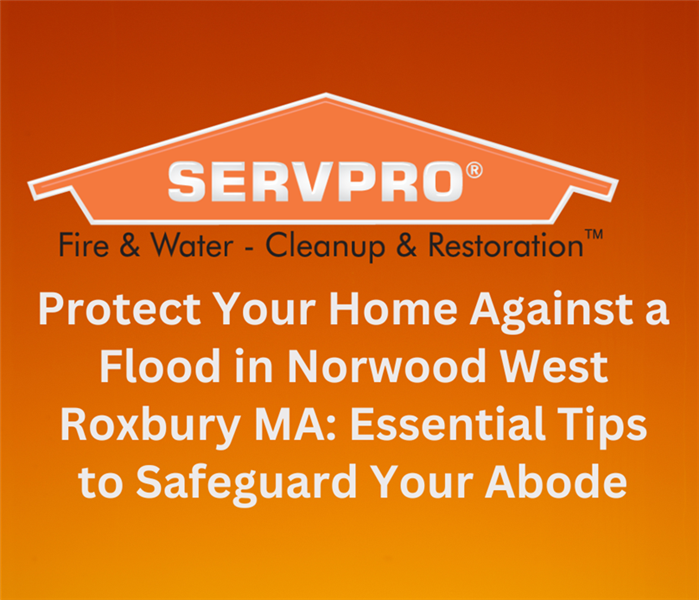 Cleanup and restoration services for fire, mold, water, and storm damage in both residential and commercial buildings, SERVPRO of Norwood West Roxbury
Cleanup and restoration services for fire, mold, water, and storm damage in both residential and commercial buildings, SERVPRO of Norwood West Roxbury
Floods are among the most destructive and devastating natural disasters. Here are some essential tips and strategies to safeguard your home and loved ones from the destructive force of floods.
- Understand the Flood Risk in Your Area: The first step in flood protection is to understand the flood risk in your area. Check local flood maps and seek information from relevant authorities about historical flood events in your region.
- Elevate Electrical Systems: Electrical systems are highly vulnerable during floods and can pose a significant safety hazard. Hire a professional electrician to elevate all electrical outlets, switches, sockets, and wiring above the expected flood levels.
- Waterproof Your Basement: Basements are highly susceptible to flooding due to their location below ground level. Seal any cracks in the foundation and walls to prevent water seepage. Consider installing a sump pump to remove any accumulated water.
- Elevate Appliances and Furnishings: Raise your valuable appliances, including washers, dryers, water heaters, and furnaces, on elevated platforms to keep them above potential floodwaters.
- Install Flood Barriers and Sandbags: Temporary flood barriers and sandbags can act as a first line of defense during a flood event. Stock up on sandbags and know how to properly stack and place them around vulnerable areas, such as doors and windows, to create a barrier against incoming water.
- Secure Sewage Backflow Valves: During severe floods, there's a risk of sewage backflow, which can lead to contamination and further damage. Installing sewage backflow valves in your home's plumbing system can help prevent sewage from entering your property.
- Create Adequate Drainage: Ensure that your property has proper drainage systems in place to direct water away from your home's foundation. Clean gutters, downspouts, and drains regularly to prevent blockages that may lead to water pooling around your home.
- Elevate Outdoor Utilities: Just like indoor electrical systems, outdoor utilities such as air conditioning units and fuel tanks should be raised above potential flood levels to minimize damage and reduce safety risks.
- Purchase Flood Insurance: Standard homeowner's insurance policies usually do not cover flood damage. It's essential to invest in separate flood insurance coverage to protect your home and belongings in case of a flood event.
While we cannot control natural disasters like floods, we can take proactive steps to protect our homes and loved ones from their devastating effects. By understanding the flood risk in our area and implementing the above-mentioned flood protection measures, we can significantly reduce the potential impact of floods on our homes.
When it comes to cleanup and restoration services for fire, mold, water, and storm damage in both residential and commercial buildings, SERVPRO of Norwood West Roxbury proudly holds the top position as the number one choice. Our services extend to various areas, including Dedham, East Dedham, Endicott, Medfield, Norwood Centre, Norwood, Walpole, MA, and Westwood, MA. Trust us to provide unparalleled expertise and dedication to bring your property back to its original condition.
5 Things Not to Do After a Fire Damages Your Home in Norwood West Roxbury, MA.
8/6/2023 (Permalink)
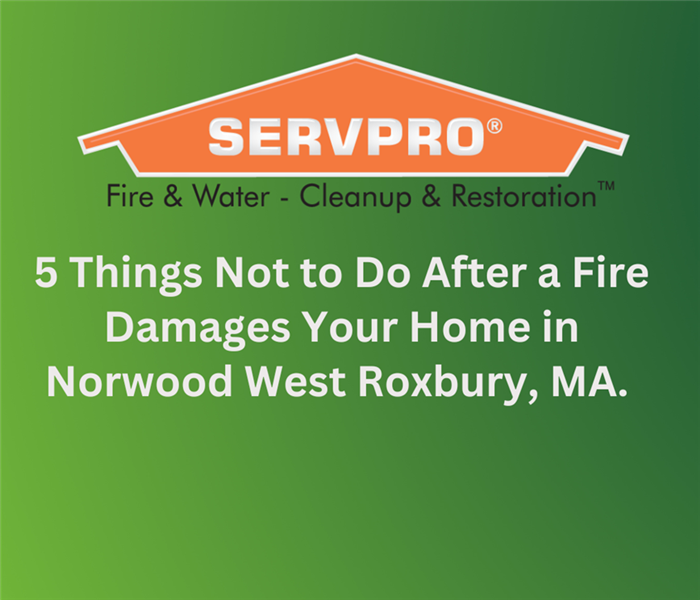 After the fire is extinguished and the immediate danger is over, it's essential to approach the situation with caution and a clear plan.
After the fire is extinguished and the immediate danger is over, it's essential to approach the situation with caution and a clear plan.
Experiencing a house fire is a devastating event that can leave you feeling overwhelmed and uncertain about what steps to take next. After the fire is extinguished and the immediate danger is over, it's essential to approach the situation with caution and a clear plan. While the desire to start restoring your home may be strong, there are several critical mistakes you should avoid to ensure a smoother recovery process.
- Entering the Property Without Proper Clearance: After a fire, your instinct may be to rush back into your home to assess the damage and retrieve valuables. However, entering the property without proper clearance from the fire department or relevant authorities can be extremely dangerous. Structural instability, hidden pockets of fire, toxic fumes, and weakened support beams are just a few of the hazards that might be present. Always wait for the official go-ahead before reentering your home to ensure your safety and that of emergency responders.
- Attempting DIY Repairs: Restoring your home after a fire requires professional expertise due to the complexity of the damage. While it's natural to want to start cleaning up immediately, attempting DIY repairs without the necessary knowledge and equipment can lead to further damage and compromise the integrity of your home. Instead, consult with licensed contractors or restoration specialists experienced in fire damage recovery. They will have the expertise and tools needed to assess the situation correctly and carry out safe and effective restoration work.
- Ignoring Smoke and Soot Damage: The aftermath of a fire often leaves behind extensive smoke and soot damage that may not be immediately apparent. Ignoring these lingering issues can lead to long-term problems, including health hazards and deterioration of materials. Smoke and soot particles can seep into walls, upholstery, and ventilation systems, causing respiratory issues and unpleasant odors. Engage professional cleaning services equipped to handle fire-related residues to ensure that your home is thoroughly cleaned and deodorized.
- Failing to Notify Your Insurance Company Promptly: Your homeowner's insurance policy is there to help you during such challenging times, but to maximize your claim and coverage, it's crucial to notify your insurance company promptly. Delaying the reporting of the fire or providing incomplete information may lead to complications and delays in receiving the necessary funds for the restoration process. Reach out to your insurance provider as soon as possible, providing detailed documentation of the damage and any valuable items that were lost.
- Disposing of Damaged Items Prematurely: Amidst the chaos of a fire-damaged home, it's tempting to discard ruined items quickly. However, it's essential to document the damage thoroughly before disposing of anything. Take photographs and make a detailed inventory of damaged belongings as evidence for your insurance claim. Your insurance adjuster may need this information to process your claim accurately. Moreover, some items may be salvageable through professional restoration services, potentially saving you money in replacement costs.
Experiencing a fire and the aftermath of its damage is an emotional and challenging ordeal. While the desire to start rebuilding your life is natural, it's essential to approach the recovery process cautiously and avoid certain mistakes. Remember not to enter your property until it's deemed safe, enlist the help of professionals for restoration work, promptly inform your insurance company, and document the damage thoroughly.
When it comes to cleanup and restoration services for fire, mold, water, and storm damage in both residential and commercial buildings, SERVPRO of Norwood West Roxbury proudly holds the top position as the number one choice. Our services extend to various areas, including Dedham, East Dedham, Endicott, Medfield, Norwood Centre, Norwood, Walpole, MA, and Westwood, MA. Trust us to provide unparalleled expertise and dedication to bring your property back to its original condition
Restoring Brilliance: A Comprehensive Guide to Rebuilding After Water Damage
7/7/2023 (Permalink)
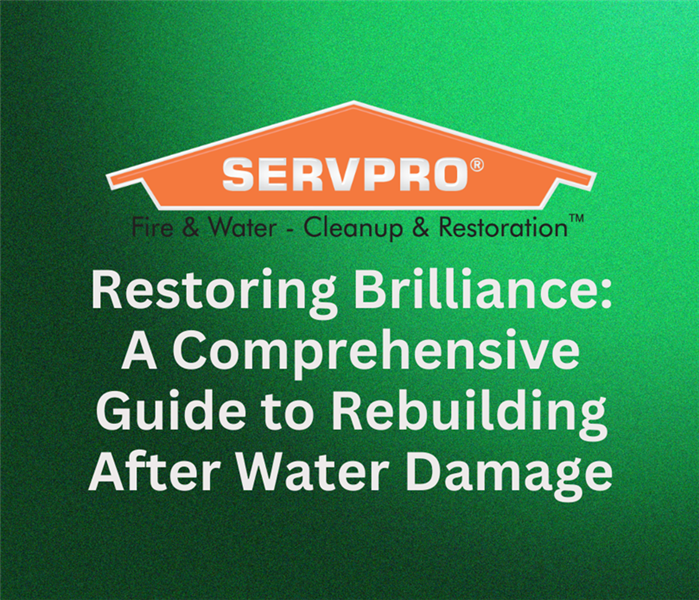 This step-by-step guide presents a comprehensive approach to rebuilding a building after water damage
This step-by-step guide presents a comprehensive approach to rebuilding a building after water damage
Water damage can have devastating consequences for any building, wreaking havoc on its structural integrity, functionality, and aesthetics. Whether caused by floods, burst pipes, or leaks, addressing the aftermath of water damage requires immediate action and careful planning to ensure successful restoration. This step-by-step guide presents a comprehensive approach to rebuilding a building after water damage, guaranteeing a safe, efficient, and visually appealing transformation.
Step 1: Evaluate the Scope of Damage: Before initiating the rebuilding process, it is crucial to conduct a thorough evaluation of the water damage. Seek the expertise of professional inspectors or reputable restoration companies to determine the extent of structural, electrical, and mold-related harm. This assessment will provide valuable insights needed to plan the restoration effectively.
Step 2: Prioritize Safety: Safety should always be the foremost concern when working on a water-damaged building. Before entering the premises, ensure that the electrical power is shut off to prevent potential hazards. Take necessary precautions to avoid slips, falls, and exposure to contaminated water. Utilize appropriate personal protective equipment (PPE) such as gloves, masks, and boots.
Step 3: Water Extraction and Drying: Water removal is a critical step in the restoration process. Utilize industrial-grade pumps, wet vacuums, and dehumidifiers to eliminate standing water from affected areas. Promote proper air circulation by opening windows, using fans, and employing specialized drying equipment. Eliminating excess moisture is imperative to prevent mold growth and further damage to the structure.
Step 4: Mold Remediation: Moisture-laden environments provide ideal conditions for mold growth. If mold is detected, consult professionals experienced in mold remediation. They will assess the extent of mold contamination, conduct thorough cleaning, and ensure proper ventilation to prevent future mold outbreaks. Taking prompt action will protect the health of occupants and preserve the building's integrity.
Step 5: Structural Repairs: Once the affected areas are dry and mold-free, it's time to address structural damage. Engage qualified contractors or construction professionals to repair weakened walls, floors, ceilings, and foundation. Reinforce compromised structures, replace damaged materials, and ensure compliance with building codes and regulations. Conduct necessary plumbing repairs and inspections to prevent future water-related issues.
Step 6: Electrical and HVAC Systems: Water damage can significantly impact electrical and HVAC (heating, ventilation, and air conditioning) systems, posing potential safety hazards. Enlist licensed electricians and HVAC technicians to thoroughly inspect, repair, or replace damaged components. Ensure that all systems meet safety standards and regulations before reconnecting utilities.
Step 7: Interior Restoration: The rebuilding process also entails restoring the interior spaces to their former glory. Assess and replace damaged insulation, drywall, flooring, and fixtures. Repaint walls, applying mold-resistant coatings where necessary. Consider utilizing waterproof materials for added protection in the future. Consult with interior designers or decorators to envision and create functional, aesthetically pleasing spaces.
Step 8: Prevention and Preparedness: To mitigate the risk of future water damage, implement preventive measures. Install water detection systems, reinforce waterproofing measures, and regularly inspect plumbing and roof systems. Educate occupants on proactive steps to prevent water-related accidents and encourage immediate reporting of leaks or other issues.
Reconstructing a building after water damage requires meticulous planning, careful execution, and collaboration among various professionals. By following this comprehensive guide, you can navigate the restoration process confidently, ensuring the safety, functionality, and beauty of the rebuilt structure.
SERVPRO Of Norwood West Roxbury remains the top choice for cleanup and restoration services for residential and commercial buildings affected by fire, mold, water, and storm damage. Our services extend to Dedham, East Dedham, Endicott, Medfield, Norwood Centre, Norwood, Walpole, MA, and Westwood, MA.
Biohazard: Unveiling the Menace Within
7/7/2023 (Permalink)
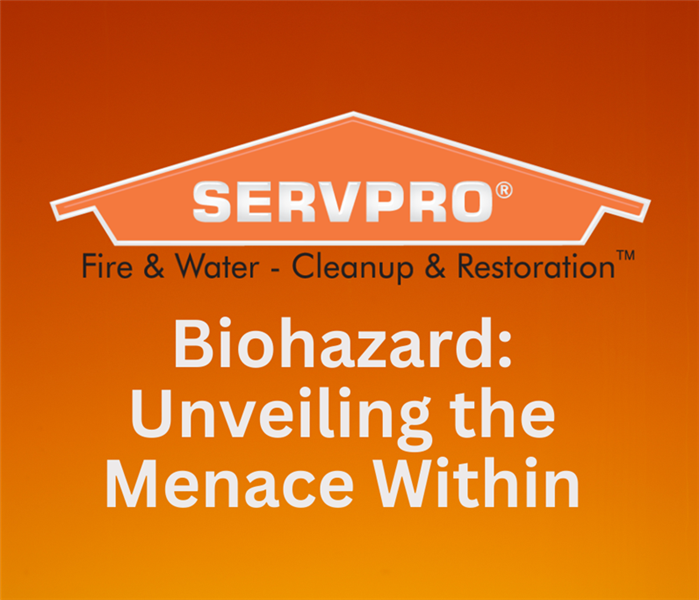 In our modern society, we constantly encounter potential dangers
In our modern society, we constantly encounter potential dangers
In our modern society, we constantly encounter potential dangers, some visible while others remain hidden to the naked eye. One such hidden threat that poses a significant risk to both human health and the environment is known as a biohazard. Biohazards refer to biological agents or substances that have the potential to harm living organisms, making them a topic of great concern in recent times. This article aims to shed light on biohazards, their various forms, and the importance of effective management to ensure our well-being.
Understanding Biohazards:
Biohazards encompass a wide range of hazardous agents, including bacteria, viruses, toxins, fungi, and other biological substances. These agents can be found in various environments such as laboratories, hospitals, industrial settings, and even natural ecosystems. What makes biohazards particularly dangerous is their ability to cause infections, diseases, and severe health complications in both humans and animals.
Types of Biohazards:
Biological Agents: This category includes pathogenic microorganisms like bacteria, viruses, fungi, and parasites. Well-known examples of biohazards include Salmonella, E. coli, HIV, influenza, and anthrax. These agents can spread through direct contact, droplets, contaminated food or water, or vectors like mosquitoes.
Biomedical Waste: Medical facilities produce significant amounts of hazardous waste, including used needles, blood-soaked materials, contaminated sharps, and pharmaceutical waste. Improper handling or disposal of these materials can lead to the spread of infections and endanger public health.
Genetically Modified Organisms (GMOs): While GMOs have their benefits in agriculture and medical research, their uncontrolled release or mishandling can have unintended consequences. Genetically altered organisms may potentially disrupt ecosystems and pose risks to native species.
Chemical Agents: Biohazards can also manifest as toxic chemicals or toxins produced by organisms. Pesticides, heavy metals, and industrial pollutants, when released into the environment, can contaminate air, water, and soil, endangering human and animal life.
Managing Biohazards:
Effective management of biohazards is crucial for protecting public health, preserving the environment, and preventing the spread of diseases. Here are key aspects of biohazard management:
Risk Assessment and Prevention: Identifying potential biohazards, evaluating their risks, and implementing preventive measures are vital. This includes proper training and education for individuals working with biohazardous materials, implementing safety protocols, and enforcing regulations to minimize exposure and transmission.
Proper Handling and Disposal: Safe handling, storage, and disposal of biohazardous materials are paramount. Strict adherence to guidelines, such as the use of personal protective equipment (PPE), decontamination procedures, and specialized waste disposal methods, help minimize the risks associated with biohazards.
Research and Development: Ongoing scientific research plays a crucial role in understanding biohazards, their behavior, and developing effective countermeasures. Investing in research and development of vaccines, antiviral drugs, and diagnostic tools aids in the prevention and management of biohazard outbreaks.
Public Awareness and Education: Educating the general public about biohazards, their potential risks, and proper precautions fosters a culture of safety and responsibility. Awareness campaigns, public health initiatives, and educational programs can empower individuals to protect themselves and their communities.
Biohazards pose a significant threat to human health, the environment, and overall well-being. Understanding the various types of biohazards, implementing effective management strategies, and promoting awareness are crucial steps toward mitigating these risks.
SERVPRO Of Norwood West Roxbury remains the top choice for cleanup and restoration services for residential and commercial buildings affected by fire, mold, water, and storm damage. Our services extend to Dedham, East Dedham, Endicott, Medfield, Norwood Centre, Norwood, Walpole, MA, and Westwood, MA.
How to Deal with Fire and Smoke Damage in a Home or Business in Norwood West Roxbury.
6/7/2023 (Permalink)
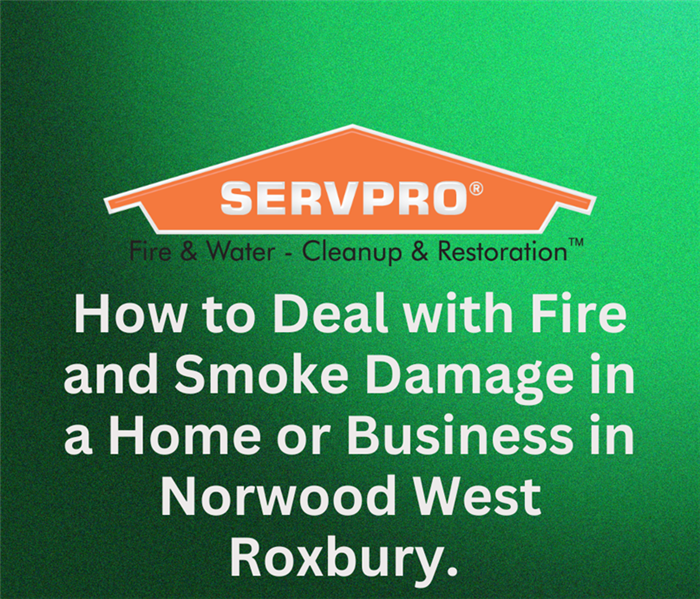 The aftermath of fire and smoke damage can present significant challenges. Here are steps to help you navigate the recovery process successfully.
The aftermath of fire and smoke damage can present significant challenges. Here are steps to help you navigate the recovery process successfully.
A fire incident in your home or business can be a traumatic event. The aftermath of fire and smoke damage can present significant challenges. Here are steps to help you navigate the recovery process successfully.
- Ensure Safety: It is crucial to wait for approval from the fire department or relevant authorities that the building is structurally safe. Wear appropriate protective gear, including masks, gloves, and eye protection, as smoke residues can contain harmful particles.
- Contact Professionals: Once the property is deemed safe to enter, contact a reputable fire damage restoration company as soon as possible, such as SERVPRO Of Norwood West Roxbury. We have the expertise, experience, and specialized equipment to handle fire and smoke damage effectively. We will assess the extent of the damage, provide guidance, and develop a comprehensive restoration plan tailored to your specific situation.
- Document the Damage: Before any cleanup or repairs take place, document the damage thoroughly. Take photographs and make a detailed inventory of all affected items and structural damage.
- Ventilate the Area: Open windows and doors to allow fresh air to circulate throughout the space. This helps to dissipate residual smoke and reduce odors. However, exercise caution if there is significant structural damage, as opening windows or doors could pose safety risks.
- Clean and Remove Soot: Soot and smoke residues can cause significant damage if left untreated. Begin by vacuuming loose soot particles using a high-efficiency particulate air (HEPA) vacuum cleaner. Avoid using regular household vacuums, as they may blow soot particles back into the air. Consider SERVPRO Of Norwood West Roxbury for thorough cleaning and restoration of delicate items such as textiles, electronics, and artwork.
- Assess and Repair Structural Damage: Evaluate the structural integrity of your property and address any immediate concerns. Seek assistance from a licensed contractor or structural engineer to determine the extent of the damage and develop a plan for repairs or rebuilding.
- Eliminate Odors: Begin by airing out the space and using fans or dehumidifiers to promote air circulation. Deep clean carpets, upholstery, and curtains to eliminate embedded smoke particles.
Remember to remain patient and resilient throughout the recovery process, as restoring your property to its preloss condition may take time.
SERVPRO Of Norwood West Roxbury is The #1 Choice in Cleanup and Restoration for residential and commercial buildings’ fire, mold, water, and storm damage. We service Dedham, East Dedham, Endicott, Medfield, Norwood Centre, Norwood, Walpole, MA, and Westwood, MA
How to Check Your Roof for Storm Damage Norwood West Roxbury, MA
6/7/2023 (Permalink)
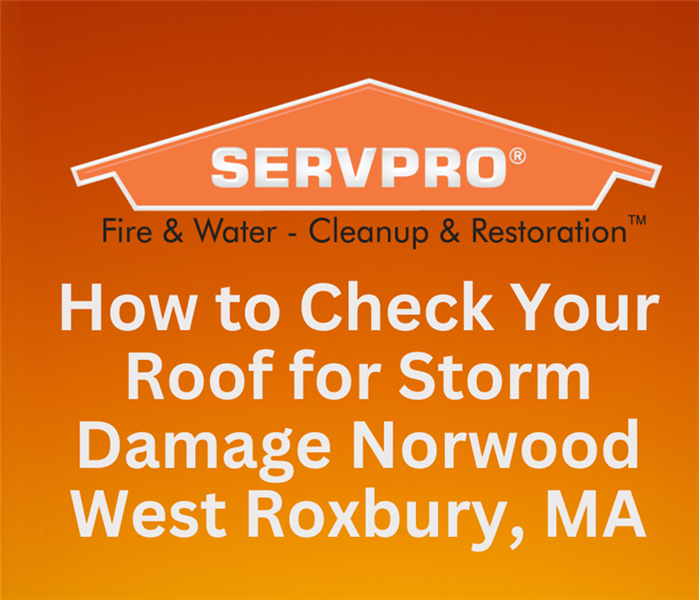 High winds, hail, and heavy rain can cause significant damage that, if left unnoticed, may lead to costly repairs.
High winds, hail, and heavy rain can cause significant damage that, if left unnoticed, may lead to costly repairs.
High winds, hail, and heavy rain can cause significant damage that, if left unnoticed, may lead to costly repairs or even compromise the safety of your home. Make sure to take precautions before inspecting your roof:
- Wait for the storm to pass completely and ensure it's safe to go outside.
- Use a sturdy ladder and have someone else present to assist or monitor your activity.
- Wear appropriate protective gear, such as gloves and non-slip shoes.
- Check if any shingles are torn, cracked, or completely missing.
- Flashing is the metal strip used to seal joints and prevent water penetration. Check for any loose or damaged flashing around chimneys, vents, or skylights.
- Inspect your gutters for granules or small pieces of shingles, which may indicate damage.
- Ensure that gutters and downspouts are securely attached and not clogged with debris.
- Check the chimney cap for any cracks or missing sections.
- Carefully examine the attic for water stains, leaks, or signs of moisture.
- Check the insulation for dampness or mold growth, which can be indications of a damaged roof.
- Look for water stains or discoloration on the ceilings and walls of the top floor. These can signify a roof leak.
Checking your roof for storm damage is a vital step in maintaining the structural integrity and safety of your home Norwood West Roxbury, MA. Taking proactive measures after a storm can save you from significant expenses down the road while ensuring the long-lasting protection of your home.
SERVPRO Of Norwood West Roxbury is The #1 Choice in Cleanup and Restoration for residential and commercial buildings’ fire, mold, water, and storm damage. We service Dedham, East Dedham, Endicott, Medfield, Norwood Centre, Norwood, Walpole, MA, and Westwood, MA
Can Mold Cause A Smell To The House?
5/23/2023 (Permalink)
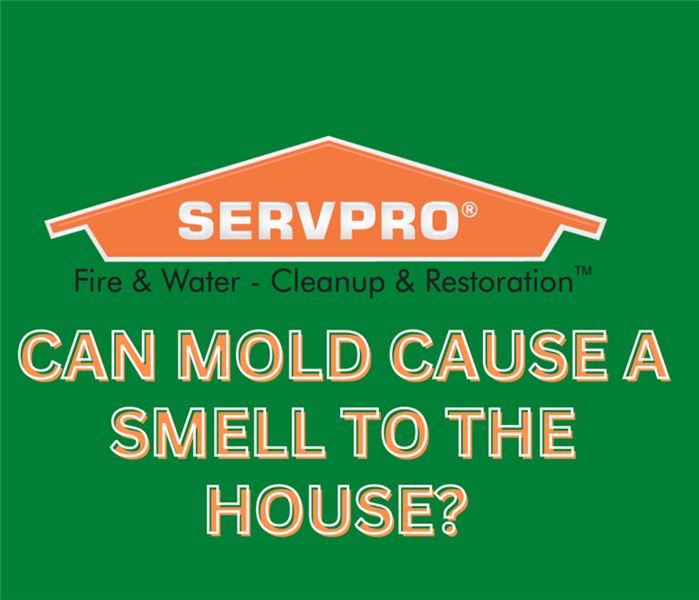 If you discover mold in your home, it's important to take action to remove it as soon as possible.
If you discover mold in your home, it's important to take action to remove it as soon as possible.
Not only can mold cause damage to your home and pose health risks, but it can also create a foul smell that can be difficult to get rid of. Here is what you can do to prevent mold.
What Causes the Smell?
Mold releases a musty odor that can be quite unpleasant. This smell is caused by the chemicals released by mold as it grows and breaks down organic matter. Mold thrives in damp environments, such as bathrooms, basements, and areas with water damage. If you notice a musty odor in your home, it could be a sign that mold is present.
Health Risks Associated with Mold.
Mold not only creates a foul smell but can also pose health risks to you and your family. Exposure to mold can cause allergic reactions, respiratory problems, and other health issues. Children, the elderly, and people with weakened immune systems are particularly vulnerable to mold-related health problems. If you suspect that mold is present in your home, it's important to take action to address the issue as soon as possible.
Here are some steps you can take to prevent mold growth in your home:
- Reduce humidity levels: Mold thrives in humid environments, so it's important to keep humidity levels low. Use dehumidifiers in areas prone to moisture, such as basements and bathrooms.
- Fix leaks: Mold needs moisture to grow, so fixing any leaks in your home is crucial. Check for leaks around windows, doors, and pipes, and repair them promptly.
- Use ventilation: Proper ventilation can help prevent mold growth. Use exhaust fans in bathrooms and kitchens, and open windows to increase airflow.
- Clean regularly: Regular cleaning can help prevent mold growth. Clean surfaces regularly with a solution of bleach and water, and use mold-resistant paint in areas prone to moisture.
If you discover mold in your home, it's important to take action to remove it as soon as possible. Here are some steps you can take to remove mold:
- Identify the source: Identify the source of the moisture that's causing the mold to grow. Fix any leaks or water damage before removing the mold.
- Use protective equipment: Wear protective equipment, such as gloves and a mask, to avoid inhaling mold spores.
- Clean surfaces: Clean surfaces with a solution of bleach and water. Use a scrub brush to remove the mold from porous surfaces, such as drywall.
- Dry the area: After cleaning the mold, dry the area thoroughly to prevent the mold from returning.
Prevention is key when it comes to dealing with mold. Reduce humidity levels, fix leaks, use ventilation, and clean regularly to prevent mold growth. If you discover mold in your home, take action to remove it promptly.
SERVPRO Of Norwood West Roxbury is The #1 Choice in Cleanup and Restoration for residential and commercial buildings’ fire, mold, water, and storm damage.
We service Blackstone, Hopedale, Mendon, Milford, Natick, North Natick, and South Natick MA.
Does My Home Need A Rebuild After A Fire?
5/18/2023 (Permalink)
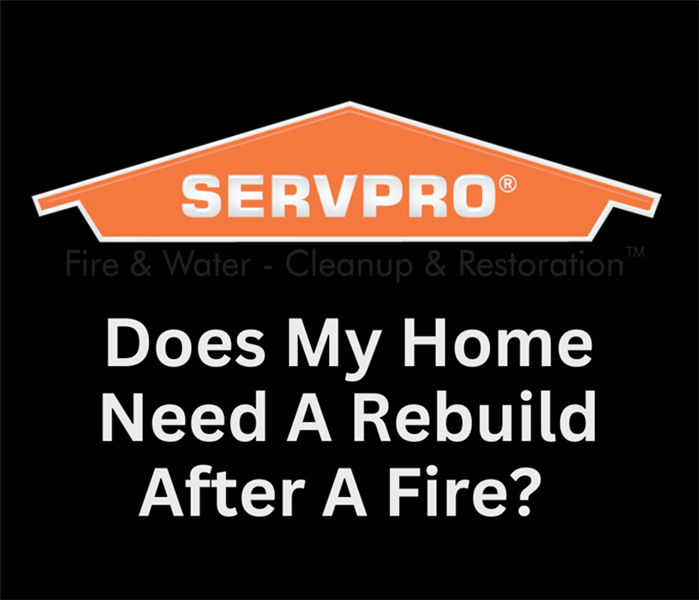 Experiencing a fire in your home is a traumatic experience, and the decision to rebuild can be a difficult one.
Experiencing a fire in your home is a traumatic experience, and the decision to rebuild can be a difficult one.
Experiencing a fire in your home is an overwhelming and devastating event. In addition to the emotional toll, there are numerous practical and logistical considerations that must be addressed. One of the most pressing questions is whether or not your home needs to be rebuilt after a fire.
- The first step in deciding whether or not your home needs to be rebuilt after a fire is to determine the extent of the damage. A thorough assessment should be conducted by a qualified professional to determine the damage to the structure, electrical and plumbing systems, and any other systems or appliances affected by the fire. In some cases, the damage may be limited to a particular area of the home, and repairs can be made without needing a full rebuild. However, if the damage is extensive, and the cost of repairs is significant, it may be more practical to rebuild the home from scratch.
- Once the extent of the damage has been determined, the next step is to assess the cost of repairs versus rebuilding. In some cases, the cost of repairs may be relatively minor and can be covered by insurance. However, if the damage is extensive, the cost of repairs may exceed the value of the home, making a rebuild a more practical solution.
- Navigating the process of rebuilding your home after a fire can be complex and challenging. Working with your insurance company and qualified contractors can help to ensure that the process goes smoothly and that your home is rebuilt to the highest standards.
- Experiencing a fire in your home is a traumatic experience, and the decision to rebuild can be a difficult one. However, by assessing the extent of the damage, weighing the cost of repairs versus rebuilding, and working with qualified professionals, you can make an informed decision and begin the process of rebuilding your home and your life.
SERVPRO Of Norwood West Roxbury is The #1 Choice in Cleanup and Restoration for residential and commercial buildings’ fire, mold, water, and storm damage.
We service Blackstone, Hopedale, Mendon, Milford, Natick, North Natick, and South Natick MA.
What To Do If My Smoke Detector Goes Off?
5/18/2023 (Permalink)
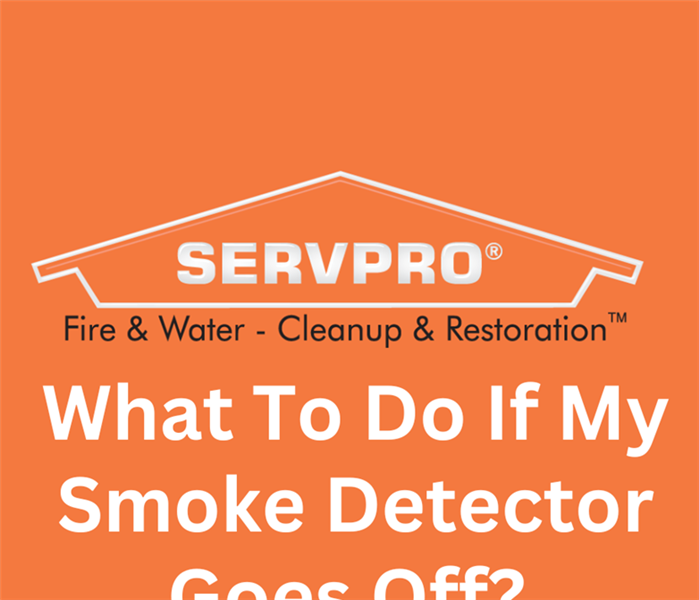 Smoke detectors can go off even when there is no actual fire.
Smoke detectors can go off even when there is no actual fire.
Smoke detectors are one of the most essential safety devices in any home. They are designed to alert you to the presence of smoke, which could be an indication of a fire. However, sometimes smoke detectors can go off even when there is no actual fire. This can be due to a variety of reasons such as cooking smoke, steam, or even dust. Here are some steps to take if your smoke detector goes off.
- Stay Calm: The first and most important thing to do is to stay calm. The loud, piercing sound of a smoke detector can be very unsettling and cause panic. However, it's important to remain calm so you can think clearly and take appropriate action.
- Determine the Source of the Smoke: Once you're calm, try to determine the source of the smoke. If you see smoke or smell something burning, then there may be a fire. However, if you don't see or smell anything, then the smoke detector may be triggered by something else. Check the room for any signs of smoke or fire.
- Silence the Alarm: If you determine that there is no actual fire, then you can silence the alarm. Most smoke detectors have a button that you can press to silence the alarm. If you're not sure which button to press, refer to the user manual.
- Ventilate the Room: If there was no actual fire, then you should ventilate the room to clear out any smoke or steam. Open a window or turn on a fan to help disperse the smoke.
- Check the Batteries: If the smoke detector continues to go off, then it may be due to low batteries. Check the batteries and replace them if necessary.
- Call for Help: If you determine that there is an actual fire, then you should call for help immediately. Call 911 or your local emergency number and provide them with your location and details about the fire.
Smoke detectors are an essential safety device in any home. If your smoke detector goes off, stay calm, determine the source of the smoke, silence the alarm, ventilate the room, check the batteries, and call for help if necessary. Remember to test your smoke detectors regularly to ensure they are functioning properly.
SERVPRO Of Norwood West Roxbury is The #1 Choice in Cleanup and Restoration for residential and commercial buildings’ fire, mold, water, and storm damage.
We service Blackstone, Hopedale, Mendon, Milford, Natick, North Natick, and South Natick MA.
What Should You Do If A Grill Is On Fire?
5/16/2023 (Permalink)
 One of the most common safety hazards when grilling is a fire breaking out.
One of the most common safety hazards when grilling is a fire breaking out.
Grilling is a great way to enjoy delicious food and spend time outdoors with friends and family. One of the most common safety hazards when grilling is a fire breaking out. Here are the steps to take if a grill is on fire:
- Turn off the burners: If the fire is contained in one area of the grill, turn off the burners in that area. This will help prevent the fire from spreading.
- Close the lid: If the fire is larger and cannot be contained to one area, close the lid of the grill. This will help cut off the oxygen supply to the fire and reduce the flames.
- Disconnect the fuel source: If you are using a propane grill, turn off the propane tank and disconnect it from the grill. If you are using a charcoal grill, remove the charcoal from the grill.
- Use a fire extinguisher: If the fire is still burning, use a fire extinguisher to put it out. Make sure you use the correct type of fire extinguisher for the type of fire you are dealing with. For grill fires, use a Class B fire extinguisher, which is designed for flammable liquids and gases.
- Call for help: If the fire is too large to be put out with a fire extinguisher, call the fire department immediately.
- Do not use water: Never use water to put out a grease fire on a grill. This can cause the fire to spread and create a dangerous situation.
- Wait before cleaning: After the fire has been put out, wait until the grill has cooled down before cleaning it. This will prevent any remaining grease or debris from reigniting.
Remember to always be mindful of grill safety and take the necessary precautions to prevent accidents from happening.
SERVPRO Of Norwood West Roxbury is The #1 Choice in Cleanup and Restoration for residential and commercial buildings’ fire, mold, water, and storm damage.
We service Blackstone, Hopedale, Mendon, Milford, Natick, North Natick, and South Natick MA.
How To Have A Safe Bonfire
5/11/2023 (Permalink)
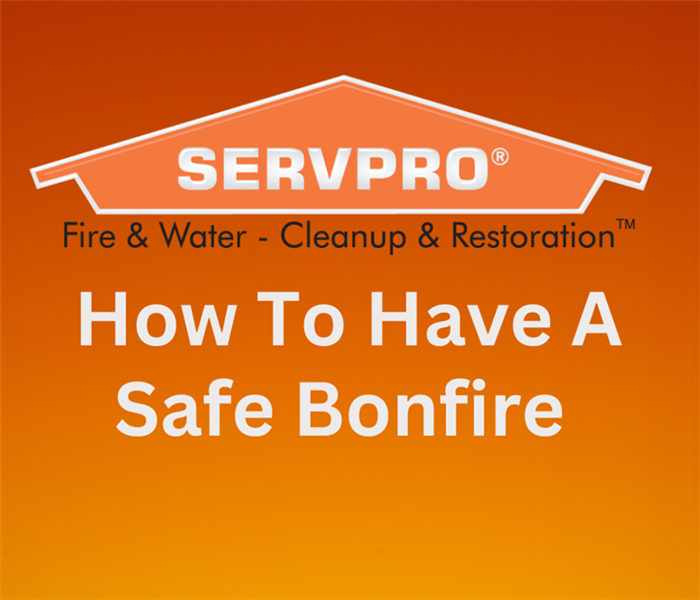 Bonfires can be a fun way to socialize, relax and create memories, but it’s important to keep safety in mind to avoid accidents and injuries.
Bonfires can be a fun way to socialize, relax and create memories, but it’s important to keep safety in mind to avoid accidents and injuries.
Bonfires can be a fun way to socialize, relax and create memories, but it’s important to keep safety in mind to avoid accidents and injuries.
- Choose a safe location: Before starting a bonfire, make sure you have a safe location. Choose a spot away from trees, shrubs, and other flammable objects. Keep at least a 10-foot radius around the fire clear of any objects that could catch fire, and be mindful of any overhanging branches or power lines.
- Check the weather: It’s important to check the weather before starting a bonfire. Avoid lighting a fire in windy conditions, as this can increase the risk of the fire spreading. Also, check for any fire restrictions or bans in your area.
- Use proper fuel: Use only dry, seasoned wood or charcoal to fuel your bonfire. Do not use gasoline, lighter fluid, or other accelerants to start the fire. These can cause flare-ups and are extremely dangerous.
- Supervise children and pets: Children and pets should be supervised at all times around the bonfire. Keep them at a safe distance from the fire and make sure they understand the dangers of playing near the flames.
- Keep a fire extinguisher or water source nearby: In case of an emergency, it’s important to have a fire extinguisher or water source nearby. Keep a bucket of water, hose, or fire extinguisher within reach of the bonfire.
- Never leave a fire unattended: Bonfires should never be left unattended. Always have someone present to monitor the fire and make sure it doesn’t get out of control.
- Properly extinguish the fire: When it’s time to put out the fire, use water to fully extinguish the flames. Make sure all embers and coals are completely extinguished before leaving the fire unattended.
By following these safety tips, you can enjoy a fun and safe bonfire experience with friends and family. Remember, safety should always come first, so take the necessary precautions to prevent accidents and injuries.
SERVPRO Of Norwood West Roxbury is The #1 Choice in Cleanup and Restoration for residential and commercial buildings’ fire, mold, water, and storm damage.
We service Blackstone, Hopedale, Mendon, Milford, Natick, North Natick, and South Natick MA.
Can Cooking Grease Cause Fires?
5/9/2023 (Permalink)
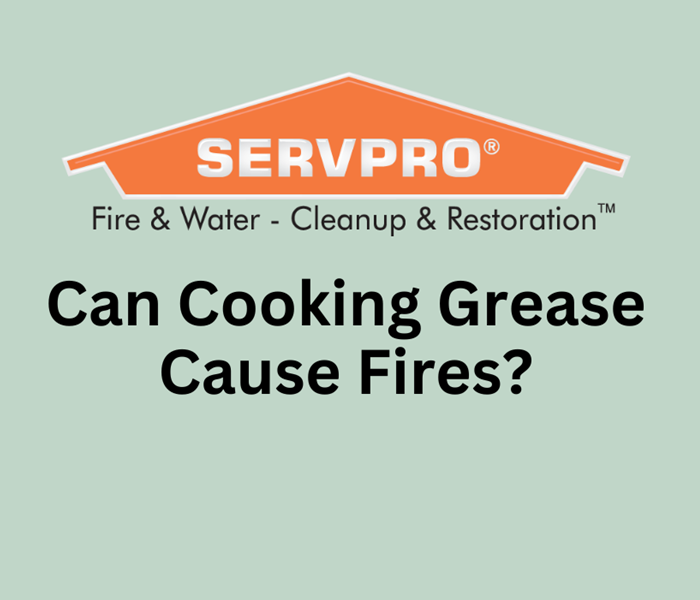 To prevent cooking grease fires, it is important to take a few simple precautions
To prevent cooking grease fires, it is important to take a few simple precautions
Cooking is a daily activity for many people, and while it can be a fun and satisfying experience, it can also be dangerous if proper safety measures are not taken. One common kitchen hazard is the risk of fires caused by cooking grease.
Cooking grease is the oil or fat that is left over after cooking, and it can be found in many different forms such as bacon grease, butter, vegetable oil, and more. It is a common ingredient in many recipes and can be very useful in the kitchen, but it can also be a serious fire hazard if not handled properly.
The reason why cooking grease is so dangerous is that it is highly flammable. If the grease becomes too hot, it can ignite and start a fire. This can happen if you leave a pan on the stove unattended or if you overheat the grease while cooking.
To prevent cooking grease fires, it is important to take a few simple precautions:
- Never leave hot grease unattended: When you are cooking with grease, it is important to stay in the kitchen and keep an eye on the pan at all times. If you need to step away, turn off the heat and remove the pan from the stove.
- Use a splatter guard: A splatter guard is a mesh screen that is placed over the top of a pan to prevent hot grease from splattering out. This can help reduce the risk of a fire.
- Keep a lid nearby: If a fire does break out, you should immediately cover the pan with a lid to smother the flames. This will help prevent the fire from spreading.
- Store grease properly: After cooking with grease, it is important to store it in a safe and secure container. This can be a metal can or a glass jar with a tight-fitting lid. Never pour grease down the drain, as this can clog pipes and cause other problems.
- Dispose of grease safely: When you are ready to dispose of the grease, wait for it to cool completely and then scrape it into a container that can be sealed. This can then be thrown away in the trash.
In addition to these precautions, it is also important to have a working fire extinguisher in the kitchen and to know how to use it. If a fire does break out, you should use the extinguisher to put out the flames. If the fire is too large or if you are not able to put it out, evacuate the building immediately and call 911.
SERVPRO Of Norwood West Roxbury is The #1 Choice in Cleanup and Restoration for residential and commercial buildings’ fire, mold, water, and storm damage.
We service Blackstone, Hopedale, Mendon, Milford, Natick, North Natick, and South Natick MA.
What Causes Microwave Fires?
5/4/2023 (Permalink)
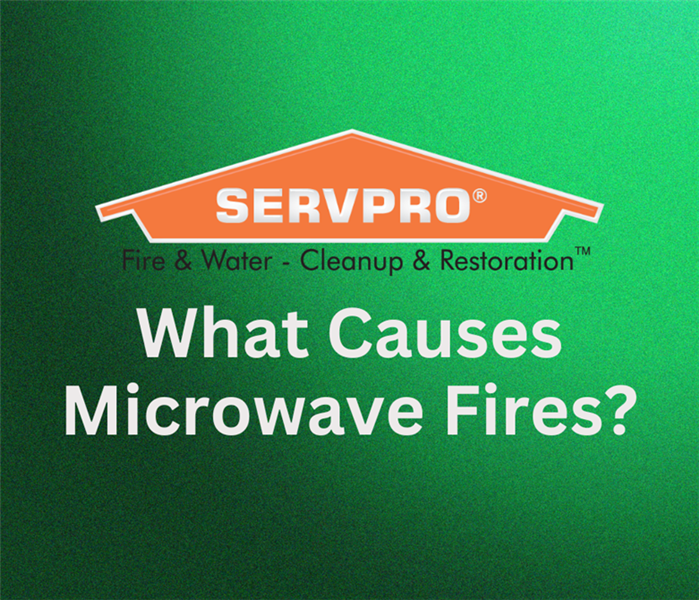 Microwave fires can be dangerous and should be avoided at all costs.
Microwave fires can be dangerous and should be avoided at all costs.
Microwaves have become an essential part of modern kitchens, allowing us to quickly heat up food and beverages. Microwaves can pose safety hazards if not used correctly. One of the most dangerous risks associated with microwaves is the possibility of a fire.
Microwave-safe containers are designed to withstand the high heat generated by the microwave, while other containers may melt, warp, or even catch fire. Common materials that are not suitable for microwaving include aluminum foil, metal, plastic containers that are not labeled as microwave-safe, and dishes with metallic or gold paint. When using a microwave, it is crucial to ensure that the containers and dishes you use are labeled as microwave-safe.
Another factor that can cause microwave fires is the buildup of grease or food residue inside the appliance. When food particles accumulate on the walls or ceiling of the microwave, they can overheat and catch fire. It is essential to clean your microwave regularly, especially after cooking greasy or fatty foods.
Overheating food can also lead to microwave fires. When food is cooked for too long, or if the microwave's power settings are set too high, the food can overheat and ignite. It is vital to follow the cooking instructions carefully and to stop cooking the food once it has reached the recommended temperature. Additionally, never leave your microwave unattended while cooking, as this can lead to overheating and potential fire hazards.
A faulty or malfunctioning microwave can also cause fires. If your microwave is making unusual noises, sparks, or emits smoke, it is essential to stop using it immediately and have it inspected by a professional. Do not attempt to repair the appliance yourself, as this can be dangerous.
Microwave fires can be dangerous and should be avoided at all costs. To prevent microwave fires, use only microwave-safe containers, keep your microwave clean, do not overheat food, and have any malfunctioning microwave inspected by a professional. By following these safety tips, you can enjoy the convenience of a microwave without putting yourself or your home at risk.
SERVPRO Of Norwood West Roxbury is The #1 Choice in Cleanup and Restoration for residential and commercial buildings’ fire, mold, water, and storm damage.
We service Blackstone, Hopedale, Mendon, Milford, Natick, North Natick, and South Natick MA.
Do you have a fire safety plan?
4/29/2023 (Permalink)
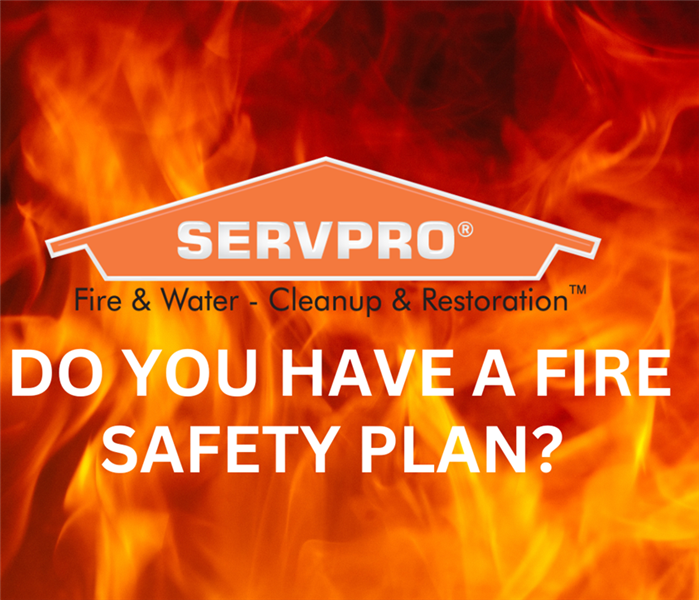 A fire safety plan is essential for keeping you and your loved ones safe in the event of a fire.
A fire safety plan is essential for keeping you and your loved ones safe in the event of a fire.
A fire safety plan is essential for keeping you and your loved ones safe in the event of a fire. Fires can happen suddenly and spread quickly, making it important to have a plan in place that everyone knows and can follow.
Why do you need a fire safety plan?
It can also help prevent injuries and property damage by ensuring that everyone knows what to do in the event of a fire. Having a plan in place can reduce panic and confusion during an emergency and increase the chances of everyone getting out safely.
How to create a fire safety plan
- Draw a floor plan: Start by drawing a floor plan for your home or workplace. Identify all exits, including doors and windows, and ensure they are easily accessible.
- Determine a meeting place: Choose a safe meeting place outside of your home or workplace where everyone can gather after evacuating. This could be a neighbor's house, a street corner, or a nearby park.
- Assign responsibilities: Assign responsibilities to each person in your household or workplace. This could include tasks such as calling 911, grabbing important documents or belongings, or assisting others in evacuating.
- Practice evacuation drills: Regularly practice evacuation drills with everyone in your household or workplace. This will help ensure that everyone knows what to do in the event of a fire and can evacuate safely and quickly.
- Install smoke detectors: Install smoke detectors on every level of your home or workplace and test them regularly to make sure they are working correctly. Replace the batteries at least once a year.
- Know how to use a fire extinguisher: Make sure that everyone in your household or workplace knows how to use a fire extinguisher and where it is located.
- Review and update the plan: Regularly review and update your fire safety plan to ensure that it is still relevant and effective. Make changes as necessary, such as adding new exits or changing responsibilities.
By creating a plan and regularly practicing evacuation drills, you can increase your chances of getting out safely and prevent injuries and property damage.
We service Dedham, East Dedham, Endicott, Medfield, Norwood Centre, Norwood, Walpole, MA, and Westwood, MA
SERVPRO Of Norwood West Roxbury is The #1 Choice in Cleanup and Restoration for residential and commercial buildings’ fire, mold, water, and storm damage.
How to prepare for a rainstorm
4/28/2023 (Permalink)
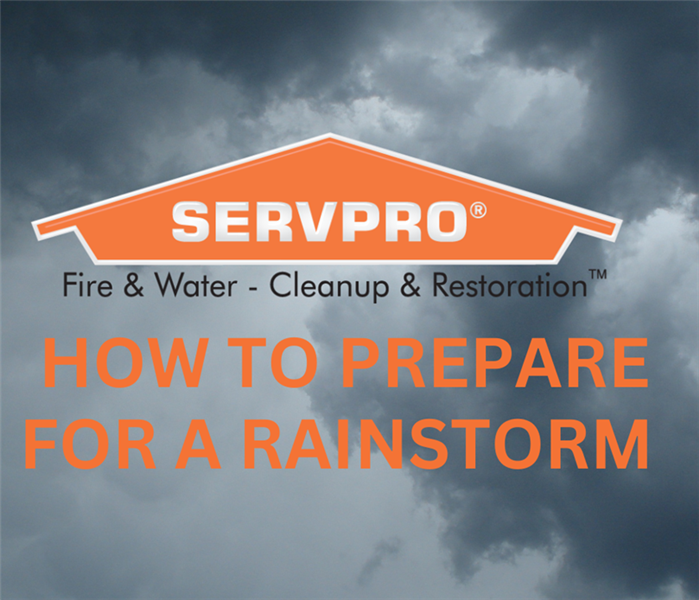 Rainstorms can come on suddenly and unexpectedly, and it's important to be prepared.
Rainstorms can come on suddenly and unexpectedly, and it's important to be prepared.
Rainstorms can come on suddenly and unexpectedly, and it's important to be prepared. Learn how to prepare for a rainstorm and what steps you can take to minimize damage and stay safe.
- Check the weather forecast: Before you head out, make sure to check the weather forecast. This will help you determine if a rainstorm is likely and when it is expected to arrive. You can plan your activities accordingly and be prepared for any changes in the weather.
- Make a plan: If you live in an area prone to heavy rain, it's important to have a plan in case of a rainstorm. This includes knowing where to go if you need to evacuate and having an emergency kit with essentials such as food, water, and a first aid kit.
- Protect your home: To protect your home from rain damage, make sure that your gutters are clear of debris and that your roof is in good condition. This will prevent water from seeping into your home and causing damage. You may also want to invest in sandbags to prevent flooding in low-lying areas.
- Pack accordingly: If you're planning a trip during the rainy season, make sure to pack accordingly. Bring rain gear such as a waterproof jacket and boots, as well as an umbrella. You may also want to pack a change of clothes and waterproof bags to keep your belongings dry.
- Secure loose items: Before a rainstorm arrives, make sure to secure any loose items outside, such as patio furniture or outdoor toys. This will prevent them from being blown away by the wind or causing damage during the storm.
- Stay indoors: During a rainstorm, it's best to stay indoors if possible. Avoid driving unless it is necessary, as rain can make roads slippery and reduce visibility. If you do need to go outside, make sure to wear appropriate rain gear and stay away from downed power lines or standing water.
- Stay informed: Finally, stay informed during a rainstorm. Listen to local news and weather reports for updates and alerts. Be aware of any potential dangers, such as flooding or landslides, and take appropriate action to stay safe.
Preparing for a rainstorm is essential for minimizing damage and staying safe.
We service Dedham, East Dedham, Endicott, Medfield, Norwood Centre, Norwood, Walpole, MA, and Westwood, MA
SERVPRO Of Norwood West Roxbury is The #1 Choice in Cleanup and Restoration for residential and commercial buildings’ fire, mold, water, and storm damage.
What is spring weather like in Boston MA?
4/26/2023 (Permalink)
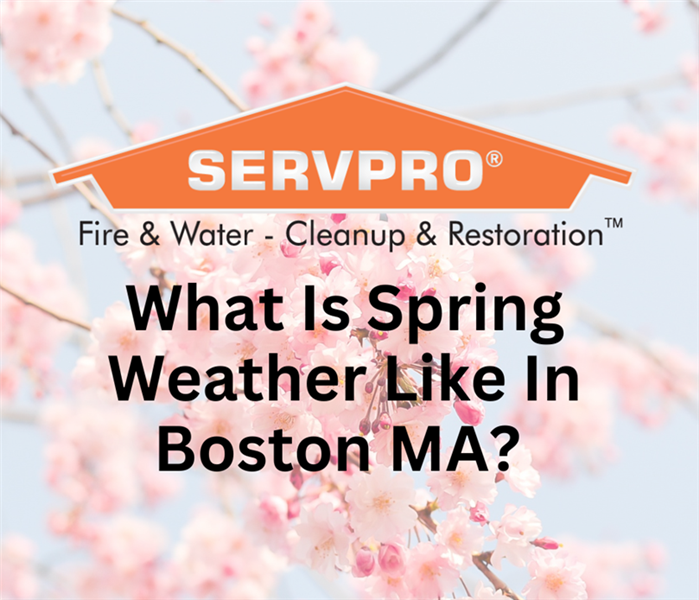 As the weather warms up, Bostonians and visitors alike take advantage of the many outdoor activities available in the city.
As the weather warms up, Bostonians and visitors alike take advantage of the many outdoor activities available in the city.
Boston, Massachusetts is a city that experiences four distinct seasons throughout the year. With mild temperatures, blooming flowers, and an abundance of outdoor activities, the city comes to life after a long, cold winter.
The spring season in Boston typically begins in March and lasts through May. During this time, temperatures can vary greatly, with average highs ranging from the mid-40s to the mid-60s Fahrenheit.
One of the most notable features of springtime in Boston is the blooming of trees and flowers throughout the city. The iconic Boston Common and Public Garden, which covers over 70 acres in the heart of the city, comes to life with colorful tulips, daffodils, and cherry blossoms. The Arnold Arboretum, a 281-acre botanical garden located in Jamaica Plain, also boasts a stunning display of blooming trees and flowers during the spring season.
As the weather warms up, Bostonians and visitors alike take advantage of the many outdoor activities available in the city. Biking and walking along the Charles River Esplanade, which stretches for three miles along the banks of the Charles River, is a popular springtime activity. The Boston Harborwalk, a 43-mile pedestrian trail that winds along Boston’s waterfront, is also a great place to enjoy the spring weather.
Sports fans flock to Fenway Park to catch a Boston Red Sox game, which is an essential Boston experience. Additionally, the Boston Marathon, which takes place on the third Monday in April, is a beloved annual event that draws runners and spectators from around the world.
Boston is a season of renewal and rejuvenation. With mild temperatures, beautiful blooming flowers, and an abundance of outdoor activities, it’s a wonderful time to explore the city and enjoy all that it has to offer.
We service Dedham, East Dedham, Endicott, Medfield, Norwood Centre, Norwood, Walpole, MA, and Westwood, MA
SERVPRO Of Norwood West Roxbury is The #1 Choice in Cleanup and Restoration for residential and commercial buildings’ fire, mold, water, and storm damage.
Grill Fire Safety Tips
4/26/2023 (Permalink)
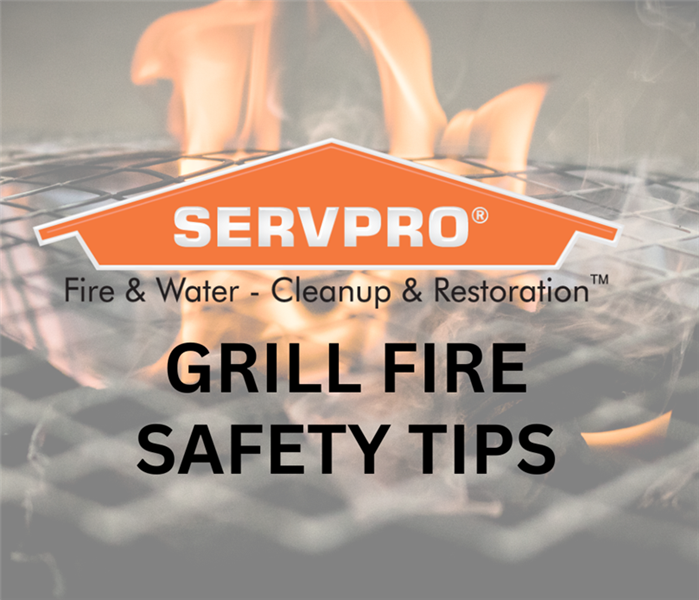 A grill fire can happen quickly and without warning, but there are steps you can take to prevent them from occurring.
A grill fire can happen quickly and without warning, but there are steps you can take to prevent them from occurring.
A grill fire can happen quickly and without warning, but there are steps you can take to prevent them from occurring.
Let’s discuss grill fire safety and tips to keep you and your family safe while enjoying your next cookout.
- Choose the right location for your grill: When choosing where to place your grill, ensure that it is at least 10 feet away from your home or any other combustible structures. Keep it away from overhanging branches, deck railings, and other potentially flammable objects.
- Clean your grill regularly: Cleaning your grill regularly can prevent grease buildup and reduce the risk of flare-ups. Grease fires can happen when grease and fat accumulate on the grates and drip pans. Make sure to clean your grill after every use, and occasionally deep clean it with a grill brush.
- Check for gas leaks: If you have a gas grill, make sure to check the hoses and connections for leaks before every use. A gas leak can cause an explosion or fire, so it's important to be vigilant.
- Keep a fire extinguisher nearby: In case of a fire, make sure to have a fire extinguisher nearby. Ensure that you know how to use it before you need it.
- Be mindful of what you're cooking: Some foods, like fatty meats or foods marinated in oil, are more likely to cause flare-ups. Be mindful of what you're cooking and how you're cooking it. Keep a close eye on the grill, and use a spray bottle of water to douse any small flames.
- Never leave the grill unattended: Never leave the grill unattended, especially if you have children or pets in the area. Accidents can happen quickly, and it's important to be present to address any issues that may arise.
- Shut off the grill properly: After you're finished cooking, make sure to shut off the grill properly. Turn off the burners and close the gas valve if you have a gas grill. For a charcoal grill, spread the coals out and let them cool down completely before disposing of them in a metal container.
Grilling can be an enjoyable activity, but it's important to prioritize safety to prevent a grill fire.
We service Dedham, East Dedham, Endicott, Medfield, Norwood Centre, Norwood, Walpole, MA, and Westwood, MA
SERVPRO Of Norwood West Roxbury is The #1 Choice in Cleanup and Restoration for residential and commercial buildings’ fire, mold, water, and storm damage.
Bonfire safety tips
4/26/2023 (Permalink)
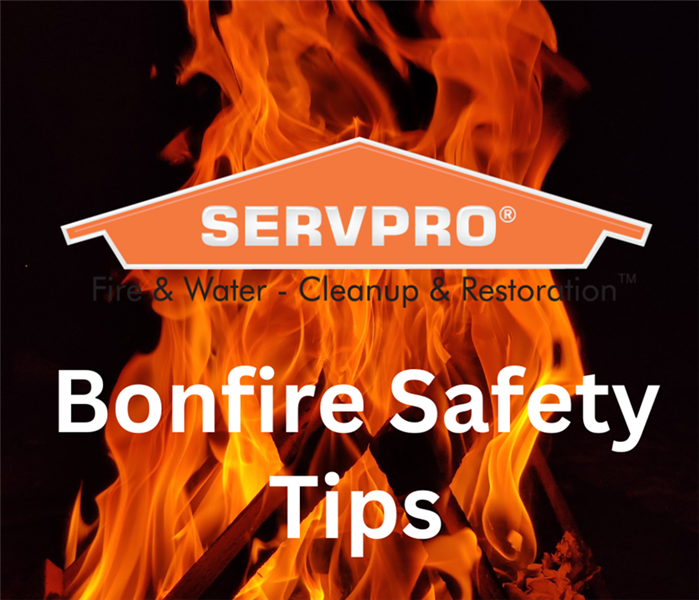 Bonfires can be a fun activity, but it's important to prioritize safety to prevent accidents or injuries.
Bonfires can be a fun activity, but it's important to prioritize safety to prevent accidents or injuries.
Bonfires are a popular outdoor activity. A bonfire can quickly turn into a dangerous situation if proper safety measures are not taken.
Here are bonfire safety tips to keep you and your loved ones safe:
- Choose the right location: When selecting the location for your bonfire, make sure to choose an area that is at least 25 feet away from any structures or combustible materials. This includes buildings, trees, bushes, and anything else that can easily catch fire. Also, ensure that the area is flat and level to prevent the fire from spreading.
- Clear the area around the bonfire: Before lighting the fire, clear the area around the bonfire of any debris, such as dry leaves, sticks, or branches. This will prevent sparks from igniting any nearby materials.
- Use an appropriate container: When building a bonfire, use a container that is made of metal or brick. This will prevent the fire from spreading beyond the container. Never use a container made of plastic, as it can melt and cause the fire to spread.
- Keep water or a fire extinguisher nearby: In case of an emergency, make sure to have a bucket of water or a fire extinguisher nearby. This will help you quickly extinguish the fire if it gets out of control.
- Don't use accelerants: Never use accelerants, such as gasoline or lighter fluid, to start a bonfire. This can cause an explosion or a sudden flare-up, which can be dangerous.
- Attend to the fire at all times: Never leave a bonfire unattended, especially if there are children or pets around. Assign a responsible person to monitor the fire at all times and make sure that it remains under control.
- Extinguish the fire properly: When you're done with the bonfire, make sure to extinguish the fire completely. Pour water over the fire and stir the ashes to ensure that there are no hot spots that could reignite the fire.
Bonfires can be a fun activity, but it's important to prioritize safety to prevent accidents or injuries.
We service Dedham, East Dedham, Endicott, Medfield, Norwood Centre, Norwood, Walpole, MA, and Westwood, MA
SERVPRO Of Norwood West Roxbury is The #1 Choice in Cleanup and Restoration for residential and commercial buildings’ fire, mold, water, and storm damage.
What happens if I don’t fix the water damage?
4/19/2023 (Permalink)
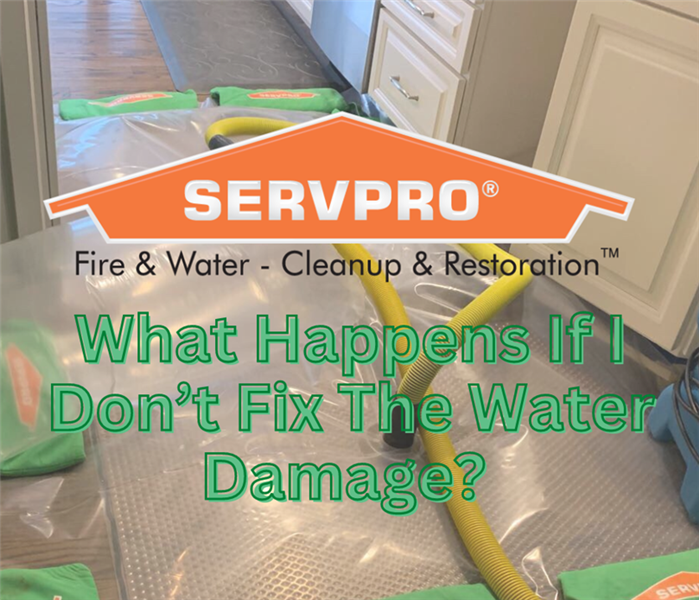 Water damage can be caused by a variety of factors such as leaky pipes, flooding, or a damaged roof.
Water damage can be caused by a variety of factors such as leaky pipes, flooding, or a damaged roof.
Water damage can be caused by a variety of factors such as leaky pipes, flooding, or a damaged roof. Here are some of the consequences of not fixing water damage:
- Structural damage: Water can weaken the structural integrity of your home, causing warping, cracking, and even collapse of your floors, walls, and ceilings.
- Mold growth: Water damage creates a perfect environment for mold to grow, which can lead to serious health problems such as respiratory issues and allergies.
- Electrical hazards: Water can cause electrical wiring to malfunction or even short circuit, which can cause fires and pose a serious risk to your safety.
- Odor: Water damage can cause unpleasant odors to develop, which can be difficult to eliminate without professional remediation.
- Pest infestations: Water damage can attract pests such as rodents and insects, which can thrive in damp environments and cause further damage to your home.
- Decreased property value: If left unprepared, water damage can decrease the value of your home and make it difficult to sell in the future.
- Health hazards: Water damage can create a breeding ground for bacteria and viruses, which can pose a serious health risk to you and your family.
It is important to seek professional help to repair and restore your home to its pre-damaged condition. By addressing water damage promptly, you can avoid more extensive and expensive repairs down the line and ensure the safety and well-being of your family.
We service Dedham, East Dedham, Endicott, Medfield, Norwood Centre, Norwood, Walpole, MA, and Westwood, MA
SERVPRO Of Norwood West Roxbury is The #1 Choice in Cleanup and Restoration for residential and commercial buildings’ fire, mold, water, and storm damage.
What should you do after a fire?
4/17/2023 (Permalink)
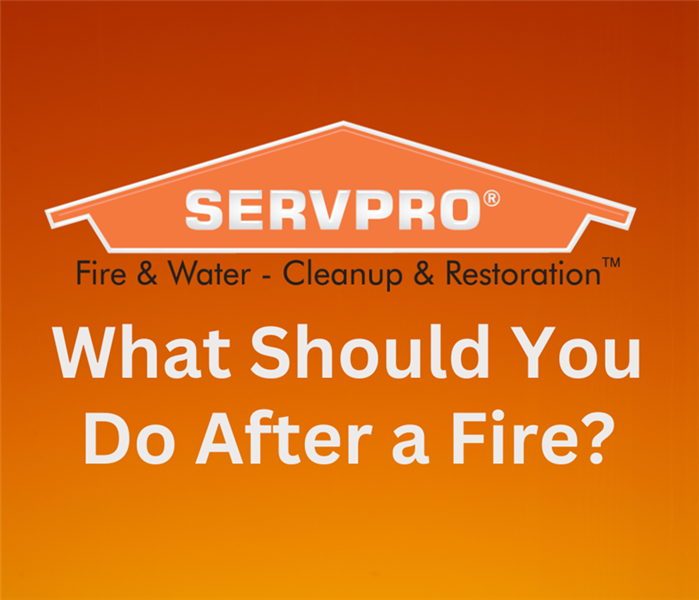 A fire can be a traumatic and devastating event. It's important to take immediate action to start the process of recovery
A fire can be a traumatic and devastating event. It's important to take immediate action to start the process of recovery
A fire can be a traumatic and devastating event. It's important to take immediate action to start the process of recovery and ensure the safety of your home and family.
Here are some steps you should take after a fire:
- Contact your insurance company: One of the first things you should do after a fire is to contact your insurance company. They can help you start the claims process and provide guidance on what steps to take next.
- Assess the damage: Once it is safe to do so, assess the damage to your home. Look for any visible damage, including structural damage, water damage, and smoke damage. Take photos of the damage to provide to your insurance company.
- Secure your property: If your home is severely damaged, you may need to board up windows and doors or cover damaged areas to prevent further damage from weather or vandalism.
- Contact restoration professionals: A professional restoration company can help you with the cleanup, salvage, and restoration of your home and belongings. They can also help you assess the extent of the damage and provide guidance on the best course of action.
- Salvage what you can: If it is safe to do so, try to salvage any belongings that were not damaged by the fire. You may be able to save some items with proper cleaning and restoration.
- Address smoke damage: Smoke can cause extensive damage to a home, even in areas not directly affected by the fire. Be sure to address smoke damage to prevent health hazards and further damage to your home.
- Ensure safety: Before returning to your home, ensure that it is safe to do so. Check for gas leaks, electrical hazards, and other safety concerns.
By contacting your insurance company, assessing the damage, securing your property, contacting restoration professionals, salvaging what you can, addressing smoke damage, and ensuring safety, you can begin to rebuild and move forward after a fire.
We service Dedham, East Dedham, Endicott, Medfield, Norwood Centre, Norwood, Walpole, MA, and Westwood, MA
SERVPRO Of Norwood West Roxbury is The #1 Choice in Cleanup and Restoration for residential and commercial buildings’ fire, mold, water, and storm damage.
What to do when a tree falls?
4/15/2023 (Permalink)
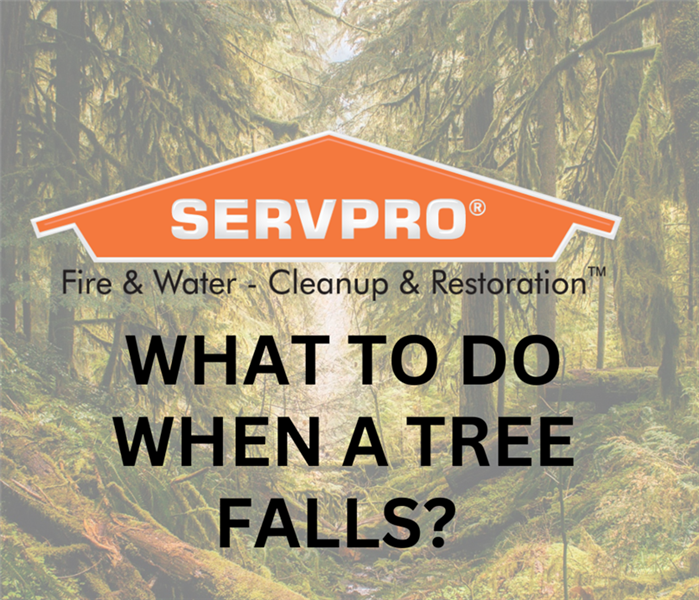 When a tree falls, it's important to stay safe and take necessary precautions.
When a tree falls, it's important to stay safe and take necessary precautions.
Trees can be dangerous when they fall. A fallen tree can cause property damage, power outages, and even personal injury.
If a tree falls here are the steps to take:
- Assess the situation: The first thing to do when a tree falls is to assess the situation. Check for any immediate danger, such as downed power lines or gas leaks. If you suspect a gas leak, evacuate immediately and call your gas company.
- Call for help: If the fallen tree has caused damage or poses a danger to people or property, call for help. Contact your local emergency services or utility company. They can dispatch crews to assess the situation and make necessary repairs.
- Stay away from the tree: If the tree has fallen across a road or path, do not attempt to move it yourself. Fallen trees can be heavy and unstable, and attempting to move them can be dangerous. Stay away from the tree and wait for professional help to arrive.
- Document the damage: Take photos of any damage caused by the fallen tree. This will be useful when filing insurance claims or for repair purposes.
- Clear debris: If the fallen tree has caused minor damage, you may be able to clear the debris yourself. Use caution and wear protective clothing, such as gloves and sturdy shoes. Use a chainsaw or hand saw to cut the tree into manageable pieces, and dispose of the debris according to local regulations.
- Prevent future incidents: To prevent future incidents, inspect trees on your property regularly. Look for signs of decay or damage, such as cracks in the trunk or branches that are hanging low. Consider hiring a professional tree service to remove any trees that pose a danger.
When a tree falls, it's important to stay safe and take necessary precautions. Assess the situation, call for help, document the damage, clear debris if possible, and prevent future incidents.
We service Dedham, East Dedham, Endicott, Medfield, Norwood Centre, Norwood, Walpole, MA, and Westwood, MA
SERVPRO Of Norwood West Roxbury is The #1 Choice in Cleanup and Restoration for residential and commercial buildings’ fire, mold, water, and storm damage.
What to do if there is mold in your walls
4/7/2023 (Permalink)
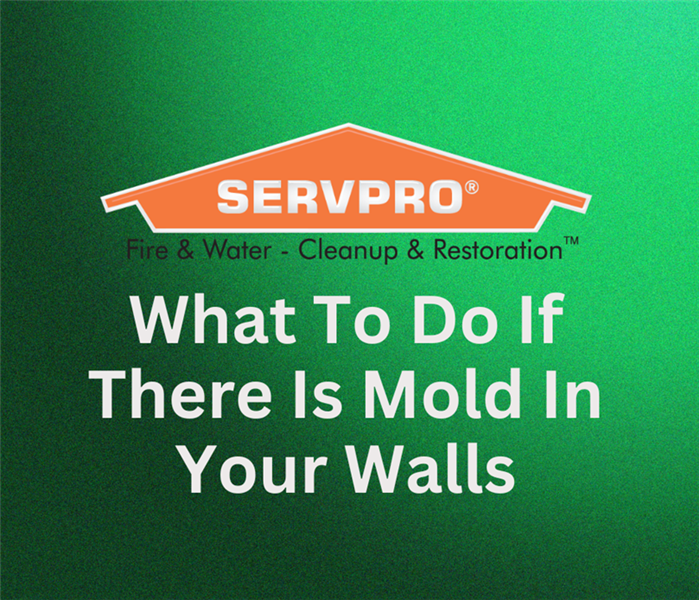 Dealing with mold on your walls can be a daunting task, but it's important to take action as soon as possible to prevent it from spreading.
Dealing with mold on your walls can be a daunting task, but it's important to take action as soon as possible to prevent it from spreading.
Mold can also be a health hazard if left untreated. If you have mold on your walls, it's important to take action as soon as possible to prevent it from spreading.
- Identify the cause of the mold: The first step in dealing with mold on your walls is to identify the underlying cause. Mold thrives in damp, humid environments, so it's important to identify any sources of moisture that may be contributing to the problem. Common causes of mold on walls include leaky pipes, roof leaks, high humidity levels, and poor ventilation.
- Remove the mold: Once you have identified the cause of the mold, it's time to remove it from your walls. Depending on the severity of the mold, you may be able to clean it yourself using a mixture of water and bleach or vinegar. However, if the mold has spread over a large area or is particularly stubborn, it's best to call in a professional mold remediation company to ensure that it is completely removed.
- Repair any damage: Once the mold has been removed, it's important to repair any damage to your walls. This may include replacing any damaged drywall or insulation, repairing leaks, or installing a dehumidifier to help control moisture levels.
- Prevent future mold growth: To prevent mold from growing on your walls in the future, it's important to take steps to control moisture levels in your home. This may include repairing any leaks promptly, using a dehumidifier in areas with high humidity, and ensuring that your home is properly ventilated.
Dealing with mold on your walls can be a daunting task, but it's important to take action as soon as possible to prevent it from spreading.
We service Dedham, East Dedham, Endicott, Medfield, Norwood Centre, Norwood, Walpole, MA, and Westwood, MA
SERVPRO Of Norwood West Roxbury is The #1 Choice in Cleanup and Restoration for residential and commercial buildings’ fire, mold, water, and storm damage.
What can storm damage do to a home?
4/7/2023 (Permalink)
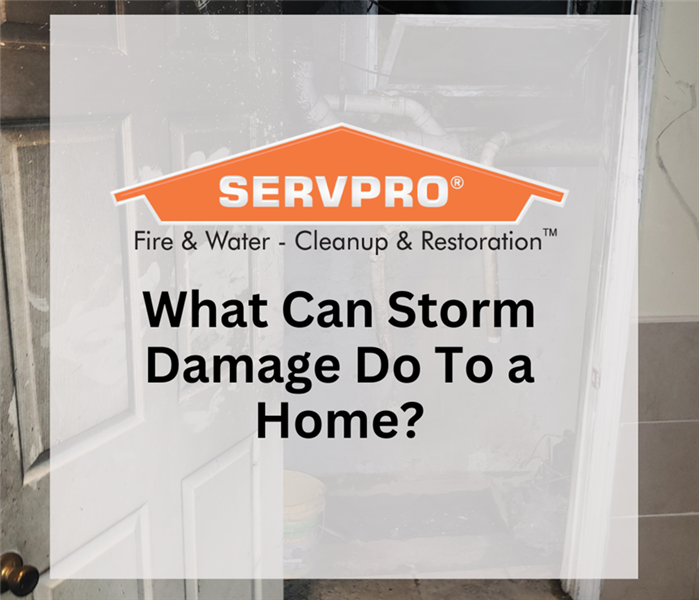 It's important to be aware of the potential dangers of storm damage and take steps to protect your home.
It's important to be aware of the potential dangers of storm damage and take steps to protect your home.
It's important to be aware of the potential dangers of storm damage and take steps to protect your home.
Here are some of the most common types of storm damage that can affect a home:
- Roof Damage: High winds, hail, and heavy rain can all cause damage to a home's roof. This can include missing or broken shingles, leaks, and even complete roof collapse in extreme cases.
- Water Damage: Flooding, leaks, and standing water can cause extensive water damage to a home. This can lead to structural damage, mold growth, and other issues.
- Structural Damage: High winds, tornadoes, and other severe weather events can cause significant structural damage to a home. This can include damage to walls, foundations, and support beams, which can compromise the safety of the home.
- Window and Door Damage: High winds and hail can damage windows and doors, leaving your home vulnerable to further damage.
- Electrical Damage: Lightning strikes and power surges can damage electrical systems in a home, leading to fire hazards and other safety concerns.
- Tree Damage: Falling trees and branches can cause extensive damage to a home, including damage to the roof, walls, and other structures.
- Car Damage: In severe storms, cars can be lifted or moved by high winds, causing them to crash into homes and other structures.
Severe storms can cause a wide range of damage to homes, from minor to severe. By being proactive and taking steps to protect your home, you can minimize the damage caused by severe storms and keep your family safe.
We service Dedham, East Dedham, Endicott, Medfield, Norwood Centre, Norwood, Walpole, MA, and Westwood, MA
SERVPRO Of Norwood West Roxbury is The #1 Choice in Cleanup and Restoration for residential and commercial buildings’ fire, mold, water, and storm damage.
What is considered a home rebuild?
3/23/2023 (Permalink)
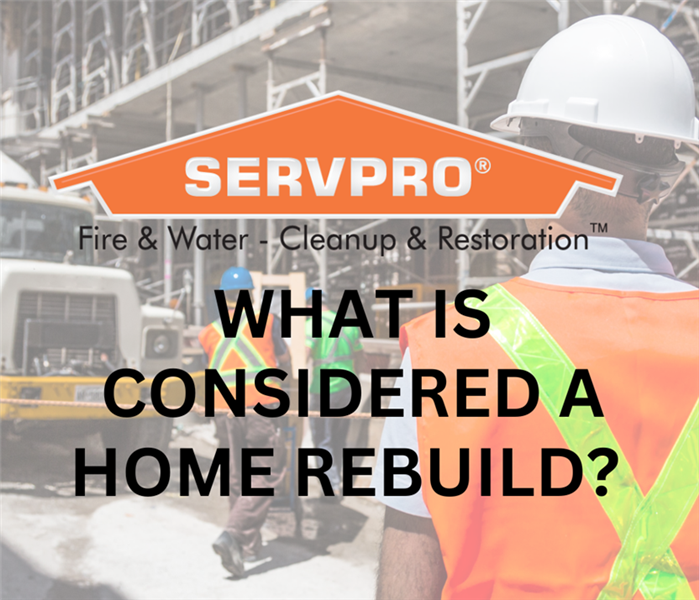 If you're considering a home rebuild, take the time to carefully evaluate your needs, budget, and work with a team of experienced professionals
If you're considering a home rebuild, take the time to carefully evaluate your needs, budget, and work with a team of experienced professionals
When it comes to renovating your home, there are many options to consider. You could do a simple cosmetic update, such as repainting the walls or replacing the flooring.
This approach is usually taken when the existing home is outdated or has been damaged.
Here are a few things to consider:
- If your home is showing signs of wear and tear, such as a cracking foundation, leaking roof, or outdated electrical or plumbing systems, a complete home rebuild may be the best solution. Starting from scratch allows you to incorporate modern building materials and technologies, resulting in a safer, more energy-efficient home.
- One of the benefits of a home rebuild is the ability to design a home that meets your specific needs and tastes. Whether you want an open-concept living area, a spacious kitchen, or a master suite with a spa-like bathroom, a home rebuild allows you to create a home that reflects your unique lifestyle.
- A home rebuild is a major undertaking that requires careful planning, budgeting, and management. It's important to work with an experienced team of professionals, such as architects, builders, and designers, to ensure that your project is executed correctly and to your satisfaction.
- You have experienced a great loss and damage from fire, water, or storm damage in your building. When a disaster hits, this can be the time when rebuilding is critical.
- A home rebuild can take several months or even years to complete, depending on the size and complexity of the project. During this time, you'll need to find alternative housing, such as a rental apartment or temporary housing unit.
If you're considering a home rebuild, take the time to carefully evaluate your needs, budget, and work with a team of experienced professionals to ensure a successful outcome.
We service Dedham, East Dedham, Endicott, Medfield, Norwood Centre, Norwood, Walpole, MA, and Westwood, MA
SERVPRO Of Norwood West Roxbury is The #1 Choice in Cleanup and Restoration for residential and commercial buildings’ fire, mold, water, and storm damage.
Does my insurance cover home damage in Norwood West Roxbury?
3/15/2023 (Permalink)
 Your insurance policy may provide coverage for water damage, but it's important to understand what is covered.
Your insurance policy may provide coverage for water damage, but it's important to understand what is covered.
Home insurance provides financial protection against various risks that could cause damage or loss to your home. Many homeowners are often uncertain about what their insurance coverage includes.
- Natural disasters such as earthquakes, floods, and hurricanes can cause significant damage to your home. Depending on your policy, your insurance coverage may include protection against these types of events.
- Home fires can be devastating, causing significant damage to your property and belongings. Your insurance policy may provide coverage for the cost of repairing or rebuilding your home, as well as replacing your damaged possessions.
- Homeowners' insurance can provide coverage for stolen or damaged property due to theft or vandalism. This coverage typically includes damage to your home's structure and any personal property that has been stolen or damaged.
- Accidents can happen at any time, and they can be costly to repair. Home insurance policies may provide coverage for accidental damage to your home, such as damage caused by a tree falling on your house or your child accidentally breaking a window.
Your insurance policy may provide coverage for water damage, but it's important to understand what is covered.
We service Dedham, East Dedham, Endicott, Medfield, Norwood Centre, Norwood, Walpole, MA, and Westwood, MA
SERVPRO Of Norwood West Roxbury is The #1 Choice in Cleanup and Restoration for residential and commercial buildings’ fire, mold, water, and storm damage.
What should I do if my house is affected by storm damage in Norwood West Roxbury?
3/7/2023 (Permalink)
 We service Dedham, East Dedham, Endicott, Medfield, Norwood Centre, Norwood, Walpole, MA, and Westwood, MA
We service Dedham, East Dedham, Endicott, Medfield, Norwood Centre, Norwood, Walpole, MA, and Westwood, MA
If your home has been affected by storm damage, it's crucial to act quickly to minimize the damage and ensure the safety of yourself and your family. :
- Assess the damage and prioritize safety: If your home has suffered severe damage, it may be unsafe to stay inside. Look for signs of structural damage, such as cracks in the walls, ceilings, or foundation, and assess the damage to the roof, windows, and doors.
- Document the damage: Take photos and videos of the damage to your home, both inside and out. This documentation will be important when filing an insurance claim.
- Contact your insurance company: Your insurer will likely send an adjuster to assess the damage and determine the amount of compensation you're entitled to.
- Make temporary repairs: Cover any holes in the roof or walls with tarps or boards, and use sandbags or other materials to block any openings where water could enter your home.
- Hire a reputable contractor: Look for contractors who are licensed and insured, and who have experience with storm damage repairs.
- Stay organized: Keep track of all communication with your insurance company and contractor, including emails, phone calls, and written correspondence. Make note of any promises or agreements made, and keep copies of all paperwork related to the claims process.
- Prepare for future storms: Consider adding storm shutters or reinforcing your roof to make it more resistant to high winds. Keep important documents in a waterproof and fireproof safe, and have an emergency kit ready in case you need to evacuate quickly.
Storm damage can be a stressful and overwhelming experience, but taking these steps can help you navigate the process and get your home back to normal as soon as possible.
We service Dedham, East Dedham, Endicott, Medfield, Norwood Centre, Norwood, Walpole, MA, and Westwood, MA
SERVPRO Of Norwood West Roxbury is The #1 Choice in Cleanup and Restoration for residential and commercial buildings’ fire, mold, water, and storm damage.
How long does it take for water damage to be fixed?
3/7/2023 (Permalink)
 If you experience water damage, it is best to contact a professional restoration company.
If you experience water damage, it is best to contact a professional restoration company.
Water damage is a common problem that many homeowners face. It can be caused by a variety of factors. Water damage can have severe consequences if not fixed promptly.
The timeline for fixing water damage depends on the severity of the damage.
- The first step in fixing water damage is to identify the source of the water and stop it from causing further damage. This may involve shutting off the main water supply or fixing a broken pipe. Once the source of the water has been identified and fixed, the water damage restoration process can begin.
- Drying is the next stage, and it involves removing any remaining moisture from the affected area. This can be done using dehumidifiers and fans. The duration of this stage depends on the extent of the water damage and the humidity levels in the affected area.
- Once the area has been dried, repairs can begin. This may involve replacing drywall, flooring, and other materials that were damaged by the water. The duration of this stage depends on the extent of the damage and the materials that need to be replaced.
If you experience water damage, it is best to contact a professional restoration company to ensure that the damage is fixed properly and efficiently.
We service Dedham, East Dedham, Endicott, Medfield, Norwood Centre, Norwood, Walpole, MA, and Westwood, MA
SERVPRO Of Norwood West Roxbury is The #1 Choice in Cleanup and Restoration for residential and commercial buildings’ fire, mold, water, and storm damage.
What types of storms are there in spring Norwood West Roxbury?
3/7/2023 (Permalink)
 The spring season can bring with it a variety of weather patterns, including rainstorms, thunderstorms, tornadoes, and dust storms.
The spring season can bring with it a variety of weather patterns, including rainstorms, thunderstorms, tornadoes, and dust storms.
As the season transitions from winter to spring, it brings with it a variety of weather patterns that can be unpredictable and sometimes dangerous.
- Rainstorms are characterized by heavy rainfalls, which can last for several hours or even days. They often occur as warm, moist air from the south collides with colder air from the north, leading to the formation of cumulonimbus clouds.
- Thunderstorms are characterized by the presence of thunder and lightning, which are caused by the discharge of electrical energy between the ground and the atmosphere. Thunderstorms can be dangerous, with the potential to produce strong winds, hail, and tornadoes.
- Tornadoes are characterized by a rotating column of air that forms within a thunderstorm and can cause widespread damage, including uprooting trees, damaging buildings, and even destroying entire communities. While tornadoes can occur at any time of the year, they are most common during the spring season.
- While not as common as the other types of storms on this list, dust storms can occur during the spring season in arid regions. These storms are characterized by strong winds that pick up dust and dirt, leading to reduced visibility and potentially hazardous driving conditions.
The spring season can bring with it a variety of weather patterns, including rainstorms, thunderstorms, tornadoes, and dust storms.
We service Dedham, East Dedham, Endicott, Medfield, Norwood Centre, Norwood, Walpole, MA, and Westwood, MA
SERVPRO Of Norwood West Roxbury is The #1 Choice in Cleanup and Restoration for residential and commercial buildings’ fire, mold, water, and storm damage.
What should I do to prepare for a thunderstorm?
3/7/2023 (Permalink)
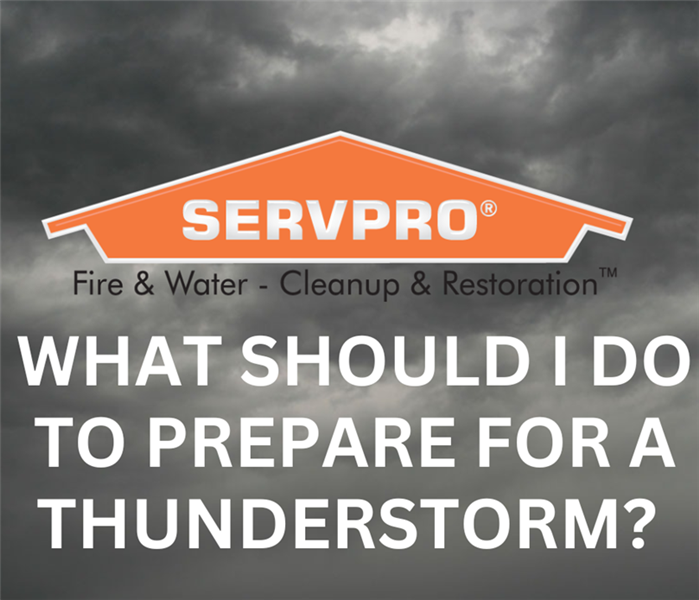 Preparing for a thunderstorm is essential to keeping yourself and your loved ones safe.
Preparing for a thunderstorm is essential to keeping yourself and your loved ones safe.
Thunderstorms are powerful weather events that can bring lightning, high winds, heavy rain, and hail.
- One of the most important things you can do to prepare for a thunderstorm is to stay informed about the weather conditions in your area. Keep an eye on local weather reports and download a reliable weather app that can give you up-to-date information.
- Create an emergency kit: Putting together an emergency kit is an excellent way to prepare for a thunderstorm. Your kit should include items like a flashlight, extra batteries, a first aid kit, bottled water, non-perishable food, a portable radio, and a phone charger.
- Secure your home: It is essential to secure your home before a thunderstorm.
- Unplug electronics: Lightning strikes can cause power surges that can damage your electronic devices. To prevent this, unplug your electronics before the storm arrives. This includes appliances, televisions, computers, and other devices.
- Stay inside: The best way to stay safe during a thunderstorm is to stay inside a sturdy building or a car. If you are outside when the storm hits, seek shelter immediately.
- Wait for the storm to pass: Thunderstorms can be intense but usually pass relatively quickly. Once the storm has passed, wait for a while before going outside to assess any damage or potential hazards.
Preparing for a thunderstorm is essential to keeping yourself and your loved ones safe. Staying informed, creating an emergency kit, securing your home, unplugging electronics, staying inside, and waiting for the storm to pass are all critical steps to take.
We service Dedham, East Dedham, Endicott, Medfield, Norwood Centre, Norwood, Walpole, MA, and Westwood, MA
SERVPRO Of Norwood West Roxbury is The #1 Choice in Cleanup and Restoration for residential and commercial buildings’ fire, mold, water, and storm damage.
How to prevent mold damage in Norwood West Roxbury MA
3/5/2023 (Permalink)
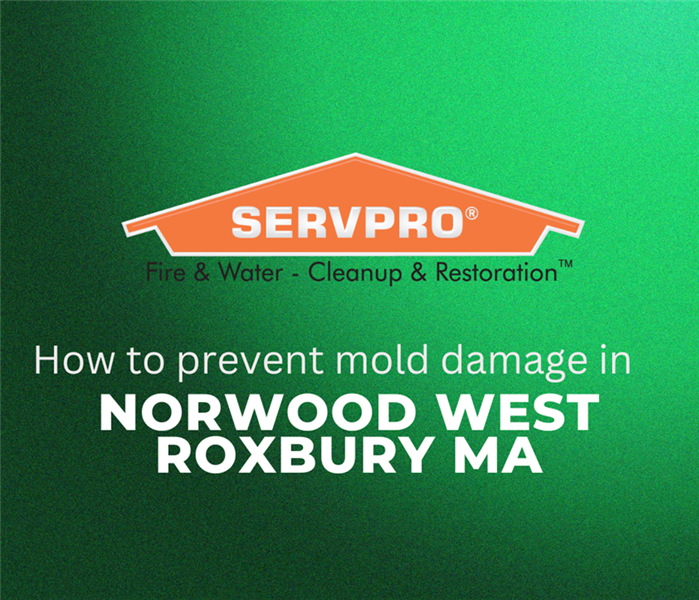 SERVPRO Of Norwood West Roxbury is The #1 Choice in Cleanup and Restoration for residential and commercial buildings’ fire, mold, water, and storm
SERVPRO Of Norwood West Roxbury is The #1 Choice in Cleanup and Restoration for residential and commercial buildings’ fire, mold, water, and storm
Mold is a common problem that affects many households. It can cause significant damage to your property and even pose a health risk to you and your family. Mold grows in damp and humid environments, and it can thrive on various surfaces, including walls, ceilings, carpets, and furniture. Fortunately, there are ways to prevent mold damage in your home.
- Keep your home dry: Mold thrives in damp and humid environments, so the best way to prevent mold damage is to keep your home dry. You can do this by fixing any leaks in your plumbing, roof, or windows. Make sure that your home is properly ventilated, especially in areas like the bathroom, kitchen, and laundry room.
- Clean and maintain your HVAC system: Your HVAC system plays a crucial role in maintaining the air quality in your home. It can also help to prevent mold growth. Make sure to clean and maintain your HVAC system regularly to prevent any buildup of dust or moisture, which can lead to mold growth.
- Use mold-resistant products: When renovating or building your home, consider using mold-resistant materials such as drywall, paints, and insulation. These materials are specially designed to resist mold growth.
- Monitor indoor humidity levels: Mold thrives in humid environments, so it's important to keep an eye on indoor humidity levels. The ideal humidity level is between 30 and 50 percent. You can use a hygrometer to measure the humidity levels in your home.
- Clean and dry any water damage promptly: Water damage is one of the leading causes of mold growth. If you experience any water damage in your home, it's important to clean and dry the affected area as soon as possible.
Mold damage can be a significant problem for homeowners, but it's a problem that can be prevented. By keeping your home dry, maintaining your HVAC system, using mold-resistant products, monitoring indoor humidity levels, and cleaning and drying any water damage promptly, you can help to prevent mold growth and protect your home from mold damage.
We service Dedham, East Dedham, Endicott, Medfield, Norwood Centre, Norwood, Walpole, MA, and Westwood, MA
SERVPRO Of Norwood West Roxbury is The #1 Choice in Cleanup and Restoration for residential and commercial buildings’ fire, mold, water, and storm damage.
What are the steps for a commercial rebuild in Norwood West Roxbury MA?
3/5/2023 (Permalink)
 We service Dedham, East Dedham, Endicott, Medfield, Norwood Centre, Norwood, Walpole, MA, and Westwood, MA
We service Dedham, East Dedham, Endicott, Medfield, Norwood Centre, Norwood, Walpole, MA, and Westwood, MA
Commercial rebuilds can be an exciting and daunting undertaking for any business owner. It can be a chance to revamp your business and take it to the next level, but it requires careful planning and execution. Here are the essential steps you need to follow to ensure a successful commercial rebuild.
Step 1: Define your goals and budget: Determine what changes you want to make and why. This will help you determine the scope of the project and the budget you'll need to allocate. Be realistic with your budget and plan for unexpected expenses.
Step 2: Hire a contractor: You will need to hire an experienced contractor to help you plan and execute the rebuild. Look for professionals with experience in commercial construction, and make sure to check their references and past projects.
Step 3: Obtain permits and approvals: Before you can start construction, you'll need to obtain the necessary permits and approvals from the local building department. This can be a time-consuming process, so it's important to start early and plan accordingly.
Step 4: Demolition and site preparation: Once you have all the necessary permits and approvals, you can start the demolition and site preparation process. This will involve removing any existing structures and preparing the site for construction.
Step 5: Construction: The construction phase involves building the new structure according to the plans created by your architect. This will include everything from framing and roofing to electrical and plumbing systems. Your contractor will oversee this process and ensure that everything is built to code and on schedule.
Step 6: Inspections and final touches: After construction is complete, your building will need to be inspected to ensure that it meets all safety and building codes. Once the inspections are complete, you can begin adding the final touches, such as flooring, paint, and fixtures.
Step 7: Move-in and reopening
Once the final touches are complete, you can move back into the building and reopen your business.
Commercial rebuilds require careful planning, budgeting, and execution.
We service Dedham, East Dedham, Endicott, Medfield, Norwood Centre, Norwood, Walpole, MA, and Westwood, MA
SERVPRO Of Norwood West Roxbury is The #1 Choice in Cleanup and Restoration for residential and commercial buildings’ fire, mold, water, and storm damage.
What are the steps for water damage in Norwood West Roxbury MA?
3/5/2023 (Permalink)
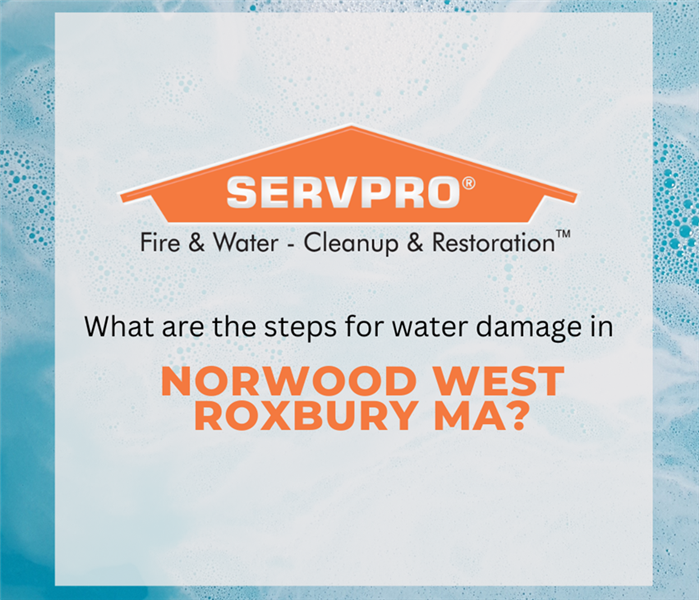 If the damage is extensive, it's best to hire a professional restoration company to ensure your home is restored to its pre-damaged condition.
If the damage is extensive, it's best to hire a professional restoration company to ensure your home is restored to its pre-damaged condition.
Water damage can be one of the most destructive problems a homeowner can face. Whether it's due to a burst pipe, a leaking roof, or flooding, water damage can cause extensive damage to your home, furniture, and personal belongings. However, taking the right steps as soon as you discover water damage can minimize the damage and save you money in the long run.
Ensure your safety: The first step in dealing with water damage is to ensure your safety. If the water damage is severe, turn off the electricity, gas, and water supply to your home before entering the affected area. Water can conduct electricity, so it's crucial to ensure your safety before entering a flooded area.
Document the damage: Before you start cleaning up the water, it's essential to document the damage for insurance purposes. Take pictures and videos of the damage to your home, furniture, and personal belongings.
Remove standing water: The next step is to remove any standing water as quickly as possible. You can use a wet/dry vacuum to remove the water or hire a professional restoration company to do the job for you.
Dry out the affected area: After removing the standing water, the next step is to dry out the affected area. You can use fans and dehumidifiers to speed up the drying process. If the water damage is extensive, it's best to hire a professional restoration company that has the equipment and expertise to dry out your home thoroughly.
Clean and disinfect: Once the affected area is completely dry, it's essential to clean and disinfect the area to prevent mold growth. You can use a bleach solution to disinfect the affected area or hire a professional cleaning company to do the job for you.
Repair and restore: The final step is to repair and restore any damage. This may include replacing drywall, flooring, or furniture.
If the damage is extensive, it's best to hire a professional restoration company to ensure your home is restored to its pre-damaged condition.
We service Dedham, East Dedham, Endicott, Medfield, Norwood Centre, Norwood, Walpole, MA, and Westwood, MA
SERVPRO Of Norwood West Roxbury is The #1 Choice in Cleanup and Restoration for residential and commercial buildings’ fire, mold, water, and storm damage.
The Rebuilding Home Process
2/15/2023 (Permalink)
 Rebuilding a home is a major undertaking that requires careful planning, a skilled team, and a clear vision for the end result.
Rebuilding a home is a major undertaking that requires careful planning, a skilled team, and a clear vision for the end result.
Whether you are rebuilding due to a natural disaster or simply renovating an older home, there are several key factors to consider as you embark on this journey.
First, you'll need to assess the scope of the project. Will you be tearing down the existing structure and starting from scratch, or will you be working with the existing framework? This will depend on the condition of the home, your budget, and your overall goals.
Next, you'll want to consider the layout of the home. Are there any areas that you would like to expand or modify? Do you need to reconfigure the layout to better suit your lifestyle or family needs? This is a good time to work with an architect or designer to create a blueprint of your new home.
Once you have a clear plan for the layout, it's time to consider the materials and finishes you will use. This includes everything from the roofing materials to the flooring, cabinetry, and countertops. You'll want to choose materials that are durable, high-quality, and in line with your personal style.
As you move forward with the rebuilding process, it's important to stay organized and keep a close eye on your budget. You may encounter unexpected expenses, so it's important to have some contingency funds set aside. You'll also want to work closely with your contractors and subcontractors to ensure that the project stays on track and within your desired timeline.
Rebuilding a home is a major undertaking that requires careful planning, a skilled team, and a clear vision for the end result.
SERVPRO of Norwood West Roxbury is your premier choice for fire damage and restoration. Our teams are ready to respond 24 hours a week, any day of the year. When you bring us on the job our team of licensed contractors and certified technicians will work collaboratively with you throughout the duration of the project. They will keep you updated on the project's status and ensure that your expectations are met. We will help you to move forward and make it “Like it never even happened” for all of your fire damage.
How Does Mold Damage Happen?
2/15/2023 (Permalink)
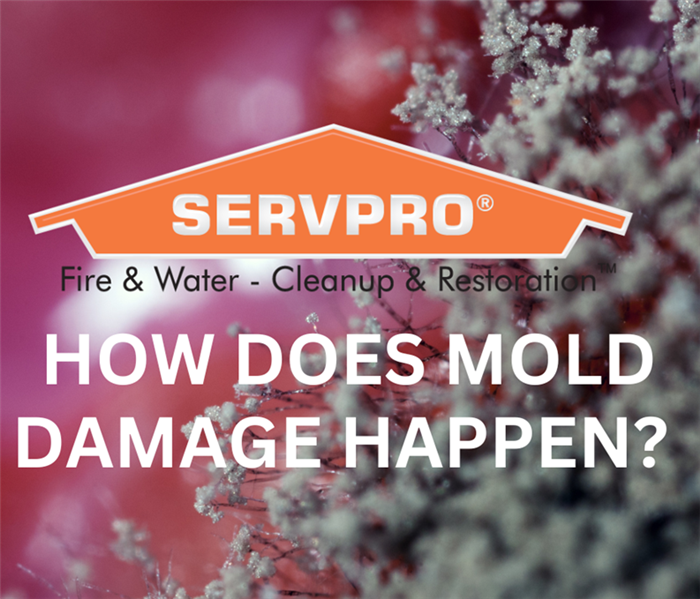 If you suspect that you have mold damage in your building, it is important to address the problem as soon as possible.
If you suspect that you have mold damage in your building, it is important to address the problem as soon as possible.
Mold is a type of fungus that thrives in damp and humid environments. It grows quickly and can spread rapidly, causing damage to the structure of a building and posing a health risk to its occupants.
Causes of Mold Damage
Mold thrives in damp and humid conditions. This means that any area of a building that is exposed to moisture is at risk of developing mold. Some of the most common causes of mold damage include:
- Water leaks: Leaky pipes, roofs, and windows can all contribute to the growth of mold.
- Flooding: If a building is flooded, the excess water can create a perfect breeding ground for mold.
- Humidity: High levels of humidity in a building can create conditions that are ideal for mold growth.
- Poor ventilation: Without adequate ventilation, moisture can become trapped in a building, providing a perfect environment for mold to grow.
Effects of Mold Damage
Mold damage can have a number of negative effects on a building and its occupants. Some of the most common effects include:
- Structural damage: Mold can weaken the structure of a building, leading to cracks, warping, and other forms of damage.
- Health risks: Exposure to mold can lead to a number of health problems, including respiratory issues, allergic reactions, and skin irritation.
- Property damage: Mold can damage walls, floors, and other surfaces, requiring expensive repairs and replacements.
Prevention of Mold Damage
Preventing mold damage is much easier than dealing with it after it has already occurred. Here are some tips for preventing mold growth in your building:
- Keep humidity levels under control: Make sure that your building has adequate ventilation and use dehumidifiers to control humidity levels.
- Repair water leaks: Fix any leaks as soon as they are detected to prevent moisture from building up.
- Keep your building clean: Regular cleaning can help prevent mold growth by removing any spores that may be present.
- Inspect your building regularly: Regular inspections can help you identify any potential problems before they become major issues.
Remediation of Mold Damage
If you suspect that you have mold damage in your building, it is important to address the problem as soon as possible. Here are the steps involved in mold remediation:
- Identify the source of the problem: Determine the source of the moisture that is causing the mold growth.
- Contain the mold: Use barriers to prevent the mold from spreading to other areas of the building.
- Remove the mold: Use specialized equipment and cleaning agents to remove the mold.
- Repair any damage: Repair any damage that was caused by the mold growth.
- Take steps to prevent future mold growth: Take steps to prevent future mold growth by addressing any moisture problems and keeping the building clean.
Mold damage is a serious problem that can have a number of negative effects on a building and its occupants.
SERVPRO of Norwood West Roxbury is your premier choice for damage and restoration. Our teams are ready to respond 24 hours a week, any day of the year. When you bring us on the job our team of licensed contractors and certified technicians will work collaboratively with you throughout the duration of the project. They will keep you updated on the project's status and ensure that your expectations are met. We will help you to move forward and make it “Like it never even happened” for all of your fire damage.
What Causes Flooding in homes and buildings?
2/15/2023 (Permalink)
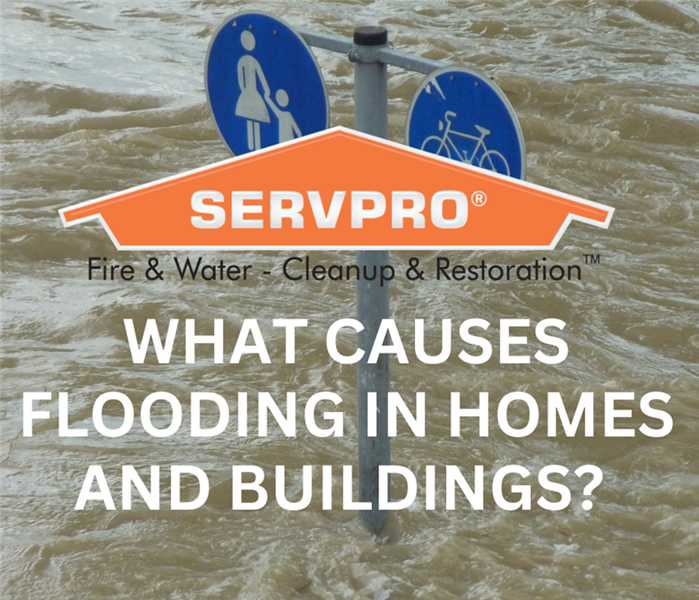 By understanding the causes and impacts of flooding, and implementing measures to mitigate its effects, we can work to protect our communities.
By understanding the causes and impacts of flooding, and implementing measures to mitigate its effects, we can work to protect our communities.
Flooding is a natural disaster that occurs when an area is overwhelmed by water, either from heavy rainfall or rising bodies of water. It can cause significant damage to homes and businesses.
Causes of Flooding
Flooding can be caused by a variety of factors, including natural events and human activities. The most common natural cause of the flooding is heavy rainfall, particularly during prolonged periods of wet weather. This can lead to rivers and streams overflowing their banks, and low-lying areas becoming flooded.
Flooding can also be caused by rising sea levels, as well as coastal storms and hurricanes. These events can cause significant damage to coastal communities, particularly those in low-lying areas.
Human activities can also contribute to flooding. For example, the construction of buildings and other infrastructure can alter the natural flow of water, leading to increased flooding. Deforestation and other land use changes can also contribute to flooding, as they reduce the ability of soil to absorb water.
Impacts of Flooding
Flooding can have significant impacts on individuals, communities, and economies. The most immediate impact is damage to homes, businesses, and infrastructure, such as roads and bridges. This can result in the displacement of residents, loss of livelihoods, and disruption of essential services.
Flooding can also have long-term impacts on the environment. For example, it can lead to soil erosion, which can reduce the fertility of agricultural land. It can also lead to water pollution, as floodwaters can carry contaminants into rivers and other bodies of water.
Finally, flooding can have significant economic impacts. In addition to the direct costs of repairing damage to infrastructure and homes, flooding can also disrupt supply chains and reduce economic activity in affected areas.
Measures to Mitigate the Effects of Flooding
There are a number of measures that can be taken to mitigate the effects of flooding. One approach is to implement natural solutions, such as restoring wetlands and other natural features that help to absorb and slow down floodwaters. This can help to reduce the impact of flooding on communities and the environment.
Another approach is to implement engineered solutions, such as building flood protection infrastructure like levees, flood walls, and stormwater management systems. These measures can help to prevent flooding in the first place, or to reduce the impact of flooding when it does occur.
Finally, it is important to ensure that communities are prepared for flooding. This can involve measures such as developing early warning systems, establishing emergency shelters, and educating residents on how to prepare for and respond to flooding events.
By understanding the causes and impacts of flooding, and implementing measures to mitigate its effects, we can work to protect our communities and reduce the impact of this devastating natural event.
SERVPRO of Norwood West Roxbury is your premier choice for fire damage and restoration. Our teams are ready to respond 24 hours a week, any day of the year. When you bring us on the job our team of licensed contractors and certified technicians will work collaboratively with you throughout the duration of the project. They will keep you updated on the project's status and ensure that your expectations are met. We will help you to move forward and make it “Like it never even happened” for all of your fire damage.
What Are The Causes Of Fire?
2/15/2023 (Permalink)
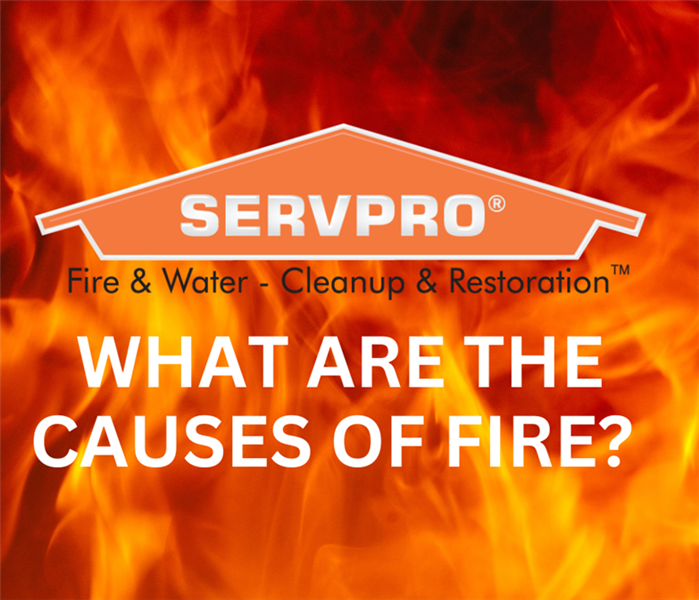 While fires can be difficult to prevent, there are many steps that can be taken to reduce the risk of fires and mitigate their impacts.
While fires can be difficult to prevent, there are many steps that can be taken to reduce the risk of fires and mitigate their impacts.
Fires are natural disaster that can occur in many different forms, from small brush fires to large-scale forest fires. They can happen at any time, and they can be devastating in terms of the damage they can cause to property, natural habitats, and human lives.
Causes of Fires
Fires can be caused by a wide range of factors, including natural causes such as lightning strikes, as well as human activities such as campfires, cooking, and smoking. In some cases, fires can also be caused by electrical faults or mechanical failures, such as faulty wiring or overheated equipment. In recent years, climate change has been identified as a major contributor to the increased incidence and severity of fires, as rising temperatures and changing weather patterns have created more favorable conditions for fires to occur.
Impacts of Fires
The impacts of fires can be far-reaching and long-lasting, affecting everything from the immediate safety of people and animals to the long-term health of ecosystems. In the short term, fires can cause injury and death to people and animals, as well as damage to property and infrastructure. In the long term, fires can have significant impacts on natural habitats, including loss of vegetation, changes in soil composition, and loss of biodiversity. Fires can also have a significant impact on the climate, releasing large amounts of carbon dioxide and other greenhouse gases into the atmosphere.
Prevention of Fires
Preventing fires requires a multi-faceted approach, including education, awareness, and proactive measures. This includes educating people about the risks and causes of fires, as well as providing information on how to prevent them. Some of the key preventative measures include regular maintenance of electrical equipment, avoiding open fires in high-risk areas, and ensuring that campfires are extinguished completely before leaving the site. Other important steps include monitoring weather conditions and fire danger ratings, as well as being prepared to evacuate in the event of an emergency.
While fires can be difficult to prevent, there are many steps that can be taken to reduce the risk of fires and mitigate their impacts. By working together and taking a proactive approach to fire prevention, we can help to protect our communities, natural habitats, and the planet as a whole.
SERVPRO of Norwood West Roxbury is your premier choice for fire damage and restoration. Our teams are ready to respond 24 hours a week, any day of the year. When you bring us on the job our team of licensed contractors and certified technicians will work collaboratively with you throughout the duration of the project. They will keep you updated on the project's status and ensure that your expectations are met. We will help you to move forward and make it “Like it never even happened” for all of your fire damage.
How To Get Rid Of Odor
2/15/2023 (Permalink)
 By using the tips and tricks, you can eliminate even the most stubborn smells and enjoy a fresh, clean home.
By using the tips and tricks, you can eliminate even the most stubborn smells and enjoy a fresh, clean home.
Odors can be unpleasant and difficult to remove, especially if they are deeply embedded in fabrics or other materials. Fortunately, there are several effective methods for odor removal that can help you get rid of unwanted smells in your home.
- Ventilate the area: One of the easiest and most effective ways to remove odors is to ventilate the area. This can be done by opening windows and doors to let in fresh air, using a fan to circulate the air, or simply turning on your air conditioning or heating system to help remove any stagnant or stale air.
- Baking soda: Baking soda is a natural deodorizer that can help remove odors from a variety of surfaces. Simply sprinkle a generous amount of baking soda onto the affected area and let it sit for several hours or overnight. Then, vacuum or sweep up the baking soda and any residual odor.
- White vinegar: White vinegar is another effective natural deodorizer that can help remove stubborn odors. Mix equal parts white vinegar and water in a spray bottle and apply to the affected area. Let it sit for several hours, then wipe clean with a damp cloth.
- Activated charcoal:Activated charcoal is a powerful odor absorber that can help eliminate even the strongest of smells. Simply place a few pieces of activated charcoal in a container and leave it in the affected area for several hours or overnight. The charcoal will absorb the odor and leave the air smelling fresh and clean.
- Enzyme cleaners: Enzyme cleaners are specially designed to break down organic matter and eliminate odors. They can be used on a variety of surfaces, including carpets, upholstery, and clothing. Simply apply the enzyme cleaner to the affected area, let it sit for several hours, then wash or rinse as directed.
- Professional cleaning: If all else fails, it may be time to call in the professionals. Professional cleaning services have the tools and expertise to remove even the toughest odors, whether they are in your carpets, furniture, or air ducts. They can also help identify the source of the odor and provide advice on how to prevent it from returning in the future.
By using the tips and tricks, you can eliminate even the most stubborn smells and enjoy a fresh, clean home. Whether you opt for natural remedies or professional cleaning services, it is important to take action as soon as possible to prevent the odor from getting worse and spreading to other areas of your home.
SERVPRO of Norwood West Roxbury is your premier choice for damage and restoration. Our teams are ready to respond 24 hours a week, any day of the year. When you bring us on the job our team of licensed contractors and certified technicians will work collaboratively with you throughout the duration of the project. They will keep you updated on the project's status and ensure that your expectations are met. We will help you to move forward and make it “Like it never even happened” for all of your fire damage.
SERVPRO of Norwood West Roxbury Shares Preventing Mold Damage: Essential Tips for a Healthy Home
2/5/2023 (Permalink)
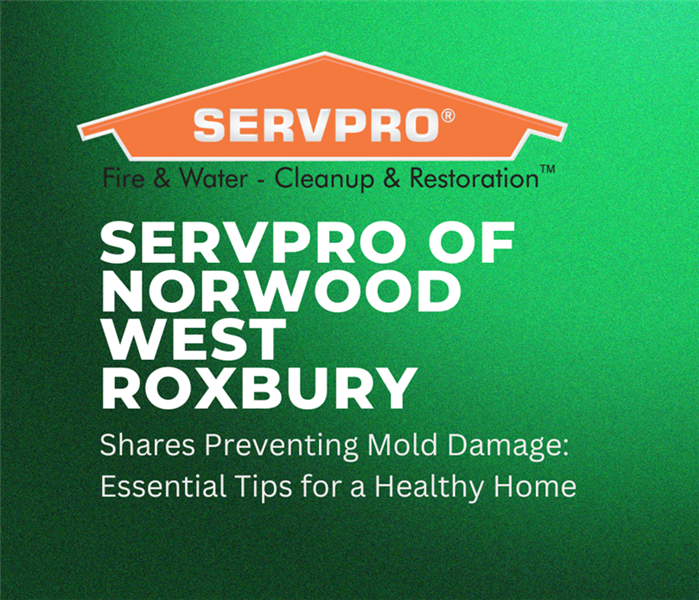 If you suspect mold growth in your home, it is important to have it inspected and professionally remediated to avoid further damage.
If you suspect mold growth in your home, it is important to have it inspected and professionally remediated to avoid further damage.
Mold damage can be a major problem in many homes. Here are some tips to help you prevent mold damage in your home:
- Control humidity levels: Mold thrives in moist environments, so it is essential to keep indoor humidity levels low. Use a dehumidifier to remove excess moisture from the air
- Fix leaks: Promptly fix any leaks in your roof, walls, or plumbing to prevent water damage and mold growth.
- Keep surfaces clean and dry: Regularly clean and dry surfaces in high-risk areas such as bathrooms, kitchens, and basements. Use a mold-resistant cleaning solution to disinfect surfaces and prevent mold from growing.
- Increase ventilation: Ensure that your home has proper ventilation to help prevent mold growth. This can be achieved by opening windows and doors regularly, using exhaust fans, and keeping air vents clear.
- Inspect and maintain HVAC systems: Your heating, ventilation, and air conditioning systems can become a breeding ground for mold if not properly maintained. Inspect them regularly and have them serviced by a professional if needed.
- Store items properly: Store items, especially paper products and organic materials, properly in sealed containers to prevent mold growth.
- Regularly inspect your home: Regular inspections of your home can help identify mold damage early, allowing you to take action before it becomes a bigger problem. Look for discoloration on walls and ceilings, a musty odor, or any other signs of moisture damage.
By following these tips, you can help prevent mold damage in your home and your home's structure. If you suspect mold growth in your home, it is important to have it inspected and professionally remediated to avoid further damage and health problems.
SERVPRO of Norwood West Roxbury is your premier choice for fire damage and restoration. Our teams are ready to respond 24 hours a week, any day of the year. When you bring us on the job our team of licensed contractors and certified technicians will work collaboratively with you throughout the duration of the project. They will keep you updated on the project's status and ensure that your expectations are met. We will help you to move forward and make it “Like it never even happened” for all of your fire damage.
SERVPRO of Norwood West Roxbury Discusses How To Prevent Flooding in a Basement
2/5/2023 (Permalink)
 If you do experience basement flooding, don't hesitate to call in a professional to help with the cleanup and repair process.
If you do experience basement flooding, don't hesitate to call in a professional to help with the cleanup and repair process.
Flooding in a basement can be a stressful and devastating experience. It can cause extensive damage to your property and belongings, and if not addressed promptly. Let's discuss the causes of basement flooding, the steps you can take to prevent it, and what to do if your basement is flooded.
There are many reasons why a basement can flood. Some common causes include:
- Heavy rainfall: When there is an excessive amount of rainfall in a short period of time, it can cause water to seep into the basement through cracks in the foundation, windows, or doorways.
- Overflowing gutters and downspouts: If your gutters and downspouts are clogged, water will overflow and can seep into the basement.
- Sewer backup: A sewer backup occurs when wastewater from the sewer system enters your basement. This can be caused by a blockage in the sewer line, heavy rainfall, or a malfunction in the sewage system.
- High water table: If the water table is high in your area, it can cause water to seep into the basement through the walls or floor.
To prevent basement flooding, there are several steps you can take:
- Install a sump pump: A sump pump is a device that pumps water out of the basement when it reaches a certain level.
- Check your gutters and downspouts regularly: Make sure they are clear of debris and are directing water away from the foundation of your home.
- Install backflow valves: Backflow valves prevent sewer water from flowing back into your home.
- Seal cracks in the foundation: If you find cracks in the foundation of your home, have them sealed to prevent water from seeping in.
If your basement is flooded, it's important to take immediate action to prevent further damage and to mitigate any health risks:
- Turn off the electricity: If water has entered your basement, turn off the electricity to prevent electrical shock.
- Remove water: If the water level is not too high, use a pump or wet vacuum to remove the water. If the water level is too high, call a professional to remove the water.
- Clean and dry everything: Once the water has been removed, clean and dry all the items in the basement. This includes walls, floors, furniture, and other belongings.
- Call in professionals: If the damage is extensive, it's best to call in a professional to assess the damage and make any necessary repairs.
Basement flooding can be a stressful and devastating experience, but by taking the steps to prevent it and knowing what to do if it occurs. If you do experience basement flooding, don't hesitate to call in a professional to help with the cleanup and repair process.
SERVPRO of Norwood West Roxbury is your premier choice for fire damage and restoration. Our teams are ready to respond 24 hours a week, any day of the year. When you bring us on the job our team of licensed contractors and certified technicians will work collaboratively with you throughout the duration of the project. They will keep you updated on the project's status and ensure that your expectations are met. We will help you to move forward and make it “Like it never even happened” for all of your fire damage.
SERVPRO of Norwood West Roxbury: How to Deal with Fire in the Workplace: Tips and Strategies
2/5/2023 (Permalink)
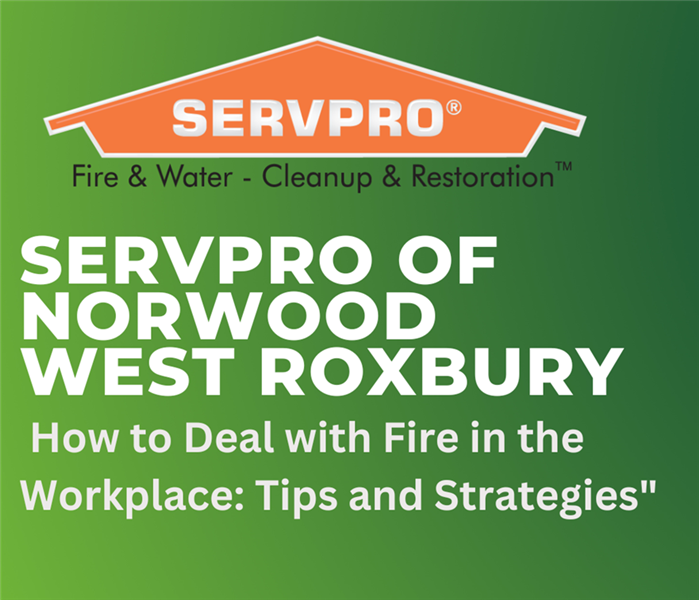 You can help prevent damage, minimize injury, and ensure the safety of everyone in your workplace in case of a fire.
You can help prevent damage, minimize injury, and ensure the safety of everyone in your workplace in case of a fire.
A fire can happen at any time and place. Having a fire response plan in place and understanding the proper procedures to follow can help prevent damage, minimize injury and ensure the safety of everyone in the workplace.
Here are some tips and strategies to help you deal with fire in your business:
- Establish a fire response plan: This should include the proper procedures to follow in case of a fire, such as evacuation procedures, and the designated meeting place for employees after evacuation.
- Install fire alarms and fire suppression systems: Fire alarms should be placed throughout the workplace, and fire suppression systems such as sprinklers should be installed to help put out the fire.
- Regularly inspect and maintain fire equipment: Regular inspections and maintenance of fire alarms, fire suppression systems and other fire equipment is essential to ensure they are functioning properly and can be used in the event of a fire.
- Conduct regular fire drills: Regular fire drills are important to help employees understand what to do in the event of a fire, and to ensure that everyone is prepared.
- Store flammable materials properly: Flammable materials should be stored in fireproof cabinets, away from heat sources and potential sources of ignition.
- Train employees: Employees should be trained on the proper procedures to follow in case of a fire, including how to evacuate the building, how to use fire extinguishers, and how to report the fire.
- Have an emergency evacuation plan: An emergency evacuation plan should be in place and clearly communicated to all employees. This should include the designated meeting place for employees after evacuation.
By following these tips and strategies, you can help prevent damage, minimize injury, and ensure the safety of everyone in your workplace in case of a fire.
SERVPRO of Norwood West Roxbury is your premier choice for fire damage and restoration. Our teams are ready to respond 24 hours a week, any day of the year. When you bring us on the job our team of licensed contractors and certified technicians will work collaboratively with you throughout the duration of the project. They will keep you updated on the project's status and ensure that your expectations are met. We will help you to move forward and make it “Like it never even happened” for all of your fire damage.
SERVPRO of Norwood West Roxbury Explains Winter Storm Damage
2/5/2023 (Permalink)
 Winter storms can bring both beauty and danger. By taking the necessary precautions and being prepared, you can protect your property from winter.
Winter storms can bring both beauty and danger. By taking the necessary precautions and being prepared, you can protect your property from winter.
Winter storms can bring both beautiful snow and dangerous ice. This can also cause significant damage to homes and businesses. Here are some common types of winter storm damage and tips for protecting your property.
- Roof damage: Heavy snow and ice can put a lot of weight on your roof, which can cause damage, including cracks, leaks, and even collapse. Regularly removing snow and ice from your roof can help prevent damage.
- Frozen pipes: When pipes freeze, they can burst and cause significant water damage to your home or business. To prevent this, make sure your pipes are properly insulated and kept at a temperature above freezing.
- Power outages: Winter storms can bring high winds and heavy snow that can cause power outages. Have backup power sources, such as a generator, on hand to ensure that you have power during a winter storm.
- Slips and falls: Ice and snow can make walkways and steps slippery, which can lead to falls and injury. Keep walkways and steps clear of snow and ice to prevent accidents.
- Vehicle damage: Winter storms can cause damage to your vehicle, including dents, scratches, and even engine damage. Store your vehicle in a garage or covered area to protect it from winter weather.
Regularly inspect your home or business for potential damage and make any necessary repairs. If a winter storm is forecasted, take steps to secure your property, such as removing loose objects, reinforcing windows and doors, and stocking up on supplies.
In the event that winter storm damage occurs, it is important to act quickly to prevent further damage.
Winter storms can bring both beauty and danger. By taking the necessary precautions and being prepared, you can protect your property from winter storm damage.
SERVPRO of Norwood West Roxbury is your premier choice for fire damage and restoration. Our teams are ready to respond 24 hours a week, any day of the year. When you bring us on the job our team of licensed contractors and certified technicians will work collaboratively with you throughout the duration of the project. They will keep you updated on the project's status and ensure that your expectations are met. We will help you to move forward and make it “Like it never even happened” for all of your fire damage.
SERVPRO of Norwood West Roxbury Fire Restoration: The Steps to Take After a Fire
2/5/2023 (Permalink)
 A fire can be a devastating experience, leaving destruction in its wake. With the right steps and the right professionals, it's possible to restore.
A fire can be a devastating experience, leaving destruction in its wake. With the right steps and the right professionals, it's possible to restore.
A fire can be a devastating experience, leaving destruction in its wake. With the right steps and the right professionals, it's possible to restore your home or business to its pre-fire condition.
Step 1: Ensure Safety
Before entering your property, make sure it's safe to do so. Check with the fire department or your insurance company to see if it's okay to enter. If it is, wear protective gear, such as a mask and gloves, to protect yourself from soot and other harmful substances.
Step 2: Contact Your Insurance Company
Contact your insurance company to report the fire and start the claims process. They will guide you through the next steps and help you determine what is covered under your policy.
Step 3: Contact a Fire Restoration Professional
It's important to work with a professional fire restoration company as soon as possible. These professionals have the experience and equipment needed to properly clean up and restore your property.
Step 4: Clean Up and Restoration
The fire restoration process can include a variety of tasks, including cleaning up soot, removing damaged items, repairing structural damage, and restoring furniture and other personal items.
Step 5: Rebuild and Reconstruction
In some cases, the fire may have caused significant damage that requires rebuilding or reconstruction. If this is the case, the restoration professionals can work with you and your insurance company to rebuild your property to its pre-fire condition.
The aftermath of a fire can be overwhelming, but with the right steps and professionals, it's possible to restore your property and get back to your normal life.
SERVPRO of Norwood West Roxbury is your premier choice for fire damage and restoration. Our teams are ready to respond 24 hours a week, any day of the year. When you bring us on the job our team of licensed contractors and certified technicians will work collaboratively with you throughout the duration of the project. They will keep you updated on the project's status and ensure that your expectations are met. We will help you to move forward and make it “Like it never even happened” for all of your fire damage.
The Do's and Don'ts of Minimizing Soot and Smoke Damages
2/1/2023 (Permalink)
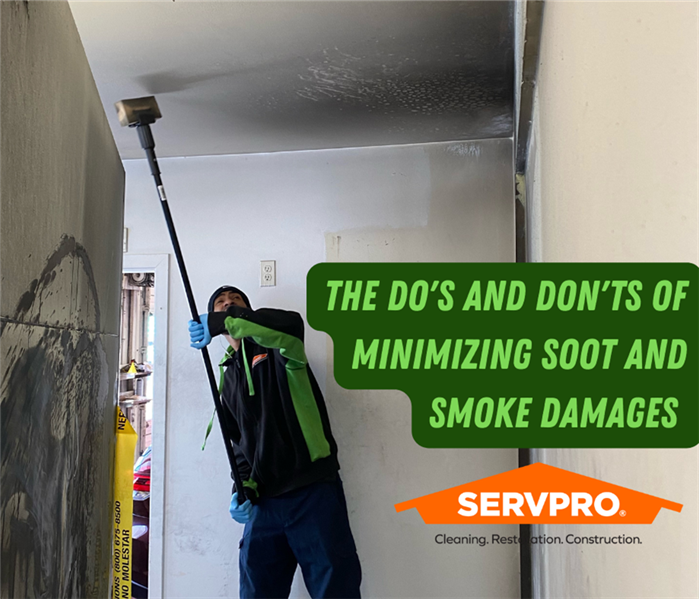 There are many ways to minimize the damage caused by soot and smoke.
There are many ways to minimize the damage caused by soot and smoke.
After experiencing fire damage, the soot and smoke damage which comes after can be difficult to restore. Knowing the best practices to remediate this damage is great information, but knowing how to prevent it is integral. Read information here on how to prevent damage from soot and smoke occurring.
DO:
- Limit movement in the home to prevent soot particles from being embedded into upholstery and carpets.
- Keep hands clean. Soot on hands can further soil upholstery, walls and woodwork.
- Brush vacuum loose soot particles from upholstery, drapes and carpet.
- Place clean towels or old linens on rugs, upholstery and carpet traffic areas.
- If electricity is off, empty freezer and refrigerator completely and prop doors open.
- Clean and protect chrome on kitchen and bathroom faucets, trim and appliances with light coating of Vaseline or oil.
- Wash house plants on both sides of leaves.
- Change HVAC filter.
- Tape double layers of cheesecloth over air registers.
DON’T:
- Don't attempt to wash any walls or painted surfaces or shampoo carpet or upholstery without contacting SERVPRO of Mobile County.
- Don't attempt to clean any electrical appliances, TV sets, radios, etc. that may have been close to fire, heat or water without first consulting an authorized repair service.
- Don't use any canned or packaged food or beverages that may have been stored near the fire, heat or water. They may have been contaminated.
- Don't turn on ceiling fixtures if ceiling is wet. The wiring may be damaged.
- Don't send garments to an ordinary dry cleaner. Improper cleaning may set smoke odor.
Even if your property didn’t suffer fire damage, there may be soot particles and residues left to clean up. If cleaned improperly, the odor and effects can linger long after the fire has been extinguished. From the structure itself to the contents inside SERVPRO of Norwood/West Roxbury utilizes the latest technology and training to make it "Like it never even happened." Contact us at (781) 769-9125
SERVPRO of Norwood West Roxbury Shares How to Deal with Fire and Smoke Damage in a Home or Business
1/7/2023 (Permalink)
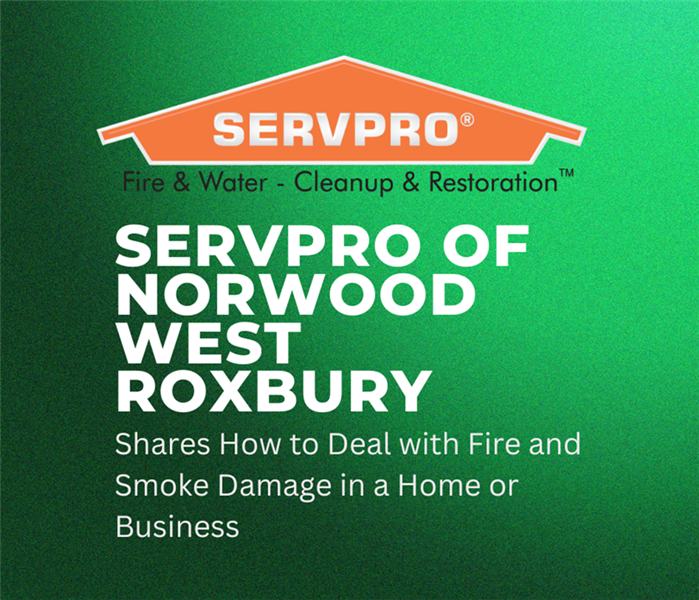 SERVPRO Norwood West Roxbury trained in a variety of different related clean-up including the latest professional equipment, tools, and procedures.
SERVPRO Norwood West Roxbury trained in a variety of different related clean-up including the latest professional equipment, tools, and procedures.
It is not common for fire loss, soot damage, or smoke damage problems to occur in any building.
When a firefighter enters a fire, their first defense is to use lots of water to extinguish the fire. The steps that firefighters take to control the fire will leave back ashes, fire loss, soot damage, smoke damage or air quality problems. You will need to hire a professional to get the remainder of the damage taken care of. SERVPRO of Norwood West Roxbury is trained in a variety of different related clean-up including the latest professional equipment, tools, and procedures.
With our fire cleanup efforts, the business can get back to business as soon as it is physically possible.
Smoke and fire damage situation is different for everyone, each situation requires a unique solution tailored to the specific conditions.
SERVPRO of Norwood West Roxbury is your premier choice for fire damage and restoration. Our teams are ready to respond 24 hours a week, any day of the year. When you bring us on the job our team of licensed contractors and certified technicians will work collaboratively with you throughout the duration of the project. They will keep you updated on the project's status and ensure that your expectations are met. We will help you to move forward and make it “Like it never even happened” for all of your fire damage.
SERVPRO of Norwood West Roxbury Shares Causes of a Flooded Basement.
1/7/2023 (Permalink)
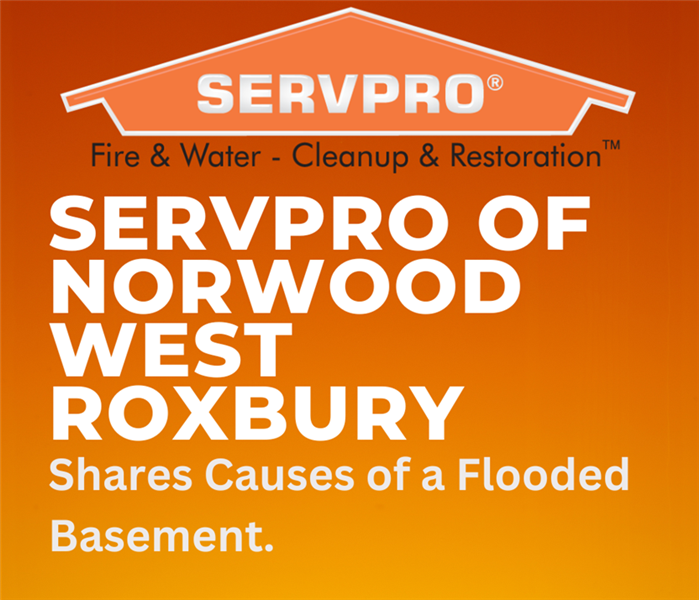 SERVPRO of Norwood West Roxbury is your premier choice for water damage and restoration.
SERVPRO of Norwood West Roxbury is your premier choice for water damage and restoration.
One of our recent projects was a flood in a local home. The SERVPRO of Norwood West Roxbury crews quickly restored their home.
A flooded basement can occur anytime, especially from weather related events such as heavy rainfall or rapid snowmelt to older homes.
Below are other causes of basement flooding:
- Foundation cracks
- Broken basement windows
- Poor-draining window wells
- Sewer system problems
- Sump pump problems
- Improperly sealed basement walls
- House located at the bottom of a slope
- Weeping tile blockage
- Overflowing rain gutters
- Improper downspout locations
- Appliance leaks
- Overflowing toilet or bathtub
- Drainage system failure
- Water heater failure
Proper home maintenance can prevent the problems. Make sure to check rain gutters and remove all debris, and seal cracks in your foundation.
SERVPRO of Norwood West Roxbury is your premier choice for water damage and restoration. Our teams are ready to respond 24 hours a week, any day of the year. When you bring us on the job our team of licensed contractors and certified technicians will work collaboratively with you throughout the duration of the project. They will keep you updated on the project's status and ensure that your expectations are met. We will help you to move forward and make it “Like it never even happened” for all of your water damage.
SERVPRO of Norwood West Roxbury Shares The Most Frequently Asked Questions About Fire Damage and Restoration
1/7/2023 (Permalink)
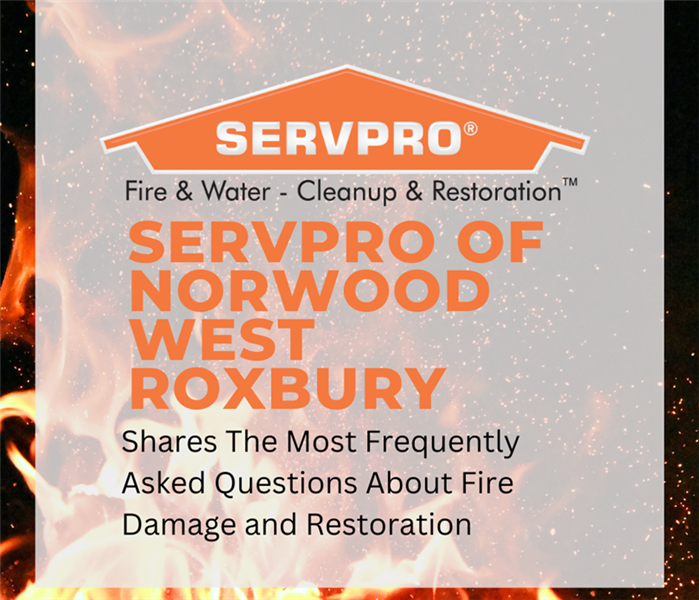 SERVPRO of Norwood West Roxbury is your premier choice for fire damage and restoration.
SERVPRO of Norwood West Roxbury is your premier choice for fire damage and restoration.
Surviving a fire can be a traumatic. After the flames have been put out and the smoke has cleared, it’s time to begin restoring your property.
We are sharing some of the top questions when it comes to fire damage.
- What Is the First Thing I Should Do After a Fire?: After the firefighters have put out the flames, it is a wise decision to call a fire damage restoration company immediately to begin the repairs.
- Can I Inspect My Home After a Fire?: No, you will want stay out of your property following a fire. Homes affected by a blaze are considered unstable and unsafe.
- How Do I Secure My Home After a Fire?: The damage restoration company can install board-ups and tarp covers to protect your home.
- If the Fire Damage Is Minor, Can I Clean It Myself?: No, this can put you and your loved ones in danger. Exposure to smoke and soot from fires can cause breathing difficulties.
- What Should I Do With the Water Used To Extinguish the Fire?: The fire damage repair team can extract the standing water using equipment such as sumps or extraction tools.
- Can Smoke Damage Be Removed? Smoke and soot damage on floors, walls, ceilings, and other surfaces might be tough to deal with, but they can be removed.
- Do I Need To Move Out During the Restoration Process? Yes, living in a fire-damaged home can be more stressful and unsafe.
- How Long Does Fire Damage Restoration Take?: The timeline for fire damage restoration project varies depending on the scope and severity of the damage.
SERVPRO of Norwood West Roxbury is your premier choice for fire damage and restoration. Our teams are ready to respond 24 hours a week, any day of the year. When you bring us on the job our team of licensed contractors and certified technicians will work collaboratively with you throughout the duration of the project. They will keep you updated on the project's status and ensure that your expectations are met. We will help you to move forward and make it “Like it never even happened” for all of your fire damage.
SERVPRO of Norwood West Roxbury Shares Frozen Pipe Information
12/4/2022 (Permalink)
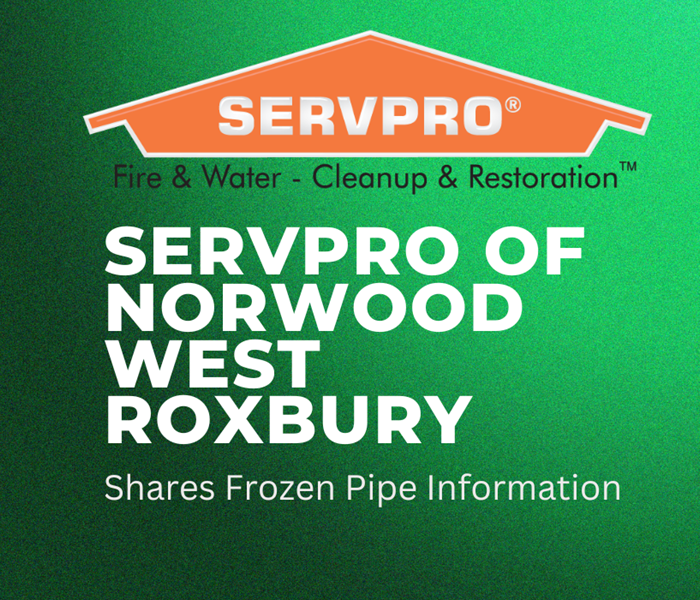 Pipes will eventually unfreeze on their own naturally. However, this takes time and could cause pipes to burst.
Pipes will eventually unfreeze on their own naturally. However, this takes time and could cause pipes to burst.
Winter months calls for frozen pipes. It is important to know and understand what this means to prevent damage to your building.
Pipes will eventually unfreeze on their own naturally. However, this takes time and could actually cause more damage because it could eventually lead to the pipe bursting.
Here is what you should do if you suspect you have frozen pipes.
- Check with a neighbor to see if they’re experiencing frozen pipes too. If they have running water, it’s likely your pipes have frozen.
- Turn off the water immediately using the main shut off valve.
- Open the faucet for water to flow through the pipe once the area is melted.
- Apply heat around the pipe using a hair dryer. Keep all heat sources away from flammable materials.
- Once pipes are thawed, you can turn the water back on and check all joints for leaks.
- Check all pipes and joints for leaks or cracks.
If there are still issues, do not wait to address them, and contact an experienced water restoration company.
SERVPRO of Norwood West Roxbury is your premier choice for water damage and restoration. Our teams are ready to respond 24 hours a week, any day of the year. When you bring us on the job our team of licensed contractors and certified technicians will work collaboratively with you throughout the duration of the project. They will keep you updated on the project's status and ensure that your expectations are met. We will help you to move forward and make it “Like it never even happened” for all of your water damage.
SERVPRO of Norwood West Roxbury Holiday Safety Advice
12/4/2022 (Permalink)
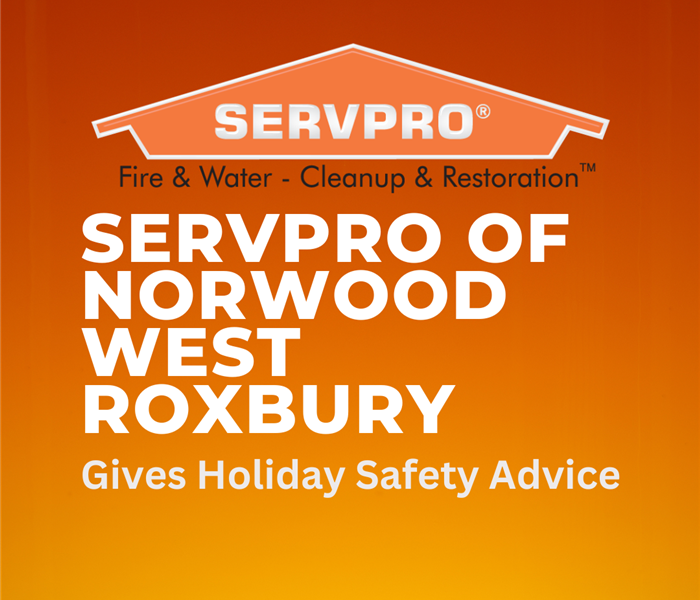 With proper Christmas lights preparation and safe practices, you can avoid those dangerous situations while decorating.
With proper Christmas lights preparation and safe practices, you can avoid those dangerous situations while decorating.
It is everyone’s favorite time of the year! With Christmas, there can be more fires than normal. Christmas lights make the holiday season bright; we decorate trees and homes with lights.
These decorations can have a risk though and electrocution is possible. With proper preparation and safe practices, you can avoid those dangerous situations while decorating.
Here are the safety tips you need to know.
- A missing or broken bulb can lead to shocks or even fires.
- Replace any broken bulbs before you string up your home or tree.
- If you decorate your home's exterior, make sure to use a ladder that isn’t metal.
- Make sure to use lights that are labeled indoors for your indoor lights and ones labeled outdoors for your outdoor lights.
- Check to make sure your lights are labeled as waterproof, especially outdoors.
- Always use an extension cord that is rated for outdoor use.
- Keep your cords from sitting on the ground.
- Make sure your light cord and your extension cord stay out of puddles or snow.
- Keep your light strands off the ground.
- Don't make your lights a year-long attraction. Lights, including smart lights, should not be used for long terms.
- Leave cords out of doors and windows. The cord could become pinched. This can ruin the insulation around the wires and lead to a shock.
Should you experience a fire, call 911 immediately and call your local fire restoration company.
SERVPRO of Norwood West Roxbury is your premier choice for fire damage and restoration. Our teams are ready to respond 24 hours a week, any day of the year. When you bring us on the job our team of licensed contractors and certified technicians will work collaboratively with you throughout the duration of the project. They will keep you updated on the project's status and ensure that your expectations are met. We will help you to move forward and make it “Like it never even happened” for all of your fire damages.
SERVPRO of Norwood West Roxbury Is The Choice For Rebuilding Homes and Businesses
12/4/2022 (Permalink)
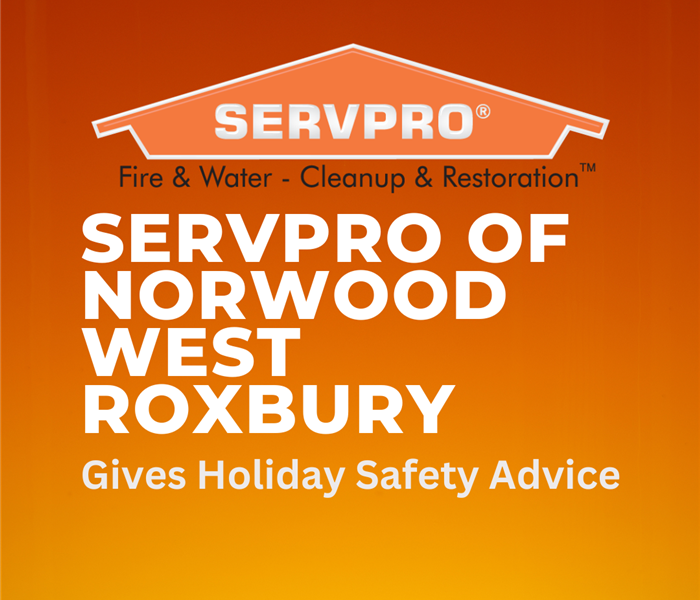 Whenever there is a fire, it is important to hire licensed professionals.
Whenever there is a fire, it is important to hire licensed professionals.
A fire in a building is one of the most devastating things anyone faces.
If you ever find yourself in this situation, take a deep breath and know it will be okay.
We provide fire restoration services in SERVPRO of Norwood West Roxbury every day. We know it is a huge project, but it’s easier to manage when you know what to expect.
Whenever there is a fire, it is important to hire licensed professionals.
Here are steps to rebuilding a fire-damaged house.
- Call your insurance company: It’s important to set the claims process in motion as soon as possible. You can ask for a preferred restoration company they have, or hire us.
- Asses your building damage: Your restoration contractor can recommend a structural engineer to make sure it is safe to begin work.
- Have the property secured: secure all but one entryway, and board up broken windows.
- Address structural repairs: You will want experienced and professional carpenters to take care of heavy repairs.
- Inspect and repair electricity: the fire might not have destroyed your entire home, but the electrical system must be inspected and repaired by a licensed electrician.
- Address problems with the fire damage: Your restoration contractor can find any additional problems such as mold growth in damp sheetrock, smoke stains and soot residue, and more.
- Clean up by room: Fire restoration can take several months: The company will replace ruined sheetrock, restore fire-damaged floors and even help you salvage furnishings. It is important to not rush the process
- Document everything: The cost to rebuild after a fire can be very expensive. Make sure to document everything for yourself and your insurance company.
With the combined talent and experience of carpenters, electricians, and fire restoration services, homes can be successfully rebuilt.
SERVPRO of Norwood West Roxbury is your premier choice for fire damage and restoration. Our teams are ready to respond 24 hours a week, any day of the year. When you bring us on the job our team of licensed contractors and certified technicians will work collaboratively with you throughout the duration of the project. They will keep you updated on the project's status and ensure that your expectations are met. We will help you to move forward and make it “Like it never even happened” for all of your fire damages.
SERVPRO of Norwood West Roxbury Is The Choice For Rebuilding Homes and Businesses
12/4/2022 (Permalink)
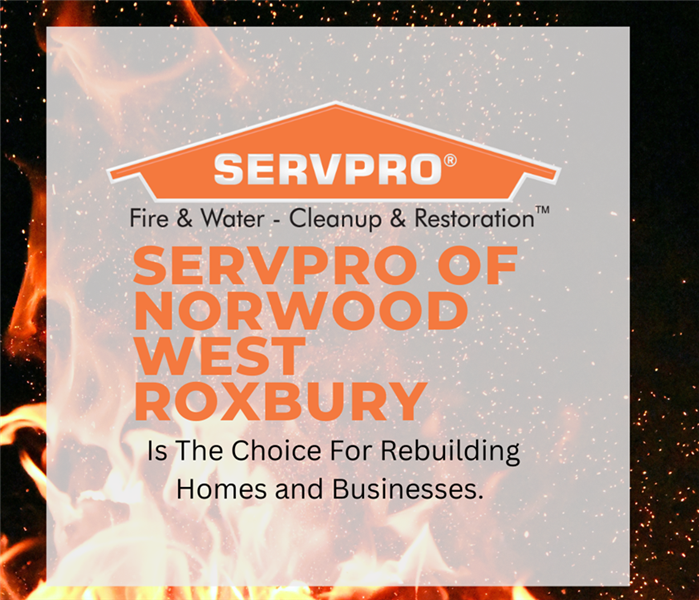 Whenever there is a fire, it is important to hire licensed professionals.
Whenever there is a fire, it is important to hire licensed professionals.
A fire in a building is one of the most devastating things anyone faces.
If you ever find yourself in this situation, take a deep breath and know it will be okay.
We provide fire restoration services in SERVPRO of Norwood West Roxbury every day. We know it is a huge project, but it’s easier to manage when you know what to expect.
Whenever there is a fire, it is important to hire licensed professionals.
Here are steps to rebuilding a fire-damaged house.
- Call your insurance company: It’s important to set the claims process in motion as soon as possible. You can ask for a preferred restoration company they have, or hire us.
- Asses your building damage: Your restoration contractor can recommend a structural engineer to make sure it is safe to begin work.
- Have the property secured: secure all but one entryway, and board up broken windows.
- Address structural repairs: You will want experienced and professional carpenters to take care of heavy repairs.
- Inspect and repair electricity: the fire might not have destroyed your entire home, but the electrical system must be inspected and repaired by a licensed electrician.
- Address problems with the fire damage: Your restoration contractor can find any additional problems such as mold growth in damp sheetrock, smoke stains and soot residue, and more.
- Clean up by room: Fire restoration can take several months: The company will replace ruined sheetrock, restore fire-damaged floors and even help you salvage furnishings. It is important to not rush the process
- Document everything: The cost to rebuild after a fire can be very expensive. Make sure to document everything for yourself and your insurance company.
With the combined talent and experience of carpenters, electricians, and fire restoration services, homes can be successfully rebuilt.
SERVPRO of Norwood West Roxbury is your premier choice for fire damage and restoration. Our teams are ready to respond 24 hours a week, any day of the year. When you bring us on the job our team of licensed contractors and certified technicians will work collaboratively with you throughout the duration of the project. They will keep you updated on the project's status and ensure that your expectations are met. We will help you to move forward and make it “Like it never even happened” for all of your fire damages.
SERVPRO of Norwood West Roxbury Celebrates Thanksgiving
11/5/2022 (Permalink)
 Happy Thanksgiving from all of us at SERVPRO of Norwood West Roxbury.
Happy Thanksgiving from all of us at SERVPRO of Norwood West Roxbury.
Thanksgiving Day is an annual national holiday in the United States and is a day to celebrate the harvest and other blessings of the past year. It is a time for gathering with loved ones. However, oftentimes safety can be a concern when cooking.
Here are the top safety tips:
- Stay in the kitchen when you are cooking
- Stay home when cooking your turkey and check on it frequently.
- Keep children away from the stove.
- Make sure kids stay away from hot food.
- Keep knives out of the reach of children.
- Keep matches and lighters out of the reach of children.
- Never leave children alone in a room with a lit candle.
- Keep the floor clear so you don’t trip.
- Make sure your smoke alarms are working.
Above all else, Happy Thanksgiving from all of us at SERVPRO of Norwood West Roxbury.
SERVPRO of Norwood West Roxbury is your premier choice for restoration and rebuilding. Our teams are ready to respond 24 hours a week, any day of the year. When you bring us on the job our team of licensed contractors and certified technicians will work collaboratively with you throughout the duration of the project. They will keep you up to date on the status of the project and make sure that your expectations are met. We will help you to move forward and make it “Like it never even happened” for all of your storm damage.
SERVPRO of Norwood West Roxbury Helps Businesses Prepare For Flooding.
11/5/2022 (Permalink)
 Flooding happens more often than we'd like. It is critical that businesses are prepared for natural disasters.
Flooding happens more often than we'd like. It is critical that businesses are prepared for natural disasters.
Flooding happens more often than we'd like. It is critical that businesses are prepared for natural disasters. It is recommended to have flood insurance and tools that mitigate total loss in emergency situations.
According to the Federal Emergency Management Agency (FEMA), flooding occurs in over 90 percent of disasters, averaging 17 billion dollars of damage each year.
Here are some helpful tips:
- Analyze flood maps: FEMA is the most reliable resource for this. They provide flood maps that are updated regularly.
- Conduct risk analysis: Storms can completely destroy a given area. FEMA states that as little as one inch of flood water can cause $25,000 in damage. This can cause the company operations issues for an unforeseen amount of time.
- Generate a disaster plan: Having a disaster plan is a great way to maintain calmness. Train your employees with steps in your disaster plan.
- Obtain commercial flood insurance: You will want to establish your risk analysis. This will give you an idea of what type of commercial flood insurance to purchase.
- Protect business information: When flooding does occur, it can be hard to salvage equipment and paperwork.
- Purchase flood boards: If you are in a flood-prone area or at risk of flooding you will want to consider this.
- Raise electrical sockets, fuse boxes, and wiring: Moving electrical wiring to a safe height is simple.
- Install non-return valves: Businesses should consider the installation of non-return valves for drains. This can be an added layer of protection during flooding.
SERVPRO of Norwood West Roxbury is your premier choice for restoration and rebuilding. Our teams are ready to respond 24 hours a week, any day of the year. When you bring us on the job our team of licensed contractors and certified technicians will work collaboratively with you throughout the duration of the project. They will keep you up to date on the status of the project and make sure that your expectations are met. We will help you to move forward and make it “Like it never even happened” for all of your storm damage.
SERVPRO of Norwood West Roxbury Helps Prepare For Winter Storms
11/5/2022 (Permalink)
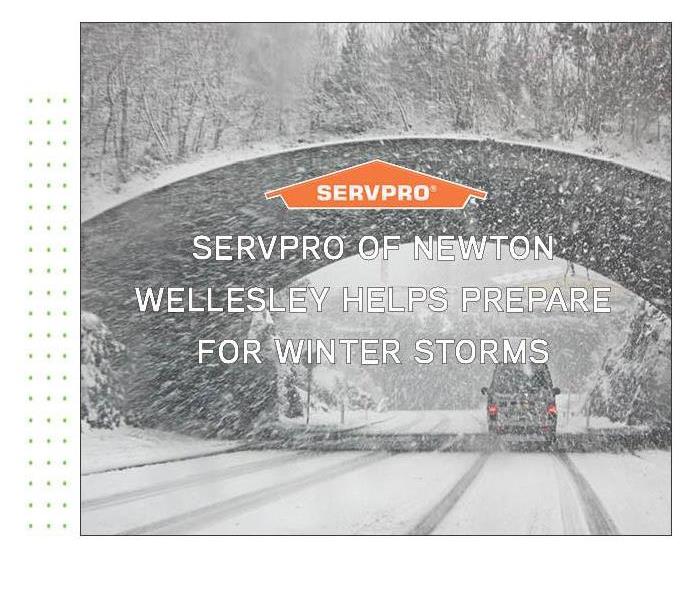 It is important to know what to do before the winter weather arrives.
It is important to know what to do before the winter weather arrives.
Winter storms can create a higher risk of car accidents, carbon monoxide poisoning, and more.
They can also create blizzard conditions, freezing rain, snow, ice, extreme cold, and high winds. They might even last for several days which can cut off heat, and cause power outages.
It is important to know what to do before the winter weather arrives.
Here are some quick winter storm tips:
- Install caulking and weather stripping around doors and windows.
- Insulate pipes to reduce freezing.
- Install and test smoke alarms and carbon monoxide detectors.
- Pay attention to weather reports and warnings.
- Sign up for your community’s warning system such as Emergency Alert System (EAS) and NOAA Weather Radio.
- Gather supplies or restock your disaster supply kits.
- Remember the needs of your pets.
- Have extra batteries for radios, flashlights and cellphones.
- Create an emergency supply kit for your vehicle. Include jumper cables, sand, a flashlight (hand-crank or battery-operated), first aid kit, etc.
- If you must go outside, dress in layers.
Winter storms are not fun, but it is mother nature and we can not prevent it. The best thing to do is be prepared for a storm.
SERVPRO of Norwood West Roxbury is your premier choice for restoration and rebuilding. Our teams are ready to respond 24 hours a week, any day of the year. When you bring us on the job our team of licensed contractors and certified technicians will work collaboratively with you throughout the duration of the project. They will keep you up to date on the status of the project and make sure that your expectations are met. We will help you to move forward and make it “Like it never even happened” for all of your storm damage.
SERVPRO of Norwood West Roxbury Recognizes Fire Prevention Week
10/5/2022 (Permalink)
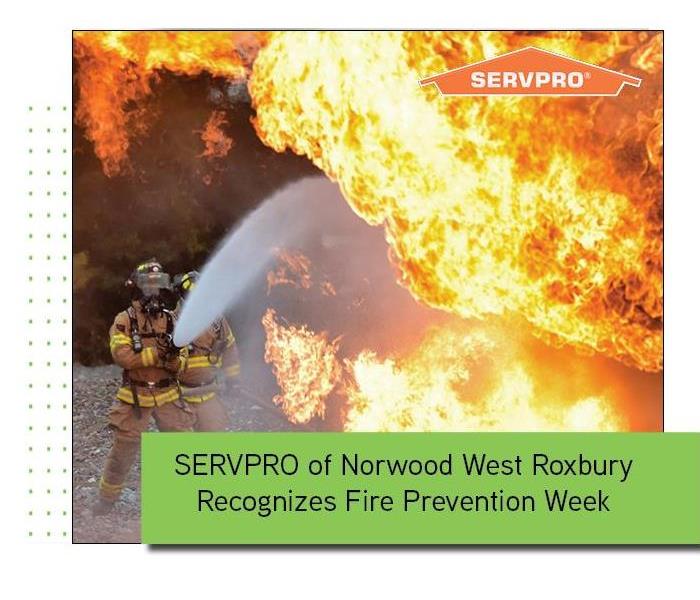 It is important for everyone to plan and practice a home fire escape. It is important everyone knows what to do when the smoke alarm sounds.
It is important for everyone to plan and practice a home fire escape. It is important everyone knows what to do when the smoke alarm sounds.
On October 9th, 1911 over 250 people died and buildings were destroyed by a fire. In 1922, President Harding proclaimed National Fire Prevention Week.
Here are some tips to help you with fire prevention.
- Install and maintain smoke detectors.
- Have a fire escape plan and practice it with your family.
- Keep matches and lighters out of the hands of children.
- Have home heating systems and chimneys inspected?
It is important for everyone to plan and practice a home fire escape. It is important everyone knows what to do when the smoke alarm sounds.
Have a plan for everyone in the home, and make sure they know what to do. Smoke alarms sense smoke well before you can, alerting you to danger, this is why it is important to have one in every bedroom.
SERVPRO of Norwood West Roxbury is your premier choice for restoration and rebuilding. Our teams are ready to respond 24 hours a week, any day of the year. When you bring us on the job our team of licensed contractors and certified technicians will work collaboratively with you throughout the duration of the project. They will keep you up to date on the status of the project and make sure that your expectations are met. We will help you to move forward and make it “Like it never even happened” for all of your storm damage.
SERVPRO of Norwood West Roxbury Explains Fire Prevention Day
10/5/2022 (Permalink)
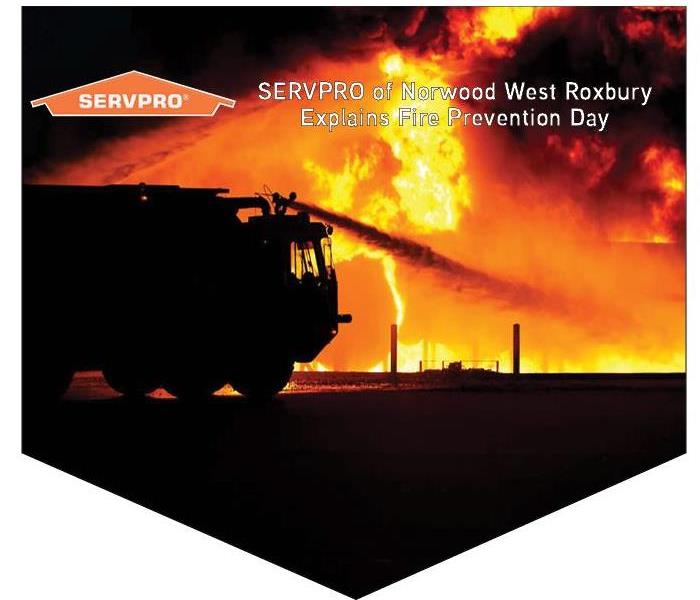 It is important to create awareness of fires and know how to participate because we never know when a fire can happen.
It is important to create awareness of fires and know how to participate because we never know when a fire can happen.
On October 8, 1871, Mrs. O’Leary was in her barn, milking her cow. The cow kicked over a lamp, which started the Great Chicago Fire of 1871. More than 300 people were killed, 100,000 people were left homeless, and over 17,000 structures were destroyed. This and other major fires caused a movement to proclaim this holiday, National Fire Prevention Day on October 9th. (nfpa.org)
It is important to create awareness of fires and know how to participate because we never know when a fire can happen.
- Fire departments around the country hold sessions and seminars to teach fire prevention and safety.
- Schools have fire drills and hold lessons on fire prevention.
- Families conduct an EDITH exercise (Exit Drills In The Home). If you need assistance with this, reach out to your local fire department.
- Businesses should conduct fire drills. Set up an escape plan.
- Learn more about fires both nationally and locally.
Fires are never something that anyone anticipates happening, but they happen more often than not, it is important to be prepared as best as you can.
SERVPRO of Norwood West Roxbury is your premier choice for restoration and rebuilding. Our teams are ready to respond 24 hours a week, any day of the year. When you bring us on the job our team of licensed contractors and certified technicians will work collaboratively with you throughout the duration of the project. They will keep you up to date on the status of the project and make sure that your expectations are met. We will help you to move forward and make it “Like it never even happened” for all of your storm damage
Fall Safety From SERVPRO of Norwood West Roxbury
10/5/2022 (Permalink)
 Fall has arrived, and it is a good idea for everyone in your home to refresh their fall fire safety tips.
Fall has arrived, and it is a good idea for everyone in your home to refresh their fall fire safety tips.
Fall has arrived, and it is a good idea for everyone in your home to refresh their fall fire safety tips.
These fire tips are especially important for children and families.
- Check Smoke Detectors & Fire Extinguishers.
- Change batteries in smoke detectors and carbon monoxide detectors.
- Verify that smoke detectors are working.
- Make sure that there are smoke detectors in your home.
- Make sure everyone knows how to use a fire extinguisher.
- Make Sure All Heating Sources Work Properly
- Verify that everything you need to keep your home warm throughout fall and winter is working.
- Make sure that any space heaters are surrounded by at least three feet of empty space.
- Never place clothing or any other objects on a space heater.
- Do not place space heaters near furniture or drapery.
If you aren’t sure about any of these tips, reach out to a local firefighter, they will be able to assist you and answer any questions.
SERVPRO of Norwood West Roxbury is your premier choice for restoration and rebuilding. Our teams are ready to respond 24 hours a week, any day of the year. When you bring us on the job our team of licensed contractors and certified technicians will work collaboratively with you throughout the duration of the project. They will keep you up to date on the status of the project and make sure that your expectations are met. We will help you to move forward and make it “Like it never even happened” for all of your storm damage.
SERVPRO of Norwood West Roxbury Shares Halloween Safety
10/5/2022 (Permalink)
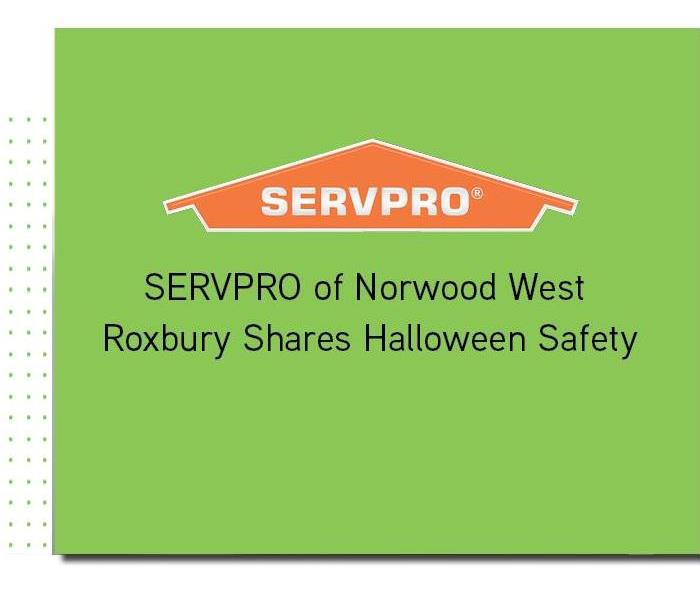 More than twice as many children are killed in pedestrian-car crashes between the hours of 4 and 10 PM on Halloween.
More than twice as many children are killed in pedestrian-car crashes between the hours of 4 and 10 PM on Halloween.
More than twice as many children are killed in pedestrian-car crashes between the hours of 4 and 10 PM on Halloween. This is because drivers not being aware of their surroundings. (National Highway Traffic Safety Administration).
However, safety is important for everyone. Here are a few tips to help be safe this holiday:
- Wear bright clothes. If your costume is dark use reflectors.
- Hold onto your child’s hand.
- Always try to cross crosswalks and be alert.
- Look every which way before you do cross the street.
- Do not jaywalk.
- Wait for the car to the first pass where you want to cross.
- All drivers should stay off their cell phones.
- If you are partying instead of trick or treating, stay sober or find another ride home.
- Wait behind other vehicles that are pulled over, because they may be dropping off children.
- Warn children that they are not to get into the car of anyone they do not know.
- Make sure to have fun!
Above all else, have fun and stay safe. After all, this holiday is met to be fun for free candy.
SERVPRO of Norwood West Roxbury is your premier choice for restoration and rebuilding. Our teams are ready to respond 24 hours a week, any day of the year. When you bring us on the job our team of licensed contractors and certified technicians will work collaboratively with you throughout the duration of the project. They will keep you up to date on the status of the project and make sure that your expectations are met. We will help you to move forward and make it “Like it never even happened” for all of your storm damage.
SERVPRO of Norwood West Roxbury Explains How To Burn Leaves Safely
10/5/2022 (Permalink)
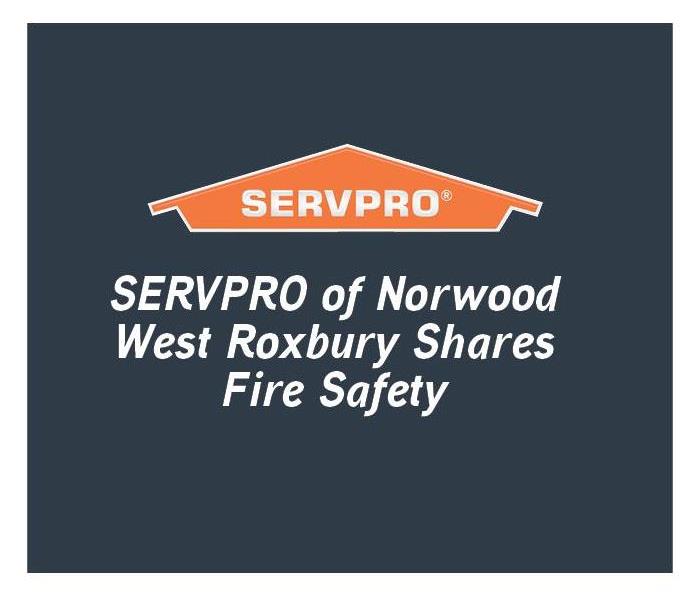 People like to burn leaves or throw trash onto piles, such as household garbage, construction debris, or old papers. This can actually cause damage.
People like to burn leaves or throw trash onto piles, such as household garbage, construction debris, or old papers. This can actually cause damage.
Falling leaves are the first signs of the fall season. Many are faced with how to dispose of them!
People like to burn leaves or throw trash onto piles, such as household garbage, construction debris, or old papers. This can actually cause more damage than good.
Burning materials such as yard waste, grass clippings, and leaves may be permissible depending on your town’s ordinances. If you decide to burn leaves, do not use flammable liquids to ignite the debris. Keep an eye on the fire at all times and be prepared to extinguish it at any moment. Safety should always be the number one concern.
There are plenty of safe alternatives for you to do instead of burning leaves.
- You can recycle tree limbs, grass clippings, and leaves.
- You can also compost items into mulch or chipped them into landscaping material.
- Many cities and towns provide a curbside collection of bagged leaves. Check with your local public works department.
- Call a yard waste or junk removal service, they will take the debris to the dump or recycling center.
There are plenty of ways to get rid of your leaves this fall, it just depends on what works best for you. Remember safety first; prevent a fire if you are able to.
SERVPRO of Norwood West Roxbury is your premier choice for restoration and rebuilding. Our teams are ready to respond 24 hours a week, any day of the year. When you bring us on the job our team of licensed contractors and certified technicians will work collaboratively with you throughout the duration of the project. They will keep you up to date on the status of the project and make sure that your expectations are met. We will help you to move forward and make it “Like it never even happened” for all of your storm damage.
SERVPRO of Norwood West Roxbury Shares Fire Safety
10/5/2022 (Permalink)
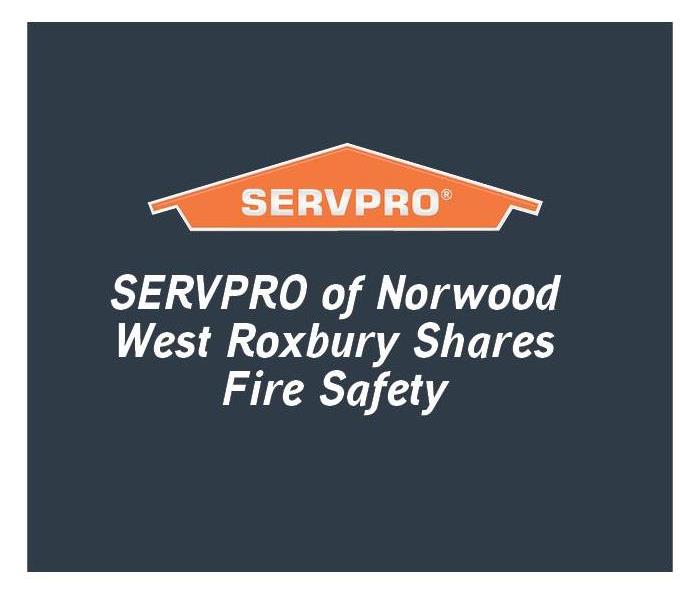 Always put your safety first; if you are not confident in your ability to use a fire extinguisher, get out and call 9-1-1.
Always put your safety first; if you are not confident in your ability to use a fire extinguisher, get out and call 9-1-1.
Cooking and heating are the leading causes of home fires during the winter months. Here are some quick and easy tips to help prevent a fire in and around your building.
- Be alert when cooking; if you are sleepy or have consumed alcohol, don’t use the oven or stovetop
- Stay in the kitchen while you are frying, grilling, boiling, or broiling food
- When simmering, baking, or roasting, check the food regularly, remain in the kitchen while cooking, and use a timer
- Keep anything that can catch fire away from your stovetop
- Keep all flammables, like paper, clothing, bedding, drapes, or rugs, at least 3 feet from a space heater, stove, or fireplace
- Never leave portable heaters and fireplaces unattended; turn off heaters and make sure fireplace embers are extinguished before leaving the room
- If you must use a space heater, place it on a level, nonflammable surface, like ceramic tile, not on a rug or carpet
- Keep children and pets away from space heaters
- Institute a “no smoking” policy in the house
- Check all cords and replace any that are frayed or have bare wires
- Switch to flameless candles
- Smoke alarms are a key part of a home fire escape plan providing early warning to reduce your risk of dying in a fire.
- Use special alarms with strobe lights and bed shakers for people who are hard of hearing or deaf
- Replace smoke alarms that are 10 or more years old
- Make an Escape Plan
Everyone needs to know your family's escape plan. The National Fire Protection Association indicates that 71% of Americans have a home fire escape plan but only 47% have practiced it. Practice getting out with your eyes closed, crawling low to the floor, and keeping your mouth covered.
Always put your safety first; if you are not confident in your ability to use a fire extinguisher, get out and call 9-1-1.
SERVPRO of Norwood West Roxbury is your premier choice for restoration and rebuilding. Our teams are ready to respond 24 hours a week, any day of the year. When you bring us on the job our team of licensed contractors and certified technicians will work collaboratively with you throughout the duration of the project. They will keep you up to date on the status of the project and make sure that your expectations are met. We will help you to move forward and make it “Like it never even happened” for all of your storm damage.
SERVPRO of Norwood West Roxbury Shares What To Do If You Have a Tornado Warning
9/16/2022 (Permalink)
 If you have a tornado warning, shelter is critical for your safety. Have a safe room that is away from any doors or windows.
If you have a tornado warning, shelter is critical for your safety. Have a safe room that is away from any doors or windows.
If you have a tornado warning, shelter is critical for your safety. Have a safe room that is away from any doors or windows.
If you don't have a safe room or basement, you should look around your home to determine the best place.
Here are Some Ideas:
- Bathrooms might be a good shelter, but they should not have outside walls or windows.
- Closets are another option; they should be deep inside with no outside walls, doors, or windows.
- A hallway is another great option. Be sure to shut all doors, and to create as many barriers as possible.
SERVPRO of Norwood West Roxbury is your premier choice for restoration and rebuilding. Our teams are ready to respond 24 hours a week, any day of the year. When you bring us on the job our team of licensed contractors and certified technicians will work collaboratively with you throughout the duration of the project. They will keep you up to date on the status of the project and make sure that your expectations are met. We will help you to move forward and make it “Like it never even happened” for all of your storm damages.
September is National Preparedness Month
9/16/2022 (Permalink)
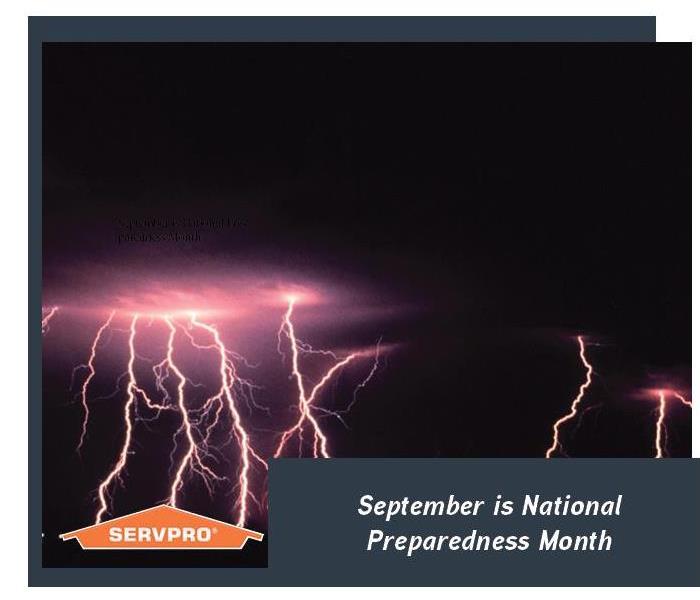 Each September we recognize National Preparedness Month. It was created to promote family and community disaster planning now, but also in the future.
Each September we recognize National Preparedness Month. It was created to promote family and community disaster planning now, but also in the future.
Each September we recognize National Preparedness Month. It was created to promote family and community disaster planning now, but also in the future.
Here are some tips to help plan:
- You need an emergency plan! Planning for emergencies is essential because they can happen to anyone at any time.
- If your emergency supply kit is already stocked, make sure that the items are not expired. For example, are the batteries still working?
- Make sure to cut back trees and shrubs that are too close to your house, so it can prevent damage in storm season.
- Make sure that those around you are prepared. Include your children in your preparedness drills and know your emergency plans of what to do if you need to evacuate or shelter in place.
SERVPRO of Norwood West Roxbury is your premier choice for restoration and rebuilding. Our teams are ready to respond 24 hours a week, any day of the year. When you bring us on the job our team of licensed contractors and certified technicians will work collaboratively with you throughout the duration of the project. They will keep you up to date on the status of the project and make sure that your expectations are met. We will help you to move forward and make it “Like it never even happened” for all of your storm damages.
SERVPRO of Norwood West Roxbury Shares Storm Safety
9/16/2022 (Permalink)
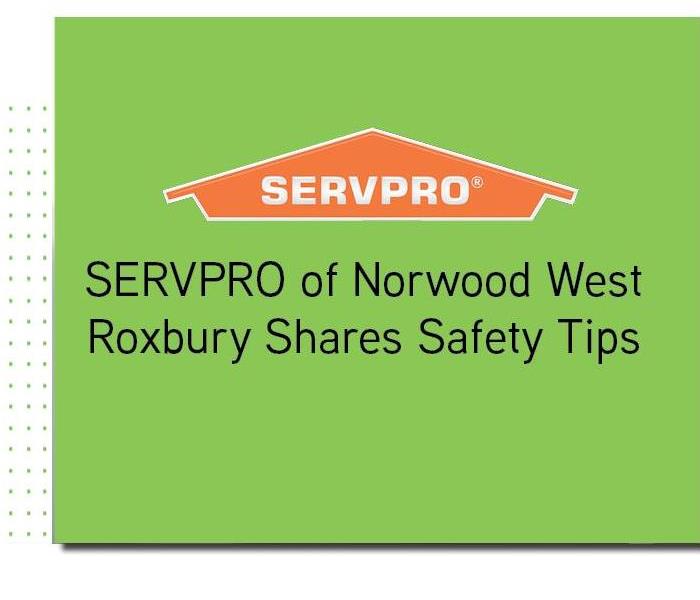 Everyone should be prepared in case of a disaster, as best as they can be.
Everyone should be prepared in case of a disaster, as best as they can be.
Everyone should be prepared in case of a disaster, as best as they can be. If you haven't taken the time to think about how disasters could effect you, then it is time to become educated to help save you and your family.
- Make sure you are always informed, and receive important lifesaving alerts from your local community.
- You can also receive wireless emergency alerts such as a NOAA Weather Radio, or follow social media.
- Know which natural disasters can occur in your area and how to prepare in advance.
- Make sure you know where the nearest shelters are. You might also want to know evacuation routes.
- It is important to make a family emergency plan that can be put into action.
SERVPRO of Norwood West Roxbury is your premier choice for restoration and rebuild. Our teams are ready to respond 24 hours a week, any day of the year. When you bring us on the job our team of licensed contractors and certified technicians will work collaboratively with you throughout the duration of the project. They will keep you up to date on the status of the project and make sure that your expectations are met. We will help you to move forward and make it “Like it never even happened” for all of your storm damages.
SERVPRO of Norwood West Roxbury Shares Safety Tips
9/16/2022 (Permalink)
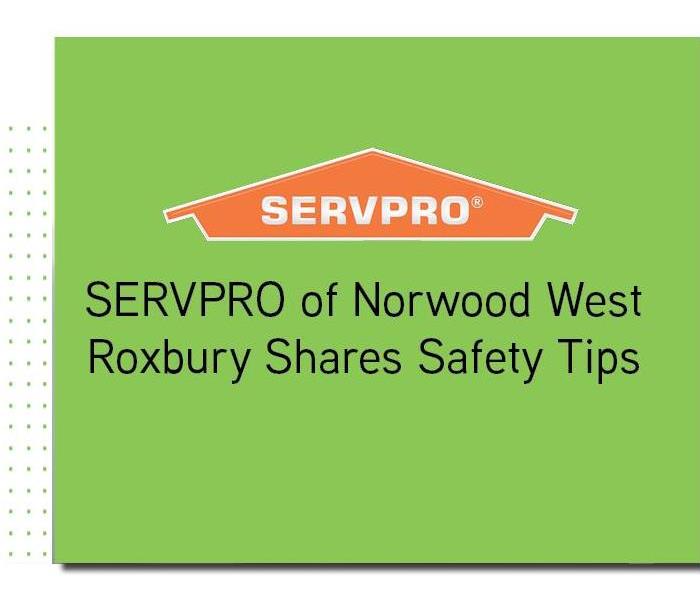 National Preparedness Month, which is September, encourages and reminds people to be prepared for disasters or emergencies in their communities.
National Preparedness Month, which is September, encourages and reminds people to be prepared for disasters or emergencies in their communities.
National Preparedness Month, which is September, encourages and reminds people to be prepared for disasters or emergencies in their communities.
This is the time to find ways to help others understand more about preparing for disasters and reducing risks to health and the environment.
- Generator: Know ahead of time where you would run a generator. The generator exhaust is not good for you to inhale. Make sure to always put generators outside well away from doors, windows, and vents.
- Water: If drinking water is from a private well, know your contacts for inspecting the safety of your drinking water after a flood.
- Septic system: Make sure to know whom to call to have it inspected after a flood.
- Communities: Plan ahead for large amounts of disaster debris from damaged or destroyed buildings, supplies, trees or other green waste, or other materials.
SERVPRO of Norwood West Roxbury is your premier choice for restoration and rebuild. Our teams are ready to respond 24 hours a week, any day of the year. When you bring us on the job our team of licensed contractors and certified technicians will work collaboratively with you throughout the duration of the project. They will keep you up to date on the status of the project and make sure that your expectations are met. We will help you to move forward and make it “Like it never even happened” for all of your storm damages.
Fire Safety Tips for Fall
9/16/2022 (Permalink)
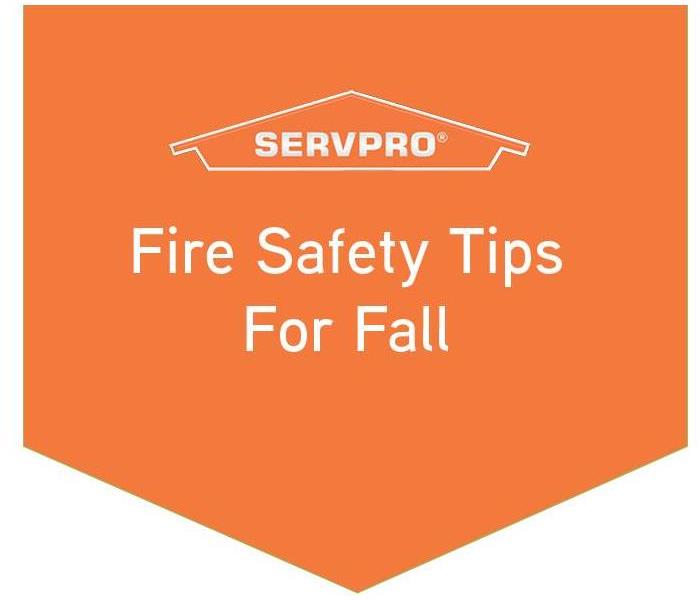 Fall is a great time for many people to enjoy the beautiful crisp weather, but along with that comes several dangers especially fires.
Fall is a great time for many people to enjoy the beautiful crisp weather, but along with that comes several dangers especially fires.
When the weather turns cold most people spend more time inside their homes. This is simply because people are using fireplaces, furnaces, and heaters to keep warm. However, make sure to understand the dangers that can come of it.
Here are some tips to help prevent fires:
- Service Your Furnace: Before the cold winter weather sets in, call your heating and cooling company to service your furnace. It is good to have an inspection to make sure everything is in working order and there are no leaks.
- Use Fireplaces Safely: Keep fire in its proper place by using a fireplace screen. This will keep sparks from flying out of the fireplace.
- Use Caution with Space Heaters: A space heater can be an effective way to warm up a chilly room. Your space heater may require venting, so make sure you have vented it to the outdoors. There should be at least three feet of empty area around space heaters.
- Reconsider Leaf Burning: Burning leaves produces dangerous and cancer-causing chemicals. Homeowners should avoid disposing of leaves this way.
- Exercise Candle Caution: Candles are a great way to give a room some light, and also smell. They can also cause fires. Never leave candles burning unattended.
- Change Smoke Alarm Batteries: It is wise to change the batteries in your smoke alarms and carbon monoxide detectors when you turn back your clocks for Daylight Saving Time.
- Safety Tips for Fall Driving: There's nothing more beautiful than a fall drive, but weather can cause dangerous roads.
Fall is a great time for many people to enjoy the beautiful crisp weather, but along with that comes several dangers especially fires.
SERVPRO of Norwood West Roxbury is your premier choice for restoration and rebuilding. Our teams are ready to respond 24 hours a week, any day of the year. When you bring us on the job our team of licensed contractors and certified technicians will work collaboratively with you throughout the duration of the project. They will keep you up to date on the status of the project and make sure that your expectations are met. We will help you to move forward and make it “Like it never even happened” for all of your fire damages.
Fall Home Maintenance Checklist
9/16/2022 (Permalink)
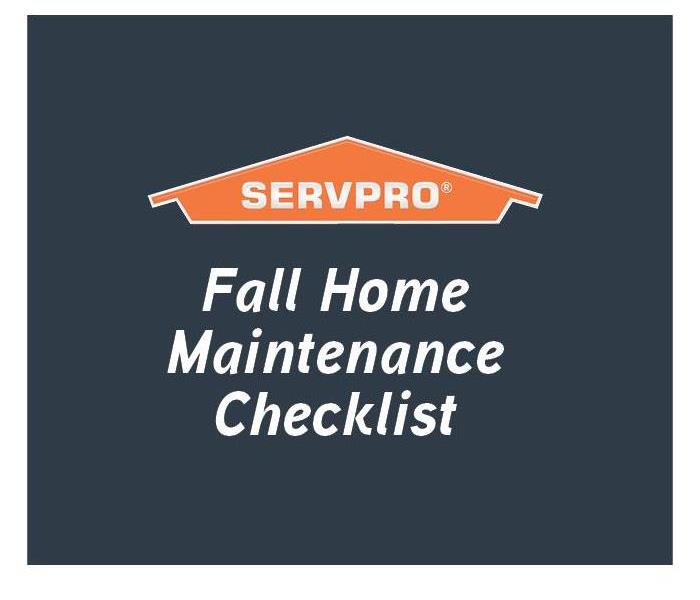 Here are some home maintenance ideas that will keep your home running in peak condition all winter long.
Here are some home maintenance ideas that will keep your home running in peak condition all winter long.
It is time to get your house in shape for the cooler months ahead. Here are some home maintenance ideas that will keep your home running in peak condition all winter long.
Exterior Maintenance
- You will want to check the foundation for cracks and caulk such as where pipes or wires enter the house; this can save you money in the long run.
- Make sure you have storm windows and doors and remove screens.
- Inspect exterior walls to see if any paint is peeling or blistering on the house or outbuildings. Peeling paint is a sign that the existing paint film is failing.
- Make sure the roof is in good shape and make sure there are not any lose shingles. If not taken care of, damage can happen with deterioration to insulation, wood, and drywall.
Interior Maintenance
- Air from windows and doors is easy to find, make sure to apply weather stripping and caulk to areas that have air venting issues.
- Change the direction of your ceiling fan to create an upward draft that redistributes warm air from the ceiling.
- Check basement windows for drafts, loose frames, or cracked panes.
- Vacuum internal parts of air conditioners.
- Clean your humidifiers regularly during the heating season. Bacteria and spores can develop in a dirty water tank resulting in unclean moisture.
SERVPRO of Norwood West Roxbury is your premier choice for restoration and rebuild. Our teams are ready to respond 24 hours a week, any day of the year. When you bring us on the job our team of licensed contractors and certified technicians will work collaboratively with you throughout the duration of the project. They will keep you up to date on the status of the project and make sure that your expectations are met. We will help you to move forward and make it “Like it never even happened” for all of your storm damages.
SERVPRO of Norwood West Roxbury Shares How to Burn a Candle Safely
8/14/2022 (Permalink)
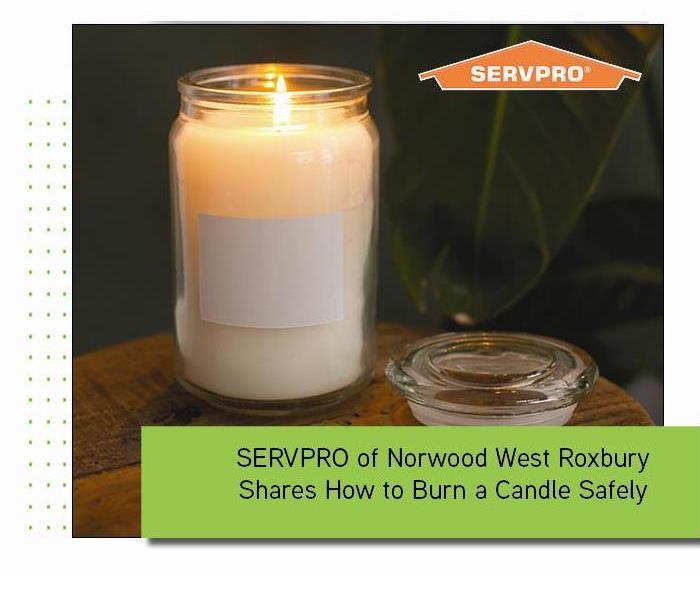 Many people enjoy having candles lit in their homes in the fall months. It is important to know candle safety.
Many people enjoy having candles lit in their homes in the fall months. It is important to know candle safety.
Many people enjoy having candles lit in their homes in the fall months. It is important to know candle safety so that you can enjoy without leading to a fire.
- Before burning, trim the wick to ¼ inch. Long or crooked wicks can cause uneven burning.
- Use a candleholder designed for candle use. It should be heat resistant, sturdy, and large enough to contain drips.
- Burn candles in a well-ventilated room.
- When lighting a candle, use a long-reach lighter.
- Keep your hair and loose clothing out of sight.
- Never leave a candle unattended.
- Never burn a candle near anything that can catch fire.
- Keep burning candles away from furniture, drapes, bedding, carpets, etc.
- Keep candles out of the reach of children and pets.
- Never touch or move a candle while it is burning.
- Place burning candles at least three inches apart from one another.
- Extinguish a candle if the flame becomes too high.
- Never use a candle as a night light or while you are sleeping.
- Use a candle snuffer to extinguish a candle.
- Never use water to extinguish a candle; this can cause wax to splatter.
- Make sure the candle is completely out before leaving the room.
Fire safety is always important. You can prevent a candle fire with these simple tips.
SERVPRO of Norwood West Roxbury is available 24/7 including holidays and weekends to assist you with your disaster needs to get it back to “Like it never even happened.”
SERVPRO of Norwood West Roxbury Shares What You Should Do to Your Home Before Fall Starts
8/14/2022 (Permalink)
 Consider everything you need to know before your house transitions to cool fall nights.
Consider everything you need to know before your house transitions to cool fall nights.
There are important preparations that come with being a homeowner. Consider everything you need to know before your house transitions to cool fall nights.
- Clean your gutters: If they're clogged, you can end up with a flooded interior and damaged exterior.
- Check for drafts: Weatherstripping is simple and probably the most cost-effective way to keep heating costs down.
- Drain your outdoor faucets: Drain and disconnect all garden hoses to prevent any water freezing.
- Bring your outdoor furniture in: If you want to get another summer season out of it you should store it away.
- Change your filters: If your filters are clogged, it's harder to keep your home at the temperature you want it to be.
- Change your batteries: Once a year you should be checking to make sure all smoke detectors and carbon monoxide devices are working.
SERVPRO of Norwood West Roxbury is available 24/7 including holidays and weekends to assist you with your disaster needs to get it back to “Like it never even happened.”
SERVPRO of Norwood West Roxbury Shares Smoke Detector Tips
8/14/2022 (Permalink)
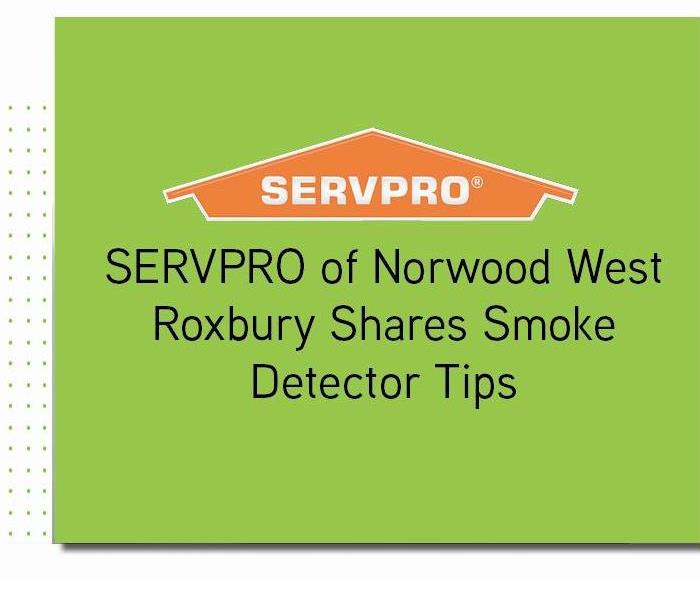 A smoke detector is one of those things we take for granted, unless it’s sounding an alarm or making that annoying chirping noise.
A smoke detector is one of those things we take for granted, unless it’s sounding an alarm or making that annoying chirping noise.
A smoke detector is one of those things we take for granted, unless it’s sounding an alarm or making that annoying chirping noise.
A smoke detector is one of the most important devices in your house. It can save your life in an emergency. Find out what you need to know about smoke detectors.
- You should check your smoke detectors monthly or at least twice a year.
- Most smoke detectors are powered by 9-volt batteries. To check these remove the plastic cap from the detector, replace the battery and press the test button.
- Most smoke detectors last a maximum of 10 years, always check for a date stamped on the back.
Three out of five home fire deaths result from fires in properties without working smoke alarms.
Furthermore, failing to check your smoke alarms regularly increases the likelihood that they’ll fail if a fire erupts.
Maintaining smoke alarms takes minutes, and it’s worth it for the peace of mind it provides.
SERVPRO of Norwood West Roxbury is available 24/7 including holidays and weekends to assist you with your disaster needs to get it back to “Like it never even happened.”
SERVPRO of Norwood West Roxbury Shares Grill Safety
8/14/2022 (Permalink)
 rill fires can start easily and spread quickly. Learn how you can help keep your home safe with these tips.
rill fires can start easily and spread quickly. Learn how you can help keep your home safe with these tips.
Grilling is a popular way to enjoy the nice summer weather. Grill fires can start easily and spread quickly. Learn how you can help keep your home safe with these tips.
- Only use grills outside: It may be tempting to set up your grill inside of your open garage, but they are strictly designed for outdoor use.
- Place your grill away from your home: You should avoid placing your grill outside the back door, or back deck because it can pose a potential fire hazard.
- Make sure your grill is located on a flat surface: Grills that are placed on uneven surfaces can tip over easily and cause a fire.
- Check your grill for leaks: A leak in the gas lines can cause propane to build up inside when the lid is closed.
- Always clean your grill after use: Using your grill often causes grease to build up. The build-up can then act as fuel and catch fire.
- Never leave your barbecue grill unattended while in use: When a grill is left unattended it can become a safety and fire hazard.
- Keep a spray bottle on hand: It’s common for grills to flare up as fat drips, and this can cause a section of the grill to remain on fire.
- Always have a fire extinguisher close by It is simple to use, just point and spray to extinguish the fire.
SERVPRO of Norwood West Roxbury is available 24/7 including holidays and weekends to assist you with your disaster needs to get it back to “Like it never even happened.”
SERVPRO of Norwood/West Roxbury is Hiring A Production Technician
8/8/2022 (Permalink)
 SERVPRO of Norwood/West Roxbury is Hiring A Production Technician
SERVPRO of Norwood/West Roxbury is Hiring A Production Technician
SERVPRO of Norwood/West Roxbury is Hiring A Production Technician
Conveniently located right off Rt 495 in Hopkinton, SERVPRO of Norwood/West Roxbury offers exciting employment opportunities. When you arrive at our office, you will feel the positive energy as you are enthusiastically greeted by our office dog, Maggie. She will put a smile on your face as soon as you enter!
SERVPRO of Norwood/West Roxbury is committed to employee development, providing multiple opportunities for resource training. You will be encouraged to stay current and to expand your knowledge and skills in your particular area of employment. We have very clear and stated goals and they don’t just sit in a word document, they are prominent for all to see and remember, painted in bright gold on our conference walls! Our traineeship office, located in Lawrence, frequently holds seminars and presentations on the latest communications from SERVPRO corporate.
In addition, our employees enjoy the convenient amenities just steps from our office. Within a block, you have Starbucks, "Dunkins", local delis, convenience stores and gas stations as well as very popular restaurants great for meeting up with friends after work. Inquire today and we will look forward to talking to you about potential employment
SERVPRO of Norwood/West Roxbury is the place for you! Contact us at (508) 370-4400
SERVPRO of Norwood West Roxbury Talks About Heat Waves
8/8/2022 (Permalink)
 It is important to stay hydrated during the month of August: it is known as the extreme heat month.
It is important to stay hydrated during the month of August: it is known as the extreme heat month.
It is important to stay hydrated during the month of August: it is known as the extreme heat month. Make sure to drink plenty of water to stay hydrated. Hot weather causes sweat, so you will need to replenish the lost fluids.
Here are some tips for you to stay cool during the summer months:
- Never leave children or pets in hot vehicles.
- Stay inside during the hottest part of the day (10 A.M to 4 P.M.)
- When you’re in the outdoors, make sure to stay out of direct sunlight.
- Set your air conditioners to a lower temperature.
- Use curtains or blinds to keep direct sunlight out.
- Eat small meals and eat more often.
- Wear light, loose-fitting, light-colored clothing.
- Check on family and friends who are elder.
- If you feel overheated, cool off with wet washcloths on your wrists and neck. Carry a cooling facial mist with you.
Stay hydrated, and cool, during the month of August, while you make sure you enjoy summer as best as you can.
SERVPRO of Norwood West Roxbury is available 24/7 including holidays and weekends to assist you with your disaster needs to get it back to “Like it never even happened.”
SERVPRO of Norwood West Roxbury Talks About Campfire Safety
8/8/2022 (Permalink)
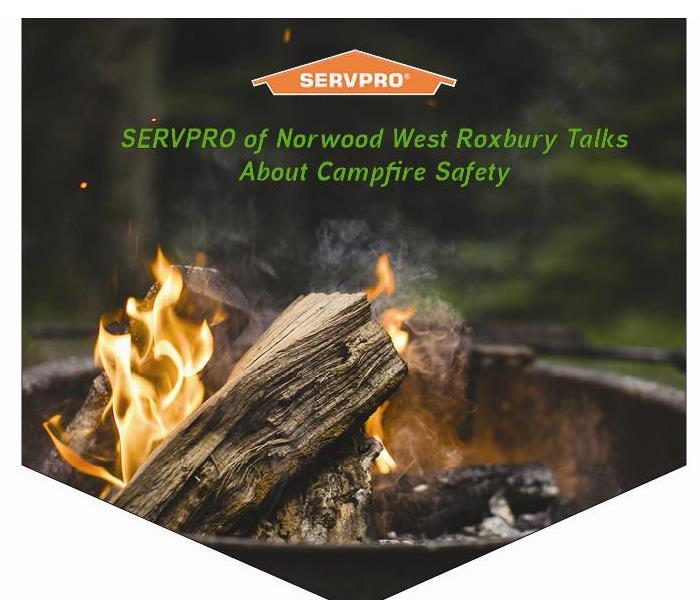 Enjoying a campfire is one of the most enjoyable parts of summer. A campfire that is not properly built, maintained, and extinguished can be dangerous
Enjoying a campfire is one of the most enjoyable parts of summer. A campfire that is not properly built, maintained, and extinguished can be dangerous
Enjoying a campfire is one of the most enjoyable parts of summer. A campfire that is not properly built, maintained, and extinguished can quickly become a hazard. It's important to understand how to safely enjoy your campfire.
- Know the rules: Before you strike a match, make sure you know the fire regulations of the campground or wilderness area.
- Use the pit: Most campgrounds provide a fire pit to build a campfire. If a pit is provided, this is the only place you should build a campfire. If not, dig a fire pit in an open area away from overhanging branches and power lines.
- Build a safe campfire: Start the fire with dried leaves or grass that will easily catch fire. Next, add small twigs and sticks that are less than an inch. As the fire builds, add the largest pieces of wood to the fire. This keeps the fire burning for a longer period of time.
Keep in mind that your fire does not have to be roaring. In fact, a small fire surrounded by rocks will do the job. Always make sure to take caution whenever you are creating a fire.
SERVPRO of Norwood West Roxbury is available 24/7 including holidays and weekends to assist you with your disaster needs to get it back to “Like it never even happened.”
SERVPRO of Norwood West Roxbury Shares Back To School Tips
8/4/2022 (Permalink)
 The school season will be starting back up soon and it is important to remember some key tips that will help keep them safe and healthy.
The school season will be starting back up soon and it is important to remember some key tips that will help keep them safe and healthy.
The school season will be starting back up soon and it is important to remember some key tips that will help keep them safe and healthy throughout the school year.
Here are some tips to make sure your child safely travels to school:
- Review your family's walking safety rules. Make sure to practice walking to school with your child.
- Walk on the sidewalk. If there is no sidewalk, walk facing the traffic.
- Before crossing the street, stop and look left, right, and left again.
- Make eye contact with drivers before crossing.
- Always cross streets at crosswalks or intersections
- Stay alert and avoid distractions.
- Teach your children school bus safety rules.
- Teach your children to stand 6 feet away from the curb
- Make eye contact with children who are crossing the street
- Never pass a bus loading or unloading children
SERVPRO of Norwood West Roxbury is available 24/7 including holidays and weekends to assist you with your disaster needs to get it back to “Like it never even happened.”
SERVPRO of Norwood West Roxbury Shares Tax-Free Information
8/4/2022 (Permalink)
 The tax-free weekend comes once a year. This allows people to get school items tax-free, which could be a great deal of savings!
The tax-free weekend comes once a year. This allows people to get school items tax-free, which could be a great deal of savings!
The tax-free weekend comes once a year. This allows people to get school items tax-free, which could be a great deal of savings!
The sales tax holiday for 2022 will be held on Saturday, August 13, and Sunday, August 14. Retail items of up to $2,500, purchased in Massachusetts for personal use on these two days, will be exempt from sales tax.
If you spend more than $2,500 on an item, the entire amount paid for the item is subject to sales tax, not just the amount that exceeds that threshold. There is, however, an exemption with respect to clothing. An item of clothing is generally exempt from the sales tax unless the item costs more than $175. If it does, only the amount over $175 is subject to tax. If on the sales tax holiday, the price of an item of clothing exceeds $2,500, the first $175 is not subject to tax.
You can learn more here:
https://www.mass.gov/info-details/sales-tax-holiday-frequently-asked-questions
SERVPRO of Norwood West Roxbury is available 24/7 including holidays and weekends to assist you with your disaster needs to get it back to “Like it never even happened.”
SERVPRO of Norwood West Roxbury Shares The Top 5 Summer Safety Tips
7/3/2022 (Permalink)
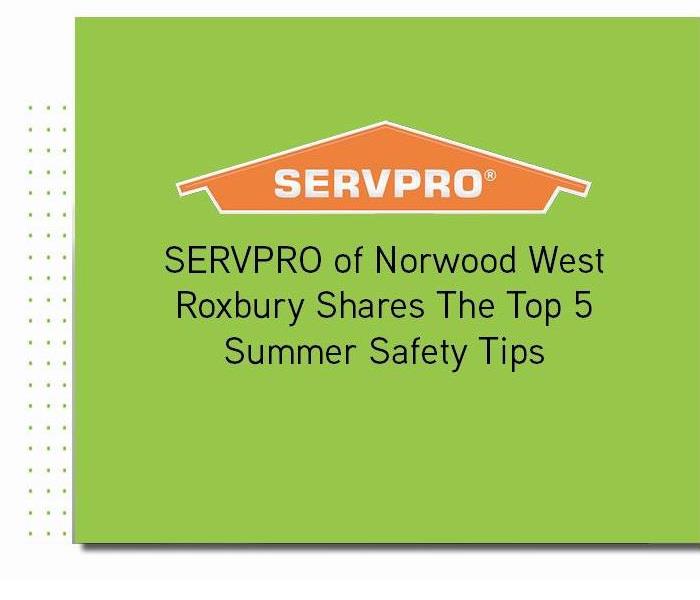 Summer is a time for adventure! Before you start with the fun and games, keep in mind these important summer safety tips.
Summer is a time for adventure! Before you start with the fun and games, keep in mind these important summer safety tips.
Summer is a time for adventure! Before you start with the fun and games, keep in mind these important summer safety tips.
- Water Safety: Drownings are number one of the leading causes of accidental deaths for children under five. To prevent this, parents are encouraged to keep a closer eye on their children, especially around water. Areas that are both in and out of the house should be kept closed off without supervision. Children participating in boating should always wear a life jacket.
- Playgrounds: Spending time outdoors with your kids is a great way to enjoy the time. Certain activities on the playground are more dangerous than others. Parent supervision is important, to keep children from falling in playground areas. Almost half of all falls occur due to a lack of supervision.
- Heat Exposure: Summer heat can be dangerous. On a hot day leaving kids dehydrated can cause exhaustion, dizziness, and even vomiting. Extreme temperatures can induce heat stroke. Parents should be extremely cautious about keeping kids hydrated with water.
- Bicycles and Outdoors Sports: Bicycle injuries among kids 5-14 are more prevalent than any other sport. Children should always wear a helmet. Outdoor games such as skateboarding, rollerblading, etc should always stay on the right side of the road and go with the flow of traffic. Make sure to make eye contact with drivers before crossing.
- Fireworks: Fireworks are dangerous and never advised around kids. Children should also never be allowed to handle sparklers. Picking a unique spot to watch fireworks can be equally as enjoyable.
SERVPRO of Norwood West Roxbury is available 24/7 including holidays and weekends to assist you with your disaster needs to get it back to “Like it never even happened.”
What To Do If Your House Floods in SERVPRO of Norwood West Roxbury
7/3/2022 (Permalink)
 Planning for a flood due to a storm is difficult, but you can take some small precautions to ensure your home is protected
Planning for a flood due to a storm is difficult, but you can take some small precautions to ensure your home is protected
Planning for a flood due to a storm is difficult, but you can take some small precautions to ensure your home is protected:
- Keep your rain gutters and downspouts clear of leaves and debris.
- Ensure downspouts direct water away from your basement or foundation.
- Be certain the ground slopes are away from your home.
- Watch for small leaks in your roof, windows, doors, and foundation and fix them promptly.
When the rain is extremely hard and lasts for a long time, this can cause water levels to rise, which will flood your home. Sandbagging and trenching can help in some cases, but if water finally does start getting into your home, further action steps are needed.
“What do I do if I get water in my basement?”
At the first sign, that water is entering your home, cut the power to all outlets. Don’t forget to Unplug all machines and equipment such as freezers, heaters, lamps, and power tools. Put washers, dryers, freezers, etc. up on blocks to keep them out of the rising water.
- If water has entered your home quickly contact your local utility company to cut the power to your home
- If you have an electric sump pump, it is important that it stays plugged in. Shut off the gas or have your gas company do it for you if you aren’t sure how to do it.
- A backup generator can be used to power additional pumps, water vacuums, and lights. Make sure that water has been cleaned up and isn’t destroying surrounding things.
- Contact your insurance company as soon as possible.
- Install fans to move air and dry your basement once the bulk of the water is gone.
- Contact a qualified flood restoration expert such as SERVPRO of Norwood West Roxbury to determine what steps are necessary to repair your home from flood damage.
We are proud to serve our local communities:
- Westwood, MA
- Dedham, MA
- West Roxbury, MA
- Norwood, MA
- East Dedham, MA
- South Norwood, MA
- Norwood Centre, MA
- Endicott, MA
- Riverdale, MA
- Midtown Bus District, MA
- Walpole, MA
- Medfield, MA
SERVPRO of Norwood West Roxbury is available 24/7 including holidays and weekends to assist you with your disaster needs to get it back to “Like it never even happened.”
SERVPRO of Norwood West Roxbury Shares Things To Do Before Going On Vacation
7/3/2022 (Permalink)
 After you are all packed for vacation and feel at ease, take the time to protect your home while you're on vacation.
After you are all packed for vacation and feel at ease, take the time to protect your home while you're on vacation.
You are getting ready to go on vacation for a week, and are all ready to go. After you are all packed and feel at ease, take the time to protect your home while you're on vacation. July and August are popular months when home burglaries peak.
Here is a checklist to help keep your house safe while you are away:
- Set timers on interior lights: Don't allow your house to appear as if no one is home.
- Power surges: Disconnect the computer, TV, stereo, and other electronics. You can also make sure they are plugged safely into a surge protector.
- Don't make or socialize status updates: Never broadcast your location on social media.
- Alert your alarm company: If you have an automatic security system in place, let them know you will be away for an extended period of time. Make sure the alarm is set properly when you leave.
- Secure valuables: Put your jewelry or other valuables in a safe deposit box.
- Set the HVAC: Set your thermostat to lower your heat or air conditioning usage.
- Protect your pipes: Make sure pipes in vulnerable areas such as attics, basements, and crawlspaces are insulated.
- Arrange for lawn care: Before you leave, trim tree branches that might allow access to a climbing burglar.
- Stop newspapers and mail: Have them regularly picked up by a neighbor.
- Plan exterior lighting: Set these lights on timers to deter burglars.
- Don't leave spare keys outdoors: Get rid of spare keys that are around the exterior of your home.
- Lock the garage: Secure the door and any entrances to the garage so they can’t enter your home from that access point.
SERVPRO of Norwood West Roxbury is available 24/7 including holidays and weekends to assist you and help you with commercial damage. “Like it never even happened.”
SERVPRO of Norwood West Roxbury Talks Hail Storm Safety
7/3/2022 (Permalink)
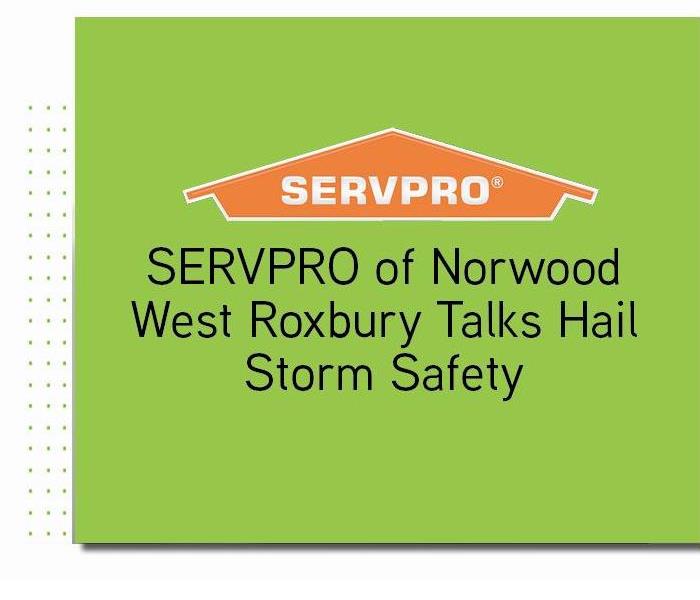 Hail can dent vehicles, shatter windows and destroy roofs. This can cause water damage in your home.
Hail can dent vehicles, shatter windows and destroy roofs. This can cause water damage in your home.
Hail is common during severe thunderstorms. Hail can dent vehicles, shatter windows and destroy roofs. This can cause water damage in your home.
Minimize hail damage with these helpful tips:
- Clear your debris to minimize water damage.
- Inspect your roof for damage and repair areas.
- Remove weak branches or trees close to your home.
- Store patio furniture in an enclosed space.
- Move vehicles into a garage or use a hail protector cover.
- Avoid finding shelter under trees or in areas that can suddenly fill with water.
- Stay indoors and away from windows or glass doors.
- Close blinds to protect yourself from broken glass and debris.
- After the storm, if there’s a power outage, turn off electronics and appliances.
- Use a flashlight instead of candles.
- Turn off valves, if you detect any gas leaks.
- Clean up debris and make temporary repairs.
If your home has been damaged:
- Document the damage as soon as possible.
- Take photos or make a video.
- Keep records for clean-up costs complete.
- Document everything for your insurance company.
We are proud to serve our local communities:
- Westwood, MA
- Dedham, MA
- West Roxbury, MA
- Norwood, MA
- East Dedham, MA
- South Norwood, MA
- Norwood Centre, MA
- Endicott, MA
- Riverdale, MA
- Midtown Bus District, MA
- Walpole, MA
- Medfield, MA
SERVPRO of Norwood West Roxbury is available 24/7 including holidays and weekends to assist you with your disaster needs to get it back to “Like it never even happened.”
SERVPRO of Norwood West Roxbury Shares What To Do If Your House Is On Fire
7/3/2022 (Permalink)
 It is never a fun experience when a house sets on fire. However, it is important to know what to do in case it ever happens.
It is never a fun experience when a house sets on fire. However, it is important to know what to do in case it ever happens.
It is never a fun experience when a house sets on fire. However, it is important to know what to do in case it ever happens.
These steps can help you, and your loved ones, recover after a house fire:
- Find a safe place to stay: No matter the amount of damage, you likely can't stay in your own home for a little while until damages are completed.
- Contact your insurance agent: You'll need to start a claim immediately. Make sure to save all receipts and keep a detailed record of all purchases. Your insurance agent should also be able to help you secure your property and offer restoration companies like SERVPRO of Framingham.
- Take care of your pets: You should have your pets checked by a veterinarian after a fire. It can affect some of their health.
- Get a copy of the fire report: You can usually get fire reports from your local fire department. This will be handy for yourself and your insurance claim.
- Address your finances: You'll still need to make mortgage payments, even if your home is destroyed. Keep in mind that you need to continue any car payments and replace any credit or debit cards that may have been destroyed.
- Recover your possessions: Items destroyed in a house fire are usually covered by insurance. To help make sure everything is accounted for, keep a home inventory of possessions. It is also a good idea to add photos of before and after items.
- Take care of your family's mental health: Disasters can affect people's mental health. It is devastating and traumatic.
SERVPRO of Norwood West Roxbury is available 24/7 including holidays and weekends to assist you with your disaster needs to get it back to “Like it never even happened.”
SERVPRO of Norwood West Roxbury Explains Commercial Rebuilding Services
7/3/2022 (Permalink)
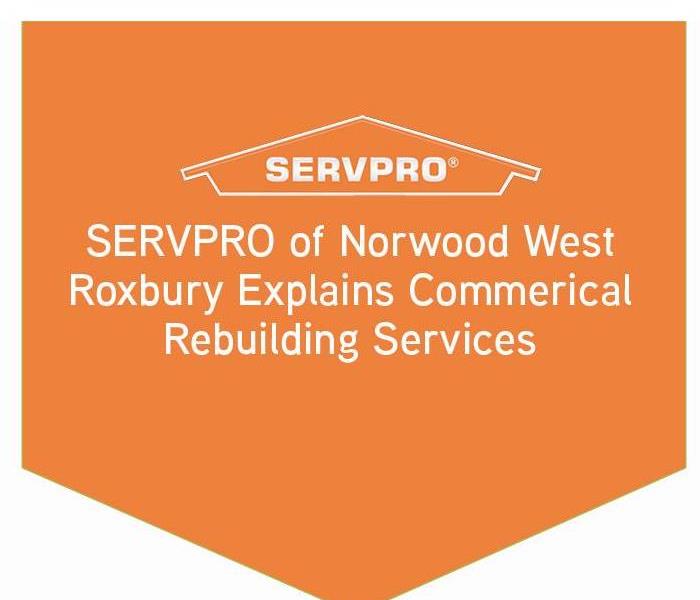 SERVPRO of Norwood West Roxbury is your one-stop shop for commercial construction.
SERVPRO of Norwood West Roxbury is your one-stop shop for commercial construction.
SERVPRO of Norwood West Roxbury is your one-stop shop for commercial construction. The last thing you want to worry about when you have a need for reconstruction is contacting and managing multiple repair crews.
We will work with your insurance company to restore your commercial property to help make it “Like it never even happened.” Our goal is to complete your commercial restoration project on time and within the budget with as little downtime to your business as possible.
We have a competent and experienced team that believes in delivering quality workmanship. Our full-service process includes: inspection and estimating, mitigation, restoration, and reconstruction.
Why choose us:
- Single Contact
- Expedited Restoration Process
- Quality Workmanship
- SERVPRO’s Clean Build Technology
- On-Time & On-Budget
- Easier Insurance Claims Process
We are proud to serve our local communities:
- Westwood, MA
- Dedham, MA
- West Roxbury, MA
- Norwood, MA
- East Dedham, MA
- South Norwood, MA
- Norwood Centre, MA
- Endicott, MA
- Riverdale, MA
- Midtown Bus District, MA
- Walpole, MA
- Medfield, MA
SERVPRO of Norwood West Roxbury is available 24/7 including holidays and weekends to assist you with your disaster needs to get it back to “Like it never even happened.”
SERVPRO of Norwood West Roxbury Helps Commercial Buildings With Restoration
6/7/2022 (Permalink)
 Commercial cleaning and restoration present unique challenges. You need a company that provides excellent results while minimizing disruption.
Commercial cleaning and restoration present unique challenges. You need a company that provides excellent results while minimizing disruption.
Commercial cleaning and restoration present unique challenges. You need a company that provides excellent results while minimizing the disruption to your clients. So when the need arises for professional cleaning or emergency restoration services, SERVPRO of Norwood West Roxbury has the training and expertise to help make it “Like it never even happened.”
We can help:
- Small Office Buildings
- Large Office/High-Rise Office Buildings
- Apartment Buildings
- Restaurants
- Hotel/Motels
- Small Retail Stores
- Large Retail/Big-Box Stores
- High-Rise Residential
- Manufacturing & Industrial
- Government/Military
We serve commercial damages in the following areas:
- Westwood, MA
- Dedham, MA
- West Roxbury, MA
- Norwood, MA
- East Dedham, MA
- South Norwood, MA
- Norwood Centre, MA
- Endicott, MA
- Riverdale, MA
- Midtown Bus District, MA
- Walpole, MA
- Medfield, MA
SERVPRO of Norwood West Roxbury is available 24/7 including holidays and weekends to assist you with your disaster needs to get it back to “Like it never even happened.”
SERVPRO of Norwood Shares Firework Safety
6/6/2022 (Permalink)
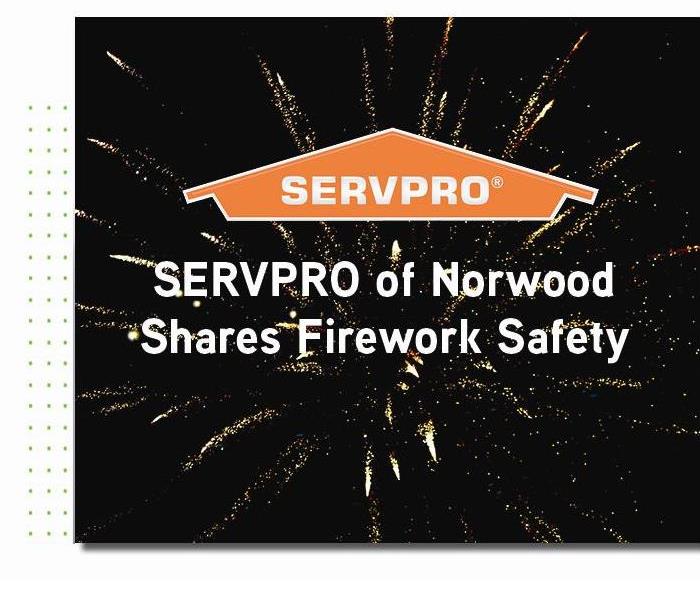 Fireworks can be very dangerous if they are not used properly, they can even cause a fire to your home.
Fireworks can be very dangerous if they are not used properly, they can even cause a fire to your home.
The summer months call for fireworks. Fireworks are designed to burn and produce motion or audible effects. Here are some firework safety tips that you should consider:
- NEVER give fireworks to young children. Make sure there is adult supervision of all fireworks at all times
- Always read and follow the manufacturer's directions
- Buy from reliable sellers
- Use outdoors only
- Always have water handy
- Never experiment or make your own fireworks
- Light only one firework at a time
- Never give fireworks to small children
- Dispose of fireworks properly by soaking them in water and then disposing of them in your trash can
- Never throw or point fireworks at other people
- Never carry fireworks in your pocket
- Never shoot fireworks in metal or glass containers.
Fireworks can be very dangerous if they are not used properly, they can even cause a fire to your home. If your house gets hit by a fire, call for restoration needs.
SERVPRO of Norwood West Roxbury is available 24/7 including holidays and weekends to assist you with your disaster needs to get it back to “Like it never even happened.”
SERVPRO of Norwood West Roxbury Shares How To Observe Lightning Safety Awareness Week
6/6/2022 (Permalink)
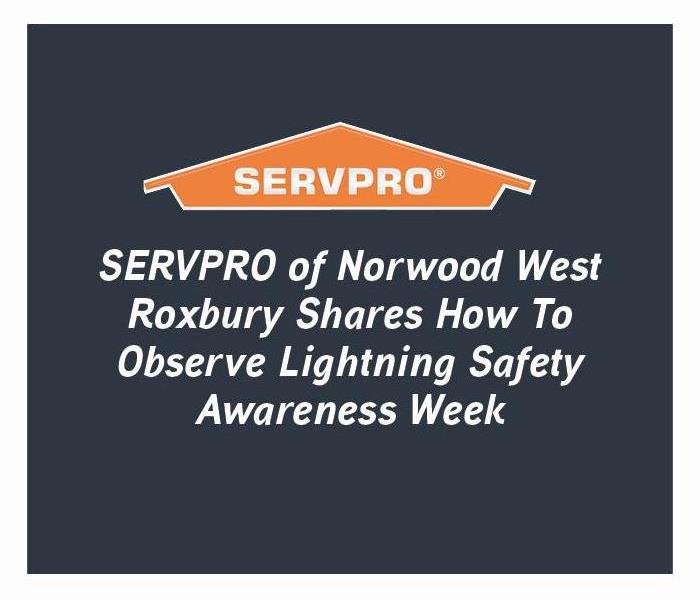 Lightning is popular in the summer months and it can cause much damage to a building. It is important to take precautions to help prevent damage.
Lightning is popular in the summer months and it can cause much damage to a building. It is important to take precautions to help prevent damage.
Lightning is popular in the summer months and it can cause much damage to a building. It is important to take precautions to help prevent damage.
It is advised to stay indoors during a thunderstorm, there are occasions when we might not be able to. It is important to have a safety plan in place should a thunderstorm arrive.
It is important to be thoroughly aware of its dangers so that we can take the necessary precautions if we are ever caught in a storm.??
Lightning Safety Awareness Week helps to alert people that the outdoors are not safe during a thunderstorm. Lightning can strike from over 15 miles away and any delays in taking precautions can cause serious injury or fatality. Lightning Safety Awareness Week is important to spread awareness of lightning and lightning safety.
Here are some topics and links to help you become more informed during the week.
SERVPRO of Norwood West Roxbury is available 24/7 including holidays and weekends to assist you with your disaster needs to get it back to “Like it never even happened.”
SERVPRO of Norwood West Roxbury Shares 5 Tips for National Pet Preparedness Month
6/6/2022 (Permalink)
 June is National Pet Preparedness Month. Pets are important in our lives so, we need to stay educated and share with others how to care for our pets.
June is National Pet Preparedness Month. Pets are important in our lives so, we need to stay educated and share with others how to care for our pets.
June is National Pet Preparedness Month. Pets are important in our lives so, we need to stay educated and share with others how to care for our pets.
Here are some tips to help our pets:
- Identification: Make sure your pet is microchipped and, if they do not have one yet, schedule an appointment with your veterinarian.
- The device can be scanned at a veterinary office or animal shelter.
- It will display life-saving information like your address and phone number.
- If you move or change numbers let your microchip company know so that they can update their records!
- Make sure identification tags are current.
- Make sure to include if they need medication, or if they do not like other animals, on their tag to help emergency personnel know what type of care they need while they work on reconnecting you.
- Know where to go!
If you area is prone to flooding or any other type of natural disaster, it is important to find a place outside of the area where you can take your pets with you.
- It is a good idea to have a list of options and contact numbers for where you might go.
- If you leave your home because the electricity is out and it is too hot or too cold, it is the same for your pets, don’t leave them behind!
- Stay together!
Natural disasters can be frightening for us and even more for our pets.
- It is important to have them on a leash at all times while you are outside.
- Your area may have dangerous debris that they can get into.
- If your home has been damaged, remember to keep cats in a carrier or confined.
- Make a kit!
?A premade kit can be vital if you have to evacuate your home.
- Good items to keep in your pet’s kit include a few days' worths of food, bottles of water, extra medication, copies of veterinary records, poop bags, cat litter and pan, sturdy leashes, and collars, and a first aid kit.
- You will also want to have a list of pet-friendly hotels, dishes, and if they have a favorite type of treat or toy!
- Know who to contact!
If a disaster hits while you are at work or away from your home, make sure to discuss a plan of action in advance with a neighbor or family member.
- Agree that if one of you cannot make it back home that the other will bring your pets and their emergency kit will make the situation much less hectic.
- Have updated stickers on your front door letting emergency personnel know how many pets are in the home.
- Keep your veterinary clinic, pet-friendly hotels, and the Pet Poison Helpline numbers handy so you are prepared for any situation you may encounter.
No one likes to think a natural disaster will happen in their area but having these strategies in place will help ensure that you and your pets are prepared. If a disaster hits your home, we are here to help restore your fire, storm, and water damage.
SERVPRO of Norwood West Roxbury is available 24/7 including holidays and weekends to assist you with your disaster needs to get it back to “Like it never even happened.”
SERVPRO of Norwood West Roxbury Explains Water Damage
6/6/2022 (Permalink)
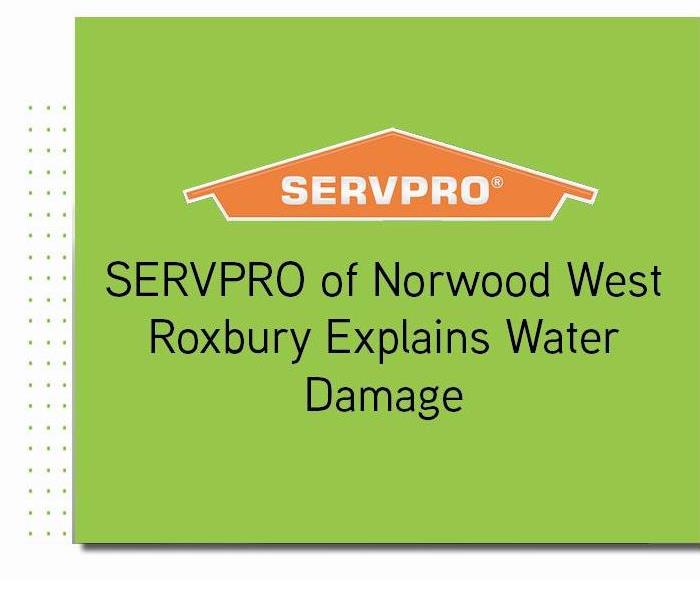 Leaking pipes, burst sewer lines, and natural disasters can leave your home severely water damaged.
Leaking pipes, burst sewer lines, and natural disasters can leave your home severely water damaged.
Leaking pipes, burst sewer lines, and natural disasters can leave your home severely water damaged. If your property is affected, it is critical to identify the cause and act quickly.
Water damage can be very stressful to deal with, especially because more problems can arise. Here is some information that might help you understand more about water damage.
- Water Volume: If your home is experiencing water, you can typically manage it on your own. However, if there is significant flooding that is not going away, it might be best to call a professional.
- If your neighborhood is recovering from a large flood, and your home has suffered significant damage, you should hire a professional to help with restoration.
- The first thing to do when you discover water damage in your home is to unplug all electronics. By using this equipment despite the situation could cause electrical shocks or even explosions.
- Mold can spread quickly once it infests an area, so it should be inspected for growth. Oftentimes, mold can appear inside the walls or floors, so it’s important that this inspection is ongoing.
- Before more damage occurs, eliminate moisture and dry out the affected areas. You can use fans or a large-capacity dehumidifier to circulate air and dry out the surrounding materials. This won’t prevent mold growth altogether, but properly drying out the area will help lessen the damage.
- If insulation or carpet, is soaked with water, you need to dispose of them immediately.
SERVPRO of Norwood West Roxbury is available 24/7 including holidays and weekends to assist you with your disaster needs to get it back to “Like it never even happened.”
New England SERVPRO® Owners Team Up with Red Sox
6/3/2022 (Permalink)
 "Our SERVPRO New England team is excited to cheer the Boston Red Sox to victory alongside our community! Let's go, Red Sox!"
"Our SERVPRO New England team is excited to cheer the Boston Red Sox to victory alongside our community! Let's go, Red Sox!"
A group of SERVPRO franchise owners in northern New England is proud to announce their collective sponsorship of the Boston Red Sox for the 2022 season. The SERVPRO owner group, which is made up of more than 30 SERVPRO franchise owners, is excited to come together and partner with their beloved Red Sox, making this sponsorship one of the first of its kind for SERVPRO.
"This new deal illustrates the SERVPRO family's love for their local communities, fellow New Englanders, and America's favorite pastime," said Jesse Mathewson, SERVPRO Marketing Team Member.
The sponsorship is marked by two LED signs that will illuminate SERVPRO's distinctive green and orange on the first and third baselines at every home game in historic Fenway Park, home of the Red Sox. The group will also sponsor National Clean-Up Day on September 17, including the pregame ceremony and in-park promotions when the Red Sox host the Kansas City Royals.
This isn't the first interaction between the Red Sox and the brand, as SERVPRO's certified restoration specialists had the honor of cleaning and sanitizing Fenway Park at the onset of the COVID-19 pandemic in 2020.
"Being selected to assist an institution like Fenway Park, prioritizing safety above all else, following all IICRC guidelines and CDC protocols, was a privilege," Mathewson said. "Ever since that initial interaction with such a first-class organization, we knew we wanted to take the next step to make the partnership bigger."
SERVPRO's full spectrum of restoration, mitigation, construction, cleaning, and decontamination services are offered year-round, but one thing SERVPRO and the Boston Red Sox have in common is how each gears up during the Spring season.
"Spring is the perfect time to have your residential or commercial property cleaned and sanitized by our team of certified technicians from our New England SERVPRO locations," Mathewson said. "We are proud to support the Red Sox and our local communities, not only with this sponsorship but with any emergency or upcoming services and projects this year."
"Our SERVPRO New England team is excited to cheer the Boston Red Sox to victory alongside our community! Let's go, Red Sox!"
SERVPRO of Norwood West Roxbury Shares Thunderstorm Tips
6/1/2022 (Permalink)
 The summer months are here, and with that comes thunderstorms. They can be dangerous for many reasons, it is important to know how to protect yourself
The summer months are here, and with that comes thunderstorms. They can be dangerous for many reasons, it is important to know how to protect yourself
The summer months are here, and with that comes thunderstorms. They can be dangerous for many reasons, it is important to know how to protect yourself and your loved ones during a thunderstorm.
Thunderstorms can happen quickly and you might find yourself outdoors. If you are outdoor and see lightning and hear thunder find shelter immediately.
Here are some Safety precautions for indoors”
- Avoid contact with water during a thunderstorm. Do NOT bathe, shower, wash dishes, or have any other contact with water.
- Avoid using electronic equipment of all types; lightning can travel through electrical systems.
- Avoid using corded phones. However, cordless or cellular phones are safe to use during a storm.
- Do NOT lie on concrete floors during a thunderstorm. Lightning can travel through any metal wires or bars in concrete walls or flooring.
Lightning strikes may be rare, but they still happen and the risk of severe injury is severe.
SERVPRO of Norwood West Roxbury is available 24/7 including holidays and weekends to assist you with your disaster needs to get it back to “Like it never even happened.”
SERVPRO of Norwood West Roxbury Shares Summer Tips
6/1/2022 (Permalink)
 Summer is finally here! We know that can mean summer fun outdoors, but summer can also bring the threat of dangerous storms.
Summer is finally here! We know that can mean summer fun outdoors, but summer can also bring the threat of dangerous storms.
Summer is finally here! We know that can mean summer fun outdoors, but summer can also bring the threat of dangerous storms. Learn how to reduce your lightning risk while outdoors.
“If you hear thunder, lightning is close enough to pose an immediate threat,” said FEMA Region V Acting Administrator Janet M. Odeshoo.
Seek shelter as quickly as possible. There is no safe place outside when a thunderstorm is in the area.”
Buildings such as offices, schools, and homes offer good protection. Once inside, stay away from windows and doors and anything that conducts electricity. If you are caught outside with no safe shelter anywhere nearby, consider these options:
- Never shelter under an isolated tree, tower, or utility pole.
- Immediately get off elevated areas such as hills, mountain ridges, or peaks.
- Immediately get away from ponds, lakes, and other bodies of water.
- Stay away from objects that conduct electricity.
- Never lie flat on the ground.
The best way to protect yourself against lightning injury is to monitor the weather and postpone outdoor activities when thunderstorms are in the forecast. Lightning can strike from up to 10 miles away. If you can hear thunder, you might be in danger of being struck by lightning.
SERVPRO of Norwood West Roxbury is available 24/7 including holidays and weekends to assist you with your disaster needs to get it back to “Like it never even happened.”
SERVPRO of Norwood West Roxbury Shares How to Have a Safe Bonfire
5/13/2022 (Permalink)
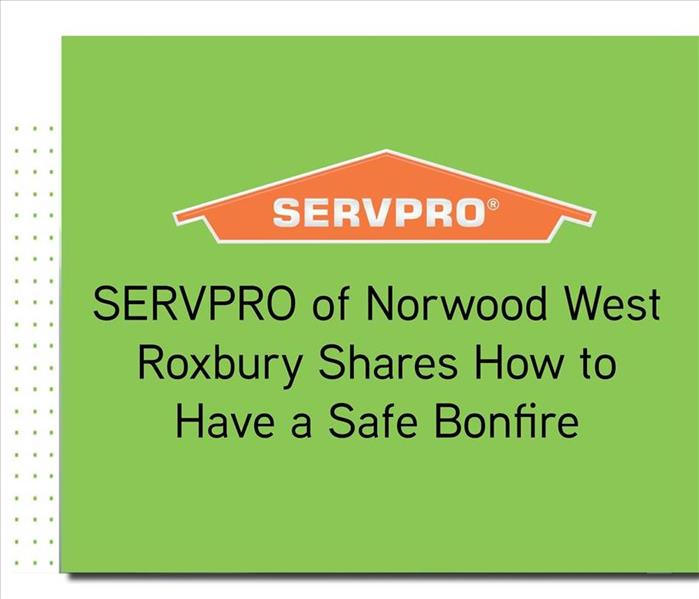 It is important to take precautions if you plan on having a bonfire.
It is important to take precautions if you plan on having a bonfire.
With the warmer weather comes much more outdoor fires such as a bonfire. This might sound like a fun idea, but it can also be dangerous and cause a bigger fire. It is important to take precautions if you plan on having a bonfire.
Here are some safety guidelines to follow:
- Never build a bonfire on a high-wind night.
- Keep a bucket of water or garden hose nearby
- Keep a close eye on the bonfire as well as anyone nearby the fire.
- Do not burn aerosols, canisters, or anything containing foam or paint.
- Ensure the wood you are burning is dry and seasoned.
- The pile shouldn't be bigger than 5' x 5'.
After the bonfire is done, turn over the materials with metal shovels and douse the area with water. Make sure to follow all fire and safety guidelines to ensure that a fire doesn't start.
SERVPRO of Norwood West Roxbury is available 24/7 including holidays and weekends to assist you with your disaster needs to get it back to “Like it never even happened.”
SERVPRO of Norwood West Roxbury Provides 5 Things You Should Never Burn in Your Outdoor Fire Pit
5/13/2022 (Permalink)
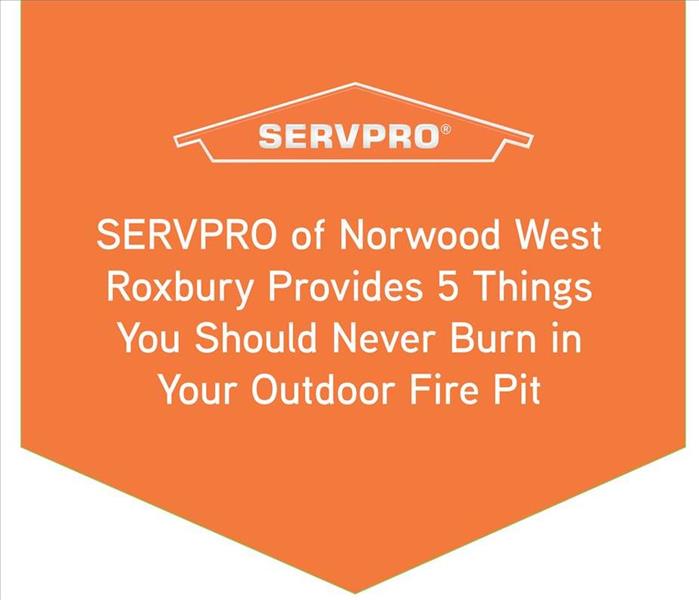 These are 5 things you should never burn in your outdoor fire pit.
These are 5 things you should never burn in your outdoor fire pit.
Having a fire pit is something that many enjoy throughout all seasons because it provides warmth when it is cold. However, there are some safety aspects that you should consider so that a larger fire isn’t created and damages anything additional.
These are 5 things you should never burn in your outdoor fire pit.
- Treated Wood
- Railroad Ties
- Plastic
- Yard Waste
- Garbage
Make sure that you are conscious about what you are burning. However, it might even pose a larger threat and cause damage to nearby items such as your home.
SERVPRO of Norwood West Roxbury is available 24/7 including holidays and weekends to assist you with your fire disaster needs to get it back to “Like it never even happened.”
SERVPRO of Norwood West Roxbury Is Your Fire Damage Experts
5/13/2022 (Permalink)
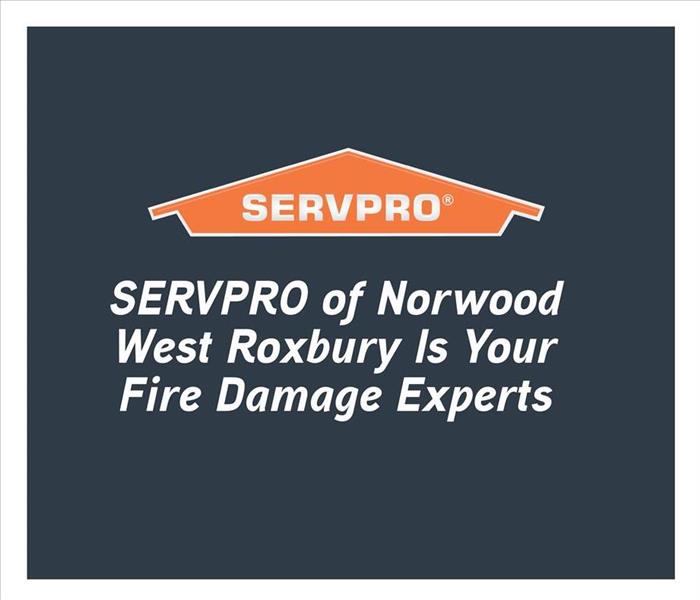 A fire disaster can cause damage to the structure of your home along with all the belongings; it can be stressful and devastating.
A fire disaster can cause damage to the structure of your home along with all the belongings; it can be stressful and devastating.
We hope that you never experience fire damage to your home. A fire disaster can cause damage to the structure of your home along with all the belongings; it can be stressful and devastating.
Here are some easy things you can do to reduce the risk of a fire.
- Make sure that you have working smoke alarms on all levels of your building. These will give you an early warning so you can get outside quickly.
- A closed-door may slow the spread of smoke, heat, and fire. Make sure that there are working smoke alarms in every sleeping room.
- Large homes may need extra smoke alarms.
- It is recommended to use interconnected smoke alarms.
- Test all smoke alarms at least once a month.
- A smoke alarm should be on the ceiling or high on a wall.
- Keep smoke alarms at least 10 feet from the kitchen stove to reduce false alarms.
- Replace all smoke alarms when they are 10 years old.
We know that you can’t always prevent a fire but these are helpful tips to reduce the risk.
SERVPRO of Norwood West Roxbury is available 24/7 including holidays and weekends to assist you with your fire disaster needs to get it back to “Like it never even happened.”
SERVPRO of Norwood West Roxbury Explains The Importance of Building an Emergency Plan
5/13/2022 (Permalink)
 It is important to be proactive and have a plan in place so that if a fire strikes your building you can act quickly.
It is important to be proactive and have a plan in place so that if a fire strikes your building you can act quickly.
A fire is not always preventable and sometimes can happen in the workplace. It is important to be proactive and have a plan in place so that if a fire strikes your building you can act quickly.
Here are tips to create an effective emergency plan:
- Assemble the Team: Seek out the participation of everyone in the office in the early stages.
- Conduct Risk Assessment: Conduct a risk assessment to identify potential hazards and vulnerabilities.
- Establish Objectives: Set quantifiable and tangible milestones that you’ll achieve as you develop your emergency preparedness program. Some ideas are reaching out to public emergency services, conducting a business impact analysis, and identifying opportunities for hazard prevention and risk mitigation.
- Create Written Policy: Here are some suggestions that your plan should include reporting fires and other emergencies, evacuation procedures, and emergency escape route assignments.
- Develop an on-site Emergency Response Team: Designate emergency response leaders within your organization to lead evacuation, coordinate communication, conduct a headcount, and communicate detailed information to 911 dispatch and emergency responders.
- Practice and Review: Your Emergency Response Plan works great when the people carrying it out are well prepared. Every six months, conduct emergency drills.
There is no right way to be prepared for a fire or damage to business property. However, when you have a plan in effect before it happens, things can go much smoother. We are able to help you create an Emergency Readiness Plan so that if damage hits your building you can act quickly.
SERVPRO of Norwood West Roxbury is available 24/7 including holidays and weekends to assist you with your commercial disaster needs to get it back to “Like it never even happened.”
SERVPRO of Norwood West Roxbury Explains Summer Storm Safety
5/10/2022 (Permalink)
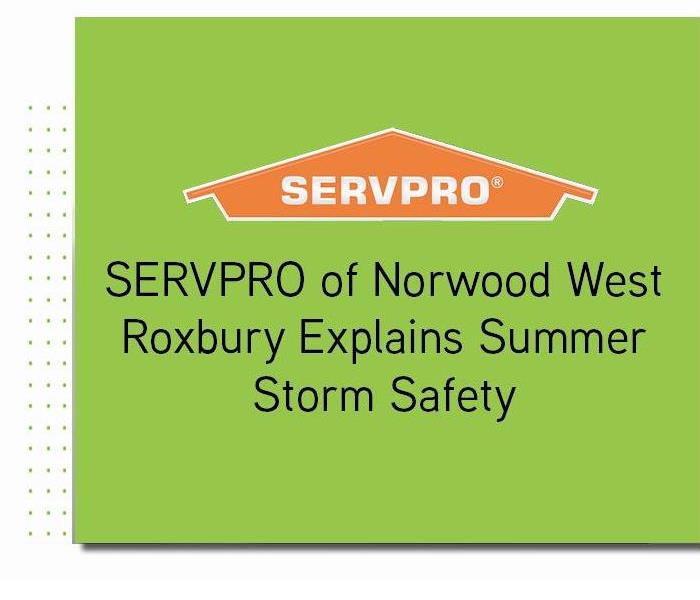 Summer is just around the corner, so the threat of dangerous storms increases. There are ways to reduce your lightning risk while outdoors.
Summer is just around the corner, so the threat of dangerous storms increases. There are ways to reduce your lightning risk while outdoors.
Summer is just around the corner, so the threat of dangerous storms increases. There are ways to reduce your lightning risk while outdoors.
Buildings such as offices, schools, and homes should have good protection. Once you are inside, stay away from windows and doors. Make sure to stay away from anything that conducts electricity.
If you have no safe shelter anywhere nearby, the following actions may reduce your risk:
- Never shelter under an isolated tree or utility pole.
- Get off hills, mountain ridges, or peaks.
- Get out and away from ponds, lakes, and water.
- Stay away from objects that conduct electricity.
- Don’t lie flat on the ground.
- Make sure to postpone or cancel outdoor activities when thunderstorms are in the forecast.
Always make sure that you are safe at all times; even if your building is damaged. We are here to help you with the damage that can be caused by storm damage.
SERVPRO of Norwood West Roxbury is available 24/7 including holidays and weekends to assist you with your disaster needs to get it back to “Like it never even happened.”
SERVPRO of Norwood West Roxbury Shares Positive Reviews
5/8/2022 (Permalink)
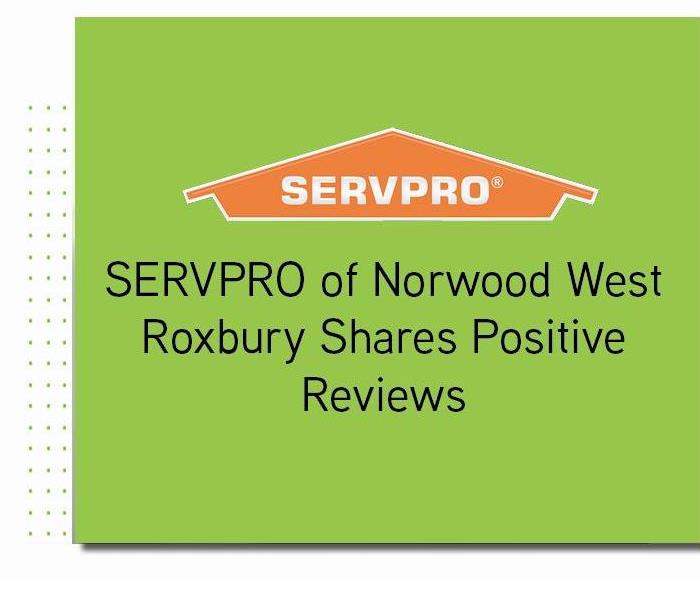 We take great pride in our services, customers, and team. We are highly trained in the restoration field.
We take great pride in our services, customers, and team. We are highly trained in the restoration field.
SERVPRO of Norwood West Roxbury is a restoration company and we hope you never have to call us. Sometimes we know that disasters can happen.
We take great pride in our services, customers, and team. We are highly trained in the restoration field. Our customer's testimonials speak for themself.
“I can't say enough good things about Kevin and Rodney. I was so impressed by how hard they worked to get my home back together. thank you so much.” --Julia
“Great company to work with after I experienced a home fire. Rodney and Amy were great in cleaning up the damage. mauritizo was great to work within the rebuild. thank you servrpo” -- Issy
SERVPRO of Norwood West Roxbury is available 24/7 including holidays and weekends to assist you with your disaster needs to get it back to “Like it never even happened.”
SERVPRO of Norwood West Roxbury Helps The Local Community
5/8/2022 (Permalink)
 Both the Disaster Remediation and Rebuild Teams of SERVPRO of Norwood West Roxbury are highly skilled and professional.
Both the Disaster Remediation and Rebuild Teams of SERVPRO of Norwood West Roxbury are highly skilled and professional.
Both the Disaster Remediation and Rebuild Teams of SERVPRO of Norwood West Roxbury are highly skilled and professional. Our certified technicians and licensed contractors will be there for you throughout the entire project life cycle. They will collaborate with you, keep you informed and make sure that your expectations are met. There is no need to manage multiple contractors, timelines, or invoices. SERVPRO of Norwood West Roxbury is your one-stop remediation to rebuild the shop. We will make it "Like it never even happened."
We are close by and ready to respond immediately when you need cleaning or restoration services. For major storms and disasters, we can even call upon special Disaster Recovery Teams for additional resources.
We are proud to serve our local communities:
- Westwood, MA
- Dedham, MA
- West Roxbury, MA
- Norwood, MA
- East Dedham, MA
- South Norwood, MA
- Norwood Centre, MA
- Endicott, MA
- Riverdale, MA
- Midtown Bus District, MA
- Walpole, MA
- Medfield, MA
SERVPRO of Norwood West Roxbury is available 24/7 including holidays and weekends to assist you with your disaster needs to get it back to “Like it never even happened.”
Preventing Water Damage
4/26/2022 (Permalink)
Preventing water damage will save you many headaches and is easier than dealing with the cleanup and repairs. We do not like to think about it, but water damage can cause severe damage to your property. It weakens the foundation and the very core that holds your property together.
You have heard about core strength in your body. Well, water damage hits at the core strength of your house, eventually causing severe structural damage. Damp wood invites termites and carpenter ants; plus, it causes mould and mildew.
Here are 3 easy prevention tips
These tips are easy things to do that will give you piece of mind the next time heavy storms hit.
- Ensure Good Drainage
Poor drainage weakens your foundation, causing cracks, uneven settling, and pathways for water to enter your home.
- Clean your gutters routinely. A clogged gutter and drains will send cascades of water down the side of your house, damaging your siding and foundation.
- Ensure your downspouts direct water 5 to 10 feet away from your house.
- Make sure your yard is sloped at least 6 inches over a 10-foot span away from your foundation.
- Check for Water Leaks
Persistent leaks lead to mould, mildew, rot, and even termites and carpenter ants (they like chewing wet wood, since it is soft).
- Check for dark spots under pipes inside sink cabinets, stains on ceilings, toilets that rock, and of course drips.
- At least once a year, inspect your roof. Repair any missing, loose, and or damaged shingles.
- Repair any cracked caulking and check for leaks around flashing.
- Know what to do should water damage occur
Water damage is all about action. Acting fast will save you time and unnecessary costs. Contact SERVPRO experts immediately will help our team to restore rather than replace. What you can do until SERVPRO arrives
- Remove art objects to a safe, dry place & gather loose items from floors.
- Remove coloured rugs and upholstery from wet carpeting to prevent stains.
- Do not turn on ceiling fixtures if the ceiling is wet, and keep out of rooms where ceilings are sagging.
SERVPRO of Norwood/West Roxbury is here, 24/7/365 to help you in your time of need. Keep our phone number in your emergency contacts: (781) 769-9125
SERVPRO of Norwood West Roxbury Specializes In Water Damage
4/9/2022 (Permalink)
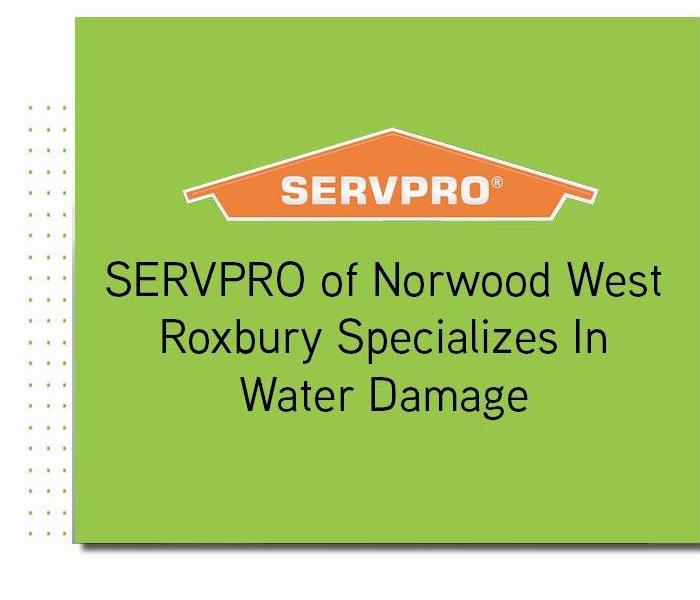 Water damage can happen at any time and can cause damage. It is important to hire a professional and highly trained company.
Water damage can happen at any time and can cause damage. It is important to hire a professional and highly trained company.
Water damage can happen at any time and can cause damage. It is important to hire a professional and highly trained company.
The technicians at SERVPRO of Norwood West Roxbury use advanced detection equipment. This allows us to thoroughly scope the property to determine the migration path of the water. It also ensures that the property has the water extracted and dried.
We use powerful extraction equipment and have specialized drying equipment. We work with flooring of different types such as hardwood floors, tile, and cement.
SERVPRO of Norwood West Roxbury is available 24/7 including holidays and weekends to assist you with your commercial disaster needs to get it back to “Like it never even happened.”
SERVPRO of Norwood West Roxbury Shares Professional Help for Water Damage
4/9/2022 (Permalink)
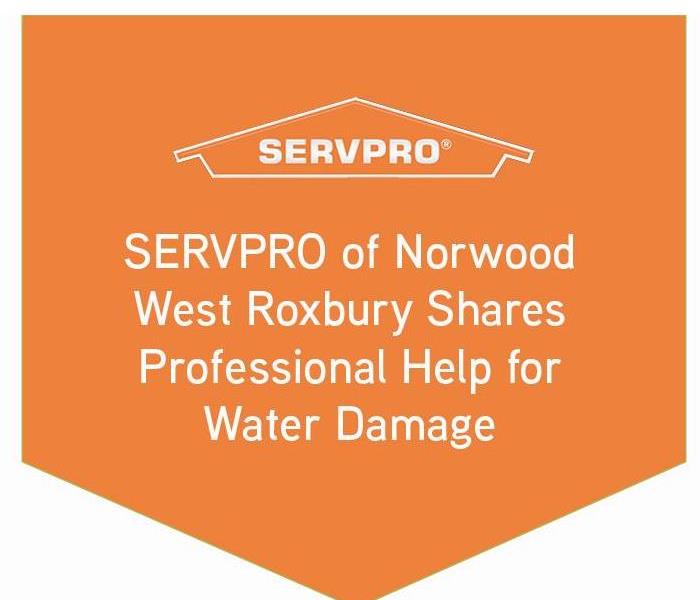 SERVPRO of Norwood West Roxbury is available 24/7 including holidays and weekends to assist you with your disaster needs to get it back to “Like it ne
SERVPRO of Norwood West Roxbury is available 24/7 including holidays and weekends to assist you with your disaster needs to get it back to “Like it ne
When water damage happens, you might want to clean it up yourself. However, the downside is that water migrates quickly and can wind up far away from the origination point. This can cause damage to your house.
If a pipe breaks in a bathroom and gravity pulls the water downward. Then it runs under the tile floor. It will go between the floor and exist into the living room all over a carpeted floor. If any moisture gets left in these areas, it can trigger issues such as mold. It is important to make sure you address these problems and hire a professional.
SERVPRO of Norwood West Roxbury is available 24/7 including holidays and weekends to assist you with your disaster needs to get it back to “Like it never even happened.”
SERVPRO of Norwood West Roxbury is the Restoration Company To Call
4/9/2022 (Permalink)
 SERVPRO of Norwood West Roxbury understands that having your building damaged from mold, fire, water, or storms can leave a lasting impression.
SERVPRO of Norwood West Roxbury understands that having your building damaged from mold, fire, water, or storms can leave a lasting impression.
SERVPRO of Norwood West Roxbury understands that having your building damaged from mold, fire, water, or storms can leave a lasting impression.
You have a responsibility to keep claims costs down while still providing the best services possible for your customers.
We are uniquely qualified to help you get your property restored efficiently. Our results create a measurable difference, giving you many competitive advantages.
SERVPRO of Norwood West Roxbury is available 24/7 including holidays and weekends to assist you with your commercial disaster needs to get it back to “Like it never even happened.”
SERVPRO of Norwood West Roxbury Shares 5 Ways to Protect For Spring Storms
4/6/2022 (Permalink)
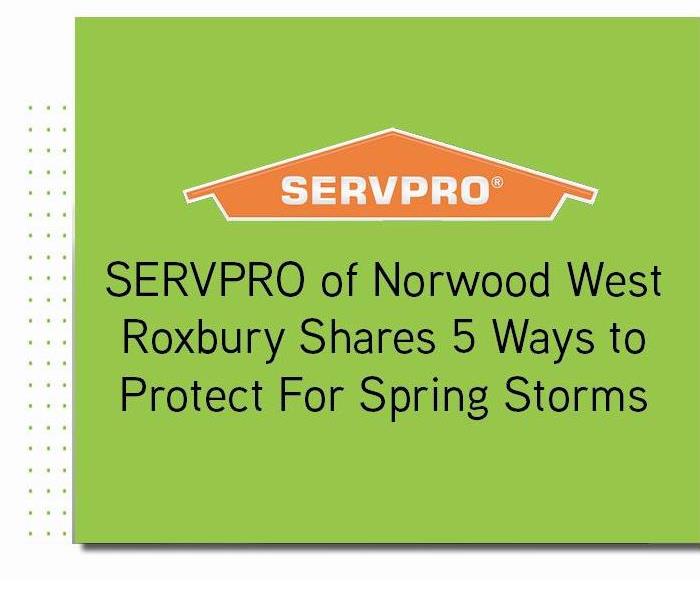 The combination of heavy rainfall and ice melting can produce large amounts of runoff.
The combination of heavy rainfall and ice melting can produce large amounts of runoff.
When spring arrives flooding can arise. The combination of heavy rainfall and ice melting can produce large amounts of runoff. This leads to large amounts of water and flooding.
Water damage is not a cheap fix, it is important to be aware of what you can do to protect yourself. Follow these five tips to protect your home from flooding this spring.
- Learn from the past: If your house has leaked before, it has a higher risk of it happening again. You will want to repair any cracks in your walls or foundation.
- Clear out debris: Built-up debris in your gutters can go through window wells. This may keep water from draining away from your home properly. Keep these areas free from debris as best as you can to prevent flooding.
- Get your pump ready: Make sure your sump pump is working properly. You will also want to make sure you have a battery or backup power source. You may also consider installing a back-water valve; this will prevent flooding from sewer backup.
- Check for leaks from above: Damaged shingles can be an easy entry point for water during a storm. Inspect your roof to make sure you don’t get water damage.
- Give the water somewhere to go: Ensure that there is a place to direct water away from your home. If you notice water around your home, try getting your yard re-graded or use downspout extensions.
SERVPRO of Norwood West Roxbury is available 24/7 including holidays and weekends to assist you with your commercial disaster needs to get it back to “Like it never even happened.”
SERVPRO of Norwood West Roxbury Is The Disaster Remediation Company
4/5/2022 (Permalink)
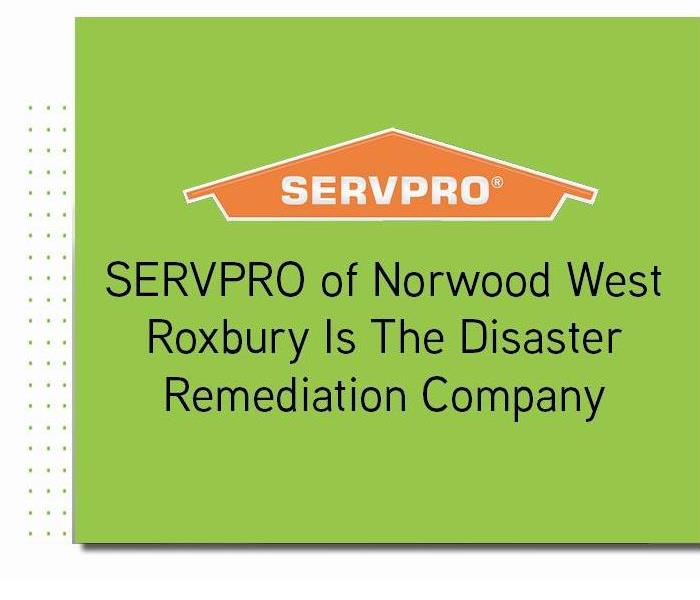 When damage strikes, you need a trusted remediation-to-rebuild expert.
When damage strikes, you need a trusted remediation-to-rebuild expert.
When damage strikes, you need a trusted remediation-to-rebuild expert. Witnessing your home being consumed by water or fire can be traumatizing.
SERVPRO of Norwood West Roxbury offers a wide variety of commercial and residential restoration services to our clients. We have a team of certified and fully trained professionals who are ready to respond 24 hours a day, every day of the year, even on holidays to all emergencies.
Some of the services that we provide are:
- Fire damage restoration
- Restoration of water damage
- Restoration of storm destruction
- Mold damage restoration and others.
SERVPRO of Norwood West Roxbury is available 24/7 including holidays and weekends to assist you with your commercial disaster needs to get it back to “Like it never even happened.”
SERVPRO of Norwood West Roxbury Helps Prepare for a Flood
4/5/2022 (Permalink)
 There are several ways to prepare for a flood, though it might not seem likely that you can fully prevent it.
There are several ways to prepare for a flood, though it might not seem likely that you can fully prevent it.
There are several ways to prepare for a flood, though it might not seem likely that you can fully prevent it. Here are a few ways to prepare for a flood:
- Visit FEMA's Flood Map Service Center to know the types of flood risk in your area. Also, make sure to sign up for your community’s warning system.
- Purchase or renew a flood insurance policy. It can take up to 30 days for a policy to go into effect so allow plenty of time.
- Make a plan for your household that includes what to do, where to go, and what you will need to protect yourselves from flooding. Make sure to be aware of evacuation routes.
- Keep important documents in a waterproof container. Protect your property by moving valuables to higher levels. Also, consider a sump pump with a battery.
SERVPRO of Norwood West Roxbury is available 24/7 including holidays and weekends to assist you with your water disaster needs to get it back to “Like it never even happened.”
What Are The Common Causes of Commercial Building Fires?
3/5/2022 (Permalink)
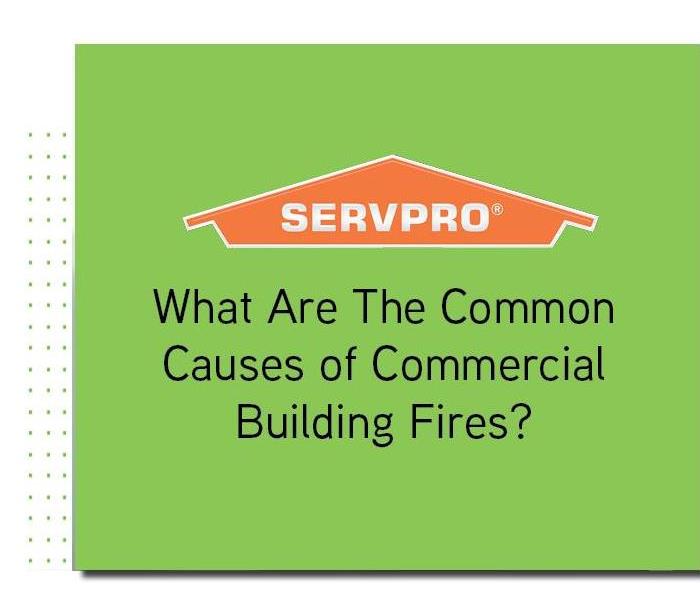 It is important to take care of employees whenever there is a fire.
It is important to take care of employees whenever there is a fire.
It is important to take care of employees whenever there is a fire. Commercial fires can be the result of human error. Therefore, it is important to educate yourself to help prevent a fire.
Arson: This is the leading cause of fire damage in a workplace setting. This is instigated by the owner for the hope of collecting insurance on a failing business.
Human Errors: There is poor judgment in the workplace sometimes and this can cause a fire, such as leaving a cigarette unattended.
Apparatus: There are strict codes regulating the installation and maintenance of water heaters, boilers, and furnaces. Mishandling of installation can ignite a fire.
Electrical Fires: Building fires are usually the result of the misuse of an appliance. An appliance is used for a purpose other than what it was designed for.
SERVPRO of Norwood West Roxbury is available 24/7 including holidays and weekends to assist you with your commercial disaster needs to get it back to “Like it never even happened.”
Choose SERVPRO of Norwood West Roxbury for Your Next Commercial Construction Project
3/5/2022 (Permalink)
 SERVPRO of Norwood West Roxbury works with your insurance company to restore your commercial property.
SERVPRO of Norwood West Roxbury works with your insurance company to restore your commercial property.
The last thing you should have to worry about when you need restoration or reconstruction is contacting multiple repair crews; it can cause stress and anxiety. This can also take away precious working hours.
SERVPRO of Norwood West Roxbury works with your insurance company to restore your commercial property. Our goal is to complete your commercial restoration project on time and within the budget. We make sure to have an as little downtime as possible.
Here are just a few reasons to choose us for your next project:
Single Contact: Communication is the key to any successful business restoration project. We will be there from start to finish with effective communication.
Expedited Restoration Process: We are a one-stop-shop. Construction will go much quicker since we coordinate construction work at the same time we’re mitigating.
Quality Workmanship: You will be proud of the results we deliver because we take pride in our experience and have the proper tools.
Clean Build Technology: We offer premium services using EPA-registered products for dust control, viral pathogen protection (including COVID-19), and other contaminants.
On-Time & On-Budget: Our professional construction service providers work with your insurance company, so you do not have to worry.
Easier Insurance Claims Process: We will help you navigate the insurance claims process and coordinate the necessary paperwork for a quicker, easier experience.
SERVPRO of Norwood West Roxbury is available 24/7 including holidays and weekends to assist you with your commercial disaster needs to get it back to “Like it never even happened.”
SERVPRO of Norwood West Roxbury Shares What To Do After A Flood
3/5/2022 (Permalink)
 When an office fills with water it is understandable to think extraction first, but the first priority should always be safety.
When an office fills with water it is understandable to think extraction first, but the first priority should always be safety.
When a thunderstorm arrives flash floods will usually occur. When an office fills with water it is understandable to think extraction first, but the first priority should always be safety.
Here are some steps to take to ensure health and safety:
Reduce Additional Risks: Electricity can cause dangers with floods. If the power is out, and there’s standing water, you might be at risk for fire. To reach the fuse box and turn off the main power line.
Avoid Contact With The Water: Floodwaters may appear clean. This could be contaminated with bacteria, sewage, or household chemicals that can be harmful.
Begin Cleanup & Mitigation: When storms damage your commercial property the best thing to do is to call water remediation experts.
SERVPRO of Norwood West Roxbury is available 24/7 including holidays and weekends to assist you with your water disaster needs to get it back to “Like it never even happened.”
SERVPRO of Norwood West Roxbury Explains Actions to Take for a House Flood
3/5/2022 (Permalink)
 Floods can arise for a variety of reasons. Here are some practices to ensure the safety of you and your home
Floods can arise for a variety of reasons. Here are some practices to ensure the safety of you and your home
Floods can arise for a variety of reasons. Here are some practices to ensure the safety of you and your home:
Avoid Risks: Make sure it is safe before you return. Check for any warping, cracked foundations, or other structural damage.
Health: The water that is now in your home could be contaminated by sewage, so wear waist-high waders.
Take Pictures: Be sure to take photos or videos of your home to prove the damage to your insurance company.
Contact your insurance provider: Have your insurance company's information handy.
Clean-Up: This is where we can help and shine. We remove water from your house and mitigate mold.
SERVPRO of Norwood West Roxbury is available 24/7 including holidays and weekends to assist you with your water disaster needs to get it back to “Like it never even happened.”
SERVPRO of Norwood West Roxbury Gives Back
3/3/2022 (Permalink)
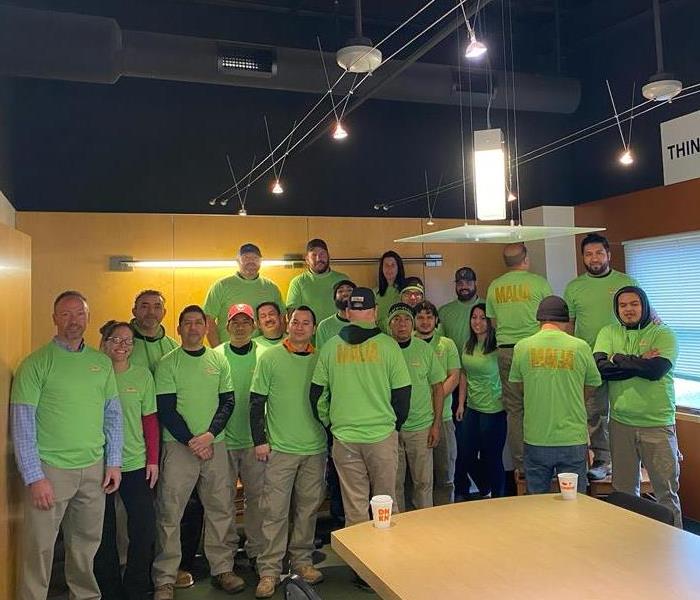 Check out the link below to see how you can support the charity! You got this, Malia!
Check out the link below to see how you can support the charity! You got this, Malia!
SERVPRO of Norwood West Roxbury is always all about giving back and helping our local community whenever possible. We believe in helping out causes that are close to our hearts.
We are supporting the fight against cancer through For Kid's Sake Foundation. Malia has been fighting neuroblastoma, and her father Glen is a longtime friend of our owner, David. Check out the link below to see how you can support the charity! You got this, Malia!
https://forkidssakefoundation.org
SERVPRO of Norwood West Roxbury is available 24/7 including holidays and weekends to assist you with your mold disaster needs to get it back to “Like it never even happened.”
SERVPRO of Norwood West Roxbury Talks About Fire Damage
2/7/2022 (Permalink)
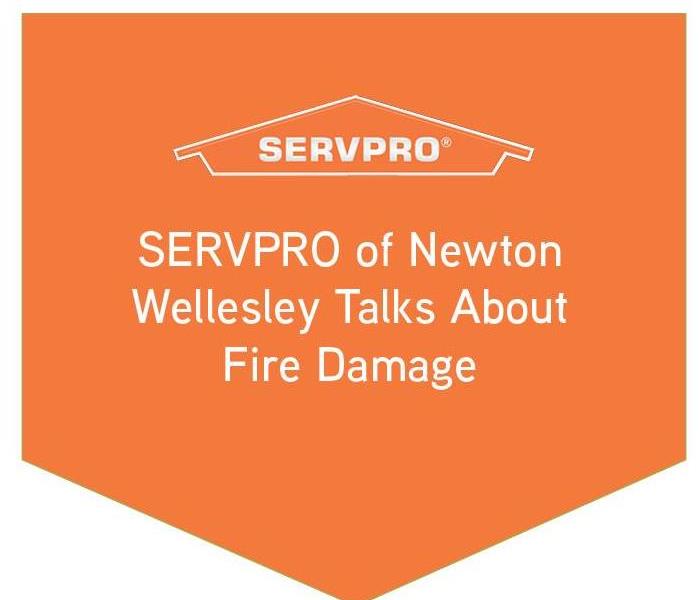 Homes have more electricity than ever before and can cause a fire if not properly addressed. Here are some tips to help prevent a fire
Homes have more electricity than ever before and can cause a fire if not properly addressed. Here are some tips to help prevent a fire
Homes have more electricity than ever before and can cause a fire if not properly addressed. Here are some tips to help prevent a fire:
- Check outlets for loose-fitting plugs.
- Don’t force plugs into outlets.
- Make sure cords are not frayed.
- Extension cords are for temporary use only.
- Use the correct light bulb wattage.
- Install Ground Fault Circuit Interrupters.
- Loose wires are common flashpoints for fires.
Fires are horrible disasters, it is important to know how to prevent one. At least once a month you should check on these items to ensure that everything is working properly and smoothly.
SERVPRO of Norwood West Roxbury is available 24/7 including holidays and weekends to assist you with your fire disaster needs to get it back to “Like it never even happened.”
SERVPRO of Norwood West Roxbury Shares The Top Reasons For Fires
2/7/2022 (Permalink)
 The key to fire prevention is knowing common causes, so you can help prevent them.
The key to fire prevention is knowing common causes, so you can help prevent them.
Fires are impossible to prevent, there are still some important factors to understand. The key to fire prevention is knowing common causes, so you can help prevent them.
Here are the top causes of fires:
- Cooking: Never leave a stove unattended.
- Smoking: An unattended burning cigarette can cause a serious fire.
- Heating: Space heaters are extremely flammable, make sure to use them properly.
- Electrical: A power cord can have your home in flames if there is damage to them.
- Candles: Always ensure all candles are blown out before leaving the room.
- Dryers: Remove the lint screen after every use in your dryer; this can cause a huge fire.
SERVPRO of Norwood West Roxbury is available 24/7 including holidays and weekends to assist you with your fire disaster needs to get it back to “Like it never even happened.”
SERVPRO of Norwood West Roxbury Shares Fire Extinguisher Use And Safety
2/7/2022 (Permalink)
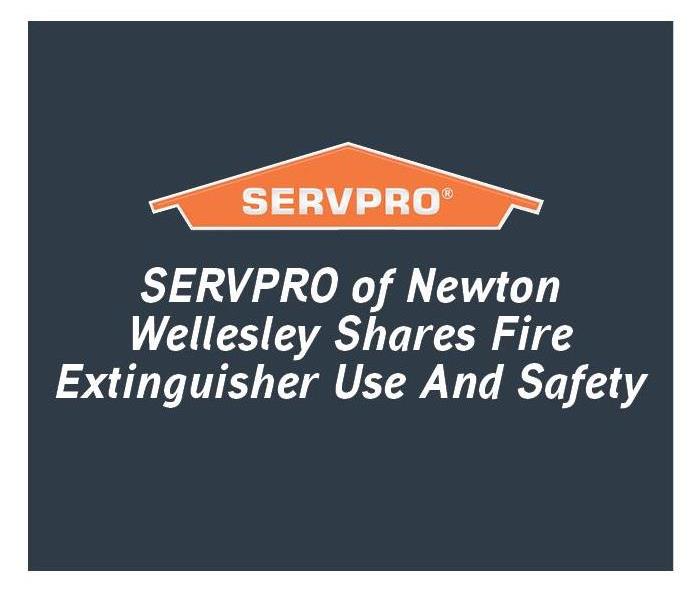 A portable fire extinguisher can be a saving tool for a fire. Here are some quick tips on how you can use a fire extinguisher correctly
A portable fire extinguisher can be a saving tool for a fire. Here are some quick tips on how you can use a fire extinguisher correctly
A portable fire extinguisher can be a saving tool for a fire. Here are some quick tips on how you can use a fire extinguisher correctly:
- Pull the pin and release the locking mechanism.
- Aim low, and point at the base of the fire.
- Squeeze the lever slowly.
- Sweep from side to side.
Make sure to read the instructions on the fire extinguisher. You will want to become familiar with it; it is important to encourage family members and coworkers to become familiar with it too.
Fire extinguishers can help put out a fire, however, make sure to seek professional assistance.
SERVPRO of Norwood West Roxbury is available 24/7 including holidays and weekends to assist you with your fire disaster needs to get it back to “Like it never even happened.”
SERVPRO of Norwood West Roxbury Explains Ways to Protect Your Home From Flooding
2/3/2022 (Permalink)
 Flooding can happen anywhere at any time. It is hard to prevent flooding, but you can take precautions.
Flooding can happen anywhere at any time. It is hard to prevent flooding, but you can take precautions.
Flooding can happen anywhere at any time. It is hard to prevent flooding, but you can take precautions. It is important to know the flood level of your home first and foremost. Here are tips to help you:
- You will want to make sure to raise switches, sockets, circuit breakers, and wiring at least a foot above the expected flood level.
- Make sure Fuel tanks, air-conditioning units, and generators are anchored above your flood level.
- A flooded sewer system can cause sewage to back up. Make sure to install an interior or exterior backflow valve.
- Raise your home on piers or columns so the lowest floor is above flood level.
- Make sure to have clear gutters, drains, and downspouts.
SERVPRO of Norwood West Roxbury is available 24/7 including holidays and weekends to assist you with your water disaster needs to get it back to “Like it never even happened.”
SERVPRO of Norwood West Roxbury Helps Restore Your Commercial Property After a Fire
2/3/2022 (Permalink)
 Businesses may be impacted by a disaster such as a tornado or flooding, at some point or another.
Businesses may be impacted by a disaster such as a tornado or flooding, at some point or another.
Fire can do a lot of damage to businesses by far. In fact, most businesses that suffer a large fire simply never reopen their doors again.
Businesses may be impacted by a disaster such as a tornado or flooding, at some point or another.
With proper clean-up and repairs, a business can open the doors and start connecting with customers again.
Heat and smoke damage from a fire can destroy structures, and make the building dangerous and unsafe. It is vital to call experts as soon as possible, so you can restore your building in a timely and efficient manner.
SERVPRO of Norwood West Roxbury has a 24-hour response team. We are able to begin work immediately, so your business time doesn’t need to be down for long periods of time.
Our experts will assess the damage then begin work and start planning for the clean-up. This involves the smoke and fire damage; we also remove the water and foam that will have been used by the fire service to extinguish the blaze.
We will work with you to restore your commercial premises back to a fully functioning business environment as quickly and efficiently as possible.
SERVPRO of Norwood West Roxbury is available 24/7 including holidays and weekends to assist you with your commercial disaster needs to get it back to “Like it never even happened.”
SERVPRO of Norwood West Roxbury Offers Biohazard Cleaning Services
2/2/2022 (Permalink)
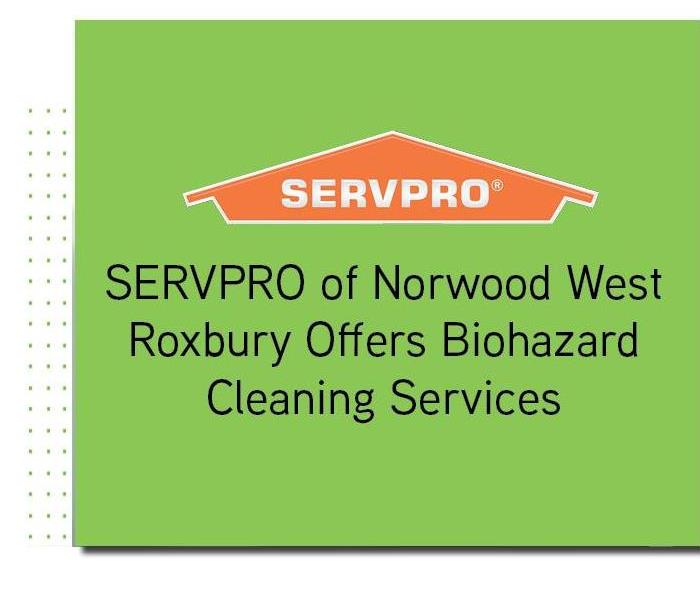 Equipped with the necessary safety apparatus and cleaning products, we transform these unhealthy environments back into clean, safe homes and offices.
Equipped with the necessary safety apparatus and cleaning products, we transform these unhealthy environments back into clean, safe homes and offices.
Exposure to biological and chemical contaminants can pose serious health consequences. Failure to properly trash substances can contribute to unhealthy and dangerous environments. SERVPRO of Norwood West Roxbury is trained to safely remove biohazards and dispose of them properly in accordance with OSHA and health regulations.
Equipped with the necessary safety apparatus and cleaning products, we transform these unhealthy environments back into clean, safe homes and offices.
The decontamination of a home or business due to trauma, sewage backups, chemical spills, hoarding, or other biohazards can be dangerous.
We provide cleanup and recovery services for many biohazard situations. These include the following:
- Sewage backups
- Crime scene residues
- Suicide/death accidents
- Homicide cleanups
- Blood cleanup
- Accident cleanup
- Hoarding scenes
- Animal waste/remains
- Chemical spills
- Tear gas cleanup
- Meth lab cleanup
SERVPRO of Norwood West Roxbury is available 24/7 including holidays and weekends to assist you with your disaster needs to get it back to “Like it never even happened.”
SERVPRO of Norwood West Roxbury Offers Trauma and Crime Scene Cleanup Services
2/2/2022 (Permalink)
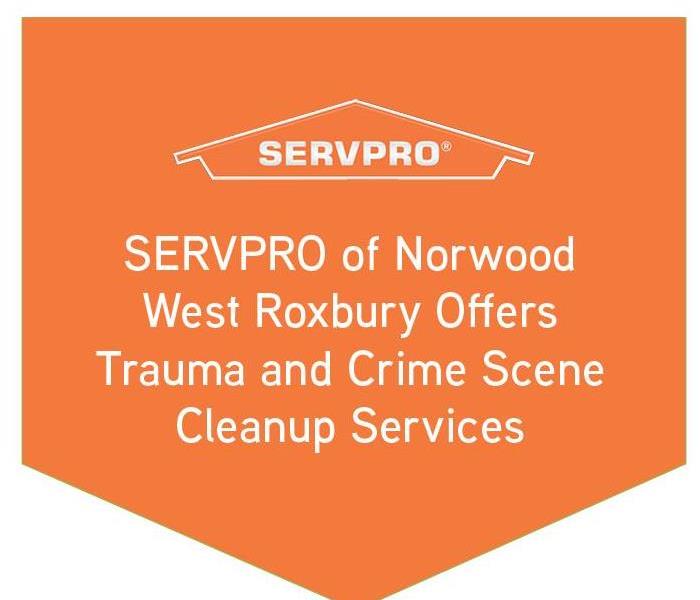 Since crime scenes may involve bloodborne pathogens and harmful chemicals we will always treat your property and the people with empathy.
Since crime scenes may involve bloodborne pathogens and harmful chemicals we will always treat your property and the people with empathy.
Our technicians follow OSHA and EPA protocols to help transform an unsafe environment back into a clean safe home.
Since crime scenes may involve bloodborne pathogens and harmful chemicals we will always treat your property and the people involved with the greatest empathy.
After the police have finished processing the scene, cleaning and restoration can begin. We will respond immediately and have the specialized training, protective equipment, and experience to safely clean trauma and crime scenes.
We help clean and restore:
- Crime Scene and Trauma Cleaning Services
- Fingerprint powder and evidence-gathering chemicals
- Tear gas and pepper spray residues
- Fire extinguisher residue
- Blood, bodily fluids, and tissue remnants
- Common Trauma and Crime Scene Scenarios
- Crime Scene Residues
From fingerprint powder and evidence-gathering chemicals, we clean and restore your property. Our trained Professionals clean, disinfect and deodorize the structure.
SERVPRO of Norwood West Roxbury is available 24/7 including holidays and weekends to assist you with your mold disaster needs to get it back to “Like it never even happened.”
SERVPRO of Norwood West Roxbury Offers Sewer Backup Services
2/2/2022 (Permalink)
 There are three major types of contaminated water. We will inspect that contaminated water to determine the type of water.
There are three major types of contaminated water. We will inspect that contaminated water to determine the type of water.
Water from sewer system backups is dangerous. The water is unsanitary and may contain bacteria and viruses. Special training and equipment are necessary to safely clean this type of contamination.
There are three major types of contaminated water. We will inspect that contaminated water to determine the type of water and then plan the appropriate response to safely restore your home.
Category 1: "Clean Water"
This is water from a clean source, such as a broken clean water supply line or faucet. If left untreated, category 1 water can quickly degrade into category 2 or 3.
Category 2: "Gray Water"
This water has a significant level of contamination that could cause discomfort. This may come from washing machine overflow; toilet overflow, or dishwasher overflow.
Category 3: "Black Water"
Any contact should be avoided. This happens when there are issues such as flooding from rivers or streams, water from beyond the toilet trap, or water from the toilet bowl with feces.
Local and state laws may require a specific inspection and documentation protocol based on the size of the affected area. We advise you on this process, providing guidance based on your unique situation.
SERVPRO of Norwood West Roxbury is available 24/7 including holidays and weekends to assist you with your mold disaster needs to get it back to “Like it never even happened.”
SERVPRO of Norwood West Roxbury Offers Mold Restoration Services
2/2/2022 (Permalink)
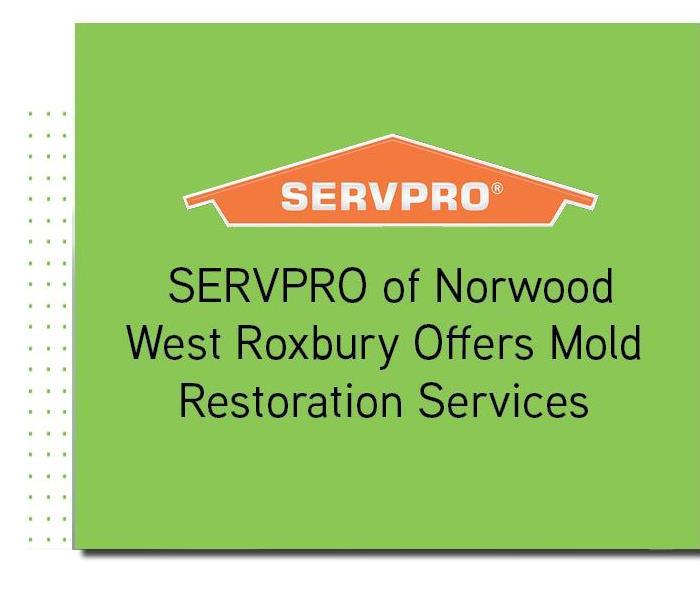 If you believe you have a mold problem, we can inspect and assess your property with our specialized training, equipment, and expertise.
If you believe you have a mold problem, we can inspect and assess your property with our specialized training, equipment, and expertise.
It only takes a small water leak, or humidity, for mold to form. Mold can spread in as little as 48 hours that produce allergens and irritants.
If you believe you have a mold problem, we can inspect and assess your property with our specialized training, equipment, and expertise.
Here are some facts about mold:
- Microscopic mold spores exist almost everywhere; this can make it impossible to remove all mold.
- Mold may enter your home through windows, doors, or AC/heating systems.
- Before mold remediation can start, the sources of water or moisture must be addressed.
- Mold often produces a strong, musty odor, that you might be able to smell and identify.
SERVPRO of Norwood West Roxbury is available 24/7 including holidays and weekends to assist you with your mold disaster needs to get it back to “Like it never even happened.”
SERVPRO of Norwood West Roxbury Talks How To Limit Mold Growth
1/19/2022 (Permalink)
 Certain types of mold can happen in cold weather. Here are steps you can take to prevent mold from happening in your home.
Certain types of mold can happen in cold weather. Here are steps you can take to prevent mold from happening in your home.
Most molds thrive in environments more than 70 degrees. However, other types of mold can happen in cold weather. Here are steps you can take to prevent mold from happening in your home.
Mold during the winter can be in uninsulated closets, crawlspaces, attics, and windows. Make sure to ensure these spots are kept free from moisture. Mold loves moisture, so keep the humidity level below 40%.
If you have spaces in your home that tend to be more humid, swap out wall-to-wall carpets for hard-surface floors or area rugs.
Make sure to fix any leaks in your roof and around doors and windows. Any spot that retains moisture can lead to mold.
When you take a shower or cook, always use fans to vent that moisture out of the house. Check all vents in the kitchen, bathroom, and laundry to the outside rather than to the crawlspace.
Many of the items on this list are regular maintenance items, but it’s always a good idea to have a winter checklist to prevent any disaster whenever possible. Prevention can go a long way to preventing mold infestation.
SERVPRO of Norwood West Roxbury is available 24/7 including holidays and weekends to assist you with your mold disaster needs to get it back to “Like it never even happened.”
SERVPRO of Norwood West Roxbury Uses Emergency Readiness Plan For Businesses
1/17/2022 (Permalink)
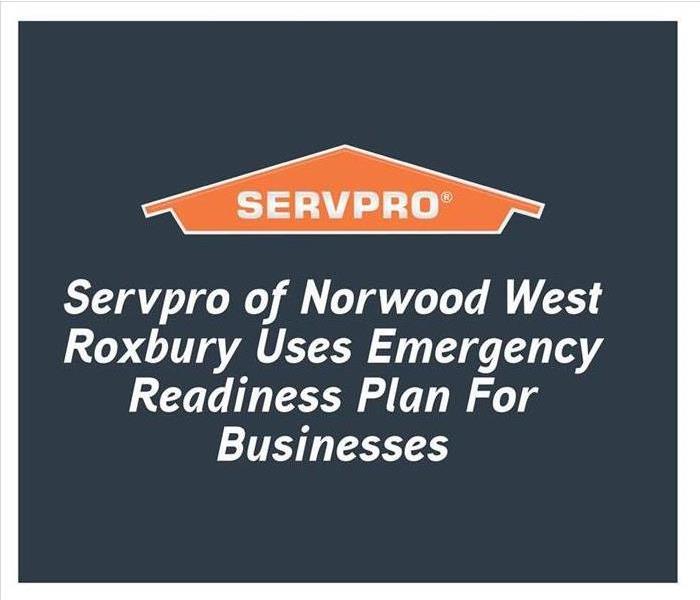 We never know when a disaster will hit, but it is important to have a plan ready for your business.
We never know when a disaster will hit, but it is important to have a plan ready for your business.
We never know when a disaster will hit, but it is important to have a plan ready for your business. Without proper preparation, a relatively minor emergency can have tragic consequences for any business.
An Emergency Readiness Plan must include the following:
- A procedure for reporting emergencies
- An evacuation plan
- A way to account for all employees after the evacuation
- Medical or rescue duties being performed by employees, if applicable
To truly protect your employees, your contingency plan could also include a description of the various alarms that will go off in the event of an emergency.
You may also want to come up with an alternative communications location where everyone can gather in the event of a fire or smoke damage to the property.
Once the plan is in place, select an employee to lead the facility in event of an emergency. Your employees should also be trained so they understand the plan. Consider holding practice drills to test.
SERVPRO of Norwood West Roxbury is available 24/7 including holidays and weekends to assist you with your commercial restoration needs to get it back to “Like it never even happened.”
SERVPRO of Norwood West Roxbury is Faster To Any Size Disaster
1/13/2022 (Permalink)
 We respond quicker with more resources and tools for all of your restoration needs.
We respond quicker with more resources and tools for all of your restoration needs.
We respond quicker with more resources and tools for all of your restoration needs. For major storms and disasters, we call upon special Disaster Recovery Teams for additional resources.
There are many benefits when working with SERVPRO of Norwood West Roxbury:
- 24 Hour Emergency Service
- We have technicians that are on call with specialized equipment
- We have advanced training to quickly restore your property
- We’re dedicated to responding immediately
In many cleaning and restoration situations, immediate action is needed. An immediate response helps to minimize the damage and the cleaning and restoration costs.
SERVPRO of Norwood West Roxbury is available 24/7 including holidays and weekends to assist you with your home restoration needs to get it back to “Like it never even happened.”
SERVPRO of Norwood West Roxbury has Advanced Technology and Techniques
1/4/2022 (Permalink)
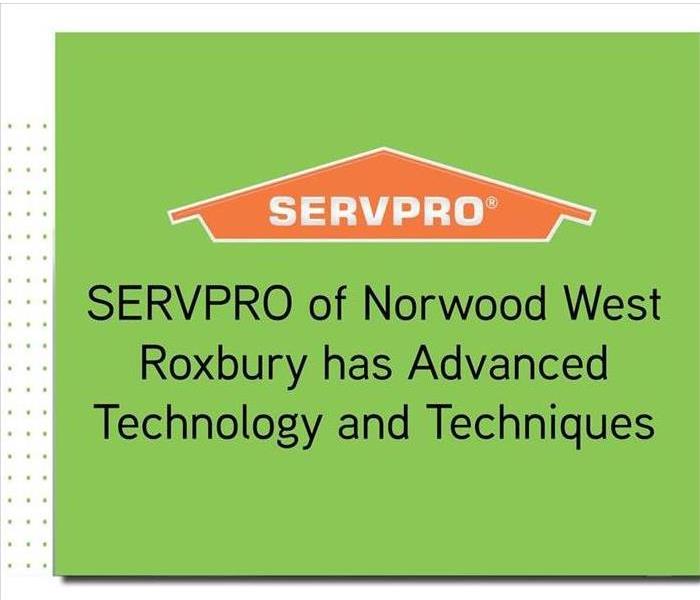 SERVPRO is ready to respond immediately when you need restoration services for your home or business.
SERVPRO is ready to respond immediately when you need restoration services for your home or business.
SERVPRO is ready to respond immediately when you need restoration services for your home or business. We have the training, equipment, and resources for any size disaster.
Moisture Detection and Measurement Equipment: Scientific drying principles rely upon specialized equipment to detect, measure, and monitor a property’s moisture levels. Infrared cameras can help detect water through a wall, ceiling, or floor.
Water Extraction Equipment: Powerful extraction equipment speeds the drying process by removing the bulk of the water.
Drying Equipment: Industrial strength air movers and dehumidifiers are needed to remove the remaining moisture from the ceiling, walls, and floors. Proper drying helps to prevent swelling and warping of floors.
Odor Removal and Deodorization: Water and fire damage often causes powerful odors. Our machines remove airborne contaminants and control the air quality during the restoration and cleanup process.
SERVPRO of Norwood West Roxbury is available 24/7 including holidays and weekends to assist you with your home restoration needs to get it back to “Like it never even happened.”
SERVPRO of Norwood West Roxbury Helps Restoration For Residential And Commercials
1/4/2022 (Permalink)
 We will be there for you on a continual basis, from the time you request services until the job has been completed to your satisfaction.
We will be there for you on a continual basis, from the time you request services until the job has been completed to your satisfaction.
We will be there for you on a continual basis, from the time you request services until the job has been completed to your satisfaction. You can count on your project manager from your first point of contact and throughout the entire remediation process. We collaborate with you while working with our great team of technicians, carefully and expeditiously restoring your home or business to a like-new state.
We take pride in our major advantages such as
- 24-Hour Emergency Service
- Faster to Any Size Disaster
- Highly Trained Restoration Technicians
- A Trusted Leader in the Restoration Industry
- Locally Owned and Operated
- Advanced Restoration and Cleaning Equipment
SERVPRO of Norwood West Roxbury is available 24/7 including holidays and weekends to assist you with your home restoration needs to get it back to “Like it never even happened.”
SERVPRO of Newton Wellesley Community Shares Christmas Safety
12/23/2021 (Permalink)
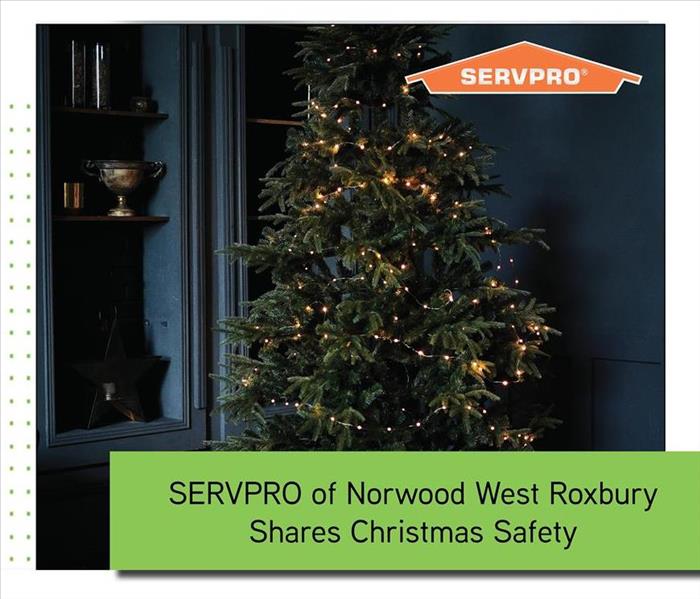 Christmas is a wonderful time of year. It is important to know some safety tips during the year, so you can protect yourself and your family.
Christmas is a wonderful time of year. It is important to know some safety tips during the year, so you can protect yourself and your family.
Christmas is a wonderful time of year. It is important to know some safety tips during the year, so you can protect yourself and your family. It’s fun to decorate, but holiday decorations may increase your risk for a home fire, if not careful. Nearly half of holiday decoration fires happen because decorations are placed too close to a heat source. Here are some safety tips:
- Inspect holiday lights before putting them up. Throw away light strands that are frayed or have pinched wires.
- Water your Christmas tree every day because a dry tree can catch on fire easily.
- Consider using battery-operated flameless candles. These can look and feel like real candles. Make sure they are in stable holders and place them where they cannot be knocked down easily.
- Half of the home decoration fires in December are started by candles. If you are not near the candle, blow it out so you prevent a fire. Make sure to keep candles at least 12 inches away from anything that burns.
- More than 1 in every 5 Christmas tree fires were caused by a heat source too close to the tree. Make sure your tree is at least 3 feet away from heat sources like fireplaces, radiators, space heaters, candles, or heat vents.
- Get rid of your tree after Christmas or when it is dry.
Happy Holidays from all of us at SERVPRO of Newton Wellesley. We hope you have a wonderful and safe holiday season!
SERVPRO of Newton Wellesley is available 24/7 including holidays and weekends to assist you and get your home back to “Like it never even happened.”
SERVPRO of Newton Wellesley Community Shares Winter Storm Safety
12/20/2021 (Permalink)
 The winter months have arrived Newton Wellesley and it is important to prepare ahead. Here are some great winter storm safety tips for you
The winter months have arrived Newton Wellesley and it is important to prepare ahead. Here are some great winter storm safety tips for you
The winter months have arrived Newton Wellesley and it is important to prepare ahead. Here are some great winter storm safety tips for you:
- Learn how to protect pipes from freezing: Check your home heating sources are correct with local codes and permit requirements.
- Make sure your home is properly insulated: Check Caulk and weather-strip doors, and windows, to keep cold air out.
- Heating options: Consider buying emergency heating equipment, such as a wood-burning stove or kerosene heater.
- Fireplace: Keep a supply of firewood handy. Be sure the fireplace is properly vented and in good working order before using it.
- Flooding: Consider purchasing flood insurance, if you live in a flood-prone area.
- Emergency Kit: Check your emergency kit and replenish any items that may have been expired or are missing.
A winter storm can hit at any time, and sometimes a business might not even be prepared for it. These are some tips to keep handy should the need arise.
SERVPRO of Newton Wellesley is available 24/7 including holidays and weekends to assist you and get your home back to “Like it never even happened.”
SERVPRO of Newton Wellesley Community Gives Back To The Community
12/14/2021 (Permalink)
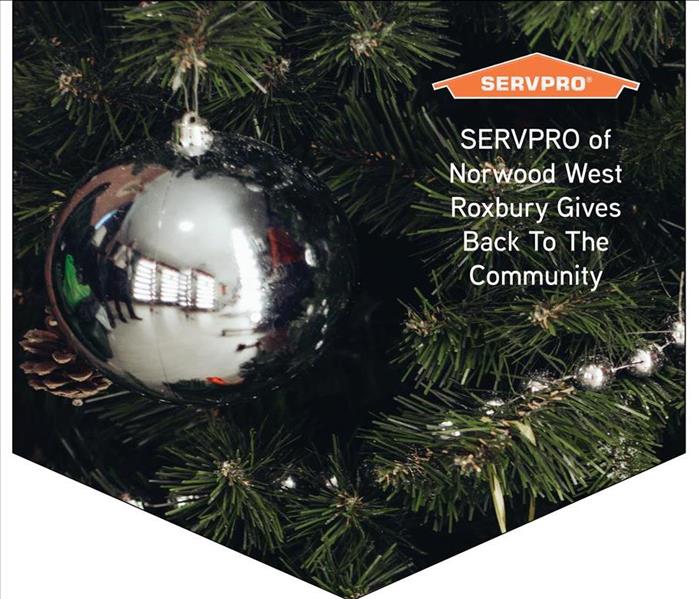 Our local SERVPRO Team is working to assist the Framingham Food Pantry here in Massachusetts this holiday season.
Our local SERVPRO Team is working to assist the Framingham Food Pantry here in Massachusetts this holiday season.
Our local SERVPRO Team is working to assist the Framingham Food Pantry here in Massachusetts this holiday season.
You can stop into our location (90 Elm Street Hopkinton, MA 01748) and donate the following items: flour (2,4 or 5 lbs) canola oil, vegetable oil, and olive oil of any size. They are also in need of personal hygiene items toothpaste, shampoo, and bars of soap.
If you are not able to make it out to our location, you can make a donation right online: https://www.hopeworldwidema.org/framingham-food-pantry
We appreciate your help this holiday season! Happy Holidays!
SERVPRO of Newton Wellesley is available 24/7 including holidays and weekends to assist you and get your home back to “Like it never even happened.”
SERVPRO of Newton Wellesley Community Prepares Businesses With Emergency Readiness Plan
12/11/2021 (Permalink)
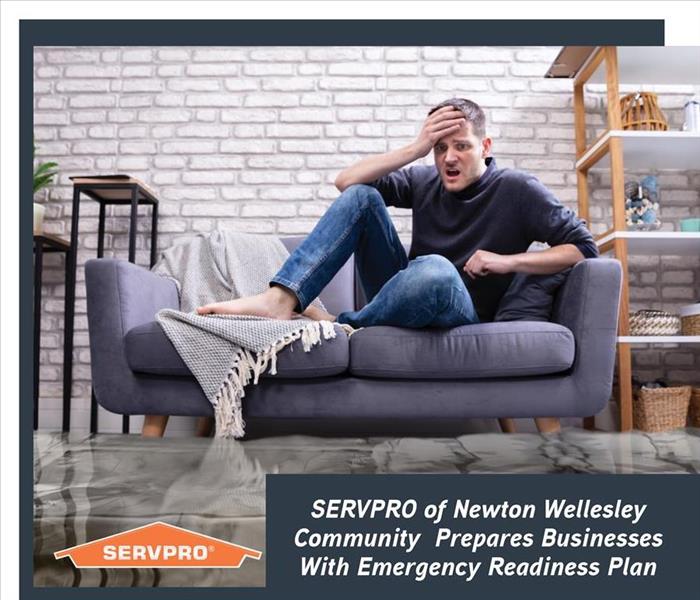 It is important to have a plan in place ahead of time in case a disaster strikes in your business.
It is important to have a plan in place ahead of time in case a disaster strikes in your business.
It is important to have a plan in place ahead of time in case a disaster strikes in your business. Businesses that come out stronger on the other side of an emergency are the ones that pre-planned using SERVPRO’s Emergency Ready Plan (ERP).
This will help your business be able to minimize interruption because you’ll know what to do.
Here are some benefits for choosing SERVPRO when you have commercial damage:
- Available 24/7, including all major holidays: Storms and disasters can strike at any time.
- Commercial Large Loss Division: Our Disaster Recovery Teams are composed of elite technicians who have the training and resources.
- Easier Insurance Claims Process: We will help you navigate the insurance claims process and ensure it is properly taken care of.
No matter what the disaster at your business is, we can help you get your business restored. If you are ready to set up your Emergency Readiness Plan, give us a call today.
SERVPRO of Newton Wellesley is available 24/7 including holidays and weekends to assist you and get your home back to “Like it never even happened.”
SERVPRO of Newton Wellesley Community Helps Commercial Buildings Restore
12/6/2021 (Permalink)
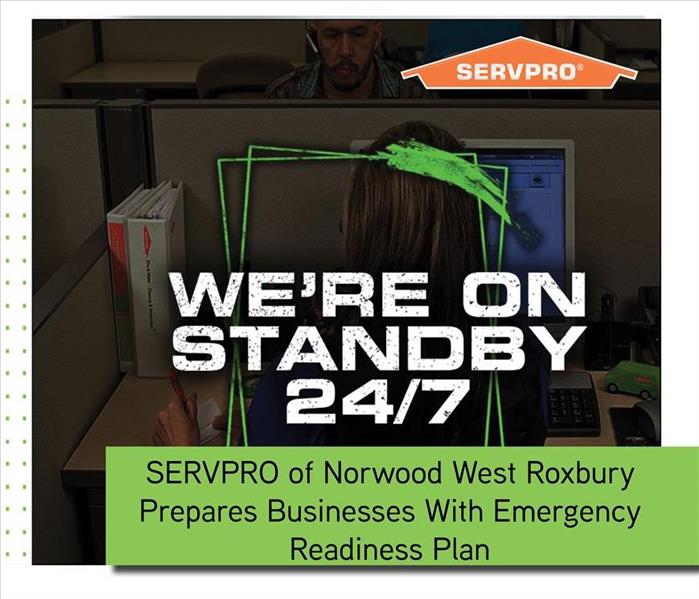 SERVPRO of Framingham helps commercial buildings with cleaning and restoration projects, that are either large or small.
SERVPRO of Framingham helps commercial buildings with cleaning and restoration projects, that are either large or small.
SERVPRO of Framingham helps commercial buildings with cleaning and restoration projects, that are either large or small.
When your commercial property is hit with damage due to a storm it can leave your employees in shock. It’s important to know that you have professional large-loss specialists to handle the restoration process.
Here are benefits for hiring SERVPRO:
- Available 24/7: Storms and disasters can strike at any time of the day or night, so we are available no matter when.
- Professionals: Our Disaster Recovery Teams are composed of elite technicians; they have training and resources to handle large-loss events.
- Large Commercial Assistance: We serve industries such as hospitals, universities, and government facilities.
- Personal Approach: Each large loss project is managed by our project manager.
- Teamwork: We will help you navigate the insurance claims process and coordinate the necessary paperwork for a great experience.
SERVPRO of Newton Wellesley is available 24/7 including holidays and weekends to assist you and get your home back to “Like it never even happened.”
SERVPRO of Norwood West Roxbury Celebrates Small business Saturday
11/27/2021 (Permalink)
 There is an entire day dedicated to the small local businesses: Small Business Saturday.
There is an entire day dedicated to the small local businesses: Small Business Saturday.
With the holidays here, people are trying to find the best deals for all of the items on family and friends. There is an entire day dedicated to the small local businesses: Small Business Saturday. We support and love all of our local small businesses not only today but through out the year.
This year, Small Business Saturday lands on November 27th. It is important to support local businesses especially after the year we have had. We can’t wait to see all the great sales from our local community.
SERVPRO of Norwood West Roxbury is available 24/7 including holidays and weekends to assist you with your home restoration needs to get it back to “Like it never even happened.”
SERVPRO of Norwood West Roxbury Celebrates Thanksgiving
11/24/2021 (Permalink)
 Here are some Thanksgiving safety tips.
Here are some Thanksgiving safety tips.
Thanksgiving Day is a national holiday in the United States. In 1621, the Plymouth colonists and Wampanoag Native Americans shared an autumn harvest feast that is acknowledged today as one of the first Thanksgiving celebrations in the colonies.
Here are some Thanksgiving safety tips:
- Do not leave food cooking unsupervised.
- Have a fire extinguisher nearby.
- Do not leave candles burning unattended.
- Do not burn candles near flammable items like curtains.
- Follow instructions carefully when using a deep fryer.
Happy Thanksgiving to all of our friends and family in Norwood West Roxbury have a wonderful day!.
SERVPRO of Norwood West Roxbury is available 24/7 including holidays and weekends to assist you with your home restoration needs to get it back to “Like it never even happened.”
SERVPRO of Norwood West Roxbury Talks Winter Weather Safety
11/16/2021 (Permalink)
 We all know that winter in the Norwood West Roxbury area can change quickly. Here are some important winter storm things to know.
We all know that winter in the Norwood West Roxbury area can change quickly. Here are some important winter storm things to know.
We all know that winter in the Norwood West Roxbury area can change quickly. Here are some important winter storm things to know.
- Winter Storm Warning: This is issued when hazardous weather is arriving such as heavy snow, freezing rain, or sleet. This is usually issued 12 to 24 hours beforehand.
- Winter Weather Advisory: This is issued for accumulations of snow, freezing rain, and sleet.
- Know Your Risk for Winter Storms: Pay attention to the weather and warnings of winter storms.
SERVPRO of Norwood West Roxbury is available 24/7 including holidays and weekends to assist you with your home restoration needs to get it back to “Like it never even happened.”
SERVPRO of Norwood West Roxbury Provides Shopping Online Tips.
11/12/2021 (Permalink)
 Online shopping is blooming this year. It’s important to take steps to protect yourself when shopping online.
Online shopping is blooming this year. It’s important to take steps to protect yourself when shopping online.
Online shopping is blooming this year. It’s important to take steps to protect yourself when shopping online especially during the holiday season.
It makes it more lucrative for scammers. They can trick buyers into paying for goods they won’t receive or even obtain personal information.
Here are some online shopping tips:
- Think before you click: Beware of ads encouraging clicking on links and leaving a website to another.
- Do your homework: Prior to making a purchase, read reviews and learn more about a company.
- Consider your payment options: A credit card is much better than using a debit card.
- Watch what you give away: Be alert to the kinds of information being collected to complete your transaction.
- Keep tabs on your bank and statements: Set up alerts so that if your credit card is used, you will receive a text message.
- Keep a clean machine: Be sure that all internet-connected devices like computers and smartphones are free from malware.
- Use secure Wi-Fi: Public Wi-Fi to shop online is convenient, but you should use a Virtual Private Network (VPN) or your phone as a hotspot.
SERVPRO of Norwood West Roxbury is available 24/7 including holidays and weekends to assist you with your home restoration needs to get it back to “Like it never even happened.”
SERVPRO of Norwood West Roxbury Shares Christmas Tree Safety
11/9/2021 (Permalink)
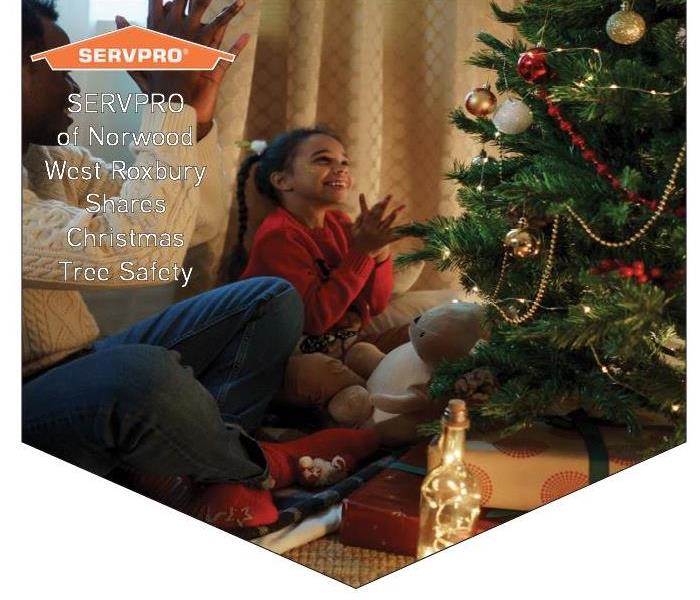 Fires are very common around the holidays simply because of Christmas trees and lights. To help prevent fires this holiday season here are some tips
Fires are very common around the holidays simply because of Christmas trees and lights. To help prevent fires this holiday season here are some tips
Fires are very common around the holidays simply because of Christmas trees and lights. Roughly three-quarters of Christmas tree fires occur in December or January. (National Fire Protection Association). To help prevent fires this holiday season here are some tips:
- Use miniature lights, they are great because they help reduce the drying of the tree.
- Always inspect light sets prior to placing them on the tree.
- Do not overload electrical circuits.
- Always turn off the lights when unattended.
- If the tree is dry, remove it from the house.
- Never burn any part of the tree in a fireplace.
SERVPRO of Norwood West Roxbury is available 24/7 including holidays and weekends to assist you with your home restoration needs to get it back to “Like it never even happened.”
SERVPRO of Norwood West Roxbury Shares Thanksgiving Cooking Safety
11/4/2021 (Permalink)
 The kitchen is used a lot during the holiday. Keep fire safety top of mind this holiday.
The kitchen is used a lot during the holiday. Keep fire safety top of mind this holiday.
Cooking fires are the number one cause of home fires. The kitchen is used a lot during the holiday. Keep fire safety top of mind this holiday. Here are some tips so you and your loved ones can stay safe during the holiday:
- Stay in the kitchen when you are cooking.
- Check on your turkey often.
- Keep children at least three feet away from cooking.
- Watch electric cords and make sure they aren’t dangling.
- Keep matches and lighters out of the reach of children.
- Keep the floor clear so you don’t trip with hot items.
- Make sure your smoke alarms are working.
SERVPRO of Norwood West Roxbury is available 24/7 including holidays and weekends to assist you with your home restoration needs to get it back to “Like it never even happened.”
Grease Fire Safety
11/2/2021 (Permalink)
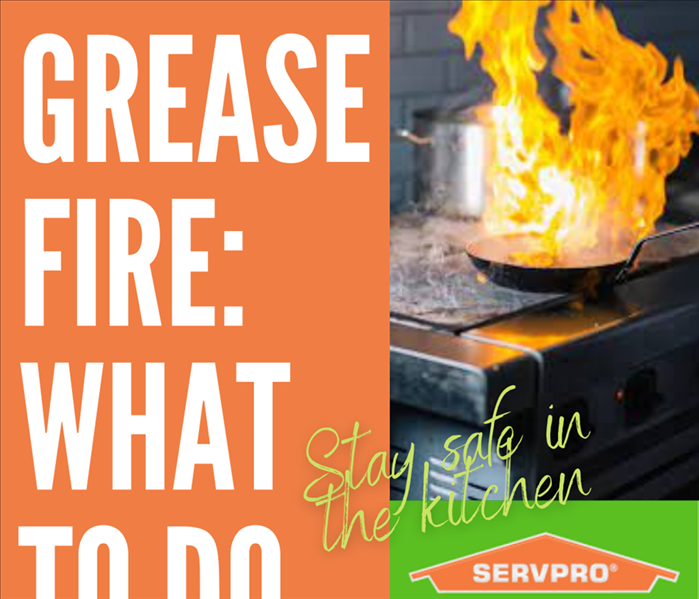 Know what to do before the instance so you can be prepared in case of emergency
Know what to do before the instance so you can be prepared in case of emergency
Grease fires can be incredibly dangerous when they begin. Follow these simple tips to keep your home safe from this event:PREVENTION:- Never leave the pot or pan unattended. This is the leading cause of grease fires.- Heat oil slowly- Add food slowly and gently to prevent oil splashing- Keep anything flammable away from the stovetop- Never put frozen food into hot grease- Always keep a metal pot lid on the counter to quickly smother a pan fireIF FIRE STARTS:- If fire has spread beyond the cooktop, call 911 and SERVPRO. It takes less then five minutes for a room to be engulfed in flames.- If fire is small, smother it with salt.- Use a Class K fire extinguisher as a last resort. This is a wet chemical extinguisher. SERVPRO of Norwood/West Roxbury is here for you, 24/7/365, to assist you and your home/commercial property in case disaster strikes. Keep our number in your emergency contacts: (781) 769-9125
SERVPRO Norwood West Roxbury Halloween Safety Tips
10/30/2021 (Permalink)
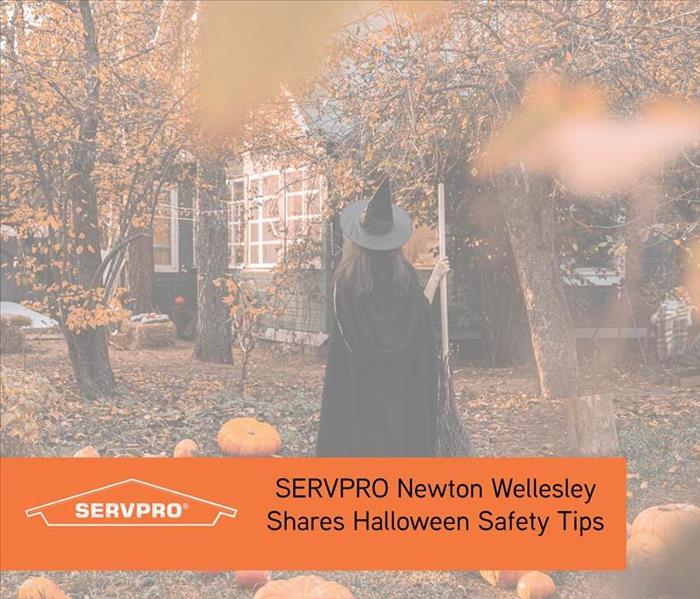 Halloween is a fun day for children. They get to dress up and get free candy. However, along with Trick or Treating comes safety.
Halloween is a fun day for children. They get to dress up and get free candy. However, along with Trick or Treating comes safety.
Halloween is a fun day for children. They get to dress up and get free candy. However, along with Trick or Treating comes safety; this is the utmost important thing for all kids.
Here are safety tips for this day:
- Walk Safely: Make sure to cross the street at corners and use traffic signals and crosswalks. Double-check left, right, and left again when crossing.
- Put electronic devices down: Pay attention to your surroundings and keep your head up.
- Walk on sidewalks: If there are no sidewalks, walk facing traffic.
- Watch for cars: Look out for cars that are backing up. Do not run into the street.
- Wear bright colors: Make sure to have some reflective clothing and choose light colors so people can see you at night.
- Drive safe: Take extra time to look for kids at intersections and hidden areas.
- Make sure to turn your headlights on so you can spot them from greater distances.
- Popular trick-or-treating hours are 5:30 p.m. to 9:30 p.m. Be especially alert for kids during those hours.
- Most of all have fun and be safe! Happy Halloween.
SERVPRO of Norwood West Roxbury is available 24/7 including holidays and weekends to assist you with your home restoration needs to get it back to “Like it never even happened.”
SERVPRO Norwood West Roxbury Honors National First Responders Day
10/28/2021 (Permalink)
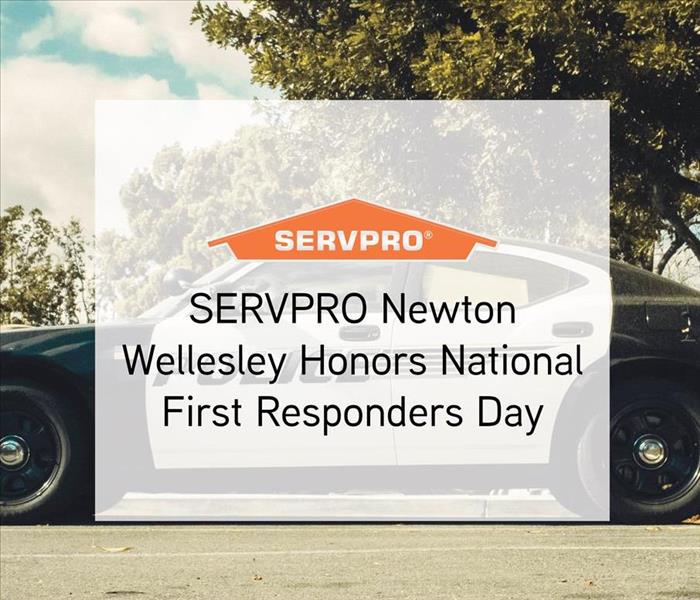 October 28th is National First Responders Day and it is a day to honor the men and women when an emergency is at hand.
October 28th is National First Responders Day and it is a day to honor the men and women when an emergency is at hand.
October 28th is National First Responders Day and it is a day to honor the men and women when an emergency is at hand.
First responders are dedicated to saving lives: firefighters, police, emergency medical technicians (EMT), paramedics, and 911 operators.
We honor this national day of gratitude and pay tribute to their endless hours and sacrifices.
HOW TO OBSERVE #NationalFirstRespondersDay
This day provides you with an opportunity to recognize a first responder.
- Treat them to their favorite beverage
- Buy their next meal
- Hand deliver a note and gift
Connect with a first responder and thank them. Let them know you appreciate their dedication and sacrifice.
SERVPRO of Norwood West Roxbury is available 24/7 including holidays and weekends to assist you with your home restoration needs to get it back to “Like it never even happened.”
SERVPRO Norwood West Roxbury Honors Mental Health Day
10/10/2021 (Permalink)
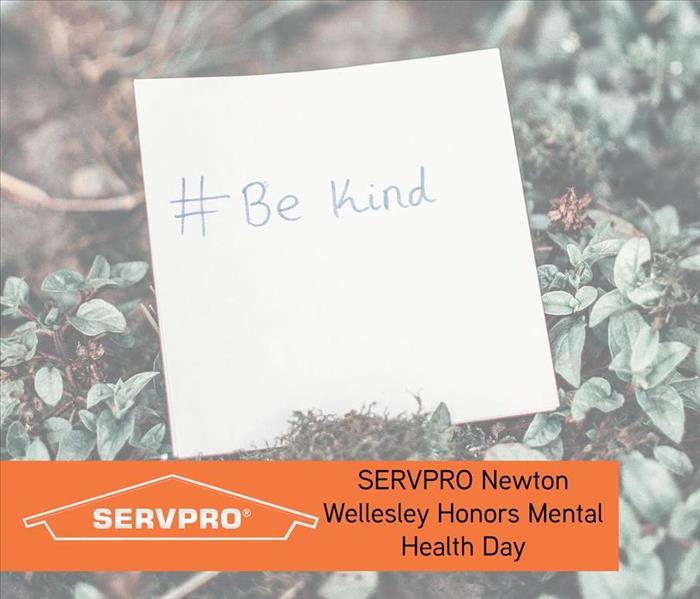 World Mental Health Day is celebrated on October 10th to help raise awareness and support mental health.
World Mental Health Day is celebrated on October 10th to help raise awareness and support mental health.
World Mental Health Day is celebrated on October 10th to help raise awareness and support mental health.
Mental health is a demanding topic. People aren’t shy to address mental health issues and are finally getting the attention they deserve.
However, that doesn’t mean we should stop creating awareness.
Mental health covers several areas and means many things to different people: social, emotional, and psychological well-being. It can affect thoughts, feelings, and actions. Positive mental health will help decrease stress.
HOW TO OBSERVE #MentalHealthDay
Not everyone faces mental health issues, but mental health can impact many at one point or another. Discussing mental health with your loved ones helps.
- Organizations host a variety of events about this topic. Events may include educational seminars, free mental health screenings, walk-a-thons, marathons, conferences, mass media promotions, and more. You can find some here: https://www.nami.org/Get-Involved/Awareness-events
- If you know someone who struggles with a mental health disorder, reach out to them and offer support. Knowing they have someone to reach out to can be life-changing.
- You can also donate to an organization: National Alliance on Mental Health (NAMI) and the Brain and Behavior Research Foundation.
Share this day on social media with #WorldMentalHealthDay.
SERVPRO of Norwood West Roxbury is available 24/7 including holidays and weekends to assist you with your home restoration needs to get it back to “Like it never even happened.”
SERVPRO Norwood West Roxbury Gives Back During Breast Cancer Month
10/4/2021 (Permalink)
 The entire month of October is Breast Cancer Awareness Month. This was created to raise awareness about the impact of breast cancer.
The entire month of October is Breast Cancer Awareness Month. This was created to raise awareness about the impact of breast cancer.
The entire month of October is Breast Cancer Awareness Month. This was created to raise awareness about the impact of breast cancer and local communities.
Each year in the United States, about 255,000 women get breast cancer and 42,000 women die from the disease.
Men also get breast cancer, but it is not very common. About 1 out of every 100 breast cancers diagnosed in the United States are found in a man. (CDC)
Here are ways to give back:
- Make a Donation: This will help cancer patients get the medical help and resources they need.
- Start a Fundraiser: Get involved with friends and family to start one and make it fun.
- Join a Race or Walk: This will help fund life-saving research, treatment, and education.
https://www.komen.org/
SERVPRO of Norwood West Roxbury is available 24/7 including holidays and weekends to assist you with your home restoration needs to get it back to “Like it never even happened.”
SERVPRO Norwood West Roxbury Honors Fire Prevention Week
10/4/2021 (Permalink)
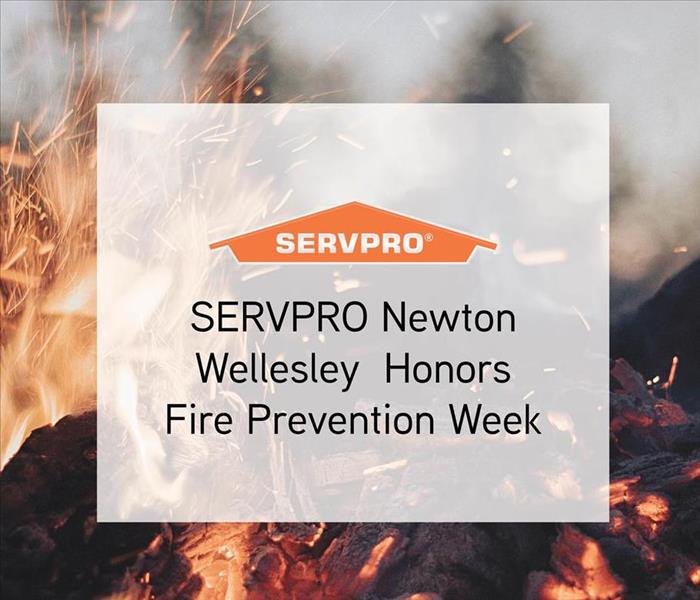 The National Fire Protection Association (NFPA) designates one week, Sunday, October 3rd to Saturday, October 9th, each year to share fire safety.
The National Fire Protection Association (NFPA) designates one week, Sunday, October 3rd to Saturday, October 9th, each year to share fire safety.
The National Fire Protection Association (NFPA) designates one week, Sunday, October 3rd to Saturday, October 9th, each year to share fire safety topics. This is honored for one week once a year, but we should practice fire safety at all times.
The goal of Fire Prevention Month is to raise fire safety awareness but to help ensure safety and protection. In 1922, the National Fire Protection Association (NFPA) named the second week of October Fire Prevention Week in commemoration of the Great Chicago Fire in 1871. (First Alert)
Fire safety awareness and education are important for families and communities. Check your local fire department, sometimes provide education to local communities.
The NFPA's 2021 campaign for Fire Safety Month is "Learn The Sounds of Fire Safety. (NFPA)"
Here are some ways to help protect your home and family:
- Install smoke and carbon monoxide alarms
- Have fire extinguishers at home
- Have an emergency plan
- Have local numbers handy (insurance, restoration, doctors, vet, etc).
- Test alarms
- Change the batteries
- Know how to use a fire extinguisher
Unattended cooking is the #1 cause of home fires. (First Alert)
Please practice home safety, so you are prepared throughout the entire year.
SERVPRO of Norwood West Roxbury is available 24/7 including holidays and weekends to assist you with your home restoration needs to get it back to “Like it never even happened.”
SERVPRO Norwood West Roxbury Celebrates Fall
9/22/2021 (Permalink)
 September 22nd is the autumnal equinox. Fall begins in the Northern Hemisphere whereas spring begins in the Southern Hemisphere.
September 22nd is the autumnal equinox. Fall begins in the Northern Hemisphere whereas spring begins in the Southern Hemisphere.
September 22nd is the autumnal equinox. Fall begins in the Northern Hemisphere whereas spring begins in the Southern Hemisphere.
This is the turning point when darkness begins to win over daylight. Our hours of daylight have been slightly shorter each day since the summer solstice in June.
For the next three months, our hours of daylight will continue to grow shorter. At the autumnal equinox, day and night are approximately equal in length.
SERVPRO of Norwood West Roxbury is available 24/7 including holidays and weekends to assist you with your home restoration needs to get it back to “Like it never even happened.”
SERVPRO Norwood West Roxbury discusses National Preparedness Month
9/15/2021 (Permalink)
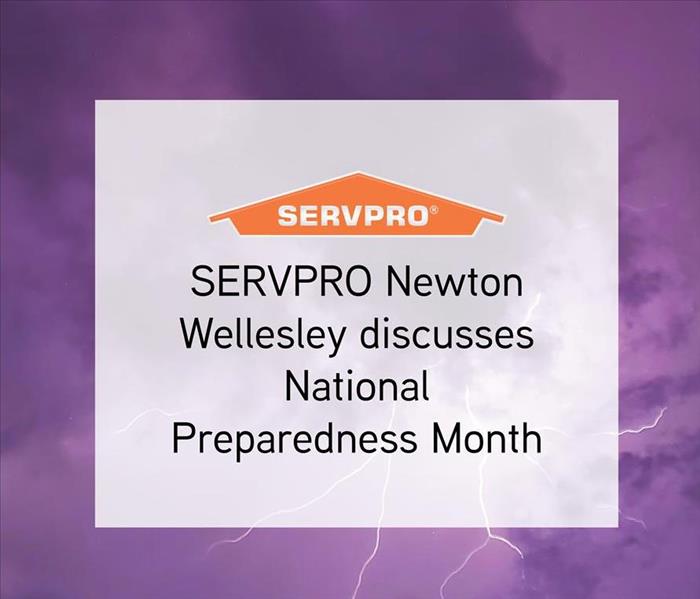 Natural disasters can happen to any home or business. It is important to be aware of the different types of disasters, and know if you can be affected
Natural disasters can happen to any home or business. It is important to be aware of the different types of disasters, and know if you can be affected
Natural disasters can happen to any home or business. It is important to be aware of the different types of disasters, and know if you can be affected by any of them.
Wildfires: If there is a wildfire in the area, be ready to evacuate quickly since they spread rapidly.
Hurricanes: Make sure to know where to go if asked to evacuate and how you will get there; it is important to act fast.
Flooding: If you approach a flooded road, turn around, don't think you can handle it.
Drought: Learn to make conserving water a part of your daily life.
Extreme Heat Temperatures: Drink plenty of water; heat exhaustion is not good for your body.
Always make sure to have a cell phone plugged into a backup battery pack if you know a disaster is coming.
SERVPRO of Norwood West Roxbury is available 24/7 including holidays and weekends to assist you with your home restoration needs to get it back to “Like it never even happened.”
SERVPRO Norwood West Roxbury Honors Grandparents Day
9/12/2021 (Permalink)
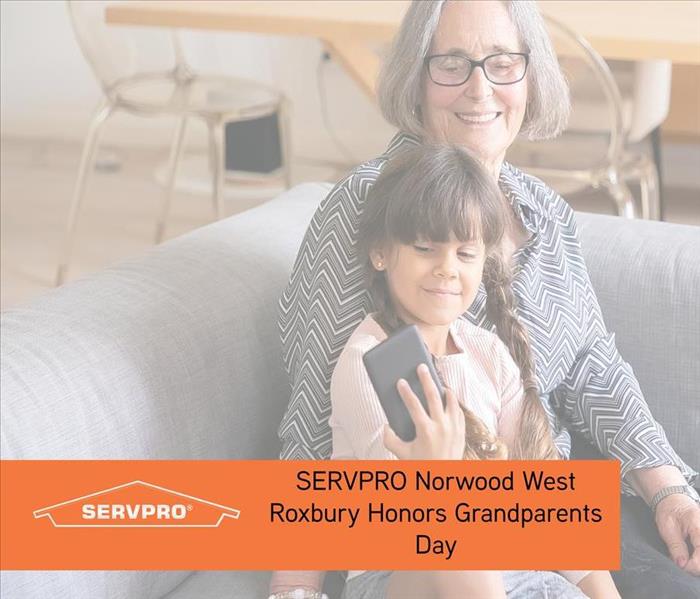 Sunday, September 12 is Grandparents Day. It is a special day for grandparents. We support Grandparents’ Day because Grandkids Matter.
Sunday, September 12 is Grandparents Day. It is a special day for grandparents. We support Grandparents’ Day because Grandkids Matter.
Sunday, September 12 is Grandparents Day. It is a special day for grandparents.
We support Grandparents’ Day because Grandkids Matter. Grandchildren thrive when grandparents have a supporting relationship with family members.
There is a special day for Mothers and Fathers so why not have a whole day dedicated to our grandparents. Grandparents have a uniquely special bond, and this day is a great time to treasure that time together.
Make sure to spend time with your Grandparents not only today but as often as you can.
SERVPRO of Norwood West Roxbury is available 24/7 including holidays and weekends to assist you with your home restoration needs to get it back to “Like it never even happened.”
SERVPRO Norwood West Roxbury Emergency Supply Kits For National Preparedness Month
9/12/2021 (Permalink)
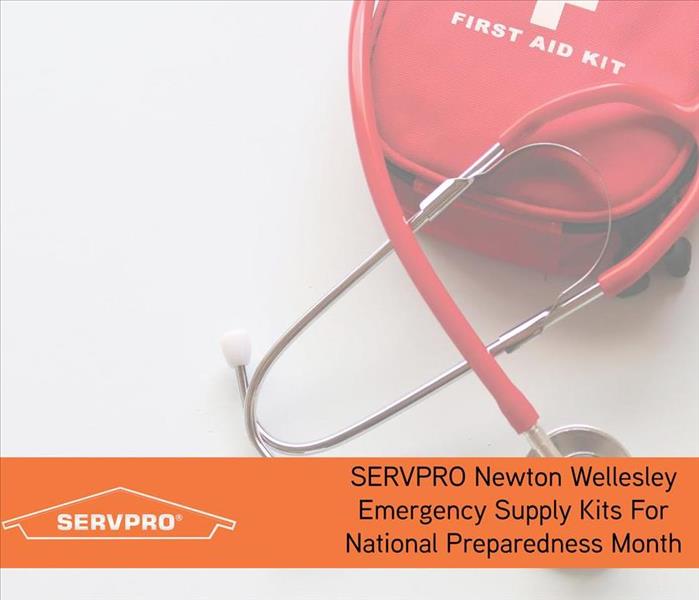 A supply kit should be prepared for potential disasters. You should make sure your family has the necessary food and supplies.
A supply kit should be prepared for potential disasters. You should make sure your family has the necessary food and supplies.
A supply kit should be prepared for potential disasters. You should make sure your family has the necessary food and supplies.
It is also important to keep the kit up to date. Keep food and water fresh. It is typically best to store the kit, along with any pet supplies, in a closet.
Here is a basic emergency supply kit list:
- Water (one gallon per person per day for several days, for drinking and sanitation)
- Food (at least a three-day supply of non-perishable food)
- Battery-powered radio and an NOAA Weather Radio
- Flashlight
- First aid kit
- Extra batteries
- Dust mask (to help filter contaminated air)
- Moist towelettes, garbage bags, and plastic ties (for personal sanitation)
- Wrench or pliers (to turn off utilities)
- Manual can opener (for food)
- Cell phone with chargers and a backup battery
- Non-prescription medications such as pain relievers
- Prescription eyeglasses or contact lens solution
- Infant formula, bottles, diapers, wipes, and diaper rash cream
- Pet food and extra water for your pet
- Important family documents such as copies of insurance policies, identification, and bank account records saved electronically
- Sleeping bag or warm blanket for each person
- Complete change of clothing appropriate for your climate
- Fire extinguisher
- Feminine supplies and personal hygiene items
- Paper cups, plates, paper towels, and plastic utensils
- Books, games, puzzles, or other activities for children
Source; https://www.ready.gov/kit
SERVPRO of Norwood West Roxbury is available 24/7 including holidays and weekends to assist you with your home restoration needs to get it back to “Like it never even happened.”
SERVPRO Norwood West Roxbury Honors 9-11
9/10/2021 (Permalink)
 September 11th is Patriot Day. It is an observed holiday in the United States. This is to commemorate the lives of those who were lost in 2001.
September 11th is Patriot Day. It is an observed holiday in the United States. This is to commemorate the lives of those who were lost in 2001.
September 11th is Patriot Day. It is an observed holiday in the United States. This is to commemorate the lives of those who were lost in the 2001 terrorist attacks.
On December 18th, 2001, September 11th was declared as Patriot Day. This is a yearly proclamation requesting that all flags be flown at half-staff.
Americans are asked to honor those lost with a moment of silence at 8:46 AM, Eastern Standard Time. This is the time that the first airplane struck the World Trade Center.
Please join us today remembering those at this designation time.
SERVPRO of Norwood West Roxbury is available 24/7 including holidays and weekends to assist you with your home restoration needs to get it back to “Like it never even happened.”
Happy Labor Day From SERVPRO Norwood West Roxbury
9/1/2021 (Permalink)
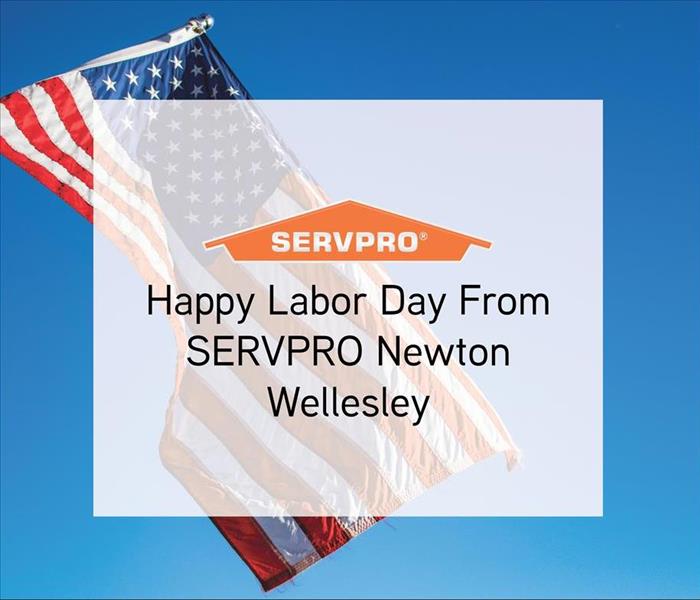 We hope that you have a healthy and safe Labor Day weekend and are able to enjoy time off.
We hope that you have a healthy and safe Labor Day weekend and are able to enjoy time off.
Labor Day is Monday, September 6th. It is a day to tribute the contributions and achievements of the hard-working Americans.
Labor Day was created by the labor movement in the 19th century; it became a federal holiday in 1894. This is an annual celebration of workers and their achievements. It originated during one of American labor history’s most dismal chapters.
The Industrial Revolution in the United States on average had Americans working 12-hour days and seven-day weeks to make a basic living. Even children as young as 5 or 6 were working across the country.
People were faced with extremely unsafe working conditions, sanitary facilities, and uneven breaks.
Today it symbolizes the end of summer for many Americans. This is celebrated with parties, street parades, and festivals.
We hope that you have a healthy and safe Labor Day weekend and are able to enjoy time off.
SERVPRO of Newton Wellesley is available 24/7 including holidays and weekends to assist you and get your home back to “Like it never even happened.”
Fire Safety Tips for Fall in Norwood West Roxbury
8/31/2021 (Permalink)
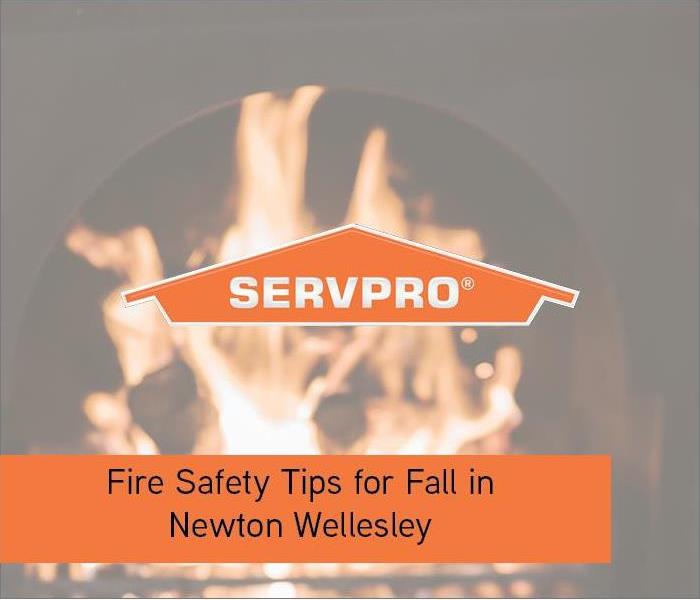 There’s nothing cozier than spending time with a fireplace to keep you warm as the weather turns colder
There’s nothing cozier than spending time with a fireplace to keep you warm as the weather turns colder
There’s nothing cozier than spending time with a fireplace to keep you warm as the weather turns colder. It is important to know some of the safety hazards:
Have Your Furnace Serviced: Have your furnace inspected by your heating and cooling company regularly, but especially during a new season. Have them check for leaks and ensure it is working properly.
Be Careful Using Your Fireplace: Make sure your fireplace has a screen; screens are crucial so that it keeps flying sparks safely inside the fireplace.
Use Caution with Space Heaters: Space heaters are a great way to chill out. Just make sure that you allow at least three feet of empty space around the heater to prevent fires.
Leaf Burning Could Be Dangerous: Burning leaves can be dangerous, make sure to wear a protective mask if you decide to do so. Never burn leaves on a windy day.
Exercise Candle Safety: Candles give a wonderful ambiance to a room but can also pose a fire hazard; never leave candles unattended.
SERVPRO of Norwood West Roxbury is available 24/7 including holidays and weekends to assist you to get your home back to “Like it never even happened.”
Winterizing Your Kitchen in Norwood West Roxbury
8/27/2021 (Permalink)
 Before you know it fall will be here; now is the time to think ahead and plan ahead
Before you know it fall will be here; now is the time to think ahead and plan ahead
Before you know it fall will be here; now is the time to think ahead and plan ahead. Apart from regular maintenance, it is time to wash the curtains, replace the shelf liners, and clean fixtures throughout your home. This is the time to give your kitchen some attention:
- Refrigerator: Remove all the contents, shelves, racks, bins, and trays, then wash everything with antibacterial cleaner.
- Stove: If your model is self-cleaning, then you know the drill. However, if not you can place a cup of ammonia in a ceramic dish in the oven overnight; be sure to wear gloves and open all nearby windows to prevent a fire.
- Dishwasher: You will want to use some baking soda on a damp sponge and wipe down the interior liner.
SERVPRO of Norwood West Roxbury is available 24/7 including holidays and weekends to assist you to get your home back to “Like it never even happened.”
Safety Tips for Fall Driving in Norwood West Roxbury
8/23/2021 (Permalink)
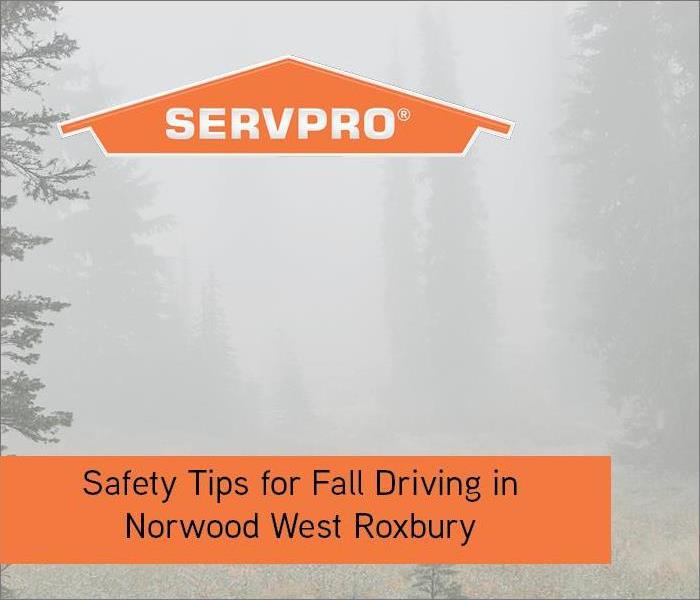 As the fall months are getting closer, the weather will be shifting, so it is important to drive cautious in the coming months.
As the fall months are getting closer, the weather will be shifting, so it is important to drive cautious in the coming months.
As the fall months are getting closer, the weather will be shifting, so it is important to drive cautious in the coming months. Here are some tips for you to remember:
Visibility May Be Poor: Falling leaves, rain, or fog can limit your vision sometimes. If you find your visibility limited, slow down or pull over.
Watch for Children: Make sure to use extra caution around leaves piled at the curbside. Children love playing in large piles of leaves that can sometimes be hidden.
Slow Down on Wet Pavement: Always keep a safe distance behind the car in front of you, especially in rainy conditions.
Be Prepared for Changing Weather: Try to always be prepared for a change in the weather by bringing a warm coat, rain gear, and gloves.
Should a storm arise and cause damage to your home or business give us a call. SERVPRO of Norwood West Roxbury is available 24/7 including holidays and weekends.
Fall Cleaning Tips in Norwood West Roxbury
8/22/2021 (Permalink)
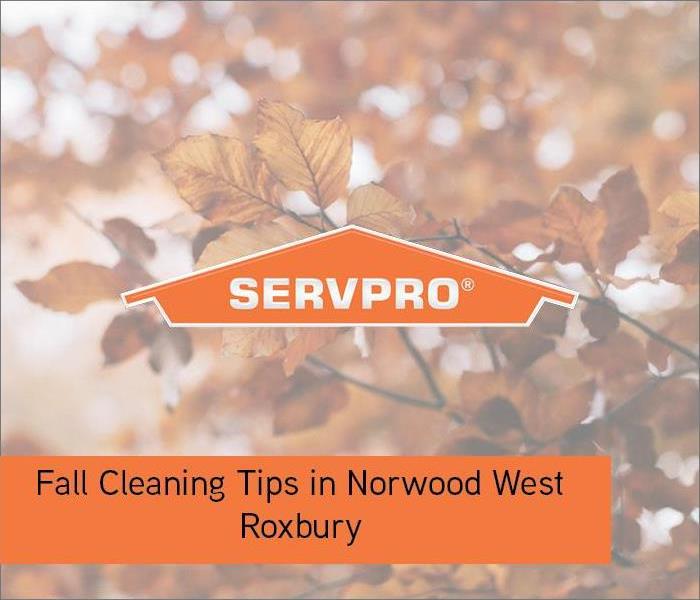 Roof gutters are traces that route water off your roof, it is really important to clean your gutters.
Roof gutters are traces that route water off your roof, it is really important to clean your gutters.
Roof gutters are traces that route water off your roof, it is really important to clean your gutters. If not taken care of, clogged gutters can cause water to pool on your roof, which can lead to water damage and structural damage. Poor gutter maintenance also leads to problems with siding, windows, doors, and foundations.
Some gutters have leaf-catching systems, but even these gutters need to be checked though. The best approach is to plan a day when you can check your gutters to make sure they are ready for the next season.
If you want to manually clean your gutters the best time is the day after a light rain; damp leaves and dirt will come up easier. If you are cleaning this yourself, use a narrow trowel to scoop and dispose of it in the garbage bag.
Next, use the hose to remove loose silt and anything else. If there's an obstruction in your downspout, use a plumber's snake to work it out. Have a helper who can spot you on the ladder as needed.
Also take a look at how the water is draining from your roof. If you see large drips along the joints where sections of gutter are attached your gutters may need repair; give someone a call to check it out.
SERVPRO of Norwood West Roxbury is available 24/7 including holidays and weekends to assist you to get your home back to “Like it never even happened.”
Autumn Home Maintenance Safety Tips in Norwood West Roxbury
8/22/2021 (Permalink)
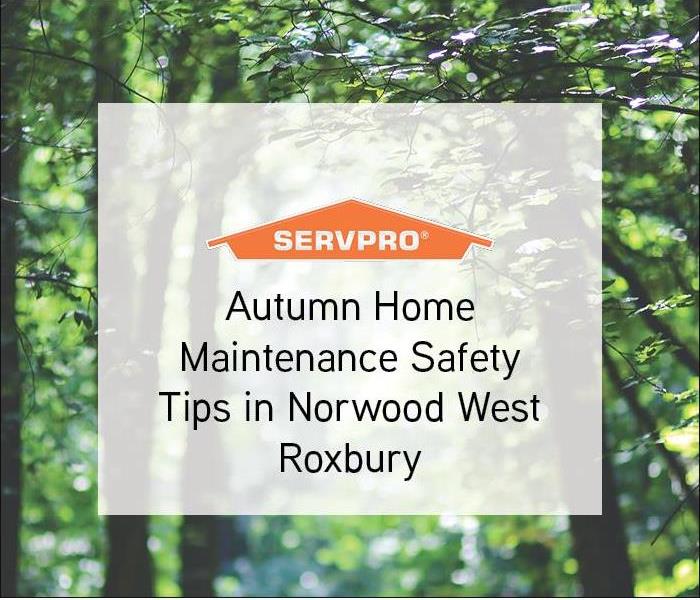 As the weather starts to cool off you will find more people doing yard work and prepping for the new season.
As the weather starts to cool off you will find more people doing yard work and prepping for the new season.
As the weather starts to cool off you will find more people doing yard work and prepping for the new season. It can be therapeutic for people to work on their yard in these crisp months.
Here are some safety tips should you decide to do yard work in the fall:
Look Up Before Pruning Trees: Make sure you know the area before you start trimming your trees. Look for where power lines are before you set up your ladder.
Use Caution on Ladders: Your ladder should be placed on a flat, level surface. You will want to make sure to wear appropriate footwear.
Clean Up Fallen Leaves: Check to make sure all walkways and driveways are clear of falling leaves since wet leaves can make for a slippery pedestrian hazard.
These are simple and easy little tips you can practice during the Autumn season to ensure safety all around you and your home.
SERVPRO of Norwood West Roxbury is available 24/7 including holidays and weekends to assist you to get your home back to “Like it never even happened.”
Summer Fires Safety Tips in Norwood West Roxbury
8/9/2021 (Permalink)
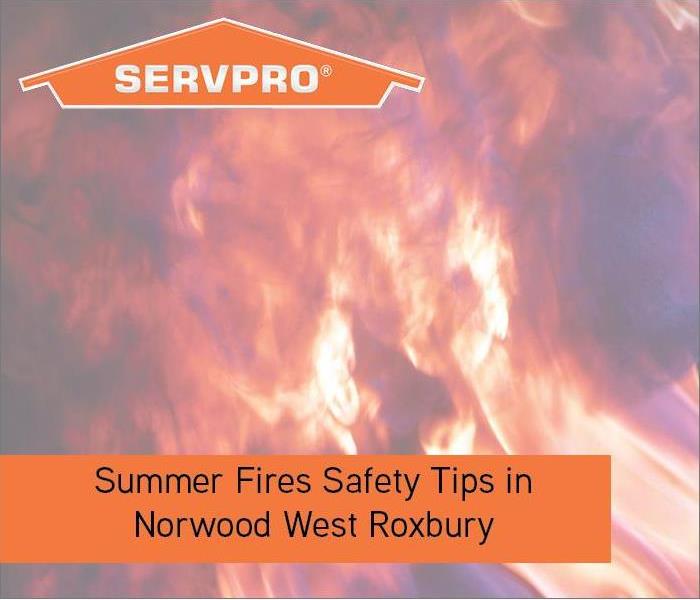 Fires can be caused in the summertime for various reasons: grilling outdoors, family gatherings, and celebrations.
Fires can be caused in the summertime for various reasons: grilling outdoors, family gatherings, and celebrations.
Fires can be caused in the summertime for various reasons: grilling outdoors, family gatherings, and celebrations. There are many different types of fires during the summer months:
Grill fires: Fires from grills happen when there is mishandling of the igniting of the grill. You will want to make sure that your grill is free of branches, roofs, or any overhang.
Air Conditioning Fires: Inadequate wiring can cause a fire because of electrical malfunctions. If your AC heats up, call for help immediately to ensure it doesn’t transfer to something nearby.
Smoking Fires: Smoking fires are common throughout the year. Make sure to keep cigarettes are properly put out before throwing them on the ground.
Summer is a time to enjoy the outdoors, have fun, and have plenty of gatherings. The weather isn’t the only thing that heats up during these few months; be aware of the risk of fires.
SERVPRO of Norwood West Roxbury is available 24/7 including holidays and weekends to assist you for your home restoration needs to get it back to “Like it never even happened.”
Summer House Safety in Norwood West Roxbury
8/9/2021 (Permalink)
 Summer is ending soon, but there are still many cookouts, bonfires, and outdoor activities happening.
Summer is ending soon, but there are still many cookouts, bonfires, and outdoor activities happening.
Summer is ending soon, but there are still many cookouts, bonfires, and outdoor activities happening. All this time outside can lead to potential dangers. It is important to keep track of repairs and installations you can make throughout your home.
We’ve put together all the tips you need to keep your family and home secure throughout the summer.
- Install sun shades to your windows to deflect heat.
- Reseal any cracking caulk on external windows and doors to prevent any leaks.
- Inspect the outside of your home for cracks and any overhanging tree limbs that could fall during a storm.
- Protect yourself in the event of a flood from a summer storm by double-checking that you have flood insurance added to your home insurance policy.
- Spray your yard home to protect it from insects, pests, and other creatures.
- Schedule a yearly inspection to help catch termites and stop them in their tracks before they cause major damage to your home’s structure.
SERVPRO of Norwood West Roxbury is available 24/7 including holidays and weekends to assist you to get your home back to “Like it never even happened.”
Fire prevention tips for your business in Norwood West Roxbury
8/9/2021 (Permalink)
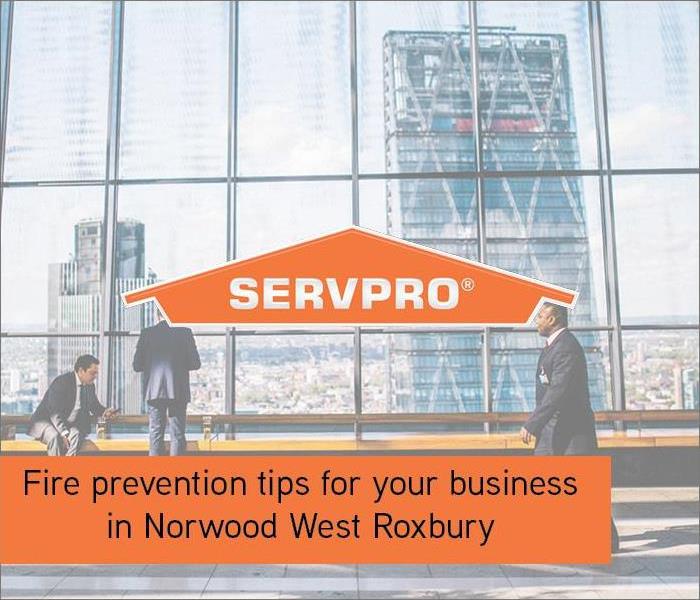 These are quick-fire tips should your business need them. If you are looking for help in creating an Emergency Readiness Plan, contact us today.
These are quick-fire tips should your business need them. If you are looking for help in creating an Emergency Readiness Plan, contact us today.
A fire can cause severe damage to business structures, equipment, and more. An owner should focus on fire risk assessment, fire prevention, and education of the staff to help reduce your chance of fire damage.
Here are three tips to consider:
1. Have fire protection equipment: Look into an automatic sprinkler system, this will provide primary fire protection for your business. Also, let employees be aware of the location of fire extinguishers throughout the building.
2. Fire safety in the workplace: Your employees are part of your team but they’re also essential assets to your business. Ensure that your employees know what to do if there's a fire.
3. Evacuation plan: Every business should post a fire evacuation plan in several spots around the workplace. In case of fire injuries, your staff should be familiar with the location of the first-aid kit.
These are quick-fire tips should your business need them. If you are looking for help in creating an Emergency Readiness Plan, contact us today for no cost.
SERVPRO of Norwood West Roxbury is available 24/7 including holidays and weekends to assist you to get your business back to “Like it never even happened.”
National Grilling Season in Norwood West Roxbury
7/12/2021 (Permalink)
 July is National Grilling Month, how will you enjoy your cookouts?
July is National Grilling Month, how will you enjoy your cookouts?
July is National Grilling Month, how will you enjoy your cookouts?
Enjoy the whole family together by using the grill. There's nothing better than outdoor cooking, so enjoy summer by entertaining with the best kinds of summer food.
However, along with grills can come fires. Here are a few helpful tips for you to during your grilling season:
- Keep your grill clean: Keeping your grill clean can extend the life of your grill. Stuck on grease should be cleaned since this can cause large fires.
- Always preheat the grill: This helps prevent food from sticking to the grates.
- Wash your hands often: Whenever handling raw meat, it is best to wash your hands with warm soapy water.
- Keep the food cold: Keep food cold until you are ready to cook.
- Monitor your grill: You should never leave your grill unattended, this can cause a large fire to anything nearby.
SERVPRO of Norwood West Roxbury is available 24/7 including holidays and weekends to assist you and get your home back to “Like it never even happened.”
National Pet Fire Safety Day in Norwood West Roxbury
7/12/2021 (Permalink)
 The best tip should a fire arise in your home, is to have an escape plan that includes your pets. Discuss who will be in charge of rescuing your pet.
The best tip should a fire arise in your home, is to have an escape plan that includes your pets. Discuss who will be in charge of rescuing your pet.
National Pet Fire Safety Day is July 15th. This is a day to learn how to keep your pet safe should a fire arise; it is important that we dedicate a day to keeping them safe should a scary event happen.
Here are some facts about pets and fires:
Pets cause over 1,000 house fires each year in the United States. It is important to make sure that there is nothing nearby that can start a fire.
Did you know that there are nearly 360,000 house fires each year in the United States? That is a lot of fire and damage.
Over 40,000 pets die every year in house fires. Awareness can save pet lives but also just having a plan should a fire arise is critical.
The best tip should a fire arise in your home, is to have an escape plan that includes your pets. Discuss who will be in charge of rescuing your pet in the event of a fire.
SERVPRO of Norwood West Roxbury is available 24/7 including holidays and weekends to assist you and get your home back to “Like it never even happened.”
Summer Flooding Tips in Norwood West Roxbury
7/12/2021 (Permalink)
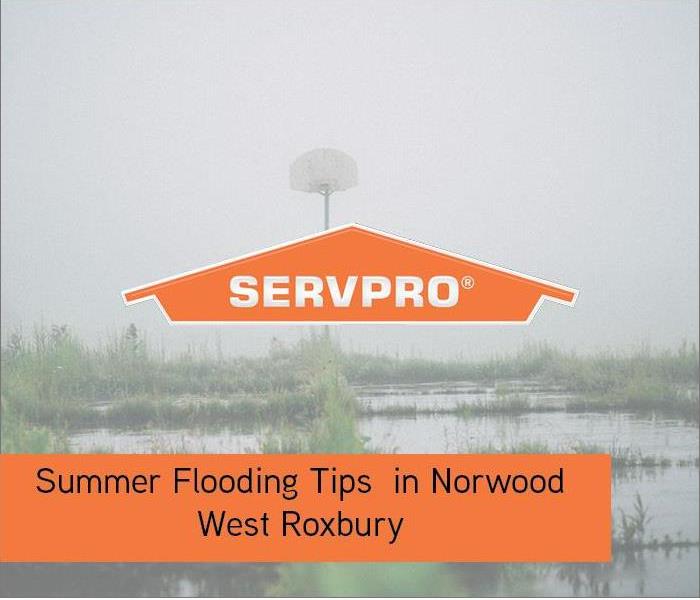 Summer is the time of year when flooding happens a lot. This can cause damage to any residential or business building.
Summer is the time of year when flooding happens a lot. This can cause damage to any residential or business building.
Summer is the time of year when flooding happens a lot. This can cause damage to any residential or business building. Here are some great tips should flooding happen:
- Find safe shelter right away.
- Do not walk or drive through flood waters.
- Stay off bridges over fast-moving water.
- Evacuate if told to do so.
- Check up on flood insurance policy.
- Make a plan for your household, including your pets.
- Learn and practice evacuation routes and shelter plans.
- Gather supplies: non-perishable foods, cleaning supplies, and water for several days.
- Move valuables to higher levels.
- Check on your sump pump.
Flooding can happen quickly, it is important to make sure to get notifications from your local weather channels so you can act quickly too. Be careful if you have a flood warning!
SERVPRO of Norwood West Roxbury is available 24/7 including holidays and weekends to assist you and get your home back to “Like it never even happened.”
Hurricane Season Safety Tips in Norwood West Roxbury
7/12/2021 (Permalink)
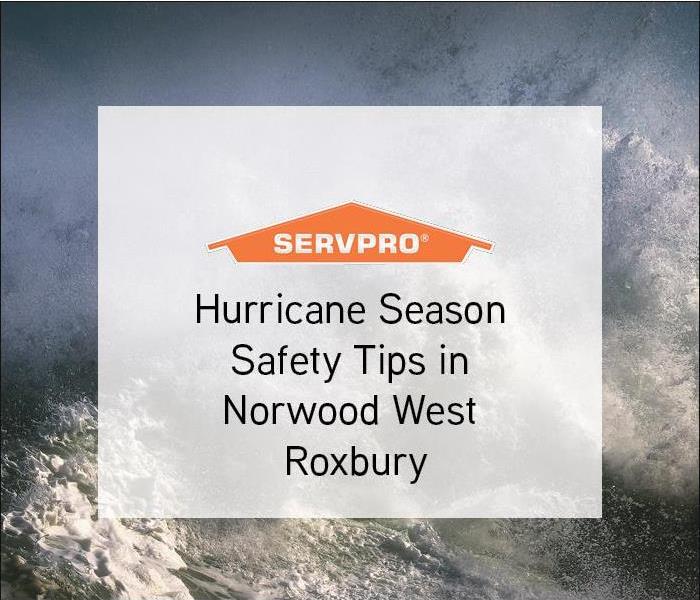 By now, we have been getting major weather effects from hurricane season and it may cause damage to your home or business.
By now, we have been getting major weather effects from hurricane season and it may cause damage to your home or business.
By now, we have been getting major weather effects from hurricane season and it may cause damage to your home or business. There are some things you can do in preparation should a hurricane, or storm weather hits.
- Create a plan with your family: Whether it’s the possibility of tornadoes, hurricanes, or floods families need to be prepared. A plan should include evacuation routes, emergency numbers, shelter possibilities, and a communication strategy.
- Build a disaster kit: The kit should have basics: bottled water, non-perishable snacks, flashlights, batteries, sanitation items, important documents, and first aid kits.
- Practice the plan: You will want to practice evacuation routes, shelter areas, and memorizing emergency numbers.
- Stay informed: You will want to keep your family safe, so staying informed is critical. When a major disaster occurs, it is advised that everyone should have a reliable resource for emergency alerts: phone apps or emergency radio.
- Tackle storm anxiety: Creating a plan is the first step in tackling anxiety. Make sure to allow your child to talk through their fears and concerns.
SERVPRO of Norwood West Roxbury is available 24/7 including holidays and weekends to assist you to get your home back to “Like it never even happened.”
Top Five Things To Prepare For In A Business Disaster in Norwood West Roxbury
7/12/2021 (Permalink)
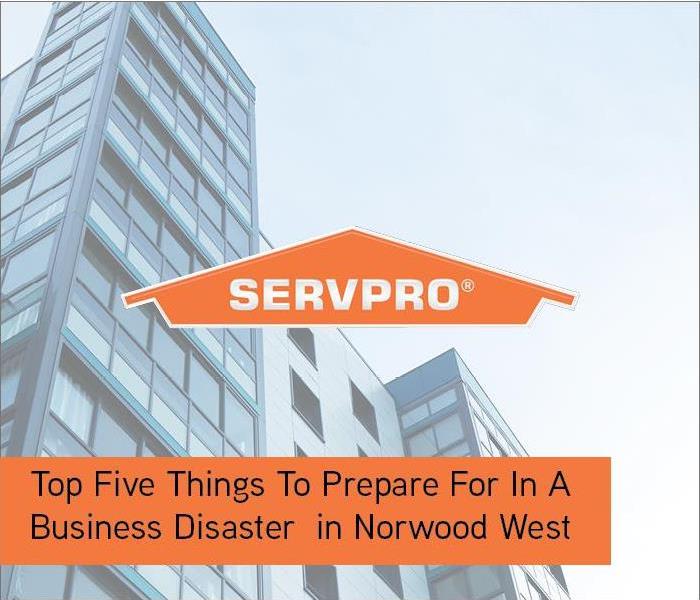 If you are in need of creating an Emergency Readiness Plan, contact us directly for NO CHARGE. We would be honored to help you set up your plan.
If you are in need of creating an Emergency Readiness Plan, contact us directly for NO CHARGE. We would be honored to help you set up your plan.
No matter what disaster your business may face, here are five simple ways you can prepare for a natural disaster.
- Create an emergency operations plan: If a natural disaster struck your business, what would happen in the hours that follow? Would employees be allowed to work remotely? There are so many critical questions to ask.
You should create an Emergency Readiness Plan for your business. As you draft your plan, make sure it addresses the following areas:
- Outline a way to communicate and make sure the contact information you have with each employee is updated.
- If a natural disaster occurs while at work, does everyone know how to safely evacuate the building?
If you are in need of creating an Emergency Readiness Plan, contact us directly for NO CHARGE. We would like to help you set up your plan so you can be prepared.
- Back up important data: You will want to safely store important business paperwork. You might want to put paperwork in an off-site location and make copies as needed. Don’t forget about the benefits of being in the cloud either.
- Meet with an insurance advisor: It’s wise to meet with your insurance advisor and review your company’s existing coverage. You may find you need to invest in additional coverage.
- Maintain communication: It is important to communicate with employees, vendors, and customers. Your plan should detail how communication will be maintained during the disaster and its aftermath.
- 5. Regroup in your community: Small businesses impacted by a natural disaster generally do not come out of it as though nothing has happened. For some small businesses, a natural disaster is enough to close a business entirely; if your business is back up and running, now is the time to offer a helping hand to other businesses.
If you are in need of creating an Emergency Readiness Plan, contact us directly for NO CHARGE. We would be honored to help you set up your plan should a disaster strike.
SERVPRO of Norwood West Roxbury is available 24/7 including holidays and weekends to assist you to get your business back to “Like it never even happened.”
Back to School Safety Tips in Norwood West Roxbury
7/12/2021 (Permalink)
 Summer is flying by, parents are starting to think about Back to School already. Here are some great school safety tips.
Summer is flying by, parents are starting to think about Back to School already. Here are some great school safety tips.
Summer is flying by, parents are starting to think about Back to School already. As the school year starts to arrive here are some great safety tips for the school year:
- Be on the lookout for school zone signals, and slow down to obey all traffic laws.
- Always stop for school busses whenever applicable.
- Watch out for school crossing guards.
- Be aware of children near schools, bus stops, sidewalks, in the streets, and in school parking lots.
- Never pass other vehicles while driving in a school zone.
- Avoid using a cell phone while driving in a school zone.
- Make sure a supervisor is always present when children are at the school’s playground.
- Allow time for drop-off and pick-up.
- If your child is walking to school make sure they know the correct route.
- Always use public sidewalks and streets when walking to school.
- If your child is walking to school, have them walk with other students.
- Make sure to teach your children to recognize and obey traffic signals and signs.
- Teach your children to only cross streets at designated crosswalks.
- Make sure to enforce looking both ways before crossing the street.
- Make sure the bus comes to a complete stop before getting on or off.
- When riding the bus, make sure your child understands to remain seated.
SERVPRO of Norwood West Roxbury is available 24/7 including holidays and weekends to assist you to get your home back to “Like it never even happened.”
Norwood to Host Independence Day Parade
6/15/2021 (Permalink)
 The parade will begin at 10 AM on July 3rd at Coakley Middle School.
The parade will begin at 10 AM on July 3rd at Coakley Middle School.
On Saturday, July 3rd, the town of Norwood is gearing up for an exciting parade. The parade will begin at 10 AM at the Coakley Middle School, located at 1315 Washington Street Norwood, MA. The parade will then go down Washington Street to Town Hall, where it will conclude after taking a right in front of the Town Hall. The town of Norwood's website states that "Our annual 4th of July Parade has brought so much pleasure to residents of Norwood and surrounding communities for many years. Many bands and entertainment acts continue to return to Norwood every year to be part of the July 4th Celebration. They come because of the tremendous response and enthusiasm of the community". If community members are interested in volunteering at the parade, they can contact the Norwood Recreation Department at 781-762-0466 to learn more about how they can help with the celebration.
Boston Area Experiences First Heat Wave of 2021
6/8/2021 (Permalink)
 Temperatures in the Greater Boston Area reached well over 90 this past weekend
Temperatures in the Greater Boston Area reached well over 90 this past weekend
Last Monday, June 7th, Boston area residents turned up their A/C and hopped in pools as the first heat wave of 2021 rolled through the Greater Boston Area. A heat wave is defined as three or more days of 90-degree or higher temperatures, and the past weekend surely lived up to heat wave standards. The grueling heat began on Saturday, June 5th, as temperatures hit 90 degrees in Boston. Then on Sunday, Boston reached 93 degrees. Communities in Norwood, Dedham, Westwood, Walpole, and Medfield attempted to cool off as the heat came through, showing signs of a hot summer ahead. “As always, be smart and hydrate,” said Bill Simpson, meteorologist at the National Weather Service, adding that people should try to take care of their outside tasks early or late when it’s not as hot. SERVPRO of Norwood/West Roxbury reminds all community members to be safe in the heat, and not over-exert themselves because it can be dangerous to the body.
Fireworks safety in Norwood West Roxbury
6/8/2021 (Permalink)
 Fireworks Safety Month is in June. Summer months are filled with celebrations of summer, vacations, and the Fourth of July.
Fireworks Safety Month is in June. Summer months are filled with celebrations of summer, vacations, and the Fourth of July.
Fireworks Safety Month is in June. Summer months are filled with celebrations of summer, vacations, and the Fourth of July.
Summer is a fun time for outdoor activities such as barbeques. However, many like to celebrate with fireworks. Fireworks are beautiful, but can also be dangerous. Fireworks’ safety should be taken heavily. Most fireworks injuries are reported between June 16 to July 16.
It is important to learn about fireworks safety methods and instructions.
Speak up if you see others indulging in fireworks activities that are dangerous.
Practice using fireworks safely. It’s a celebration of our protectors; the fire and health departments work hard for our comfort and safety; practice safe fireworks.
Go all out in enjoying any celebrations, but practice the necessary safety precautions while doing it.
SERVPRO of Norwood West Roxbury is available 24/7 including holidays and weekends to assist you and get your home back to “Like it never even happened.”
June is National Safety Month in Norwood West Roxbury
6/6/2021 (Permalink)
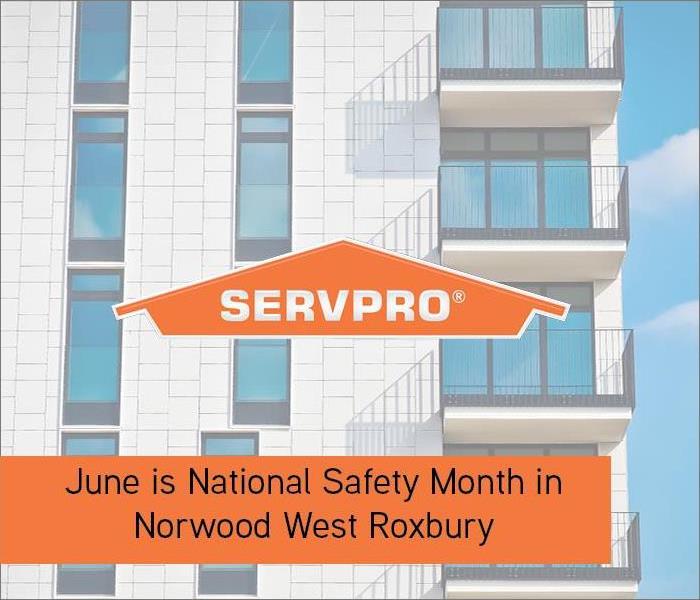 National Safety Month is celebrated in June. This is when people focus on how to keep their environment safe and danger-free in the workplace.
National Safety Month is celebrated in June. This is when people focus on how to keep their environment safe and danger-free in the workplace.
National Safety Month is celebrated in June. This is when people focus on how to keep their environment safe and danger-free in the workplace. It is a time to reflect on how to create a safer environment for business owners and employees. Learning about safety methods can help increase pressure on employers to offer a safer working environment.
HOW TO CELEBRATE NATIONAL SAFETY MONTH
Conduct a fire drill: Taking precautionary measures can prevent severe damage if a fire were to happen. It is a great time to conduct a fire drill. Select a safety point that's close to your business and test your fire alarms to perform the drill.
Update your first-aid kit: Keep an updated first aid kit and stock it with dressings, bandages, tape, ointments, wipes, aspirin, gloves, scissors, and gauze pads.
WHY NATIONAL SAFETY MONTH IS IMPORTANT
It focuses on all aspects of employee health and safety, instead of focusing on a single workplace hazard, the National Safety Council selects four different types of health and safety issues each year.
This helps offer safety tips for everyday life and it teaches us to be proactive when it comes to anticipating potential disasters. This is something that you can implement at your workplace to make it safer.
SERVPRO of Norwood West Roxbury is available 24/7 including holidays and weekends to assist you and get your home back to “Like it never even happened.”
Summer Awareness in Norwood West Roxbury
6/6/2021 (Permalink)
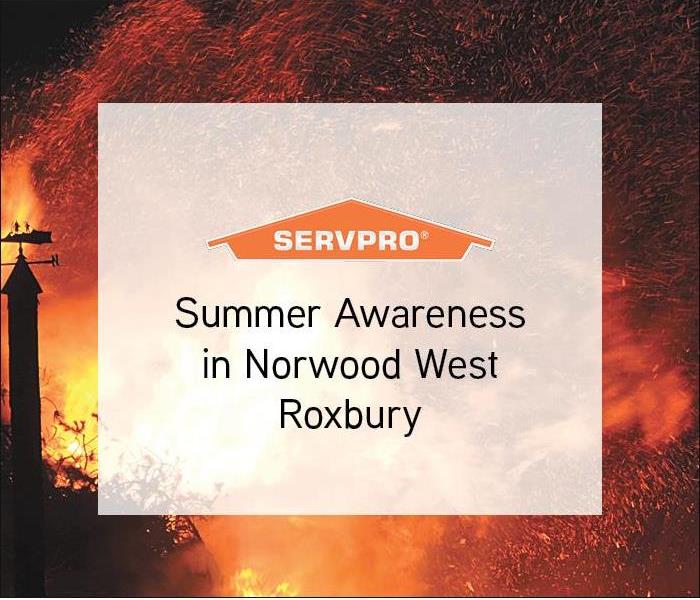 The National Weather Service (NWS) recognizes many safety hazards during the summertime including air quality, floods, heat, hurricanes, lightning.
The National Weather Service (NWS) recognizes many safety hazards during the summertime including air quality, floods, heat, hurricanes, lightning.
June is the month for summer awareness. It seems obvious, however, there is a lot to consider.
The National Weather Service (NWS) recognizes many safety hazards during the summertime including air quality, floods, heat, hurricanes, lightning, rip currents, tornadoes, and wildfires. Here are a few summer safety storm warning tips:
Watch the Clouds: A severe storm with the potential of developing deadly weather will often look very dark or green.
Pay Attention to the Temperature: For severe storms and tornadoes to form, a mixture of warm, moist air at low levels has to collide with dry cold air above.
Sudden Wind Changes: Be prepared if it suddenly gets very windy or if there is an abrupt calm during or after a thunderstorm.
Precipitation Changes: Be aware of hail or heavy rain followed by either calm or a fast, intense wind shift.
Listen Intently: If you hear a loud roar that is similar to a freight train, take shelter right away; a tornado could likely be spawned.
Check the Radar: You don’t have to be a meteorologist to interpret the radar. When observing storms on the radar, look for large lines of red.
SERVPRO of Norwood West Roxbury is available 24/7 including holidays and weekends to assist you and get your home back to “Like it never even happened.”
National Insurance Awareness Day in Norwood West Roxbury
6/6/2021 (Permalink)
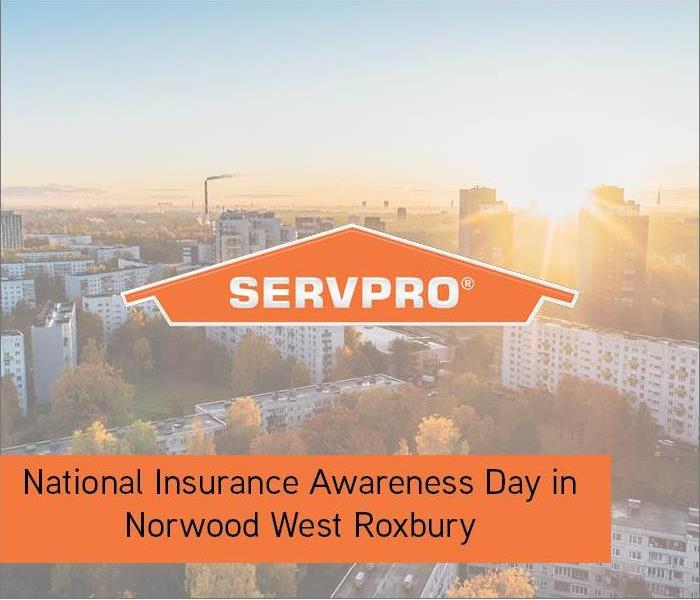 June 28 is National Insurance Awareness Day. It is a good idea to check out yearly your insurance coverages and deductibles
June 28 is National Insurance Awareness Day. It is a good idea to check out yearly your insurance coverages and deductibles
June 28 is National Insurance Awareness Day. It is a good idea to check out yearly your insurance coverages and deductibles; you never know when a disaster can strike in your home. This means it is a good day to evaluate your insurance coverage and assess your risk.
It is important to review your policies and consider any life changes that might require updating your coverage. This can help you in the future should a disaster ever happen.
Hurricane season started on June 1st. It is important to know the storm risk. Do you need supplemental flood or wind insurance? Anywhere that it can rain, it can flood.
SERVPRO of Norwood West Roxbury is available 24/7 including holidays and weekends to assist you and get your home back to “Like it never even happened.”
Are You Storm Ready?
6/1/2021 (Permalink)
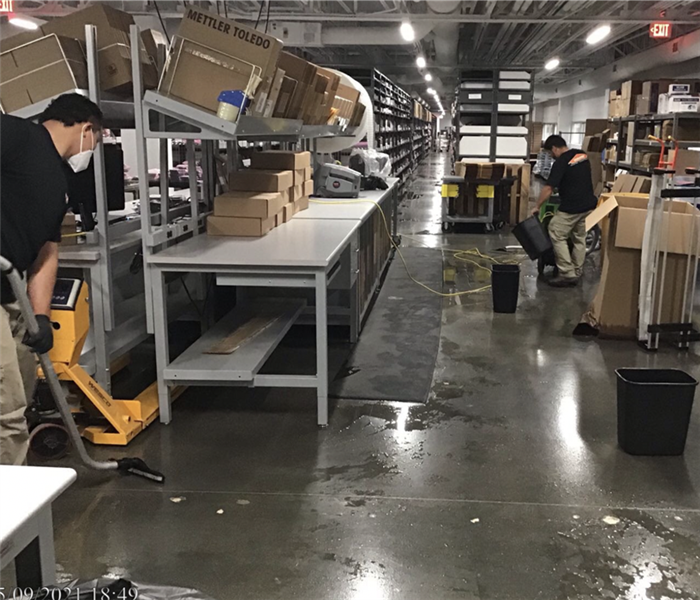 Storm can strike at any moment, like it did in this warehouse in Westwood, MA.
Storm can strike at any moment, like it did in this warehouse in Westwood, MA.
Not many of us plan for disasters, natural or man-made. When they happen, people may say things like, “But I never saw it coming,” and “We didn’t have time to react.” Well, the time for action is long before a tragedy befalls you or your property!
According to FEMA, there are four main ways to prepare for storms you can and should do now:
- Get informed
- Make a plan
- Assemble a kit
- Maintain your plan and kit
- Get Informed - Many areas have local emergency management offices and/or a Red Cross Chapter. These organizations can provide you vital information concerning local emergency response arrangements, evacuation plans and emergency shelters. It’s also a good idea to invest in a NOAA Weather Radio that will alert you during any time of the day or night for when possible destructive conditions materialize.
- Make a Plan
- Conduct a family meeting that will inform everyone what your emergency plans are.
- Have an out-of-town contact that each one knows the number to. This is who you’ll call to inform where you are after a disaster strikes.
- Teach your children how and when to call emergency numbers.
- Have a prearranged location picked out as the place your family will meet in case you get separated from one another. Make sure everyone knows not only the best escape routes but the safe places to go inside your home if a tornado approaches.
- Know how and when to turn off water, gas and electricity at the main switches or valves.
- Have fire extinguishers ready and show everyone where they’re located and how to use them.
- Inventory your possessions and keep that list along with important documents in a safe deposit box.
- Keep your homeowners or renter’s insurance company’s telephone numbers readily available. (Also, be sure to keep SERVPRO of Norwood/West Roxbury's phone number close at hand!)
- Assemble a Kit – this is a collection of basic family needs you’ll need after a disaster. These should be stored in a portable container and enough to last you three days. It should include food, water, a battery powered radio, a flashlight, etc. You can find a full list of items for your survival kit at redcross.org.
- Maintain Your Plan – every six months, review your plans with your family, conduct evacuation drills and restock expiring food and perishables in your kit. Also, confirm your fire extinguisher is recharged and smoke alarm batteries are replaced.
Wind Storm Basics
6/1/2021 (Permalink)
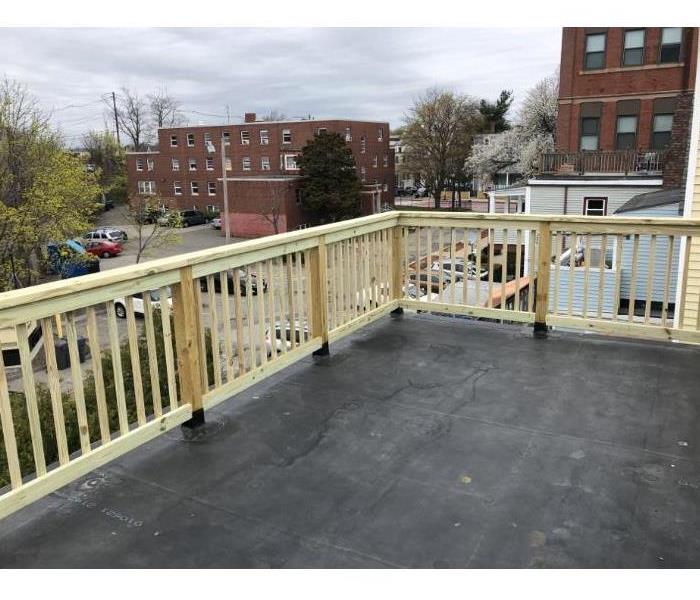 A rubber roof top deck with a sturdy railing built by our rebuilds team in Norwood, MA
A rubber roof top deck with a sturdy railing built by our rebuilds team in Norwood, MA
There are many concerns that come with severe storms, with the threat of damaging winds being one of them. These winds can come with little to no notice and have long-term structural impacts.
While many think of damaging winds as a result of a tornado or a hurricane, those are not the only times when they can occur. Traditionally, damaging winds are considered those with wind speeds exceeding 50–60 mph and can stem from a strong thunderstorm. You will often hear damaging winds referred to as “straight-line” winds, differentiating them from the winds caused by a tornado.
The damage from these winds can be especially destructive. Straight-line winds can pick up loose objects in your yard and cause those objects to become projectiles.
Windows and the roof can take the brunt of this damage, and the wind damage is extensive enough, water damage can result as the outside elements are able to come indoors.
Anyone who lives in a thunderstorm-prone area can be at risk from damaging winds, but some structures are more susceptible to damage and are especially at risk. Mobile homes, even anchored mobile homes, can sustain extensive damage in wind gusts over 80 mph.
How to Protect Your Home From Damaging Winds
Here are some of the ways you can help protect your property from damaging winds. Always keep the “Two R’s” in mind: reinforce and remove.
Ask a professional to reinforce your garage door.
Remove or anchor loose objects on your property that could easily turn into projectiles by the wind. Don’t forget trash cans, grills and outdoor furniture.
Hire a professional to remove large or dying trees and branches that may fall on your home.
Not all high wind circumstances come with forewarning, but incorporating some of these suggestions keep your prepared for that “just in case” moment.
Also, if you are building a new home or renovating an older home, check to be sure the windows, walls and doors are up to code for your area.
Should your home be hit by damaging winds and resulting water damage, our highly trained specialists at SERVPRO of Norwood/West Roxbury are here to help with the cleanup and restoration of your home
Spring Storm Tips for Norwood West Roxbury MA
5/29/2021 (Permalink)
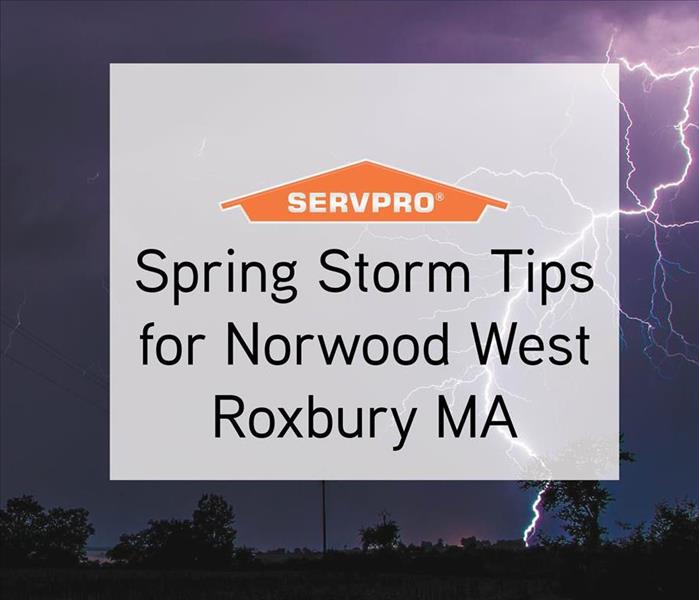 SERVPRO of Norwood West Roxbury is available 24/7 including holidays and weekends to assist you with your storm needs. Call (781) 769-9125
SERVPRO of Norwood West Roxbury is available 24/7 including holidays and weekends to assist you with your storm needs. Call (781) 769-9125
Storms can cause a lot of damage to your home; it is important to prepare for it as best as you can. Here are some preparations that you can make before a storm hits.
- Build an Emergency Kit with essential items. Make sure to add water, food, a battery-powered or hand-crank radio, a flashlight to name a few. The Federal Emergency Management Agency (FEMA) has a detailed checklist available.
- Eversource also has a storm safety checklist available to help.
- Stock up on non-perishables, such as canned goods and pet food. You should also make sure you have adequate medical supplies and prescriptions for everyone in the household.
- You will want to pick up paper goods such as paper plates, paper towels, plastic ware in case you lose power.
- If you have a power outage, turn the temperature control on your refrigerator and freezer to the coldest setting.
- You should fill several large containers with water for drinking.
- Make sure to keep flashlights, batteries, candles, and matches on hand.
- Make sure you have batteries that are the correct size for the flashlights and other important electronics.
- Check to make sure there’s a first aid kit in the house.
- Fill your car with gasoline, so if you need to go anywhere you are prepared.
- If you lose power, you will want to cook outside. You can use charcoal or propane grills or even a camping cookstove.
- You will want to have a list of emergency phone numbers on hand: Red Cross, fire, police, and a family doctor.
SERVPRO of Norwood West Roxbury is available 24/7 including holidays and weekends to assist you with your storm needs. Call (781) 769-9125
Is your business emergency ready?
5/19/2021 (Permalink)
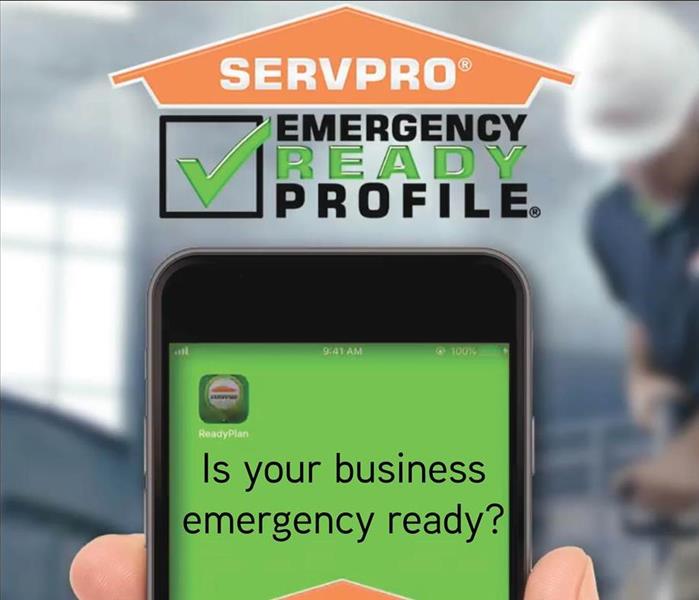 The Ready Plan is an emergency preparedness tool for business owners, property managers, risk managers, and facility management.
The Ready Plan is an emergency preparedness tool for business owners, property managers, risk managers, and facility management.
As many as 50% of businesses may never recover following a disaster, according to the latest industry research. Of the businesses that survive, the overwhelming majority of them had a preparedness plan in place. Pre-planning can serve as an insurance policy aimed at peace of mind.
By developing a SERVPRO® Emergency READY Profile for your business, you minimize business interruption by having an immediate plan of action. Knowing what to do and what to expect in advance is the key to timely mitigation and can help minimize how water and fire damage can affect your business.
The SERVPRO® Emergency READY Profile Advantage is a no-cost assessment of your facility. There are many benefits to it:
- This means there is no need to allocate funds, giving you a great value at no cost.
- A concise Profile Document that contains only the critical information needed in the event of an emergency.
- It will only take a little time to complete and will not take you away from current projects. But it will save a lot of time if ever needed.
- A guide to help you get back into your building following a disaster.
- This can help minimize the amount of time your business is inactive by having an immediate plan of action.
- Establishes your local SERVPRO® Franchise Professional as your disaster mitigation and restoration provider.
- You have a provider that is recognized as an industry leader and close by.
- Identification of the line of command for authorizing work to begin. This saves time so we can begin the work of mitigating the damage which can save you time and money.
- Provides facility details such as shut-off valve locations, priority areas, and priority contact information. Having a quick reference of what to do, how to do it, and who to call.
The Ready Plan is an emergency preparedness tool for business owners, property managers, risk managers, and facility management. It allows for the creation of an Emergency Ready Profile® containing critical facility information to help speed up response time.
SERVPRO of Norwood West Roxbury is available 24/7 including holidays and weekends to assist you and get your business back to “Like it never even happened.” If you are ready to get started call (781) 769-9125.
Avoid Fires This Summer Season
5/19/2021 (Permalink)
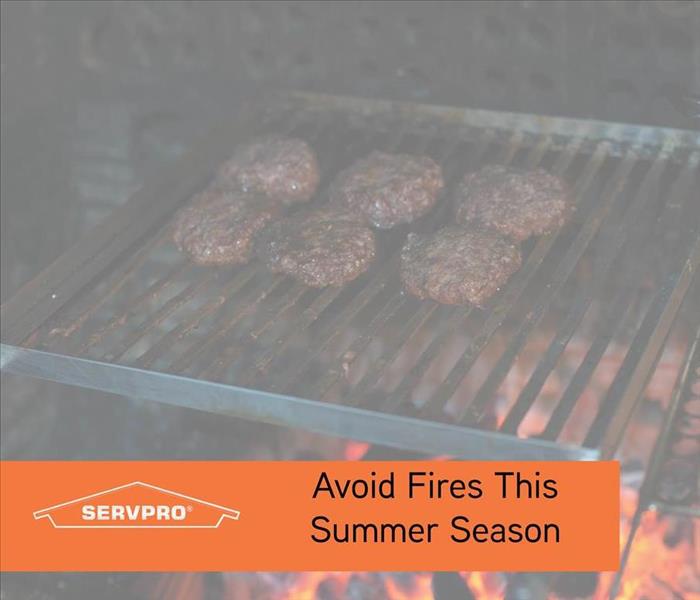 We encourage summer fire safety in your community with these free tips.
We encourage summer fire safety in your community with these free tips.
Every year we look forward to summer vacations, camping, family reunions, picnics, and the holidays or celebrations. Summertime brings fires and injuries due to fireworks and outdoor cooking.
We encourage summer fire safety in your community with these free tips:
- Know how to prevent a burn while you enjoy outdoor activity this summer.
- Wear short sleeves or roll them up when cooking on the grill.
- Use long-handled barbecue tools
- Keep a 3-foot safe zone around grills, fire pits, and campfires.
- Attend public fireworks displays so it leaves the lighting to the professionals.
- Ensure children are not near fireworks, fires, or grill cooking without adult supervision.
- Propane and charcoal BBQ grills should be used outdoors only.
- Keep children and pets at least three feet from the grill area.
- Keep your grill clean by removing grease buildup.
- Never leave your grill unattended.
- Always make sure your gas grill lid is open before lighting it.
SERVPRO of Norwood West Roxbury is available 24/7 including holidays and weekends to assist you with your fire needs. Call (781) 769-9125
Summer Fire Safety
5/19/2021 (Permalink)
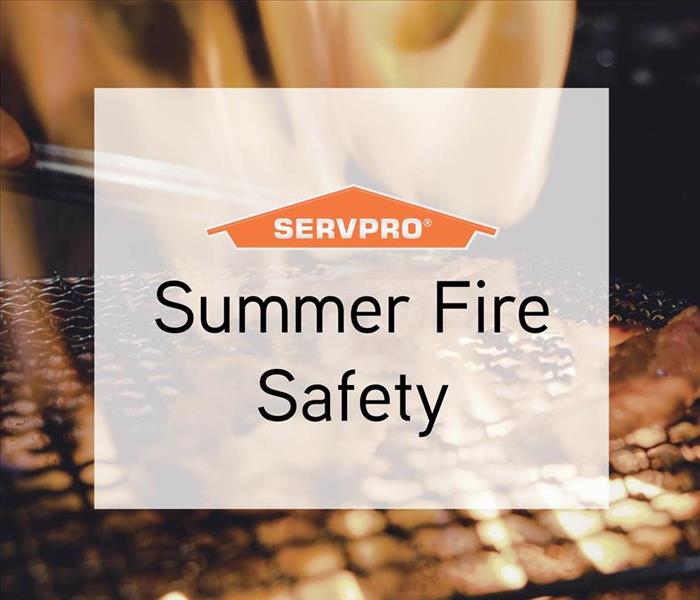 Now that the summer months are here, there are some things to remember so you are careful and don’t create any unnecessary fires.
Now that the summer months are here, there are some things to remember so you are careful and don’t create any unnecessary fires.
Now that the summer months are here, there are some things to remember so you are careful and don’t create any unnecessary fires:
- Grilling Safety: Make sure to regularly remove grease or fat buildup from the trays. Never leave a grill unattended.
- Lawn Mower Care Follow the manufacturer’s recommended maintenance plan for your mowing equipment. Make sure to remove debris and grass clippings from cutting units and engines.
- Gas Storage: Do not store gasoline, liquid fire starter, propane, or any other type of flammable liquids near a grill. Store any sort of flammable liquid in a well-ventilated area outdoors.
- HVAC Maintenance: Annual inspections of your air conditioner system can prevent a house fire. Dust can settle in places that can cause short circuits and other electrical malfunctions. This could lead to an air conditioning fire.
- Alarm Inspection: Make sure to check your smoke detectors and/or carbon monoxide detectors regularly; this is one of the best fire prevention methods.
SERVPRO of Norwood West Roxbury is available 24/7 including holidays and weekends to assist you with your fire needs. Call (781) 769-9125
SERVPRO of Norwood West Roxbury nurses
5/6/2021 (Permalink)
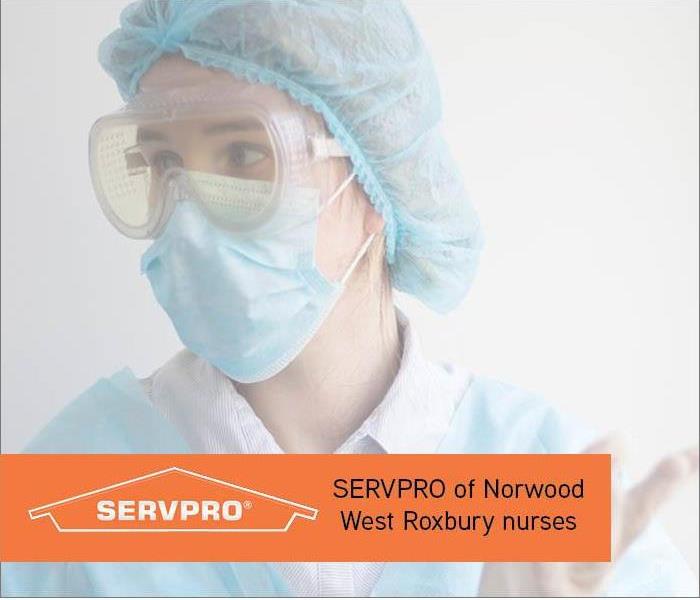 Give nurses you know a shout-out and thank them for their hard work.
Give nurses you know a shout-out and thank them for their hard work.
Did you know National Nurses Day is observed every year on May 6th? Help us raise awareness of all nurses on this day. We acknowledge the vital role nurses play in society.
National Nurses Week is May 6th and ends on May 12th. Nurses play a vital part in our community every day. We should not only celebrate and appreciate them during this time but every day.
HOW TO OBSERVE #NationalNursesDay
You can recognize nurses everywhere.
Celebrate their dedication and commitment to their patients and career.
Tell someone about the excellent care you’ve received from a nurse.
All it takes is a simple ‘thank you.’
When you visit a doctor, make sure to follow the instructions they give you and ask questions. Asking questions is always critical especially for your health.
Give nurses you know a shout-out and thank them for their hard work.
Use #NationalNursesDay to share a story and recognition on social media.
SERVPRO of Norwood West Roxbury is available 24/7 including holidays and weekends to assist you and get your home back to “Like it never even happened.”
SERVPRO of Norwood West Roxbury is celebrating International Firefighters’ Day 2021
5/4/2021 (Permalink)
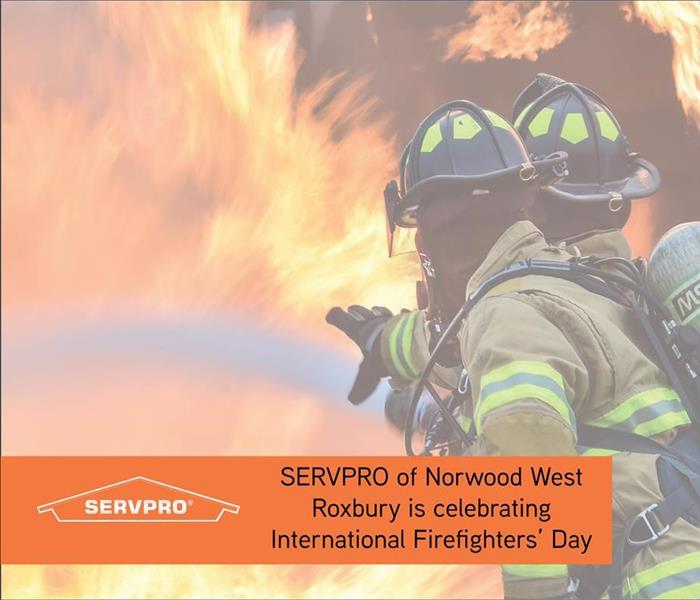 The (NFFF) National Fallen Firefighters Foundation Observes International Firefighters’ Day 2021.
The (NFFF) National Fallen Firefighters Foundation Observes International Firefighters’ Day 2021.
The (NFFF) National Fallen Firefighters Foundation Observes International Firefighters’ Day 2021.
This day was established in 1999 to honor the lives of firefighters who died in a wildfire in Victoria, Australia. It helps to recognize the service and sacrifice that firefighters make daily.
This day of recognition is the mission behind the NFFF. They help to honor and remember fallen firefighters. They assist families in rebuilding their lives but also are incredible for our community.
Firefighters are our family, friends, and co-workers at SERVPRO of Norwood West Roxbury. They respond to calls without any hesitation. They take amazing care of our community. Join us in thanking firefighters for all that they do. They work the front lines every day and our communities are made stronger by the dedication of these firefighters.
We appreciate them today and every day. Thank you for all that you do in the community.
SERVPRO of Norwood West Roxbury is available 24/7 including holidays and weekends to assist you and get your home back to “Like it never even happened.”
Prepare for Flooding Season in Norwood West Roxbury
4/26/2021 (Permalink)
 There are plenty of safety tips to take if flooding is happening in your area so you can be safe and prepared.
There are plenty of safety tips to take if flooding is happening in your area so you can be safe and prepared.
Flooding is a topic that no one likes to talk about until it’s too late. It is one of the most important topics that should not be ignored. Flooding is a common hazard in Massachusetts. Flash floods can occur within minutes or hours after a storm.
There are so many different terms when it comes to flooding for you to be aware of.
- Flooding, flash flooding: Pay attention to changing flood patterns; they can change quickly. You will want to be prepared to move to higher ground.
- Flood Warning: This means that flooding is happening or is increasing rapidly. Make sure to avoid low-lying areas.
- Flash Flood Warning: A flash flood is occurring and you should seek higher ground immediately.
There are plenty of safety tips to take if flooding is happening in your area so you can be safe and prepared.
If you find yourself in need of water damage to your home or business, give SERVPRO Norwood West Roxbury a call at (617) 332-9000, we respond faster to any size disaster.
Thanks to our SERVPRO of Norwood Westroxbury administrative staff
4/25/2021 (Permalink)
Administrative Professionals Day was April 21st. We did not post about this special day on time,
but we still did celebrate with our staff. We want to share more about it with our local community.
Administrative Professionals Day is a special day to recognizes assistants and office staff. They are truly critical for our team at SERVPRO. The purpose of this day is to show appreciation for administrative teammates.
We always strive to show appreciation to our customers and staff whenever possible. It is important to recognize them throughout the year. There are fairly simple ways to recognize a team member: flowers, candy, coffee, coffee mugs, and so much more. Find out what they like best and show them you care and appreciate them.
Voltaire -- “Appreciation is a wonderful thing. It makes what is excellent in others belong to us as well.”
Thank you to our administrative staff at SERVPRO of Norwood Westroxbury each and every day. Here at SERVPRO, we have the certified professionals you need to help restore your home or business. Contact us today at (781) 769-9125 for more information.
Spring Storm Tips for Norwood West Roxbury
4/25/2021 (Permalink)
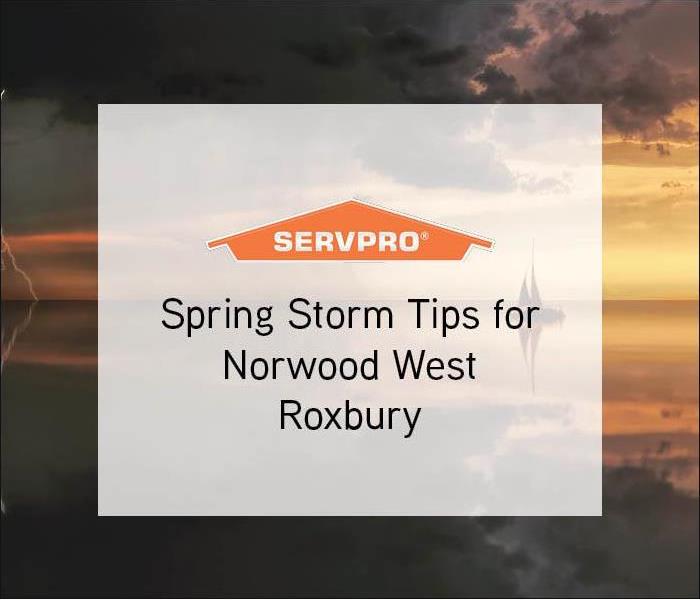 Spring is has arrived here in Norwood West Roxbury. Spring can also mean strong severe storms.
Spring is has arrived here in Norwood West Roxbury. Spring can also mean strong severe storms.
Spring is has arrived here in Norwood West Roxbury. It is a great time of year, you know cook out’s, sports, and gatherings. Spring can also mean strong severe storms. There are some simple things you can do to prepare for storms before they happen.
Here are a few tips to consider:
Trim trees: Get rid of dead branches that could end up being dangerous in a severe storm. Find out if they are near the power source to your home.
Ensure sump pumps are working: Rainstorms can all result in flooded basements, it is important to make sure they are working properly now, not when the storm comes.
Secure backyard items: Move items such as patio furniture, lawn chairs, propane tanks, grills, flags, and poles, to your shed, or garage if the weather has called for high winds.
Be ready for power outages:
Think ahead: Plan to have extra ice in your freezer. This can ensure you have ice for several different reasons.
Use a cooler: You can add food that you want to access easily to in the cooler. This will keep other items in the fridge without constantly opening the fridge.
Extras: Have extra batteries, drinking water, and a good first-aid kit readily accessible.
If you find yourself in need of restoration for your home or business, give SERVPRO of Norwood West Roxbury a call at (617) 332-9000, we respond faster to any size disaster.
How To Reduce The Risk Of Water Damage To Your Home
4/7/2021 (Permalink)
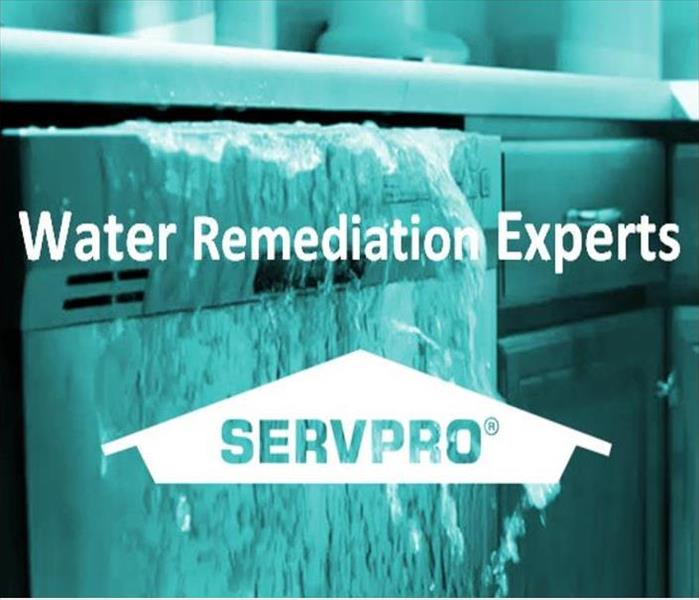 Even after taking every necessary precaution, accidents still happen. When they do our team at SERVPRO Norwood/West Roxbury is here to help.
Even after taking every necessary precaution, accidents still happen. When they do our team at SERVPRO Norwood/West Roxbury is here to help.
There's nothing worse than walking into your home to find an appliance leaking or even worse flooded basement. Studies show that 40% of homeowners have experienced a loss from water damage. With billions of dollars in property losses recorded every year, water damage causes a significant amount of loss. The good news, in most instances the damage could have been prevented.
There are many things homeowners you can do to prevent water damage. It's just a matter of knowing what to do. By staying on top of leaks and taking the proper safety measures, we can defend ourselves from the stress and money loss caused by water damage. Here are the two ways homeowners can reduce the risk of water damage in their homes.
Stay On Top Of Leaks
If you come across a leaking water source in your house, even a slight one, it should be tended to immediately. Leaks do not go away and they usually get worse. Taking the time to fix a little leak when it is first discovered will certainly save you time, money, and hassle if and when the little leak transforms into something more spinster! Even slow leaks will lead to mold, mildew, rot, and insect damage.
It is a good idea to regularly inspect:
- Refrigerators
- Washing machines
- Dishwashers
- Toilets
- Windows
- Ice makers
- Roofs/ceilings
- Walls
Really, anything connected to a water line or exposed to external elements should be checked regularly. Look for any discolored or brown spots under or around these areas. These are indicators for leakage. Also, look for any cracked walls or loose shingles on the roof. These should be fixed quickly and are usually grounds for leaks and water damage to follow.
Inspect Water Sources
Making sure that your water sources are working properly is key to the prevention of water damage. These include:
- irrigation system
- sump pump
- hoses
- wells
- septic systems
If you use an irrigation system you'll want to inspect it routinely to make sure it's in proper working condition. Damage to these systems can result in gallons of water and significant flooding.
A sump pump is usually located in the basement of your home and its purpose is to remove any excess water that has built up due to a storm or flooding. Performing checkups on your pump every year and during storms will limit any water damage from building up.
Damaged external hose nozzles can cause leaks both outside and inside your home. If not properly winterized, water remaining in the nozzle will freeze and may cause either damage to the nozzle or, even worse, an interior pipe to burst. It is a good idea to inspect the plumbing for any external water source each spring prior to turning it on for the first time.
Even after taking every necessary precaution, accidents still happen. When they do our team at SERVPRO Norwood/West Roxbury is here to help. Give us a call today for assistance in helping you with your water damage at (781) 769-9125.
Spring Cleaning
4/7/2021 (Permalink)
Now that spring is upon us once again, cleaning is probably on your mind. Whether you just need to freshen up your home after a long winter or you're thinking about cleaning out cluttered spaces SERVPRO of Norwood/West Roxbury is here to help with some tips to get you started!
Lemon Power
This spring, make faucets clean and sparkly by rubbing a lemon half on the water stains. The citric acid helps remove hard water marks. Then, use the other half of the lemon for our next tip.
Cut a lemon into halves, squeeze the juice into 1/2 cup of water and drop the rinds into the mixture. Microwave for three minutes and let it stand for five minutes without opening the door. The trapped steam will loosen the grime, so you can wipe the microwave clean with less elbow grease.
White Vinegar Beats Buildup
Looking for more natural ways to clean your bathroom? Vinegar can dissolve the mineral deposits accumulate in showerheads over time, causing reduced pressure and water flow. Fill a plastic bag with white vinegar, secure it over the showerhead with a rubber band and leave it overnight to get rid of buildup. Just be sure to run the shower before you hop in, or you risk smelling like vinegar all day.
Mix ¼ cup of white vinegar, 2 cups of water and 2 teaspoons of liquid soap into a spray bottle. Spray the mixture onto the glass and scrub with newspaper for a streak-free window or mirror. The ink acts as a mild abrasive and allows you to make use of old newspapers.
Magic Dryer Sheets
Dryer sheets are non-abrasive and a great way to remove burnt-on food from your stove. Place a wet dryer sheet on your stovetop. Leave it on your hard to remove residue at least 15 minutes. Start rubbing with the dryer sheet and watch the gunk come off!
Grilling Onions
Get your grill cleaned up and ready for the warm weather. First, heat it up and spray some white vinegar onto the grates to help loosen the residue. Then, scrub the area firmly using half an onion. The acid from the onion will rid your grill of any leftover remnants.
Window Wash Your Carpet
The rubber edge of a window washing squeegee is a great tool for gripping and removing pet hair from your rug. Use a firm grip and make sure to clean up the excess hair as you go. Finish by running the vacuum to catch any hair still on the surface.
And don't forget that SERVPRO of Norwood/West Roxbury is here to help you with all of your spring cleaning needs! Just give us a call at (781) 769-9125.
Here To Help After The Storm
4/7/2021 (Permalink)
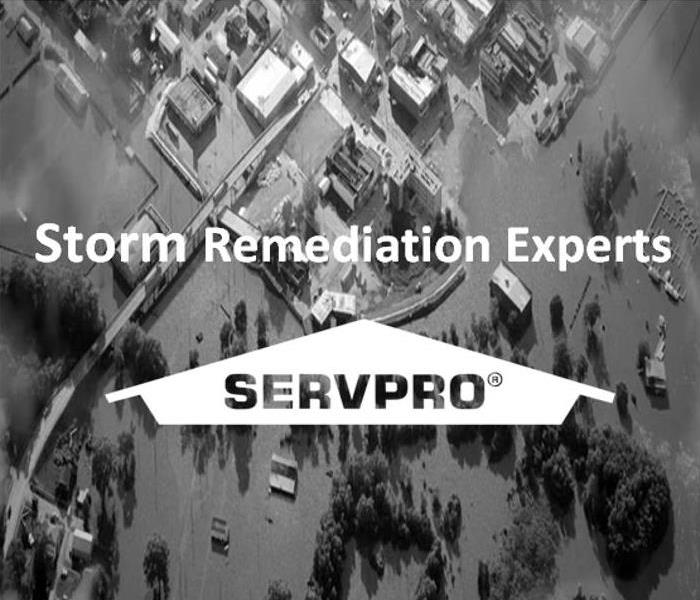 When storm damage strikes your commercial property SERVPRO of Norwood/West Roxbury is here to help our community.
When storm damage strikes your commercial property SERVPRO of Norwood/West Roxbury is here to help our community.
Research shows since 1980, the occurrence of weather-related disasters has increased by more than 230 percent. According to AccuWeather, natural disasters have affected at least 217 million people every single year since 1990. When a storm wreaks havoc on your commercial property you need help from a company that can handle any size of the disaster. SERVPRO of Norwood/West Roxbury is that company.
Our Disaster Remediation Teams have access to a fleet of vehicles and a 4,000 square foot warehouse full of professional-grade, state-of-the-art equipment. Our main facility is located right of 495 which means that we can arrive onsite within hours of receiving your call. Every large loss is supervised by one of our Project Managers to help ensure seamless communication and timely mitigation. Our Teams are on call 24 hours a day, every day of the year, including holidays. Our clients do not have to wait till the next business day for us to arrive.
When storm damage strikes your commercial property SERVPRO of Norwood/West Roxbury is here to help our community. No matter what your needs may be, we have a commercial-sized solution for you. Call us today - (781) 769-9125. We will make it, "Like it never even happened."
Stay Safe During A Flood
3/31/2021 (Permalink)
Spring time in New England is upon us. As the saying goes, April showers bring May flowers. Unfortunately, these shower can also bring flash flooding. Floods are one of the most common and widespread natural disasters in the United States. Even if your Westwood, MA home is in a moderate-to-low risk flood zone, there is always a potential for a flood to occur. In fact, studies show that approximately 20% of all flood insurance claims come from moderate-to-low risk areas. Knowing what to do in the event of a flood can help keep you and your loved ones safe. Below are important safety tips from the American Red Cross:
- Stay away from floodwaters. It can be easy to underestimate the power of running water. Just 6 inches of quickly moving water is enough to potentially sweep you off your feet. If running water is up over your ankles, turn around and find another way.
- Rapidly moving water can also push heavy objects such as cars. Many vehicles can be overcome by the current from waters less than 2 feet deep! Travel should be avoided if possible during a flood but if you do travel and come to a road that appears to be flooded, turn around and choose a safer route. If you are stuck on a flooded road and the water is rising, leaving the car for higher ground and shelter is advised.
- Do not let your children out of your sight during a flood. Kids tend to be curious and may not understand how dangerous contaminated or running water can be.
- Having an emergency safety kit is helpful in a situation such as a flood. Visit the American Red Cross website for tips on how to build your own emergency flood kit!
When flooding does occur safety is always the top concern. Our team at SERVPRO Norwood/West Roxbury is here to help. Give us a call today for assistance in helping you with your water damage at (781) 769-9125.
Water Bulge in Ceiling
3/26/2021 (Permalink)
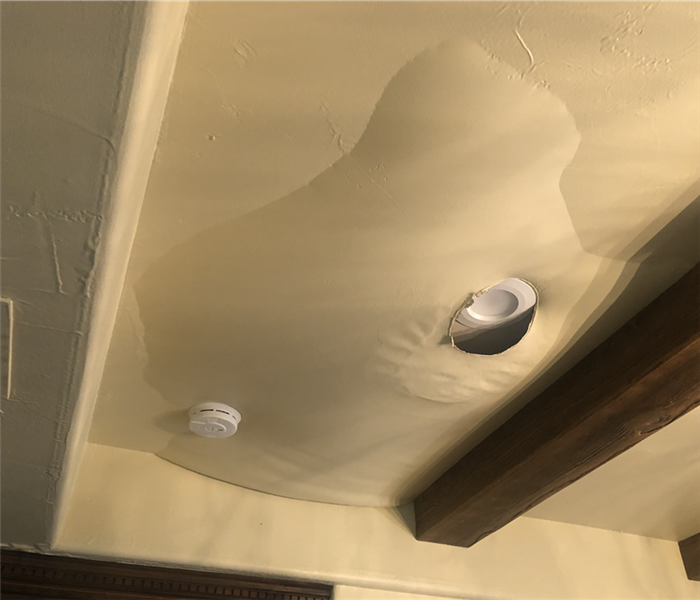 A ceiling bubble found in a home that experienced water damage in Austin, Texas due to the historic snow storm.
A ceiling bubble found in a home that experienced water damage in Austin, Texas due to the historic snow storm.
Water bulges in ceilings are a shock to anyone who may discover them in your home or office. The causes of these bulges can range, but the bulges are usually caused by two things: water leaks from pipes or a mistake in installation of parts of a ceiling. These bulges can be ugly, and can also pose a hazard by weakening the structure of a ceiling, depending on the extent of the damage.
As described in this article from Hunker by Renee Miller, https://www.hunker.com/13414058/a-bulge-in-the-ceiling, the first step to fixing a bulge in a ceiling is to determine the cause of the problem.
1. Improper Construction
Ceilings made using plaster applied over gypsum lath may develop what is called a bulge effect if the final coat of plaster is applied before the first coat is completely dry. The moisture from the first coat moves back into the lath and results in bulges at the seams. In some cases, the seams running perpendicular to these also bulge. In other types of ceilings, such drywall, too much weight from insulation, exposure to prolonged humidity, an improperly installed vapor barrier, or the installation of ceiling panels that are too thin for the frame spacing can cause ceilings to bulge.
2. Leaks
Leaking water from plumbing pipes or other sources of water can be damaging to your ceiling, causing these bubbles. This can signify that water is pooling from the leak, and will show a bubble. The water can lead to structural defects in the ceiling, making it dangerous. We are professionally trained in the steps to determine what steps need to be taken (i.e. a puller needs to be brought in) and how to restore your ceiling, as a part of our rebuilds devision.
Steps to Take if you Find a Bubble
Before a professional can arrive to check it out, there are some steps you can take to ensure safety for everyone in the home/building before the issue can be resolved.
1. Call SERVPRO
Call a professional, such as SERVPRO to ask to have someone to come take a look at it. Whatever instructions given to you by a project manager/representative should be followed, but the next two steps are likely what they will tell you. Again, every situation is different, and the SERVPRO representative may tell you different steps, which should always be followed.
2. Remove all furniture under the bubble
Furniture/items under the bubble may become damaged if water/liquid inside of it gets on it.
3. Collect large buckets, and pop it!
Sometimes it can take weeks from estimate to fixing the issue. The longer the water sits behind the paint, the more damage it will do the drywall, and especially with ceilings, which will fall into the house if the drywall gets too wet and heavy. Use something such as a pencil or a knife to pop it with a small hole. Have lots of buckets ready to collect the water and do all you can to avoid the water getting on the flooring, as water on a floor can lead to mold and/or buckling.
Our team at SERVPRO Norwood/West Roxbury is here to help you in your time of need. Give us a call today for assistance in helping you with your damage, whether it be residential or commercial at (781) 769-9125
Specialty Commercial Cleaning Services
3/12/2021 (Permalink)
SERVPRO of Norwood/West Roxbury professionals offer cleaning services ranging from cleaning restaurant hoods to removing biohazard contaminants. They have the specialized training and products to get your property back to business. Their cleaning services include the following:
- Certified: SERVPRO Cleaned: Our new defensive pathogen cleaning program, goes way beyond standard janitorial cleaning practices. This is proactive viral pathogen cleaning. With over 50 years of experience in biochemical spill remediation and decontamination, you can trust us to bring a higher standard of clean to the places we gather.
- Biohazard: Exposure to biological and chemical contaminants can pose serious health consequences. A failure to properly remove such substances can contribute to unhealthy and dangerous environments. We are trained to safely clean and remove biohazardous substances and dispose of them properly in accordance with OSHA and health regulations.
- Ceilings, Floors, and Walls: Ceiling and wall cleaning should be part of the cleaning maintenance of your business. You should also clean walls before painting so that the primer and paint can adhere properly. Whether you are preparing to paint or just looking for professional cleaning, we can help.
- Document Restoration: In the aftermath of a disaster, some of your most valued contents could be lost forever. As a leader in the restoration industry, we know that timely mitigation is the key to recovering damaged possessions. With years of experience and state-of-the-art technology, our restoration professionals will help you recover your paper goods before it’s too late.
- Odor Removal: As experts in deodorization, our professionals are trained to identify and eliminate offensive odors. These odors can come from a number of sources both inside and outside a structure.
- Sewage: Sewer backups should be considered an emergency since the water may contain viruses, bacteria, and other microbes that cause serious illnesses. Our team has specialized training and equipment to quickly and safely clean contaminants like sewage.
- Vandalism: Graffiti and vandalism can be very upsetting. It can range from relatively minor pranks to malicious destruction of property. Often simple acts of vandalism, like breaking a window, can cause significant water and mold damage if not addressed in a timely manner.
When damage strikes Dedham, MA commercial property SERVPRO of Norwood/West Roxbury is here to help our community. No matter what your needs may be, we have a commercial cleaning solution for you. Call us today - (781) 769-9125. We will make it, "Like it never even happened."
Has Cleaning Exceeded Your Business' Internal Resources
3/12/2021 (Permalink)
Running a successful business in Massachusetts is hard enough, let alone during a pandemic. You have enough to do to keep your business running, so be sure that you have the best vendors possible to take care of your commercial property. Your time is better spent that having to figure out what to do about the inevitable wear and tear that gradually builds in your office over time. When grime, odor, and moisture challenges go beyond the scope of your regular janitorial staff, call SERVPRO of Norwood/West Roxbury to help with your commercial cleaning projects.
Whether it’s disinfecting your offices, removing an odor problem or a deep cleaning, you can rely on us to make your workspace look and feel its very best. When you call SERVPRO of Norwood/West Roxbury you will be bringing in a quality contractor who carries these benefits:
- Certified training
- Over 50 years’ experience in the industry
- More than 100 exclusive cleaning products
When damage strikes West Roxbury, MA commercial property SERVPRO of Norwood/West Roxbury is here to help our community. No matter what your needs may be, we have a commercial cleaning solution for you. Call us today for more information or to set up an appointment - (781) 769-9125. We will make it, "Like it never even happened."
Why Choose SERVPRO Norwood/West Roxbury - Restore Versus Replace
3/9/2021 (Permalink)
Everyone at SERVPRO Norwood/West Roxbury understands our customer's situation. After disaster strikes they want to know that they are receiving the best possible remediation services at a fair cost. The Disaster Remediation Teams at SERVPRO of Norwood/West Roxbury are uniquely qualified to help. Our results create a measurable difference.
Emergency Response
Restoring property is our first priority. Our customers will appreciate our immediate response to their calls and they know everything is being done to limit the damage.
Minimize Cost
Restoring property is less expensive than replacing property. Our certified technicians follow the rule of, "Restore whenever possible, replace only when necessary." Our Disaster Remediation Teams make sure pretesting is completed on every loss to determine restorability. Furthermore, we will provide an itemized loss report complete with pictures of important items to ensure complete reimbursement on any claims.
Electronic Filing
To expedite the process even further we offer electronic claims filing for our customers. Our Claims Information Center provides fast, accurate information in a format insurance companies understand. This means our clients receive the highest allowable reimbursement in the fastest time possible. Our reporting includes:
- A Complete Electronic Job File.
- First Notice of Loss.
- Detailed Estimate.
- Digital Loss Photos.
- Scanned Forms and Paperwork.
- All delivered by email or hard copy.
- On-line Access to All Files.
- New Assignments.
- Pending Jobs.
- Completed Jobs.
SERVPRO of Norwood/West Roxbury is here to help our community and will be by your side every step of the way after a crisis damages your commercial or residential property. Call (781) 769-9125 for help with any emergency and will make it, "Like it never even happened."
Fire Alarms In Your Home
2/10/2021 (Permalink)
While you might assume that when you bought your home in Medfield, Ma that it came correctly installed fire alrams, this is not always the case. As more research has been conducted over the years on fires and how they spread, requirements have changed. Many older homes do not meet these standards which can be dangerous in the case a fire does occur. Keep your family safe by ensuring a fire alarm is located in the following four locations!
Bedrooms
The National Fire Protection Association suggests the placement of a fire alarm in every bedroom of the house. This ensures that if a fire occurs while your family is asleep, the alarms will wake quickly wake up everyone.
Outside Every Sleeping Area
Not only should alarms be inside every bedroom, there should be a smoke alarm right outside the room or any other sleeping areas as well. This is so you can react and start to escape before any fire or smoke even enters your room.
10 Feet From Your Kitchen
Kitchen fires result in approximately 50 percent of all home fires, many of which result in serious fire damage to your home. Make sure a fire alarm is located 10 feet from your kitchen rather than inside it since smoke or steam from cooking can easily trigger it.
Every Level of Your Home
Ensure that there is as least one smoke alarm on every level of your home. Don’t forget your basement! Serious fire and smoke damage can occur from an undetected fire that starts in the basement.
It doesn’t take long for a house fire to quickly get out of hand! That’s why it is so important to have fire alarms correctly installed in your home. A fire can happen at any time and when it does call the experts at SERVPRO of Norwood/West Roxbury at (781) 769-9125. We will make it, "Like it never even happened."
Removing Odor After A Fire
2/10/2021 (Permalink)
Smoke odors after a fire are persistent. Methods such as air filtration, ventilation, or wiping residue off of surfaces are not likely to be sufficient. Particles of smoke drift into air ducts, nooks and crannies, and porous materials such as carpeting, drapery, and furniture. The only way to completely eliminate smoke odor is to permanently neutralize the presence of these particles. Here are three methods we use to eliminate odor after a fire.
Ozone Machines
Ozone machines release molecules that follow the same path as smoke particles and oxidize these sources of odor. This method is popular because it works quickly, but all occupants, pets, and plants must be temporarily evacuated.
HVAC Air Scrubbers
These scrubbers connect to the central air system to circulate air and filter out smoke particles. As these systems do not neutralize odor molecules, a faint smoke odor may linger. Some odor mitigation professionals may combine an air scrubber with another smoke cleaning method.
Thermal Foggers
Thermal foggers fill a home with fog for approximately 30 minutes before the residence is ventilated and allowed to dry. This highly effective odor elimination method also calls for evacuation and workers must wear respirators.
When fire strikes your commercial or residential property fixing the damage is step one, eliminating the odor is step to. The Disaster Remediation Teams at SERVPRO of Norwood/West Roxbury are here to help with both! Call us at (781) 769-9125. We will make it, "Like it never even happened."
After A Fire You Need Professional Help
2/10/2021 (Permalink)
When fire strikes your Dedham, Ma commercial or residential property most owners think expect that there will be some sort of structural damage that needs to be fixed. What most do not consider is the need for professional cleaning to remove smoke and soot damage. Why should a property owner seek a professional?
There are two different types of smoke–wet and dry. As a result, there are different types of soot residue after a fire. Before restoration begins, SERVPRO of Norwood/West Roxbury will test the soot to determine which type of smoke damage occurred. The cleaning procedures will then be based on the information identified during pretesting.
Wet Smoke – Plastic & Rubber
Low heat, smoldering, pungent odor, sticky, smeary. Smoke webs are more difficult to clean.
Dry Smoke – Paper & Wood
Fast burning, high temperatures, heat rises therefore smoke rises.
Protein Fire Residue
Protein fire residue is produced by evaporation of materials, is virtually invisible, discolors paints and varnishes, and usually has an extreme pungent odor.
Since each smoke and fire damage situation is a little different, each one requires a unique solution tailored for the specific conditions. The Disaster Remediation Teams at SERVPRO of Norwood/West Roxbury are here to help! Call us at (781) 769-9125. We will make it, "Like it never even happened."
Complete Water Remediation
2/5/2021 (Permalink)
WHY SERVPRO of Norwood/West Roxbury Disaster Remediation Teams Can Make a Difference in Your Westwood, Ma commercial or residential property after disaster strikes. After a water damage incident, one thing most property owners do not consider is the potential risk of residual odor damage. We will help guard against such pleasantries.
To neutralize the unpleasant odors, our certified technicians utilize various tactics. First, we determine the cause of the odor. As water comes into contact with organic materials, rotting may take place and lead to the formation of the odors. At the same time, the odor can emanate from wet materials that are not thoroughly dry.
To deal with the odor problem after water damage in teams of professionals start by determining the source of the odor. In most cases, the smell usually emanates from multiple sources; that is why we employ different methods in the deodorization process. To perform the job satisfactorily, we have the latest technical equipment and a vast wealth of knowledge on how to deal with such situations.
When removing the unpleasant smell, our remediation experts understand that one type of deodorization agent cannot fight all types of water damage odor. For that reason, we use different types of deodorants to eliminate the different types of odor. Depending on the situation we are dealing with, we may decide to use thermal foggers or ULV foggers to dispense the deodorants.
There are different types of deodorants that can be used. Some simply mask the odor. Unfortunately, these type of products do not last and eventually the odor will return, sometimes even more pungently. That is why our teams use filtration and absorption agents which combine with the odor particles causing them to fall on surfaces that we later on clean. After deodorization, we can apply disinfectants to inhibit the growth of mold.
SERVPRO of Norwood/West Roxbury has a track record in eliminating bad smells from both commercial and residential properties. We are here to help our community and will be by your side every step of the way after a crisis damages your Westwood, Ma commercial or residential property. Call (781) 769-9125 for help with any emergency and will make it, "Like it never even happened."
Why SERVPRO of Norwood/West Roxbury - The Right Choice
2/5/2021 (Permalink)
When a storm causes a flood, or a burst pipe causes serious water damage to your Dedham, Ma commercial or residential property choosing the right restoration services provider makes all the difference. Property owners should be mindful of who they hire, as all service providers are not created equally. Before selecting a company to handle the job, keep in mind these points of emphasis:
- Only choose certified professionals to perform water damage restoration services. Technicians who have received certification have made the effort to get the best training possible, proving that they take their job seriously. Certification through the Institute of Inspection, Cleaning and Restoration Certification (IICRC) is a sign that a professional has received the most up to date training and is knowledgeable in the latest techniques and technologies employed during repairs. The IICRC operates a Certified Firm registrant-only database on its site, making it easy to find a local, certified professional without trouble.
- Do not select a technician based only on the price. As a cost savings measure insurance companies often select a restoration company based on the estimation price. The cost of restoration is consistent throughout the industry. Therefore, the a lower cost means less services provided. While this may go unnoticed in the short term, long term issues like mold, odor or structural damage may occur.
- A company that offers a range of water damage restoration services is the wisest choice. A company offering a full range of remediation services is the best equipped to identify and mitigate against secondary damage. We are a one-stop remediation-to-rebuild shop. That means we understand how remediation impacts rebuilding efforts. Our teams understand the impacts of decisions made during remediation to the cost of the rebuilding process as well as its overall long term success.
- Emergency services are not always synonymous. Answering the phone 24 hours a day is not the same as having Teams on call, ready to be deployed 24 hours a day, every day of the week, including holidays. When disaster strikes every minute the start of remediation is delayed translates into increased remediation costs and timelines.
SERVPRO of Norwood/West Roxbury is here to help our community and will be by your side every step of the way after a crisis damages your Dedham, Ma commercial or residential property. Call (781) 769-9125 for help with any emergency and will make it, "Like it never even happened."
Why Choose SERVPRO Norwood/West Roxbury - Biohazard Remediation
2/5/2021 (Permalink)
Biohazard cleanup is the cleaning, sanitation, and deodorizing of areas where a traumatic events such as an accident, injury or death has occurred. Usually this means dealing with blood, human or animal remains, chemical spills, and more. This also includes cleaning up after a crime scene, since it is up to the property owner to find biohazard cleaning services.
Biohazard Cleanup Should Be Done By Professionals
SERVPRO of Norwood/West Roxbury Disaster Remediation Technicians are OSHA certified. Our technicians understand how to protect themselves and others with personal protective equipment (PPE) when dealing with blood borne pathogens. PPE helps ensure the safety of our workers. This equipment helps prevent hazardous material from contacting the body through the skin, eyes, mouth, nose or any other area. Although PPE varies from job to job, it should always include gloves, a hazardous material body-suit, and a respirator.
The Biohazard Cleanup Process
- First, our technicians will identify the affected areas and determine the scope of the work. Once the plan is agreed upon, the remediation begins as quickly as possible.
- We will always put the focus on both their safety and that of other individuals at the cleanup site.
- Our teams will properly remove and dispose of any potentially infectious materials from the site.
- Hazardous medical waste, such as: bodily fluids, or items that contain potential health hazards, are handled following OSHA and state of Massachusetts regulations.
- We remove porous materials like fabric and carpeting following both industry and state of Massachusetts regulations.
- Non-hazardous materials are decontaminated if they are salvageable.
- After the cleanup and sanitization, we thoroughly deodorize the affected areas.
- Removing contaminated materials, then cleaning and sanitizing is usually enough to control odors. However, in rare cases, the crew will use hydroxyls or ozone to ensure the odor is eliminated.
SERVPRO of Norwood/West Roxbury is here to help our community and will be by your side every step of the way after a crisis damages your commercial or residential property. Call (781) 769-9125 for help with any emergency and will make it, "Like it never even happened."
Water Damage Imaging Equipement
2/5/2021 (Permalink)
Once a water damage hits your Norwood, Ma or commercial or residential property, our Disaster Remediation Team will come out to evaluate the damage. Water damage restoration requires the use of certain equipment. This may include detection devices, extraction equipment, air moving and dehumidification equipment, as well as safety equipment.
Scoping involves locating the areas of the structure into which water has intruded and defining the extent to which structure and contents have absorbed moisture beyond normal moisture levels. Various devices allow our certified technicians to track moisture within a structure. These devices include the following:
- Moisture sensors
- Thermal imaging cameras
- Moisture meters
Moisture Sensors
The moisture sensor is used to detect moisture in carpets and padding. The moisture sensor has sharp probes that penetrate through carpets and pad to determine if water has migrated on the subfloor underneath.
Thermal Imaging Camera
Thermal imaging cameras (also called infrared cameras) are utilized for inspecting and monitoring moisture in building materials. They can show how water traveled throughout a structure, and many times they can indicate moisture that otherwise may not have been discovered. At the end of the project, they provide excellent documentation or proof that drying was successfully completed.
Moisture Meters
Moisture meters are utilized to measure the actual moisture content or level of various materials. Some meters are calibrated to measure specific materials; for example, a moisture meter calibrated for drywall will not accurately read moisture content in wood materials. Some meters are adjustable for different types of materials, such as a meter that can be adjusted for both wood and drywall. There are penetrating and non- penetrating moisture meters.
SERVPRO of Norwood/West Roxbury is here to help our community when water damage strikes their commercial or residential property. We are equipped to get the job done right. Call (781) 769-9125 for help with any emergency and will make it, "Like it never even happened."
Protect Your Commercial Property Against Sprinkler System Failure
2/5/2021 (Permalink)
As a commercial property owner in West Roxbury, MA when did you last think about it your sprinkler systems? Unfortunately, sprinkler systems often get left off of the yearly maintenance to-do list because they do not malfunction often, but they can. When they do the damage can be significant! The following are steps to be taken regularly to prevent against a sprinkler system disaster;
Maintenance
Plan to periodically check your sprinkler system for obvious issues. It is relatively easy to accidently damage a sprinkler head. A damaged head, bent pipe, rust and even dust build up might not cause immediate system failure, however, over time it may. If you notice anything like that, call your fire suppression system contractor to come and replace the parts.
Inspect
The National Fire Protection Association sets standards for regular maintenance, inspection, and testing of fire sprinkler systems. Following these regulations keeps your business up-to-code and ensures that your system is ready if it's needed. Completing the main drain test will likely fall under the scope of a whole system inspection, but if for any reason you're concerned that your sprinkler system may not be working properly, you can test it yourself.
SERVPRO of Norwood/West Roxbury is here to help our community when damage strikes their commercial property. Regular maintenance, inspection, and testing of your sprinkler system will keep your business and employees safe. If they do fail call (781) 769-9125 will make it, "Like it never even happened."
Why SERVPRO of Norwood/West Roxbury - Attic Mold
1/26/2021 (Permalink)
Mold problems spread via spores that float in the air, which is why experts recommend immediate mold remediation. Unlike most other property damage, mold infestation can go unnoticed, especially in the attic space of your Norwood, MA commercial or residential property. Here are some potential warning signs to look for.
Gutter Issues
Did you know that problems with your rain gutters can cause rot, and leaks that may cause mold damage? Gutters can cause moisture problems in your attic if they become clogged and back up allowing water to get under the sheathing or behind the soffits. If the gutter is too small, misaligned or deformed they could allow water to escape into your property.
Air Flow And Humidity
Air flow in your attic space is extremely important, especially during the hot and humid summer months. Attic ventilation works on the principle that heated air rises, primarily utilizing two types of vents: Intake vents, located at the lowest part of the roof under the eaves, allow cool air to enter the attic. Hot air exhaust vents, located at the peak of the roof, allow hot air to escape. When your attic space is not properly ventilated the build up of humidity may result in mold growth.
Roof Leaks
You'd expect that a roof leak could cause moisture problems in the attic. It is a good idea to periodically check the sheathing for any signs of leakage or water damage. Over time even a small leak will, over time, result in mold growth.
Pests
Pests can be either a cause of or an effect of moisture problems. For example, damp wood termites love to infest wood that's already wet and rotting, so they could show up throughout your home after moisture problems develop. On the other hand, pests such as bats and raccoons can sometimes be the cause of a moisture problem in your home.
One way pests can cause moisture problems is simply by living in your attic. Their waste products could increase humidity and allow mold to develop.
To keep mold problems from deteriorating the structural integrity of your home, you'll need to not only remove the mold but also eliminate the conditions that caused the mold to grow. That is why you need to call the mold remediation experts at SERVPRO of Norwood/West Roxbury. Our Disaster Remediation teams will help you salvage damaged materials, clean off mold, and remove excess moisture from the air. Also, we will help you get to the bottom of why the damage occurred in the first place so you prevent future damage. Call (781) 769-9125 and we will make it, "Like it never even happened."
Planning To Reopen - Latest COVID-19 Vaccine Update
1/7/2021 (Permalink)
Governor Charlie Baker has voiced his concerns regarding the potential increase in COVID-19 cases coming out of the holiday season. Baker said while it remained too early to draw definitive conclusions, it appeared the state is seeing a uptick in coronavirus hospitalizations stemming from the December holidays.
He also shared the change in the average age of COVID-19 patients. At the beginning of November the average age of patients receiving hospitalization for COVID-19 was 61. The average age has increased significantly. Currently it is 71 years old.
In light of this new data Governor Baker announced that people age 75 or older had been moved higher up in the order of the state's vaccination plan; and that first responders will begin receiving vaccination shots next week.
The 75-plus age group is now part of Phase 2, Group 1 in the rollout, joining people with two co-morbid conditions as those considered at high risk for complications from COVID-19. They had previously been listed later in Phase 2.
The change affects about 170,000 people and was recommended by the state's advisory board.
But the next set of people who will receive the vaccine are the state's roughly 45,000 first responders, the third of seven groups in Phase 1, who can begin to be vaccinated starting next Monday, Jan. 11.
"Police officers, firefighters EMTs and all first responders work in risky situations every day and this vaccine will protect them from COVID and the terrible illness that can come with it," Baker said during a press conference Monday.
There are three options for getting the vaccine, outlined on the state's first responder vaccination website:
- Departments that meet certain criteria, like being able to vaccinate at least 200 first responders and store the doses on-site, can administer the shots themselves.
- More than 60 sites have been stood up to give first responders the vaccine.
- The state is working on developing four mass vaccination sites that can vaccinate up to 2,000 people per day, the details of which are still yet to be released. Baker said it's likely those sites would continue to be used after first responders are vaccinated.
It is critical for all of us to remain vigilant in our battle against COVID-19. COVID-19 remains a highly transmissible disease. Individuals should continue to follow these universal precautions:
- Follow healthy hygiene practices
- Stay at home when sick
- Practice social distancing
- Use a cloth face covering (with some exceptions) in community settings when physical distancing cannot be maintained.
We will continue to share with you guidance from the CDC, EPA, FDA, Mass EEA, Mass EEC, Mass DESE, and OSHA and the Governor's office While the administration continues to work with Federal and Local agencies to insure the safety and wellbeing of the residents of the Commonwealth during this ongoing pandemic and now manage the delivery of the much needed aid.
Also, we at SERVPRO of Norwood/West Roxbury know that not every community has access to the resources necessary to meet the strict cleaning guidelines to ensure a safe environment for our children. For those communities, we are here to help!
Certified: SERVPRO Cleaned
The Disaster Remediation Teams at SERVPRO of Norwood/West Roxbury are specialists in cleaning services and we adhere to the highest cleaning and sanitation standards. We are prepared to clean and disinfect your schools, according to protocols set forth by the Centers for Disease Control and Prevention. We have years of experience in dealing with biological contaminants, and we will go beyond the scope of work of "normal daily cleaning". Call SERVPRO of Norwood/West Roxbury today for a free consultation - (781) 769-9125.
All of us here at SERVPRO of Norwood/West Roxbury want you and your loved ones to stay safe and know that we will make it through this together! Rest assured, we will continue to do our best to keep you up-to-date and informed!
Planning To Reopen - Latest COVID-19 Update
1/6/2021 (Permalink)
At his press conference yesterday, Governor Charlie Baker reiterated the importance of remaining vigilant in following the Administration's guidelines to control the spread of COVID-19 and warned of the reality that the new, more contagious variant of the coronavirus has arrived in the state.
"I think most of us are working on the assumption that it's here," Baker said at a press conference at Baystate Medical Center in Springfield. "There would be no reason not to."
Currently, four states have confirmed the presence of this new strand of the COVID-19 virus:
- New York
- Colorado
- California
- Florida
The first U.S. case of the U.K. virus was detected by health officials in Colorado at the end of December in a man in his 20s. The most concerning aspect of this discovery was that this individual had no recent travel history.
Governor Baker shared the latest data on the spread of COVID-19 in Massachusetts:
- The number of patients hospitalized for COVID-19 has increased again, to 2,339.
- Of those hospitalized, 423 were listed as being in intensive care units
- Of those in ICU 258 are intubated
He assured residents that Department of Public Health is working closely with the Centers for Disease Control and Prevention, to monitor the potential spread of this new variant into the Commonwealth.
He also took this time to remind residents that the rollback on coronavirus restrictions that took effect last month are still in affect until at least noon on Jan. 10. These include a crack down on gatherings and businesses and a requirement that hospitals halt most elective surgeries. The major impact of these rollbacks was a reduction in maximum capacity limits to 25% for the following:
- Restaurants
- Movie theaters and performance venues
- Casinos
- Offices
- Places of worship
- Retail businesses
- Fitness centers and health clubs
- Libraries
- Golf facilities
- Driving and flight schools
- Arcades
- Museums
Baker closed by reiterating the need for people to refrain from unnecessary social gatherings and follow guidelines set forth by the state. He said, "I'll go back to my little speech about how important it is for people to wear masks, maintain distance and recognize and appreciate that when you're not with the people you live with, you really ought to be very vigilant and careful and cautious about your physical engagement with other people," and that, "everything we can do to be vigilant is going to protect you and the members of your family from getting the virus or potentially giving it to someone else."
It is critical for all of us to remain vigilant in our battle against COVID-19. COVID-19 remains a highly transmissible disease. Individuals should continue to follow these universal precautions:
- Follow healthy hygiene practices
- Stay at home when sick
- Practice social distancing
- Use a cloth face covering (with some exceptions) in community settings when physical distancing cannot be maintained.
We will continue to share with you guidance from the CDC, EPA, FDA, Mass EEA, Mass EEC, Mass DESE, and OSHA and the Governor's office While the administration continues to work with Federal and Local agencies to insure the safety and wellbeing of the residents of the Commonwealth during this ongoing pandemic and now manage the delivery of the much needed aid.
Also, we at SERVPRO of Norwood/West Roxbury know that not every community has access to the resources necessary to meet the strict cleaning guidelines to ensure a safe environment for our children. For those communities, we are here to help!
Certified: SERVPRO Cleaned
The Disaster Remediation Teams at SERVPRO of Norwood/West Roxbury are specialists in cleaning services and we adhere to the highest cleaning and sanitation standards. We are prepared to clean and disinfect your schools, according to protocols set forth by the Centers for Disease Control and Prevention. We have years of experience in dealing with biological contaminants, and we will go beyond the scope of work of "normal daily cleaning". Call SERVPRO of Norwood/West Roxbury today for a free consultation - (781) 769-9125.
All of us here at SERVPRO of Norwood/West Roxbury want you and your loved ones to stay safe and know that we will make it through this together! Rest assured, we will continue to do our best to keep you up-to-date and informed!
Travel FAQ 18-26
1/5/2021 (Permalink)

The holiday season has past but travel risks remain. It remains important that we all do our best to continue to travel as responsibly and safely as possible. The Baker Administration has set forth guidelines to follow for those of us where travel is unavoidable this Holiday Season. The following are FAQ to help residents of the Commonwealth better understand the requirements.
18. May travelers from places other than lower-risk states be exempt from the Travel Order requirements if traveling for the purpose of running errands like going to the grocery store or pharmacy?
- Travelers are exempt from the requirements to fill out the Travel Form and self-quarantine or obtain a negative COVID-19 test result if their travel is limited to brief trips for purposes that the Commissioner has designated as Critical Life Activities. This allowance is limited to short, same-day trips across the border and back for the following purposes: grocery shopping, visits to pharmacies, attending appointments with licensed health care providers including medical, dental, or mental health,, visiting persons receiving treatment in hospitals or residing in congregate care settings, attendance at day care or children’s camps, attending religious services and funerals or memorial services, or attending to the care needs of family members.
- During such trips, travelers are instructed to wear face-coverings, maintain social distance, practice good hygiene, and adhere to all other COVID-19 rules and restrictions.
19. I am a resident of RI attending a wedding in MA. Is the wedding considered a Commissioner’s Exemption under “religious services?”
- The wedding service itself can be considered an exemption as a religious service. However, any reception or celebration which either precedes or follows the ceremony is not exempted and requires either quarantining or a 72 hour negative test result in order to attend.
20. Are parents, guardians, and children required to comply with the Travel Order if traveling for the purpose of managing shared custody of a child?
- Children who travel into and out of Massachusetts because of transfers of custody or visitation between parents or guardians are exempt from the requirements of the order. Parents and guardians may rely on the transitory travel exemption, provided they comply with its limitations.
21. Other states’ travel restrictions include exemptions for trips that last less than 24 hours. Does Massachusetts have a similar exemption?
- No, there is no specific exemption for trips that last less than 24 hours. Such short trips may be covered by exemptions like the ones for transitory travel or commuting for work or school. Travelers arriving from places other than lower-risk States must fill out the Travel Form and self-quarantine or obtain a negative test result if they do not meet one of these exemptions.
22. I am looking to be exempt from the requirement to self-quarantine by obtaining a negative COVID-19 test, but I am unable to get tested in the state that I am traveling from. What can I do?
- A traveler who is required to quarantine may be released from the obligation to continue quarantining upon obtaining proof of a COVID-19 negative test, which was administered after the person’s arrival in Massachusetts. Travelers are required to quarantine immediately upon arrival in Massachusetts but may temporarily break quarantine to receive testing. Travelers must arrange for the test at their own expense and then are required to immediately continue quarantining until receiving a negative test result or the 10 days is complete.
23. After completing the Travel Form, do I need to keep a copy of my submission on-hand?
- You should keep the documentation with you. If you obtained a negative COVID-19 test result to be exempt from the self-quarantine requirement you should be prepared to produce those results upon request.
24. I am traveling to Massachusetts from Puerto Rico (or some other United States Territory). How does the Travel Order apply to me?
- For the purposes of the Travel Order the following U.S. jurisdictions are treated as States:
- District of Columbia
- Puerto Rico
- USVI
- Guam
- Northern Mariana Islands
- American Samoa
- None of these areas is currently classified as a lower-risk State, so travelers arriving from any of these places are required to fill out the Travel Form and self-quarantine or be prepared to produce a negative COVID-19 test result if they do not fall within one of the enumerated exceptions.
23. My child attends day care or day camp in MA or RI. Does he or she need to test or quarantine each day?
- No. Children who travel into or out of Massachusetts to attend day care or day camps are not required to comply with the Travel Order, and a parent or guardian transporting the child may rely on the transitory travel exemption, provided they comply with its limitations.
24. I live in Rhode Island and have a child or other family member receiving specialized medical care in MA. Can I visit them without quarantining or receiving a negative COVID test result?
- Yes. See response question number 18 above, which explains the Commissioner’s limited exception for Critical Life Activities.
25. What are the Commissioner’s exceptions for Critical Life Activities?
- grocery shopping
- visits to pharmacies
- attending appointments with licensed health care providers, including medical, dental, or mental health
- visiting persons receiving treatment in hospitals or residing in congregate care facilities
- attendance at day care or children’s camps
- attending religious services, and funerals or memorial services
- attending to the care needs of a family member
26. I am traveling into Massachusetts to participate in a clinical trial, am I exempt from the form and quarantine requirements?
Yes. Travelers coming to Massachusetts to participate in a clinical trial do not need to fill out the travel form and do not need to quarantine for 10 days.
Visitors are strongly urged to obtain a negative result before traveling to Massachusetts.
Testing for children, 10 years and younger, who are traveling with an adult from their household is not required.
Note: These requirements are in addition to Massachusetts requirements for wearing a mask or other face covering in both indoor and outdoor settings, any time you cannot socially distance and remain 6 feet from other people.
It is critical for all of us to remain vigilant in our battle against COVID-19. COVID-19 remains a highly transmissible disease. Individuals should continue to follow these universal precautions:
- Follow healthy hygiene practices
- Stay at home when sick
- Practice social distancing
- Use a cloth face covering (with some exceptions) in community settings when physical distancing cannot be maintained.
We will continue to share with you guidance from the CDC, EPA, FDA, Mass EEA, Mass EEC, Mass DESE, and OSHA and the Governor's office While the administration continues to work with Federal and Local agencies to insure the safety and wellbeing of the residents of the Commonwealth during this ongoing pandemic and now manage the delivery of the much needed aid.
Also, we at SERVPRO of Norwood/West Roxbury know that not every community has access to the resources necessary to meet the strict cleaning guidelines to ensure a safe environment for our children. For those communities, we are here to help!
Certified: SERVPRO Cleaned
The Disaster Remediation Teams at SERVPRO of Norwood/West Roxbury are specialists in cleaning services and we adhere to the highest cleaning and sanitation standards. We are prepared to clean and disinfect your schools, according to protocols set forth by the Centers for Disease Control and Prevention. We have years of experience in dealing with biological contaminants, and we will go beyond the scope of work of "normal daily cleaning". Call SERVPRO of Norwood/West Roxbury today for a free consultation - (781) 769-9125.
All of us here at SERVPRO of Norwood/West Roxbury want you and your loved ones to stay safe and know that we will make it through this together! Rest assured, we will continue to do our best to keep you up-to-date and informed!
Celebrating The Holidays Safely - Travel FAQ 10-17
12/31/2020 (Permalink)

As we continue to celebrate the holiday season it is important that we all do our best to do so as responsibly and safely as possible. The Baker Administration has set forth guidelines to follow for those of us where travel is unavoidable this Holiday Season. The following are FAQ to help residents of the Commonwealth better understand the requirements.
10. I am a MA resident and I provide Critical Infrastructure Services. I plan to go on vacation to Florida with my family. Do I need to quarantine when I return home from Florida?
- Yes. Workers who travel from Massachusetts for personal or leisure reasons cannot rely on the Critical Infrastructure Worker exemption upon return. You must either quarantine or satisfy the testing rule. Your status as a Critical Infrastructure Worker does not allow you to break quarantine—even to do that specialized work—following travel for personal or leisure reasons.
- Likewise, a Critical Infrastructure Worker who comes to Massachusetts for personal or leisure reasons cannot rely on the Critical Infrastructure Worker exemption upon arrival and must either quarantine or satisfy the testing rule.
11. I am dropping my child off at college in another state that is not considered lower risk. Do I need to quarantine when I come home?
- It depends. If a parent/guardian/family member is entering a non-lower-risk state only to drop off the student and then immediately leaves the campus and the state, then they would meet the exemption of transitory travel. If they are staying overnight, then they are subject to the quarantine requirement upon return or must meet the testing rule.
12. I am entering Massachusetts but do not need to fill out the travel form because I meet an exemption. Do I need written documentation demonstrating that I meet the exemption criteria?
13. I am visiting my relative in Massachusetts. I live in a non-lower-risk state. I plan to quarantine in my relative’s home. Does my relative need to quarantine as well?
- No. You should stay in a separate room from your relative. However, your presence in your relative’s home does not require your relative to quarantine.
14. I am traveling to MA from a non-lower-risk state and do not meet an exemption criteria. I previously had COVID-19, I isolated pursuant to CDC guidelines and was released from isolation, do I still need to quarantine or meet the testing rule?
- Yes. You must quarantine upon arrival or meet the testing rule.
- If you took a test within 72 hours of your arrival and it came back positive due to your previous infection, you can use the positive test result plus a note from your doctor documenting your previous diagnosis and recovery to satisfy the testing rule.
15. Can international travelers get tested in another country before arriving?
- Yes, provided that they take a molecular (PCR) SARS-CoV2 test on a sample obtained 72 hours or less prior to arrival in Massachusetts that is authorized by their Government.
16. I am a MA resident and went on vacation to a non-lower-risk state. Can I get a test in that state 72 hours before I come home to avoid the quarantine requirement?
- Yes, provided the test meets the DPH specifications.
17. I am a MA resident and I am required to travel from MA to a non-lower-risk state at the direction of the Military. Do I need to fill out the form and quarantine when I come home?
- No. Massachusetts residents who go out of state for military work and then return back to Massachusetts meet the military exemption.
Visitors are strongly urged to obtain a negative result before traveling to Massachusetts.
Testing for children, 10 years and younger, who are traveling with an adult from their household is not required.
Note: These requirements are in addition to Massachusetts requirements for wearing a mask or other face covering in both indoor and outdoor settings, any time you cannot socially distance and remain 6 feet from other people.
It is critical for all of us to remain vigilant in our battle against COVID-19. COVID-19 remains a highly transmissible disease. Individuals should continue to follow these universal precautions:
- Follow healthy hygiene practices
- Stay at home when sick
- Practice social distancing
- Use a cloth face covering (with some exceptions) in community settings when physical distancing cannot be maintained.
We will continue to share with you guidance from the CDC, EPA, FDA, Mass EEA, Mass EEC, Mass DESE, and OSHA and the Governor's office While the administration continues to work with Federal and Local agencies to insure the safety and wellbeing of the residents of the Commonwealth during this ongoing pandemic and now manage the delivery of the much needed aid.
Also, we at SERVPRO of Norwood/West Roxbury know that not every community has access to the resources necessary to meet the strict cleaning guidelines to ensure a safe environment for our children. For those communities, we are here to help!
Certified: SERVPRO Cleaned
The Disaster Remediation Teams at SERVPRO of Norwood/West Roxbury are specialists in cleaning services and we adhere to the highest cleaning and sanitation standards. We are prepared to clean and disinfect your schools, according to protocols set forth by the Centers for Disease Control and Prevention. We have years of experience in dealing with biological contaminants, and we will go beyond the scope of work of "normal daily cleaning". Call SERVPRO of Norwood/West Roxbury today for a free consultation - (781) 769-9125.
All of us here at SERVPRO of Norwood/West Roxbury want you and your loved ones to stay safe and know that we will make it through this together! Rest assured, we will continue to do our best to keep you up-to-date and informed!
Celebrating The Holidays Safely - Travel FAQ 1-9
12/30/2020 (Permalink)

As we continue to celebrate the holiday season it is important that we all do our best to do so as responsibly and safely as possible. The Baker Administration has set forth guidelines to follow for those of us where travel is unavoidable this Holiday Season. The following are FAQ to help residents of the Commonwealth better understand the requirements.
1. Does this apply to students arriving from other States or foreign countries to attend college or university or boarding school?
- Yes. The travel rule applies to all persons entering Massachusetts from any point of origin. A student who enters Massachusetts from any place not included on the list of COVID-19 lower-risk States must quarantine for 10 days if the student cannot provide proof of a negative test result that meets the standards of the 72-hour test rule.
2. Does the rule apply to parents, guardians and family members who are dropping their students off for boarding school or college/university?
- Yes. If a parent/guardian/family member is entering Massachusetts only to drop off the student and then immediately leaves the campus and the state, then they would meet the exemption of transitory travel. If they are staying overnight, then they are subject to the requirements of the travel order.
- Parents, guardians, and family members who do not meet the transitory travel exemption and are coming into Massachusetts from any place other than a COVID-19 lower-risk State are required to either receive a negative test within 72 hours of coming into Massachusetts or quarantine for 10 days.
3. Where can I report concerns I may have about non-compliance with the order?
4. If I develop symptoms but had a negative test what should I do?
- The 72-hour test is a diagnostic test that is a point in time clinical measurement. If you develop symptoms, you may need to be tested again and may need medical attention.
5. I received a call that I should go into quarantine because I was exposed to someone who tested positive for COVID-19. My test came back negative 3 days ago. Do I still need to quarantine?
- Yes. If you were exposed to someone known to be COVID-19 positive, then you are at increased risk of becoming positive and will need to quarantine for 10 days in your home state.
6. I had an antigen test which was negative, do I need to be tested again?
- Yes, a negative antigen test must be confirmed by a negative result from an FDA EUA-approved molecular (PCR) SARS-CoV2 test on a sample obtained 72 hours or less prior to arrival in Massachusetts.
7. I plan to arrive in Massachusetts on, or before, July 31, 2020, do I need to fill out the travel form?
8. I am traveling with my children from a non-lower-risk State. I took a test and have my negative result. Do my kids need a test for COVID-19 as well?
- It depends on each child’s age. If your child is 10 or younger, then the child does not need a test. If the child is 11 or older, then the child needs to be tested or will need to quarantine for 10 days, unless an exemption criteria applies.
9. I am a MA resident returning home after traveling to a state that is not considered lower risk. I have proof of a negative test result on a sample taken before my out-of-state travel, and because I was out of state only for 48 hours, I am returning within 72 hours of the time the sample was taken. Can I use my negative test results taken before I left to satisfy the 72-hour testing rule and avoid quarantine?
- No, you must quarantine or obtain a new test upon return, unless you meet another exemption.
Visitors are strongly urged to obtain a negative result before traveling to Massachusetts.
Testing for children, 10 years and younger, who are traveling with an adult from their household is not required.
Note: These requirements are in addition to Massachusetts requirements for wearing a mask or other face covering in both indoor and outdoor settings, any time you cannot socially distance and remain 6 feet from other people.
It is critical for all of us to remain vigilant in our battle against COVID-19. COVID-19 remains a highly transmissible disease. Individuals should continue to follow these universal precautions:
- Follow healthy hygiene practices
- Stay at home when sick
- Practice social distancing
- Use a cloth face covering (with some exceptions) in community settings when physical distancing cannot be maintained.
We will continue to share with you guidance from the CDC, EPA, FDA, Mass EEA, Mass EEC, Mass DESE, and OSHA and the Governor's office While the administration continues to work with Federal and Local agencies to insure the safety and wellbeing of the residents of the Commonwealth during this ongoing pandemic and now manage the delivery of the much needed aid.
Also, we at SERVPRO of Norwood/West Roxbury know that not every community has access to the resources necessary to meet the strict cleaning guidelines to ensure a safe environment for our children. For those communities, we are here to help!
Certified: SERVPRO Cleaned
The Disaster Remediation Teams at SERVPRO of Norwood/West Roxbury are specialists in cleaning services and we adhere to the highest cleaning and sanitation standards. We are prepared to clean and disinfect your schools, according to protocols set forth by the Centers for Disease Control and Prevention. We have years of experience in dealing with biological contaminants, and we will go beyond the scope of work of "normal daily cleaning". Call SERVPRO of Norwood/West Roxbury today for a free consultation - (781) 769-9125.
All of us here at SERVPRO of Norwood/West Roxbury want you and your loved ones to stay safe and know that we will make it through this together! Rest assured, we will continue to do our best to keep you up-to-date and informed!
Celebrating The Holidays Safely - Quarantine Guidance
12/23/2020 (Permalink)

As we continue to celebrate the holiday season it is important that we all do our best to do so as responsibly and safely as possible. The Baker Administration has set forth guidelines to follow for those of us where travel is unavoidable this Holiday Season. Visitors are strongly urged to obtain a negative result before traveling to Massachusetts. The following highlights the administration's quarantine guidelines.
Testing As An Alternative To QuarantineYou do not need to quarantine for 10 days if you took a test for COVID-19 and have received a negative result. The specimen for the test must have been collected no longer than 72 hours before your arrival in Massachusetts, and the testing must be by a method approved by the Massachusetts Department of Public Health. Upon request, you must be able to demonstrate proof of the negative test result.
If you took a test prior to your arrival but have not received your negative result, you MUST quarantine until you receive the negative result. You may obtain a test at your own expense after your arrival in Massachusetts, but you MUST quarantine until you obtain a negative result. Use the COVID-19 testing map to find a site near you.
Information about approved molecular tests can be found in the Department of Public Health Guidance. A negative result from an antigen test must be confirmed by a negative result from an FDA EUA-approved molecular (PCR) SARS-CoV2 test, on a sample obtained 72 hours or less prior to arrival in Massachusetts. Serology tests will not be accepted.
How to Quarantine
Travelers who do not fall within the one of the three exemption categories detailed above:
- coming from a lower-risk state,
- meeting the 72-hour testing rule, or
- meeting a limited circumstance-specific exemption, must quarantine beginning immediately upon arrival in Massachusetts.
The quarantine must continue for a period of 10 days unless the traveler leaves the State sooner.
The requirements for quarantining are as follows:
- Travelers, along with their travel party, must separate from all other people for 10 days.
- Travelers must not be in public or otherwise leave the identified quarters.
- The living quarters must have a separate bathroom facility for each individual or family group. Access to a sink with soap, water, and paper towels is necessary. Cleaning supplies (e.g. household cleaning wipes, bleach) must be available in the bathroom.
- Travelers must have a way to self-quarantine from other household members if a fever or other symptoms develop, in a separate room(s) with a door.
- During the quarantine period, no one else should be in the living quarters other than those in the Travel Party, including hotel staff or delivery persons, as applicable.
- Food must be delivered to the living quarters.
- Travelers must have a sufficient supply of face masks or face coverings to wear and must be compliant with the Massachusetts masking order.
- Travelers are not to leave their living quarters except to receive urgent medical care.
- Travelers should engage in proper hygiene including washing hands frequently using soap and water for at least 20 seconds. If soap and water are not available, an alcohol-based hand sanitizer that contains at least 60% alcohol may be used.
- Travelers should remain aware of potential COVID like symptoms including: fever (temperature over 100.0 degrees); cough; difficulty breathing; shortness of breath; chills; muscle or body aches; runny nose or nasal congestion; new loss of taste or smell; headache; nausea; vomiting or diarrhea. Travelers with any of these symptoms should immediately contact a healthcare provider.
- If no one in the Travel Party develops symptoms, then the travel party may continue with their normal activities after 10 days.
These requirements are in addition to Massachusetts requirements for wearing a mask or other face covering in both indoor and outdoor settings, any time you cannot socially distance and remain 6 feet from other people.
What Happens Visitors Develop COVID-19 Symptoms While In Massachusetts?
The 72-hour test is a diagnostic test that is a point in time clinical measurement. If you develop symptoms, you may need to be tested again and may need medical attention.
Leaving Prior To Completion Of Quarantine
A traveler may choose to leave Massachusetts before the completion of their 10-day quarantine.
Testing for children, 10 years and younger, who are traveling with an adult from their household is not required.Note: These requirements are in addition to Massachusetts requirements for wearing a mask or other face covering in both indoor and outdoor settings, any time you cannot socially distance and remain 6 feet from other people.
It is critical for all of us to remain vigilant in our battle against COVID-19. COVID-19 remains a highly transmissible disease. Individuals should continue to follow these universal precautions:
- Follow healthy hygiene practices
- Stay at home when sick
- Practice social distancing
- Use a cloth face covering (with some exceptions) in community settings when physical distancing cannot be maintained.
We will continue to share with you guidance from the CDC, EPA, FDA, Mass EEA, Mass EEC, Mass DESE, and OSHA and the Governor's office While the administration continues to work with Federal and Local agencies to insure the safety and wellbeing of the residents of the Commonwealth during this ongoing pandemic and now manage the delivery of the much needed aid.
Also, we at SERVPRO of Norwood/West Roxbury know that not every community has access to the resources necessary to meet the strict cleaning guidelines to ensure a safe environment for our children. For those communities, we are here to help!
Certified: SERVPRO Cleaned
The Disaster Remediation Teams at SERVPRO of Norwood/West Roxbury are specialists in cleaning services and we adhere to the highest cleaning and sanitation standards. We are prepared to clean and disinfect your schools, according to protocols set forth by the Centers for Disease Control and Prevention. We have years of experience in dealing with biological contaminants, and we will go beyond the scope of work of "normal daily cleaning". Call SERVPRO of Norwood/West Roxbury today for a free consultation - (781) 769-9125.
All of us here at SERVPRO of Norwood/West Roxbury want you and your loved ones to stay safe and know that we will make it through this together! Rest assured, we will continue to do our best to keep you up-to-date and informed!
Celebrating The Holidays Safely - Travel Guidance
12/22/2020 (Permalink)

As we continue to celebrate the holiday season it is important that we all do our best to do so as responsibly and safely as possible. The Baker Administration has set forth guidelines to follow for those of us where travel is unavoidable this Holiday Season. The following highlights those guidelines.
10-Day Quarantine Requirement
All individuals entering the State of Massachusetts must quarantine for 10 days from the date of arrival in the Commonwealth unless the individual meets one of the criteria below:
- 72-hour Testing Rule: The individual can produce, upon request, proof of a negative test result for COVID-19 from a test administered on a sample taken no longer than 72 hours before your arrival in Massachusetts.
- Transitory travel: This includes people who are passing through Massachusetts and permits travelers to drive through the State or to connect to their airplane, bus or train, or to stop at a highway rest stop, but this exception extends only so long as is reasonably required for the traveler to complete their transit, make any necessary airplane, bus, or train connection, or make use of travel services such as at a highway rest stop.
- Patients Seeking or Receiving Medical Treatment: Patients who are traveling to Massachusetts to seek or receive specialized medical care from a physician located in the Commonwealth and persons accompanying and providing needed support to the patient.
- Military Personnel: Any person who is required to travel to Massachusetts at the order or directive of a Federal or State military authority.
- Workers Providing Critical Infrastructure Services: Workers who enter Massachusetts to perform critical infrastructure functions as specified in Version 3.1 of the listing published by the Federal Cybersecurity and Infrastructure Security Agency are exempt from quarantine while they are commuting to or from or while at work. For the first 10-days after arrival, when the worker is not at work or commuting to work they must quarantine. Additional information may be found here: https://www.cisa.gov/publication/guidance-essential-critical-infrastructure-workforce. Workers who travel to or from Massachusetts for personal or leisure reasons cannot rely on this exemption.
Travelers visiting the state of Massachusetts may not need to quarantine for 10 days if they took a test for COVID-19 and have received a negative result. The specimen for the test must have been collected no longer than 72 hours before their arrival in Massachusetts, and the testing must be by a method approved by the Massachusetts Department of Public Health. Upon request, visitors must be able to demonstrate proof of the negative test result.
Visitors who took a test prior to their arrival but have not received a negative result, MUST quarantine until a negative result is received. Visitors may obtain a test at their own expense after arrival in Massachusetts, but they MUST quarantine until they obtain a negative result. Use the COVID-19 testing map to find a site near you.
Information about approved molecular tests can be found in the Department of Public Health Guidance. A negative result from an antigen test must be confirmed by a negative result from an FDA EUA-approved molecular (PCR) SARS-CoV2 test, on a sample obtained 72 hours or less prior to arrival in Massachusetts. Serology tests will not be accepted.
Visitors are strongly urged to obtain a negative result before traveling to Massachusetts.
Testing for children, 10 years and younger, who are traveling with an adult from their household is not required.
Note: These requirements are in addition to Massachusetts requirements for wearing a mask or other face covering in both indoor and outdoor settings, any time you cannot socially distance and remain 6 feet from other people.
It is critical for all of us to remain vigilant in our battle against COVID-19. COVID-19 remains a highly transmissible disease. Individuals should continue to follow these universal precautions:
- Follow healthy hygiene practices
- Stay at home when sick
- Practice social distancing
- Use a cloth face covering (with some exceptions) in community settings when physical distancing cannot be maintained.
We will continue to share with you guidance from the CDC, EPA, FDA, Mass EEA, Mass EEC, Mass DESE, and OSHA and the Governor's office While the administration continues to work with Federal and Local agencies to insure the safety and wellbeing of the residents of the Commonwealth during this ongoing pandemic and now manage the delivery of the much needed aid.
Also, we at SERVPRO of Norwood/West Roxbury know that not every community has access to the resources necessary to meet the strict cleaning guidelines to ensure a safe environment for our children. For those communities, we are here to help!
Certified: SERVPRO Cleaned
The Disaster Remediation Teams at SERVPRO of Norwood/West Roxbury are specialists in cleaning services and we adhere to the highest cleaning and sanitation standards. We are prepared to clean and disinfect your schools, according to protocols set forth by the Centers for Disease Control and Prevention. We have years of experience in dealing with biological contaminants, and we will go beyond the scope of work of "normal daily cleaning". Call SERVPRO of Norwood/West Roxbury today for a free consultation - (781) 769-9125.
All of us here at SERVPRO of Norwood/West Roxbury want you and your loved ones to stay safe and know that we will make it through this together! Rest assured, we will continue to do our best to keep you up-to-date and informed!
Celebrating The Holidays Safely - Guidance
12/17/2020 (Permalink)
As we enter the December holiday season, the Baker administration urge residents of the Commonwealth to follow the public health guidance to help keep themselves and those around them safe. This year the administration is asking residents to:
- Limit in-person celebrations to household members only
- Postpone or cancel travel this holiday season. If you do choose to travel, be aware of and comply with Massachusetts travel order requirements.
- Follow the current state gathering size limits and sector-specific workplace safety standards.
Lower-Risk Celebrations And Activities
- Limit in-person holiday gatherings to only people you live with.
- Host a virtual holiday dinner with extended family or friends.
- Prepare foods for family and neighbors and deliver them in a no-contact way.
- Virtually attend your traditional holiday activities, such as a visit with Santa.
- Consider virtual caroling or reciting. Provide a link to your virtual caroling to the people you want to sing to.
- View holiday lights from your car with those you live with.
Higher-Risk Celebrations And Activities
- Any time you gather with others outside of your household, you increase the risk of contracting or spreading illness. All residents are discouraged from gathering. Gatherings in Massachusetts are subject to gathering size limits.
- You are risking your health and others health if you host or participate in any in-person festivities if you or anyone in your household:
- has been diagnosed with COVID-19 and has not completed the isolation period;
- has symptoms of COVID-19;
- is waiting for COVID-19 viral test results;
- may have been exposed to someone with COVID-19 in the last 14 days; or
- is at increased risk of severe illness from COVID-19, such as older adults or those with certain medical conditions.
- If in-person caroling or reciting, stay more than 25 feet from the people you are reciting or singing for and wear a mask. Remain outdoors while caroling.
- If you visit Santa Claus in person, wear a mask, stay 6 feet from Santa and others while in line, and make a reservation for your visit where available.
- If viewing holiday lights outdoors, take a one-way walk with those you live with and maintain distance from others.
Other Recommendations And Guidance
- Always wear your mask and watch your distance. (Remove your mask only for eating and drinking.)
- For 10 days before and after holiday gatherings, monitor yourself closely for fever and other symptoms of COVID-19, minimize contact with other people, and leave home only for essential services like going to work, buying groceries, and appointments with doctors; OR,
- Obtain a negative result from a COVID-19 test, on a sample obtained within 72 hours of the celebration. Even with a negative test you must be vigilant about masking and distancing when you are around individuals you do not live with.
- Testing only indicates whether a person may have COVID-19 at the moment of the test. You can still become sick with COVID-19 after your test and before your celebration.
- Testing information can be found at www.mass.gov/GetTested
- Do not share food, drink, or any utensils, including serving utensils.
- Seat people with plenty of space (at least six feet) from one another while dining.
- Consider seating people at smaller tables in multiple rooms instead of around a large family table.
- Improve ventilation by opening windows and doors.
- If setting up outdoor seating under a tent, ensure guests are still seated with physical distancing in mind. Enclosed 4-wall tents will have less air circulation than open air tents and should be considered indoor spaces (check also fire codes for heating tents).
- If outdoor temperature or weather forces you to put down the tent sidewalls, consider leaving one or more sides open or rolling up the bottom 12 inches of each sidewall to enhance ventilation while still providing a wind break.
With the first vaccines rolling into Massachusetts this week, the hope is that this request is a one-time sacrifice to help the state weather the winter season and return to normal next year.
The end is finally in-sight, however, it has yet to arrive. It is critical for all of us to remain vigilant in our battle against COVID-19. COVID-19 remains a highly transmissible disease. Individuals should continue to follow these universal precautions:
- Follow healthy hygiene practices
- Stay at home when sick
- Practice social distancing
- Use a cloth face covering (with some exceptions) in community settings when physical distancing cannot be maintained.
We will continue to share with you guidance from the CDC, EPA, FDA, Mass EEA, Mass EEC, Mass DESE, and OSHA and the Governor's office While the administration continues to work with Federal and Local agencies to insure the safety and wellbeing of the residents of the Commonwealth during this ongoing pandemic and now manage the delivery of the much needed aid.
(See our Planning to Reopen series of blogs for more information regarding CDC, EPA, FDA, Mass EEA, Mass DESE, and OSHA safety requirements). To review the administration's reopening guidance from the state click here. To view Governor Baker's full report click here).
Also, we at SERVPRO of Norwood/West Roxbury know that not every community has access to the resources necessary to meet the strict cleaning guidelines to ensure a safe environment for our children. For those communities, we are here to help!
Certified: SERVPRO Cleaned
The Disaster Remediation Teams at SERVPRO of Norwood/West Roxbury are specialists in cleaning services and we adhere to the highest cleaning and sanitation standards. We are prepared to clean and disinfect your schools, according to protocols set forth by the Centers for Disease Control and Prevention. We have years of experience in dealing with biological contaminants, and we will go beyond the scope of work of "normal daily cleaning". Call SERVPRO of Norwood/West Roxbury today for a free consultation - (781) 769-9125.
All of us here at SERVPRO of Norwood/West Roxbury want you and your loved ones to stay safe and know that we will make it through this together! Rest assured, we will continue to do our best to keep you up-to-date and informed!
Celebrating The Holidays Safely
12/16/2020 (Permalink)
Governor Charlie Baker has a message to the residents of the Commonwealth - Reconsider how you wish to celebrate the holiday season this year. After a spike in COVID-19 rates after Thanksgiving Governor Baker's administration and local communities were forced to reimpose certain safety restrictions. The Governor went so far as rolling back the state's current phase to Stage 1 of Phase 3. That is why the administration is urging residents against inter-household gatherings and travel for Christmas, Hanukkah, Kwanzaa, and New Year’s Eve in order to avoid a similar scenario playing out as the pandemic enters its first full winter season.
“After seeing what happened in the aftermath of that one day, Thanksgiving, I don’t think we should kid ourselves about the holidays in December,” Baker said during a press conference Tuesday afternoon at the Massachusetts State House.
The state’s Department of Public Health released updated guidance Tuesday for the December holidays, echoing previous guidelines for Halloween and Thanksgiving but with a specific focus on limiting gatherings to members of the same household.
“It’s pretty simple,” Baker said Tuesday. “The safest way to celebrate this year is with members of your own household and to postpone or cancel any travel plans.
For those residents who do plan to travel should be prepared to comply with the state’s quarantine requirements for people entering and returning to Massachusetts.
Baker noted that the average number of new daily COVID-19 infections nearly doubled following Thanksgiving, as did the rate of positive tests in Massachusetts. This increase appears to have tapered off within the last several days and the Baker administration is doing its best to educate Massachusetts residents of the inherent risks involved when we let our guard down.
Similar to the Thanksgiving guidance, the guidelines encourage virtual gatherings only with extended family members and friends, as well as virtual Santa visits and caroling. Driving around to look at holiday lights in a car with members of your own family is also listed as a low-risk activity.
For those who are planning in-person versions of those events, the guidelines stress the importance of mask wearing and social distancing.
“It’s not a secret that we’re in a second surge here in Massachusetts,” Baker said. “And while hope is clearly right around the corner — arriving in dry ice in the form of the vaccine — it’s not here yet".
With the first vaccines rolling into Massachusetts this week, the hope is that this request is a one-time sacrifice to help the state weather the winter season and return to normal next year.
The end is finally in-sight, however, it has yet to arrive. It is critical for all of us to remain vigilant in our battle against COVID-19. COVID-19 remains a highly transmissible disease. Individuals should continue to follow these universal precautions:
- Follow healthy hygiene practices
- Stay at home when sick
- Practice social distancing
- Use a cloth face covering (with some exceptions) in community settings when physical distancing cannot be maintained.
We will continue to share with you guidance from the CDC, EPA, FDA, Mass EEA, Mass EEC, Mass DESE, and OSHA and the Governor's office While the administration continues to work with Federal and Local agencies to insure the safety and wellbeing of the residents of the Commonwealth during this ongoing pandemic and now manage the delivery of the much needed aid.
(See our Planning to Reopen series of blogs for more information regarding CDC, EPA, FDA, Mass EEA, Mass DESE, and OSHA safety requirements). To review the administration's reopening guidance from the state click here. To view Governor Baker's full report click here).
Also, we at SERVPRO of Norwood/West Roxbury know that not every community has access to the resources necessary to meet the strict cleaning guidelines to ensure a safe environment for our children. For those communities, we are here to help!
Certified: SERVPRO Cleaned
The Disaster Remediation Teams at SERVPRO of Norwood/West Roxbury are specialists in cleaning services and we adhere to the highest cleaning and sanitation standards. We are prepared to clean and disinfect your schools, according to protocols set forth by the Centers for Disease Control and Prevention. We have years of experience in dealing with biological contaminants, and we will go beyond the scope of work of "normal daily cleaning". Call SERVPRO of Norwood/West Roxbury today for a free consultation - (781) 769-9125.
All of us here at SERVPRO of Norwood/West Roxbury want you and your loved ones to stay safe and know that we will make it through this together! Rest assured, we will continue to do our best to keep you up-to-date and informed!
Planning To Reopen - Vaccine Update, First Responders
12/15/2020 (Permalink)
First responders at the State and local level have been on the front lines of providing support to their communities during the COVID-19 pandemic. For the past year they have selflessly put the health and safety of themselves and their families at risk in order battle the Coronavirus pandemic. While there fight is far from over there is finally a light at the end tunnel. After a tumultuous nine months, Massachusetts has begun to receive doses of a newly authorized Coronavirus vaccine!
To assist our brave front line workers in their ongoing self-sacrificing struggle the initial, limited, quantities have been air-marked for medical staff. According to the Baker Administration the following hospitals received deliveries on Monday:
- Boston Medical Center
- Brockton Hospital
- Cape Cod Hospital
- Falmouth Hospital.
Additionally, the Administration has shared their schedule of expected deliveries for the remainder of this week.
TUESDAY, December 15
- Melrose Wakefield gets shipment, begins vaccinations
- Tufts Medical Center begins vaccinations
- Massachusetts General Hospital gets shipment
- UMass Memorial Medical Center gets shipment
- Boston Children’s Hospital gets shipment
- Newton Wellesley Hospital gets shipment
- South Shore Health gets shipment
WEDNESDAY, December 16
- BMC begins vaccinations
- MGH begins vaccinations
- Beth Israel Lahey Health begins vaccinations
THURSDAY, December 17
- UMass Memorial Medical begins vaccinations
Also, Lawrence General Hospital is expecting to receive a shipment and begin vaccinations this week. They estimate receiving the vaccine no later than Thursday.
And that is only the beginning of the good news! Moderna’s COVID-19 vaccine is up for approval by the FDA on Thursday and if all goes as expected distribution could begin next week!
Governor Baker has outlined a phased approach for the distribution of the vaccinations in Massachusetts. During the first phase health care workers, elderly in long term care and first responders can expect to be given access to the vaccines. The vaccines will be made available to the general public in the second phase which is expected to begin sometime next spring.
The hospitals are all in the process of identifying, notifying and scheduling those who will get vaccinated first. The state expects a total of 59,475 doses to arrive in Massachusetts sometime this week. Another 40,000 doses will come in a second delivery to the state, earmarked for nursing home and assisted living residents and staff. By the end of December, the state expects a total of some 300,000 doses.
The end is finally in-sight, however, it has yet to arrive. It is critical for all of us to remain vigilant in our battle against COVID-19. COVID-19 remains a highly transmissible disease. Individuals should continue to follow these universal precautions:
- Follow healthy hygiene practices
- Stay at home when sick
- Practice social distancing
- Use a cloth face covering (with some exceptions) in community settings when physical distancing cannot be maintained.
We will continue to share with you guidance from the CDC, EPA, FDA, Mass EEA, Mass EEC, Mass DESE, and OSHA and the Governor's office While the administration continues to work with Federal and Local agencies to insure the safety and wellbeing of the residents of the Commonwealth during this ongoing pandemic and now manage the delivery of the much needed aid.
(See our Planning to Reopen series of blogs for more information regarding CDC, EPA, FDA, Mass EEA, Mass DESE, and OSHA safety requirements). To review the administration's reopening guidance from the state click here. To view Governor Baker's full report click here).
Also, we at SERVPRO of Norwood/West Roxbury know that not every community has access to the resources necessary to meet the strict cleaning guidelines to ensure a safe environment for our children. For those communities, we are here to help!
Certified: SERVPRO Cleaned
The Disaster Remediation Teams at SERVPRO of Norwood/West Roxbury are specialists in cleaning services and we adhere to the highest cleaning and sanitation standards. We are prepared to clean and disinfect your schools, according to protocols set forth by the Centers for Disease Control and Prevention. We have years of experience in dealing with biological contaminants, and we will go beyond the scope of work of "normal daily cleaning". Call SERVPRO of Norwood/West Roxbury today for a free consultation - (781) 769-9125.
All of us here at SERVPRO of Norwood/West Roxbury want you and your loved ones to stay safe and know that we will make it through this together! Rest assured, we will continue to do our best to keep you up-to-date and informed!
Planning To Reopen - Understanding The Rollback
12/10/2020 (Permalink)
On Tuesday Gov. Charlie Baker declared that Massachusetts will soon roll back a single step within the current phase of its economic reopening plans, as cases continue to spike across the state. The changes officially begin on Sunday, Dec. 13 and will impact restrictions on the number of people allowed inside facilities and implement new rules related to masks and dining. He explained that the move back to "step one, phase three" will reduce capacity limits at nearly all businesses — including gyms, museums, office spaces, restaurants and arcades — to 40%.
Additionally, he also announced that masks must now be worn at all times inside workplaces unless a worker has a medical exemption or is in a private space. Lastly, outdoor events in every municipality no longer may host gatherings with more than 50 people.
The new orders called for restaurants to reduce the number of people who can be seated at any table to six, as well as to set 90-minute limits for diners. Patrons must wear masks as they order food and whenever they are not eating or drinking. Musical performances will no longer be allowed in restaurants. Food courts will close again. For the communities that were, however, deemed "lower risk," and did move into "step 2," the state permitted the following:
- Indoor performance venues to open with 50% capacity with a maximum of 250 people
- Outdoor performance venues capacity to increase to 50%, with a maximum of 250 people
- Trampolines, obstacles courses, roller rinks and laser tag to open, with capacity at 50%
- Fitting rooms open at retail stores
- Gyms, museums, libraries and driving and flight schools to increase capacity to 50%
Now, Baker's most recent order means all communities that adopted any of the above measures will need to shut those activities down by Sunday.
"The state of Massachusetts is being tested once again," Baker said, "the days of most people doing most of the right things are probably not enough," he added. Tuesday's announcement came just one day after the governor told reporters that starting Friday, hospitals would begin canceling some non-urgent, inpatient elective surgeries and appointments.
While the administration continues to work with communities to implement best practices and protocols for reopening we will continue to share with you guidance from the CDC, EPA, FDA, Mass EEA, Mass EEC, Mass DESE, and OSHA and the Governor's office to follow as we prepare for the new school year.
Also, we at SERVPRO of Norwood/West Roxbury know that not every community has access to the resources necessary to meet the strict cleaning guidelines to ensure a safe environment for our children. For those communities, we are here to help!
Certified: SERVPRO Cleaned
The Disaster Remediation Teams at SERVPRO of Norwood/West Roxbury are specialists in cleaning services and we adhere to the highest cleaning and sanitation standards. We are prepared to clean and disinfect your schools, according to protocols set forth by the Centers for Disease Control and Prevention. We have years of experience in dealing with biological contaminants, and we will go beyond the scope of work of "normal daily cleaning". Call SERVPRO of Norwood/West Roxbury today for a free consultation - (781) 769-9125.
All of us here at SERVPRO of Norwood/West Roxbury want you and your loved ones to stay safe and know that we will make it through this together! Rest assured, we will continue to do our best to keep you up-to-date and informed!
Planning To Reopen - Rollback
12/9/2020 (Permalink)
Last week Governor Baker announced that beginning Friday, December 4th, hospitals in Massachusetts will “curtail” elective inpatient procedures in an effort to free up staff and beds as the commonwealth braces for a new surge of coronavirus cases in the Commonwealth.
This means that medical centers will need to cease procedures that impact their inpatient capacity. The measure does not apply in cases where canceling or delaying treatment would negatively impact a patient’s health.
Data released by the state Department of Public Health on Sunday shows the seven-day average of the number of hospitalized COVID-19 patients has risen consistently over the past month, jumping from 491 patients on Nov. 6 to 936 patients on Nov. 26, Thanksgiving Day, to 1,312 patients on Dec. 5, the last date with available data.
In response to this negative trend the state opened a field hospital at the DCU Center in Worcester and plans are in the works to launch another such facility in Lowell.
Additionally, yesterday, Governor Baker announced, amid the swelling COVID-19 hospitalizations, a statewide rollback of the Massachusetts reopening process.
According to the Governor, all cities and towns will be required to go back to the first step of Phase 3 of the reopening, along with several other more “targeted” restrictions.
In addition to requiring indoor performance venues, certain retail fitting rooms, and recreational attractions like roller rinks, trampoline parks, laser tag venues, and escape rooms across the state to close, rolling back to the first step of Phase 3 also reduces capacity limits for a variety of sectors — including retail stores, gyms, offices, places of worship, movie theaters, and museums — from 50 percent to 40 percent of their maximum occupancy.
Previously, the Baker administration had allowed communities with lower rates of COVID-19 to move to the second step of Phase 3. According to the state’s website, there were already 58 communities in Massachusetts not deemed lower-risk that had to remain in or move back to the first step of Phase 3 (though others, like Boston, had voluntarily stayed in the first step). Under the new order, which takes effect Sunday, all 351 cities and towns in the state have to go back to the first step.
While the administration continues to work with communities to implement best practices and protocols for reopening we will continue to share with you guidance from the CDC, EPA, FDA, Mass EEA, Mass EEC, Mass DESE, and OSHA and the Governor's office to follow as we prepare for the new school year.
Also, we at SERVPRO of Norwood/West Roxbury know that not every community has access to the resources necessary to meet the strict cleaning guidelines to ensure a safe environment for our children. For those communities, we are here to help!
Certified: SERVPRO Cleaned
The Disaster Remediation Teams at SERVPRO of Norwood/West Roxbury are specialists in cleaning services and we adhere to the highest cleaning and sanitation standards. We are prepared to clean and disinfect your schools, according to protocols set forth by the Centers for Disease Control and Prevention. We have years of experience in dealing with biological contaminants, and we will go beyond the scope of work of "normal daily cleaning". Call SERVPRO of Norwood/West Roxbury today for a free consultation - (781) 769-9125.
All of us here at SERVPRO of Norwood/West Roxbury want you and your loved ones to stay safe and know that we will make it through this together! Rest assured, we will continue to do our best to keep you up-to-date and informed!
Planning To Reopen - Updated MA Safety, Manufacturing Part 4 of 4
12/8/2020 (Permalink)
Lower risk Massachusetts communities have been permitted to move into Step II of Phase III of Governor Baker's reopening plan. The Commonwealth defines "Lower-risk communities" as cities and towns that have not been designated in the “red” category in any of the last three weekly Department of Public Health weekly reports. Click here to see the list of communities not designated as lower-risk communities.
To assist business owners we will be sharing highlights of the State's Updated Safety Standards and Reopening Guidelines for impacted sectors. NOTE: COVID-19 is highly transmissible. Individuals should follow these universal precautions regardless of the extent of mitigation needed:
- Follow healthy hygiene practices
- Stay at home when sick
- Practice social distancing
- Use a cloth face covering (with some exceptions) in community settings when physical distancing cannot be maintained.
The current state of the COVID-19 pandemic is continually evolving. What is true today may not be tomorrow. At this time, the evidence suggests schools have not played a significant role in COVID-19 transmission and that children, particularly younger children, are less likely than adults to be infected with COVID-19.
As always, work with your local health officials to determine a set of strategies appropriate for your community’s situation.
(See our Planning to Reopen series of blogs for more information regarding CDC, EPA, FDA, Mass EEA, Mass DESE, and OSHA safety requirements). To review the administration's reopening guidance from the state click here. To view Governor Baker's full report click here).
Manufacturing
These sector specific COVID-19 workplace safety standards, and in conjunction with the COVID-19 Order No. 53, for Manufacturing Activities are issued to provide owners and operators of manufacturing sites and workers and contractors with instructions to help protect against the spread of COVID-19. Employers are encouraged to have workers continue to telework if feasible. These standards are minimum requirements only and are not exclusive or exhaustive. The public health data and matrix for disease prevention upon which these guidelines are based can and does change frequently, and the operator of the manufacturing site is accountable for adhering to all local, state and federal requirements relative to manufacturing activities. The operator of the manufacturing site is also responsible for staying abreast of any updates to these requirements.
Hygiene Protocols
- Ensure access to handwashing facilities on site, including soap and running water, and allow sufficient break time for workers to wash hands to frequently; alcohol-based hand sanitizers with at least 60% alcohol may be used as an alternative
- Supply workers at workplace location with adequate cleaning products (e.g., sanitizer, disinfecting wipes)
- Require regular and not less than daily cleaning and sanitation of all high-touch areas such as workstations, door handles, and restrooms
- Avoid sharing materials / equipment (e.g., goggles) or disinfect equipment between use
- Post visible signage throughout the site to remind workers of the hygiene and safety protocols
Recommended Best Practices
- Whenever possible employees should wear gloves, according to Standard Precautions, when it can be reasonably anticipated that contact with blood or other potentially infectious materials, mucous membranes, non-intact skin, potentially contaminated skin or contaminated equipment could occur.
- Gloves are not a substitute for hand hygiene.
- If your task requires gloves, perform hand hygiene prior to donning gloves, before touching the patient or the patient environment.
- Perform hand hygiene immediately after removing gloves.
- Change gloves and perform hand hygiene during patient care, if:
- gloves become damaged
- gloves become visibly soiled with blood or body fluids following a task
- moving from work on a soiled body site to a clean body site on the same patient or if another clinical indication for hand hygiene occur
- Never wear the same pair of gloves in the care of more than one patient
- Carefully remove gloves to prevent hand contamination
Cleaning And Disinfecting
- Clean commonly touched surfaces in restrooms (e.g., toilet seats, doorknobs, stall handles, sinks, paper towel dispensers, soap dispensers) frequently and in accordance with CDC guidelines
- Conduct frequent cleaning and disinfection of site (after each shift, and more frequently if feasible)
- Keep cleaning logs that include date, time, and scope of cleaning
- Conduct frequent disinfecting of heavy transit areas, heavy machinery and high-touch surfaces (e.g., doorknobs, handrails, shared tools, bathrooms, elevators)
- In event of a positive case, shut down site for a deep cleaning and disinfecting of the workplace in accordance with current guidance
- Open windows and doors to increase airflow where possible
Recommended Best Practices
- Open windows and doors to increase airflow where possible
While the administration continues to work with communities to implement best practices and protocols for reopening our schools we will continue to share with you guidance from the CDC, EPA, FDA, Mass EEA, Mass EEC, Mass DESE, and OSHA and the Governor's office to follow as we prepare for the new school year.
Also, we at SERVPRO of Norwood/West Roxbury know that not every community has access to the resources necessary to meet the strict cleaning guidelines to ensure a safe environment for our children. For those communities, we are here to help!
Certified: SERVPRO Cleaned
The Disaster Remediation Teams at SERVPRO of Norwood/West Roxbury are specialists in cleaning services and we adhere to the highest cleaning and sanitation standards. We are prepared to clean and disinfect your schools, according to protocols set forth by the Centers for Disease Control and Prevention. We have years of experience in dealing with biological contaminants, and we will go beyond the scope of work of "normal daily cleaning". Call SERVPRO of Norwood/West Roxbury today for a free consultation - (781) 769-9125.
All of us here at SERVPRO of Norwood/West Roxbury want you and your loved ones to stay safe and know that we will make it through this together! Rest assured, we will continue to do our best to keep you up-to-date and informed!
Planning To Reopen - Updated MA Safety, Manufacturing Part 3 of 4
12/3/2020 (Permalink)
Lower risk Massachusetts communities have been permitted to move into Step II of Phase III of Governor Baker's reopening plan. The Commonwealth defines "Lower-risk communities" as cities and towns that have not been designated in the “red” category in any of the last three weekly Department of Public Health weekly reports. Click here to see the list of communities not designated as lower-risk communities.
To assist business owners we will be sharing highlights of the State's Updated Safety Standards and Reopening Guidelines for impacted sectors. NOTE: COVID-19 is highly transmissible. Individuals should follow these universal precautions regardless of the extent of mitigation needed:
- Follow healthy hygiene practices
- Stay at home when sick
- Practice social distancing
- Use a cloth face covering (with some exceptions) in community settings when physical distancing cannot be maintained.
The current state of the COVID-19 pandemic is continually evolving. What is true today may not be tomorrow. At this time, the evidence suggests schools have not played a significant role in COVID-19 transmission and that children, particularly younger children, are less likely than adults to be infected with COVID-19.
As always, work with your local health officials to determine a set of strategies appropriate for your community’s situation.
(See our Planning to Reopen series of blogs for more information regarding CDC, EPA, FDA, Mass EEA, Mass DESE, and OSHA safety requirements). To review the administration's reopening guidance from the state click here. To view Governor Baker's full report click here).
Manufacturing
These sector specific COVID-19 workplace safety standards, and in conjunction with the COVID-19 Order No. 53, for Manufacturing Activities are issued to provide owners and operators of manufacturing sites and workers and contractors with instructions to help protect against the spread of COVID-19. Employers are encouraged to have workers continue to telework if feasible. These standards are minimum requirements only and are not exclusive or exhaustive. The public health data and matrix for disease prevention upon which these guidelines are based can and does change frequently, and the operator of the manufacturing site is accountable for adhering to all local, state and federal requirements relative to manufacturing activities. The operator of the manufacturing site is also responsible for staying abreast of any updates to these requirements.
Staffing And Operations
- Provide training to workers on up-to-date safety information and precautions including hygiene and other measures aimed at reducing disease transmission, including:
- Social distancing, hand-washing, proper use of face coverings
- Self-screening at home, including temperature and symptom checks
- Importance of not coming to work if ill
- When to seek medical attention if symptoms become severe
- Which underlying health conditions may make individuals more susceptible to contracting and suffering from a severe case of the virus
- Facilities must screen workers at each shift by ensuring the following:
- Worker is not experiencing any symptoms such as fever (100.0 and above) or chills, cough, shortness of breath, sore throat, fatigue, headache, muscle/body aches, runny nose/congestion, new loss of taste or smell, or nausea, vomiting or diarrhea
- Worker has not had “close contact” with an individual diagnosed with COVID-19. “Close contact” means living in the same household as a person who has tested positive for COVID-19, caring for a person who has tested positive for COVID-19, being within 6 feet of a person who has tested positive for COVID-19 for 15 minutes or more, or coming in direct contact with secretions (e.g., sharing utensils, being coughed on) from a person who has tested positive for COVID-19, while that person was symptomatic
- Worker has not been asked to self-isolate or quarantine by their doctor or a local public health official
- Workers who fail to meet the above criteria must be sent home
- Facilities with highly manual work should reopen in gradual / phased approach, adjusting operations and work scheduling (working teams with different schedules or designated staggered arrival / departure time) to reduce density in the facility, minimize contact across workers and prevent congestion
- Limit visitors and service providers on site; shipping and deliveries should be completed in designated areas, outside the facility if possible
- Log everyone who comes in contact with site to enable contact tracing, including temporary visitors (e.g., those doing material drop-offs)
- For guidance on business-sponsored travel, refer to the Commonwealth's current out-of-state travel order. Employers are strongly discouraged from requiring or allowing business-related travel to destinations other than those appearing on the Department of Public Health’s list of COVID-19 lower risk States. Employers that permit employer-paid or - reimbursed travel to those States should take measures to ensure employees comply with this order. Employers are also urged to strongly discourage their employees from taking leisure travel to destinations not included on the list of COVID-19 lower-risk States
- Workers must stay home if feeling ill
- Workers who are particularly vulnerable to COVID-19 according to the Centers for Disease Control (e.g., due to age or underlying conditions) are encouraged to stay home
- Encourage workers to self-identify symptoms or any close contact to a known or suspected COVID-19 case to the employer
- Encourage workers who test positive for COVID-19 to disclose to the workplace employer for purposes of cleaning / disinfecting and contact tracing. If the employer is notified of a positive case at the workplace, the employer shall notify the local Board of Health (LBOH) in the city or town where the workplace is located and assist the LBOH as reasonably requested to advise likely contacts to isolate and self-quarantine. Testing of other workers may be recommended consistent with guidance and / or at the request of the LBOH
- Post notice to worker and customers of important health information and relevant safety measures as outlined in the Commonwealth’s Mandatory Safety Standards for Workplace
- Manufacturing sites should maintain operating hours that allow for on-going off-hour sanitation and cleaning
- Additional on-site amenities and services may only open and operate when those amenities or services would otherwise be authorized to operate under the Commonwealth’s Phased Reopening Plan and then must adhere to all sector-specific safety protocols, available on the Reopening Plan website, applicable to the amenity or service.
Recommended Best Practices
- Facilities with highly manual work should reopen in gradual / phased approach, adjusting operations and work scheduling (working teams with different schedules or designated staggered arrival / departure time) to reduce density in the facility, minimize contact across workers and prevent congestion
- Workers who are particularly vulnerable to COVID-19 according to the Centers for Disease Control (e.g., due to age or underlying conditions) are encouraged to stay home
- Encourage workers to self-identify symptoms or any close contact to a known or suspected COVID-19 case to the employer
- Encourage workers who test positive for COVID-19 to disclose to the workplace employer for purposes of cleaning / disinfecting and contact tracing
While the administration continues to work with communities to implement best practices and protocols for reopening our schools we will continue to share with you guidance from the CDC, EPA, FDA, Mass EEA, Mass EEC, Mass DESE, and OSHA and the Governor's office to follow as we prepare for the new school year.
Also, we at SERVPRO of Norwood/West Roxbury know that not every community has access to the resources necessary to meet the strict cleaning guidelines to ensure a safe environment for our children. For those communities, we are here to help!
Certified: SERVPRO Cleaned
The Disaster Remediation Teams at SERVPRO of Norwood/West Roxbury are specialists in cleaning services and we adhere to the highest cleaning and sanitation standards. We are prepared to clean and disinfect your schools, according to protocols set forth by the Centers for Disease Control and Prevention. We have years of experience in dealing with biological contaminants, and we will go beyond the scope of work of "normal daily cleaning". Call SERVPRO of Norwood/West Roxbury today for a free consultation - (781) 769-9125.
All of us here at SERVPRO of Norwood/West Roxbury want you and your loved ones to stay safe and know that we will make it through this together! Rest assured, we will continue to do our best to keep you up-to-date and informed!
Planning To Reopen - Updated MA Safety, Manufacturing Part 2 of 4
12/2/2020 (Permalink)
Lower risk Massachusetts communities have been permitted to move into Step II of Phase III of Governor Baker's reopening plan. The Commonwealth defines "Lower-risk communities" as cities and towns that have not been designated in the “red” category in any of the last three weekly Department of Public Health weekly reports. Click here to see the list of communities not designated as lower-risk communities.
To assist business owners we will be sharing highlights of the State's Updated Safety Standards and Reopening Guidelines for impacted sectors. NOTE: COVID-19 is highly transmissible. Individuals should follow these universal precautions regardless of the extent of mitigation needed:
- Follow healthy hygiene practices
- Stay at home when sick
- Practice social distancing
- Use a cloth face covering (with some exceptions) in community settings when physical distancing cannot be maintained.
The current state of the COVID-19 pandemic is continually evolving. What is true today may not be tomorrow. At this time, the evidence suggests schools have not played a significant role in COVID-19 transmission and that children, particularly younger children, are less likely than adults to be infected with COVID-19.
As always, work with your local health officials to determine a set of strategies appropriate for your community’s situation.
(See our Planning to Reopen series of blogs for more information regarding CDC, EPA, FDA, Mass EEA, Mass DESE, and OSHA safety requirements). To review the administration's reopening guidance from the state click here. To view Governor Baker's full report click here).
Manufacturing
These sector specific COVID-19 workplace safety standards, and in conjunction with the COVID-19 Order No. 53, for Manufacturing Activities are issued to provide owners and operators of manufacturing sites and workers and contractors with instructions to help protect against the spread of COVID-19. Employers are encouraged to have workers continue to telework if feasible. These standards are minimum requirements only and are not exclusive or exhaustive. The public health data and matrix for disease prevention upon which these guidelines are based can and does change frequently, and the operator of the manufacturing site is accountable for adhering to all local, state and federal requirements relative to manufacturing activities. The operator of the manufacturing site is also responsible for staying abreast of any updates to these requirements.
Social Distancing
- Ensure separation of 6 feet or more between individuals at fixed working positions unless this distance is unsafe due to the particular nature of the manufacturing work or the configuration of the workspace
- Manual work: reengineer workstations to increase distance between workers; install visual distancing markers on workstations to delineate 6 feet separations; place markers throughout facility to guide movement of individuals
- Close or reconfigure worker common spaces and high density areas of facilities where workers are likely to congregate (e.g., break rooms, eating areas) to allow physical distancing
- Cafeterias must practice physical distancing and appropriate hygiene measures and may allow indoor and / or outdoor seating according to Restaurant guidance
- Designate assigned working areas (e.g., floor, building, factory zone) to individuals where possible to limit movement throughout the facility and limit contact between workers
- Improve ventilation for enclosed spaces where possible (e.g., open doors and windows)
- Stagger lunch and break times, regulating maximum number of people in one place and ensuring at least 6 feet of physical distancing during any meeting
- Face coverings are required for all workers, except where doing so may introduce a safety hazard to workers or where an individual is unable to wear a face covering due to a medical condition or disability
- Establish directional pathways to manage worker flow for foot traffic, to minimize contact (e.g., one-way entrance and exit to rooms, one-way pathways). Post clearly visible signage regarding these policies
- Minimize the use of confined spaces (e.g., elevators, control rooms, vehicles) by more than one individual at a time; all workers in such spaces at the same time are required to wear face coverings
- Physical partitions separating workstations must be installed for areas that cannot be spaced out. Physical partitions must be at least 6 feet in height
Recommended Best Practices
Designate assigned working areas (e.g., floor, building, factory zone) to individuals where possible to limit movement throughout the facility and limit contact between workers
While the administration continues to work with communities to implement best practices and protocols for reopening our schools we will continue to share with you guidance from the CDC, EPA, FDA, Mass EEA, Mass EEC, Mass DESE, and OSHA and the Governor's office to follow as we prepare for the new school year.
Also, we at SERVPRO of Norwood/West Roxbury know that not every community has access to the resources necessary to meet the strict cleaning guidelines to ensure a safe environment for our children. For those communities, we are here to help!
Certified: SERVPRO Cleaned
The Disaster Remediation Teams at SERVPRO of Norwood/West Roxbury are specialists in cleaning services and we adhere to the highest cleaning and sanitation standards. We are prepared to clean and disinfect your schools, according to protocols set forth by the Centers for Disease Control and Prevention. We have years of experience in dealing with biological contaminants, and we will go beyond the scope of work of "normal daily cleaning". Call SERVPRO of Norwood/West Roxbury today for a free consultation - (781) 769-9125.
All of us here at SERVPRO of Norwood/West Roxbury want you and your loved ones to stay safe and know that we will make it through this together! Rest assured, we will continue to do our best to keep you up-to-date and informed!
Planning To Reopen - Updated MA Safety, Manufacturing Part 1 of 4
12/1/2020 (Permalink)
Lower risk Massachusetts communities have been permitted to move into Step II of Phase III of Governor Baker's reopening plan. The Commonwealth defines "Lower-risk communities" as cities and towns that have not been designated in the “red” category in any of the last three weekly Department of Public Health weekly reports. Click here to see the list of communities not designated as lower-risk communities.
To assist business owners we will be sharing highlights of the State's Updated Safety Standards and Reopening Guidelines for impacted sectors. NOTE: COVID-19 is highly transmissible. Individuals should follow these universal precautions regardless of the extent of mitigation needed:
- Follow healthy hygiene practices
- Stay at home when sick
- Practice social distancing
- Use a cloth face covering (with some exceptions) in community settings when physical distancing cannot be maintained.
The current state of the COVID-19 pandemic is continually evolving. What is true today may not be tomorrow. At this time, the evidence suggests schools have not played a significant role in COVID-19 transmission and that children, particularly younger children, are less likely than adults to be infected with COVID-19.
As always, work with your local health officials to determine a set of strategies appropriate for your community’s situation.
(See our Planning to Reopen series of blogs for more information regarding CDC, EPA, FDA, Mass EEA, Mass DESE, and OSHA safety requirements). To review the administration's reopening guidance from the state click here. To view Governor Baker's full report click here).
Manufacturing
These sector specific COVID-19 workplace safety standards, and in conjunction with the COVID-19 Order No. 53, for Manufacturing Activities are issued to provide owners and operators of manufacturing sites and workers and contractors with instructions to help protect against the spread of COVID-19. Employers are encouraged to have workers continue to telework if feasible. These standards are minimum requirements only and are not exclusive or exhaustive. The public health data and matrix for disease prevention upon which these guidelines are based can and does change frequently, and the operator of the manufacturing site is accountable for adhering to all local, state and federal requirements relative to manufacturing activities. The operator of the manufacturing site is also responsible for staying abreast of any updates to these requirements.
Standards For Responsible Manufacturing Activities In Massachusetts
No manufacturing activity shall occur without meeting the State mandatory Safety Standards for Workplaces as applied to manufacturing facilities in this document. These sector specific COVID-19 Workplace Safety Standards for Manufacturing apply to all manufacturing (essential and non-essential) in operation during the COVID-19 public health emergency until rescinded or amended by the State. The operator of each manufacturing site or facility shall be responsible for meeting these standards.
The following workplace specific safety standards are organized around four distinct categories covering Social Distancing, Hygiene Protocols, Staffing and Operations, and Cleaning and Disinfecting.
Hygiene Protocols
- Ensure access to handwashing facilities on site, including soap and running water, and allow sufficient break time for workers to wash hands to frequently; alcohol-based hand sanitizers with at least 60% alcohol may be used as an alternative
- Supply workers at workplace location with adequate cleaning products (e.g., sanitizer, disinfecting wipes)
- Require regular and not less than daily cleaning and sanitation of all high-touch areas such as workstations, door handles, and restrooms
- Post visible signage throughout the site to remind workers of the hygiene and safety protocols
- Avoid sharing materials / equipment (e.g., goggles) or disinfect equipment between use
Recommended Best Practices
- Frequently wash your hands with soap and water for at least 20 seconds. When soap and running water are unavailable, use an alcohol-based hand rub with at least 60% alcohol.
- Always wash hands that are visibly soiled.
- Avoid touching your eyes, nose, or mouth with unwashed hands.
- Practice good respiratory etiquette, including covering coughs and sneezes.
While the administration continues to work with communities to implement best practices and protocols for reopening our schools we will continue to share with you guidance from the CDC, EPA, FDA, Mass EEA, Mass EEC, Mass DESE, and OSHA and the Governor's office to follow as we prepare for the new school year.
Also, we at SERVPRO of Norwood/West Roxbury know that not every community has access to the resources necessary to meet the strict cleaning guidelines to ensure a safe environment for our children. For those communities, we are here to help!
Certified: SERVPRO Cleaned
The Disaster Remediation Teams at SERVPRO of Norwood/West Roxbury are specialists in cleaning services and we adhere to the highest cleaning and sanitation standards. We are prepared to clean and disinfect your schools, according to protocols set forth by the Centers for Disease Control and Prevention. We have years of experience in dealing with biological contaminants, and we will go beyond the scope of work of "normal daily cleaning". Call SERVPRO of Norwood/West Roxbury today for a free consultation - (781) 769-9125.
All of us here at SERVPRO of Norwood/West Roxbury want you and your loved ones to stay safe and know that we will make it through this together! Rest assured, we will continue to do our best to keep you up-to-date and informed!
Planning To Reopen - Updated MA Safety, Retail Part 4 of 4
11/24/2020 (Permalink)
Lower risk Massachusetts communities have been permitted to move into Step II of Phase III of Governor Baker's reopening plan. The Commonwealth defines "Lower-risk communities" as cities and towns that have not been designated in the “red” category in any of the last three weekly Department of Public Health weekly reports. Click here to see the list of communities not designated as lower-risk communities.
To assist business owners we will be sharing highlights of the State's Updated Safety Standards and Reopening Guidelines for impacted sectors. NOTE: COVID-19 is highly transmissible. Individuals should follow these universal precautions regardless of the extent of mitigation needed:
- Follow healthy hygiene practices
- Stay at home when sick
- Practice social distancing
- Use a cloth face covering (with some exceptions) in community settings when physical distancing cannot be maintained.
The current state of the COVID-19 pandemic is continually evolving. What is true today may not be tomorrow. At this time, the evidence suggests schools have not played a significant role in COVID-19 transmission and that children, particularly younger children, are less likely than adults to be infected with COVID-19.
As always, work with your local health officials to determine a set of strategies appropriate for your community’s situation.
(See our Planning to Reopen series of blogs for more information regarding CDC, EPA, FDA, Mass EEA, Mass DESE, and OSHA safety requirements). To review the administration's reopening guidance from the state click here. To view Governor Baker's full report click here).
Retail Businesses
These updated workplace safety standards, and in conjunction with the COVID-19 Order No. 53, for Retail Businesses are posted in advance of their effective date to allow Retail Businesses time to prepare to operate in compliance with these mandatory health and safety standards. Retail Businesses remain subject to the previously issued October 29, 2020 safety standards until these revised workplace safety standards go into effect on November 6, 2020.
Hygiene Protocols
- Disinfect shared equipment, such as cash registers, intercoms, tagging machines before use by another employee
- Ensure access to handwashing facilities on site, including soap and running water, wherever possible and encourage frequent handwashing; alcohol-based hand sanitizers with at least 60% alcohol may be used as an alternative
- Supply workers at workplace location with adequate cleaning products (e.g., sanitizer, disinfecting wipes)
- Alcohol-based hand sanitizers with at least 60% alcohol shall be made available at entrances and throughout floor areas for both workers and customers
- Avoid sharing equipment and supplies between workers
- Post visible signage throughout the site to remind workers of hygiene and safety protocols
Recommended Best Practices
- Stock up on cleaning products (e.g., sanitizer, disinfecting wipes)
- Alcohol-based hand sanitizers stations throughout floor areas for both workers and customers
Cleaning and Disinfecting
- Clean commonly touched surfaces in restrooms (e.g., toilet seats, doorknobs, stall handles, sinks, paper towel dispensers, soap dispensers) frequently and in accordance with CDC guidelines
- Conduct frequent cleaning and disinfection of site (at least daily and more frequently if feasible)
- Keep cleaning logs that include date, time, and scope of cleaning
- Conduct frequent disinfecting of heavy transit areas and high-touch surfaces (e.g., doorknobs, bathrooms, baskets, carts, staff break rooms)
- In event of a positive case, shut down site for a deep cleaning and disinfecting of the workplace in accordance with current CDC guidance
- Open windows and doors to increase airflow where possible
- Once returned or tried on by customers, remove clothing from service for 24 hours (before it can be returned by staff and handled by another customer)
Recommended Best Practices
- Open windows and doors to increase airflow where possible
While the administration continues to work with communities to implement best practices and protocols for reopening our schools we will continue to share with you guidance from the CDC, EPA, FDA, Mass EEA, Mass EEC, Mass DESE, and OSHA and the Governor's office to follow as we prepare for the new school year.
Also, we at SERVPRO of Norwood/West Roxbury know that not every community has access to the resources necessary to meet the strict cleaning guidelines to ensure a safe environment for our children. For those communities, we are here to help!
Certified: SERVPRO Cleaned
The Disaster Remediation Teams at SERVPRO of Norwood/West Roxbury are specialists in cleaning services and we adhere to the highest cleaning and sanitation standards. We are prepared to clean and disinfect your schools, according to protocols set forth by the Centers for Disease Control and Prevention. We have years of experience in dealing with biological contaminants, and we will go beyond the scope of work of "normal daily cleaning". Call SERVPRO of Norwood/West Roxbury today for a free consultation - (781) 769-9125.
All of us here at SERVPRO of Norwood/West Roxbury want you and your loved ones to stay safe and know that we will make it through this together! Rest assured, we will continue to do our best to keep you up-to-date and informed!
Planning To Reopen - Updated MA Safety, Retail Part 3 of 4
11/23/2020 (Permalink)
Lower risk Massachusetts communities have been permitted to move into Step II of Phase III of Governor Baker's reopening plan. The Commonwealth defines "Lower-risk communities" as cities and towns that have not been designated in the “red” category in any of the last three weekly Department of Public Health weekly reports. Click here to see the list of communities not designated as lower-risk communities.
To assist business owners we will be sharing highlights of the State's Updated Safety Standards and Reopening Guidelines for impacted sectors. NOTE: COVID-19 is highly transmissible. Individuals should follow these universal precautions regardless of the extent of mitigation needed:
- Follow healthy hygiene practices
- Stay at home when sick
- Practice social distancing
- Use a cloth face covering (with some exceptions) in community settings when physical distancing cannot be maintained.
The current state of the COVID-19 pandemic is continually evolving. What is true today may not be tomorrow. At this time, the evidence suggests schools have not played a significant role in COVID-19 transmission and that children, particularly younger children, are less likely than adults to be infected with COVID-19.
As always, work with your local health officials to determine a set of strategies appropriate for your community’s situation.
(See our Planning to Reopen series of blogs for more information regarding CDC, EPA, FDA, Mass EEA, Mass DESE, and OSHA safety requirements). To review the administration's reopening guidance from the state click here. To view Governor Baker's full report click here).
Retail Businesses
These updated workplace safety standards, and in conjunction with the COVID-19 Order No. 53, for Retail Businesses are posted in advance of their effective date to allow Retail Businesses time to prepare to operate in compliance with these mandatory health and safety standards. Retail Businesses remain subject to the previously issued October 29, 2020 safety standards until these revised workplace safety standards go into effect on November 6, 2020.
Staffing And Operations
The following workplace specific guidance is organized around four distinct categories covering Staffing and Operations.
- Provide training to workers on up-to-date safety information and precautions including hygiene 4 and other measures aimed at reducing disease transmission, including:
- Social distancing, hand-washing, proper use of face coverings
- Self-screening at home, including temperature and symptom checks
- Importance of not coming to work if ill
- When to seek medical attention if symptoms become severe
- Which underlying health conditions may make individuals more susceptible to contracting and suffering from a severe case of the virus
- Facilities must screen workers at each shift by ensuring the following:
- Worker is not experiencing any symptoms such as fever (100.0 and above) or chills, cough,shortness of breath, sore throat, fatigue, headache, muscle/body aches, runny nose/congestion, new loss of taste or smell, or nausea, vomiting ordiarrhea
- Worker has not had “close contact” with an individual diagnosed with COVID-19. “Close contact” means living in the same household as a person who has tested positive for COVID-19, caring for a person who has tested positive for COVID-19, being within 6 feet of a person who has tested positive for COVID-19 for 15 minutes or more, or coming in direct contact with secretions (e.g., sharing utensils, being coughed on) from a person who has tested positive for COVID-19
- Worker has not been asked to self-isolate or quarantine by their doctor or a local public health official
- Workers who fail to meet the above criteria must be sent home
- Adjust workplace hours and shifts (leverage working teams with different schedules or staggered arrival / departure) to minimize contact across workers and reduce congestion at entry points
- Businesses should reduce operating hours to allow for on-going off-hour sanitation and cleaning
- Limit visitors and service providers on site; shipping and deliveries should be completed in designated areas
- Workers shall not appear for work or complete a shift if feeling ill
- Workers who are particularly vulnerable to COVID-19 according to the Centers for Disease Control (e.g., due to age or underlying conditions) are encouraged to stay home
- Workers are strongly encouraged to self-identify symptoms or any close contact to a known or suspected COVID-19 case to the employer
- Encourage workers who test positive for COVID-19 to disclose to the employer for purposes of cleaning / disinfecting and contact tracing. If the employer is notified of any positive case at the workplace, the employer must immediately notify the local Board of Health (LBOH) in the city or town where the workplace is located. Employers must assist the LBOH with contact tracing efforts, including advising likely contacts to isolate and self-quarantine. Testing of other workers may be recommended consistent with guidance and / or at the request of theLBOH
- Post notice to workers and customers of important health information and relevant safety measures as outlined in the Commonwealth’s Mandatory Safety Standards for Workplace
- For in-home delivery of products, such as furniture and appliances, screen customers for symptoms prior to workers entering the house. Delay delivery if customer indicates potential COVID-19 positive person in the household
- Limit visitors and service providers on site; shipping and deliveries should be completed in designated areas
- Limit employee movement to discrete work zones to minimize overlap where possible
Recommended Best Practices
- Workers who are particularly vulnerable to COVID-19 according to the Centers for Disease Control (e.g., due to age or underlying conditions) are encouraged to stay home
- Workers are strongly encouraged to self-identify symptoms or any close contact to a known or suspected COVID-19 case to the employer
- Encourage workers who test positive for COVID-19 to disclose to the workplace employer for purposes of cleaning / disinfecting and contact tracing
- Limit employee movement to discrete work zones to minimize overlap where possible
While the administration continues to work with communities to implement best practices and protocols for reopening our schools we will continue to share with you guidance from the CDC, EPA, FDA, Mass EEA, Mass EEC, Mass DESE, and OSHA and the Governor's office to follow as we prepare for the new school year.
Also, we at SERVPRO of Norwood/West Roxbury know that not every community has access to the resources necessary to meet the strict cleaning guidelines to ensure a safe environment for our children. For those communities, we are here to help!
Certified: SERVPRO Cleaned
The Disaster Remediation Teams at SERVPRO of Norwood/West Roxbury are specialists in cleaning services and we adhere to the highest cleaning and sanitation standards. We are prepared to clean and disinfect your schools, according to protocols set forth by the Centers for Disease Control and Prevention. We have years of experience in dealing with biological contaminants, and we will go beyond the scope of work of "normal daily cleaning". Call SERVPRO of Norwood/West Roxbury today for a free consultation - (781) 769-9125.
All of us here at SERVPRO of Norwood/West Roxbury want you and your loved ones to stay safe and know that we will make it through this together! Rest assured, we will continue to do our best to keep you up-to-date and informed!
Planning To Reopen - Updated MA Safety, Retail Part 2 of 4
11/18/2020 (Permalink)
Lower risk Massachusetts communities have been permitted to move into Step II of Phase III of Governor Baker's reopening plan. The Commonwealth defines "Lower-risk communities" as cities and towns that have not been designated in the “red” category in any of the last three weekly Department of Public Health weekly reports. Click here to see the list of communities not designated as lower-risk communities.
To assist business owners we will be sharing highlights of the State's Updated Safety Standards and Reopening Guidelines for impacted sectors. NOTE: COVID-19 is highly transmissible. Individuals should follow these universal precautions regardless of the extent of mitigation needed:
- Follow healthy hygiene practices
- Stay at home when sick
- Practice social distancing
- Use a cloth face covering (with some exceptions) in community settings when physical distancing cannot be maintained.
The current state of the COVID-19 pandemic is continually evolving. What is true today may not be tomorrow. At this time, the evidence suggests schools have not played a significant role in COVID-19 transmission and that children, particularly younger children, are less likely than adults to be infected with COVID-19.
As always, work with your local health officials to determine a set of strategies appropriate for your community’s situation.
(See our Planning to Reopen series of blogs for more information regarding CDC, EPA, FDA, Mass EEA, Mass DESE, and OSHA safety requirements). To review the administration's reopening guidance from the state click here. To view Governor Baker's full report click here).
Retail Businesses
These updated workplace safety standards for Retail Businesses are posted in advance of their effective date to allow Retail Businesses time to prepare to operate in compliance with these mandatory health and safety standards. Retail Businesses remain subject to the previously issued October 29, 2020 safety standards until these revised workplace safety standards go into effect on November 6, 2020.
Social Distancing and Capacity Limits
The following workplace specific guidance is organized around four distinct categories covering Social Distancing and Capacity Limits.
- Require face coverings at all times for all workers and customers, except where unsafe due to medical condition or disability
- Each business must monitor customer entries and exits and limit occupancy at all times to the greater of the following:
- 50% of the building’s maximum permitted occupancy as documented in its occupancy permit on record with the municipal building department or other municipal record holder
- Buildings for which no permitted occupancy limitation is on record may allow up to 10 persons (including staff) per 1,000 square feet of accessible space
- In any case, no enclosed space within the building shall exceed occupancy of 10 persons per 1,000 square feet
- All occupancy counts and calculations shall include customers, staff, and other workers
- Operators of enclosed shopping malls and other indoor, multi-tenant retail spaces must monitor customer and worker entries and exits to common areas and limit occupancy of common areas at all times to 50% of maximum permitted occupancy levels
- Within enclosed shopping malls and other indoor multi-tenant retail spaces:
- Retailers or restaurants serving food shall adhere to the latest restaurant protocols. Food court seating may be open provided that restaurant protocols, including spacing and cleaning of tables, are followed. In accordance with the COVID-19 Order No. 53 restaurants and food courts must close to the public no later than 9:30 pm and may not re-open to the public before 5:00 am the following day, although restaurants may continue to provide take-out service after 9:30pm.
- Any additional seating areas must remain closed
- Any children’s play areas must be closed
- All arcades must follow the standards for Arcades and Other Indoor and Outdoor Game and Recreation Businesses
- If the store offers delivery, curbside pickup capabilities, or limited “appointment only shopping,” customers should be encouraged to use those methods before coming into the store
- Grocery stores and retail stores with a pharmacy department must provide dedicated hours at least one hour each day of operation, in the early morning, for adults 60 years of age and older. These hours must be conspicuously posted
- Other retail stores are encouraged to offer exclusive hours or other accommodations for those in high-risk populations as defined by the CDC
- Ensure separation of 6 feet or more between individuals where possible:
- Close or reconfigure worker common spaces and high density areas where workers are likely to congregate (e.g., break rooms, eating areas) to allow social distancing
- Physical partitions must separate workstations that cannot be spaced out (partitions must be at least 6 feet in height) 3
- Install physical barriers for checkout stations where possible, otherwise maintain 6 feet distance where not possible
- Install visual social distancing markers to encourage customers to remain 6 feet apart (e.g., lines outside of the stores if applicable, lines to make payments, lines to use the restroom)
- Mark rooms and hallways to indicate 6 feet separation
- Establish directional aisles to manage customer flow for foot traffic, if possible, to minimize contact (e.g., one-way entrance and exit to the store, one-way aisles). Post clearly visible signage regarding these policies
- Contactless payment methods are encouraged
- Self-serve, unattended buffets, topping bars, and other communal serving areas (such as salad bars) must remain closed. Retailers must eliminate any open free samples or tastings. Self-serve beverage stations must comply with the following guidelines:
- Hand sanitizer must be made available next to beverage stations and operators must instruct customers to use before pouring beverages
- Only straws and stirrers individually wrapped in cellophane or paper are allowed
- Cups and lids must be from single pull dispenser or other method to minimize contact
- Sweeteners, sugars and creamers must be individual packets
- Floor markers must be installed to achieve social distancing
- Use of personal mugs and cups are not allowed
- Frequent disinfecting of the beverage station must take place, even during busy times
- Individual retailers must not allow sampling or application of personal goods (makeup, perfume, lotion) unless they provide single-use applicators or have a no-touch option.
- In Phase 3 Step 1, fitting rooms may be opened for use by businesses for which their operation is necessary.
- In Phase 3 Step 2, fitting rooms may be open for use by all retail businesses.
- Any clothing tried on by a customer must either be quarantined for 24 hours or thoroughly steam cleaned prior to returning to the floor
- Stagger staff lunch and break times, regulating max number of people in one place and ensuring at least 6 feet of physical distancing
While the administration continues to work with communities to implement best practices and protocols for reopening our schools we will continue to share with you guidance from the CDC, EPA, FDA, Mass EEA, Mass EEC, Mass DESE, and OSHA and the Governor's office to follow as we prepare for the new school year.
Also, we at SERVPRO of Norwood/West Roxbury know that not every community has access to the resources necessary to meet the strict cleaning guidelines to ensure a safe environment for our children. For those communities, we are here to help!
Certified: SERVPRO Cleaned
The Disaster Remediation Teams at SERVPRO of Norwood/West Roxbury are specialists in cleaning services and we adhere to the highest cleaning and sanitation standards. We are prepared to clean and disinfect your schools, according to protocols set forth by the Centers for Disease Control and Prevention. We have years of experience in dealing with biological contaminants, and we will go beyond the scope of work of "normal daily cleaning". Call SERVPRO of Norwood/West Roxbury today for a free consultation - (781) 769-9125.
All of us here at SERVPRO of Norwood/West Roxbury want you and your loved ones to stay safe and know that we will make it through this together! Rest assured, we will continue to do our best to keep you up-to-date and informed!
Planning To Reopen - Updated MA Safety, Retail Part 1 of 4
11/17/2020 (Permalink)
Lower risk Massachusetts communities have been permitted to move into Step II of Phase III of Governor Baker's reopening plan. The Commonwealth defines "Lower-risk communities" as cities and towns that have not been designated in the “red” category in any of the last three weekly Department of Public Health weekly reports. Click here to see the list of communities not designated as lower-risk communities.
To assist business owners we will be sharing highlights of the State's Updated Safety Standards and Reopening Guidelines for impacted sectors. NOTE: COVID-19 is highly transmissible. Individuals should follow these universal precautions regardless of the extent of mitigation needed:
- Follow healthy hygiene practices
- Stay at home when sick
- Practice social distancing
- Use a cloth face covering (with some exceptions) in community settings when physical distancing cannot be maintained.
The current state of the COVID-19 pandemic is continually evolving. What is true today may not be tomorrow. At this time, the evidence suggests schools have not played a significant role in COVID-19 transmission and that children, particularly younger children, are less likely than adults to be infected with COVID-19.
As always, work with your local health officials to determine a set of strategies appropriate for your community’s situation.
(See our Planning to Reopen series of blogs for more information regarding CDC, EPA, FDA, Mass EEA, Mass DESE, and OSHA safety requirements). To review the administration's reopening guidance from the state click here. To view Governor Baker's full report click here).
Retail Businesses
These updated workplace safety standards for Retail Businesses are posted in advance of their effective date to allow Retail Businesses time to prepare to operate in compliance with these mandatory health and safety standards. Retail Businesses remain subject to the previously issued October 29, 2020 safety standards until these revised workplace safety standards go into effect on November 6, 2020.
These sector specific COVID-19 workplace safety standards for Retail Businesses are issued to provide owners and operators of Retail Businesses and workers and customers with instructions to help protect against the spread of COVID-19 as retail stores transition from curbside pickup and delivery only to browsing and in-store transactions with restrictions.
These standards are minimum requirements only and are not exclusive or exhaustive. The public health data and matrix upon which these guidelines are based can and does change frequently, and the owner or operator for each retail business is accountable for staying abreast of any updates to these requirements.
Facilities Permitted to Open to the Public by Community Status
- Food Courts
- Open, but required to close between 9:30 pm – 5:00 am except for take-out
- Open, but required to close between 9:30 pm – 5:00 am except for take-out
- Fitting Rooms
- Open in businesses for which their operation is necessary
- Open for all retail stores
Standards for Responsible Retail Businesses in Massachusetts
- In accordance with the COVID-19 Order No. 53, Requiring Early Closing for Certain Businesses and Activities, no retail business may sell or provide alcohol of any kind between the hours of 9:30 pm and 5:00 am and no entity operating under a marijuana retailer license may sell adult use cannabis or adult use cannabis products of any kind between the hours of 9:30pm and 5:00 am.
- No activity in Retail Businesses can occur without meeting these sector specific COVID-19 workplace 2 safety standards for Retail Businesses. These standards apply, until rescinded or amended by the State, to all Retail Businesses except for Farmers’ Markets, which shall continue to be governed by Department of Public Health Guidance. These standards supersede and replace earlier issued Department of Public Health guidance governing grocery stores and pharmacies.
- These standards do not supersede the updated stay at home order issued on Friday, November 6th. It is critically important that everybody follows the new order which can be found on the Mass.gov website.
While the administration continues to work with communities to implement best practices and protocols for reopening our schools we will continue to share with you guidance from the CDC, EPA, FDA, Mass EEA, Mass EEC, Mass DESE, and OSHA and the Governor's office to follow as we prepare for the new school year.
Also, we at SERVPRO of Norwood/West Roxbury know that not every community has access to the resources necessary to meet the strict cleaning guidelines to ensure a safe environment for our children. For those communities, we are here to help!
Certified: SERVPRO Cleaned
The Disaster Remediation Teams at SERVPRO of Norwood/West Roxbury are specialists in cleaning services and we adhere to the highest cleaning and sanitation standards. We are prepared to clean and disinfect your schools, according to protocols set forth by the Centers for Disease Control and Prevention. We have years of experience in dealing with biological contaminants, and we will go beyond the scope of work of "normal daily cleaning". Call SERVPRO of Norwood/West Roxbury today for a free consultation - (781) 769-9125.
All of us here at SERVPRO of Norwood/West Roxbury want you and your loved ones to stay safe and know that we will make it through this together! Rest assured, we will continue to do our best to keep you up-to-date and informed!
Planning To Reopen - New Orders And Advisories, Part 2 of 2
11/13/2020 (Permalink)

Beginning on Friday, November 6, 2020, all residents of Massachusetts are advised to stay home between the hours of 10pm and 5am.
COVID-19 case numbers in our state are rising and the Commonwealth’s COVID-19 related hospitalizations and COVID-19 Intensive Care Unit (ICU) census have more than doubled over the past 2 months. Social gatherings are contributing to these increases. Left unchecked, the current COVID-19 case growth poses a risk to our healthcare system. Intervention is warranted to moderate case growth and preserve hospital capacity. It’s more important than ever to follow guidance from local, state, and federal officials on how to stop the spread of the virus.
NOTE: COVID-19 is highly transmissible. Individuals should follow these universal precautions regardless of the extent of mitigation needed:
- Follow healthy hygiene practices
- Stay at home when sick
- Practice social distancing
- Use a cloth face covering (with some exceptions) in community settings when physical distancing cannot be maintained.
The current state of the COVID-19 pandemic is continually evolving. What is true today may not be tomorrow. At this time, the evidence suggests schools have not played a significant role in COVID-19 transmission and that children, particularly younger children, are less likely than adults to be infected with COVID-19.
As always, work with your local health officials to determine a set of strategies appropriate for your community’s situation.
(See our Planning to Reopen series of blogs for more information regarding CDC, EPA, FDA, Mass EEA, Mass DESE, and OSHA safety requirements). To review the administration's reopening guidance from the state click here. To view Governor Baker's full report click here).
Masks And Face Coverings
All persons in the Commonwealth over the age of five years old are required to wear a mask or cloth face covering over their mouth and nose when in a public location, weather indoors or outdoors. Mask or face coverings are encouraged but not required for children between the ages of two and five.
Public locations include any place open to the public including, but not limited to:
- Grocery stores
- Pharmacies and other retail stores
- Public transportation, taxis, in other ridesharing vehicles
- Public streets and ways
- Locations that host indoor or outdoor events, activities, or performances
Masks or cloth face coverings are also required when in a carpool with non-household members.
NOTE: Medical–grade masks should be reserved for healthcare workers and first responders.
Customers, visitors, attendees, etc. refusing to wear a mask or cloth face covering for non-medical reasons are to be declined entry to the facility.
Masks And Face Coverings - Exceptions
- Any person with a medical or disabling condition.
- In situations where a face covering would impede communication by or with persons with hearing impairments or similar disabilities.
- When alone in a vehicle or only with other household members
- Places of employment - Employees who request accommodations to not have to wear a face covering while at work due to a medical or disabling condition must provide their employer with documentation to verify the condition.
- Schools - Students unable to wear a face covering due to a medical or disabling condition and are expected to participate in in in-person learning must provide documentation verifying the condition.
Limitations To Gatherings
The following limitations apply to indoor and outdoor gatherings including, without limitation, all social, community, civic, public, and leisure events as well as conferences, conventions, fundraisers, and other similar events or assemblies. Members of the same household, one assemble together with no other non-household members present, do not constitute a gathering and are not be subject to these limitations.
Social Distancing
In addition to the capacity restrictions all participants in indoor and outdoor gatherings, including gatherings at private residence,must maintain at least 6 feet of physical distance from every other participant in the gathering, except where participants are members of the same household. A gathering shall violate his provision wear, no matter the number of participants present, conditions or activities at the gathering are such that it is not reasonably possible for all participants to maintain this degree of separation.
Gatherings At Private Residences
Indoor gatherings at private residences and in any other place not falling within the definition of an event venue or public setting are limited to a maximum of 10 people.
Outdoor gatherings at private residences and in any other place not falling within the definition of an event venue or public setting are limited to a maximum of 25 people.
Gatherings At Event Venues And In Public Settings
Indoor gatherings at event venues or in public settings are limited to a maximum of 25 people.
The following capacity limitations shall apply to outdoor gatherings at event venues or in public settings:
- In lower risk communities or in any successor order gatherings at event venues or in public settings are limited to a maximum of 100 persons in a single venue or space.
- In communities that do not qualify as lower risk communities, gatherings at event venues or in public settings are limited to a maximum of 50 persons in a single venue or space.
Exceptions To Limitation Restrictions
- Religious activities provided that such gatherings follow the COVID-19 safety rules and capacity limitations for Places of Worship
- Outdoor gatherings for the purpose of political expression
Notification Of Exposure Risk
For outdoor gatherings in lower risk communicate communities where more than 50 attendees are anticipated, the operator of the event venue shall provide notice to the local Board of Health in the municipality where the gathering is located at least one week before the event is scheduled, or otherwise as soon as possible where one week notice is not practical due to the nature of the event.
For events held in public spaces like parks were more than 50 attendees are anticipated, the event organizer shall be responsible for providing this notice.
Time Limitation
All gatherings, no matter the size or location, must end and participants must disperse by 9:30 PM, with the exceptions of religious gatherings and political gatherings.
Face Coverings
Masks or face coverings are encouraged at all gatherings private and public.
Contact Tracing
If a host or event venue is notified that an event attendee or event worker has tested positive for COVID-19 the event host or event venue must immediately notify the Local Board of Health in the municipality where the event took place. Host and event venues must assist the Department of Public Health and Local Board of Health with contact tracing in case investigations, including, upon request, providing list of attendees at social gatherings and their contact information. Event hosts and venues who fail to timely report positive cases or “cooperate with contact tracing and case investigations may be subject to the penalties.
While the administration continues to work with communities to implement best practices and protocols for reopening our schools we will continue to share with you guidance from the CDC, EPA, FDA, Mass EEA, Mass EEC, Mass DESE, and OSHA and the Governor's office to follow as we prepare for the new school year.
Also, we at SERVPRO of Norwood/West Roxbury know that not every community has access to the resources necessary to meet the strict cleaning guidelines to ensure a safe environment for our children. For those communities, we are here to help!
Certified: SERVPRO Cleaned
The Disaster Remediation Teams at SERVPRO of Norwood/West Roxbury are specialists in cleaning services and we adhere to the highest cleaning and sanitation standards. We are prepared to clean and disinfect your schools, according to protocols set forth by the Centers for Disease Control and Prevention. We have years of experience in dealing with biological contaminants, and we will go beyond the scope of work of "normal daily cleaning". Call SERVPRO of Norwood/West Roxbury today for a free consultation - (781) 769-9125.
All of us here at SERVPRO of Norwood/West Roxbury want you and your loved ones to stay safe and know that we will make it through this together! Rest assured, we will continue to do our best to keep you up-to-date and informed!
Planning To Reopen - New Orders And Advisories
11/12/2020 (Permalink)

Beginning on Friday, November 6, 2020, all residents of Massachusetts are advised to stay home between the hours of 10pm and 5am.
COVID-19 case numbers in our state are rising and the Commonwealth’s COVID-19 related hospitalizations and COVID-19 Intensive Care Unit (ICU) census have more than doubled over the past 2 months. Social gatherings are contributing to these increases. Left unchecked, the current COVID-19 case growth poses a risk to our healthcare system. Intervention is warranted to moderate case growth and preserve hospital capacity. It’s more important than ever to follow guidance from local, state, and federal officials on how to stop the spread of the virus.
NOTE: COVID-19 is highly transmissible. Individuals should follow these universal precautions regardless of the extent of mitigation needed:
- Follow healthy hygiene practices
- Stay at home when sick
- Practice social distancing
- Use a cloth face covering (with some exceptions) in community settings when physical distancing cannot be maintained.
The current state of the COVID-19 pandemic is continually evolving. What is true today may not be tomorrow. At this time, the evidence suggests schools have not played a significant role in COVID-19 transmission and that children, particularly younger children, are less likely than adults to be infected with COVID-19.
As always, work with your local health officials to determine a set of strategies appropriate for your community’s situation.
(See our Planning to Reopen series of blogs for more information regarding CDC, EPA, FDA, Mass EEA, Mass DESE, and OSHA safety requirements). To review the administration's reopening guidance from the state click here. To view Governor Baker's full report click here).
Updated Stay-At-Home Advisory
It is critically important that everybody follows the steps listed below, not just for their own health and safety, but for the health and safety of their family and loved ones as well. The following are excerpts from Governor Baker's executive order which can be downloaded from the Mass.gov website.
NOTE: In order to comply with this advisory, between the hours of 10pm and 5am, you must:
- Only leave home to go to work or school, or for essential needs such as seeking emergency medical care, going to the grocery store or pharmacy, picking up take-out food, or receiving deliveries. If you do leave home, practice social distancing by staying 6 feet away from others and wearing a face covering.
- Not have gatherings in your home with anybody outside of your household.
- Comply with all Governor’s Orders, including orders requiring face coverings, limiting gatherings, and mandating early closure of businesses.
- Practice social distancing and avoid touching surfaces frequently touched by others if you go outside to get fresh air.
- Use remote modes of communication like phone or video chat instead of visiting friends or family.
Taking these steps is critical to preventing the spread of the virus, protecting the lives of you and your loved ones, and preserving our acute care hospital and other health care systems’ capacity.
Early Closure of Businesses And Activities
All businesses, facilities, or activities included within the categories listed below must close their premises to the public each day no later than 9:30 PM and may not re-open their premises to the public before 5 AM the following day (the “mandatory closing period”). Except as otherwise specifically permitted, during the daily mandatory closing period, businesses, facilities, or activities within the categories listed below may not admit customers, patrons, or members of the public to their premises or otherwise offer, provide, or permit in-person, on premises services or activities.
Operations of affected businesses, facilities, or activities may keep their premises open to employees and other workers during the mandatory closing period and otherwise conduct business activities and operations that do not involve admitting customers, patrons, or members of the public to the premises.
Businesses, facilities, and activities subject to the daily mandatory closing period:
- Restaurants, take-out and delivery of food and non-alcoholic beverages may continue
- Arcades and other indoor and outdoor recreation
- Indoor and outdoor events
- Indoor and outdoor theaters, movie theaters, and performance venues
- Drive-in movie theaters
- Youth and adult amateur sports activities
- Golf facilities
- Recreational boating and boating businesses
- Outdoor recreational experiences and educational activities
- Casinos, horse racing tracks, and simulcast facilities
- Driving and flight schools
- Zoos, botanical gardens, wildlife reserves, and nature centers
- Close contact personal services
- Fitness centers and health club
- Indoor and outdoor pools
- Museums, cultural and historical facilities, guided tours
Categories of businesses, facilities, and activities listed above are each authorized and directed to amend all relevant rules, guidance documents, and protocols to incorporate the mandatory closing period requirement.
Restriction On Service And Sale Of Alcohol
During the daily mandatory closing period no person, business, organization, establishment, premises, or service holding or operating under a license issued pursuant to the general laws may sell, serve or provide alcohol of any kind to any person or entity. This restriction applies to all retailers, restaurants, private clubs, catering halls, events, and delivery services license to offer alcohol services or retail sale pursuant to the general laws.
Retail Sale Of Adult-Use Cannabis
During the daily mandatory closing period no individual, business, organization, establishment, premises, or entity holding or operating under a marijuana retailer license may sel adult-use cannabis or adult-use cannabis products of any kind to any person or entity.
While the administration continues to work with communities to implement best practices and protocols for reopening our schools we will continue to share with you guidance from the CDC, EPA, FDA, Mass EEA, Mass EEC, Mass DESE, and OSHA and the Governor's office to follow as we prepare for the new school year.
Also, we at SERVPRO of Norwood/West Roxbury know that not every community has access to the resources necessary to meet the strict cleaning guidelines to ensure a safe environment for our children. For those communities, we are here to help!
Certified: SERVPRO Cleaned
The Disaster Remediation Teams at SERVPRO of Norwood/West Roxbury are specialists in cleaning services and we adhere to the highest cleaning and sanitation standards. We are prepared to clean and disinfect your schools, according to protocols set forth by the Centers for Disease Control and Prevention. We have years of experience in dealing with biological contaminants, and we will go beyond the scope of work of "normal daily cleaning". Call SERVPRO of Norwood/West Roxbury today for a free consultation - (781) 769-9125.
All of us here at SERVPRO of Norwood/West Roxbury want you and your loved ones to stay safe and know that we will make it through this together! Rest assured, we will continue to do our best to keep you up-to-date and informed!
Planning To Reopen - Updated MA Safety, Places Of Worship, Part 1 of 3
11/5/2020 (Permalink)
Lower risk Massachusetts communities have been permitted to move into Step II of Phase III of Governor Baker's reopening plan. The Commonwealth defines "Lower-risk communities" as cities and towns that have not been designated in the “red” category in any of the last three weekly Department of Public Health weekly reports. Click here to see the list of communities not designated as lower-risk communities.
To assist business owners we will be sharing highlights of the State's Updated Safety Standards and Reopening Guidelines for impacted sectors. NOTE: COVID-19 is highly transmissible. Individuals should follow these universal precautions regardless of the extent of mitigation needed:
- Follow healthy hygiene practices
- Stay at home when sick
- Practice social distancing
- Use a cloth face covering (with some exceptions) in community settings when physical distancing cannot be maintained.
The current state of the COVID-19 pandemic is continually evolving. What is true today may not be tomorrow. At this time, the evidence suggests schools have not played a significant role in COVID-19 transmission and that children, particularly younger children, are less likely than adults to be infected with COVID-19.
As always, work with your local health officials to determine a set of strategies appropriate for your community’s situation.
(See our Planning to Reopen series of blogs for more information regarding CDC, EPA, FDA, Mass EEA, Mass DESE, and OSHA safety requirements). To review the administration's reopening guidance from the state click here. To view Governor Baker's full report click here).
Places Of Worship
These sector specific COVID-19 safety standards for Places of Worship and Religious Services are issued to provide instructions to help protect against the spread of COVID-19 as the number of persons attending in-person services increases.
These standards are minimum requirements only and are not exclusive or exhaustive. The public health data and matrix for disease prevention upon which these guidelines are based can and does change frequently, and the operator of a Place of Worship is responsible for adhering to all local, state and federal requirements.
General Standards
These standards apply to all Places of Worship and Religious Services, and all services and activities including regular and holiday services, weddings, funerals, wakes, support group meetings, and other related gatherings.
Places of Worship shall communicate to members and workers that they should not attend services in person if any of the following are true:
- Member or worker is experiencing any symptoms such as fever (100.0 and above) or chills, cough, shortness of breath, sore throat, fatigue, headache, muscle/body aches, runny nose/congestion, new loss of taste or smell, or nausea, vomiting or diarrhea
- Member or worker has had “close contact” with an individual diagnosed with COVID-19. “Close contact” means living in the same household as a person who has tested positive for COVID-19, caring for a person who has tested positive for COVID-19, being within 6 feet of a person who has tested positive for COVID-19 for 15 minutes or more, or coming in direct contact with secretions (e.g., sharing utensils, being coughed on) from a person who has tested positive for COVID-19, while that person was symptomatic
- Member or worker has been asked to self-isolate or quarantine by their doctor or a local public health official
Persons who are particularly vulnerable to COVID-19 according to the Centers for Disease Control (e.g., due to age or underlying conditions) are encouraged to stay home.
Places of Worship are encouraged to hold services virtually or outdoors and to ensure that attendees who are not from the same immediate household are spaced at least 6 feet apart. When conducting services, places of worship must abide by the following requirements.
Occupancy Limitations
For indoor services, places of worship must monitor member entries and exits and limit occupancy at all times to the greater of the following:
- 50% of the building’s maximum permitted occupancy as documented in its occupancy permit on record with the municipal building department or other municipal record holder
- Buildings for which no permitted occupancy limitation is on record may allow 10 persons (including staff) per 1,000 square feet of accessible space
- In any case, no enclosed space (e.g. a single room, basement) within the building may exceed occupancy of 10 persons per 1,000 square feet
- All occupancy counts and calculations shall include attendees, staff, and other workers
If feasible, places of worship are encouraged to arrange online sign-up for services in advance in order to monitor and limit the number of attendees
Recommended Best Practices
- If feasible, places of worship are encouraged to arrange online sign-up for services in advance in order to monitor and limit the number of attendees
While the administration continues to work with communities to implement best practices and protocols for reopening our schools we will continue to share with you guidance from the CDC, EPA, FDA, Mass EEA, Mass EEC, Mass DESE, and OSHA and the Governor's office to follow as we prepare for the new school year.
Also, we at SERVPRO of Norwood/West Roxbury know that not every community has access to the resources necessary to meet the strict cleaning guidelines to ensure a safe environment for our children. For those communities, we are here to help!
Certified: SERVPRO Cleaned
The Disaster Remediation Teams at SERVPRO of Norwood/West Roxbury are specialists in cleaning services and we adhere to the highest cleaning and sanitation standards. We are prepared to clean and disinfect your schools, according to protocols set forth by the Centers for Disease Control and Prevention. We have years of experience in dealing with biological contaminants, and we will go beyond the scope of work of "normal daily cleaning". Call SERVPRO of Norwood/West Roxbury today for a free consultation - (781) 769-9125.
All of us here at SERVPRO of Norwood/West Roxbury want you and your loved ones to stay safe and know that we will make it through this together! Rest assured, we will continue to do our best to keep you up-to-date and informed!
Planning To Reopen - Updated MA Safety, Office Spaces Part 4 of 4
11/4/2020 (Permalink)
Lower risk Massachusetts communities have been permitted to move into Step II of Phase III of Governor Baker's reopening plan. The Commonwealth defines "Lower-risk communities" as cities and towns that have not been designated in the “red” category in any of the last three weekly Department of Public Health weekly reports. Click here to see the list of communities not designated as lower-risk communities.
To assist business owners we will be sharing highlights of the State's Updated Safety Standards and Reopening Guidelines for impacted sectors. NOTE: COVID-19 is highly transmissible. Individuals should follow these universal precautions regardless of the extent of mitigation needed:
- Follow healthy hygiene practices
- Stay at home when sick
- Practice social distancing
- Use a cloth face covering (with some exceptions) in community settings when physical distancing cannot be maintained.
The current state of the COVID-19 pandemic is continually evolving. What is true today may not be tomorrow. At this time, the evidence suggests schools have not played a significant role in COVID-19 transmission and that children, particularly younger children, are less likely than adults to be infected with COVID-19.
As always, work with your local health officials to determine a set of strategies appropriate for your community’s situation.
(See our Planning to Reopen series of blogs for more information regarding CDC, EPA, FDA, Mass EEA, Mass DESE, and OSHA safety requirements). To review the administration's reopening guidance from the state click here. To view Governor Baker's full report click here).
Office Spaces
These sector specific COVID-19 workplace safety standards for Office Spaces are issued to provide businesses and other organizations operating within general use office spaces and workers in these office spaces with instructions to help protect against the spread of COVID-19. Employers are encouraged to have workers continue to telework if feasible.
These standards are minimum requirements only and are not exclusive or exhaustive. The public health data and matrix for disease prevention upon which these guidelines are based can and does change frequently, and the operator of the office space is accountable for adhering to all local, state and federal requirements. The operator of the office space is also responsible for staying abreast of any updates to these requirements.
According to the state of Massachusetts no activity in office spaces can occur without meeting the following sector specific COVID-19 workplace safety standards. These standards apply to all businesses and other organizations operating in general use office space until rescinded or amended by the State.
Cleaning And Disinfecting
Always read and follow the directions on the label to ensure safe and effective use.Wear skin protection and consider eye protection for potential splash hazards
Ensure adequate ventilation
Use no more than the amount recommended on the label
Use water at room temperature for dilution (unless stated otherwise on the label)
Avoid mixing chemical products
Label diluted cleaning solutions
Store and use chemicals out of the reach of children and pets
- Always read and follow the directions on the label to ensure safe and effective use
- Wear skin protection and consider eye protection for potential splash hazards
- Ensure adequate ventilation
- Use no more than the amount recommended on the label
- Use water at room temperature for dilution (unless stated otherwise on the label)
- Avoid mixing chemical products
- Label diluted cleaning solutions
- Store chemicals safely according to the warning labels
- Clean commonly touched surfaces in restrooms (e.g., toilet seats, doorknobs, stall handles, sinks, paper towel dispensers, soap dispensers) frequently and in accordance with CDC guidelines
- Conduct frequent cleaning and disinfection of site (at least daily and more frequently if feasible)
- Keep cleaning logs that include date, time, and scope of cleaning
- Conduct frequent disinfecting of heavy transit areas and high-touch surfaces (e.g., doorknobs, elevator buttons, staircases, vending machine, bathrooms)
- Clean shared spaces (e.g., conference rooms) between use and supply cleaning products (e.g., sanitizer, disinfecting wipes)
- In event of a positive case, shut down site for a deep cleaning and disinfecting of the workplace in accordance with current CDC guidance
- Open windows and doors to increase airflow where possible
- Clean commonly touched surfaces in restrooms (e.g., toilet seats, doorknobs, stall handles, sinks, paper towel dispensers, soap dispensers) frequently and in accordance with CDC guidelines
- Conduct frequent cleaning and disinfection of site (at least daily and more frequently if feasible)
- Keep cleaning logs that include date, time, and scope of cleaning Conduct frequent disinfecting of heavy transit areas and high-touch surfaces (e.g., doorknobs, elevator buttons, staircases, vending machine, bathrooms)
- Clean shared spaces (e.g., conference rooms) between use and supply cleaning products (e.g., sanitizer, disinfecting wipes) In event of a positive case, shut down site for a deep cleaning and disinfecting of the workplace in accordance with current CDC guidance
- Diluted household bleach solutions can be used if appropriate for the surface. Unexpired household bleach will be effective against coronaviruses when properly diluted:
- Use bleach containing 5.25%–8.25% sodium hypochlorite. Do not use a bleach product if the percentage is not in this range or is not specified.
- Follow the manufacturer’s application instructions for the surface, ensuring a contact time of at least 1 minute.
- Ensure proper ventilation during and after application.
- Check to ensure the product is not past its expiration date.
- Never mix household bleach with ammonia or any other cleanser. This can cause fumes that may be very dangerous to breathe in.
- Prepare a bleach solution by mixing:
- 5 tablespoons (1/3rd cup) of 5.25%–8.25% bleach per gallon of room temperature water or
- 4 teaspoons of 5.25%–8.25% bleach per quart of room temperature water
- Bleach solutions will be effective for disinfection up to 24 hours.
- Alcohol solutions with at least 70% alcohol may also be used.
- For electronics such as tablets, touch screens, keyboards, remote controls, and ATM machines, remove visible contamination if present.
- Follow the manufacturer’s instructions for all cleaning and disinfection products.
- Consider use of wipeable covers for electronics.
- If no manufacturer guidance is available, consider the use of alcohol-based wipes or sprays containing at least 70% alcohol to disinfect touch screens. Dry surfaces thoroughly to avoid pooling of liquids.
Recommended Best Practices
- Open windows and doors to increase airflow where possible
While the administration continues to work with communities to implement best practices and protocols for reopening our schools we will continue to share with you guidance from the CDC, EPA, FDA, Mass EEA, Mass EEC, Mass DESE, and OSHA and the Governor's office to follow as we prepare for the new school year.
Also, we at SERVPRO of Norwood/West Roxbury know that not every community has access to the resources necessary to meet the strict cleaning guidelines to ensure a safe environment for our children. For those communities, we are here to help!
Certified: SERVPRO Cleaned
The Disaster Remediation Teams at SERVPRO of Norwood/West Roxbury are specialists in cleaning services and we adhere to the highest cleaning and sanitation standards. We are prepared to clean and disinfect your schools, according to protocols set forth by the Centers for Disease Control and Prevention. We have years of experience in dealing with biological contaminants, and we will go beyond the scope of work of "normal daily cleaning". Call SERVPRO of Norwood/West Roxbury today for a free consultation - (781) 769-9125.
All of us here at SERVPRO of Norwood/West Roxbury want you and your loved ones to stay safe and know that we will make it through this together! Rest assured, we will continue to do our best to keep you up-to-date and informed!
Planning To Reopen - Updated MA Safety, Office Spaces Part 3 of 4
11/3/2020 (Permalink)
Lower risk Massachusetts communities have been permitted to move into Step II of Phase III of Governor Baker's reopening plan. The Commonwealth defines "Lower-risk communities" as cities and towns that have not been designated in the “red” category in any of the last three weekly Department of Public Health weekly reports. Click here to see the list of communities not designated as lower-risk communities.
To assist business owners we will be sharing highlights of the State's Updated Safety Standards and Reopening Guidelines for impacted sectors. NOTE: COVID-19 is highly transmissible. Individuals should follow these universal precautions regardless of the extent of mitigation needed:
- Follow healthy hygiene practices
- Stay at home when sick
- Practice social distancing
- Use a cloth face covering (with some exceptions) in community settings when physical distancing cannot be maintained.
The current state of the COVID-19 pandemic is continually evolving. What is true today may not be tomorrow. At this time, the evidence suggests schools have not played a significant role in COVID-19 transmission and that children, particularly younger children, are less likely than adults to be infected with COVID-19.
As always, work with your local health officials to determine a set of strategies appropriate for your community’s situation.
(See our Planning to Reopen series of blogs for more information regarding CDC, EPA, FDA, Mass EEA, Mass DESE, and OSHA safety requirements). To review the administration's reopening guidance from the state click here. To view Governor Baker's full report click here).
Office Spaces
These sector specific COVID-19 workplace safety standards for Office Spaces are issued to provide businesses and other organizations operating within general use office spaces and workers in these office spaces with instructions to help protect against the spread of COVID-19. Employers are encouraged to have workers continue to telework if feasible.
These standards are minimum requirements only and are not exclusive or exhaustive. The public health data and matrix for disease prevention upon which these guidelines are based can and does change frequently, and the operator of the office space is accountable for adhering to all local, state and federal requirements. The operator of the office space is also responsible for staying abreast of any updates to these requirements.
According to the state of Massachusetts no activity in office spaces can occur without meeting the following sector specific COVID-19 workplace safety standards. These standards apply to all businesses and other organizations operating in general use office space until rescinded or amended by the State.
Staffing and Operations Cont.
- Workers must wear face coverings when social distancing of 6 feet is not possible, except where unsafe due to medical condition or disability
- Employers are encouraged to have workers continue to telework if feasible; external meetings should be remote to reduce density in the office
- Employers should establish adjusted workplace hours and shifts for workers (if working in person, leverage working teams with different schedules or staggered arrival / departure) to minimize contact across workers and reduce congestion at entry points
- Limit visitors and service providers on site; shipping and deliveries should be completed in designated areas
- For guidance on business-sponsored travel, refer to the Commonwealth's current out-of-state travel order: mass.gov/MAtraveler. Employers are strongly discouraged from allowing business related travel to destinations other than those appearing on the Department of Public Health’s list of COVID-19 lower risk States. Employers that permit employer-paid or -reimbursed travel to those States should take measures to ensure employees comply with this order. Employers are also urged to strongly discourage their employees from taking leisure travel to destinations not included on the list of COVID-19 lower-risk States
- Workers must stay home if feeling ill
- Workers who are particularly vulnerable to COVID-19 according to the Centers for Disease Control (e.g., due to age or underlying conditions) are encouraged to stay home or arrange an alternate work assignment
- Workers are strongly encouraged to self-identify symptoms or any close contact to a known or suspected COVID-19 case to the employer
- Encourage workers who test positive for COVID-19 to disclose to the workplace employer for purposes of cleaning / disinfecting and contact tracing. If the employer is notified of a positive case at the workplace, the employer shall notify the local Board of Health (LBOH) in the city or town where the workplace is located and assist the LBOH as reasonably requested to advise likely contacts to isolate and self-quarantine. Testing of other workers may be recommended consistent with guidance and / or at the request of the LBOH
- Post notice to workers and customers of important health information and relevant safety measures as outlined in the Commonwealth’s Mandatory Safety Standards for Workplace
- Offices should maintain operating hours that allow for on-going off-hour sanitation and cleaning
- Allow water fountains to be used as refill stations only, provided that social distancing can be maintained. Workers should bring their own water bottles
- Additional on-site amenities and services may only open and operate when those amenities or services would otherwise be authorized to operate under the Commonwealth’s Phased Reopening Plan and then must adhere to all sector-specific safety protocols, available on the Reopening Plan website, applicable to the amenity or service. Examples include:
- Cafeterias: Must follow the latest restaurant guidance
Recommended Best Practices
- Employers are encouraged to have workers continue to telework if feasible; external meetings should be remote to reduce density in the office
- Workers who are particularly vulnerable to COVID-19 according to the Centers for Disease Control (e.g., due to age or underlying conditions) are encouraged to stay home or arrange an alternate work assignment
- Workers are strongly encouraged to self-identify symptoms or any close contact to a known or suspected COVID-19 case to the employer
- Encourage workers who test positive for COVID-19 to disclose to the workplace employer for purposes of cleaning / disinfecting and contact tracing
While the administration continues to work with communities to implement best practices and protocols for reopening our schools we will continue to share with you guidance from the CDC, EPA, FDA, Mass EEA, Mass EEC, Mass DESE, and OSHA and the Governor's office to follow as we prepare for the new school year.
Also, we at SERVPRO of Norwood/West Roxbury know that not every community has access to the resources necessary to meet the strict cleaning guidelines to ensure a safe environment for our children. For those communities, we are here to help!
Certified: SERVPRO Cleaned
The Disaster Remediation Teams at SERVPRO of Norwood/West Roxbury are specialists in cleaning services and we adhere to the highest cleaning and sanitation standards. We are prepared to clean and disinfect your schools, according to protocols set forth by the Centers for Disease Control and Prevention. We have years of experience in dealing with biological contaminants, and we will go beyond the scope of work of "normal daily cleaning". Call SERVPRO of Norwood/West Roxbury today for a free consultation - (781) 769-9125.
All of us here at SERVPRO of Norwood/West Roxbury want you and your loved ones to stay safe and know that we will make it through this together! Rest assured, we will continue to do our best to keep you up-to-date and informed!
Planning To Reopen - Updated MA Safety, Office Spaces Part 2 of 4
10/30/2020 (Permalink)
Lower risk Massachusetts communities have been permitted to move into Step II of Phase III of Governor Baker's reopening plan. The Commonwealth defines "Lower-risk communities" as cities and towns that have not been designated in the “red” category in any of the last three weekly Department of Public Health weekly reports. Click here to see the list of communities not designated as lower-risk communities.
To assist business owners we will be sharing highlights of the State's Updated Safety Standards and Reopening Guidelines for impacted sectors. NOTE: COVID-19 is highly transmissible. Individuals should follow these universal precautions regardless of the extent of mitigation needed:
- Follow healthy hygiene practices
- Stay at home when sick
- Practice social distancing
- Use a cloth face covering (with some exceptions) in community settings when physical distancing cannot be maintained.
The current state of the COVID-19 pandemic is continually evolving. What is true today may not be tomorrow. At this time, the evidence suggests schools have not played a significant role in COVID-19 transmission and that children, particularly younger children, are less likely than adults to be infected with COVID-19.
As always, work with your local health officials to determine a set of strategies appropriate for your community’s situation.
(See our Planning to Reopen series of blogs for more information regarding CDC, EPA, FDA, Mass EEA, Mass DESE, and OSHA safety requirements). To review the administration's reopening guidance from the state click here. To view Governor Baker's full report click here).
Office Spaces
These sector specific COVID-19 workplace safety standards for Office Spaces are issued to provide businesses and other organizations operating within general use office spaces and workers in these office spaces with instructions to help protect against the spread of COVID-19. Employers are encouraged to have workers continue to telework if feasible.
These standards are minimum requirements only and are not exclusive or exhaustive. The public health data and matrix for disease prevention upon which these guidelines are based can and does change frequently, and the operator of the office space is accountable for adhering to all local, state and federal requirements. The operator of the office space is also responsible for staying abreast of any updates to these requirements.
According to the state of Massachusetts no activity in office spaces can occur without meeting the following sector specific COVID-19 workplace safety standards. These standards apply to all businesses and other organizations operating in general use office space until rescinded or amended by the State.
Hygiene Protocols
- Ensure access to handwashing facilities on site, including soap and running water, wherever possible and encourage frequent handwashing; alcohol-based hand sanitizers with at least 60% alcohol may be used as an alternative
- Supply workers at workplace location with adequate cleaning products (e.g., sanitizer, disinfecting wipes)
- Post visible signage throughout the site to remind workers of the hygiene and safety protocols
- Alcohol-based hand sanitizers with at least 60% alcohol should be made available at entrances and throughout floor areas for workers
- Require regular and not less than daily cleaning and sanitation of all high-touch areas such as workstations, door handles, and restrooms
- Avoid sharing office materials / equipment or disinfect equipment between use (e.g., telephones, fax machines)
Recommended Best Practices
- Provide hand washing capabilities throughout the workplace
- Ensure frequent hand washing by employees and adequate supplies to do so
- Provide regular sanitization of high touch areas, such as workstations, equipment, screens, doorknobs, restrooms throughout work site
Staffing and Operations
- Provide training to workers on up-to-date safety information and precautions including hygiene and other measures aimed at reducing disease transmission, including:
- Social distancing, hand-washing, proper use of face coverings
- Self-screening at home, including temperature and symptom checks
- Importance of not coming to work if ill
- When to seek medical attention if symptoms become severe
- Which underlying health conditions may make individuals more susceptible to contracting and suffering from a severe case of the virus
- Facilities must screen workers at each shift by ensuring the following:
- Worker is not experiencing any symptoms such as fever (100.0 and above) or chills, cough, shortness of breath, sore throat, fatigue, headache, muscle/body aches, runny nose/congestion, new loss of taste or smell, or nausea, vomiting or diarrhea
- Worker has not had “close contact” with an individual diagnosed with COVID-19. “Close contact” means living in the same household as a person who has tested positive for COVID-19, caring for a person who has tested positive for COVID-19, being within 6 feet of a person who has tested positive for COVID-19 for 15 minutes or more, or coming in direct contact with secretions (e.g., sharing utensils, being coughed on) from a person who has tested positive for COVID-19, while that person was symptomatic
- Worker has not been asked to self-isolate or quarantine by their doctor or a local public health official
- Workers who fail to meet the above criteria must be sent home
- Adjust workplace hours and shifts (leverage working teams with different schedules or staggered arrival / departure) to minimize contact across workers and reduce congestion at entry points
- Maintain a log of workers and customers to support contact tracing (name, date, time, contact information) if needed
While the administration continues to work with communities to implement best practices and protocols for reopening our schools we will continue to share with you guidance from the CDC, EPA, FDA, Mass EEA, Mass EEC, Mass DESE, and OSHA and the Governor's office to follow as we prepare for the new school year.
Also, we at SERVPRO of Norwood/West Roxbury know that not every community has access to the resources necessary to meet the strict cleaning guidelines to ensure a safe environment for our children. For those communities, we are here to help!
Certified: SERVPRO Cleaned
The Disaster Remediation Teams at SERVPRO of Norwood/West Roxbury are specialists in cleaning services and we adhere to the highest cleaning and sanitation standards. We are prepared to clean and disinfect your schools, according to protocols set forth by the Centers for Disease Control and Prevention. We have years of experience in dealing with biological contaminants, and we will go beyond the scope of work of "normal daily cleaning". Call SERVPRO of Norwood/West Roxbury today for a free consultation - (781) 769-9125.
All of us here at SERVPRO of Norwood/West Roxbury want you and your loved ones to stay safe and know that we will make it through this together! Rest assured, we will continue to do our best to keep you up-to-date and informed!
Planning To Reopen - Updated MA Safety, Office Spaces Part 1 of 4
10/29/2020 (Permalink)
Lower risk Massachusetts communities have been permitted to move into Step II of Phase III of Governor Baker's reopening plan. The Commonwealth defines "Lower-risk communities" as cities and towns that have not been designated in the “red” category in any of the last three weekly Department of Public Health weekly reports. Click here to see the list of communities not designated as lower-risk communities.
To assist business owners we will be sharing highlights of the State's Updated Safety Standards and Reopening Guidelines for impacted sectors. NOTE: COVID-19 is highly transmissible. Individuals should follow these universal precautions regardless of the extent of mitigation needed:
- Follow healthy hygiene practices
- Stay at home when sick
- Practice social distancing
- Use a cloth face covering (with some exceptions) in community settings when physical distancing cannot be maintained.
The current state of the COVID-19 pandemic is continually evolving. What is true today may not be tomorrow. At this time, the evidence suggests schools have not played a significant role in COVID-19 transmission and that children, particularly younger children, are less likely than adults to be infected with COVID-19.
As always, work with your local health officials to determine a set of strategies appropriate for your community’s situation.
(See our Planning to Reopen series of blogs for more information regarding CDC, EPA, FDA, Mass EEA, Mass DESE, and OSHA safety requirements). To review the administration's reopening guidance from the state click here. To view Governor Baker's full report click here).
Office Spaces
These sector specific COVID-19 workplace safety standards for Office Spaces are issued to provide businesses and other organizations operating within general use office spaces and workers in these office spaces with instructions to help protect against the spread of COVID-19. Employers are encouraged to have workers continue to telework if feasible.
These standards are minimum requirements only and are not exclusive or exhaustive. The public health data and matrix for disease prevention upon which these guidelines are based can and does change frequently, and the operator of the office space is accountable for adhering to all local, state and federal requirements. The operator of the office space is also responsible for staying abreast of any updates to these requirements.
According to the state of Massachusetts no activity in office spaces can occur without meeting the following sector specific COVID-19 workplace safety standards. These standards apply to all businesses and other organizations operating in general use office space until rescinded or amended by the State.
Social Distancing
- Each office must monitor customer and worker entries and exits and limit occupancy at all times to the greater of the following:
- 50% of the building’s maximum permitted occupancy as documented in its occupancy permit on record with the municipal building department or other municipal record holder
- Buildings for which no permitted occupancy limitation is on record may allow 10 persons (including staff) per 1,000 square feet of accessible space
- In any case, no enclosed space within the facility may exceed occupancy of 10 persons per 1,000 square feet
- All occupancy counts and calculations shall include customers, staff, and other workers
- Businesses and other organizations may exceed this maximum occupancy level based on a demonstrated need for relief based on public health or public safety considerations or where strict compliance may interfere with the continued delivery of critical services
- Ensure separation of 6 feet or more between individuals unless this creates a safety hazard due to the nature of the work or the configuration of the workspace
- Close or reconfigure worker common spaces and high density areas where workers are likely to congregate (e.g., break rooms, eating areas) to allow 6 feet of physical distancing; redesign work stations to ensure physical distancing (e.g., separate tables, use distance markers to assure spacing)
- Cafeterias must practice physical distancing and appropriate hygiene measures and may allow indoor and /or outdoor seating according to Restaurant guidance
- Physical partitions separating workstations must be installed for areas that cannot be spaced out. Physical partitions must be at least 6 feet in height
- Establish directional hallways and passageways for foot traffic if possible, to minimize contact. Post clearly visible signage regarding these policies
- Limit visitors where feasible, and avoid congregation in common areas (e.g., lobbies)
- Mark rooms and hallways to indicate 6 feet separation
- Designate assigned working areas (e.g., floor, building) to individuals where possible to limit movement throughout the facility and limit contact between workers
- Stagger work schedules and improve ventilation for enclosed spaces where possible (e.g., open doors and windows)
- Limit meeting sizes, ensure 6 feet of social distancing, and encourage remote participation
- Stagger lunch and break times, regulating maximum number of people in one place and ensuring at least 6 feet of physical distancing
- Minimize the use of confined spaces (e.g., elevators, control rooms, vehicles) by more than one individual at a time; all workers in such spaces at the same time are required to wear face coverings
Recommended Best Practices
- Designate assigned working areas (e.g., floor, building) to individuals where possible to limit movement throughout the facility and limit contact between workers
While the administration continues to work with communities to implement best practices and protocols for reopening our schools we will continue to share with you guidance from the CDC, EPA, FDA, Mass EEA, Mass EEC, Mass DESE, and OSHA and the Governor's office to follow as we prepare for the new school year.
Also, we at SERVPRO of Norwood/West Roxbury know that not every community has access to the resources necessary to meet the strict cleaning guidelines to ensure a safe environment for our children. For those communities, we are here to help!
Certified: SERVPRO Cleaned
The Disaster Remediation Teams at SERVPRO of Norwood/West Roxbury are specialists in cleaning services and we adhere to the highest cleaning and sanitation standards. We are prepared to clean and disinfect your schools, according to protocols set forth by the Centers for Disease Control and Prevention. We have years of experience in dealing with biological contaminants, and we will go beyond the scope of work of "normal daily cleaning". Call SERVPRO of Norwood/West Roxbury today for a free consultation - (781) 769-9125.
All of us here at SERVPRO of Norwood/West Roxbury want you and your loved ones to stay safe and know that we will make it through this together! Rest assured, we will continue to do our best to keep you up-to-date and informed!
Planning To Reopen - Updated MA Safety, Museums And Guided Tours Part 4 of 4
10/28/2020 (Permalink)
Lower risk Massachusetts communities have been permitted to move into Step II of Phase III of Governor Baker's reopening plan. The Commonwealth defines "Lower-risk communities" as cities and towns that have not been designated in the “red” category in any of the last three weekly Department of Public Health weekly reports. Click here to see the list of communities not designated as lower-risk communities.
To assist business owners we will be sharing highlights of the State's Updated Safety Standards and Reopening Guidelines for impacted sectors. NOTE: COVID-19 is highly transmissible. Individuals should follow these universal precautions regardless of the extent of mitigation needed:
- Follow healthy hygiene practices
- Stay at home when sick
- Practice social distancing
- Use a cloth face covering (with some exceptions) in community settings when physical distancing cannot be maintained.
The current state of the COVID-19 pandemic is continually evolving. What is true today may not be tomorrow. At this time, the evidence suggests schools have not played a significant role in COVID-19 transmission and that children, particularly younger children, are less likely than adults to be infected with COVID-19.
As always, work with your local health officials to determine a set of strategies appropriate for your community’s situation.
(See our Planning to Reopen series of blogs for more information regarding CDC, EPA, FDA, Mass EEA, Mass DESE, and OSHA safety requirements). To review the administration's reopening guidance from the state click here. To view Governor Baker's full report click here).
Museums And Guided Tours
These sector specific COVID-19 workplace safety are issued to provide owners and operators of these facilities and workers and visitors with instructions to help protect against the spread of COVID-19 as Museums re-open. Facilities addressed under the term “Museum” below include Museums, Aquariums, indoor and outdoor Historic Spaces and Sites, and Guided Tours.
These standards are minimum requirements only and are not exclusive or exhaustive. The public health data and matrix upon which these guidelines are based can and does change frequently, and the owner or operator for each Museum is accountable for staying abreast of any updates to these requirements.
No activity at Museums shall occur without meeting these sector specific COVID-19 workplace safety standards. These standards apply until rescinded or amended by the State. Owners of Museums, Cultural and Historical Facilities, and Guided Tours shall be responsible for meeting these standards.
Staffing and Operations Cont.
- Facilities must screen workers at each shift by ensuring the following:
- Worker is not experiencing any symptoms such as fever (100.0 and above) or chills, cough,shortness of breath, sore throat, fatigue, headache, muscle/body aches, runny nose/congestion, new loss of taste or smell, or nausea, vomiting or diarrhea
- Worker has not had “close contact” with an individual diagnosed with COVID-19. “Close contact” means living in the same household as a person who has tested positive for COVID-19, caring for a person who has tested positive for COVID-19, being within 6 feet of a person who has tested positive for COVID-19 for 15 minutes or more, or coming in direct contact with secretions (e.g., sharing utensils, being coughed on) from a person who has tested positive for COVID-19
- Worker has not been asked to self-isolate or quarantine by their doctor or a local public health official
- Workers who fail to meet the above criteria must be sent home
- Maintain a log of workers and visitors to support potential contact tracing (name, date, time, contact information)
- Workers shall not appear for work or complete a shift if feeling ill
- Workers who are particularly vulnerable to COVID-19 according to the Centers for Disease Control (e.g., due to age or underlying conditions) are encouraged to stay home
- Workers are strongly encouraged to self-identify symptoms or any close contact to a known or suspected COVID-19 case to the employer
- Encourage workers who test positive for COVID-19 to disclose to the workplace employer for purposes of cleaning / disinfecting and contact tracing. If the employer is notified of any positive case at the workplace, the employer shall notify the local Board of Health (LBOH) in the city or town where the workplace is located.
- Employers must assist the LBOH with contact tracing efforts, including advising likely contacts to isolate and self-quarantine. Testing of other workers may be recommended consistent with guidance and / or at the request of the LBOH
- Post notice to workers and visitors of important health information and relevant safety measures as outlined in the Commonwealth’s Mandatory Safety Standards for Workplaces
- Interactive exhibits (i.e., touch and feel exhibits, play areas) should be closed or be configured with 6 feet of distancing clearly marked and receive frequent cleaning and disinfection. Hand hygiene station (soap and water or alcohol-based hand sanitizer) should be accessible to promote safe use
- Additional on-site amenities and services may only open and operate when those amenities or services would otherwise be authorized to operate under the Commonwealth’s Phased Reopening Plan and then must adhere to all sector-specific safety protocols, available on the Reopening Plan website, applicable to the amenity or service. Examples include:
- Restaurants: Must follow the latest restaurant guidance
- Gift shops: Must follow the latest retail guidance
- Performance venues: Must follow the latest performance venue guidance
- Events: Must follow the latest indoor and outdoor events guidance
Recommended Best Practices
- Workers who are particularly vulnerable to COVID-19 according to the Centers for Disease Control (e.g., due to age or underlying conditions) are encouraged to stay home
- Workers are strongly encouraged to self-identify symptoms or any close contact to a known or suspected COVID-19 case to the employer
- Encourage workers who test positive for COVID-19 to disclose to the workplace employer for purposes of cleaning / disinfecting and contact tracing
Cleaning and Disinfecting
- Clean commonly touched surfaces in restrooms (e.g., toilet seats, doorknobs, stall handles, sinks, paper towel dispensers, soap dispensers) frequently and in accordance with CDC guidelines
- Conduct frequent cleaning and disinfection of site (at least daily and more frequently if feasible)
- Keep cleaning logs that include date, time, and scope of cleaning
- Conduct frequent disinfecting of heavy transit areas and high-touch surfaces (e.g., doorknobs, bathrooms, ticket counters, staff break rooms)
- In event of a positive case, shut down site for a deep cleaning and disinfecting of the workplace in accordance with current CDC guidance
- Open windows and doors to increase airflow where possible
Recommended Best Practices
- Open windows and doors to increase airflow where possible
While the administration continues to work with communities to implement best practices and protocols for reopening our schools we will continue to share with you guidance from the CDC, EPA, FDA, Mass EEA, Mass EEC, Mass DESE, and OSHA and the Governor's office to follow as we prepare for the new school year.
Also, we at SERVPRO of Foxborough know that not every community has access to the resources necessary to meet the strict cleaning guidelines to ensure a safe environment for our children. For those communities, we are here to help!
Certified: SERVPRO Cleaned
The Disaster Remediation Teams at SERVPRO of Foxborough are specialists in cleaning services and we adhere to the highest cleaning and sanitation standards. We are prepared to clean and disinfect your schools, according to protocols set forth by the Centers for Disease Control and Prevention. We have years of experience in dealing with biological contaminants, and we will go beyond the scope of work of "normal daily cleaning". Call SERVPRO of Foxborough today for a free consultation - (508) 533-5305.
All of us here at SERVPRO of Foxborough want you and your loved ones to stay safe and know that we will make it through this together! Rest assured, we will continue to do our best to keep you up-to-date and informed!
Planning To Reopen - Updated MA Safety, Museums And Guided Tours Part 3 of 4
10/27/2020 (Permalink)
Lower risk Massachusetts communities have been permitted to move into Step II of Phase III of Governor Baker's reopening plan. The Commonwealth defines "Lower-risk communities" as cities and towns that have not been designated in the “red” category in any of the last three weekly Department of Public Health weekly reports. Click here to see the list of communities not designated as lower-risk communities.
To assist business owners we will be sharing highlights of the State's Updated Safety Standards and Reopening Guidelines for impacted sectors. NOTE: COVID-19 is highly transmissible. Individuals should follow these universal precautions regardless of the extent of mitigation needed:
- Follow healthy hygiene practices
- Stay at home when sick
- Practice social distancing
- Use a cloth face covering (with some exceptions) in community settings when physical distancing cannot be maintained.
The current state of the COVID-19 pandemic is continually evolving. What is true today may not be tomorrow. At this time, the evidence suggests schools have not played a significant role in COVID-19 transmission and that children, particularly younger children, are less likely than adults to be infected with COVID-19.
As always, work with your local health officials to determine a set of strategies appropriate for your community’s situation.
(See our Planning to Reopen series of blogs for more information regarding CDC, EPA, FDA, Mass EEA, Mass DESE, and OSHA safety requirements). To review the administration's reopening guidance from the state click here. To view Governor Baker's full report click here).
Museums And Guided Tours
These sector specific COVID-19 workplace safety are issued to provide owners and operators of these facilities and workers and visitors with instructions to help protect against the spread of COVID-19 as Museums re-open. Facilities addressed under the term “Museum” below include Museums, Aquariums, indoor and outdoor Historic Spaces and Sites, and Guided Tours.
These standards are minimum requirements only and are not exclusive or exhaustive. The public health data and matrix upon which these guidelines are based can and does change frequently, and the owner or operator for each Museum is accountable for staying abreast of any updates to these requirements.
No activity at Museums shall occur without meeting these sector specific COVID-19 workplace safety standards. These standards apply until rescinded or amended by the State. Owners of Museums, Cultural and Historical Facilities, and Guided Tours shall be responsible for meeting these standards.
Group Size Limitations For Guided Tours
- Each tour operator using a bus or other vehicle (such as a trolley, harbor cruise vessel, or duck boat) must limit occupancy at all times to 50% of the tour, vehicle or vessel’s maximum permitted occupancy as documented in its occupancy permit on record with the relevant municipal record holder
- Occupancy limitations for boat tours using vessels with open deck space that can be used to accommodate passengers shall be determined in accordance with the formula used to set charter boat occupancy limits, outlined in the Workplace Safety and Reopening Standards for For-Hire and Charter Vessels
- Tours of spaces for which no permitted occupancy limitation is on record must limit occupancy based on the Indoor and Outdoor Event guidance on the Reopening Website
- All occupant counts and calculations shall include customers and workers
- Groups of passengers should be separated on the vehicle by empty seats. If that is not possible, vehicles should stagger open rows
- Tour operators must limit group size in walking tours to groups of no more than 10 persons, excluding guides, Recommend limiting tour parties to members of the same household only
- Guides and guests should maintain 6 feet of distance and wear face coverings
Recommended Best Practices
- Museums are encouraged to offer exclusive hours or other accommodations for those in high-risk populations as defined by the CDC
- Encourage online ticket sales and contactless payment methods if possible
- Consider using timed entry tickets / reservations and imposing time limits for visits to ensure compliance with occupancy limits
- Recommend limiting tour parties to members of the same household only
Hygiene Protocols
- Ensure access to handwashing facilities on site, including soap and running water, wherever possible and encourage frequent handwashing; alcohol-based hand sanitizers with at least 60% alcohol may be used as an alternative Supply workers at workplace location with adequate cleaning products (e.g., sanitizer, disinfecting wipes)
- Alcohol-based hand sanitizers with at least 60% alcohol should be made available at entrances, exits, and throughout floor areas for both workers and visitors
- Avoid sharing equipment and supplies between workers
- Disinfect shared equipment before use by another employee
- Post visible signage throughout the site to remind workers of hygiene and safety protocols
Staffing and Operations
- Provide training to workers on up-to-date safety information and precautions including hygiene and other measures aimed at reducing disease transmission, including:
- Social distancing, hand-washing, proper use of face coverings
- Self-screening at home, including temperature and symptom checks
- Reinforce that staff shall not coming to work if ill
- When to seek medical attention if symptoms become severe
- Which underlying health conditions may make individuals more susceptible to contracting and suffering from a severe case of the virus
- Adjust workplace hours and shifts (leverage working teams with different schedules or staggered arrival / departure) to minimize contact across workers and reduce congestion at entry points
- Facilities should maintain operating hours that allow for on-going off-hour sanitation and cleaning
- Limit visitors and service providers on site; shipping and deliveries should be completed in designated areas
While the administration continues to work with communities to implement best practices and protocols for reopening our schools we will continue to share with you guidance from the CDC, EPA, FDA, Mass EEA, Mass EEC, Mass DESE, and OSHA and the Governor's office to follow as we prepare for the new school year.
While the administration continues to work with communities to implement best practices and protocols for reopening our schools we will continue to share with you guidance from the CDC, EPA, FDA, Mass EEA, Mass EEC, Mass DESE, and OSHA and the Governor's office to follow as we prepare for the new school year.
Also, we at SERVPRO of Norwood/West Roxbury know that not every community has access to the resources necessary to meet the strict cleaning guidelines to ensure a safe environment for our children. For those communities, we are here to help!
Certified: SERVPRO Cleaned
The Disaster Remediation Teams at SERVPRO of Norwood/West Roxbury are specialists in cleaning services and we adhere to the highest cleaning and sanitation standards. We are prepared to clean and disinfect your schools, according to protocols set forth by the Centers for Disease Control and Prevention. We have years of experience in dealing with biological contaminants, and we will go beyond the scope of work of "normal daily cleaning". Call SERVPRO of Norwood/West Roxbury today for a free consultation - (781) 769-9125.
All of us here at SERVPRO of Norwood/West Roxbury want you and your loved ones to stay safe and know that we will make it through this together! Rest assured, we will continue to do our best to keep you up-to-date and informed!
Planning To Reopen - Updated MA Safety, Museums And Guided Tours Part 2 of 4
10/23/2020 (Permalink)
Lower risk Massachusetts communities have been permitted to move into Step II of Phase III of Governor Baker's reopening plan. The Commonwealth defines "Lower-risk communities" as cities and towns that have not been designated in the “red” category in any of the last three weekly Department of Public Health weekly reports. Click here to see the list of communities not designated as lower-risk communities.
To assist business owners we will be sharing highlights of the State's Updated Safety Standards and Reopening Guidelines for impacted sectors. NOTE: COVID-19 is highly transmissible. Individuals should follow these universal precautions regardless of the extent of mitigation needed:
- Follow healthy hygiene practices
- Stay at home when sick
- Practice social distancing
- Use a cloth face covering (with some exceptions) in community settings when physical distancing cannot be maintained.
The current state of the COVID-19 pandemic is continually evolving. What is true today may not be tomorrow. At this time, the evidence suggests schools have not played a significant role in COVID-19 transmission and that children, particularly younger children, are less likely than adults to be infected with COVID-19.
As always, work with your local health officials to determine a set of strategies appropriate for your community’s situation.
(See our Planning to Reopen series of blogs for more information regarding CDC, EPA, FDA, Mass EEA, Mass DESE, and OSHA safety requirements). To review the administration's reopening guidance from the state click here. To view Governor Baker's full report click here).
Museums And Guided Tours
These sector specific COVID-19 workplace safety are issued to provide owners and operators of these facilities and workers and visitors with instructions to help protect against the spread of COVID-19 as Museums re-open. Facilities addressed under the term “Museum” below include Museums, Aquariums, indoor and outdoor Historic Spaces and Sites, and Guided Tours.
These standards are minimum requirements only and are not exclusive or exhaustive. The public health data and matrix upon which these guidelines are based can and does change frequently, and the owner or operator for each Museum is accountable for staying abreast of any updates to these requirements.
No activity at Museums shall occur without meeting these sector specific COVID-19 workplace safety standards. These standards apply until rescinded or amended by the State. Owners of Museums, Cultural and Historical Facilities, and Guided Tours shall be responsible for meeting these standards.
Staffing And Operations
- Require face coverings for all workers and visitors, except where unsafe due to medical condition or disability
- In Phase 3, Step 1 each museum must monitor visitor entries and exits and limit occupancy for each building open to the public at all times to:
- 40% of the museum’s maximum permitted occupancy as documented in its occupancy permit on record with the municipal building department or other municipal record holder
- Facilities for which no permitted occupancy limitation is on record may allow up to 8 persons (including staff) per 1,000 square feet of accessible indoor or outdoor space
- In any case, no enclosed space within the facility shall exceed occupancy of 8 persons per 1,000 square feet
- In Phase 3 Step 2, each facility must monitor visitor entries and exits, ensure social distancing, and limit occupancy at all times to:
- 50% of the facility’s maximum permitted occupancy as documented in its occupancy permit on record with the municipal building department or other municipal record holder
- Facilities for which no permitted occupancy limitation is on record may allow up to 10 persons per 1,000 square feet of accessible indoor or outdoor space
- In any case, no enclosed space within the facility shall exceed occupancy of 10 persons per 1,000 square feet
- All occupant counts and calculations shall include customers, staff, and other workers
- Post clearly visible signage regarding the need to maintain 6 feet of social distancing and not to enter a room until that distancing can be maintained
- Museums are encouraged to offer exclusive hours or other accommodations for those in high risk populations as defined by the CDC
- Ensure separation of 6 feet or more between individuals where possible:
- Close or reconfigure worker common spaces and high density areas where workers are likely to congregate (e.g., break rooms, eating areas) to allow social distancing
- Physical partitions must separate workstations that cannot be spaced out (partitions must be at least 6 feet in height)
- Install physical barriers for ticket counters, checkout stations, etc. where possible o Install visual social distancing markers to encourage visitors to remain 6 feet apart (e.g., lines outside of the museum if applicable, lines to make payments, lines to use the restroom)
- Mark exhibit rooms and hallways to indicate 6 feet separation
- Establish directional pathways to manage visitor flow for foot traffic, if possible, to minimize contact (e.g., one-way entrance and exit to rooms / exhibits, one-way pathways). Post clearly visible signage regarding these policies
- Stagger lunch and break times, regulating max number of people in one place and ensuring at least 6 feet of physical distancing
- Encourage online ticket sales and contactless payment methods if possible
- Consider using timed entry tickets / reservations and imposing time limits for visits to ensure compliance with occupancy limits
- Encourage the use of electronic versions of guide materials (such as brochures and gallery guides) where possible. All physical guide materials (such as paper brochures, gallery guides, and audio guides) must be discarded or sanitized between use. Any self-serve racks must be removed, and all materials must be handed out individually
While the administration continues to work with communities to implement best practices and protocols for reopening our schools we will continue to share with you guidance from the CDC, EPA, FDA, Mass EEA, Mass EEC, Mass DESE, and OSHA and the Governor's office to follow as we prepare for the new school year.
Also, we at SERVPRO of Norwood/West Roxbury know that not every community has access to the resources necessary to meet the strict cleaning guidelines to ensure a safe environment for our children. For those communities, we are here to help!
Certified: SERVPRO Cleaned
The Disaster Remediation Teams at SERVPRO of Norwood/West Roxbury are specialists in cleaning services and we adhere to the highest cleaning and sanitation standards. We are prepared to clean and disinfect your schools, according to protocols set forth by the Centers for Disease Control and Prevention. We have years of experience in dealing with biological contaminants, and we will go beyond the scope of work of "normal daily cleaning". Call SERVPRO of Norwood/West Roxbury today for a free consultation - (781) 769-9125.
All of us here at SERVPRO of Norwood/West Roxbury want you and your loved ones to stay safe and know that we will make it through this together! Rest assured, we will continue to do our best to keep you up-to-date and informed!
Planning To Reopen - Updated MA Safety, Museums And Guided Tours Part 1 of 4
10/22/2020 (Permalink)
Lower risk Massachusetts communities have been permitted to move into Step II of Phase III of Governor Baker's reopening plan. The Commonwealth defines "Lower-risk communities" as cities and towns that have not been designated in the “red” category in any of the last three weekly Department of Public Health weekly reports. Click here to see the list of communities not designated as lower-risk communities.
To assist business owners we will be sharing highlights of the State's Updated Safety Standards and Reopening Guidelines for impacted sectors. NOTE: COVID-19 is highly transmissible. Individuals should follow these universal precautions regardless of the extent of mitigation needed:
- Follow healthy hygiene practices
- Stay at home when sick
- Practice social distancing
- Use a cloth face covering (with some exceptions) in community settings when physical distancing cannot be maintained.
The current state of the COVID-19 pandemic is continually evolving. What is true today may not be tomorrow. At this time, the evidence suggests schools have not played a significant role in COVID-19 transmission and that children, particularly younger children, are less likely than adults to be infected with COVID-19.
As always, work with your local health officials to determine a set of strategies appropriate for your community’s situation.
(See our Planning to Reopen series of blogs for more information regarding CDC, EPA, FDA, Mass EEA, Mass DESE, and OSHA safety requirements). To review the administration's reopening guidance from the state click here. To view Governor Baker's full report click here).
Museums And Guided Tours
These sector specific COVID-19 workplace safety are issued to provide owners and operators of these facilities and workers and visitors with instructions to help protect against the spread of COVID-19 as Museums re-open. Facilities addressed under the term “Museum” below include Museums, Aquariums, indoor and outdoor Historic Spaces and Sites, and Guided Tours.
These standards are minimum requirements only and are not exclusive or exhaustive. The public health data and matrix upon which these guidelines are based can and does change frequently, and the owner or operator for each Museum is accountable for staying abreast of any updates to these requirements.
No activity at Museums shall occur without meeting these sector specific COVID-19 workplace safety standards. These standards apply until rescinded or amended by the State. Owners of Museums, Cultural and Historical Facilities, and Guided Tours shall be responsible for meeting these standards.
Social Distancing And Capacity Limits
- Require face coverings for all workers and visitors, except where unsafe due to medical condition or disability
- In Phase 3, Step 1 each museum must monitor visitor entries and exits and limit occupancy for each building open to the public at all times to:
- 40% of the museum’s maximum permitted occupancy as documented in its occupancy permit on record with the municipal building department or other municipal record holder
- Facilities for which no permitted occupancy limitation is on record may allow up to 8 persons (including staff) per 1,000 square feet of accessible indoor or outdoor space
- In any case, no enclosed space within the facility shall exceed occupancy of 8 persons per 1,000 square feet
- In Phase 3 Step 2, each facility must monitor visitor entries and exits, ensure social distancing, and limit occupancy at all times to:
- 50% of the facility’s maximum permitted occupancy as documented in its occupancy permit on record with the municipal building department or other municipal record holder
- Facilities for which no permitted occupancy limitation is on record may allow up to 10 persons per 1,000 square feet of accessible indoor or outdoor space
- In any case, no enclosed space within the facility shall exceed occupancy of 10 persons per 1,000 square feet
- All occupant counts and calculations shall include customers, staff, and other workers
- Post clearly visible signage regarding the need to maintain 6 feet of social distancing and not to enter a room until that distancing can be maintained
- Museums are encouraged to offer exclusive hours or other accommodations for those in high risk populations as defined by the CDC
- Ensure separation of 6 feet or more between individuals where possible:
- Close or reconfigure worker common spaces and high density areas where workers are likely to congregate (e.g., break rooms, eating areas) to allow social distancing
- Physical partitions must separate workstations that cannot be spaced out (partitions must be at least 6 feet in height)
- Install physical barriers for ticket counters, checkout stations, etc. where possible
- Install visual social distancing markers to encourage visitors to remain 6 feet apart (e.g., lines outside of the museum if applicable, lines to make payments, lines to use the restroom)
- Mark exhibit rooms and hallways to indicate 6 feet separation
- Establish directional pathways to manage visitor flow for foot traffic, if possible, to minimize contact (e.g., one-way entrance and exit to rooms / exhibits, one-way pathways). Post clearly visible signage regarding these policies
- Stagger lunch and break times, regulating max number of people in one place and ensuring at least 6 feet of physical distancing
- Encourage online ticket sales and contactless payment methods if possible
- Consider using timed entry tickets / reservations and imposing time limits for visits to ensure compliance with occupancy limits
- Encourage the use of electronic versions of guide materials (such as brochures and gallery guides) where possible. All physical guide materials (such as paper brochures, gallery guides, and audio guides) must be discarded or sanitized between use. Any self-serve racks must be removed, and all materials must be handed out individually
Recommended Best Practices
- Museums are encouraged to offer exclusive hours or other accommodations for those in high-risk populations as defined by the CDC
- Encourage online ticket sales and contactless payment methods if possible
While the administration continues to work with communities to implement best practices and protocols for reopening our schools we will continue to share with you guidance from the CDC, EPA, FDA, Mass EEA, Mass EEC, Mass DESE, and OSHA and the Governor's office to follow as we prepare for the new school year.
Also, we at SERVPRO of Norwood/West Roxbury know that not every community has access to the resources necessary to meet the strict cleaning guidelines to ensure a safe environment for our children. For those communities, we are here to help!
Certified: SERVPRO Cleaned
The Disaster Remediation Teams at SERVPRO of Norwood/West Roxbury are specialists in cleaning services and we adhere to the highest cleaning and sanitation standards. We are prepared to clean and disinfect your schools, according to protocols set forth by the Centers for Disease Control and Prevention. We have years of experience in dealing with biological contaminants, and we will go beyond the scope of work of "normal daily cleaning". Call SERVPRO of Norwood/West Roxbury today for a free consultation - (781) 769-9125.
All of us here at SERVPRO of Norwood/West Roxbury want you and your loved ones to stay safe and know that we will make it through this together! Rest assured, we will continue to do our best to keep you up-to-date and informed!
Planning To Reopen - Updated MA Safety, Fitness & Health Clubs Part 3 of 3
10/21/2020 (Permalink)
Lower risk Massachusetts communities have been permitted to move into Step II of Phase III of Governor Baker's reopening plan. The Commonwealth defines "Lower-risk communities" as cities and towns that have not been designated in the “red” category in any of the last three weekly Department of Public Health weekly reports. Click here to see the list of communities not designated as lower-risk communities.
To assist business owners we will be sharing highlights of the State's Updated Safety Standards and Reopening Guidelines for impacted sectors. NOTE: COVID-19 is highly transmissible. Individuals should follow these universal precautions regardless of the extent of mitigation needed:
- Follow healthy hygiene practices
- Stay at home when sick
- Practice social distancing
- Use a cloth face covering (with some exceptions) in community settings when physical distancing cannot be maintained.
The current state of the COVID-19 pandemic is continually evolving. What is true today may not be tomorrow. At this time, the evidence suggests schools have not played a significant role in COVID-19 transmission and that children, particularly younger children, are less likely than adults to be infected with COVID-19.
As always, work with your local health officials to determine a set of strategies appropriate for your community’s situation.
(See our Planning to Reopen series of blogs for more information regarding CDC, EPA, FDA, Mass EEA, Mass DESE, and OSHA safety requirements). To review the administration's reopening guidance from the state click here. To view Governor Baker's full report click here).
Fitness Centers And Health Clubs
The state of Massachusetts defines Fitness Centers and Health Clubs as any fitness facility that provides access to and/or instruction of personal fitness training, including but not limited to fitness activities such as:
- Weight and resistance training
- Crosstraining
- Yoga
- Spin classes
- Boot camp training
Indoor and outdoor athletic facilities, such as those for gymnastics, tennis, and swimming (whether a standalone facility or part of a Fitness Center or Health Club) must follow the Youth and Adult Sports guidance and the Pools guidance, available on the EEA Reopening Site.
Staffing And Operations Cont.
- Clearly designate staff responsible for sanitizing, cleaning, and supervision during each shift
- Workers must stay home if feeling ill
- If the employer is notified of a positive case at the workplace, the employer shall notify the local Board of Health (LBOH) in the city or town where the workplace is located and assist the LBOH as reasonably requested to advise likely contacts to isolate and self-quarantine. Testing of other workers may be recommended consistent with CDC or DPH guidance and / or at the request of the LBOH
- Post notice to workers and visitors of important health information and relevant safety measures as outlined in the Commonwealth’s Mandatory Safety Standards for Workplace
- Close or mark lockers to enforce 6 feet social distancing, especially in locker rooms. Lockers should be sanitized after each use. Gyms should provide sanitizing wipes near the lockers or in the locker room
- Individual and communal shower areas may open but should be limited to 50% capacity. Social distancing of at least 6 feet is required for all individuals in shower and locker room areas. Showers that accompany pools may follow guidance for pools located on the Reopening Website
- Require that towels be stored in clearly labeled (clean vs. soiled) sanitary containers. Appropriate temperatures should be used when washing and drying towels. Employees must wear proper protective equipment (gloves and face covering) while handling towels. Towels should not be shaken out
- Operations of related services may be allowed to open and must follow sector-specific safety protocols for each setting. Some examples include:
- In-facility child-care: Must follow child-care guidance
- Bars/food services: Must follow restaurant guidance
- Pools: Must follow pool guidance
- Athletic facilities (e.g., tennis courts): Must follow adult and youth sports guidance
- Massage: Must follow close contact personal services guidance
- Saunas, hot-tubs, and steam rooms: May not open before Phase 4
- Fans should not be used indoors and should only be used for outdoor classes if directed away from other customers
- For indoor and outdoor sports guidance, please refer to the EEA Reopening Site
Recommended Best Practices
- Consider creating “shifts” for customers engaging in unstructured exercise (i.e., open weight rooms) by using a reservation system in order to enforce occupancy limits
- Workers who are particularly high risk to COVID-19 according to the Centers for Disease Control (e.g., due to age or underlying conditions) are encouraged to stay home
- Encourage workers to self-identify symptoms or any close contact to a known or suspected COVID-19 case to the employer
- Encourage workers who test positive for COVID-19 to disclose to the workplace employer for purposes of cleaning / disinfecting and contact tracing
- Consider setting aside specific hours of operation exclusively for vulnerable populations
- Limit employees to discrete work zones to minimize overlap where possible
Cleaning And Disinfecting
- Clean commonly touched surfaces in restrooms (e.g., toilet seats, doorknobs, stall handles, sinks, paper towel dispensers, soap dispensers) frequently and in accordance with CDC guidelines
- Conduct frequent cleaning and disinfection of site (at least daily, and more frequently if feasible)
- Keep cleaning logs that include date, time, and scope of cleaning
- Conduct frequent disinfecting of heavily transited areas and high-touch surfaces (e.g., doorknobs, handrails, equipment, etc.)
- In the event of a positive case of a worker, customer or vendor shut down site and wait 24 hours before cleaning and disinfecting of the workplace in accordance with current CDC guidance
- Disinfect all fitness equipment or mutually-touched objects (e.g., spin shoes, jump ropes, dumbbells, etc.) immediately after each use. At no point should customers come in contact with objects that others have touched without first being disinfected according to CDC guidance
Recommended Best Practices
- Open windows and doors to increase airflow where possible
While the administration continues to work with communities to implement best practices and protocols for reopening our schools we will continue to share with you guidance from the CDC, EPA, FDA, Mass EEA, Mass EEC, Mass DESE, and OSHA and the Governor's office to follow as we prepare for the new school year.
Also, we at SERVPRO of Norwood/West Roxbury know that not every community has access to the resources necessary to meet the strict cleaning guidelines to ensure a safe environment for our children. For those communities, we are here to help!
Certified: SERVPRO Cleaned
The Disaster Remediation Teams at SERVPRO of Norwood/West Roxbury are specialists in cleaning services and we adhere to the highest cleaning and sanitation standards. We are prepared to clean and disinfect your schools, according to protocols set forth by the Centers for Disease Control and Prevention. We have years of experience in dealing with biological contaminants, and we will go beyond the scope of work of "normal daily cleaning". Call SERVPRO of Norwood/West Roxbury today for a free consultation - (781) 769-9125.
All of us here at SERVPRO of Norwood/West Roxbury want you and your loved ones to stay safe and know that we will make it through this together! Rest assured, we will continue to do our best to keep you up-to-date and informed!
Planning To Reopen - Updated MA Safety, Fitness & Health Clubs Part 1 of 3
10/16/2020 (Permalink)
Last Monday, October 5, lower risk Massachusetts communities will be permitted to move into Step II of Phase III of Governor Baker's reopening plan.
Lower-risk communities are defined as cities and towns that have not been designated in the “red” category in any of the last three weekly Department of Public Health weekly reports. Click here to see the list of communities not designated as lower-risk communities.
To assist business owners we will be sharing highlights of the State's Updated Safety Standards and Reopening Guidelines for impacted sectors. NOTE: COVID-19 is highly transmissible. Individuals should follow these universal precautions regardless of the extent of mitigation needed:
- Follow healthy hygiene practices
- Stay at home when sick
- Practice social distancing
- Use a cloth face covering (with some exceptions) in community settings when physical distancing cannot be maintained.
The current state of the COVID-19 pandemic is continually evolving. What is true today may not be tomorrow. At this time, the evidence suggests schools have not played a significant role in COVID-19 transmission and that children, particularly younger children, are less likely than adults to be infected with COVID-19.
As always, work with your local health officials to determine a set of strategies appropriate for your community’s situation.
(See our Planning to Reopen series of blogs for more information regarding CDC, EPA, FDA, Mass EEA, Mass DESE, and OSHA safety requirements). To review the administration's reopening guidance from the state click here. To view Governor Baker's full report click here).
Fitness Centers And Health Clubs
The state of Massachusetts defines Fitness Centers and Health Clubs as any fitness facility that provides access to and/or instruction of personal fitness training, including but not limited to fitness activities such as:
- Weight and resistance training
- Crosstraining
- Yoga
- Spin classes
- Boot camp training
Indoor and outdoor athletic facilities, such as those for gymnastics, tennis, and swimming (whether a standalone facility or part of a Fitness Center or Health Club) must follow the Youth and Adult Sports guidance and the Pools guidance, available on the EEA Reopening Site.
Social Distancing And Capacity Limits
- Require face coverings for all workers and visitors, except where unsafe due to medical condition or disability, or when engaging in strenuous fitness activity in accordance with the rules below
- Customers wearing face coverings during fitness activity must maintain physical distancing of at least 6 feet. If customers cannot wear a face covering during strenuous fitness activity, distancing of at least 14 feet must be maintained,
- In Phase 3 Step 1, each facility must monitor visitor entries and exits, ensure social distancing, and limit occupancy at all times to:
- 40% of the facility’s maximum permitted occupancy as documented in its occupancy permit on record with the municipal building department or other municipal record holder
- Facilities for which no permitted occupancy limitation is on record may allow 8 persons per 1,000 square feet of accessible indoor or outdoor space
- In any case, no enclosed space within the facility shall exceed occupancy of 8 persons per 1,000 square feet
- In Phase 3 Step 2, each facility must monitor visitor entries and exits, ensure social distancing, and limit occupancy at all times to:
- 50% of the facility’s maximum permitted occupancy as documented in its occupancy permit on record with the municipal building department or other municipal record holder
- Facilities for which no permitted occupancy limitation is on record may allow up to 10 persons per 1,000 square feet of accessible indoor or outdoor space
- In any case, no enclosed space within the facility shall exceed occupancy of 10 persons per 1,000 square feet
- All occupancy counts and calculations shall include visitors, staff, and other workers
- Arrange all equipment (weights, machines, treadmills, bikes, etc.) so exercise areas are spaced out at least 14 feet apart. If spacing of equipment is not possible, equipment must be blocked off or closed to maintain 14 feet of distancing. Spacing of machines may be adjusted to at least 6 feet apart if barriers are installed
- Consider installing plastic barriers between equipment where possible. Barriers must extend high enough to effectively block respiration from someone using the equipment. If barriers are installed, they must be cleaned regularly.
- In group fitness classes, 14 feet of physical distancing must be maintained between attendees at all times. If physical barriers are installed to separate group fitness equipment, 6 feet of physical distancing must be maintained
- Install visual markers (boundaries, walkways, signage, etc.) to encourage customers to remain at least 6 feet apart while moving throughout the space
- Establish directional pathways to manage visitor flow for foot traffic, to minimize contact (e.g., one-way entrance and exit to rooms, oneway pathways). Post clearly visible signage regarding these policies
- Stagger lunch and break times for workers, regulate the maximum number of people in one place and ensure at least 6 feet of physical distancing between workers
- Close or reconfigure common spaces and high-density areas of facilities where workers are likely to congregate (e.g., break rooms and eating areas) to allow 6 feet of physical distancing
- Close or reconfigure other common spaces where customers are likely to congregate or where social distancing is not possible, such as lobbies and waiting areas
- Install physical partitions in areas where physical distancing is not possible, such as service counters
Recommended Best Practices
- Consider installing plastic barriers between equipment where possible. Barriers must extend high enough to effectively block respiration from someone using the equipment. If barriers are installed, they must be cleaned regularly
- Consider establishing “workout zones” to encourage spacing of customers using free weights, dumbbells, etc.
- Contactless payment and sign-in methods are encouraged
While the administration continues to work with communities to implement best practices and protocols for reopening our schools we will continue to share with you guidance from the CDC, EPA, FDA, Mass EEA, Mass EEC, Mass DESE, and OSHA and the Governor's office to follow as we prepare for the new school year.
Also, we at SERVPRO of Norwood/West Roxbury know that not every community has access to the resources necessary to meet the strict cleaning guidelines to ensure a safe environment for our children. For those communities, we are here to help!
Certified: SERVPRO Cleaned
The Disaster Remediation Teams at SERVPRO of Norwood/West Roxbury are specialists in cleaning services and we adhere to the highest cleaning and sanitation standards. We are prepared to clean and disinfect your schools, according to protocols set forth by the Centers for Disease Control and Prevention. We have years of experience in dealing with biological contaminants, and we will go beyond the scope of work of "normal daily cleaning". Call SERVPRO of Norwood/West Roxbury today for a free consultation - (781) 769-9125.
All of us here at SERVPRO of Norwood/West Roxbury want you and your loved ones to stay safe and know that we will make it through this together! Rest assured, we will continue to do our best to keep you up-to-date and informed!
Planning To Reopen - Updated MA Safety, Close Contact Personal Services Part 3 of 3
10/15/2020 (Permalink)
Last Monday, October 5, lower risk Massachusetts communities will be permitted to move into Step II of Phase III of Governor Baker's reopening plan.
Lower-risk communities are defined as cities and towns that have not been designated in the “red” category in any of the last three weekly Department of Public Health weekly reports. Click here to see the list of communities not designated as lower-risk communities.
To assist business owners we will be sharing highlights of the State's Updated Safety Standards and Reopening Guidelines for impacted sectors. NOTE: COVID-19 is highly transmissible. Individuals should follow these universal precautions regardless of the extent of mitigation needed:
- Follow healthy hygiene practices
- Stay at home when sick
- Practice social distancing
- Use a cloth face covering (with some exceptions) in community settings when physical distancing cannot be maintained.
The current state of the COVID-19 pandemic is continually evolving. What is true today may not be tomorrow. At this time, the evidence suggests schools have not played a significant role in COVID-19 transmission and that children, particularly younger children, are less likely than adults to be infected with COVID-19.
As always, work with your local health officials to determine a set of strategies appropriate for your community’s situation.
(See our Planning to Reopen series of blogs for more information regarding CDC, EPA, FDA, Mass EEA, Mass DESE, and OSHA safety requirements). To review the administration's reopening guidance from the state click here. To view Governor Baker's full report click here).
Close Contact Personal Services - Cleaning And Disinfecting
- Establish and maintain cleaning protocols specific to the business
- When an active employee is diagnosed with COVID19, cleaning and disinfecting must be performed
- Disinfection of all common surfaces must take place at intervals appropriate to said workplace
- Clean commonly touched surfaces in restrooms (e.g., toilet seats, doorknobs, stall handles, sinks, paper towel dispensers, soap dispensers) frequently and in accordance with CDC guidelines
- Conduct frequent cleaning and disinfection of site (at least daily, and more frequently if feasible)
- Keep cleaning logs that include date, time, and scope of cleaning
- Conduct frequent disinfecting of heavily transited areas and high-touch surfaces (e.g., doorknobs, handrails, headrests, armrests, etc.)
- In the event of a positive case of a worker, patron or vendor shut down site for a deep cleaning and disinfecting of the workplace in accordance with current CDC guidance
- Disinfect or replace tools, implements and surfaces between customers (e.g., tables, finger bowls, chairs and headrests, spatulas, clippers, spacers, styling tools)
- If tools cannot be disinfected (i.e., porous tools such as nail files, buffers, drill bits, etc.), they must be discarded after use
- Disinfect chair, table, and/or workstation between customers or use disposable plastic coverings for each customer, observing contact time on label for disinfectant to work properly
- Launder all linens, towel drapes and smocks in hot soapy water and dry completely regularly and between each use
- Routine cleaning and disinfection procedures (e.g., using cleaners and water to pre-clean surfaces prior to applying an EPA-registered, hospital-grade disinfectant for appropriate contact times as indicated on the product's label).
- If performing emergency dental procedures, follow standard practices for disinfection and sterilization of dental devices contaminated with SARS-CoV-2, as described in the CDC Guideline for Disinfection and Sterilization in Healthcare Facilities, 2008 and Guidelines for Infection Control in Dental Health Care Settings – 2003.
- In some emergency procedures appropriate cleaning and disinfecting techniques from bloodborne pathogen practices should be used, including protecting vacuum lines with liquid disinfectant traps and high-efficiency particulate air (HEPA) filters or filters of equivalent or superior efficiency and which are checked routinely and maintained or replaced as necessary.
Note: Workers who perform cleaning and disinfection in healthcare may require PPE and/or other controls to protect them simultaneously from chemical hazards posed by disinfectants and from human blood, body fluids, and other potentially infectious materials to which they have occupational exposure in the healthcare environment. Employers may need to adapt guidance from this Dentistry workers and Employers section, the Environmental Services Workers and Employers section, and the interim guidance for workers and employers of workers at increased risk of occupational exposure, in order to fully protect workers performing cleaning and disinfection activities in healthcare workplaces.
Recommended Best Practices
- Open windows and doors to increase airflow where possible
While the administration continues to work with communities to implement best practices and protocols for reopening our schools we will continue to share with you guidance from the CDC, EPA, FDA, Mass EEA, Mass EEC, Mass DESE, and OSHA and the Governor's office to follow as we prepare for the new school year.
Also, we at SERVPRO of Norwood/West Roxbury know that not every community has access to the resources necessary to meet the strict cleaning guidelines to ensure a safe environment for our children. For those communities, we are here to help!
Certified: SERVPRO Cleaned
The Disaster Remediation Teams at SERVPRO of Norwood/West Roxbury are specialists in cleaning services and we adhere to the highest cleaning and sanitation standards. We are prepared to clean and disinfect your schools, according to protocols set forth by the Centers for Disease Control and Prevention. We have years of experience in dealing with biological contaminants, and we will go beyond the scope of work of "normal daily cleaning". Call SERVPRO of Norwood/West Roxbury today for a free consultation - (781) 769-9125.
All of us here at SERVPRO of Norwood/West Roxbury want you and your loved ones to stay safe and know that we will make it through this together! Rest assured, we will continue to do our best to keep you up-to-date and informed!
Planning To Reopen - Updated MA Safety, Close Contact Personal Services Part 2 of 3
10/14/2020 (Permalink)
Last Monday, October 5, lower risk Massachusetts communities will be permitted to move into Step II of Phase III of Governor Baker's reopening plan.
Lower-risk communities are defined as cities and towns that have not been designated in the “red” category in any of the last three weekly Department of Public Health weekly reports. Click here to see the list of communities not designated as lower-risk communities.
To assist business owners we will be sharing highlights of the State's Updated Safety Standards and Reopening Guidelines for impacted sectors. NOTE: COVID-19 is highly transmissible. Individuals should follow these universal precautions regardless of the extent of mitigation needed:
- Follow healthy hygiene practices
- Stay at home when sick
- Practice social distancing
- Use a cloth face covering (with some exceptions) in community settings when physical distancing cannot be maintained.
The current state of the COVID-19 pandemic is continually evolving. What is true today may not be tomorrow. At this time, the evidence suggests schools have not played a significant role in COVID-19 transmission and that children, particularly younger children, are less likely than adults to be infected with COVID-19.
As always, work with your local health officials to determine a set of strategies appropriate for your community’s situation.
(See our Planning to Reopen series of blogs for more information regarding CDC, EPA, FDA, Mass EEA, Mass DESE, and OSHA safety requirements). To review the administration's reopening guidance from the state click here. To view Governor Baker's full report click here).
Close Contact Personal Services - Hygiene Protocols
- Ensure access to handwashing facilities on site, including soap and running water, and allow enough break time for workers to wash hands frequently; alcohol-based hand sanitizers with at least 60% alcohol may be used as an alternative
- Supply workers at workplace location with adequate cleaning products (e.g., sanitizer, disinfecting wipes, disinfectant)
- Alcohol-based hand sanitizers with at least 60% alcohol shall be made available at entrances and throughout floor areas for both workers and customers
- Require glove changes and handwashing before and after each customer
- Do not permit sharing of tools and supplies between workers (e.g., clippers, spacers, brushes, needles, etc.). All tools must be cleaned between each customer
- Workers should change into a clean smock or gown between each customer. Consider using disposable capes and smocks. Reusable capes, towels, gowns should be laundered between each use
- Post visible signage throughout the site to remind workers and customers of hygiene and safety protocols
Staffing & Operations
- Provide training to workers on up-to-date safety information and precautions including hygiene and other measures aimed at reducing disease transmission, including:
- Social distancing, hand-washing, proper use of face coverings
- Self-screening at home, including temperature and symptom checks
- Reinforcing that staff shall not come to work if sick
- When to seek medical attention if symptoms become severe
- Which underlying health conditions may make individuals more susceptible to contracting and suffering from a severe case of the virus
- Facilities must screen workers at each shift by ensuring the following:
- Worker is not experiencing any symptoms such as fever (100.0 and above) or chills, cough, shortness of breath, sore throat, fatigue, headache, muscle/body aches, runny nose/congestion, new loss of taste or smell, or nausea, vomiting or diarrhea
- Worker has not had “close contact” with an individual diagnosed with COVID-19. “Close contact” means living in the same household as a person who has tested positive for COVID-19, caring for a person who has tested positive for COVID-19, being within 6 feet of a person who has tested positive for COVID-19 for 15 minutes or more, or coming in direct contact with secretions (e.g., sharing utensils, being coughed on) from a person who has tested positive for COVID-19
- Worker has not been asked to self-isolate or quarantine by their doctor or a local public health official
- Workers who fail to meet the above criteria must be sent home
- Adjust workplace hours and shifts (working teams with different schedules or staggered arrival / departure) to minimize contact across workers and reduce congestion
- Require customers to make an appointment in advance to receive service
- Close waiting areas and ask customers to wait outside or in cars until it is time for their appointment
- Maintain a log of workers and customers to support potential contact tracing (name, date, time, contact information)
- Remove non-essential amenities (e.g., magazines, customer-facing water or coffee, coat rooms, etc.)
- Workers shall not appear for work or complete a shift if feeling ill
- Encourage workers who test positive for COVID-19 to disclose to the workplace employer for purposes of cleaning / disinfecting and contact tracing. If the employer is notified of any positive case at the workplace, the employer must immediately notify the local Board of Health (LBOH) in the city or town where the workplace is located. Employers must assist the LBOH with contact tracing efforts, including advising likely contacts to isolate and self-quarantine. Testing of other workers may be recommended consistent with guidance and / or at the request of the LBOH
- Post notice to workers and customers of important health information and relevant safety measures as outlined in the Commonwealth’s Mandatory Safety Standards for Workplace
- Businesses should maintain operating hours that allow for on-going off-hour sanitation and cleaning
- Limit visitors and service providers on site; shipping and deliveries should be completed in designated areas
Recommended Best Practices
- Workers who are who are at high risk from COVID-19 according to the Centers for Disease Control should be encouraged to stay home or should have work assignments shifted to reduce contact with customers and co-workers
- Workers are strongly encouraged to self-identify symptoms or any close contact to a known or suspected COVID-19 case to the employer
- Encourage workers who test positive for COVID-19 to disclose to the workplace employer for purposes of cleaning / disinfecting and contact tracing
- Limit employee movement to discrete work zones to minimize overlap where possible
While the administration continues to work with communities to implement best practices and protocols for reopening our schools we will continue to share with you guidance from the CDC, EPA, FDA, Mass EEA, Mass EEC, Mass DESE, and OSHA and the Governor's office to follow as we prepare for the new school year.
Also, we at SERVPRO of Norwood/West Roxbury know that not every community has access to the resources necessary to meet the strict cleaning guidelines to ensure a safe environment for our children. For those communities, we are here to help!
Certified: SERVPRO Cleaned
The Disaster Remediation Teams at SERVPRO of Norwood/West Roxbury are specialists in cleaning services and we adhere to the highest cleaning and sanitation standards. We are prepared to clean and disinfect your schools, according to protocols set forth by the Centers for Disease Control and Prevention. We have years of experience in dealing with biological contaminants, and we will go beyond the scope of work of "normal daily cleaning". Call SERVPRO of Norwood/West Roxbury today for a free consultation - (781) 769-9125.
All of us here at SERVPRO of Norwood/West Roxbury want you and your loved ones to stay safe and know that we will make it through this together! Rest assured, we will continue to do our best to keep you up-to-date and informed!
Planning To Reopen - Updated MA Safety, Restaurants Part 3 of 3
10/9/2020 (Permalink)
As of this past Monday, October 5, lower risk Massachusetts communities will be permitted to move into Step II of Phase III of Governor Baker's reopening plan.
Lower-risk communities are defined as cities and towns that have not been designated in the “red” category in any of the last three weekly Department of Public Health weekly reports. Click here to see the list of communities not designated as lower-risk communities.
To assist business owners we will be sharing highlights of the State's Updated Safety Standards and Reopening Guidelines for impacted sectors. NOTE: COVID-19 is highly transmissible. Individuals should follow these universal precautions regardless of the extent of mitigation needed:
- Follow healthy hygiene practices
- Stay at home when sick
- Practice social distancing
- Use a cloth face covering (with some exceptions) in community settings when physical distancing cannot be maintained.
The current state of the COVID-19 pandemic is continually evolving. What is true today may not be tomorrow. At this time, the evidence suggests schools have not played a significant role in COVID-19 transmission and that children, particularly younger children, are less likely than adults to be infected with COVID-19.
As always, work with your local health officials to determine a set of strategies appropriate for your community’s situation.
(See our Planning to Reopen series of blogs for more information regarding CDC, EPA, FDA, Mass EEA, Mass DESE, and OSHA safety requirements). To review the administration's reopening guidance from the state click here. To view Governor Baker's full report click here).
Restaurants - Staffing & Operations Cont.
- Anyone showing signs of illness may be denied entry
- Workers must stay home if feeling ill
- Encourage workers who test positive for COVID-19 to disclose to the employer for purposes of cleaning / disinfecting and contact tracing. If the employer is notified of any positive case at the workplace, the employer must immediately notify the local Board of Health (LBOH) in the city or town where the workplace is located. Employers must assist the LBOH with contact tracing efforts, including advising likely contacts to isolate and self-quarantine. Testing of other workers may be recommended consistent with guidance and / or at the request of the LBOH
- Notify workers that they may not work if they test positive for COVID-19 (they should be isolated at home) or are found to be a close contact of someone with COVID-19 (they should be quarantined at home)
- Post notice to workers and customers of important health information and relevant safety measures as outlined in the Commonwealth’s Mandatory Safety Standards for Workplace
- Designate the Person in Charge (105 CMR 590) for each shift to oversee implementation of the guidelines in this document
- Restaurants will be allowed to maximize outdoor dining space, including patios and parking lots where available, where municipal approval is obtained
- Additional on-site amenities and services shall only open and operate when those amenities or services would otherwise be authorized to operate under the Commonwealth’s Phased Reopening Plan and then must adhere to all sector-specific safety protocols, available on the Reopening Plan website, applicable to the amenity or service. Examples include:
- Darts, arcade games, and other indoor games: Must follow the Arcades & Other Indoor & Outdoor Game & Recreation Businesses guidance, including the requirement that active use of pool tables and other games involving patrons not seated at tables is not permitted in areas where food service is provided.
- Musical and other performances: Must follow the latest Theater and Performance Venue guidance, including distance between performers and between performers and attendees. Any performers arriving from other states must follow the Commonwealth’s current out-of-state travel order. Performances at indoor venues in Step 1 communities may not include singing or the playing of wind or brass instruments. Performances at indoor venues in step 2 communities may not include singing, but may include the playing of wind or brass instruments in accordance with the performance venue guidance
- Dance floors: Must remain closed until Phase 4
- Gift shops: Must follow the latest retail guidance
- Events hosted at restaurants must follow the Indoor and Outdoor Events guidance, including the capacity limitations in that guidance.
Recommended Best Practices - Staffing & Operations
- Encourage use of technological solutions where possible to reduce person-to-person interaction (e.g., contactless payment, mobile ordering, text on arrival for seating)
- Workers who are particularly high risk to COVID-19 according to the Centers for Disease Control (e.g., due to age or underlying conditions) are encouraged to stay home or arrange an alternate work assignment
- Workers are strongly encouraged to self-identify symptoms or any close contact to a known or suspected COVID-19 case to the employer
- Encourage workers who test positive for COVID-19 to disclose to the employer for purposes of cleaning / disinfecting and contact tracing
Cleaning & Disinfecting
- Clean commonly touched surfaces in restrooms (e.g., toilet seats, doorknobs, stall handles, sinks, paper towel dispensers, soap dispensers) frequently and in accordance with CDC guidelines
- Keep cleaning logs that include date, time, and scope of cleaning
- Conduct frequent disinfecting of heavy transit areas and high-touch surfaces (e.g., doorknobs, elevator buttons, staircases)
- Implement procedures to increase cleaning / disinfecting in the back-of-house. Avoid all food contact surfaces when using disinfectants. Food contact surfaces must be cleaned and sanitized before use with a sanitizer approved for food contact surfaces. Non-food contact surfaces must be frequently cleaned
- In the event of a presumptive or actual positive COVID-19 case of a worker, patron, or vendor, the restaurant must shut down site for a deep cleaning and disinfecting of the workplace in accordance with current CDC guidance
Recommended Best Practices - Cleaning & Disinfecting
- Open windows and doors to increase airflow where possible
While the administration continues to work with communities to implement best practices and protocols for reopening our schools we will continue to share with you guidance from the CDC, EPA, FDA, Mass EEA, Mass EEC, Mass DESE, and OSHA and the Governor's office to follow as we prepare for the new school year.
Also, we at SERVPRO of Norwood/West Roxbury know that not every community has access to the resources necessary to meet the strict cleaning guidelines to ensure a safe environment for our children. For those communities, we are here to help!
Certified: SERVPRO Cleaned
The Disaster Remediation Teams at SERVPRO of Norwood/West Roxbury are specialists in cleaning services and we adhere to the highest cleaning and sanitation standards. We are prepared to clean and disinfect your schools, according to protocols set forth by the Centers for Disease Control and Prevention. We have years of experience in dealing with biological contaminants, and we will go beyond the scope of work of "normal daily cleaning". Call SERVPRO of Norwood/West Roxbury today for a free consultation - (781) 769-9125.
All of us here at SERVPRO of Norwood/West Roxbury want you and your loved ones to stay safe and know that we will make it through this together! Rest assured, we will continue to do our best to keep you up-to-date and informed!
Planning To Reopen - Updated MA Safety, Restaurants Part 2 of 3
10/8/2020 (Permalink)
As of this past Monday, October 5, lower risk Massachusetts communities will be permitted to move into Step II of Phase III of Governor Baker's reopening plan.
Lower-risk communities are defined as cities and towns that have not been designated in the “red” category in any of the last three weekly Department of Public Health weekly reports. Click here to see the list of communities not designated as lower-risk communities.
To assist business owners we will be sharing highlights of the State's Updated Safety Standards and Reopening Guidelines for impacted sectors. NOTE: COVID-19 is highly transmissible. Individuals should follow these universal precautions regardless of the extent of mitigation needed:
- Follow healthy hygiene practices
- Stay at home when sick
- Practice social distancing
- Use a cloth face covering (with some exceptions) in community settings when physical distancing cannot be maintained.
The current state of the COVID-19 pandemic is continually evolving. What is true today may not be tomorrow. At this time, the evidence suggests schools have not played a significant role in COVID-19 transmission and that children, particularly younger children, are less likely than adults to be infected with COVID-19.
As always, work with your local health officials to determine a set of strategies appropriate for your community’s situation.
(See our Planning to Reopen series of blogs for more information regarding CDC, EPA, FDA, Mass EEA, Mass DESE, and OSHA safety requirements). To review the administration's reopening guidance from the state click here. To view Governor Baker's full report click here).
Restaurants - Hygiene Protocols
- All workers must wash their hands frequently, and table servers must wash their hands or apply hand sanitizer between each table interaction
- Restaurants must ensure access to handwashing facilities on site, including soap and running water, and allow sufficient break time for workers to wash hands frequently; alcohol-based hand sanitizers with at least 60% alcohol may be used as an alternative
- Alcohol-based hand sanitizers with at least 60% alcohol shall be made available at entrances, exits, and in the dining area
- Restaurants must supply workers at workplace location with adequate cleaning products (e.g., sanitizer, disinfecting wipes) Post visible signage throughout the site to remind workers and customers of hygiene and safety protocols
- Self-serve, unattended buffets, topping bars, drink stations, and other communal serving areas must remain closed
- Condiments and similar products (e.g., salt, pepper, and salad dressing) should not be pre-set on tables and should instead only be provided upon request either in single-serving portions (e.g., individual packages or cups) or in serving containers that are sanitized between each use
- Menus must be one of the following:
- paper, single-use menus disposed after each use
- displayed menu (e.g., digital, whiteboard, chalkboard)
- electronic menus viewed on customers’ phones / mobile devices,
- laminated reusable menus sanitized between each use
- Utensils and place settings must be either single-use or sanitized after each use; utensils should be rolled or packaged
- Tables should not be pre-set to reduce opportunity for exposure
- Tables and chairs must be cleaned and sanitized thoroughly between each seating
Staffing & Operations
- When possible, reservations or call ahead seating should be encouraged; managers must ensure that diners waiting for tables do not congregate in common areas or form lines
- When taking reservations and when seating walk-in customers, restaurants should retain a phone number of someone in the party for possible contact tracing
- Restaurants may not provide customers with buzzers or other devices to provide alerts that seating is available or orders are ready; restaurants should instead use no-touch methods such as audio announcements, text messaging, and notices on fixed video screens or blackboards
- Alcoholic beverages may only be served for on-site consumption if accompanied by food prepared on-site. Potato chips, pretzels, and other pre-packaged, shelf stable foods, or other food prepared off-site, do not constitute food “prepared onsite.”
- For each customer, an item of prepared food must be ordered at the same time as an initial alcoholic beverage(s) order. One or more shareable food item(s) may be ordered, as long as it/they would sufficiently serve the number of people at the table.
- Provide training to workers on up-to-date safety information and precautions including hygiene and other measures aimed at reducing disease transmission, including:
- Social distancing, hand-washing, and requirement and proper use of face coverings
- Modifying practices for serving in order to minimize time spent within 6 feet of customers
- Self-screening at home, including temperature or symptom checks
- Reinforcing that staff shall not come to work if sick
- When to seek medical attention if symptoms become severe
- Which underlying health conditions may make individuals more susceptible to contracting and suffering from a severe case of the virus
- Restaurant operators should establish adjusted workplace hours and shifts for workers to minimize contact across workers and reduce congestion at entry points
- Limit visitors and vendors on site; shipping and deliveries should be completed in designated areas
- Workers shall not appear for work or complete a shift if feeling ill
- Restaurants must screen workers at each shift by ensuring the following:
- Worker is not experiencing any symptoms such as fever (100.0 and above) or chills, cough, shortness of breath, sore throat, fatigue, headache, muscle/body aches, runny nose/congestion, new loss of taste or smell, or nausea, vomiting or diarrhea
- Worker has not had “close contact” with an individual diagnosed with COVID-19. “Close contact” means living in the same household as a person who has tested positive for COVID-19, caring for a person who has tested positive for COVID-19, being within 6 feet of a person who has tested positive for COVID-19 for 15 minutes or more, or coming in direct contact with secretions (e.g., sharing utensils, being coughed on) from a person who has tested positive for COVID-19
- Worker has not been asked to self-isolate or quarantine by their doctor or a local public health official
- Workers who fail to meet the above criteria must be sent home
While the administration continues to work with communities to implement best practices and protocols for reopening our schools we will continue to share with you guidance from the CDC, EPA, FDA, Mass EEA, Mass EEC, Mass DESE, and OSHA and the Governor's office to follow as we prepare for the new school year.
Also, we at SERVPRO of Norwood/West Roxbury know that not every community has access to the resources necessary to meet the strict cleaning guidelines to ensure a safe environment for our children. For those communities, we are here to help!
Certified: SERVPRO Cleaned
The Disaster Remediation Teams at SERVPRO of Norwood/West Roxbury are specialists in cleaning services and we adhere to the highest cleaning and sanitation standards. We are prepared to clean and disinfect your schools, according to protocols set forth by the Centers for Disease Control and Prevention. We have years of experience in dealing with biological contaminants, and we will go beyond the scope of work of "normal daily cleaning". Call SERVPRO of Norwood/West Roxbury today for a free consultation - (781) 769-9125.
All of us here at SERVPRO of Norwood/West Roxbury want you and your loved ones to stay safe and know that we will make it through this together! Rest assured, we will continue to do our best to keep you up-to-date and informed!
Planning To Reopen - Updated MA Safety, Restaurants Part 1 of 3
10/7/2020 (Permalink)

As of this past Monday, October 5, lower risk Massachusetts communities will be permitted to move into Step II of Phase III of Governor Baker's reopening plan.
Lower-risk communities are defined as cities and towns that have not been designated in the “red” category in any of the last three weekly Department of Public Health weekly reports. Click here to see the list of communities not designated as lower-risk communities.
To assist business owners we will be sharing highlights of the State's Updated Safety Standards and Reopening Guidelines for impacted sectors. NOTE: COVID-19 is highly transmissible. Individuals should follow these universal precautions regardless of the extent of mitigation needed:
- Follow healthy hygiene practices
- Stay at home when sick
- Practice social distancing
- Use a cloth face covering (with some exceptions) in community settings when physical distancing cannot be maintained.
The current state of the COVID-19 pandemic is continually evolving. What is true today may not be tomorrow. At this time, the evidence suggests schools have not played a significant role in COVID-19 transmission and that children, particularly younger children, are less likely than adults to be infected with COVID-19.
As always, work with your local health officials to determine a set of strategies appropriate for your community’s situation.
(See our Planning to Reopen series of blogs for more information regarding CDC, EPA, FDA, Mass EEA, Mass DESE, and OSHA safety requirements). To review the administration's reopening guidance from the state click here. To view Governor Baker's full report click here).
Restaurants
The state of Massachusetts defines “Restaurant” as an establishment that provides seated food service that is prepared on-site and under a Food Service Establishment , for food service establishments that cook, prepare and serve food, intended for immediate consumption, as permitted and issued by a municipal authority pursuant to 105 CMR 590.000. Potato chips, pretzels, and other similar pre-packaged, shelf stable foods, or other food prepared off-site, do not constitute food “prepared on-site.”Restaurants must comply with the following sector specific social distancing rules for providing dining services in all customer seating areas:- Require face coverings for all customers and workers at all times, except where an individual is unable to wear a face covering due to medical condition or disability
- Customers must wear face coverings unless seated at tables
- While indoor table service is permitted, restaurants are encouraged to structure operations to operate as much as possible through outdoor table service and to strictly limit indoor table service in order to assure effective compliance with social distancing requirements and to limit activities within confined spaces
- Restaurants must comply with the following sector specific social distancing rules for providing dining services in all customer seating areas:
- Tables must be positioned so to maintain at least a 6 foot distance from all other tables and any high foot traffic areas (e.g., routes to bathrooms, entrances, exits); tables may be positioned closer if separated by protective / non-porous barriers (e.g., structural walls or plexi-glass dividers) not less than 6 feet high installed between tables and high foot traffic areas
- The size of a party seated at a table cannot exceed 10 people
- Bar seating is permitted provided that either:
- There are no active work areas or working staff behind the bar at least 6 ft away; or
- There is a physical barrier (e.g. Plexiglas) separating customers from the bar space that is at least 30 inches high and a gap/opening at the bottom of the barrier is allowed for food and drink service as long as the gap/opening is no more than 8 inches high
- In addition, parties must be seated at bars (no standing customer service) and parties must be spaced at least 6 feet from other parties
- Subject to any applicable building and fire code requirements, bar areas may be re-configured to accommodate table seating that complies with all spacing and other requirements in these COVID-19 safety standards. Tables must not be placed within 6 feet of the staffed bartending area.
- All customers must be seated; eat-in service to standing customers (e.g., around bar areas) is prohibited
- Restaurants may provide carry-out or delivery service, but all safety standards for table separation, size of party, and hygiene must be maintained for any indoor or outdoor table seating that is available to carry-out patrons
- All other amenities and areas not employed for food and beverage service (e.g., dance floors, pool tables, playgrounds, etc.) must be closed or removed to prevent gathering of customers.
- Recreation amenities which are allowed to open in Step 1 of Phase III (such as arcade games) may be open if adhering to all safety protocols in the Arcades & Other Indoor & Outdoor Game & Recreation Businesses including the requirement that active use of pool tables and other games involving patrons not seated at tables is not permitted in areas where food service is provided.
- Ensure separation of 6 feet or more between all individuals (workers, vendors, and customers) unless this creates a safety hazard due to the nature of the work or the configuration of the workspace
- Close or reconfigure worker common spaces and high density areas where workers are likely to congregate (e.g., break rooms, eating areas) to allow 6 feet of physical distancing; redesign work stations to ensure physical distancing (e.g., separate tables, stagger workstations on either side of processing lines so workers are not face-to-face, use distance markers to assure spacing including in the kitchen area)
- Establish directional hallways and passageways for foot traffic if possible, to minimize contact (e.g., one-way entrance and exit to the restaurant). Post clearly visible signage regarding these policies
- Prohibit lingering in common areas (e.g., waiting areas, bathrooms) and ensure social distancing in common areas by marking 6 feet spacing with tape or paint on the floor and signage
- All customer-facing workers (e.g., servers, bus staff) must minimize time spent within 6 feet of customers
Recommended Best Practices
- Designate assigned working areas to workers where possible to limit movement throughout the restaurant and limit contact between workers (e.g., assigning zones to servers)
- Stagger work schedules and staff meal and break times, regulating maximum number of people in one place and ensuring at least 6 feet of physical distancing
- Minimize the use of confined spaces (e.g., elevators, vehicles) by more than one individual at a time
- Valet parking operations should be avoided unless necessary due to physical or geographic constraints or in order to accommodate individual guests with disabling conditions
- Valets must be provided with hand sanitizer and should use sanitizer before and after parking vehicles
While the administration continues to work with communities to implement best practices and protocols for reopening our schools we will continue to share with you guidance from the CDC, EPA, FDA, Mass EEA, Mass EEC, Mass DESE, and OSHA and the Governor's office to follow as we prepare for the new school year.
Also, we at SERVPRO of Norwood/West Roxbury know that not every community has access to the resources necessary to meet the strict cleaning guidelines to ensure a safe environment for our children. For those communities, we are here to help!
Certified: SERVPRO Cleaned
The Disaster Remediation Teams at SERVPRO of Norwood/West Roxbury are specialists in cleaning services and we adhere to the highest cleaning and sanitation standards. We are prepared to clean and disinfect your schools, according to protocols set forth by the Centers for Disease Control and Prevention. We have years of experience in dealing with biological contaminants, and we will go beyond the scope of work of "normal daily cleaning". Call SERVPRO of Norwood/West Roxbury today for a free consultation - (781) 769-9125.
All of us here at SERVPRO of Norwood/West Roxbury want you and your loved ones to stay safe and know that we will make it through this together! Rest assured, we will continue to do our best to keep you up-to-date and informed!
Planning To Reopen - DESE Vocational Education Guidance, Part 3
10/6/2020 (Permalink)
By now the vast majority of school districts have begun the 20-21 academic year and every reasonable precaution has been taken to ensure the safest possible environment for our students. Much of the discussion has focused on the traditional classroom setting, but how has the current COVID-19 pandemic affected Vocational schools were learning requires hands-on, in-person, group learning? The Massachusetts Department of Elementary and Secondary Education (DESE) has offered guidance for vocational technical schools and comprehensive schools offering vocational technical programs. The guidance includes appropriate safety measures to promote the safety of students, teachers, and staff. This guidance may also be used as a reference for other related programs, such as Innovation Pathways and Connecting Activities. The following highlights DESE guidance. For complete details click here.
NOTE: COVID-19 is highly transmissible. Individuals should follow these universal precautions regardless of the extent of mitigation needed:
- Follow healthy hygiene practices
- Stay at home when sick
- Practice social distancing
- Use a cloth face covering (with some exceptions) in community settings when physical distancing cannot be maintained.
The current state of the COVID-19 pandemic is continually evolving. What is true today may not be tomorrow. At this time, the evidence suggests schools have not played a significant role in COVID-19 transmission and that children, particularly younger children, are less likely than adults to be infected with COVID-19.
As always, work with your local health officials to determine a set of strategies appropriate for your community’s situation.
(See our Planning to Reopen series of blogs for more information regarding CDC, EPA, FDA, Mass EEA, Mass DESE, and OSHA safety requirements). To review the administration's reopening guidance from the state click here. To view Governor Baker's full report click here).
Culinary Arts
Culinary arts programs should follow both the DESE reopening guidance and the Massachusetts Safety Standards and Checklist for Restaurants. In implementing these guidelines, culinary arts programs should:
- Limit customers. Culinary sites should only serve internal guests (e.g., staff and students) within a dine-in restaurant setting for the first two months.
- Setup online ordering for curbside pick-up for external customers. This will enable a broader customer base to buy food at the restaurant while limiting the number of external customers entering the building.
- Designate meal pick-up sites. In order to further limit interaction with customers, sites should identify a single area where meals will be picked up.
- Setup disinfecting stations. These should be available at the front and back of the house for students and staff.
Early Education And Care
Early education and care programs should follow both the DESE reopening guidance and the Massachusetts Child and Youth Serving Programs Reopen Approach. High school students in early childhood education and care programs may participate in practicums and cooperative education placements with the following safeguards:
- Sites follow guidelines issued by the Department of Early Education and Care,
- The high school student’s school district must be in the designated green/unshaded zone
- The childcare placement must be in the designated green/unshaded zone.
Cosmetology
Cosmetology programs must abide by both the DESE reopening guidance and the Massachusetts Safety Standards and Checklist for Close Contact Personal Services. In implementing these guidelines, cosmetology programs should:
- Limit customers. Cosmetology sites should only serve classmates and staff for the first two months of operations and not permit external customers. Use of mannequins should be prioritized as feasible.
- Limit services.Haircuts and other services are permitted if the individuals are not face-to-face for extended periods of time, so long as DESE and industry safety standards are followed. These standards include wearing masks, gloves, gowns or smocks, and prescription glasses, safety glasses, or goggles.
Automotive Technology And Automotive Collision
Automotive technology and automotive collision programs must abide by both the DESE reopening guidance and the Massachusetts Reopening Mandatory Safety Standards for Workplaces. In implementing these guidelines, automotive technology and automotive collision programs should:
- Provide appointment-based services only. For services provided to external customers (i.e., the public), service should be by appointment only to limit interaction.
- Minimize public entry to the building. Create drop-off and pick-up procedures that do not require personal interaction, such as key drop-boxes. If customer interactions are needed, they must occur outside of the building.
- Consider online payment systems. If feasible and to limit interaction with customers, consider using or creating online booking systems with automotive service signature and credit card payment options.
Graphic Communications And Marketing
Graphic communications and marketing programs must abide by boththe DESE reopening guidance and the Massachusetts Reopening Mandatory Safety Standards for Workplaces.In implementing these guidelines, graphic communications and marketing programs should:
- Limit external customers. For external customers, graphic communications and marketing programs should utilize virtual operations.
- Provide appointment-based services only. For services provided to external customers, service should be by appointment only to limit interaction.
- Minimize public entry to the building. Create pick-up procedures for graphic communications and marketing products that do not require personal interaction.
It is important to note that CVTE specific guidance from the Massachusetts DESE is intended to be in place ONLY for the first two months of the school year. This is consistent with the way many CVTE programs already operate, in which the initial months of the school year are dedicated to training and preparing students for work in program settings. The Department will provide additional guidance in the coming months based on updated state guidance and COVID-19 trends.
While the administration continues to work with communities to implement best practices and protocols for reopening our schools we will continue to share with you guidance from the CDC, EPA, FDA, Mass EEA, Mass EEC, Mass DESE, and OSHA and the Governor's office to follow as we prepare for the new school year.
Also, we at SERVPRO of Norwood/West Roxbury know that not every community has access to the resources necessary to meet the strict cleaning guidelines to ensure a safe environment for our children. For those communities, we are here to help!
Certified: SERVPRO Cleaned
The Disaster Remediation Teams at SERVPRO of Norwood/West Roxbury are specialists in cleaning services and we adhere to the highest cleaning and sanitation standards. We are prepared to clean and disinfect your schools, according to protocols set forth by the Centers for Disease Control and Prevention. We have years of experience in dealing with biological contaminants, and we will go beyond the scope of work of "normal daily cleaning". Call SERVPRO of Norwood/West Roxbury today for a free consultation - (781) 769-9125.
All of us here at SERVPRO of Norwood/West Roxbury want you and your loved ones to stay safe and know that we will make it through this together! Rest assured, we will continue to do our best to keep you up-to-date and informed!
Planning To Reopen - DESE Vocational Education Guidance, Part 2
10/5/2020 (Permalink)
By now the vast majority of school districts have begun the 20-21 academic year and every reasonable precaution has been taken to ensure the safest possible environment for our students. Much of the discussion has focused on the traditional classroom setting, but how has the current COVID-19 pandemic affected Vocational schools were learning requires hands-on, in-person, group learning? The Massachusetts Department of Elementary and Secondary Education (DESE) has offered guidance for vocational technical schools and comprehensive schools offering vocational technical programs. The guidance includes appropriate safety measures to promote the safety of students, teachers, and staff. This guidance may also be used as a reference for other related programs, such as Innovation Pathways and Connecting Activities. The following highlights DESE guidance. For complete details click here.
NOTE: COVID-19 is highly transmissible. Individuals should follow these universal precautions regardless of the extent of mitigation needed:
- Follow healthy hygiene practices
- Stay at home when sick
- Practice social distancing
- Use a cloth face covering (with some exceptions) in community settings when physical distancing cannot be maintained.
The current state of the COVID-19 pandemic is continually evolving. What is true today may not be tomorrow. At this time, the evidence suggests schools have not played a significant role in COVID-19 transmission and that children, particularly younger children, are less likely than adults to be infected with COVID-19.
As always, work with your local health officials to determine a set of strategies appropriate for your community’s situation.
(See our Planning to Reopen series of blogs for more information regarding CDC, EPA, FDA, Mass EEA, Mass DESE, and OSHA safety requirements). To review the administration's reopening guidance from the state click here. To view Governor Baker's full report click here).
CVTE Program Specific Guidance
The Massachusetts Department of Elementary and Secondary Education has compiled program specific guidance for CVTE schools. This guidance provides additional considerations on how to effectively apply the guidance above to CVTE programs, including exploratory programs, cooperative education (co-ops), clinical placements, and internships.
Health And Safety Practices
In DESE’s initial fall school reopening guidance, the goal was to identify the safe return of as many students as possible to in-person school. This required the establishment of new health and safety recommendations to be followed in our schools this fall. DESE medical advisors have indicated that it is not one mitigation strategy, but a combination of several strategies that will substantially reduce the risk of transmission of COVID-19 in school settings. These measures include staying home when sick, symptom screening, physical distancing, use of masks, frequent hand hygiene, creating student cohorts as feasible, and improving ventilation as feasible.
Career/vocational technical education programs must adhere to DESE's and other agencies’ COVID-19 health and safety guidelines, BUT ALSO, adhere to the federal and state guidelines for safe workplaces, and industry-specific protocols when and where ever applicable.
Additionally, CVTE programs should follow the below guidance.
- Maintain safe student collaboration. Student collaboration, such as group projects, is a core part of vocational technical education. Student collaboration is permitted if modified to accommodate all applicable health and safety guidelines. Programs will need to modify projects so that students can work collaboratively while still wearing masks and maintaining 6 feet of distance when feasible; 3 feet being the minimum distance allowed.
- Use proper eye protection. When used, face shields do not replace eye protection. Industry-standard eye protection must still be used when required.
- Use proper hand coverings. Technical programs must follow industry guidelines on the use of protective hand coverings (gloves).
- Focus on safety training. Consider designating “Safety September” to focus on safety training, including establishing new protocols necessary to mitigate COVID-19 for each CVTE program, with regular updates.
- Prepare outdoor workspaces. When possible, it is preferable for students to work outdoors. Make sure any outdoor work sites are outfitted with the required safety equipment. For instance, a work site may require fire extinguishers, Ground Fault Circuit Interrupter (GFCI) protected outlets, and first aid kits, among other items.
- Provide safe transportation. Student transportation (by van, bus, or other approved vehicle) should follow the same capacity guidelines, health and safety guidelines, and cleaning and disinfecting guidelines outlined in DESE’s Fall Reopening Transportation Guidance.
- Maintain safe equipment and materials sharing practices. Sharing equipment and materials should be minimized when feasible, but it is permitted as outlined in DESE’s Guidance for Courses Requiring Additional Safety Considerations.
- Minimize personal belongings onsite. Students should come to their class/program/technical area prepared and in uniform each day. Programs should follow the locker guidance in the Fall Reopening Facilities and Operations Guidance.
- All customers or visitors must comply with DESE and industry health and safety standards, including wearing masks at all times.
It is important to note that CVTE specific guidance from the Massachusetts DESE is intended to be in place ONLY for the first two months of the school year. This is consistent with the way many CVTE programs already operate, in which the initial months of the school year are dedicated to training and preparing students for work in program settings. The Department will provide additional guidance in the coming months based on updated state guidance and COVID-19 trends.
While the administration continues to work with communities to implement best practices and protocols for reopening our schools we will continue to share with you guidance from the CDC, EPA, FDA, Mass EEA, Mass EEC, Mass DESE, and OSHA and the Governor's office to follow as we prepare for the new school year.
Also, we at SERVPRO of Norwood/West Roxbury know that not every community has access to the resources necessary to meet the strict cleaning guidelines to ensure a safe environment for our children. For those communities, we are here to help!
Certified: SERVPRO Cleaned
The Disaster Remediation Teams at SERVPRO of Norwood/West Roxbury are specialists in cleaning services and we adhere to the highest cleaning and sanitation standards. We are prepared to clean and disinfect your schools, according to protocols set forth by the Centers for Disease Control and Prevention. We have years of experience in dealing with biological contaminants, and we will go beyond the scope of work of "normal daily cleaning". Call SERVPRO of Norwood/West Roxbury today for a free consultation - (781) 769-9125.
All of us here at SERVPRO of Norwood/West Roxbury want you and your loved ones to stay safe and know that we will make it through this together! Rest assured, we will continue to do our best to keep you up-to-date and informed!
Planning To Reopen - DESE Vocational Education Guidance
10/1/2020 (Permalink)
By now the vast majority of school districts have begun the 20-21 academic year and every reasonable precaution has been taken to ensure the safest possible environment for our students. Much of the discussion has focused on the traditional classroom setting, but how has the current COVID-19 pandemic affected Vocational schools were learning requires hands-on, in-person, group learning? The Massachusetts Department of Elementary and Secondary Education (DESE) has offered guidance for vocational technical schools and comprehensive schools offering vocational technical programs. The guidance includes appropriate safety measures to promote the safety of students, teachers, and staff. This guidance may also be used as a reference for other related programs, such as Innovation Pathways and Connecting Activities. The following highlights DESE guidance. For complete details click here.
NOTE: COVID-19 is highly transmissible. Individuals should follow these universal precautions regardless of the extent of mitigation needed:
- Follow healthy hygiene practices
- Stay at home when sick
- Practice social distancing
- Use a cloth face covering (with some exceptions) in community settings when physical distancing cannot be maintained.
The current state of the COVID-19 pandemic is continually evolving. What is true today may not be tomorrow. At this time, the evidence suggests schools have not played a significant role in COVID-19 transmission and that children, particularly younger children, are less likely than adults to be infected with COVID-19.
As always, work with your local health officials to determine a set of strategies appropriate for your community’s situation.
(See our Planning to Reopen series of blogs for more information regarding CDC, EPA, FDA, Mass EEA, Mass DESE, and OSHA safety requirements). To review the administration's reopening guidance from the state click here. To view Governor Baker's full report click here).
Career/Vocational Technical Education (CVTE) Programs Health And Safety Requirements – ZERO Tolerance
For administrators, educators, staff and students there is a ZERO tolerance policy for entering school property if you are sick.
Administrators, educators, and staff exhibiting any of the symptoms below once at school are required to report this to their supervisor and COVID-19 POC (via phone, text or email) right away, head home and follow the established protocols. Students exhibiting any of the symptoms below once at school are required to report this to their instructor and follow established protocols.
Anyone showing signs or complaining about such symptoms, should be directed to the school Nurse.
COVID-19 Typical Symptoms:
- Fever
- Cough
- Shortness of Breath
- Sore Throat
Self-certify Prior To Arriving On School Property
For administrators, educators, staff and students will self-certify that they:
- Have no signs of a fever or a measured temperature above 100.3 degrees or greater, a cough or trouble breathing within the past 24 hours.
- Have not had "close contact" with an individual diagnosed with COVID-19. “Close contact” means living in the same household as a person who has tested positive for COVID-19, caring for a person who has tested positive for COVID-19, being within 6 feet of a person who has tested positive for COVID-19 for about 15 minutes, or coming in direct contact with secretions (e.g., sharing utensils, being coughed on) from a person who has tested positive for COVID-19, while that person was symptomatic.
- Have not been asked to self-isolate or quarantine by their doctor or a local public health official.
Guidance To Prevent Exposure & Limit Transmission
- No handshaking
- Wash hands often with soap for at least 20 seconds or use an alcohol-based hand sanitizer with at least 60% ethanol or 70% isopropanol
- School Districts should develop cleaning and decontamination procedures that are posted and shared. These Procedures must cover all areas including tools, gates, equipment, vehicles, etc. and shall be visibly posted.
- Instructors and students must implement social distancing by maintaining a minimum distance of 6-feet f
- Avoid face to face meetings whenever possible
- All groups must be kept a minimum of 6’ apart at all times to eliminate the potential of cross contamination
- Each shop should have laminated COVID-19 safety guidelines and hand washing instructions
- All restroom facilities should be cleaned and handwashing stations must be provided with soap, hand sanitizer and paper towels
- All surfaces should be regularly cleaned, including surfaces, door handles, tools, equipment, etc.
- All common areas are to be regularly cleaned and disinfected at least once a day but preferably twice a day
- Faculty and students must use their own water bottle, No Sharing
- Please maintain Social Distancing separation during breaks and lunch
- Avoid touching eyes, nose, and mouth with your hands
- To avoid sharing germs, faculty and students are required to clean up after themselves. DO NOT make others responsible for moving, unpacking and packing up your personal belongings
- If you or a family member is feeling ill, stay home!
All shop areas without ready access to an indoor bathroom MUST install Wash Stations.
- Install hand wash stations with hot water, if possible, and soap at fire hydrants or other water sources to be used for frequent handwashing for all faculty and students
- All faculty and students must help to maintain and keep stations clean
- Garbage barrels will be placed next to the hand wash station for disposal of tissues/towels
Where these guidance does not meet or exceed the standards put forth by local municipalities everyone shall abide by the most stringent procedure available.
All infractions must be reported to the appointed COVID-19 Officer to ensure appropriate protocols are followed.
While the administration continues to work with communities to implement best practices and protocols for reopening our schools we will continue to share with you guidance from the CDC, EPA, FDA, Mass EEA, Mass EEC, Mass DESE, and OSHA and the Governor's office to follow as we prepare for the new school year.
Also, we at SERVPRO of Norwood/West Roxbury know that not every community has access to the resources necessary to meet the strict cleaning guidelines to ensure a safe environment for our children. For those communities, we are here to help!
Certified: SERVPRO Cleaned
The Disaster Remediation Teams at SERVPRO of Norwood/West Roxbury are specialists in cleaning services and we adhere to the highest cleaning and sanitation standards. We are prepared to clean and disinfect your schools, according to protocols set forth by the Centers for Disease Control and Prevention. We have years of experience in dealing with biological contaminants, and we will go beyond the scope of work of "normal daily cleaning". Call SERVPRO of Norwood/West Roxbury today for a free consultation - (781) 769-9125.
All of us here at SERVPRO of Norwood/West Roxbury want you and your loved ones to stay safe and know that we will make it through this together! Rest assured, we will continue to do our best to keep you up-to-date and informed!
Planning To Reopen - Baker Announcement - Phase 3, Step 2
9/30/2020 (Permalink)
Governor Charlie Baker has announced that effective Monday, October 5th, lower risk communities will be permitted to move into Step 2 of Phase 3 of the Commonwealth’s reopening plan. All other communities will remain in Phase 3, Step 1. Additionally, he issued a revised gatherings order.
NOTE: COVID-19 is highly transmissible. Individuals should follow these universal precautions regardless of the extent of mitigation needed:
- Follow healthy hygiene practices
- Stay at home when sick
- Practice social distancing
- Use a cloth face covering (with some exceptions) in community settings when physical distancing cannot be maintained.
The current state of the COVID-19 pandemic is continually evolving. What is true today may not be tomorrow. At this time, the evidence suggests schools have not played a significant role in COVID-19 transmission and that children, particularly younger children, are less likely than adults to be infected with COVID-19.
As always, work with your local health officials to determine a set of strategies appropriate for your community’s situation.
(See our Planning to Reopen series of blogs for more information regarding CDC, EPA, FDA, Mass EEA, Mass DESE, and OSHA safety requirements). To review the administration's reopening guidance from the state click here. To view Governor Baker's full report click here).
Communities At Risk
The Baker administration defines lower risk communities as cities and towns that have not been a “red” community in any of the last three weekly Department of Public Health (DPH) weekly reports.
According to the most recent report there were 17 new coronavirus-related deaths reported, bringing the state’s death toll to 9,135 with 126,408 confirmed cases.
Based on the average daily cases per 100,000 residents, each city or town has been designated as a higher risk (red), moderate risk (yellow), or lower risk (green) community. Communities with fewer than five cases are not given a designation.
Fifteen cities and towns now fall in the Department of Public Health’s highest-risk category for COVID-19 transmission;
- Chelsea
- Everett
- Framingham
- Holliston
- Lawrence
- Lynn
- Marlborough
- Nantucket
- New Bedford
- Revere
- Saugus
- Tyngsborough
- Winthrop
- Worcester
- Wrentham are
All considered to be in the red category. Dedham, Lynnfield, Monson, and Plainville were all in the red last week but have since been moved down to moderate risk.
To view the latest DPH weekly report click here.
Phase 3, Step 2 Update
Effective October 5, a limited number of sectors will be eligible to reopen, with restrictions, in Step II of Phase III for lower risk communities only:
- Indoor performance venues will be permitted to open with 50% capacity with a maximum of 250 people.
- Outdoor performance venue capacity will increase to 50% with a max of 250 people.
- For arcades and indoor and outdoor recreation businesses, additional Step II activities like trampolines, obstacle courses, roller rinks and laser tag will also be permitted to open and capacity will increase to 50%.
- Fitting rooms will be permitted to open in all types of retail stores.
- Gyms, museums, libraries and driving and flight schools will also be permitted to increase their capacity to 50%.
Revised Gatherings Order
- The limit for indoor gatherings remains at a maximum of 25 people for all communities.
- Outdoor gatherings at private residences and in private backyards will remain at a maximum of 50 people for all communities.
- Outdoor gatherings at event venues and in public settings will have a limit of 50 people in Step I communities, and a limit of 100 people in lower risk, Step II communities.
We will be sharing the updates to the industry specific guidance and protocols for a range of Phase 1, 2, and 3 businesses as the administration issues them.
Also, we at SERVPRO of Norwood/West Roxbury know that not every community has access to the resources necessary to meet the strict cleaning guidelines to ensure a safe environment for our children. For those communities, we are here to help!
Certified: SERVPRO Cleaned
The Disaster Remediation Teams at SERVPRO of Norwood/West Roxbury are specialists in cleaning services and we adhere to the highest cleaning and sanitation standards. We are prepared to clean and disinfect your schools, according to protocols set forth by the Centers for Disease Control and Prevention. We have years of experience in dealing with biological contaminants, and we will go beyond the scope of work of "normal daily cleaning". Call SERVPRO of Norwood/West Roxbury today for a free consultation - (781) 769-9125.
All of us here at SERVPRO of Norwood/West Roxbury want you and your loved ones to stay safe and know that we will make it through this together! Rest assured, we will continue to do our best to keep you up-to-date and informed!
Planning To Reopen - Our Schools, DESE Family Fact Sheet, Part 3 of 3
9/29/2020 (Permalink)
The Massachusetts Department of Elementary and Secondary Education (DESE) continues to publish guidance for schools and districts. The following highlights the guidance for schools administrators and districts to use as they work with families to help students with Individualized Education Programs (IEPs) recover as much as possible from the school disruptions that occurred because of COVID-19. To view the documentation in full You can find the guidance here: Mass DESE COVID-19 Resources.
This Fact Sheet summarizes the main points in DESE’s guidance for families. DESE encourages families to keep in touch with your child’s educators and administrators, and to talk about what the new guidance means for you and your child. If you belong to your local Special Education Parent Advisory Council (SEPAC), you can also collaborate with your school and district to plan and put in place policies and practices that will help all students with IEPs, in addition to your own child.
Please note supplemental information can be found on the Department's website at DESE COVID-19 Information and Resources.
NOTE: COVID-19 is highly transmissible. Individuals should follow these universal precautions regardless of the extent of mitigation needed:
- Follow healthy hygiene practices
- Stay at home when sick
- Practice social distancing
- Use a cloth face covering (with some exceptions) in community settings when physical distancing cannot be maintained.
The current state of the COVID-19 pandemic is continually evolving. What is true today may not be tomorrow. At this time, the evidence suggests schools have not played a significant role in COVID-19 transmission and that children, particularly younger children, are less likely than adults to be infected with COVID-19.
As always, work with your local health officials to determine a set of strategies appropriate for your community’s situation.
(See our Planning to Reopen series of blogs for more information regarding CDC, EPA, FDA, Mass EEA, Mass DESE, and OSHA safety requirements). To review the administration's reopening guidance from the state click here. To view Governor Baker's full report click here).
Your Child’s Right To Implementation Of Their IEP And A Free And Appropriate Public Education (FAPE)
It is important for you to know that special education laws provide that every student with an IEP must have a Free and Appropriate Public Education (FAPE). The U.S. Department of Education has made clear that students with IEPs must receive FAPE even during the pandemic. However, FAPE may look different because of COVID-19. For example, to protect the health and safety of students and their educators, when schools were closed in the spring your child probably received special education instruction and services by using a computer or phone, instead of being in a classroom.
You Wanted Your School To Conduct Special Needs Testing, But The Process Was Impacted By COVID-19
When school buildings unexpectedly closed because of the pandemic, schools were unable to assess students in person. This was true for students of any age, whether in pre-school or older. Going forward, districts must complete evaluations to determine the need for special education services as soon as possible, and talk with you about how best to meet the timelines for testing and holding IEP meetings so that you know whether your child is eligible, and so that students receive the services they need.
If the evaluation shows that your child is eligible for special education services, the IEP Team will develop an IEP for your child. As you and the other members of the IEP Team discuss your child’s needs during the IEP meeting, one decision you will make together is whether your child will need COVID-19 Compensatory Services because of the delays in testing and holding an IEP meeting. This is true for all students newly eligible for special education services whose eligibility determination was delayed due to the pandemic, including young children referred by Early Intervention.
Your Child Has Moved From One District To Another Or Is Attending A New Charter or Vocational/Technical School
If your child will attend a district, charter school, or vocational technical school in school year 2020-21 that is different from the district or school they attended in Spring 2020, then the new district or school is responsible for convening the IEP Team to decide whether your child needs COVID-19 Compensatory Services and/or New IEP Services. The new district or school might invite a representative from your former district or school to attend, because the former districts will pay for COVID-19 Compensatory Services.
Your Child Attends A Collaborative Or Approved Special Education School
If your child is in an out-of-district placement, the district responsible for your child’s special education program will convene an IEP meeting. The district will work with the collaborative or the approved special education school to make sure the Team has all the information it needs to consider whether your child needs COVID-19 Compensatory Services or New IEP Services.
Your district should include a representative of the collaborative or approved special education school in any planning conversations even if you decide not to convene an IEP meeting and instead discuss your child’s needs with an administrator.
Your Child Is Or Will Be 22 Years Old Between March 17 And December 23, 2020
If your child is turning 22 by December 23rd or turned 22 when school buildings were closed, you and the other members of the IEP team can work together to make your child’s transition to adult life as smooth as possible. DESE’s guidance indicates that it will be important to convene an IEP meeting, even if your child’s 22nd birthday has already passed, if:
- Your child was unable to access services during the unexpected suspension of in-person education.
- Your child regressed or failed to make effective progress during remote learning.
- Your child has significant difficulty with transitions and changes in routine, and there is concern that the suspension of in-person education will result in an unduly challenging move to adult agency services if no additional school services are provided.
- No connections, or minimal attempts at connections, have been made to relevant adult agencies such as the Massachusetts Rehabilitation Commission, the Department of Developmental Services, or the Department of Mental Health.
- You and your child have been unable to follow through on identified transitional services with adult agencies because of COVID-19, or the adult agency(ies) have been unable to follow through with you because of COVID-19.
- Your child had been expected to fulfill the requirements for the competency determination by their 22nd birthday but was unable to do so because in-person education was suspended.
If your child is over age 14, your child will be invited to attend the IEP meeting as well. If they will be receiving services from an adult agency, the district will invite a representative from that agency to attend, too. It’s important that school staff and agency staff communicate and collaborate with you to help your child.
At the meeting, you, your child, and the other IEP Team members will keep your child’s transition needs and plans for adult life in mind when considering whether your child needs COVID-19 Compensatory Services.
Keep in mind that you also have the option to not request an IEP meeting, if you feel that your child’s needs can be met through an informal meeting as described above in this Fact Sheet, or if you feel that your child has already successfully transitioned to adult life and has no more need of school services.
Legal rights
If you are interested in learning more about your and your child’s rights, please see the Parent's Notice of Procedural Safeguards.
Questions About DESE’s Guidance
For questions related to this Fact Sheet please contact DESE’s
Problem Resolution Office at 781-338-3700 or compliance@doe.mass.edu.
While the administration continues to work with communities to implement best practices and protocols for reopening our schools we will continue to share with you guidance from the CDC, EPA, FDA, Mass EEA, Mass EEC, Mass DESE, and OSHA and the Governor's office to follow as we prepare for the new school year.
Also, we at SERVPRO of Norwood/West Roxbury know that not every community has access to the resources necessary to meet the strict cleaning guidelines to ensure a safe environment for our children. For those communities, we are here to help!
Certified: SERVPRO Cleaned
The Disaster Remediation Teams at SERVPRO of Norwood/West Roxbury are specialists in cleaning services and we adhere to the highest cleaning and sanitation standards. We are prepared to clean and disinfect your schools, according to protocols set forth by the Centers for Disease Control and Prevention. We have years of experience in dealing with biological contaminants, and we will go beyond the scope of work of "normal daily cleaning". Call SERVPRO of Norwood/West Roxbury today for a free consultation - (781) 769-9125.
All of us here at SERVPRO of Norwood/West Roxbury want you and your loved ones to stay safe and know that we will make it through this together! Rest assured, we will continue to do our best to keep you up-to-date and informed!
Planning To Reopen - Our Schools, DESE Family Fact Sheet, Part 2 of 3
9/28/2020 (Permalink)
The Massachusetts Department of Elementary and Secondary Education (DESE) continues to publish guidance for schools and districts. The following highlights the guidance for schools administrators and districts to use as they work with families to help students with Individualized Education Programs (IEPs) recover as much as possible from the school disruptions that occurred because of COVID-19. To view the documentation in full You can find the guidance here: Mass DESE COVID-19 Resources.
This Fact Sheet summarizes the main points in DESE’s guidance for families. DESE encourages families to keep in touch with your child’s educators and administrators, and to talk about what the new guidance means for you and your child. If you belong to your local Special Education Parent Advisory Council (SEPAC), you can also collaborate with your school and district to plan and put in place policies and practices that will help all students with IEPs, in addition to your own child.
Please note supplemental information can be found on the Department's website at DESE COVID-19 Information and Resources.
NOTE: COVID-19 is highly transmissible. Individuals should follow these universal precautions regardless of the extent of mitigation needed:
- Follow healthy hygiene practices
- Stay at home when sick
- Practice social distancing
- Use a cloth face covering (with some exceptions) in community settings when physical distancing cannot be maintained.
The current state of the COVID-19 pandemic is continually evolving. What is true today may not be tomorrow. At this time, the evidence suggests schools have not played a significant role in COVID-19 transmission and that children, particularly younger children, are less likely than adults to be infected with COVID-19.
As always, work with your local health officials to determine a set of strategies appropriate for your community’s situation.
(See our Planning to Reopen series of blogs for more information regarding CDC, EPA, FDA, Mass EEA, Mass DESE, and OSHA safety requirements). To review the administration's reopening guidance from the state click here. To view Governor Baker's full report click here).
Your Child’s Right To Implementation Of Their IEP And A Free And Appropriate Public Education (FAPE)
It is important for you to know that special education laws provide that every student with an IEP must have a Free and Appropriate Public Education (FAPE). The U.S. Department of Education has made clear that students with IEPs must receive FAPE even during the pandemic. However, FAPE may look different because of COVID-19. For example, to protect the health and safety of students and their educators, when schools were closed in the spring your child probably received special education instruction and services by using a computer or phone, instead of being in a classroom.
Starting With Data
All decisions about the COVID-19 Compensatory Services your child may need must be individualized and based on information and data. Because your child has spent several months in your full-time company, schools and districts should prioritize collecting data and information from you. You can give your school partners important information about your child’s access to learning, engagement, attention, behavior, progress, skills, home experiences, and the effect of the COVID-19 pandemic on them. The Team needs to learn from you whether your child had difficulty accessing services remotely because of their disability, because of problems with the Internet or computer devices, because your child needed to have an interpreter or materials translated, or for any other reason.
After your child’s IEP Team (which includes you)looks at all of the information and data on your child’s progress toward meeting IEP goals, the Team will determine whether your child needs these services and supports.
Deciding What Support Your Child Needs
DESE recommends that you and the other members of the IEP Team use questions like these to guide your conversations during the Team meeting. Not necessarily all of them will need to be asked and answered to decide whether your child needs COVID-19 Compensatory Services.
- Were some services on your child’s IEP not offered? Were there services on the IEP that your child did not access remotely when in-person education was suspended?
- Did your child lose any skills?
- Did your child fail to make effective progress toward achieving their IEP goals?
- Did your child fail to make effective progress in the general curriculum?
- Does your child need additional supports and/or services temporarily to help recover from the time they did not access services remotely?
- What kinds of General Education Recovery Supports will your school or district offer? Will the General Education Recovery Support be enough to help your child regain skills and knowledge that were affected when in-person education was postponed because of COVID-19?
- Will your child need COVID-19 Compensatory Services? What kinds? How much? It is important to note that these services may not be the exact same number of IEP service hours they missed; however, the services must address your child’s individual needs. The goal of COVID-19 Compensatory Services is to help your child recover from educational disruptions caused by the COVID-19 pandemic. You and the other members of the IEP team will discuss which services will be necessary to do that.
- Will your child need new IEP Services? What kinds? How much? You may decide with your school partners that your child needs a re-evaluation or a new testing if your child has not yet been tested in the new area of suspected disability.
Having An IEP Team Meeting Or Talking To The District Without Convening The IEP Team
There are two ways that you and the school district can discuss and decide whether your child needs COVID-19 Compensatory Services. The first is having an IEP meeting. The meeting can be with the full IEP Team, or if you decide that it’s not necessary to have an IEP meeting with everybody on the Team, you can meet with only some Team members. For example, you might feel that as long as you have your child’s written math assessment, you don’t need to speak with your child’s math teacher, even though that teacher would normally attend at Team meeting. The school needs to have your permission to have an IEP meeting without the usual members present.
Another option is for you and the school district together to choose not to convene an IEP meeting and discuss your child’s need for COVID-19 Compensatory Services with your school more informally. In this case, you may feel that your child’s needs can be met fully and efficiently by talking informally with your school. It is the parent’s choice whether to skip the IEP meeting and instead discuss their child’s need for COVID-19 Compensatory Services with an administrator. If you decide that an IEP meeting is unnecessary, your district will document this with you in writing. Any decision about services or supports will also be documented in writing by the district as is explained below.
Documenting The Support Your Child Needs
The different kinds of support your child needs can be documented in different ways.
- All children can use the General Education Recovery Support offered by their school. Schools and districts are not required to write down and give you a list of the general education recovery support your child will receive, but it is a good idea to talk about these services with your child’s IEP Team. If you have questions about general education recovery support, it is a good idea to reach out to your child’s teacher or the school principal to find out more about how the school is helping all students return to learning this fall.
- If you and the other members of your child’s IEP team agree at an IEP meeting or through an informal meeting that your child needs COVID-19 Compensatory Services, the district must write down the type and amount of service(s), how often the service(s) will happen and for how long, and how your child’s progress will be monitored, and whether transportation is needed in order to access those services. The district should use DESE’s form, Notice of Proposed School District Action/N1, or meeting notes, and give you a copy in your home language.
During the current school year, your child might receive COVID-19 Compensatory Services in person or remotely.
- Any New IEP Services needed because your child has new disability-related needs will be documented on the IEP form or IEP Amendment Form.
Included in Part 3 - Testing, Moving From Districts, Attending A Collaborative, and If Your Child Is The Age Of 22.
While the administration continues to work with communities to implement best practices and protocols for reopening our schools we will continue to share with you guidance from the CDC, EPA, FDA, Mass EEA, Mass EEC, Mass DESE, and OSHA and the Governor's office to follow as we prepare for the new school year.
Also, we at SERVPRO of Norwood/West Roxbury know that not every community has access to the resources necessary to meet the strict cleaning guidelines to ensure a safe environment for our children. For those communities, we are here to help!
Certified: SERVPRO Cleaned
The Disaster Remediation Teams at SERVPRO of Norwood/West Roxbury are specialists in cleaning services and we adhere to the highest cleaning and sanitation standards. We are prepared to clean and disinfect your schools, according to protocols set forth by the Centers for Disease Control and Prevention. We have years of experience in dealing with biological contaminants, and we will go beyond the scope of work of "normal daily cleaning". Call SERVPRO of Norwood/West Roxbury today for a free consultation - (781) 769-9125.
All of us here at SERVPRO of Norwood/West Roxbury want you and your loved ones to stay safe and know that we will make it through this together! Rest assured, we will continue to do our best to keep you up-to-date and informed!
Planning To Reopen - Our Schools, DESE Family Fact Sheet, Part 1 of 3
9/25/2020 (Permalink)
The Massachusetts Department of Elementary and Secondary Education (DESE) continues to publish guidance for schools and districts. The following highlights the guidance for schools administrators and districts to use as they work with families to help students with Individualized Education Programs (IEPs) recover as much as possible from the school disruptions that occurred because of COVID-19. To view the documentation in full You can find the guidance here: Mass DESE COVID-19 Resources.
This Fact Sheet summarizes the main points in DESE’s guidance for families. DESE encourages families to keep in touch with your child’s educators and administrators, and to talk about what the new guidance means for you and your child. If you belong to your local Special Education Parent Advisory Council (SEPAC), you can also collaborate with your school and district to plan and put in place policies and practices that will help all students with IEPs, in addition to your own child.
Please note supplemental information can be found on the Department's website at DESE COVID-19 Information and Resources.
NOTE: COVID-19 is highly transmissible. Individuals should follow these universal precautions regardless of the extent of mitigation needed:
- Follow healthy hygiene practices
- Stay at home when sick
- Practice social distancing
- Use a cloth face covering (with some exceptions) in community settings when physical distancing cannot be maintained.
The current state of the COVID-19 pandemic is continually evolving. What is true today may not be tomorrow. At this time, the evidence suggests schools have not played a significant role in COVID-19 transmission and that children, particularly younger children, are less likely than adults to be infected with COVID-19.
As always, work with your local health officials to determine a set of strategies appropriate for your community’s situation.
(See our Planning to Reopen series of blogs for more information regarding CDC, EPA, FDA, Mass EEA, Mass DESE, and OSHA safety requirements). To review the administration's reopening guidance from the state click here. To view Governor Baker's full report click here).
Your Child’s Right To Implementation Of Their IEP And A Free And Appropriate Public Education (FAPE)
It is important for you to know that special education laws provide that every student with an IEP must have a Free and Appropriate Public Education (FAPE). The U.S. Department of Education has made clear that students with IEPs must receive FAPE even during the pandemic. However, FAPE may look different because of COVID-19. For example, to protect the health and safety of students and their educators, when schools were closed in the spring your child probably received special education instruction and services by using a computer or phone, instead of being in a classroom.
Definitions
In its guidance to schools and districts, DESE defined three kinds of services to help students with IEPs recover from school disruptions caused by the pandemic when the Governor ordered that in-person education was stopped, beginning in March 2020:
General Education Recovery Support
This is support that schools and districts may give to all students, including students with IEPs, to help them regain the skills and knowledge they lost when in-person instruction was suspended in the spring because of the pandemic, and to help them be well emotionally and socially.
COVID-19 Compensatory Services
These are special education instruction and services provided in addition to your child’s ongoing IEP services. If your child regressed or did not make effective progress in meeting their IEP goals because of the pandemic, these services will specifically address the effects of delayed, interrupted, suspended, or inaccessible IEP services.
New IEP Services
Your child may need additional special education services to address new areas of disability-related need. If so, these are called “New IEP Services” and your child’s IEP Team will discuss and include these new services in your child’s IEP.
Prioritizing students
While all students’ education was affected by the sudden shift to remote instruction and service delivery, some students with IEPs experienced more significant challenges than others. DESE is asking schools and districts to prioritize specific students when determining the need for these services. These specific groups of students are:
- Students with complex and significant needs:
- students already identified as “high needs” through the IEP process on the form entitled “Primary Disability/Level of Need-PL 3.”What a student’s level of need is depends on (1) where the student receives services (in or out of the general education classroom); (2) whether services are provided by general educators, special educators, paraprofessionals, or related service providers; and (3) the percent of time during the school day that the student receives special education services.
- students who could not engage in remote learning due to their disability-related needs or lack of technology;
- students who primarily use aided and augmentative communication (AAC);
- students who are homeless;
- students in foster care or congregate care; and
- students dually identified as English Learners;
- Preschool-aged children whose eligibility evaluations or start of preschool special education services have been delayed or interrupted; and
- Students who turned 22 during the suspension of in-person education or who will turn 22 during the first three months of the 2020-21 school year, and whose transition programs were interrupted or suspended before they aged out.
The Department has recommended that parents and the IEP Team work together to make decisions about COVID-19 Compensatory Services for students in these high priority groups by December 15, 2020.
For students who are not in the high priority groups, school staff will take some time to observe your child to see how they are adjusting to the new educational environment this fall. They will also review data and communicate with you about your child’s learning and emotional needs.Schools and districts will work with you to make sure your child has the services and supports they need.
Included in Part 2 - Starting Data, Deciding Appropriate Support Level, How To Meet During COVID-19, and Supporting Documentation
While the administration continues to work with communities to implement best practices and protocols for reopening our schools we will continue to share with you guidance from the CDC, EPA, FDA, Mass EEA, Mass EEC, Mass DESE, and OSHA and the Governor's office to follow as we prepare for the new school year.
Also, we at SERVPRO of Norwood/West Roxbury know that not every community has access to the resources necessary to meet the strict cleaning guidelines to ensure a safe environment for our children. For those communities, we are here to help!
Certified: SERVPRO Cleaned
The Disaster Remediation Teams at SERVPRO of Norwood/West Roxbury are specialists in cleaning services and we adhere to the highest cleaning and sanitation standards. We are prepared to clean and disinfect your schools, according to protocols set forth by the Centers for Disease Control and Prevention. We have years of experience in dealing with biological contaminants, and we will go beyond the scope of work of "normal daily cleaning". Call SERVPRO of Norwood/West Roxbury today for a free consultation - (781) 769-9125.
All of us here at SERVPRO of Norwood/West Roxbury want you and your loved ones to stay safe and know that we will make it through this together! Rest assured, we will continue to do our best to keep you up-to-date and informed!
Planning To Reopen - Our Schools, DESE Guidance For Student Groups And Events
9/24/2020 (Permalink)
As the Commonwealth, School Districts and local communities continue to manage the ever-changing pandemic environment and create some semblance of normalcy for our children it is important to understand how the need for safety impacts student groups and events. The Massachusetts Department of Elementary and Secondary Education has issued guidance to help school districts and parents to navigate these uncharted waters. Below are excerpts from the DESE's recommendations. To view recommendations in their entirety click here.
Please note supplemental information can be found on the Department's website at DESE COVID-19 Information and Resources.
NOTE: COVID-19 is highly transmissible. Individuals should follow these universal precautions regardless of the extent of mitigation needed:
- Follow healthy hygiene practices
- Stay at home when sick
- Practice social distancing
- Use a cloth face covering (with some exceptions) in community settings when physical distancing cannot be maintained.
The current state of the COVID-19 pandemic is continually evolving. What is true today may not be tomorrow. At this time, the evidence suggests schools have not played a significant role in COVID-19 transmission and that children, particularly younger children, are less likely than adults to be infected with COVID-19.
As always, work with your local health officials to determine a set of strategies appropriate for your community’s situation.
(See our Planning to Reopen series of blogs for more information regarding CDC, EPA, FDA, Mass EEA, Mass DESE, and OSHA safety requirements). To review the administration's reopening guidance from the state click here. To view Governor Baker's full report click here).
Guidance For Student Groups and School Events For School Year 2020-2021
According to the Massachusetts DESE’s and the Executive Office of Energy and Environmental Affairs the following guidance is intended to aid districts and schools in planning for the possible need to mixing of cohorts and school events that may require additional safety considerations.
Student activities provide important opportunities to develop leadership and teamwork skills, engage in new experiences, and serve their community. We strongly encourage schools and districts to continue providing these opportunities to students this fall. Adaptations to these activities, however, are necessary to support the safety of students and staff.
Specifically, this guidance covers:
- Student activities before and after school
- Non-athletic student groups
- Non-athletic interschool competitions
- Volunteering
- Gatherings with outside participants
- Leaving school grounds
Note: As the DESE continues to monitor COVID-19 trends and the latest medical research the need to amend these guidelines may arise. Districts and schools should also reference the extensive reopening guidance issued by DESE for more information on core health and safety practices that schools must adopt this fall.
Specific guidance by type of activity
Non-Athletic Student Groups
Non-athletic student group meetings are likely to involve increased mixing between student cohorts. This may be more relevant for elementary students, who likely will have stricter cohorts. Whenever feasible and to the maximum extent possible, these meetings should be held virtually.
For in-person meetings, we recommend the following guidelines:
- Group meetings should be supervised by staff and must abide by DESE’s core health and safety guidelines (including masks, physical distance, frequent handwashing).
- Groups that work collaboratively (e.g., student newspaper, yearbook) should abide by the shared equipment guidance previously released in the Guidance for Courses Requiring Additional Safety Considerations During School Year 2020-2021.
- Group sizes should be reduced and work organized into cohorts to the extent feasible.
Non-Athletic Inter-school Competitions
Whenever feasible and to the maximum extent possible, inter-school competitions should be held virtually. There are online resources to support these virtual interactions. In-person interschool competitions are permitted if at least 6 feet of distance can be maintained between individuals and participants and attendees wear masks at all times.
- If an interschool competition is held in person, it must abide by the guidelines below for large gatherings and leaving school grounds.
- To the maximum extent feasible, interschool competitions should:
- Not share equipment
- Be held outdoors, if possible
- Shorten events or reduce participants
- Incorporate protective equipment in a safe manner to further reduce spread of respiratory particles
Volunteering
- Any volunteer activities must abide by DESE’s core health and safety guidelines (including masks, physical distance, frequent handwashing).
- Consider volunteer activities that are outdoors and do not require person-to-person interaction (e.g., planting flowers in a park).
- Consider virtual volunteer service (e.g., younger student mentor program, pen pals).
General guidance for gatherings with outside participants or leaving school grounds
Gatherings of 10 or More That Include Outside Participants
Whenever feasible and to the maximum extent possible, these gatherings should be moved online. Online events can be held where all participants are virtual, or where students and staff are in person, but audiences are virtual.
In-person gatherings (such as events and performances) should be discouraged and must abide by the following safety requirements. Only essential, student-centered events should be held in person, such as student group activities or inter-school competitions.
Gatherings of 10 or more that include outside participants, such as in-person events, inter-school competitions, and field trips, typically involve families and others outside of the school community, including people who may be in higher risk groups. As a result, it is important to put in place additional safety considerations.
- Whenever feasible and to the maximum extent possible, hold all events or competitions outdoors.
- Masks are required except when unsafe due to age, medical condition, or disability.
- All participants must maintain at least 6 feet of physical distance from every other participant in the gathering, aside from participants who are members of the same household. Additional physical distancing requirements for specific activities can be found in DESE’s Guidance for Courses Requiring Additional Safety Considerations During School Year 2020-2021.
- Limit attendees to the extent feasible:
- Indoor gatherings are limited to 8 persons per 1,000 square feet of accessible, indoor floor space and never more than 25 persons in a single, enclosed indoor space.
- Outdoor gatherings are limited to 25 percent of the maximum permitted occupancy of the facility or space, or 8 persons per 1,000 square feet if no occupancy limitation is on record, and never more than 50 persons in a single outdoor space.
- For outdoor performances involving singing or brass or wind instruments, there must be at least 25 feet of distance between performers and the first row of the audience.
- Indoor performances, including theater, band, or orchestra, are not permitted at this time, but may be in the future in accordance with state guidelines.
- Attendees should be informed in the weeks leading up to and including the day of the event, and at the entrance to the event, that they must not attend if they are feeling unwell or showing any symptoms of COVID-19.
- Consider scheduling multiple events, if needed, to allow for physical distancing.
- If the event is ticketed, tickets should be sold online in advance, if possible. Consider touchless payment for in-person ticket sales,and use handwashing before and after transactions.
- Establish directional pathways to manage visitor flow for foot traffic in order to minimize contact (e.g., one-way entrance and exit to shows, one-way pathways). Post clearly visible signage regarding these policies.
- Encourage the use of electronic versions or no-touch displays in place of commonly touched physical materials (such as programs or playbills) where possible. All commonly touched physical materials must be discarded or sanitized between use.
- Ensure access to handwashing facilities on site, including soap and running water, wherever possible, and encourage frequent handwashing; alcohol-based hand sanitizers with at least 60 percent alcohol may be used as an alternative.
Leaving School Grounds
Whenever feasible and to the maximum extent possible, consider virtual alternatives to leaving school grounds. Generally, it is not recommended to hold organized school trips leaving school grounds.
However, the risk level of leaving school grounds depends on the type of activity and transportation for the trip. All trips leaving school grounds must comply with all health and safety guidance, including physical distancing, mask wearing, hand washing, and sanitation.
- If a school trip includes walking or a brief ride that abides by transportation guidelines, takes place where significant interaction with the public is not expected, and abides by the health and safety guidelines, it is permitted. For example, students may walk to a nearby park to observe plant and animal life during science class.
- If a school trip includes a long bus ride (more than three hours one way), results in close interaction with additional people (e.g., within 6 feet of outside chaperones or the public), or cannot abide by the health and safety guidelines, it is not permitted.
- Field trips can pose an additional risk due to the need to travel offsite and the need for additional chaperones. Ideally, all field trips should be held virtually.
- Out of state travel is not recommended. If an out of state trip occurs, it must abide by the state COVID-19 travel order.
Consider how to adjust open campus policies (i.e., when older students are permitted to leave school campus during the school day) to better support health and safety guidelines, such as ensuring students follow health and safety guidelines upon entering or re-entering school.
While the administration continues to work with communities to implement best practices and protocols for reopening our schools we will continue to share with you guidance from the CDC, EPA, FDA, Mass EEA, Mass EEC, Mass DESE, and OSHA and the Governor's office to follow as we prepare for the new school year.
Also, we at SERVPRO of Norwood/West Roxbury know that not every community has access to the resources necessary to meet the strict cleaning guidelines to ensure a safe environment for our children. For those communities, we are here to help!
Certified: SERVPRO Cleaned
The Disaster Remediation Teams at SERVPRO of Norwood/West Roxbury are specialists in cleaning services and we adhere to the highest cleaning and sanitation standards. We are prepared to clean and disinfect your schools, according to protocols set forth by the Centers for Disease Control and Prevention. We have years of experience in dealing with biological contaminants, and we will go beyond the scope of work of "normal daily cleaning". Call SERVPRO of Norwood/West Roxbury today for a free consultation - (781) 769-9125.
All of us here at SERVPRO of Norwood/West Roxbury want you and your loved ones to stay safe and know that we will make it through this together! Rest assured, we will continue to do our best to keep you up-to-date and informed!
Planning To Reopen - Our Schools, DESE - Update to the Child Nutrition Program Waiver
9/23/2020 (Permalink)
The following is an update which was released yesterday, September 22, 2020, by the Massachusetts Department of Elementary and Secondary Education regarding the Child Nutrition Program. To view the update in its entirety click here.
Please note supplemental information can be found on the Department's website at DESE COVID-19 Information and Resources.
NOTE: COVID-19 is highly transmissible. Individuals should follow these universal precautions regardless of the extent of mitigation needed:
- Follow healthy hygiene practices
- Stay at home when sick
- Practice social distancing
- Use a cloth face covering (with some exceptions) in community settings when physical distancing cannot be maintained.
The current state of the COVID-19 pandemic is continually evolving. What is true today may not be tomorrow. At this time, the evidence suggests schools have not played a significant role in COVID-19 transmission and that children, particularly younger children, are less likely than adults to be infected with COVID-19.
As always, work with your local health officials to determine a set of strategies appropriate for your community’s situation.
(See our Planning to Reopen series of blogs for more information regarding CDC, EPA, FDA, Mass EEA, Mass DESE, and OSHA safety requirements). To review the administration's reopening guidance from the state click here. To view Governor Baker's full report click here).
Frequently Asked Questions
NOTE: According to Massachusetts Department of Elementary and Secondary Education areas of the school visited by the COVID-19 positive individual must be closed off and/or cleaned and disinfected. The area can be used 12 hours after cleaning/disinfecting has occurred.
On June 25, 2020 MA DESE Commissioner Jeffrey Riley announced school reopening guidance that created school opening options for MA school districts. Schools may start the year with full remote learning, hybrid remote and in person learning or full in person learning. School districts are required to submit to MA DESE a plan for all three options to be used at any point during the school year. The continuum of fall reopening models has created historic uncertainty for students, families, and schools. It is unclear how many schools will reopen in September with full remote learning and for how long.
Specific Program Requirements To Be Waived
The State agency is requesting to waive the requirement that children must be present with parents or guardians in order for children to receive FFVP during COVID-19 that was included in the USDA FNS Q&A SP12-2020 under question 4 released on April 9, 2020.
Food Pick Up
Elementary schools offering FFVP foods in a non-congregate setting may not provide these foods to parents or guardians unless they are accompanied by their child(ren). Section 19(b) of the NSLA requires schools participating in the FFVP to make fresh fruits and vegetables available “to students.” Because the Families First Coronavirus Response Act (P.L. 116-127) did not include FFVP as a “qualified program,” the nationwide waiver allowing parents to pick up meals for children at non-congregate sites does not apply to FFVP.
Alternative Procedures And Anticipated Impact On Program Operations
If approved, the State agency will allow SFAs who are offering remote learning services to continue to utilize their FFVP grant funds by purchasing additional fruits and vegetables to be provided to children with the Child Nutrition Program meals. The funds will not be used to purchase components of the unitized meal. FFVP funds will continue to be used to purchase additional fresh fruits and vegetables to increase student exposure to these foods. SFAs will be instructed to follow the same food safety procedures they are currently using.
The State agency will continue to monitor FFVP reimbursement requests to ensure that the purchases and administrative costs are appropriate to the Program. There are no impacts on technology, State systems, or monitoring.
State Regulatory Barriers
There are currently no State level regulatory barriers related to this specific issue.
Anticipated Challenges
MA DESE does not anticipate that the implementation of this waiver will pose any challenges at the State or sponsor level since the sponsoring organizations are currently distributing remote meals successfully to parents under SFSP/SSO. Alternatively, high needs children will continue to benefit from increased access to fresh fruits and vegetables and schools can use already encumbered resources.
Proposed Monitoring
MA DESE will continue to closely monitor program operators and sites during the application and administrative review process. All aspects of operation will be reviewed according to regulations and guidance. MA DESE will require corrective action as necessary to ensure Program integrity.
Proposed Reporting
No later than September 30, 2021, the MA DESE will report to USDA the number of sponsors, sites and overall impact of this waiver.
Link to a copy of the notice of the waiver;
Waiver
While the administration continues to work with communities to implement best practices and protocols for reopening our schools we will continue to share with you guidance from the CDC, EPA, FDA, Mass EEA, Mass EEC, Mass DESE, and OSHA and the Governor's office to follow as we prepare for the new school year.
Also, we at SERVPRO of Norwood/West Roxbury know that not every community has access to the resources necessary to meet the strict cleaning guidelines to ensure a safe environment for our children. For those communities, we are here to help!
Certified: SERVPRO Cleaned
The Disaster Remediation Teams at SERVPRO of Norwood/West Roxbury are specialists in cleaning services and we adhere to the highest cleaning and sanitation standards. We are prepared to clean and disinfect your schools, according to protocols set forth by the Centers for Disease Control and Prevention. We have years of experience in dealing with biological contaminants, and we will go beyond the scope of work of "normal daily cleaning". Call SERVPRO of Norwood/West Roxbury today for a free consultation - (781) 769-9125.
All of us here at SERVPRO of Norwood/West Roxbury want you and your loved ones to stay safe and know that we will make it through this together! Rest assured, we will continue to do our best to keep you up-to-date and informed!
Planning To Reopen - Our Schools, DESE FAQ From The Commissioner's Desk
9/22/2020 (Permalink)
As schools reopen, common questions continue to arise from district and school leaders on how to implement the guidance that the Massachusetts Department of Elementary and Secondary Education issued over the summer. The DESE will continue to issue an intermittent FAQ, developed in collaboration with the Department of Public Health, regarding these questions. The information below provides further clarifications on the following topics: when to consider suspending in-person instruction, whether alternative diagnoses can negate the need for a COVID test, guidance for safely hosting ACT or SAT tests, and mask usage.
Please note supplemental information can be found on the Department's website at DESE COVID-19 Information and Resources.
NOTE: COVID-19 is highly transmissible. Individuals should follow these universal precautions regardless of the extent of mitigation needed:
- Follow healthy hygiene practices
- Stay at home when sick
- Practice social distancing
- Use a cloth face covering (with some exceptions) in community settings when physical distancing cannot be maintained.
The current state of the COVID-19 pandemic is continually evolving. What is true today may not be tomorrow. At this time, the evidence suggests schools have not played a significant role in COVID-19 transmission and that children, particularly younger children, are less likely than adults to be infected with COVID-19.
As always, work with your local health officials to determine a set of strategies appropriate for your community’s situation.
(See our Planning to Reopen series of blogs for more information regarding CDC, EPA, FDA, Mass EEA, Mass DESE, and OSHA safety requirements). To review the administration's reopening guidance from the state click here. To view Governor Baker's full report click here).
Frequently Asked Questions
1) How do we know if we need to suspend in-person learning for our school or district?
There is no one threshold or metric that indicates a school or district should suspend in-person learning. District and school leaders can work closely with DESE’s COVID Reporting Unit (781-338-3500) when there is a positive case in their district to determine the appropriate next steps. These next steps can include implementing existing DESE protocols to notify close contacts for testing and isolation, conferring with local public health and/or the Massachusetts Department of Public Health to determine if transmission is occurring in the class or school, or seeking advice on whether to suspend in-person learning for that class, grade, or school. It is important to note that these decisions need to be made based on local context, occur in collaboration with DESE and the local board of health, and may be based on the following factors:
- If there is a need for an extensive cleaning of the building or other facility mitigation
- If the mobile testing unit results, or other test results, suggest widespread transmission is occurring
- If there are widespread absences among students and staff due to illness
- If the school is in a district reported as “red” on the DPH health metric for the past three weeks, and risk of transmission to students and/or staff is increased
The school department and the local board of health may have other local factors that are important to consider when making this decision.
2) Does a symptomatic child with an alternative diagnosis, such as a strep throat, still need a COVID test before returning to school?
In order to protect schools from the introduction of COVID, testing of symptomatic individuals should be the default practice. Students with acute onset of new symptoms (especially respiratory symptoms such as cough, shortness of breath, sore throat) or fever should almost always receive a negative COVID test before returning to school. Health care providers have clinical discretion to consider chronic illnesses or symptoms such as headache and abdominal or gastrointestinal symptoms and use clinical judgment to defer testing when an alternative cause is firmly established.
3) Can schools host SAT and ACT tests?
Districts and school leaders have asked questions on how to safely administer SAT and ACT tests during the 2020-2021 school year, especially as many students were not able to take these tests as anticipated last spring. As long as the testing is sponsored by or administered by the school or district, this testing can occur in alignment if DESE health and safety guidelines for gatherings with outside participants (available here) are followed. Key health and safety requirements for gatherings with outside participants include maintaining at least six feet of distance between individuals, wearing masks at all times, proper hand hygiene, and a capacity limitation of 8 persons per 1,000 square feet and never more than 25 individuals in a single, enclosed indoor space.
4) What masks are recommended?
DESE has received a number of queries on the recommended types of masks from educators. Masks should cover the nose and mouth and fit snugly but comfortably against the side of the face. Masks should be secured with ties or ear loops and include multiple layers of fabric. If students are not able to wear a mask due to medical, behavioral, or other challenges, they may consider wearing a face shield. Transparent masks may be the best option for both teachers and students in classes for deaf and hard of hearing students. They may also be useful for teachers and younger students who rely on visual or facial cues.
5) How can masks be safely removed?
When putting on and taking off a mask, do not touch the front of it. Only handle the ties or ear loops. Wash your hands or use hand sanitizer after removing a mask, and before putting on a mask. Be careful not to touch your eyes, nose, and mouth when removing the mask. Masks should be placed on napkins or paper towels (with the inside face up) when removed for meals or mask breaks. Masks should be washed regularly. More information on how to wash masks can be found visiting the CDC website or clicking here.
6) How should mask breaks be conducted?
It is recommended that students have at least two mask breaks per day (e.g. mealtime and recess). As it is recommended that students younger than second grade wear masks, it is important to note that they may need additional mask breaks during the day. Mask breaks should be held outdoors, if feasible. Students must be at least 6 feet apart during mask breaks. Hand washing facilities or hand sanitizer must be available when entering and leaving this space. Students should remove masks as outlined above.
NOTE: According to Massachusetts Department of Elementary and Secondary Education areas of the school visited by the COVID-19 positive individual must be closed off and/or cleaned and disinfected. The area can be used 12 hours after cleaning/disinfecting has occurred.
While the administration continues to work with communities to implement best practices and protocols for reopening our schools we will continue to share with you guidance from the CDC, EPA, FDA, Mass EEA, Mass EEC, Mass DESE, and OSHA and the Governor's office to follow as we prepare for the new school year.
Also, we at SERVPRO of Norwood/West Roxbury know that not every community has access to the resources necessary to meet the strict cleaning guidelines to ensure a safe environment for our children. For those communities, we are here to help!
Certified: SERVPRO Cleaned
The Disaster Remediation Teams at SERVPRO of Norwood/West Roxbury are specialists in cleaning services and we adhere to the highest cleaning and sanitation standards. We are prepared to clean and disinfect your schools, according to protocols set forth by the Centers for Disease Control and Prevention. We have years of experience in dealing with biological contaminants, and we will go beyond the scope of work of "normal daily cleaning". Call SERVPRO of Norwood/West Roxbury today for a free consultation - (781) 769-9125.
All of us here at SERVPRO of Norwood/West Roxbury want you and your loved ones to stay safe and know that we will make it through this together! Rest assured, we will continue to do our best to keep you up-to-date and informed!
Planning To Reopen - Our Schools, DESE FAQ Special Education Qs 40-44
9/18/2020 (Permalink)
The way in which our children learn and our educators teach to begin this school year will be will challenging for both to say the least. Regardless of the reopening model chosen by your school district, all schools will be providing remote learning to some extent. Parents whose children require special education in the COVID-19 environment may be struggling with how these necessary changes may impact the ability of school districts to meet their children's needs. The Massachusetts Department of Elementary and Secondary Education has put together a FAQ to help parents navigate these uncharted waters.
Please note supplemental information can be found on the Department's website at DESE COVID-19 Information and Resources.
NOTE: COVID-19 is highly transmissible. Individuals should follow these universal precautions regardless of the extent of mitigation needed:
- Follow healthy hygiene practices
- Stay at home when sick
- Practice social distancing
- Use a cloth face covering (with some exceptions) in community settings when physical distancing cannot be maintained.
The current state of the COVID-19 pandemic is continually evolving. What is true today may not be tomorrow. At this time, the evidence suggests schools have not played a significant role in COVID-19 transmission and that children, particularly younger children, are less likely than adults to be infected with COVID-19.
As always, work with your local health officials to determine a set of strategies appropriate for your community’s situation.
(See our Planning to Reopen series of blogs for more information regarding CDC, EPA, FDA, Mass EEA, Mass DESE, and OSHA safety requirements). To review the administration's reopening guidance from the state click here. To view Governor Baker's full report click here).
The Massachusetts DESE recommends that districts and schools select high quality, and subject areas.
Frequently Asked Questions Regarding Special Education Related Services, and Models of Learning
Strategies for Engaging Families
40) In what ways is family engagement important to focus on at this time?
Family engagement is crucial for the healthy growth of children and youth. Quality family engagement has a lasting effect on a child’s social-emotional health as well as school readiness and academic success.
Research shows that families want their children to do well and that they believe school is important. Partnering with families improves students’ grades and motivation, helps student academic achievement. Partnering with families also helps teachers learn more about students' needs, which is information they can apply toward better meeting those needs. Engaging families can be done through phone calls, emails, texts and web-based activities.
41) What should we focus on to strengthen family engagement as schools reopen?
One of the first steps is to build partnerships with families. It will be important to continue to build and strengthen your relationships with families during the school reopening process. Building relationships encourages fundamental practices that include but are not limited to:
- Recognizing and respecting the uniqueness of each family,
- Keeping families and youth voices and perspectives at the center, and
- Planning and implementing activities with families and youth and not for families and youth.
42) How do we build a partnership with families?
- Talk with families using clear language.
- Communicate in the primary language of the home, using interpreters and translating documents, when appropriate.
- Make sure to limit educational jargon and consider the translation needs of the family.
- Be honest in your conversation. If you do not know an answer to a question, you can let the family know that you will get back to them.
- Be sure to follow up with the family.
- Discuss concerns and offer suggestions, supports and resources.
- Plan next steps together.
43) What are strategies we can use to build relationships with families during the school reopening process?
Schools and community organizations play a crucial role in establishing and strengthening shared connections with families. the Department has developed STRENGTHENING PARTNERSHIPS: A Framework for Prenatal through Young Adulthood Family Engagement in Massachusetts. Five Guiding Principles form the basis of this Framework and provide a foundation for creating, within systems and organizations, a culture that values and thrives on family engagement.
- Each family is unique, and all families represent diverse structures.
- Acknowledging and accepting the need to engage all families is essential for successful engagement of diverse families and includes recognizing the strengths that come from their diverse backgrounds.
- Building a respectful, trusting, and reciprocal relationship is a shared responsibility of families, practitioners, organizations, and systems.
- Families are their child’s first and best advocate.
- Family engagement must be equitable.
The Flamboyan Foundation has developed strategies to build relationships and partnerships with families:
- Be Authentic
- Center on the student
- Learn and focus on what is important to the family
- Offer frequent and consistent communication
- Reach out to all families
44) Are there resources available to help build relationships with families during the school reopening process?
There are many resources that provide ideas and strategies for building relationships with families. You can also work with your Special Education Parent Advisory Council (SEPAC) to be part of the process of strengthening Family Engagement.When building relationships with families, please consider that some parents/guardians are limited English proficient and may need translations or interpretations to be able to effectively engage in this collaborative work.
You may find the following resources helpful now and in the future:
- The Federation for Children with Special Needs (FCSN) provides resources and trainings for families and educators and has focused their work to address the school reopening process
- Massachusetts Prenatal through Young Adult Family Engagement Framework
- Massachusetts Family, School, and Community Partnership Fundamentals (the Fundamentals)
- Family and Community Engagement Requirements of ESSA (Every Student Succeeds Act)
NOTE: According to Massachusetts Department of Elementary and Secondary Education areas of the school visited by the COVID-19 positive individual must be closed off and/or cleaned and disinfected. The area can be used 12 hours after cleaning/disinfecting has occurred.
While the administration continues to work with communities to implement best practices and protocols for reopening our schools we will continue to share with you guidance from the CDC, EPA, FDA, Mass EEA, Mass EEC, Mass DESE, and OSHA and the Governor's office to follow as we prepare for the new school year.
Also, we at SERVPRO of Norwood/West Roxbury know that not every community has access to the resources necessary to meet the strict cleaning guidelines to ensure a safe environment for our children. For those communities, we are here to help!
Certified: SERVPRO Cleaned
The Disaster Remediation Teams at SERVPRO of Norwood/West Roxbury are specialists in cleaning services and we adhere to the highest cleaning and sanitation standards. We are prepared to clean and disinfect your schools, according to protocols set forth by the Centers for Disease Control and Prevention. We have years of experience in dealing with biological contaminants, and we will go beyond the scope of work of "normal daily cleaning". Call SERVPRO of Norwood/West Roxbury today for a free consultation - (781) 769-9125.
All of us here at SERVPRO of Norwood/West Roxbury want you and your loved ones to stay safe and know that we will make it through this together! Rest assured, we will continue to do our best to keep you up-to-date and informed!
Planning To Reopen - Our Schools, DESE FAQ Special Education Qs 36-39
9/17/2020 (Permalink)
The way in which our children learn and our educators teach to begin this school year will be will challenging for both to say the least. Regardless of the reopening model chosen by your school district, all schools will be providing remote learning to some extent. Parents whose children require special education in the COVID-19 environment may be struggling with how these necessary changes may impact the ability of school districts to meet their children's needs. The Massachusetts Department of Elementary and Secondary Education has put together a FAQ to help parents navigate these uncharted waters.
Please note supplemental information can be found on the Department's website at DESE COVID-19 Information and Resources.
NOTE: COVID-19 is highly transmissible. Individuals should follow these universal precautions regardless of the extent of mitigation needed:
- Follow healthy hygiene practices
- Stay at home when sick
- Practice social distancing
- Use a cloth face covering (with some exceptions) in community settings when physical distancing cannot be maintained.
The current state of the COVID-19 pandemic is continually evolving. What is true today may not be tomorrow. At this time, the evidence suggests schools have not played a significant role in COVID-19 transmission and that children, particularly younger children, are less likely than adults to be infected with COVID-19.
As always, work with your local health officials to determine a set of strategies appropriate for your community’s situation.
(See our Planning to Reopen series of blogs for more information regarding CDC, EPA, FDA, Mass EEA, Mass DESE, and OSHA safety requirements). To review the administration's reopening guidance from the state click here. To view Governor Baker's full report click here).
The Massachusetts DESE recommends that districts and schools select high quality, and subject areas.
Frequently Asked Questions Regarding Special Education Related Services, and Models of Learning
Early Childhood Special Education (ECSE)
36) Will districts continue to receive referrals to Early Childhood Special Education (ECSE)?
Yes, districts should continue to accept referrals from families, caregivers, and Early Intervention (EI) programs, in accordance with Child Find requirements. EI programs will refer all children who are potentially eligible for ECSE and who will be turning 3. EI regulations require the EI program to make referrals at least 90 days before the child’s third birthday.
37) Do districts need to complete the eligibility process for children referred from EI?
Districts must accept and act on referrals from EI providers. This includes attending the virtual Transition Planning Conference (TPC), reviewing existing and EI assessments, and conducting an evaluation of the child to determine if the child is eligible for special education services.
For districts that were unable to complete the eligibility process without a face-to-face assessment, an extension of EI services was made available for children who turned 3 between March 15, 2020 and August 31, 2020. For those students, EI services can continue until special education eligibility determination can be completed and the child has transitioned to special education, or until October 15, 2020. Because many districts may have been unable to conduct evaluations, convene IEP meetings, and initiate services by the child’s third birthday, and children may have been supported through this extension of EI services, districts can expect an increased number of children for whom they need to complete the eligibility determination process and an increased number of children needing special education services. District leaders should be prepared to complete the transition process, have completed assessments, and an IEP signed for this group of students by October 15, 2020.
38) How can schools and districts complete the eligibility process for young children if they cannot complete a face-to-face assessment?
Schools and districts are encouraged to consider any and all evaluation information that is already available, and conduct additional assessments that are needed, as appropriate for the child under consideration.Schools and districts should make a decision regarding the feasibility of completing the eligibility determination process on an individual basis. Use the following guide for each child to determine if the eligibility process can be completed. See above for further guidance related to assessments.
For some young children, face-to-face assessments will be necessary to determine eligibility. If assessments cannot be completed, and the child has been identified as potentially eligible for ECSE by Early Intervention providers, the following special considerations should be discussed with families:
- Provide learning opportunities in general education preschool, if available.
- Consult with Regional Consultation Program (RCP) specialists to provide resources to families and/or schools and districts.
- Connect with Coordinated Family and Community Engagement (CFCE) grantees for families to receive supports and remote playgroup opportunities.
- Collaborate with local EI programs on how to support the transition. With concurrence from the family, EI programs may complete additional assessments that may facilitate the process for determining eligibility. The EI program may request a waiver from the DPH to support and prepare the family for the transition. The waiver is not intended for the continuation of Individuals Family Service Plan (IFSP) services after the child’s third birthday.
39) What are the service options for children who are transitioning from EI to ECSE?
After eligibility is determined, there are options for the provision of services.
- IEP teams can decide to:
- Continue the IFSP for one year after the child is found eligible for ECSE. Services are considered Part B services and are provided by local schools and districts.
- Contract with EI providers to provide services and to support EC transition.
- Write an IEP
- Your staff can provide services, or
- District, and EI staff can collaboratively provide services to support EC transition.
- Write a partial IEP and conduct an extended evaluation.
Additional resources are available from the Early Childhood Technical Assistance Center (ECTA), including information about eligibility determinations and transitions.
NOTE: According to Massachusetts Department of Elementary and Secondary Education areas of the school visited by the COVID-19 positive individual must be closed off and/or cleaned and disinfected. The area can be used 12 hours after cleaning/disinfecting has occurred.
While the administration continues to work with communities to implement best practices and protocols for reopening our schools we will continue to share with you guidance from the CDC, EPA, FDA, Mass EEA, Mass EEC, Mass DESE, and OSHA and the Governor's office to follow as we prepare for the new school year.
Also, we at SERVPRO of Norwood/West Roxbury know that not every community has access to the resources necessary to meet the strict cleaning guidelines to ensure a safe environment for our children. For those communities, we are here to help!
Certified: SERVPRO Cleaned
The Disaster Remediation Teams at SERVPRO of Norwood/West Roxbury are specialists in cleaning services and we adhere to the highest cleaning and sanitation standards. We are prepared to clean and disinfect your schools, according to protocols set forth by the Centers for Disease Control and Prevention. We have years of experience in dealing with biological contaminants, and we will go beyond the scope of work of "normal daily cleaning". Call SERVPRO of Norwood/West Roxbury today for a free consultation - (781) 769-9125.
All of us here at SERVPRO of Norwood/West Roxbury want you and your loved ones to stay safe and know that we will make it through this together! Rest assured, we will continue to do our best to keep you up-to-date and informed!
Planning To Reopen - Our Schools, DESE FAQ Special Education Qs 31-35
9/16/2020 (Permalink)
The way in which our children learn and our educators teach to begin this school year will be will challenging for both to say the least. Regardless of the reopening model chosen by your school district, all schools will be providing remote learning to some extent. Parents whose children require special education in the COVID-19 environment may be struggling with how these necessary changes may impact the ability of school districts to meet their children's needs. The Massachusetts Department of Elementary and Secondary Education has put together a FAQ to help parents navigate these uncharted waters.
Please note supplemental information can be found on the Department's website at DESE COVID-19 Information and Resources.
NOTE: COVID-19 is highly transmissible. Individuals should follow these universal precautions regardless of the extent of mitigation needed:
- Follow healthy hygiene practices
- Stay at home when sick
- Practice social distancing
- Use a cloth face covering (with some exceptions) in community settings when physical distancing cannot be maintained.
The current state of the COVID-19 pandemic is continually evolving. What is true today may not be tomorrow. At this time, the evidence suggests schools have not played a significant role in COVID-19 transmission and that children, particularly younger children, are less likely than adults to be infected with COVID-19.
As always, work with your local health officials to determine a set of strategies appropriate for your community’s situation.
(See our Planning to Reopen series of blogs for more information regarding CDC, EPA, FDA, Mass EEA, Mass DESE, and OSHA safety requirements). To review the administration's reopening guidance from the state click here. To view Governor Baker's full report click here).
The Massachusetts DESE recommends that districts and schools select high quality, and subject areas.
Frequently Asked Questions Regarding Special Education Related Services, and Models of Learning
Bureau of Special Education Appeals (BSEA) Information
31) How should schools and districts communicate with and send documents to the BSEA?
During the COVID-19 crisis, the BSEA is maintaining minimal staff onsite. Therefore,administrative tasks that are not governed by timelines may take longer to fulfill (e.g., processing rejected IEPs). With regard to notice of rejected IEPs, if mailing or faxing documents is not feasible, notice of rejected IEPs can now be sent via email to BSEA at BSEArejectedIEPs@mass.gov. By contrast, hearing requests must still be faxed or sent via U.S. mail.
Consistent with BSEA Standing Order 20-02C, to ensure timely receipt of submissions during the COVID-19 pandemic, Hearing Officers and Mediators may permit the submission of correspondence and documents electronically, in addition to paper filing (via fax or regular mail). Electronic submissions to BSEA must be simultaneously copied to all other parties. All hearing requests must be submitted via mail, fax, or hand delivery.
32) Can parties obtain an extension of due process hearing timelines?
While the IDEA provides that a final decision on a due process complaint must be issued not later than 45 days after the expiration of the 30-day resolution period, a hearing officer can grant an extension of time beyond the required timelines at the request of either party for good cause. The COVID-19 emergency does not per se constitute good cause; the hearing officer will make a case by case determination on requests for extension including considerations that may be COVID-19 related.
33) Are BSEA proceedings, including mediations, occurring remotely or in person?
Effective March 15, 2020, and consistent with BSEA Standing Order 20-01C, the BSEA is conducting all proceedings remotely/virtually until further notice. This includes mediations, facilitated IEP meetings, settlement conferences, pre-hearing conferences, and hearings.The BSEA will contact parties as the date of the scheduled proceeding approaches to make necessary arrangements. Any request for change of date, location, or medium for holding due process hearings will continue to be considered on a case by case basis by the hearing officer.
Early Childhood Special Education (ECSE)
34) Do schools and districts need to complete developmental screenings as outlined in 603 CMR 28.03(1)(d)?
Yes. Schools and districts are required to complete Preschool Screenings for three and four-year-old children and for all children who are of age to enter kindergarten. Such screening shall be designed to review a child's development and to assist in identification of those children who should be referred for an evaluation to determine eligibility for special education services. The Department recognizes that schools and districts are conducting virtual interviews with families and caregivers to begin gathering information until in-person screening can occur, using current health and safety requirements.
35) Is there any specific guidance for submission of Child Outcome Summary (COS)/Indicator 7 data?
Data collection schedules and school or district cohort assignments are unchanged for Indicator 7/Early Childhood COS. Data for the COS will continue to be collected using the data collection schedule and cohort assignments. Schools and districts responsible for submitting COS data can expect to receive a letter by early October with information regarding data collection, timelines, and resources.
As schools and districts are implementing their reopening plans, special education services and supports to students, ECSE programs can continue to report on each child’s outcomes for the COS. Meetings with team members to discuss progress and outcomes should be included in the planning process.
Additional resources for ECSE:
Below are links to additional resources regarding special education and remote learning that may be helpful.
If you have concerns about the submission, please contact both;
Martha Daigle at Martha.S.Daigle@mass.gov Carla Corina at corina.eval@outlook.com
to discuss individual circumstances.
NOTE: According to Massachusetts Department of Elementary and Secondary Education areas of the school visited by the COVID-19 positive individual must be closed off and/or cleaned and disinfected. The area can be used 12 hours after cleaning/disinfecting has occurred.
While the administration continues to work with communities to implement best practices and protocols for reopening our schools we will continue to share with you guidance from the CDC, EPA, FDA, Mass EEA, Mass EEC, Mass DESE, and OSHA and the Governor's office to follow as we prepare for the new school year.
Also, we at SERVPRO of Norwood/West Roxbury know that not every community has access to the resources necessary to meet the strict cleaning guidelines to ensure a safe environment for our children. For those communities, we are here to help!
Certified: SERVPRO Cleaned
The Disaster Remediation Teams at SERVPRO of Norwood/West Roxbury are specialists in cleaning services and we adhere to the highest cleaning and sanitation standards. We are prepared to clean and disinfect your schools, according to protocols set forth by the Centers for Disease Control and Prevention. We have years of experience in dealing with biological contaminants, and we will go beyond the scope of work of "normal daily cleaning". Call SERVPRO of Norwood/West Roxbury today for a free consultation - (781) 769-9125.
All of us here at SERVPRO of Norwood/West Roxbury want you and your loved ones to stay safe and know that we will make it through this together! Rest assured, we will continue to do our best to keep you up-to-date and informed!
Planning To Reopen - Our Schools, DESE FAQ Special Education Qs 26-30
9/15/2020 (Permalink)
The way in which our children learn and our educators teach to begin this school year will be will challenging for both to say the least. Regardless of the reopening model chosen by your school district, all schools will be providing remote learning to some extent. Parents whose children require special education in the COVID-19 environment may be struggling with how these necessary changes may impact the ability of school districts to meet their children's needs. The Massachusetts Department of Elementary and Secondary Education has put together a FAQ to help parents navigate these uncharted waters.
Please note supplemental information can be found on the Department's website at DESE COVID-19 Information and Resources.
NOTE: COVID-19 is highly transmissible. Individuals should follow these universal precautions regardless of the extent of mitigation needed:
- Follow healthy hygiene practices
- Stay at home when sick
- Practice social distancing
- Use a cloth face covering (with some exceptions) in community settings when physical distancing cannot be maintained.
The current state of the COVID-19 pandemic is continually evolving. What is true today may not be tomorrow. At this time, the evidence suggests schools have not played a significant role in COVID-19 transmission and that children, particularly younger children, are less likely than adults to be infected with COVID-19.
As always, work with your local health officials to determine a set of strategies appropriate for your community’s situation.
(See our Planning to Reopen series of blogs for more information regarding CDC, EPA, FDA, Mass EEA, Mass DESE, and OSHA safety requirements). To review the administration's reopening guidance from the state click here. To view Governor Baker's full report click here).
The Massachusetts DESE recommends that districts and schools select high quality, and subject areas.
Frequently Asked Questions Regarding Special Education Related Services, and Models of Learning
Out-of-District Placements and Approved Special Education Schools and Programs
26) How can residential programs for students with IEPs maintain health and safety during the COVID-19 outbreak?
The health and safety of the students and employees in residential schools is of utmost concern during the COVID-19 pandemic.The Executive Office of Health and Human Services (EOHHS) issued guidance, most recently updated on April 14, 2020, addressing the specific procedures and protocols for residential, congregate care, and shelter providers. This guidance includes background on COVID-19, protective measures, ways to mitigate the risk of spreading COVID-19, cases and suspected cases in residents or employees, and information on testing, reporting COVID-19 cases, providing care to residents, personal protective equipment, deep cleaning, and monitoring the emotional health of employees. EOHHS will update this guidance as needed.
State and Federal Monitoring and Assistance
27) Will data submission timelines be enforced for Tiered Focused Monitoring activities and State Performance Plan/Annual Performance Report indicators?
Tiered Focused Monitoring
Due date for submission of the Public School Tiered Focused Monitoring self-assessments and Indicator data has been extended to October 30, 2020:
- Special education self-assessment?
- Civil rights self-assessment?
- English learner education self-assessment?
- Indicator data submission for Indicators 11, 12 & 13?
Contact Tim Gallagher at
Phone: 781-338-3717 Email: Timothy.Gallagher2@mass.gov
with questions related to the special education self-assessment, civil rights self-assessment and Indicator data submission.
Contact Sibel Hughes at
Phone: 781-338-3569 Email: Sibel.Hughes@mass.gov
with questions related to the English learner education self-assessment.
Indicator 7
See section on Early Childhood Special Education Services section for more information.
Indicator 14
Deadlines for Indicator 14 data submission have changed this year. The submission date is November 16, 2020. Schools and districts in Cohort 2 will use an online survey to learn about the further education and employment outcomes of their former students with IEPs. In July, the Department emailed all Cohort 2 special education administrators with detailed instructions for this year’s Indicator 14 data collection. For additional information, please contact Amanda Green at 781-338-3368 or Amanda.C.Green@mass.gov.
28) Will data submission timelines be enforced for program and mid-cycle reviews for collaboratives and approved special education day and residential programs in WBMS?
Self-assessments for the 2020-2021 WBMS data submission for collaboratives and approved special education day and residential programs are due on August 24, 2020. Please contact Jannelle Roberts at:
Jannelle.K.Roberts@mass.gov
with questions or to discuss the individual circumstances of your collaborative or approved special education school if an extension is necessary.
29) Given the COVID-19 situation, can the period of availability for IDEA Part B grant funds be extended?
The U.S. Department of Education has approved Massachusetts’ waiver request for the extension to obligate IDEA FY19 funds.This means that FY19 IDEA funds (fund codes 240 & 262) set to expire on September 30, 2020 can now be used until September 30, 2021. If a school or district has any unexpended FY19 fund code 240 &fund code 262 funds, the Department urges the school or district to continue to spend down these funds first. If the district still has unexpended FY19 funds and would like to continue to use the funds until September 30, 2021, the Department’s Grants Management Office will automatically handle the obligation period adjustments for the school or district. Schools and districts do not need to take any extra steps to secure this additional time. Schools and districts may contact the Federal Grant Programs office with any questions at
federalgrantprograms@doe.mass.edu.
30) With the extended period of availability of funds, can the district have a second year (until September 30, 2021) to carry over any unspent FY19 proportionate share funds?
The extended period of availability of FY19 funds does not change the spending requirements and time frame in IDEA regarding the expenditure of a proportionate share of a district’s IDEA Part B funds on equitable services for parentally placed private school students with disabilities attending a private school located in the district, or eligible homeschool students. The district’s equitable services obligation must be spent in the year in which funds were appropriated or obligated during a carry-over period of one additional year. See Electronic Code of Federal Regulations
NOTE: According to Massachusetts Department of Elementary and Secondary Education areas of the school visited by the COVID-19 positive individual must be closed off and/or cleaned and disinfected. The area can be used 12 hours after cleaning/disinfecting has occurred.
While the administration continues to work with communities to implement best practices and protocols for reopening our schools we will continue to share with you guidance from the CDC, EPA, FDA, Mass EEA, Mass EEC, Mass DESE, and OSHA and the Governor's office to follow as we prepare for the new school year.
Also, we at SERVPRO of Norwood/West Roxbury know that not every community has access to the resources necessary to meet the strict cleaning guidelines to ensure a safe environment for our children. For those communities, we are here to help!
Certified: SERVPRO Cleaned
The Disaster Remediation Teams at SERVPRO of Norwood/West Roxbury are specialists in cleaning services and we adhere to the highest cleaning and sanitation standards. We are prepared to clean and disinfect your schools, according to protocols set forth by the Centers for Disease Control and Prevention. We have years of experience in dealing with biological contaminants, and we will go beyond the scope of work of "normal daily cleaning". Call SERVPRO of Norwood/West Roxbury today for a free consultation - (781) 769-9125.
All of us here at SERVPRO of Norwood/West Roxbury want you and your loved ones to stay safe and know that we will make it through this together! Rest assured, we will continue to do our best to keep you up-to-date and informed!
Planning To Reopen - Our Schools, DESE FAQ Special Education Qs 20-25
9/11/2020 (Permalink)
The way in which our children learn and our educators teach to begin this school year will be will challenging for both to say the least. Regardless of the reopening model chosen by your school district, all schools will be providing remote learning to some extent. Parents whose children require special education in the COVID-19 environment may be struggling with how these necessary changes may impact the ability of school districts to meet their children's needs. The Massachusetts Department of Elementary and Secondary Education has put together a FAQ to help parents navigate these uncharted waters.
Please note supplemental information can be found on the Department's website at DESE COVID-19 Information and Resources.
NOTE: COVID-19 is highly transmissible. Individuals should follow these universal precautions regardless of the extent of mitigation needed:
- Follow healthy hygiene practices
- Stay at home when sick
- Practice social distancing
- Use a cloth face covering (with some exceptions) in community settings when physical distancing cannot be maintained.
The current state of the COVID-19 pandemic is continually evolving. What is true today may not be tomorrow. At this time, the evidence suggests schools have not played a significant role in COVID-19 transmission and that children, particularly younger children, are less likely than adults to be infected with COVID-19.
As always, work with your local health officials to determine a set of strategies appropriate for your community’s situation.
(See our Planning to Reopen series of blogs for more information regarding CDC, EPA, FDA, Mass EEA, Mass DESE, and OSHA safety requirements). To review the administration's reopening guidance from the state click here. To view Governor Baker's full report click here).
The Massachusetts DESE recommends that districts and schools select high quality, and subject areas.
Frequently Asked Questions Regarding Special Education Related Services, and Models of Learning
IEP Meetings, Timelines, and Other Procedural Requirements
20) Can the Department offer flexibility to schools and districts on meeting procedural timelines?
On April 27, 2020, U.S. Secretary of Education DeVos issued a report to Congress, declining to recommend waivers to the core tenets of the Individuals with Disabilities Education Act (IDEA). This means that IDEA procedural timelines remain in effect. The Department has issued guidance to schools and districts on this topic. For more information, see COVID Special Education Technical Advisory 2020-2.
21) A student’s IEP expired during the period when in-person instruction was suspended. Will the IEP still be in effect?
Yes. The current IEP will remain in effect until a new IEP is developed and accepted, irrespective of the expired date reflected in the IEP form.
22) If the annual review of a student’s IEP is due, or if an IEP Team determines an IEP meeting is needed, how should the district hold the meeting if an in-person meeting is not possible?
IDEA regulations contemplate that IEP meetings may be held via telephone and/or video conference. Districts should continue to convene IEP Team meetings using these alternative means of meeting participation, if necessary. To convene an IEP meeting using telephone or video conferencing, districts must ensure that all IEP Team members, particularly those whose participation is required under IDEA, have access to necessary technology and accommodations to allow remote participation. Rather than using personal telephone lines or cell phones, school and district personnel may choose to use a third-party platform. For limited English proficient parents, districts must also ensure that interpreters are provided for IEP Team meetings and translate documents, when appropriate.
If required members of the IEP Team are unable to attend, IDEA regulations provide that Team members can be excused with agreement from the family, if:
- The district and the family agree, in writing, that the attendance of the Team member is not necessary because the member’s area of the curriculum or related services is not being modified or discussed; or
- The district and the family agree, in writing, to excuse a required Team member’s participation and the excused member provides written input into the development of the IEP to the family and the IEP Team prior to the meeting.
23) Should schools continue to issue student Progress Reports?
Yes. Schools, districts, collaborative programs, and approved special education schools must continue to issue student Progress Reports at least as often as report cards or progress reports are provided for students without disabilities in accordance with Special Education Laws.Progress Reports can be sent to families in multiple ways, e.g., U.S. mail, email, student information systems, or online communication platforms, and must be translated for families if necessary.
24) Should schools continue to maintain student health records?
Yes. Even though not all schools maintain electronic health records, schools should continue to maintain nursing documentation per the Department of Public Health (DPH). Records can be maintained through paper logs and/or by entering calls into the Student Information Management System (SIMS). DPH understands that it may not be possible for nurses to transfer all paper logs into electronic systems and encourages retaining all paper logs.
25) Should schools continue to submit Chapter 688 referrals for secondary students with severe disabilities?
Yes. Schools must continue to submit Chapter 688 referrals via the Virtual Gateway. These referrals are essential so that adult agencies (Department of Developmental Services, Massachusetts Rehabilitation Commissioner, Department of Mental Health, Massachusetts Commission for the Blind, Department of Children and Families, and Massachusetts Commission for the Deaf and Hard or Hearing) can request the appropriate amount of funding from the legislature to serve students with IEPs who will turn 22 and are eligible for adult agency services. 688 referrals should be completed by the district two years before the student’s anticipated date of exit, but even late referrals are useful.
Districts should submit with the referral form, at a minimum, the student’s most recent IEP and three-year evaluation. Parent consent during this emergency can be in the form of wet signature or e-signature, email, or verbal consent documented in district staff notes. Questions about 688 filing or referral should be sent to:
Kathy Stern
NOTE: According to Massachusetts Department of Elementary and Secondary Education areas of the school visited by the COVID-19 positive individual must be closed off and/or cleaned and disinfected. The area can be used 12 hours after cleaning/disinfecting has occurred.
While the administration continues to work with communities to implement best practices and protocols for reopening our schools we will continue to share with you guidance from the CDC, EPA, FDA, Mass EEA, Mass EEC, Mass DESE, and OSHA and the Governor's office to follow as we prepare for the new school year.
Also, we at SERVPRO of Norwood/West Roxbury know that not every community has access to the resources necessary to meet the strict cleaning guidelines to ensure a safe environment for our children. For those communities, we are here to help!
Certified: SERVPRO Cleaned
The Disaster Remediation Teams at SERVPRO of Norwood/West Roxbury are specialists in cleaning services and we adhere to the highest cleaning and sanitation standards. We are prepared to clean and disinfect your schools, according to protocols set forth by the Centers for Disease Control and Prevention. We have years of experience in dealing with biological contaminants, and we will go beyond the scope of work of "normal daily cleaning". Call SERVPRO of Norwood/West Roxbury today for a free consultation - (781) 769-9125.
All of us here at SERVPRO of Norwood/West Roxbury want you and your loved ones to stay safe and know that we will make it through this together! Rest assured, we will continue to do our best to keep you up-to-date and informed!
Is Your Roof A Storm Risk?
9/10/2020 (Permalink)
A well-built roof can last for 30 years or more. Over time, the roof will start to wear out and show its age. Also, severe weather, such as heavy storm winds and hail can cause significant damage to even newly installed roofs. Minor damage is all it takes to cause a roof leak. What is worse, small amounts of moisture, over long periods of time, will result in mold growth. It is a good idea to routinely check the roof of your Westwood, MA commercial or residential property for signs of any damage.
Signs of Roof Problems
It is wise building inspect the roof of your commercial or residential property at least once a year. Here are some signals that your roof could be leaking or have other issues:
- There are missing shingles.
- Some of the shingles are curling.
- Asphalt shingle granules are in the rain gutters.
- There are water stains on your ceiling.
Get Rid of Wet Materials
If you do have a damaged roof, make sure you remove water damaged materials immediately. Be sure to file an insurance claim and then call the Disaster Remediation Team at SERVPRO of Norwood and West Roxbury to guide you through the process. Our certified technicians will identify the materials and contents that are salvageable, professionally remove the materials and contents that are not, remove any remaining moisture in the affected area.
Dry and Sanitize
Once everything is out of the way, the professionals will thoroughly dry the area that the roof leak affected. Technicians will use heavy-duty blowers and dehumidifiers to remove all water and moisture. To further discourage the growth of mold, the technicians will disinfect all applicable areas of the building.
Restoration
The last step in the drying process is to restore damaged materials and rebuild your roof. As a one-stop-shop we are able to offer our clients a seamless transition from remediation to rebuild. Our Rebuild Team of master craftsmen will make it "Like it never even happened," and repair your roof to preloss condition.
We’re Here for You
A roof leak can cause more problems than you might think. The Disaster Remediation and Rebuild Teams at SERVPRO of Norwood/West Roxbury has specialized training and experience in water damage remediation and natural disaster prevention, cleanup, and rebuild. Call SERVPRO of Norwood/West Roxbury at (781) 769-9125 today.
Planning To Reopen - Our Schools, DESE FAQ Special Education Qs 9-14
9/9/2020 (Permalink)
The way in which our children learn and our educators teach to begin this school year will be will challenging for both to say the least. Regardless of the reopening model chosen by your school district, all schools will be providing remote learning to some extent. Parents whose children require special education in the COVID-19 environment may be struggling with how these necessary changes may impact the ability of school districts to meet their children's needs. The Massachusetts Department of Elementary and Secondary Education has put together a FAQ to help parents navigate these uncharted waters.
Please note supplemental information can be found on the Department's website at DESE COVID-19 Information and Resources.
NOTE: COVID-19 is highly transmissible. Individuals should follow these universal precautions regardless of the extent of mitigation needed:
- Follow healthy hygiene practices
- Stay at home when sick
- Practice social distancing
- Use a cloth face covering (with some exceptions) in community settings when physical distancing cannot be maintained.
The current state of the COVID-19 pandemic is continually evolving. What is true today may not be tomorrow. At this time, the evidence suggests schools have not played a significant role in COVID-19 transmission and that children, particularly younger children, are less likely than adults to be infected with COVID-19.
As always, work with your local health officials to determine a set of strategies appropriate for your community’s situation.
(See our Planning to Reopen series of blogs for more information regarding CDC, EPA, FDA, Mass EEA, Mass DESE, and OSHA safety requirements). To review the administration's reopening guidance from the state click here. To view Governor Baker's full report click here).
The Massachusetts DESE recommends that districts and schools select high quality, and subject areas.
Frequently Asked Questions Regarding Special Education Related Services, and Models of Learning
9) What must schools and districts do to fulfill their responsibilities under IDEA equitable services?
IDEA equitable services requirements have not changed.Schools and districts remain responsible for all IDEA equitable services requirements, irrespective of whether the school or district is implementing an in-person, remote, or hybrid model of instruction and service delivery. Schools and districts should continue to engage in meaningful consultation with approved special education private school representatives and parents/guardians of parentally-placed private school students with disabilities, including parents/guardians of homeschool students, and include as part of consultation what, if any, changes in service delivery may be implemented in the new school year based on the instructional and service delivery model(s) implemented by the school or district.Consultation with the parents/guardians should be in the primary language of the home, using interpreters and translating documents, when appropriate.If changes are made to students’ service delivery, schools and districts must include those changes in the service plans developed in collaboration with students’ parents/guardians. As part of consultation, schools and districts should also discuss whether any unspent FY 20 funds will be carried over into FY 21.
10) Should a school or district continue to provide in-person services to students with disabilities that have been prioritized for in-person instruction if their districts have received a designation of "red" based on cases per 100,000?
If a district receives a red designation for a high average daily case rate in the Department of Public Health’s weekly update, the decision to continue to provide in-person instruction to vulnerable students (including those with disabilities, English learners, and students who have not engaged with remote learning) needs to be made at the local level. Solely receiving a red designation does not in any way automatically mean that all in-person services have to be discontinued. In fact, DESE recommends that districts continue to provide as much in-person instruction as possible to vulnerable students using the key safety protocols outlined in our reopening guidance.
11) Will all students with IEPs be eligible for compensatory services because of the disruption of in-person instruction and service delivery from March 17 until the end of the 2020-2021 school year?
Whether a student is entitled to receive compensatory services because of the suspension of in-person instruction in the spring due to COVID-19, is a fact-specific and individualized determination to be made by the IEP Team. The Department has issued guidance on this topic. For more information, see COVID-19 Special Education Technical Assistance Advisory 2021-1.
12) If a student is presenting with behavior that requires them to be physically restrained and a staff member must restrain the student, should the student continue to wear a mask?
Schools and districts are required to implement preventive and proactive behavioral supports and interventions to prevent the need for a physical restraint. The Department maintains a commitment to the reduction of physical restraint in schools and reminds schools and districts that all relevant regulatory procedures, as outlined in 603 CMR 46.00, must be followed prior to, during, and subsequent to any physical restraint. If a student does need to be physically restrained, a mask should not be on the face of the student. If the student was wearing a mask prior to being placed in a physical restraint, the mask should be removed as soon as is practical and safe. Students in physical restraints should not wear masks, regardless of the behaviors they are exhibiting because masks may restrict airflow, preventing staff from effectively monitoring the student’s breathing, and the mask might be inhaled or swallowed by the student.
13) May homeschool students receive special education services delivered by the school or district, pursuant to the IEP?
Yes. Homeschool plans must be reviewed and approved in advance by the school or district, including the special education portion of the plan. Schools and districts are responsible for providing special education services to homeschool students pursuant to the IEP. Services may be provided in-person or through remote learning; communication with families is essential for understanding how services will be provided.This communication should be in the primary language of the home, using interpreters and translating documents, when appropriate.
Educational Resources
14) How can educators and administrators find resources to support remote and hybrid learning?
The Department has created and is continuously updating a spreadsheet with resources for educators and administrators, to assist them in their work with students and families.This spreadsheet can be found on the COVID-19 resources page of the Office of Special Education Planning and Policy Development (SEPP).
In addition, the Department provides information regarding special education guidance on the special education webpage. Other guidance issued by the Department can be found on the COVID-19 Guidance/On the Desktop Messages webpage.Nationally, USED has designated the National Center for Systemic Instruction (NCSI) as a resource hub for remotely-provided special education services and supports. NCSI’s resource library has been specifically created to share instructional resources and service delivery solutions.
NOTE: According to Massachusetts Department of Elementary and Secondary Education areas of the school visited by the COVID-19 positive individual must be closed off and/or cleaned and disinfected. The area can be used 12 hours after cleaning/disinfecting has occurred.
While the administration continues to work with communities to implement best practices and protocols for reopening our schools we will continue to share with you guidance from the CDC, EPA, FDA, Mass EEA, Mass EEC, Mass DESE, and OSHA and the Governor's office to follow as we prepare for the new school year.
Also, we at SERVPRO of Norwood/West Roxbury know that not every community has access to the resources necessary to meet the strict cleaning guidelines to ensure a safe environment for our children. For those communities, we are here to help!
Certified: SERVPRO Cleaned
The Disaster Remediation Teams at SERVPRO of Norwood/West Roxbury are specialists in cleaning services and we adhere to the highest cleaning and sanitation standards. We are prepared to clean and disinfect your schools, according to protocols set forth by the Centers for Disease Control and Prevention. We have years of experience in dealing with biological contaminants, and we will go beyond the scope of work of "normal daily cleaning". Call SERVPRO of Norwood/West Roxbury today for a free consultation - (781) 769-9125.
All of us here at SERVPRO of Norwood/West Roxbury want you and your loved ones to stay safe and know that we will make it through this together! Rest assured, we will continue to do our best to keep you up-to-date and informed!
Planning To Reopen - Our Schools, DESE FAQ Special Education Qs 5-8
9/8/2020 (Permalink)
The way in which our children learn and our educators teach to begin this school year will be will challenging for both to say the least. Regardless of the reopening model chosen by your school district, all schools will be providing remote learning to some extent. Parents whose children require special education in the COVID-19 environment may be struggling with how these necessary changes may impact the ability of school districts to meet their children's needs. The Massachusetts Department of Elementary and Secondary Education has put together a FAQ to help parents navigate these uncharted waters.
Please note supplemental information can be found on the Department's website at DESE COVID-19 Information and Resources.
NOTE: COVID-19 is highly transmissible. Individuals should follow these universal precautions regardless of the extent of mitigation needed:
- Follow healthy hygiene practices
- Stay at home when sick
- Practice social distancing
- Use a cloth face covering (with some exceptions) in community settings when physical distancing cannot be maintained.
The current state of the COVID-19 pandemic is continually evolving. What is true today may not be tomorrow. At this time, the evidence suggests schools have not played a significant role in COVID-19 transmission and that children, particularly younger children, are less likely than adults to be infected with COVID-19.
As always, work with your local health officials to determine a set of strategies appropriate for your community’s situation.
(See our Planning to Reopen series of blogs for more information regarding CDC, EPA, FDA, Mass EEA, Mass DESE, and OSHA safety requirements). To review the administration's reopening guidance from the state click here. To view Governor Baker's full report click here).
The Massachusetts DESE recommends that districts and schools select high quality, and subject areas.
Frequently Asked Questions Regarding Special Education Related Services, and Models of Learning
5) How can schools and districts notify and document the implementation of a student’s IEP if the delivery of services is different than described in the student’s IEP(i.e.,in circumstances where the school or district is providing services through an in-person, remote, or hybrid learning model that may look different than traditionally delivered due to COVID-19)?
Teachers or IEP liaisons should contact students’ parents/guardians as soon as possible to discuss how a given student’s IEP service will be delivered if different than described in the student’s IEP, due to the COVID-19 pandemic. Using input from that discussion, teachers or liaisons must provide parents/guardians with written documentation containing specific information about how IEP services will be delivered promptly at the start of the 2020-2021 school year. Examples of written documentation include the use of an N1,DESE’s sample “COVID-19 Special Education Learning Plan”, letter,or other means of written communication. Translations of this resource will be made available to schools and districts on DESE’s website.
This documentation should include how and where specialized services are being provided. If the remote model or remote portion of the hybrid model are being employed, this documentation should also include when the specialized services are being provided in remote. This documentation should be dated to reflect when services began. If plans change, revision dates should be added to the plan. This written documentation does not constitute an IEP amendment, and students retain stay-put rights through their IEP. Though parental consent is not required to implement the modified in-person, hybrid, or remote special education services plan, it is recommended for schools and districts to keep families informed of any changes in service delivery. Schools and districts can deliver written notification to families in multiple ways, e.g., U.S. mail, email, student information systems, or online communication platforms. Each communication should be in the primary language of the home, using interpreters and translating documents, when appropriate.
6) What types of services can be provided remotely?
The U.S. Department of Education (USED) has stated that the IDEA does not mandate specific methodologies. Where technology itself imposes a barrier to access or where educational materials simply are not available in an accessible format, educators may still meet their legal obligations by providing children with IEPs equally effective alternate access to the curriculum or services provided to other students. For example, if a teacher who has a blind student in her class is working from home and cannot distribute a document accessible to that student, she can distribute to the rest of the class an inaccessible document and, if appropriate for the student, read the document over the phone to the blind student or provide the blind student with an audio recording of a reading of the document aloud. The Department encourages parents/guardians, educators, and administrators to collaborate creatively to continue to meet the needs of students with IEPs. Consider practices such as distance instruction, tele-therapy and tele-intervention, meetings held on digital platforms, online options for data tracking, and documentation.
7) How can related services be provided during the suspension of in-person education?
Related services can be provided remotely to students in accordance with the guidelines of their respective professional boards. Schools and districts should document the provision of related services in their written notification to parents.This communication should be in the primary language of the home, using interpreters and translating documents, when appropriate.
8) If a school or district chooses a hybrid or remote model, how does this impact special education students who receive services in community-based settings and students who participate in inclusive concurrent enrollment programs at institutions of higher education?
Although in-person participation in community-based programs and inclusive concurrent enrollment programs at institutions of higher education may be limited at this time, schools and districts should make best efforts to develop plans collaboratively with community-based providers, colleges, parents/guardians, and students in order to allow students access to as much programming as possible during COVID-19. Current health and safety requirements must remain a priority when making decisions about the extent to which transition services may be provided in the community. However, it is highly recommended that in-person transition services resume as soon as it is safe to do so with the proper health and safety measures in place.
NOTE: According to Massachusetts Department of Elementary and Secondary Education areas of the school visited by the COVID-19 positive individual must be closed off and/or cleaned and disinfected. The area can be used 12 hours after cleaning/disinfecting has occurred.
While the administration continues to work with communities to implement best practices and protocols for reopening our schools we will continue to share with you guidance from the CDC, EPA, FDA, Mass EEA, Mass EEC, Mass DESE, and OSHA and the Governor's office to follow as we prepare for the new school year.
Also, we at SERVPRO of Norwood/West Roxbury know that not every community has access to the resources necessary to meet the strict cleaning guidelines to ensure a safe environment for our children. For those communities, we are here to help!
Certified: SERVPRO Cleaned
The Disaster Remediation Teams at SERVPRO of Norwood/West Roxbury are specialists in cleaning services and we adhere to the highest cleaning and sanitation standards. We are prepared to clean and disinfect your schools, according to protocols set forth by the Centers for Disease Control and Prevention. We have years of experience in dealing with biological contaminants, and we will go beyond the scope of work of "normal daily cleaning". Call SERVPRO of Norwood/West Roxbury today for a free consultation - (781) 769-9125.
All of us here at SERVPRO of Norwood/West Roxbury want you and your loved ones to stay safe and know that we will make it through this together! Rest assured, we will continue to do our best to keep you up-to-date and informed!
Planning To Reopen - Our Schools, DESE FAQ Special Education Qs 1-4
9/4/2020 (Permalink)
The way in which our children learn and our educators teach to begin this school year will be will challenging for both to say the least. Regardless of the reopening model chosen by your school district, all schools will be providing remote learning to some extent. Parents whose children require special education in the COVID-19 environment may be struggling with how these necessary changes may impact the ability of school districts to meet their children's needs. The Massachusetts Department of Elementary and Secondary Education has put together a FAQ to help parents navigate these uncharted waters.
Please note supplemental information can be found on the Department's website at DESE COVID-19 Information and Resources.
NOTE: COVID-19 is highly transmissible. Individuals should follow these universal precautions regardless of the extent of mitigation needed:
- Follow healthy hygiene practices
- Stay at home when sick
- Practice social distancing
- Use a cloth face covering (with some exceptions) in community settings when physical distancing cannot be maintained.
The current state of the COVID-19 pandemic is continually evolving. What is true today may not be tomorrow. At this time, the evidence suggests schools have not played a significant role in COVID-19 transmission and that children, particularly younger children, are less likely than adults to be infected with COVID-19.
As always, work with your local health officials to determine a set of strategies appropriate for your community’s situation.
(See our Planning to Reopen series of blogs for more information regarding CDC, EPA, FDA, Mass EEA, Mass DESE, and OSHA safety requirements). To review the administration's reopening guidance from the state click here. To view Governor Baker's full report click here).
The Massachusetts DESE recommends that districts and schools select high quality, and subject areas.
Frequently Asked Questions Regarding Special Education Related Services, and Models of Learning
1: How will schools and districts provide special education and related services to students with IEPs as schools reopen during this period of public health crisis from COVID-19?
As schools reopen, schools and districts must continue to provide a free and appropriate public education (FAPE) to students with Individualized Education Programs (IEPs) consistent with the need to protect the health and safety of students and staff. Students with IEPs must receive all services documented in their IEPs even if services are being delivered in a different service model (i.e.,modified in-person, hybrid or remote). The Department has recommended that certain categories of students be prioritized for in-person instruction even if schools and districts are operating in a hybrid or remote model. Specifically, preschool-age students with IEPs and students with disabilities who have been prioritized for in-person instruction should receive in-person instruction to the greatest extent feasible.
2: How will schools and districts provide special education and related services to students with IEPs during periods when a school or district is providing instruction a hybrid or remote model because of COVID-19?
Even if schools or districts are operating in a hybrid or remote model, educators and administrators must make every effort to continue to provide up to full-time in person instruction for students with disabilities, particularly preschool-aged students and those with who have been prioritized for in-person instruction.If in-person instruction cannot be provided, students must receive special education instruction and related services necessary to provide FAPE through an Instruction and Services model of delivery (e.g., structured lessons, tele-therapy, video-based lessons, etc.).
For school year 2020-2021, remote special education services must include the following components:
- A regular and consistent schedule of classes, interventions, services, and therapies as required by the student’s IEP, offered synchronously and/or asynchronously;
- Structured learning time designed so that the student can access state standards; and
- Frequent interactions with teachers and other staff members to ensure participation and engagement.
The consistent schedule of classes, interventions, services, and therapies must include time interacting directly with teachers and related service providers on a regular basis, as well as some independent work time, as appropriate, and opportunities for interacting with classmates. Synchronous remote lessons or tele-therapy sessions can be provided via telephone or video conferencing. Students might also benefit from asynchronous pre-recorded videos of lessons to follow at home. For students receiving the majority of their daily instruction through special education, teachers and therapists should assign supplemental work (beyond lessons taught synchronously or asynchronously) during the school day that can be accomplished independently with guidance from and accountability to the teacher or therapist.For more detailed information, please see the Comprehensive Guidance on Fall 2020 Special Education Services. For guidance and for specific resources on educating students with IEPs, please see Additional Resources for Supporting Students with Disabilities for All Educators and Providers.
3: How often should schools and districts communicate with parents/guardians during the 2020-2021 school year?
The Department strongly recommends that schools and districts cultivate excellent two-way communication with families. Schools and districts should ensure that appropriate staff(e.g., classroom teacher, special education teacher, or other service provider) communicate regularly with parents/guardians.The frequency and type of communication will vary depending on the child’s individual needs, the availability of the Team member, and the mode of communication.
The Department recommends that school and district personnel document their communication with families.Communication can include direct conversations, office hours, emails, texts, and webinars for parents/guardians.The communication should be in the primary language of the home, using interpreters and translating documents, when appropriate.
4: How can schools and districts complete the special education initial eligibility process if they cannot complete a face-to-face assessment?
Schools and districts are encouraged to consider any and all evaluation information that is already available, and conduct additional assessments that are needed, as appropriate, for the child under consideration for special education eligibility.
Schools and districts should make a decision regarding the feasibility of completing the eligibility determination process on an individual basis. Professionals should use their best judgment in determining whether the existing data review provides sufficient information for some aspects of a student’s evaluation and, if not sufficient, developing a plan for completing all special education assessments in-person or remotely.
Based on professional judgment, it may be determined that a special education assessment or parts of an assessment may be conducted remotely. Factors involved in professional judgment and supporting a determination as to whether a special education assessment can be conducted remotely include:
- Referring to guidance of the relevant professional organization(s) of the particular evaluator conducting the assessment at the state or national level.
- Consulting the assessment’s publisher regarding technical/interpretive guidelines for remote administration.
- Relying on evaluators as to whether an entire assessment or parts of an assessment may be conducted remotely.
- Taking into consideration current knowledge and circumstances of the student and making individualized decisions.
- Consulting with the special education administrator.
- Considering the use of alternative assessment tools to assess all areas of suspected disability.
- Continuing to monitor for developments in the manner assessments can be conducted remotely and, as developments emerge, revisit earlier decisions not to assess, as appropriate.
NOTE: According to Massachusetts Department of Elementary and Secondary Education areas of the school visited by the COVID-19 positive individual must be closed off and/or cleaned and disinfected. The area can be used 12 hours after cleaning/disinfecting has occurred.
While the administration continues to work with communities to implement best practices and protocols for reopening our schools we will continue to share with you guidance from the CDC, EPA, FDA, Mass EEA, Mass EEC, Mass DESE, and OSHA and the Governor's office to follow as we prepare for the new school year.
Also, we at SERVPRO of Norwood/West Roxbury know that not every community has access to the resources necessary to meet the strict cleaning guidelines to ensure a safe environment for our children. For those communities, we are here to help!
Certified: SERVPRO Cleaned
The Disaster Remediation Teams at SERVPRO of Norwood/West Roxbury are specialists in cleaning services and we adhere to the highest cleaning and sanitation standards. We are prepared to clean and disinfect your schools, according to protocols set forth by the Centers for Disease Control and Prevention. We have years of experience in dealing with biological contaminants, and we will go beyond the scope of work of "normal daily cleaning". Call SERVPRO of Norwood/West Roxbury today for a free consultation - (781) 769-9125.
All of us here at SERVPRO of Norwood/West Roxbury want you and your loved ones to stay safe and know that we will make it through this together! Rest assured, we will continue to do our best to keep you up-to-date and informed!
Planning To Reopen - Our Schools, DESE Available Resources, Materials and Considerations For High Schools
9/2/2020 (Permalink)
By now most parents of the Commonwealth know which of the three possible education models their school districts have chosen to begin the 2020-2021 academic year. The possibilities are:
- In-person - learning with new and enhanced safety requirements
- Hybrid - some combination of In-person (with new and enhanced safety requirements) and remote learning
- Remote - 100% remote learning environment
The way in which our children learn and our educators teach to begin this school year will be will challenging for both to say the least. Regardless of the reopening model chosen by your school district, all schools will be providing remote learning to some extent. To ensure that our children's learning experience is not diminished by these significant changes to their leaning structure the Massachusetts Department of Elementary and Secondary Education has offered the following resources, materials as well as guidance to consider when developing curriculum for high school students.
NOTE: COVID-19 is highly transmissible. Individuals should follow these universal precautions regardless of the extent of mitigation needed:
- Follow healthy hygiene practices
- Stay at home when sick
- Practice social distancing
- Use a cloth face covering (with some exceptions) in community settings when physical distancing cannot be maintained.
The current state of the COVID-19 pandemic is continually evolving. What is true today may not be tomorrow. At this time, the evidence suggests schools have not played a significant role in COVID-19 transmission and that children, particularly younger children, are less likely than adults to be infected with COVID-19.
As always, work with your local health officials to determine a set of strategies appropriate for your community’s situation.
(See our Planning to Reopen series of blogs for more information regarding CDC, EPA, FDA, Mass EEA, Mass DESE, and OSHA safety requirements). To review the administration's reopening guidance from the state click here. To view Governor Baker's full report click here).
Resources Available To School Districts
Providing students and teachers with access to stronger curricular materials can be a powerful way to narrow opportunity gaps and accelerate student learning at scale. During these difficult times school and district leaders lack the time and information necessary to make well-informed decisions about curriculum.
The CURATE project is DESE's response to this opportunity and need. The project's goal is to make it easier for schools and districts to lay a foundation of great curricular materials in every classroom, so that teachers can focus on making those materials work for the students they know best.
View quick reference guides on critical components of curriculum:
- Assessing your curriculum landscape
- Aligning curriculum to Massachusetts standards
- Ensuring curricular coherence
View the rubrics CURATE panels use to evaluate curricular materials (English Language Arts and Literacy; Mathematics; Science and Technology/Engineering)
- CURATE English Language Arts & Literacy Rubric
- CURATE Mathematics Rubric
- CURATE Science & Technology/Engineering Rubric
High-Quality Instructional Materials and Remote
It is paramount to ensure that every student in Massachusetts has access to a safe and supportive school environment that cultivates academic curiosity and confidence. Students have equitable access to an excellent education. Students read meaningful texts across content areas, work on complex real-world problems, participate in the arts, and share their ideas through speaking and writing using evidence, all in an effort to understand the world, their personal identities and their roles in the world.
Instruction is most powerful when educators have strong content knowledge and access to high-quality instructional materials and professional learning that promote inclusive practice accessible to all students, including English learners and students with disabilities; support authentic, engaging, and interdisciplinary student learning experiences; and invest families and students in their learning.
To support standards-based learning, we believe that every student should engage:
- with grade-appropriate text every day
- with meaningful real-world problems every day
- in scientific conversations using data every week
DESE’s is offering a 5-Part online module series though its Center for Instructional Support. This seriesreviews key instructional practices and provides tips and strategies for remote teaching aligned to the Standards and Indicators of Effective Practice and the MA Curriculum Frameworks for ELA/Literacy, Math, History/Social Science, and Science.
To inquire about registering for this series contact:
Claire Abbott @ Claire.J.Abbott@mass.gov
The Council of Chief State School Officers (CCSSO) is sharing recommendations for high-quality materials that support all district contexts and include free resources (open education resources). CCSSO runs the High-Quality Instructional Materials and Professional Development (IMPD) Network that currently supports eight states
(Delaware, Massachusetts, Mississippi, Nebraska, New Mexico, Rhode Island, Tennessee and Wisconsin) to significantly increase the number of
districts selecting high-quality, standards aligned instructional materials and to increase the number of pre-service and in-service teachers
receiving professional development grounded in the use of those materials. To view their recommendations click here.
Special Considerations for Grades 9-12
High school schedules differ from those of younger students in that coursework completion and grading “fuels” a high school transcript that is used to provide information and give access to opportunity for post-secondary life in college and career. Also, in high school, courses are typically taken just once, and that content will not be repeated in their educational career. Thus, it is critical that high school students receive schedules based on their individual credit and course content needs.
Students should enroll in courses according to the school’s normal requirements and processes, with the goal of mastering grade-level skills and building college and career readiness. School officials, in counsel with the student and reflecting on that student’s skills and priorities, should design a full and appropriate schedule for each individual student. Then the student should receive remote instruction and coursework for each of those courses commensurate with what they would have received in person. While high school schedules are much more varied than schedules at other educational levels, schools should assure that students are accessing the skills and knowledge detailed in the Massachusetts Curriculum Frameworks for their grade level. In cases where schools have limited teaching staff to support remote courses (such as for particular courses), districts may consider purchasing individual courses with certified educators provided, such as through a partnership with Commonwealth Virtual Schools. Click here to visit the website.
Schools and districts should also consider student agency throughout the scheduling process. High school students should have an opportunity to plan for their academic, personal/social, and career success through an individual planning process such as My Career and Academic Plan. This may include scheduled time with school counselors and other engaged educators to meet the needs of college and career planning in both a group and individual setting.
NOTE: According to Massachusetts Department of Elementary and Secondary Education areas of the school visited by the COVID-19 positive individual must be closed off and/or cleaned and disinfected. The area can be used 12 hours after cleaning/disinfecting has occurred.
While the administration continues to work with communities to implement best practices and protocols for reopening our schools we will continue to share with you guidance from the CDC, EPA, FDA, Mass EEA, Mass EEC, Mass DESE, and OSHA and the Governor's office to follow as we prepare for the new school year.
Also, we at SERVPRO of Norwood/West Roxbury know that not every community has access to the resources necessary to meet the strict cleaning guidelines to ensure a safe environment for our children. For those communities, we are here to help!
Certified: SERVPRO Cleaned
The Disaster Remediation Teams at SERVPRO of Norwood/West Roxbury are specialists in cleaning services and we adhere to the highest cleaning and sanitation standards. We are prepared to clean and disinfect your schools, according to protocols set forth by the Centers for Disease Control and Prevention. We have years of experience in dealing with biological contaminants, and we will go beyond the scope of work of "normal daily cleaning". Call SERVPRO of Norwood/West Roxbury today for a free consultation - (781) 769-9125.
All of us here at SERVPRO of Norwood/West Roxbury want you and your loved ones to stay safe and know that we will make it through this together! Rest assured, we will continue to do our best to keep you up-to-date and informed!
Planning To Reopen - Our Schools, DESE 3 Critical Areas For Successful Remote Learning
9/1/2020 (Permalink)
By now most parents of the Commonwealth know which of the three possible education models their school districts have chosen to begin the 2020-2021 academic year. The possibilities are:
- In-person - learning with new and enhanced safety requirements
- Hybrid - some combination of In-person (with new and enhanced safety requirements) and remote learning
- Remote - 100% remote learning environment
The way in which our children learn and our educators teach to begin this school year will be will challenging for both to say the least. Regardless of the reopening model chosen by your school district, all schools will be providing remote learning to some extent. To ensure that our children's learning experience is not diminished by these significant changes to their leaning structure the Massachusetts Department of Elementary and Secondary Education has identified three (3) critical areas to focus on when developing the upcoming educational curriculum.
- High-quality Curriculum And Instructional Materials
- Organizing Student Schedules For Structured Learning Time
- Organizing Educator Time To Maximize Time With Students
NOTE: COVID-19 is highly transmissible. Individuals should follow these universal precautions regardless of the extent of mitigation needed:
- Follow healthy hygiene practices
- Stay at home when sick
- Practice social distancing
- Use a cloth face covering (with some exceptions) in community settings when physical distancing cannot be maintained.
The current state of the COVID-19 pandemic is continually evolving. What is true today may not be tomorrow. At this time, the evidence suggests schools have not played a significant role in COVID-19 transmission and that children, particularly younger children, are less likely than adults to be infected with COVID-19.
As always, work with your local health officials to determine a set of strategies appropriate for your community’s situation.
(See our Planning to Reopen series of blogs for more information regarding CDC, EPA, FDA, Mass EEA, Mass DESE, and OSHA safety requirements). To review the administration's reopening guidance from the state click here. To view Governor Baker's full report click here).
High-quality Curriculum And Instructional Materials
According to the DESE, more than ever, strong curricular materials are critical during this uncertain time. Studies have shown that districts that have coherent, high-quality curriculum have been able to pivot more easily and have seen more coherence among teachers during the pandemic. They help teachers align their expectations to state standards designed to keep students on track for success while providing guidance on how to tailor instruction to individual students’ needs. They are engaging, challenging, and culturally-relevant. Additionally, compared to other popular interventions, simply upgrading learning materials is a more cost-effective option.
The Department has compiled a number of resources to support districts in selecting and using high-quality curriculum and instructional materials and in supporting teachers to bring them to life, especially in hybrid or remote learning environments. Visit the DESE website to view these recommendations.
Organizing Student Schedules For Structured Learning Time
All students, including those learning remotely, must receive at least the minimum amount of required instruction for the 2020-2021 school year:
- 850 hours for elementary schools, or 5 hours per day over 170 days
- 935 hours for secondary schools, or 5.5 hours per day over 170 days
Throughout the school day and week, students learning remotely should experience a combination of instructional activities, such as:
- live, synchronous instruction
- small group or individual academic support
- asynchronous, independent work time
Students should also have access to teachers or staff members at a regularly scheduled time to monitor ongoing progress and needs. With family input, schools should create and adhere to a consistent schedule of synchronous and asynchronous learning time for each child.
During asynchronous periods, schools should provide clear expectations for what students should be working on, what they need to submit, and when any assignments are due. Schools should take into consideration student and family schedules and allow for flexibility for students to complete asynchronously assigned tasks based on family schedules (such as in the evenings, on the following day, or at the end of a week). Students and families should clearly understand how attendance will be taken, how they will receive feedback on work completed asynchronously, and how they will be evaluated (such as grades).
Whether they are engaging in synchronous or asynchronous work, students learning remotely should have access to rigorous, relevant content; spend time in a range of content areas, including specials and enrichment; and have opportunities to exercise their voice and choice in activities.
Organizing Educator Time To Maximize Time With Students
For districts and schools operating an in-person or hybrid learning model, educators and staff members may be stretched across multiple learning environments, limiting their ability to directly engage with all students at all times. In these cases, it may be necessary for a district or school to supplement live teacher instruction and support with asynchronous, student-directed content. In these scenarios, it is recommended that:
- Students have opportunities to connect with adults from school as often as possible but at least once a day, for both relationship-building and academic support.
- Schools provide as much synchronous instruction and/or direct support as possible.
- Teachers provide regular, targeted, individualized or small-group instruction to students who are not meeting grade-level standards or who need additional support.
Districts and schools that are operating fully remotely are not limited by the same staffing constraints that in-person and hybrid models may experience.In this model, it is recommended that:
- Educators provide direct services to students for a comparable amount of time as they would typically provide in person, with students receiving direct instruction, support, or having access to a teacher for the majority of the scheduled school day.
- Schools and districts maximize the use of all educators to support students, including teaching or co-teaching a class, working with students individually or in small groups, facilitating independent work time, hosting advisory or office hours, providing feedback on student work, meeting with students and families, etc.
- Educators incorporate a variety of instructional activities, including those that allow students to move away from or turn off their screens and those that include physical movement, reading, writing, and working with physical materials.
NOTE: According to Massachusetts Department of Elementary and Secondary Education areas of the school visited by the COVID-19 positive individual must be closed off and/or cleaned and disinfected. The area can be used 12 hours after cleaning/disinfecting has occurred.
While the administration continues to work with communities to implement best practices and protocols for reopening our schools we will continue to share with you guidance from the CDC, EPA, FDA, Mass EEA, Mass EEC, Mass DESE, and OSHA and the Governor's office to follow as we prepare for the new school year.
Also, we at SERVPRO of Norwood/West Roxbury know that not every community has access to the resources necessary to meet the strict cleaning guidelines to ensure a safe environment for our children. For those communities, we are here to help!
Certified: SERVPRO Cleaned
The Disaster Remediation Teams at SERVPRO of Norwood/West Roxbury are specialists in cleaning services and we adhere to the highest cleaning and sanitation standards. We are prepared to clean and disinfect your schools, according to protocols set forth by the Centers for Disease Control and Prevention. We have years of experience in dealing with biological contaminants, and we will go beyond the scope of work of "normal daily cleaning". Call SERVPRO of Norwood/West Roxbury today for a free consultation - (781) 769-9125.
All of us here at SERVPRO of Norwood/West Roxbury want you and your loved ones to stay safe and know that we will make it through this together! Rest assured, we will continue to do our best to keep you up-to-date and informed!
Planning To Reopen - Our Schools, DESE Protocol, A Staff Member Is Symptomatic
8/31/2020 (Permalink)
The Massachusetts Department of Elementary and Secondary Education (DESE) has worked closely with Governor Baker's administration, public health officials, and community leaders to develop guidelines to follow should a specific COVID-19 scenario arise in a school district. As parents face the difficult decision about if and how their child will return to school this fall we believe it is critical for parents to understand the totality of any potential risks that exists and know in advance what the contingency plans are. The Massachusetts DESE has issued guidance for schools, districts, and individualized education program teams that identifies potential scenarios along with case specific protocols for responding to each specific COVID-19 scenarios.
NOTE: COVID-19 is highly transmissible. Individuals should follow these universal precautions regardless of the extent of mitigation needed:
- Follow healthy hygiene practices
- Stay at home when sick
- Practice social distancing
- Use a cloth face covering (with some exceptions) in community settings when physical distancing cannot be maintained.
The current state of the COVID-19 pandemic is continually evolving. What is true today may not be tomorrow. At this time, the evidence suggests schools have not played a significant role in COVID-19 transmission and that children, particularly younger children, are less likely than adults to be infected with COVID-19.
As always, work with your local health officials to determine a set of strategies appropriate for your community’s situation.
(See our Planning to Reopen series of blogs for more information regarding CDC, EPA, FDA, Mass EEA, Mass DESE, and OSHA safety requirements). To review the administration's reopening guidance from the state click here. To view Governor Baker's full report click here).
Protocol: Staff Member Is Symptomatic At Home
Staff members should monitor themselves at home each morning for the most common symptoms of COVID-19 (see list, CDC Covid-19 symptom checker). According to the Massachusetts DESE the following protocols should be inplace and executed upon should a staff member determine that they are symptomatic at home.
- If the staff member determines that they DO NOT have any symptoms:
- They are cleared to go into work.
- If the staff member determines that they DO HAVE symptoms:
- They should not go to work.
- They must contact the COVID-19 POC and/or other absence reporting mechanism established by the school.
- Current Massachusetts DPH guidance is that all symptomatic individuals in Massachusetts, even those with mild symptoms, should be tested. An individual who does not wish to be tested may return to school ten (10) days from start of symptoms, as long as their symptoms have improved and they have been without fever for at least 24 hours prior to their return to school without the use of fever reducing medication.
- The staff member should get tested at one of Massachusetts’s test sites. Sites may require pre-screening, a referral, and/or an appointment.
- Isolate at home until test results are returned.
- Proceed as follows according to test results:
- If test results are NEGATIVE:
- Staff member may return to school after they have tested negative for COVID-19, have improvement in symptoms, and have been without fever for at least 24 hours without the use of fever reducing medications. If a provider makes an alternative diagnosis for the COVID-19-like symptoms, the individual may return to school based on the recommendations for that alternative diagnosis (e.g., influenza or strep pharyngitis).
- If test results are POSITIVE:
- Staff member should remain at home (except to get medical care), monitor their symptoms, notify the school, notify personal close contacts, assist the school in contact tracing efforts, and answer the call from local board of health or Massachusetts Community Tracing Collaborative. Most people who have relatively mild illness will need to stay in self-isolation for at least ten (10) days and until at least three (3) days have passed with no fever and improvement in other symptoms. FOLLOW STEPS UNDER: “Protocol: Student or staff tests positive for COVID-19.”
Protocol: Staff Member Is Symptomatic At School
Staff members should monitor themselves at home each morning for the most common symptoms of COVID-19 (see list, CDC Covid-19 symptom checker). As noted above, staff should be encouraged not to come to school if they are experiencing any symptoms of COVID-19.
According to the Massachusetts DESE the following protocols should be inplace and executed upon should a staff member determine that they are symptomatic at home.
- If a staff member suspects any symptoms during the day, they should follow the school’s protocols for getting another adult to cover their class mid-day, if needed, and see the school nurse (or school medical point of contact) to be evaluated for symptoms.
- Upon evaluation if the staff member displays NO SIGNS of symptoms:
- The staff member should follow the school’s standard protocols for being excused due to illness.
- Upon evaluation if the staff member displays ANY SIGNS of symptoms:
- Current Massachusetts DPH guidance is that all symptomatic individuals in Massachusetts, even those with mild symptoms, should be tested. An individual who does not wish to be tested may return to school ten (10) days from start of symptoms, as long as their symptoms have improved and they have been without fever for at least 24 hours prior to their return to school without the use of fever reducing medication.
- The staff member should get tested at one of Massachusetts’s test sites. Sites may require pre-screening, a referral, and/or appointment.
- Isolate at home until test results are returned.
- Proceed as follows according to test results:
- If the test results are NEGATIVE:
- Staff member may return to school after they have tested negative for COVID-19, have improvement in symptoms, and have been without fever for at least 24 hours without the use of fever reducing medications. If a provider makes an alternative diagnosis for the COVID-19-like symptoms, the individual may return to school based on the recommendations for that alternative diagnosis (e.g., influenza or strep pharyngitis).
- If the test results are POSITIVE:
- Staff member should remain at home (except to get medical care), monitor their symptoms, notify the school, notify personal close contacts, assist the school in contact tracing efforts, and answer the call from local board of health or Massachusetts Community Tracing Collaborative. Most people who have relatively mild illness will need to stay in self-isolation for at least 10 days and until at least 3 days have passed with no fever and improvement in other symptoms. FOLLOW STEPS UNDER: “Protocol: Student or staff tests positive for COVID-19.”
NOTE: According to Massachusetts Department of Elementary and Secondary Education areas of the school visited by the COVID-19 positive individual must be closed off and/or cleaned and disinfected. The area can be used 12 hours after cleaning/disinfecting has occurred.
While the administration continues to work with communities to implement best practices and protocols for reopening our schools we will continue to share with you guidance from the CDC, EPA, FDA, Mass EEA, Mass EEC, Mass DESE, and OSHA and the Governor's office to follow as we prepare for the new school year.
Also, we at SERVPRO of Norwood/West Roxbury know that not every community has access to the resources necessary to meet the strict cleaning guidelines to ensure a safe environment for our children. For those communities, we are here to help!
Certified: SERVPRO Cleaned
The Disaster Remediation Teams at SERVPRO of Norwood/West Roxbury are specialists in cleaning services and we adhere to the highest cleaning and sanitation standards. We are prepared to clean and disinfect your schools, according to protocols set forth by the Centers for Disease Control and Prevention. We have years of experience in dealing with biological contaminants, and we will go beyond the scope of work of "normal daily cleaning". Call SERVPRO of Norwood/West Roxbury today for a free consultation - (781) 769-9125.
All of us here at SERVPRO of Norwood/West Roxbury want you and your loved ones to stay safe and know that we will make it through this together! Rest assured, we will continue to do our best to keep you up-to-date and informed!
Planning To Reopen - Our Schools, DESE Protocol, A Student Is Symptomatic At School
8/27/2020 (Permalink)
The Massachusetts Department of Elementary and Secondary Education (DESE) has worked closely with Governor Baker's administration, public health officials, and community leaders to develop guidelines to follow should a specific COVID-19 scenario arise in a school district. As parents face the difficult decision about if and how their child will return to school this fall we believe it is critical for parents to understand the totality of any potential risks that exists and know in advance what the contingency plans are. The Massachusetts DESE has issued guidance for schools, districts, and individualized education program teams that identifies potential scenarios along with case specific protocols for responding to each specific COVID-19 scenarios.
NOTE: COVID-19 is highly transmissible. Individuals should follow these universal precautions regardless of the extent of mitigation needed:
- Follow healthy hygiene practices
- Stay at home when sick
- Practice social distancing
- Use a cloth face covering (with some exceptions) in community settings when physical distancing cannot be maintained.
The current state of the COVID-19 pandemic is continually evolving. What is true today may not be tomorrow. At this time, the evidence suggests schools have not played a significant role in COVID-19 transmission and that children, particularly younger children, are less likely than adults to be infected with COVID-19.
As always, work with your local health officials to determine a set of strategies appropriate for your community’s situation.
(See our Planning to Reopen series of blogs for more information regarding CDC, EPA, FDA, Mass EEA, Mass DESE, and OSHA safety requirements). To review the administration's reopening guidance from the state click here. To view Governor Baker's full report click here).
Protocol: Student Is Symptomatic At School
According to the Massachusetts DESE the following protocols should be inplace and executed upon should a student become symptomatic while at school.
Although families are the most important first line of defense for monitoring symptoms, teachers will play an important role in referring possible symptomatic students to the school nurse or other medical point of contact. (Note: This will require training for teachers.)
- Teacher must ensure the student is wearing a mask that fully covers nose and mouth at all times.
- Teacher calls the nurse or school medical point of contact to inform them that they have a possible case. Nurse or school medical point of contact comes to get the student from class.
- Nurse (or school medical point of contact) should evaluate the student for symptoms (see list, CDC Covid-19 symptom checker).
- If ANY Covid-19 symptoms exist:
- Place the student in the designated medical waiting room. This space must be supervised. If feasible, schools are encouraged to provide individual students with their own waiting room. If more than one student is in the same waiting room at a time, each student must be at least 6 feet apart (and should be spaced as far apart as possible) and wearing a surgical mask (non-N95 and non-cloth) while in the medical waiting room. If a student does not already have a surgical mask, the school should provide one. Schools must also be equipped with the PPE for the staff involved with supervision of the waiting room. Strict mask wearing covering the nose and mouth at all times for every person in the room must be enforced. Students can work on individual schoolwork or other activities while in the medical waiting room.
- Contact caregiver for pick-up.
- Caregiver can pick up the student during the day
- Student waits to be picked up in the medical waiting room. Caregivers must wear a mask/face covering when picking up their student. Students should not ride the school bus to get home. Caregivers and students should wash their hands upon arriving at home and change their clothes as a precaution.
- Caregiver cannot pick up the student during the day:
- The student should wait in the medical waiting room until the end of the day to be picked up by caregiver. The student should not go home on a school bus with other students.
- Current Massachusetts DPH guidance is that all symptomatic individuals in Massachusetts, even those with mild symptoms, should be tested. An individual who does not wish to be tested may return to school ten (10) days from start of symptoms, as long as their symptoms have improved and they have been without fever for at least 24 hours prior to their return to school without the use of fever reducing medication.
- Student should get tested at one of Massachusetts’s test sites. Sites may require pre-screening, a referral, and/or appointment.
- Isolate at home until test results are returned.
- Proceed as follows according to test results:
- IF NEGATIVE: Students may return to school after they have tested negative for COVID-19, have improvement in symptoms, and have been without fever for at least 24 hours without the use of fever reducing medications. If a provider makes an alternative diagnosis for the COVID-19-like symptoms, the individual may return to school based on the recommendations for that alternative diagnosis (e.g., influenza or strep pharyngitis).
- IF POSITIVE: Student must remain at home (except to get medical care), monitor their symptoms, notify the school, notify personal close contacts, assist the school in contact tracing efforts, and answer the call from local board of health or Massachusetts Community Tracing Collaborative. Most people who have relatively mild illness will need to stay in self-isolation for at least ten (10) days and until at least three (3) days have passed with no fever and improvement in other symptoms. FOLLOW STEPS UNDER: “Protocol: Student or staff tests positive for COVID-19.”
- If NO Covid-19 symptoms exist:
- If the evaluation shows the student does not have any symptoms, send the student back to class.
NOTE: According to Massachusetts Department of Elementary and Secondary Education areas of the school visited by the COVID-19 positive individual must be closed off and/or cleaned and disinfected. The area can be used 12 hours after cleaning/disinfecting has occurred.
While the administration continues to work with communities to implement best practices and protocols for reopening our schools we will continue to share with you guidance from the CDC, EPA, FDA, Mass EEA, Mass EEC, Mass DESE, and OSHA and the Governor's office to follow as we prepare for the new school year.
Also, we at SERVPRO of Norwood/West Roxbury know that not every community has access to the resources necessary to meet the strict cleaning guidelines to ensure a safe environment for our children. For those communities, we are here to help!
Certified: SERVPRO Cleaned
The Disaster Remediation Teams at SERVPRO of Norwood/West Roxbury are specialists in cleaning services and we adhere to the highest cleaning and sanitation standards. We are prepared to clean and disinfect your schools, according to protocols set forth by the Centers for Disease Control and Prevention. We have years of experience in dealing with biological contaminants, and we will go beyond the scope of work of "normal daily cleaning". Call SERVPRO of Norwood/West Roxbury today for a free consultation - (781) 769-9125.
All of us here at SERVPRO of Norwood/West Roxbury want you and your loved ones to stay safe and know that we will make it through this together! Rest assured, we will continue to do our best to keep you up-to-date and informed!
Planning To Reopen - Our Schools, DESE Protocol, Student Is Symptomatic On The Bus
8/26/2020 (Permalink)
The Massachusetts Department of Elementary and Secondary Education (DESE) has worked closely with Governor Baker's administration, public health officials, and community leaders to develop guidelines to follow should a specific COVID-19 scenario arise in a school district. As parents face the difficult decision about if and how their child will return to school this fall we believe it is critical for parents to understand the totality of any potential risks that exists and know in advance what the contingency plans are. The Massachusetts DESE has issued guidance for schools, districts, and individualized education program teams that identifies potential scenarios along with case specific protocols for responding to each specific COVID-19 scenarios.
NOTE: COVID-19 is highly transmissible. Individuals should follow these universal precautions regardless of the extent of mitigation needed:
- Follow healthy hygiene practices
- Stay at home when sick
- Practice social distancing
- Use a cloth face covering (with some exceptions) in community settings when physical distancing cannot be maintained.
The current state of the COVID-19 pandemic is continually evolving. What is true today may not be tomorrow. At this time, the evidence suggests schools have not played a significant role in COVID-19 transmission and that children, particularly younger children, are less likely than adults to be infected with COVID-19.
As always, work with your local health officials to determine a set of strategies appropriate for your community’s situation.
(See our Planning to Reopen series of blogs for more information regarding CDC, EPA, FDA, Mass EEA, Mass DESE, and OSHA safety requirements). To review the administration's reopening guidance from the state click here. To view Governor Baker's full report click here).
Protocol: Student Is Symptomatic On The Bus
According to the Massachusetts DESE the following protocols should be inplace and executed upon should a student become symptomatic while on the bus.
Although families are the most important first line of defense for monitoring symptoms, bus drivers and bus monitors also play an important role in flagging possible symptomatic students. Note: This will require training for bus drivers (and bus monitors, if applicable).
- If symptoms are noticed as the student is getting on the bus and if there is a caregiver present, do not allow student to board the bus. The caregiver should then Follow: “Protocol: Student is symptomatic at home.”
- If student is already on the bus, ensure student is masked and the student keeps mask on covering nose and mouth at all times. If the student does not have a mask, the bus driver should be equipped to provide one.
- Ensure other students keep their masks on covering their nose and mouth at all times. Ensure student keeps required physical distance from other students.
- If not already open, windows should be opened as fully as possible, weather permitting.
- Bus driver/monitor should call ahead to the bus service dispatch. The bus service dispatch should be equipped with appropriate cell phone numbers for school and district personnel (nurse or other medical personnel). The dispatch should contact the school to inform the school nurse (or school medical point of contact) ofa possible symptomatic child.
- School nurse (or school medical point of contact) should meet the bus as it arrives, wearing a mask. As practical, student with possible symptoms should exit the bus first.
- Bus should be cleaned / disinfected.
- Nurse (or school medical point of contact) should evaluate the student for symptoms (see list above: CDC list of common symptoms of COVID-19).
- If the student displays any of the common symptoms of COVID-19 the nurse should place the student in the designated medical waiting room. This space must be supervised. If feasible schools are encouraged to provide individual students with their own waiting room. If more than one student is in the same waiting room at a time, each student must be at least 6 feet apart (and should be spaced as far apart as possible) and wearing a surgical mask (non-N95 and non-cloth) while in the medical waiting room. If a student does not already have a surgical mask, the school should provide one. Schools must also be equipped with the PPE for the staff involved with supervision of the waiting room. Strict mask wearing covering the nose and mouth at all times for every person in the room must be enforced. Students can work on individual schoolwork or other activities while in the medical waiting room.
- Contact caregiver for pick-up.
- If the caregiver CAN PICK UP the student during the day:
- Student waits to be picked up in the medical waiting room. Caregivers must wear a mask/face covering when picking up their student. Students should not ride the school bus to get home. Caregivers and students should wash their hands upon arriving at home and change their clothes, as a precaution.
- If the caregiver CAN NOT PICK UP the student during the day:
- The student should wait in the medical waiting room until the end of the day to be picked up by caregiver. The student should not go home on a school bus with other students.
- Current Massachusetts DPH guidance is that all symptomatic individuals in Massachusetts, even those with mild symptoms, should be tested. An individual who does not wish to be tested may return to school ten (10) days from start of symptoms, as long as their symptoms have improved and they have been without fever for at least 24 hours prior to their return to school without the use of fever reducing medications.
- Student should get tested at one of Massachusetts’s test sites. Sites may require pre-screening, a referral, and/or an appointment.
- Isolate at home until test results are returned.
- Proceed as follows according to test results:
- IF NEGATIVE:Students may return to school after they have tested negative for COVID-19, have improvement in symptoms, and have been without fever for at least 24 hours without the use of fever reducing medications. If a provider makes an alternative diagnosis for the COVID-19-like symptoms, the individual may return to school based on the recommendations for that alternative diagnosis (e.g., influenza or strep pharyngitis).
- IF POSITIVE:Student should remain at home (except to get medical care), monitor their symptoms, notify the school, notify personal close contacts, assist the school in contact tracing efforts, and answer the call from local board of health or Massachusetts Community Tracing Collaborative. Most people who have relatively mild illness will need to stay in self-isolation for at least 10 days and until at least 3 days have passed with no fever and improvement in other symptoms.FOLLOW: “Protocol: Student/staff tests positive for COVID-19.”
- If the student DOES NOT display any of the common symptoms of COVID-19 the nurse should:
- Send the student to class
NOTE: According to Massachusetts Department of Elementary and Secondary Education areas of the school visited by the COVID-19 positive individual must be closed off and/or cleaned and disinfected. The area can be used 12 hours after cleaning/disinfecting has occurred.
While the administration continues to work with communities to implement best practices and protocols for reopening our schools we will continue to share with you guidance from the CDC, EPA, FDA, Mass EEA, Mass EEC, Mass DESE, and OSHA and the Governor's office to follow as we prepare for the new school year.
Also, we at SERVPRO of Norwood/West Roxbury know that not every community has access to the resources necessary to meet the strict cleaning guidelines to ensure a safe environment for our children. For those communities, we are here to help!
Certified: SERVPRO Cleaned
The Disaster Remediation Teams at SERVPRO of Norwood/West Roxbury are specialists in cleaning services and we adhere to the highest cleaning and sanitation standards. We are prepared to clean and disinfect your schools, according to protocols set forth by the Centers for Disease Control and Prevention. We have years of experience in dealing with biological contaminants, and we will go beyond the scope of work of "normal daily cleaning". Call SERVPRO of Norwood/West Roxbury today for a free consultation - (781) 769-9125.
All of us here at SERVPRO of Norwood/West Roxbury want you and your loved ones to stay safe and know that we will make it through this together! Rest assured, we will continue to do our best to keep you up-to-date and informed!
Planning To Reopen - Our Schools, DESE Protocol, A Student Is Symptomatic At Home
8/25/2020 (Permalink)
The Massachusetts Department of Elementary and Secondary Education (DESE) has worked closely with Governor Baker's administration, public health officials, and community leaders to develop guidelines to follow should a specific COVID-19 scenario arise in a school district. As parents face the difficult decision about if and how their child will return to school this fall we believe it is critical for parents to understand the totality of any potential risks that exists and know in advance what the contingency plans are. The Massachusetts DESE has issued guidance for schools, districts, and individualized education program teams that identifies potential scenarios along with case specific protocols for responding to each specific COVID-19 scenarios.
NOTE: COVID-19 is highly transmissible. Individuals should follow these universal precautions regardless of the extent of mitigation needed:
- Follow healthy hygiene practices
- Stay at home when sick
- Practice social distancing
- Use a cloth face covering (with some exceptions) in community settings when physical distancing cannot be maintained.
The current state of the COVID-19 pandemic is continually evolving. What is true today may not be tomorrow. At this time, the evidence suggests schools have not played a significant role in COVID-19 transmission and that children, particularly younger children, are less likely than adults to be infected with COVID-19.
As always, work with your local health officials to determine a set of strategies appropriate for your community’s situation.
(See our Planning to Reopen series of blogs for more information regarding CDC, EPA, FDA, Mass EEA, Mass DESE, and OSHA safety requirements). To review the administration's reopening guidance from the state click here. To view Governor Baker's full report click here).
Protocol: Student Is Symptomatic At Home
According to the Massachusetts DESE the following protocols should be inplace and executed upon should a student become symptomatic at home.
- Family should monitor students at home each morning for the most common symptoms of COVID-19 (see CDC's list).
- If no the student shows no signs of symptoms
- If the student shows signs of symptoms
- Do not send the student to school.
- Call the school’s COVID-19 point of contact and inform them student is staying home due to symptoms.
- Current Massachusetts DPH guidance is that all symptomatic individuals in Massachusetts, even those with mild symptoms, should be tested. An individual who does not wish to be tested may return to school ten (10) days from start of symptoms, as long as their symptoms have improved and they have been without fever for at least 24 hours prior to their return to school without the use of fever reducing medication.
- The student should get tested at one of Massachusetts’s test sites. Sites may require pre-screening, a referral, and/or an appointment.
- Isolate at home until test results are returned.
- Proceed as follows according to test results:
- NEGATIVE: Students may return to school after they have tested negative for COVID-19, have improvement in symptoms, and have been without fever for at least 24 hours without the use of fever reducing medications. If a provider makes an alternative diagnosis for the COVID-19-like symptoms, the individual may return to school based on the recommendations for that alternative diagnosis (e.g., influenza or strep pharyngitis).
- POSITIVE: Student should remain at home (except to get medical care), monitor their symptoms, notify the school, notify personal close contacts, assist the school in contact tracing efforts, and answer the call from local board of health or Massachusetts Community Tracing Collaborative. Most people who have relatively mild illness will need to stay in self-isolation for at least 10 days and until at least 3 days have passed with no fever and improvement in other symptoms.
- FOLLOW STEPS UNDER: “Protocol: Student / staff tests positive for COVID-19.”
NOTE: According to Massachusetts Department of Elementary and Secondary Education areas of the school visited by the COVID-19 positive individual must be closed off and/or cleaned and disinfected. The area can be used 12 hours after cleaning/disinfecting has occurred.
While the administration continues to work with communities to implement best practices and protocols for reopening our schools we will continue to share with you guidance from the CDC, EPA, FDA, Mass EEA, Mass EEC, Mass DESE, and OSHA and the Governor's office to follow as we prepare for the new school year.
Also, we at SERVPRO of Norwood/West Roxbury know that not every community has access to the resources necessary to meet the strict cleaning guidelines to ensure a safe environment for our children. For those communities, we are here to help!
Certified: SERVPRO Cleaned
The Disaster Remediation Teams at SERVPRO of Norwood/West Roxbury are specialists in cleaning services and we adhere to the highest cleaning and sanitation standards. We are prepared to clean and disinfect your schools, according to protocols set forth by the Centers for Disease Control and Prevention. We have years of experience in dealing with biological contaminants, and we will go beyond the scope of work of "normal daily cleaning". Call SERVPRO of Norwood/West Roxbury today for a free consultation - (781) 769-9125.
All of us here at SERVPRO of Norwood/West Roxbury want you and your loved ones to stay safe and know that we will make it through this together! Rest assured, we will continue to do our best to keep you up-to-date and informed!
Planning To Reopen - Our Schools, DESE Protocol, Multiple Cases In School District
8/24/2020 (Permalink)
The Massachusetts Department of Elementary and Secondary Education (DESE) has worked closely with Governor Baker's administration, public health officials, and community leaders to develop guidelines to follow should a specific COVID-19 scenario arise in a school district. As parents face the difficult decision about if and how their child will return to school this fall we believe it is critical for parents to understand the totality of any potential risks that exists and know in advance what the contingency plans are. The Massachusetts DESE has issued guidance for schools, districts, and individualized education program teams that identifies potential scenarios along with case specific protocols for responding to each specific COVID-19 scenarios.
NOTE: COVID-19 is highly transmissible. Individuals should follow these universal precautions regardless of the extent of mitigation needed:
- Follow healthy hygiene practices
- Stay at home when sick
- Practice social distancing
- Use a cloth face covering (with some exceptions) in community settings when physical distancing cannot be maintained.
The current state of the COVID-19 pandemic is continually evolving. What is true today may not be tomorrow. At this time, the evidence suggests schools have not played a significant role in COVID-19 transmission and that children, particularly younger children, are less likely than adults to be infected with COVID-19.
As always, work with your local health officials to determine a set of strategies appropriate for your community’s situation.
(See our Planning to Reopen series of blogs for more information regarding CDC, EPA, FDA, Mass EEA, Mass DESE, and OSHA safety requirements). To review the administration's reopening guidance from the state click here. To view Governor Baker's full report click here).
Protocol: Presence OF Multiple Cases In The School or School District
According to the Massachusetts DESE the following protocols should be inplace and executed upon should multiple cases of COVID-19 arise within a school system or school district.
- If there is more than one confirmed COVID-19 case (students or staff) in the school at one time, or if there is a series of single cases in a short time span, school leaders and the superintendent should work with the local board of health to determine if it is likely that there is transmission happening in school.
- For each individual case, FOLLOW STEPS UNDER: “Protocol: Student or staff tests positive for COVID-19.” (see our previous blog) Note that when there is one isolated case, the student’s close contacts will need to stay home and be tested, not the whole school.
- When there is suspected in-school transmission beyond one cohort or a small number of cohorts, school and district leaders must consult with the local board of health as to proposed next steps. These steps should include a review of the specific COVID-19 public health metrics for the municipality and could lead to, for example:
- making a decision to close part of the school or the entire school for a short time (e.g. 1-3 days) for an extensive cleaning or other facility mitigation,or
- OR - making a decision to close the school partially or fully for the longer duration of a 14-day quarantine period.
- Should there be circumstances where there are multiple cases in multiple schools, school and district leaders must consult with the local board of health as to proposed next steps. These steps should include a review of the specific COVID-19 public health metrics for the municipality and could lead to:
- making a decision to a shut down the district for a short time (e.g. 1-3 days) for an extensive cleaning or other facility mitigation
- OR making a decision to shut down the district for the longer duration of a 14-day quarantine period.
- Before a final decision is made on a school or district closure, the superintendent must consult with DESE for further guidance.
- Russell Johnston, Senior Associate Commissioner, Russell.Johnston@mass.gov, 781-605-4958.
- Anne Marie Stronach, Senior Advisor to the Commissioner – Rapid Response, Anne.marie.stronach@mass.gov, 781-873-9514.
- If the decision is made to close for some number of days, the school and/or district should send clear information and instructions to families and staff:
- Informing them that it is possible COVID-19 is being transmitted in the school and/or district
- Noting that there may be more potential cases that are not yet symptomatic
- Recommending students quarantine and not have contact with others
- Reminding families of the importance of not having contact with higher-risk individuals (e.g., grandparents)
- Reminding families of the list of COVID-19 symptoms for which to monitor
- Ensuring that remote learning is immediately provided to all students
- Before bringing students back to school:
- Check inventory levels of needed supplies (e.g., disposable masks, soap, hand sanitizer, cleaning products); re-order replacement inventory
- Consider a school-wide refresher training on the importance of correct hygiene procedures (masks, physical distance, handwashing)
- Reiterate the critical nature of masks, physical distancing, and hand hygiene when students return to school
Protocol: Presence Of Significant Number Of New Cases In A Municipality
According to the Massachusetts DESE the following protocols should be inplace and executed upon should a significant rise in the number of new cases of COVID-19 occur within municipality.
- In the case of significant municipal outbreak, as determined by the local board of health or DPH, the superintendent and school leaders must consult with the local board of health to determine whether it is appropriate to close a specific school, schools, or an entire district.
- Again, before a final decision is made on a school or district closure, the superintendent must consult with DESE for further guidance.
- Russell Johnston, Senior Associate Commissioner, Russell.Johnston@mass.gov, 781-605-4958.
- Anne Marie Stronach, Senior Advisor to the Commissioner – Rapid Response, Anne.marie.stronach@mass.gov, 781-873-9514.
Protocol: State-wide Changes To Reopening Phases
According to the Massachusetts DESE the following protocols should be inplace and executed upon should any change in the Commonwealth's Reopening Phase plan occur.
- Governor Baker has announced that the Commonwealth will remain in Phase 3 of Reopening Massachusetts in significant part to help support an overall environment for the safe return to our schools for as many students, staff and teachers as possible.
- If Massachusetts moves back into a prior phase, or further changes are made in Phase 3, DESE (in consultation with the Massachusetts COVID-19 Command Center) will communicate with school districts and schools to determine whether in-person school should continue. As the transmission of the virus can vary due to local circumstances and actions, these potential recommendations may be by locality, region or statewide.
NOTE: According to Massachusetts Department of Elementary and Secondary Education areas of the school visited by the COVID-19 positive individual must be closed off and/or cleaned and disinfected. The area can be used 12 hours after cleaning/disinfecting has occurred.
While the administration continues to work with communities to implement best practices and protocols for reopening our schools we will continue to share with you guidance from the CDC, EPA, FDA, Mass EEA, Mass EEC, Mass DESE, and OSHA and the Governor's office to follow as we prepare for the new school year.
Also, we at SERVPRO of Norwood/West Roxbury know that not every community has access to the resources necessary to meet the strict cleaning guidelines to ensure a safe environment for our children. For those communities, we are here to help!
Certified: SERVPRO Cleaned
The Disaster Remediation Teams at SERVPRO of Norwood/West Roxbury are specialists in cleaning services and we adhere to the highest cleaning and sanitation standards. We are prepared to clean and disinfect your schools, according to protocols set forth by the Centers for Disease Control and Prevention. We have years of experience in dealing with biological contaminants, and we will go beyond the scope of work of "normal daily cleaning". Call SERVPRO of Norwood/West Roxbury today for a free consultation - (781) 769-9125.
All of us here at SERVPRO of Norwood/West Roxbury want you and your loved ones to stay safe and know that we will make it through this together! Rest assured, we will continue to do our best to keep you up-to-date and informed!
Planning To Reopen - Our Schools, DESE Protocol, Positive Test Result
8/21/2020 (Permalink)
The Massachusetts Department of Elementary and Secondary Education (DESE) has worked closely with Governor Baker's administration, public health officials, and community leaders to develop guidelines to follow should a specific COVID-19 scenario arise in a school district. As parents face the difficult decision about if and how their child will return to school this fall we believe it is critical for parents to understand the totality of any potential risks that exists and know in advance what the contingency plans are. The Massachusetts DESE has issued guidance for schools, districts, and individualized education program teams that identifies potential scenarios along with case specific protocols for responding to each specific COVID-19 scenarios.
NOTE: COVID-19 is highly transmissible. Individuals should follow these universal precautions regardless of the extent of mitigation needed:
- Follow healthy hygiene practices
- Stay at home when sick
- Practice social distancing
- Use a cloth face covering (with some exceptions) in community settings when physical distancing cannot be maintained.
The current state of the COVID-19 pandemic is continually evolving. What is true today may not be tomorrow. At this time, the evidence suggests schools have not played a significant role in COVID-19 transmission and that children, particularly younger children, are less likely than adults to be infected with COVID-19.
As always, work with your local health officials to determine a set of strategies appropriate for your community’s situation.
(See our Planning to Reopen series of blogs for more information regarding CDC, EPA, FDA, Mass EEA, Mass DESE, and OSHA safety requirements). To review the administration's reopening guidance from the state click here. To view Governor Baker's full report click here).
Protocol: Student or Staff Tests positive for COVID-19
According to the Massachusetts DESE the following protocols should be inplace and executed upon should a student or staff member test positive for COVID-19.
- The student or staff member must remain at home (except to get medical care), monitor their symptoms, notify the school, notify personal close contacts, assist the school in contact tracing efforts, and answer the call from local board of health or Massachusetts Community Tracing Collaborative. For most people who have relatively mild illness, they will need to stay in self-isolation for at least 10 days and until at least 3 days have passed with no fever and improvement in other symptoms.
- The student’s parent/caregiver or the staff member informs the proper school official (e.g. the COVID-19 school leader) that the individual has tested positive for COVID-19.
- The designated COVID-19 school leader should notify others as pre-determined by the school (e.g., school leadership, school nurse or school medical point of contact, building management, maintenance).
- Determine whether the student or staff member was on the premises during the time frame that started two days prior to symptom onset (or testing positive if not symptomatic) until the time of isolation.
- If so, promptly close off areas visited by the COVID-19 positive individual until such areas can be cleaned and disinfected, if they have not been cleaned and disinfected already.
- Promptly clean and disinfect the student’s or staff member’s classroom and any other facilities (e.g., extracurricular facilities) visited by the individual, if that has not been done already.
- Promptly clean and disinfect the bus(es) the student or staff member was on, if any, and if not already done.
- Communicate with families and staff of close contacts:
- The school should identify the student’s or staff member’s possible “close contacts” based on the assigned seating charts and proximity related to class activities. Close contacts are defined as only those who have been within 6 feet of distance of the individual for at least fifteen minutes, while the person was infectious. This definition is for students, teachers and other staff. The infectious period begins two days before symptom onset (or two days prior to the date of the positive test if asymptomatic) and includes up until the time the student/staff/teacher was isolated. Consider students and staff members who were close contacts in class, other school spaces, on the school bus, or at extracurricular activities.
- Send a communication to the staff/teachers and families of students of close contacts that there has been a positive test without naming the individual student or staff member who tested positive.
- Communications sent to families/staff should:
- Inform them there was a positive test (without identifying the specific individual who tested positive) in the student’s class/bus or other activity.
- Explain that since the student/staff were within 6 feet of the person with a positive test for 15 minutes or more, they are considered a “close contact” and therefore should be tested. Having assigned seating and keeping up-to-date seating charts will help identify who should be instructed to be tested: specifically, those who were sitting next to the student, plus any others who also had close contact with the student.)
- Instruct close contacts to isolate prior to their test and while waiting for the results. In general, as the highest yield test will be a few days after the exposure, ideally, the test should occur no sooner than day 4 or 5 after the last exposure. (In other words, if an exposure lasted several days, the best time to test is 4 or 5 days after the end of the exposure period.)
- Close contacts should be tested for COVID-19 at one of Massachusetts’s test sites. Sites may require pre-screening, a referral, and/or an appointment.
- Close contacts are asked to communicate their test results to the school. They should not return to school until they have quarantined for 14 days. This includes close contacts who receive a negative test result or who choose not to be tested.
- Remind families and/or staff of the importance of not having contact with higher-risk individuals (e.g., grandparents and those with underlying medical conditions).
- Remind families and/or staff of the list of COVID-19 symptoms for which to monitor.
- If the school finds out about the original COVID-19 positive test in the middle of a school day:
- The school should quickly identify the individuals who may be “close contacts” of the student and notify students and their families.
- Make sure the students who could be considered close contacts are wearing masks, including students in pre-kindergarten through first grade. Extra masks as may be needed should be provided by the school. Enforce strict physical distancing. Require students to wash their hands.
- Caregivers of close contacts may pick students up prior to the end of the day. Caregivers must wear a mask/face covering when picking up their student. Students who are close contacts and students with any symptoms should not ride the school bus to get home. Caregivers and students, as well as staff, should wash their hands upon arriving at home and change their clothes as a precaution.
- Close contacts should not come back to school until they have quarantined for 14 days and are asked to communicate their test results to the school.
- As feasible, to assist with contact tracing, make a list including phone number and email of any other close contacts the student or staff member had, beginning two days before the onset of symptoms (or positive test if asymptomatic)until individual was isolated.
- If other in the school test positive: Perform all steps under this protocol for that person. Also follow: “Protocol: Presence of multiple cases in the school.” (next blog)
- If no others in the school test positive: Close contacts are asked to communicate their test results to the school. They should not return to school until they have quarantined for 14 days. This includes close contacts who receive a negative test result or who choose not to be tested.
NOTE: areas of the school visited by the COVID-19 positive individual must be closed off and/or cleaned and disinfected. The area can be used 12 hours after cleaning/disinfecting has occurred.
While the administration continues to work with communities to implement best practices and protocols for reopening our schools we will continue to share with you guidance from the CDC, EPA, FDA, Mass EEA, Mass EEC, Mass DESE, and OSHA and the Governor's office to follow as we prepare for the new school year.
Also, we at SERVPRO of Norwood/West Roxbury know that not every community has access to the resources necessary to meet the strict cleaning guidelines to ensure a safe environment for our children. For those communities, we are here to help!
Certified: SERVPRO Cleaned
The Disaster Remediation Teams at SERVPRO of Norwood/West Roxbury are specialists in cleaning services and we adhere to the highest cleaning and sanitation standards. We are prepared to clean and disinfect your schools, according to protocols set forth by the Centers for Disease Control and Prevention. We have years of experience in dealing with biological contaminants, and we will go beyond the scope of work of "normal daily cleaning". Call SERVPRO of Norwood/West Roxbury today for a free consultation - (781) 769-9125.
All of us here at SERVPRO of Norwood/West Roxbury want you and your loved ones to stay safe and know that we will make it through this together! Rest assured, we will continue to do our best to keep you up-to-date and informed!
Planning To Reopen - Our Schools, State Guidelines - Hygiene, Isolation, Testing, PPE, Communication
8/19/2020 (Permalink)
The current state of the COVID-19 pandemic is continually evolving. What is true today may not be tomorrow. At this time, the evidence suggests schools have not played a significant role in COVID-19 transmission and that children, particularly younger children, are less likely than adults to be infected with COVID-19.
Governor Baker's administration provided the following guidance to help communities develop their individual plans which were submitted last Friday, August 14th.
NOTE: COVID-19 is highly transmissible. Individuals should follow these universal precautions regardless of the extent of mitigation needed:
- Follow healthy hygiene practices
- Stay at home when sick
- Practice social distancing
- Use a cloth face covering (with some exceptions) in community settings when physical distancing cannot be maintained.
As always, work with your local health officials to determine a set of strategies appropriate for your community’s situation.
(See our Planning to Reopen series of blogs for more information regarding CDC, EPA, FDA, Mass EEA and OSHA safety requirements). To review the administration's reopening guidance from the state click here. To view Governor Baker's full report click here).
Handwashing and Hand Sanitizing
Handwashing removes pathogens from the surface of the hands. While handwashing with soap and water is the best option, alcohol-based hand sanitizer (at least 60 percent ethanol or at least 70 percent isopropanol) may be utilized when handwashing is not available. As has always been the case, handwashing should be used whenever hands are visibly soiled and after using the bathroom. The state's initial requirements and related guidance are as follows:
- Students and staff are required to exercise hand hygiene (handwashing or sanitizing) upon arrival to school, before eating, before putting on and taking off masks, and before dismissal.
- Handwashing: When handwashing, individuals should use soap and water to wash all surfaces of their hands for at least 20 seconds, wait for visible lather, rinse thoroughly, and dry with an individual disposable towel.
- Hand sanitizing: If handwashing is not feasible, hand sanitizer with at least 60 percent ethanol or at least 70 percent isopropanol content can be used.
- Hand sanitizer should be applied to all surfaces of the hands and in sufficient quantity that it takes 20 seconds of rubbing hands together for the sanitizer to dry.
- Hand sanitizer should be placed at key locations (e.g., building entrances, cafeteria, classrooms).
COVID-19 Related Isolation Space
In order to minimize transmission of COVID-19, schools must ensure they have an isolated space available for students displaying COVID-19 symptoms. The state's initial requirements and related guidance are as follows:
- Schools are required to designate a COVID-19 related isolation space that is separate from the nurse’s office or other space where routine medical care is provided.
- A student who shows COVID-19 symptoms during the school day should be moved to the specific room pre-designated for medical-related isolation until they can be picked up by a family member.
- More information about steps to safely discharge students will be provided in future guidance.
COVID-19 Testing in Schools
At this time, the administration dose not recommend in-school testing. Rather, it is recommended that students’ families discuss testing with their health care provider. As the accuracy of point-of-care testing develops, this guidance may change.
Vaccines
Districts and schools should work with parents to ensure that students are current on all standard vaccinations before they return to in-person school. In addition, health providers strongly recommend all students and staff get their regular flu vaccine. Whereas for COVID-19 it appears children are less likely to be infected with and to transmit COVID-19, this is not the case for influenza, where children are frequent transmitters. Therefore, ensuring all students, teachers, and staff receive the seasonal flu vaccine is an extremely high priority. The Department of Public Health will be issuing updated guidance regarding vaccines for schools and parents.
Health and Safety/PPE Supplies
Per the initial supply guidance issued by Department of Elementary and Secondary Education, schools should have an inventory of standard healthcare supplies (e.g., masks and gloves). Use of additional supplies may be optional based on type of tasks performed (e.g., teachers do not need to wear gloves while teaching but may need to during necessary contact with students, such as when providing physical support to students with disabilities). All districts are eligible for federal CARES Act funds to support these purchases.
Communication Structures
Each school district should identify a COVID-19 Response Leader Point of Contact (POC). The COVID-19 response leaders should coordinate with key district and school personnel on planning efforts over the summer and be a key part of the implementation as schools open.
Establish planning and implementation teams with POC's for the following essential domains:
- Teaching and learning, including plans for in-person learning, hybrid learning, and remote learning, including technology needs and training.
- Student supports, including addressing mental health and trauma.
- Special education, English learners, and other special student populations.
- Personnel and staffing, including managing staff assignments, supporting staff with high risk medical conditions, addressing the need for possible additional staff to assist with instruction, possible additional needs for tutors, and ways to provide additional support including recruitment of volunteers as needed.
- Facilities and operations, including cleaning and sanitation, classroom and building set-up and flow, and food services.
- Transportation, including bus transportation capacity and safety protocols, management of increased traffic flow from families who decide to drop off/pick up their children, promotion of alternatives such as walking and biking.
- Additional domains appropriate to each school and district.
Communication Plans and Structures
Develop and begin implementing a plan for communicating more intensively with students, families, staff, and the community. This plan should include both two-way proactive communication (e.g., providing information and receiving feedback) and emergency communication. Consider creating and practicing communication systems with parents, students, all staff, facility and/or grounds management, and emergency medical services. Ensure translation of any information published by the school into the primary language spoken by the parent/guardian and make interpretation services available for two-way communication.
Establish connections and a process to work with local boards of health so that all parties are up to date on various statewide and local guidance and plans (e.g., health and safety updates, COVID-19 testing availability, availability of flu vaccines, etc.).
Family Survey
Develop a family survey to support school reopening planning and scheduling. Districts should consider surveying families multiple times throughout the summer and potentially into the school year. Districts and schools can use the survey to help determine:
- Children who will return to school in the fall in-person
- Children who will continue remote learning and for what reasons
- Children who need internet/technology access, and/or other technical support or one-on-one guidance
- Children who will need bus transportation
- Families who are planning to use alternate transportation (e.g., drop off and pick up their children, have their children walk or bike)
- Families who will need food assistance and other essential services
While the administration continues to work with communities to implement best practices and protocols for reopening our schools we will continue to share with you guidance from the CDC, EPA, FDA, Mass EEA, Mass EEC and OSHA and the Governor's office to follow as we prepare for the new school year.
Also, we at SERVPRO of Norwood/West Roxbury know that not every community has access to the resources necessary to meet the strict cleaning guidelines to ensure a safe environment for our children. For those communities, we are here to help!
Certified: SERVPRO Cleaned
The Disaster Remediation Teams at SERVPRO of Norwood/West Roxbury are specialists in cleaning services and we adhere to the highest cleaning and sanitation standards. We are prepared to clean and disinfect your schools, according to protocols set forth by the Centers for Disease Control and Prevention. We have years of experience in dealing with biological contaminants, and we will go beyond the scope of work of "normal daily cleaning". Call SERVPRO of Norwood/West Roxbury today for a free consultation - (781) 769-9125.
All of us here at SERVPRO of Norwood/West Roxbury want you and your loved ones to stay safe and know that we will make it through this together! Rest assured, we will continue to do our best to keep you up-to-date and informed!
Planning To Reopen - Our Schools, State Guidelines - Distancing, Grouping, Screening
8/18/2020 (Permalink)
According to the CDC, in lieu of a vaccine or therapeutic drug, mitigation is the greatest weapon communities can wield to slow the spread of a virus with pandemic potential such as COVID-19. COVID-19 is an infectious disease caused by a new, (and some data suggests evolving) coronavirus.
The current state of the COVID-19 pandemic is continually evolving. What is true today may not be tomorrow. At this time, the evidence suggests schools have not played a significant role in COVID-19 transmission and that children, particularly younger children, are less likely than adults to be infected with COVID-19.
Governor Baker's administration provided the following guidance to help communities develop their individual plans which were submitted last Friday, August 14th.
NOTE: COVID-19 is highly transmissible. Individuals should follow these universal precautions regardless of the extent of mitigation needed:
- Follow healthy hygiene practices
- Stay at home when sick
- Practice social distancing
- Use a cloth face covering (with some exceptions) in community settings when physical distancing cannot be maintained.
As always, work with your local health officials to determine a set of strategies appropriate for your community’s situation.
(See our Planning to Reopen series of blogs for more information regarding CDC, EPA, FDA, Mass EEA and OSHA safety requirements). To review the administration's reopening guidance from the state click here. To view Governor Baker's full report click here).
Physical Distancing
Physical distancing is another important practice that helps mitigate transmission of the virus. While the U.S. federal CDC has recommended maintaining a physical distance of six feet between individuals, the World Health Organization’s (WHO)guidance states approximately three feet. There is no precise threshold for safety; indeed, studies suggest that physical distancing of three feet or more leads to reduced transmission, with additional distance providing additional protection. For instance, in a study of household transmission in China, keeping at least three feet of distance was associated with one-fourth the number of transmissions. It is important to note that six feet distancing is emphasized in public health advisories especially when no mask/face covering is worn.
Baker's administration encourages districts and schools to aim for six feet of distance between individuals where feasible. At the same time, a minimum physical distance of three feet has been established when combined with the other measures outlined in this list of safety requirements. Because of the reduced susceptibility in children and lower apparent rates of transmission, establishing a minimum physical distance of three feet is informed by evidence and balances the lower risk of COVID-19 transmission and the overarching benefits of in-person school.
The state's guidance is based on review of the physical distance guidance for many other states and countries. In addition to the WHO, several other countries including Denmark, France, China, and Hong Kong recommend one meter (approximately three feet) distance in schools. The United Kingdom is also changing its guidance to one meter of distance beginning July 4, replacing previous guidance of two meters.
Finally, this guidance is for fall reopening and is predicated on the Commonwealth continuing to progress through the phases of reopening with low COVID-19 public health metrics. It will be critical to continue to take into account the community context of COVID-19 prevalence into the fall and winter. Where the community prevalence of COVID-19 is of concern, increased distancing will need to be considered.
Initial Requirements and Related Guidance
- As reviewed and advised by the Massachusetts COVID-19 Command Center Medical Advisory Group, schools should aim for a physical distance of six feet when feasible, and three feet is the minimum distance allowed. Schools should 10 seek to maximize physical distance among individuals within their physical and operational constraints.
- To the extent possible, aim for desks to be spaced six feet apart (but no fewer than three feet apart) and facing the same direction. Again, schools should seek to maximize physical distance between desks within their physical and operational constraints.
- Alternative spaces in the school (e.g., cafeteria, library, and auditorium) should be repurposed to increase the amount of available space to accommodate the maximum distance possible.
- In these larger spaces, establishing consistent cohorts/classes with separation between the cohorts/classes provides another option to maximize these spaces safely.
- Additional safety precautions are required for school nurses and/or any staff supporting students with disabilities in close proximity, when distance is not possible: These precautions must include eye protection (e.g., face shield or goggles) and a mask/face covering. Precautions may also include gloves and disposable gowns or washable outer layer of clothing depending on duration of contact and especially if the individual may come into close contact with bodily fluids.
Student Groups
To minimize the number of students who would potentially be exposed in the event of a COVID-19 event, to the extent feasible, elementary schools should aim to keep students in the same group throughout the day and middle and high schools are encouraged to minimize mixing student groups to the extent feasible.
- Cohorts: Schools should divide students into small groups that remain with each other throughout the day, with smaller cohort sizes preferred. Schools should look for ways to isolate cohorts of students and prevent inter-group contact to the extent feasible.
- Capacity: There are no required maximums on cohort or group sizes, so long as schools adhere to the physical distancing requirements above. (This guidance for the fall will replace previous summer guidance at the start of the school year, assuming positive health metrics hold.)
Screening Upon Entry:
Checking for symptoms each morning by families and caregivers is critical and will serve as the primary screening mechanism for COVID-19 symptoms. Schools should provide information to families in their primary language to support them in conducting this symptom check and families should not send their children to school if they exhibit COVID19 symptoms. We will be providing a checklist of symptoms and other guides to districts and schools to help families and students.
- Screening procedures are not required at the point of entry to the school. However, school staff (as well as bus drivers) should observe students throughout the day and refer students who may be symptomatic to the school healthcare point of contact.
- As noted in previous guidance, temperature checks are not recommended as screening for all students due to the high likelihood of potential false positive and false negative results.
While the administration continues to work with communities to implement best practices and protocols for reopening our schools we will continue to share with you guidance from the CDC, EPA, FDA, Mass EEA, Mass EEC and OSHA and the Governor's office to follow as we prepare for the new school year.
Also, we at SERVPRO of Norwood/West Roxbury know that not every community has access to the resources necessary to meet the strict cleaning guidelines to ensure a safe environment for our children. For those communities, we are here to help!
Certified: SERVPRO Cleaned
The Disaster Remediation Teams at SERVPRO of Norwood/West Roxbury are specialists in cleaning services and we adhere to the highest cleaning and sanitation standards. We are prepared to clean and disinfect your schools, according to protocols set forth by the Centers for Disease Control and Prevention. We have years of experience in dealing with biological contaminants, and we will go beyond the scope of work of "normal daily cleaning". Call SERVPRO of Norwood/West Roxbury today for a free consultation - (781) 769-9125.
All of us here at SERVPRO of Norwood/West Roxbury want you and your loved ones to stay safe and know that we will make it through this together! Rest assured, we will continue to do our best to keep you up-to-date and informed!
Planning To Reopen - Our Schools, State Guidelines - Background and Facial Coverings
8/17/2020 (Permalink)
This past Friday, August 14th, the State of Massachusetts required all School districts to submit their education plans for the coming academic school year. Each school district was required to submit plans that cover all three potential scenarios:
- In-school, traditional setting
- Hybrid, scaled down, in-school paired with remote learning
- 100% remote learning
Governor Baker's administration provided the following guidance to help communities develop their individual plans.
According to the administration both education and medical groups agree that we must keep in mind both the risks associated with COVID-19 for in-person school programs and the known challenges and consequences of keeping students out of school for extended periods of time. While remote learning has improved over the course of the school closures, there is no substitute for in-person instruction when it comes to the quality of students’ academic learning. In-person school plays an equally important role in our ability to support students’ social-emotional needs, including their mental and physical health.
According to the CDC, in lieu of a vaccine or therapeutic drug, mitigation is the greatest weapon communities can wield to slow the spread of a virus with pandemic potential such as COVID-19. COVID-19 is an infectious disease caused by a new, (and some data suggests evolving) coronavirus.
The following highlights CDC's recommended goals and guiding principles to be considered when formulating our plans to reopen our schools.
NOTE: COVID-19 is highly transmissible. Individuals should follow these universal precautions regardless of the extent of mitigation needed:
- Follow healthy hygiene practices
- Stay at home when sick
- Practice social distancing
- Use a cloth face covering (with some exceptions) in community settings when physical distancing cannot be maintained.
As always, work with your local health officials to determine a set of strategies appropriate for your community’s situation.
(See our Planning to Reopen series of blogs for more information regarding CDC, EPA, FDA, Mass EEA and OSHA safety requirements). To review the administration's reopening guidance from the state click here. To view Governor Baker's full report click here).
The current state of the COVID-19 pandemic is continually evolving. What is true today may not be tomorrow. At this time, the evidence suggests schools have not played a significant role in COVID-19 transmission and that children, particularly younger children, are less likely than adults to be infected with COVID-19.
Furthermore, if they become infected, it appears children may be less likely to transmit COVID-19 to others. Based on these initial findings, the health and safety requirements throughout this guidance, as well as considering the key features of school programming at different grade spans, the current evidence supports a safe in-person return to school with implementation details varying for elementary schools (including pre-kindergarten programs), middle schools, and high schools.
Schools Do Not Appear To Have Played A Major Role In COVID-19 Transmission.
In a review of COVID clusters, only 4% (8 of 210) involved school transmission. In a case study from New South Wales Australia, after 18 cases were found in schools (12 in high schools and 6 in primary schools), only 0.3% of student contacts were infected (1 in 695 individuals in 10 high schools and 1 in 168 individuals in primary schools). No teachers or staff were infected.
In General, Rates Of COVID-19 Infection Are Lower For Children Than For Adults.
Based on an analysis of data from six countries, children under 20 are half as susceptible to COVID-19 infection than adults. Furthermore, although children under the age of 18 make up 22% of the U.S. population, they account for less than 2% of all cases of COVID-19. In Massachusetts, children under the age of 19 were about four times less likely than the population at large to be diagnosed with COVID-19. Children are more likely to be asymptomatic, however, which underscores the importance of health behaviors for everyone (masks/face coverings, distancing, handwashing, surface cleaning).
If Exposed, Children May Be Less Likely To Become Infected With COVID-19
A meta-analysis of studies from several countries found that children were only 44% as likely as adults to become infected after exposure (note: pre-print study). In China, in households with COVID-19 exposure, children under the age of 18 were infected at a rate of 4% compared with 17% for adults.
If Infected, It Appears Children May Be Less Likely To Infect Others
Most transmissions are from adults to children, rather than vice versa; this is different from some other respiratory viruses. In a U.S. study of 15 households, 73% of transmissions were from adult-to-child (the remaining were child-to-child or child-to-adult).
Health And Safety Requirements And Related Guidance For In-Person Learning
The health and safety of students and staff are everyone's top priority when making the decision to reopen schools for in-person learning this fall. The following health and safety requirements have been developed in collaboration with infectious disease physicians, pediatricians and public health experts from the Massachusetts General Brigham Health System and the Massachusetts chapter of American Academy of Pediatrics. Our process has included a thorough review of guidelines from the Centers for Disease Control (CDC) and World Health Organization (WHO), as well as available medical literature on COVID-19 related to children and school settings. Finally, the MA COVID-19 Command Center Medical Advisory Board, made up of physicians and other health experts, has carefully reviewed the health and safety requirements for in-person learning outlined in this section.
At this time, these are the health and safety practices that will enable the safe reopening of schools for in-person learning this fall. These requirements will be modified as needed. In addition to required practices, we have also included guidance on best practices where applicable.
As general background, COVID-19 spreads when people are in relatively close proximity, through respiratory droplets generated through coughing, sneezing, or talking to an infected person. Among the most effective preventive measures – when used consistently and in combination – are masks/face coverings, physical distancing, handwashing, and cleaning frequently touched surfaces.
Masks/face coverings
As the primary route of transmission for COVID-19 is respiratory, masks or face coverings are among the most critical components of risk reduction. Masks/face coverings protect the general public against COVID-19 infection, with a recent retrospective study estimating near 80% effectiveness in reducing COVID-19 transmission, especially when worn prior to symptom onset. In the United States, states advising face masks/face coverings be worn in public saw a decline in their COVID-19 growth rates, and community-wide mask/face covering usage contributed to control of COVID-19 in Hong Kong. At this time, our initial requirements and related guidance are as follows:
- Students in grade 2 and above are required to wear a mask/face covering that covers their nose and mouth. Students in kindergarten and grade 1 should be encouraged to wear a mask/face covering. Face shields may be an option for those students with medical, behavioral, or other challenges who are unable to wear masks/face coverings. Transparent masks may be the best option for both teachers and students in classes for deaf and hard of hearing students. They may also be useful for teachers and younger students who rely on visual / facial cues.
- Adults, including educators and staff, are required to wear masks/face coverings.
- Exceptions to mask/face covering requirements must be made for those for whom it is not possible due to medical conditions, disability impact, or other health or safety factors.
- Mask breaks should occur throughout the day. Breaks should occur when students can be six feet apart and ideally outside or at least with the windows open. Further guidance on mask breaks including duration and frequency will be forthcoming, as well as more information about properly removing and putting on masks.
- Masks/face coverings should be provided by the student/family, but extra disposable face masks should be made available by the school for students who need them. Reusable masks/face coverings provided by families should be washed by families daily. Districts and schools with families experiencing financial hardship and unable to afford masks/face coverings should endeavor to provide masks for students through grant funds described earlier in this document.
- Masks/face coverings are required to be worn by everyone on the bus during school bus transportation.
- Transparent face coverings provide the opportunity for more visual cues and should be especially considered as an alternative for younger students, students who are deaf and hard of hearing, and their teachers.
While the administration continues to work with communities to implement best practices and protocols for reopening our schools we will continue to share with you guidance from the CDC, EPA, FDA, Mass EEA, Mass EEC and OSHA and the Governor's office to follow as we prepare for the new school year.
Also, we at SERVPRO of Norwood/West Roxbury know that not every community has access to the resources necessary to meet the strict cleaning guidelines to ensure a safe environment for our children. For those communities, we are here to help!
Certified: SERVPRO Cleaned
The Disaster Remediation Teams at SERVPRO of Norwood/West Roxbury are specialists in cleaning services and we adhere to the highest cleaning and sanitation standards. We are prepared to clean and disinfect your schools, according to protocols set forth by the Centers for Disease Control and Prevention. We have years of experience in dealing with biological contaminants, and we will go beyond the scope of work of "normal daily cleaning". Call SERVPRO of Norwood/West Roxbury today for a free consultation - (781) 769-9125.
All of us here at SERVPRO of Norwood/West Roxbury want you and your loved ones to stay safe and know that we will make it through this together! Rest assured, we will continue to do our best to keep you up-to-date and informed!
Planning To Reopen - Our Schools, Reopening Plans Due Today
8/14/2020 (Permalink)
Today marks the state-imposed deadline for school districts across Massachusetts to submit their fall reopening plans. The state's education department directed school districts to prepare plans for three different reopening models: in-person, remote or a mix of the two. Several districts have already opted for online-only or hybrid versions of in-person and remote learning.
This comes at a time when the Commonwealth is seeing a rise COVID-19 case counts. The Department of Public Health confirmed 210 new cases of COVID-19 on Saturday and 273 more cases on Sunday, along with the announcement of 31 recent COVID-19 deaths between the two days. The number of daily new cases, which had generally settled at fewer than 200 a day earlier in the month, has been above 200 each of the last four days.
There has been push back from unions and parents regarding any model with any form of in-person learning. Currently there are at least 31 districts in Massachusetts that have already decided against having kids return to class at all at this time. These districts will begin the new school year offering remote learning only. To
To find out if your school district has decided to offer remote learning only click here.
The most challenging aspect of the coming school year is that, state wide, Massachusetts may have lost more than a quarter of the available space at child care centers. This is sure to complicate life for parents who will need child care services this coming school year. To help, the Massachusetts Department of Early Education and Care (EEC) has created a geographic search tool to help you find licensed child care programs. You can search by both geographic area and child care program type. Unfortunately, some licensed programs choose to not be listed in EEC's searchable directory. If a program that you are looking for doesn't appear in your search results, you can call your local EEC office to confirm whether the program is licensed.
NOTE: According to the CDC, in lieu of a vaccine or therapeutic drug, mitigation is the greatest weapon communities can wield to slow the spread of a virus with pandemic potential such as COVID-19. COVID-19 is an infectious disease caused by a new (and some data suggests evolving) coronavirus.
COVID-19 is highly transmissible. Individuals should follow these universal precautions regardless of the extent of mitigation needed:
- Follow healthy hygiene practices
- Stay at home when sick
- Practice social distancing
- Use a cloth face covering (with some exceptions) in community settings when physical distancing cannot be maintained.
(See our Planning to Reopen series of blogs for more information regarding CDC, EPA, FDA, Mass EEA, Mass EEC, and OSHA safety requirements). To review the administration's reopening guidance from the state click here. To view Governor Baker's full report click here).
While the administration continues to work with communities to implement best practices and protocols for reopening our schools we will continue to share with you guidance from the CDC, EPA, FDA, Mass EEA, Mass EEC, and OSHA and the Governor's office to follow as we prepare for the new school year.
Also, we at SERVPRO of Norwood/West Roxbury know that not every community has access to the resources necessary to meet the strict cleaning guidelines to ensure a safe environment for our children. For those communities, we are here to help!
Certified: SERVPRO Cleaned
The Disaster Remediation Teams at SERVPRO of Norwood/West Roxbury are specialists in cleaning services and we adhere to the highest cleaning and sanitation standards. We are prepared to clean and disinfect your schools, according to protocols set forth by the Centers for Disease Control and Prevention. We have years of experience in dealing with biological contaminants, and we will go beyond the scope of work of "normal daily cleaning". Call SERVPRO of Norwood/West Roxbury today for a free consultation - (781) 769-9125.
All of us here at SERVPRO of Norwood/West Roxbury want you and your loved ones to stay safe and know that we will make it through this together! Rest assured, we will continue to do our best to keep you up-to-date and informed!
Planning To Reopen - Our Schools, Helping Children Cope with Changes in School Routines
8/13/2020 (Permalink)
The COVID-19 pandemic can be stressful for most of us, especially our children. Fear and anxiety about what could happen can be overwhelming and cause strong emotions children. Public health actions, such as social distancing, cancelation of school sports and remote learning can make children feel isolated and lonely leading to increased levels of stress and anxiety. Parents, however, understand that these actions are necessary to reduce the spread of COVID-19 and keep our communities safe.
As communities finalize their academic plans for the coming school year it is clear that, whatever the solution is, returning to a traditional school setting is not an option. Regardless of your child’s age, this realization can have traumatic effects on them. They may feel upset, depressed or have other strong emotions. Some children react right away, while others may show signs of difficulty much later.
According to the CDC, creating a support system and helping our children cope with the stresses resulting from the changes in our lifestyles caused by the prolonged COVID-19 pandemic is vital to their mental wellbeing. The following highlights influential factors to a child's emotional wellbeing, common reactions children exhibit, and how to help them cope.
NOTE: According to the CDC, in lieu of a vaccine or therapeutic drug, mitigation is the greatest weapon communities can wield to slow the spread of a virus with pandemic potential such as COVID-19. COVID-19 is an infectious disease caused by a new (and some data suggests evolving) coronavirus.
COVID-19 is highly transmissible. Individuals should follow these universal precautions regardless of the extent of mitigation needed:
- Follow healthy hygiene practices
- Stay at home when sick
- Practice social distancing
- Use a cloth face covering (with some exceptions) in community settings when physical distancing cannot be maintained.
(See our Planning to Reopen series of blogs for more information regarding CDC, EPA, FDA, Mass EEA and OSHA safety requirements). To review the administration's reopening guidance from the state click here. To view Governor Baker's full report click here).
Factors that Influence the Emotional Impact on Children During a Pandemic
The prolonged separation from school, family, and friends can create a great amount of stress and anxiety for children. The emotional impact of a pandemic on a child depends on a child’s characteristics and experiences, the social and economic circumstances of the family and community, and the availability of local resources. Not all children respond in the same ways. Some might have more severe, longer-lasting reactions. The following specific factors may affect a child’s emotional response:
- Direct involvement with the pandemic (i.e. have they or someone they care about been infected)
- Previous traumatic or stressful event
- Belief that the they or a loved one may die
- Loss of a family member, close friend, or pet
- Separation from caregivers
- Physical illness
- How parents and caregivers respond
- Family resources
- Relationships and communication among family members
- Repeated exposure to mass media coverage of the pandemic
- Ongoing stress due to the change in familiar routines and living conditions
- Cultural differences
- Community resilience
Common Reactions
How a child reacts and the common signs of distress can vary according to the child’s age, previous experiences, and how the child typically copes with stress. The common reactions to distress will fade over time for most children. Children who were directly exposed to the effects of a pandemic can become upset again; behavior related to the event may return if they see or hear reminders of what happened. If children continue to be very upset or if their reactions hurt their schoolwork or relationships then parents may want to talk to a professional or have their children talk to someone who specializes in children’s emotional needs. Learn more about common reactions to distress:
- Infants to 2 Year Olds
- Infants may become more cranky. They may cry more than usual or want to be held and cuddled more.
- 3 to 6 Year Olds
- Preschool and kindergarten children may return to behaviors they have outgrown. For example, toileting accidents, bed-wetting, or being frightened about being separated from their parents/caregivers. They may also have tantrums or a hard time sleeping.
- 7 to 10 Year Olds
- Older children may feel sad, mad, or afraid that the pandemic will never end. Peers may share false information with them, worsening their fears. Parents or caregivers must correct the misinformation as soon as possible. Older children may focus on details of the pandemic and want to talk about it all the time or not want to talk about it at all. Also, they may have trouble concentrating.
- Preteens and Teenagers
- Some preteens and teenagers respond to stressful situations by acting out. This could include reckless driving, and alcohol or drug use. Others may become afraid to leave the home. They may resent the inability to spend time with their friends. They can feel overwhelmed by their intense emotions and feel unable to talk about them. Their emotions may lead to increased arguing and even fighting with siblings, parents/caregivers or other adults.
- Children with Special Needs
- Children who need continuous use of a breathing machine or are confined to a wheelchair or bed or are at a higher risk of infection, may have stronger reactions to pandemic such as COVID-19. They might have more intense distress, worry or anger than children without special needs because they have less control over day-to-day well-being than other people. The same is true for children with other physical, emotional, or intellectual limitations. Children with special needs may need extra words of reassurance, more explanations about the event, and more comfort and other positive physical contact such as hugs from loved ones.
How to Help Children Cope with a Pandemic
While it is necessary for parents to stay informed about the effects of the pandemic to their local communities and the world around them it is equally important to understand that children can become more distressed if they see and hear constant, negative reminders of the current reality in the media. Parents should consider limiting the amount of exposure your children get to media coverage.
Setting a good example for your children by managing your stress through healthy lifestyle choices, such as eating healthy, exercising regularly, getting plenty of sleep, and avoiding drugs and alcohol, is critical for parents and caregivers. When you are prepared, rested, and relaxed you can respond better to unexpected events and can make decisions in the best interest of your family and loved ones.
The following tips can help reduce stress before, during, and after a disaster or traumatic event such as a pandemic.
Before
- Talk to your children so that they know you are prepared to keep them safe.
- Review safety plans. Having a plan will increase your children’s confidence and help give them a sense of control.
During
- Stay calm and reassure your children often.
- Talk to children about what is happening in a way that they can understand.
- Keep it simple and appropriate for each child’s age.
After
- Provide children with opportunities to talk about what they went through or what they think about it.
- Encourage them to share concerns and ask questions.
- Encouraging them to take action directly related to the pandemic. For example, they could make masks or hand sanitizer. This will help your children feel a sense of control and enable them to better manage their feelings.
- It is difficult to predict how some children will respond to traumatic events. Because parents, teachers, and other adults see children in different situations, it is important for them to work together to share information about how each child is coping after a traumatic event.
While the administration continues to work with communities to implement best practices and protocols for reopening our schools we will continue to share with you guidance from the CDC, EPA, FDA, Mass EEA and OSHA and the Governor's office to follow as we prepare for the new school year.
Also, we at SERVPRO of Norwood/West Roxbury know that not every community has access to the resources necessary to meet the strict cleaning guidelines to ensure a safe environment for our children. For those communities, we are here to help!
Certified: SERVPRO Cleaned
The Disaster Remediation Teams at SERVPRO of Norwood/West Roxbury are specialists in cleaning services and we adhere to the highest cleaning and sanitation standards. We are prepared to clean and disinfect your schools, according to protocols set forth by the Centers for Disease Control and Prevention. We have years of experience in dealing with biological contaminants, and we will go beyond the scope of work of "normal daily cleaning". Call SERVPRO of Norwood/West Roxbury today for a free consultation - (781) 769-9125.
All of us here at SERVPRO of Norwood/West Roxbury want you and your loved ones to stay safe and know that we will make it through this together! Rest assured, we will continue to do our best to keep you up-to-date and informed!
Fire Damage Causes Water Damage
8/12/2020 (Permalink)
Most people don’t think about it until a fire happens to them, but fire and water damage almost always go hand-in-hand. For this reason, it is necessary for fire restoration services to specialize in water clean-up too! Here are just a few ways fires can lead to water damage in your Norwood, MA commercial or residential property:
Fire Hose
For most commercial building owners, the primary cause of water issues following a fire comes from the tool used to douse the fire, the hose. Fire hoses emit gallons of water per minute at an extremely high pressure. Even if it does not take long for firefighters to extinguish a blaze, your building may sustain considerable water damage and property loss.
Burst Pipes
Some blazes become so hot that they begin to melt certain metals. If the fire in your building reaches the melting points of copper you will find yourself dealing with both fire and water damage.
Suppression Systems
Sprinkler systems will put out a fire. Unfortunately, they will cause water damage too. In some instances they may flood the property as well.
Clean Up
If your home has suffered fire damage call the fire AND water remediation experts at SERVPRO of Norwood/West Roxbury at (781) 769-9125. We will make it "Like it never even happened."
Planning To Reopen - Our Schools, How to Prepare for an Outbreak
8/12/2020 (Permalink)
As it becomes closer to the decision making point for local communities and parents regarding the 20-21 academic year it is important to note that no amount of preparation and mitigation will eliminate the risk of potential transmission of COVID-19 within our school systems. Therefore, it is important for communities to have a response plan in place and for parents to be aware of the plan. The following is CDC's guidance for school administrators and community leaders to follow when developing their response plans.
NOTE: According to the CDC, in lieu of a vaccine or therapeutic drug, mitigation is the greatest weapon communities can wield to slow the spread of a virus with pandemic potential such as COVID-19. COVID-19 is an infectious disease caused by a new (and some data suggests evolving) coronavirus.
COVID-19 is highly transmissible. Individuals should follow these universal precautions regardless of the extent of mitigation needed:
- Follow healthy hygiene practices
- Stay at home when sick
- Practice social distancing
- Use a cloth face covering (with some exceptions) in community settings when physical distancing cannot be maintained.
(See our "Planning to Reopen series of blogs for more information regarding CDC, EPA, FDA, Mass EEA and OSHA safety requirements). To review the administration's reopening guidance from the state click here. To view Governor Baker's full report click here).
How to Develop a COVID-19 Response Plan
Schools should be prepared for COVID-19 outbreaks in their local communities and for individual exposure events to occur in their facilities, regardless of the level of community transmission, for example a case associated with recent travel to an area with sustained COVID-19 transmission. The pictured decision tree can be used to help schools determine which set of mitigation strategies may be most appropriate for their current situation.
When a Confirmed Case has Entered a School
Any school in any community might need to implement short-term closure procedures regardless of community spread if an infected person has been in a school building. If this happens, CDC recommends the following procedures regardless of the level of community spread:
Coordinate with Local Health Officials.
Once learning of a COVID-19 case in someone who has been in the school, immediately notify local health officials. These officials will help administrators determine a course of action for their child care programs or schools.
Dismiss Students and Most Staff for 2-5 Days.
This initial short-term dismissal allows time for the local health officials to gain a better understanding of the COVID-19 situation impacting the school and allows the local health officials to help the school determine appropriate next steps, including whether an extended dismissal duration is needed to stop or slow further spread of COVID-19.
- Local health officials’ recommendations for the scope (e.g., a single school, multiple schools, the full district) and duration of school dismissals will be made on a case-by-case basis using the most up-to-date information about COVID-19 and the specific cases in the community.
- During school dismissals, also cancel extracurricular group activities, school-based afterschool programs, and large events (e.g., assemblies, spirit nights, field trips, and sporting events).
- Discourage staff, students, and their families from gathering or socializing anywhere. This includes group child care arrangements, as well as gathering at places like a friend’s house, a favorite restaurant, or the local shopping mall.
Communicate with Staff, Parents, and Students
Coordinate with local health officials to communicate dismissal decisions and the possible COVID-19 exposure.
- This communication to the school community should align with the communication plan in the school’s emergency operations plan.
- Plan to include messages to counter potential stigma and discrimination.
- In such a circumstance, it is critical to maintain confidentiality of the student or staff member as required by the Americans with Disabilities Act and the Family Education Rights and Privacy Act.
Clean and Disinfect Thoroughly
- Close off areas used by the individuals with COVID-19 and wait as long as practical before beginning cleaning and disinfection to minimize potential for exposure to respiratory droplets. Open outside doors and windows to increase air circulation in the area. If possible, wait up to 24 hours before beginning cleaning and disinfection.
- Cleaning staff should clean and disinfect all areas (e.g., offices, bathrooms, and common areas) used by the ill persons, focusing especially on frequently touched surfaces.
- If surfaces are dirty, they should be cleaned using a detergent or soap and water prior to disinfection.
- For disinfection most common EPA-registered household disinfectants should be effective.
- A list of products that are EPA-approved for use against the virus that causes COVID-19 is available here. Follow the manufacturer’s instructions for all cleaning and disinfection products (e.g., concentration, application method and contact time, etc.).
- Additionally, diluted household bleach solutions can be used if appropriate for the surface. Follow manufacturer’s instructions for application and proper ventilation. Check to ensure the product is not past its expiration date.
- Never mix household bleach with ammonia or any other cleanser. Unexpired household bleach will be effective against coronaviruses when properly diluted.
- Prepare a bleach solution by mixing:
- 5 tablespoons (1/3rd cup) bleach per gallon of water or
- 4 teaspoons bleach per quart of water
- Additional information on cleaning and disinfection of community facilities such as schools can be found on CDC’s website.
Make Decisions About Extending the School Dismissal.
Temporarily dismissing child care programs and K-12 schools is a strategy to stop or slow the further spread of COVID-19 in communities.
- During school dismissals (after cleaning and disinfection), child care programs and schools may stay open for staff members (unless ill) while students stay home. Keeping facilities open:
- Allows teachers to develop and deliver lessons and materials remotely, thus maintaining continuity of teaching and learning
- Allows other staff members to continue to provide services and help with additional response efforts.
- Decisions on which, if any, staff should be allowed in the school should be made in collaboration with local health officials.
- Child care and school administrators should work in close collaboration and coordination with local health officials to make dismissal and large event cancellation decisions. Schools should not be expected to make decisions about dismissal or canceling events on their own. School dismissals and event cancellations may be extended if advised by local health officials. The nature of these actions (e.g., geographic scope, duration) may change as the local outbreak situation evolves.
- Administrators should seek guidance from local health officials to determine when students and staff should return to schools and what additional steps are needed for the school community. In addition, students and staff who are well but are taking care of or share a home with someone with a case of COVID-19 should follow instructions from local health officials to determine when to return to school.
Implement Strategies to Continue Education and Related Supports for Students
- Ensure continuity of education.
- Review continuity plans, including plans for the continuity of teaching and learning. Implement e-learning plans, including digital and distance learning options as feasible and appropriate.
- Determine, in consultation with school district officials or other relevant state or local partners:
- If a waiver is needed for state requirements of a minimum number of in-person instructional hours or school days (seat time) as a condition for funding
- How to convert face-to-face lessons into online lessons and how to train teachers to do so
- How to triage technical issues if faced with limited IT support and staff
- How to encourage appropriate adult supervision while children are using distance learning approaches
- How to deal with the potential lack of students’ access to computers and the Internet at home.
- Ensure continuity of meal programs.
- Consider ways to distribute food to students.
- If there is community spread of COVID-19, design strategies to avoid distribution in settings where people might gather in a group or crowd. Consider options such as “grab-and-go” bagged lunches or meal delivery.
- Consider alternatives for providing essential medical and social services for students.
- Continue providing necessary services for children with special healthcare needs, or work with the state Title V Children and Youth with Special Health Care Needs (CYSHCN) Program.
While the administration continues to work with communities to implement best practices and protocols for reopening our schools we will continue to share with you guidance from the CDC, EPA, FDA, Mass EEA and OSHA and the Governor's office to follow as we prepare for the new school year.
Also, we at SERVPRO of Norwood/West Roxbury know that not every community has access to the resources necessary to meet the strict cleaning guidelines to ensure a safe environment for our children. For those communities, we are here to help!
Certified: SERVPRO Cleaned
The Disaster Remediation Teams at SERVPRO of Norwood/West Roxbury are specialists in cleaning services and we adhere to the highest cleaning and sanitation standards. We are prepared to clean and disinfect your schools, according to protocols set forth by the Centers for Disease Control and Prevention. We have years of experience in dealing with biological contaminants, and we will go beyond the scope of work of "normal daily cleaning". Call SERVPRO of Norwood/West Roxbury today for a free consultation - (781) 769-9125.
All of us here at SERVPRO of Norwood/West Roxbury want you and your loved ones to stay safe and know that we will make it through this together! Rest assured, we will continue to do our best to keep you up-to-date and informed!
Planning To Reopen - Our Schools, Decision Making Tool
8/11/2020 (Permalink)
As schools begin to reopen across the nation, parents, guardians, and caregivers will be making decisions based on numerous factors, such as individual preferences, health concerns, work situations, and school considerations. When making decisions about school for your family, there are many things to think about beyond academics, such as access to school meal programs, social services, extended day childcare, extra-curricular activities, social-emotional support from peers and educators, and transportation. Parents, guardians, and caregivers will be thinking about numerous factors, such as individual preferences, health concerns, work situations, and school considerations.
Many schools are offering parents and guardians a choice between in-person and virtual modes of instruction. CDC's Decision-Making Tool for Parents and Guardians is designed to help you think through school re-entry and the choices that your child’s school is offering.
According to the CDC, in lieu of a vaccine or therapeutic drug, mitigation is the greatest weapon communities can wield to slow the spread of a virus with pandemic potential such as COVID-19. COVID-19 is an infectious disease caused by a new (and some data suggests evolving) coronavirus.
NOTE: COVID-19 is highly transmissible. Individuals should follow these universal precautions regardless of the extent of mitigation needed:
- Follow healthy hygiene practices
- Stay at home when sick
- Practice social distancing
- Use a cloth face covering (with some exceptions) in community settings when physical distancing cannot be maintained.
(See our "Planning to Reopen series of blogs for more information regarding CDC, EPA, FDA, Mass EEA and OSHA safety requirements). To review the administration's reopening guidance from the state click here. To view Governor Baker's full report click here).
Household and Community Risks for COVID-19
If you, your child, or a household member are at increased risk for severe illness from COVID-19, you will need to weigh the benefits, risks, and feasibility of the educational options available. The table below will help you to assess your risk for COVID-19. If your response to any of the following 3 scenarios it true the risk of COVID infection is high.
- My child has an underlying condition that increases the risk for severe illness from COVID-19.
- I live with someone, or my child’s caregiver, is at increased risk for severe illness from COVID-19 due to age or underlying medical conditions.
- The level of community spread in my area is high.
Decision-Making Tool
Choosing whether or not to send your child back to school can be difficult. When weighing decisions about your child returning to school, it is important to consider your family’s unique needs and situation and your comfort level with the steps your school is taking to reduce the spread of COVID-19. Some considerations may include the specific risks to members of your household if a child were to become infected in school, as well as access to school meal programs, social services, extended day childcare services and extra-curricular activities, social-emotional support from peers and educators, and school transportation.
These questions address your views about how your school is preparing for school year 2020-2021 and are designed to help you weigh the risks and benefits of available educational options before you make decisions. If you answer “unsure” to any items regarding your school’s plan, consider reaching out to your school administrator for more information.
- I feel comfortable with my school’s reopening plans for reducing risk of spreading COVID-19.
- Does not Apply
- Disagree
- Unsure
- Agree
- I believe my school has the resources needed to effectively implement their reopening plan (e.g., staffing, supplies, training).
- Does not Apply
- Disagree
- Unsure
- Agree
- I feel comfortable with my school’s plan if a student or staff member test positive for COVID-19.
- Does not Apply
- Disagree
- Unsure
- Agree
- I believe my school has a plan to provide an effective program of instruction every day of the regular school week (generally five days).
- Does not Apply
- Disagree
- Unsure
- Agree
- I am satisfied with how my school communicates with families about the changes it is considering.
- Does not Apply
- Disagree
- Unsure
- Agree
- I am satisfied with how my school is addressing parents’ or caregivers’ concerns and questions.
- Does not Apply
- Disagree
- Unsure
- Agree
- My child knows how to properly wear a mask and understands the importance of doing so.
- Does not Apply
- Disagree
- Unsure
- Agree
- My child can wear a mask for an extended period of time, if required by the school.
- Does not Apply
- Disagree
- Unsure
- Agree
- My child has a reliable mode of transportation to and from school (e.g., school bus, carpool, walk/bike, public transit).
- Does not Apply
- Disagree
- Unsure
- Agree
- I am comfortable with how my child’s mode of transportation to and from school is reducing the risk of spreading COVID-19 (e.g., decreased bus/transit capacity, wearing masks, increased cleaning and disinfecting practices).
- Does not Apply
- Disagree
- Unsure
- Agree
Virtual/At-Home Learning Feasibility
These questions assess whether learning would be feasible for you and your child.
- I am able to work while my child is not in school (i.e., can still successfully do my job or I am able to telework).
- Does not Apply
- Disagree
- Unsure
- Agree
- I have access to reliable internet and a device, such as a computer or tablet, which my child can use for virtual learning.
- Does not Apply
- Disagree
- Unsure
- Agree
- I can supervise or identify someone who can supervise my child during periods of virtual/at home learning.
- Does not Apply
- Disagree
- Unsure
- Agree
- My child has a space where I live that is free of distractions during school hours.
- Does not Apply
- Disagree
- Unsure
- Agree
- My school provides a virtual learning option that allows students to have real-time interactions with their teachers (e.g., have live instruction).
- Does not Apply
- Disagree
- Unsure
- Agree
- My child’s learning style and needs are compatible with digital modes of learning.
- Does not Apply
- Disagree
- Unsure
- Agree
Academic and Social-Emotional Wellbeing
These questions assess your belief in your child's ability to succeed, both academically and socially, in a remote learning environment.
- My child will be able to keep up academically through virtual/at-home learning.
- Does not Apply
- Disagree
- Unsure
- Agree
- My child will receive quality education through virtual/at-home learning.
- Does not Apply
- Disagree
- Unsure
- Agree
- My child will be sufficiently engaged during prolonged periods of virtual/at-home learning.
- Does not Apply
- Disagree
- Unsure
- Agree
- My child will be able to stay socially connected during prolonged periods of virtual/at-home learning.
- Does not Apply
- Disagree
- Unsure
- Agree
- My child will be able to keep up academically through virtual/at-home learning.
- Does not Apply
- Disagree
- Unsure
- Agree
- My child will receive quality education through virtual/at-home learning.
- Does not Apply
- Disagree
- Unsure
- Agree
- My child will be sufficiently engaged during prolonged periods of virtual/at-home learning.
- Does not Apply
- Disagree
- Unsure
- Agree
- My child will be able to stay socially connected during prolonged periods of virtual/at-home learning.
- Does not Apply
- Disagree
- Unsure
- Agree
- If my child needs specialized adaptive communication devices, equipment, or learning aides, I am able to have them where I live.
- Does not Apply
- Disagree
- Unsure
- Agree
School-Based Services
These questions review some school-based services that your family may be using. You may want to consider whether you have been able to access these services through a virtual/at home learning option, your satisfaction with the services to date, and whether you would prefer to receive these services in school. If your child is at higher risk for severe illness and relies on school-based services that are only available on site, you may want to have additional conversations with your school to address concerns you may have.
- If your child has an Individualized Education Program (IEP) or other specialized learning or behavior plan…
- Does not Apply
- Disagree
- Unsure
- Agree
- My child is able to receive the required IEP learning accommodations through a virtual/at-home learning option that meets my family’s needs.
- Does not Apply
- Disagree
- Unsure
- Agree
- If your child receives school-based learning services (e.g., tutoring before or after school) …
- Does not Apply
- Disagree
- Unsure
- Agree
- My child is able to receive needed school-based learning services through a virtual/at-home learning option that meets my family’s needs.
- Does not Apply
- Disagree
- Unsure
- Agree
- If your child receives school-based nutrition services (e.g., school breakfast or lunch) …
- Does not Apply
- Disagree
- Unsure
- Agree
- My child has an alternative to the nutrition services provided in schools that adequately meets our family’s needs (Your school district’s child nutrition website may have this information).
- Does not Apply
- Disagree
- Unsure
- Agree
- If your child receives school-based behavioral services (e.g., social skills training, occupational therapy, speech/language therapy) …
- Does not Apply
- Disagree
- Unsure
- Agree
- My child is able to receive needed behavioral services through a virtual/at-home option that meets my family’s needs.
- Does not Apply
- Disagree
- Unsure
- Agree
- If your child receives school-based emotional or mental health services…
- Does not Apply
- Disagree
- Unsure
- Agree
- My child is able to receive needed emotional or mental health services through a virtual/at-home option that meets my family’s needs.
- Does not Apply
- Disagree
- Unsure
- Agree
- If your child attends after care (including after school clubs and activities) provided by the school…
- Does not Apply
- Disagree
- Unsure
- Agree
- My child has an alternative to the after-care services provided by schools that adequately meets my family’s needs.
- Does not Apply
- Disagree
- Unsure
- Agree
While the administration continues to work with communities to implement best practices and protocols for reopening our schools we will continue to share with you guidance from the CDC, EPA, FDA, Mass EEA and OSHA and the Governor's office to follow as we prepare for the new school year.
Also, we at SERVPRO of Norwood/West Roxbury know that not every community has access to the resources necessary to meet the strict cleaning guidelines to ensure a safe environment for our children. For those communities, we are here to help!
Certified: SERVPRO Cleaned
The Disaster Remediation Teams at SERVPRO of Norwood/West Roxbury are specialists in cleaning services and we adhere to the highest cleaning and sanitation standards. We are prepared to clean and disinfect your schools, according to protocols set forth by the Centers for Disease Control and Prevention. We have years of experience in dealing with biological contaminants, and we will go beyond the scope of work of "normal daily cleaning". Call SERVPRO of Norwood/West Roxbury today for a free consultation - (781) 769-9125.
All of us here at SERVPRO of Norwood/West Roxbury want you and your loved ones to stay safe and know that we will make it through this together! Rest assured, we will continue to do our best to keep you up-to-date and informed!
Planning To Reopen - Our Schools, Communication and Planning for Cases
8/10/2020 (Permalink)
As the state, local communities and families struggle to understand and plan for the best, safest, course of action to take regarding the reopening of our schools we will be doing our best to share with our communities the most up-to-date guidance regarding best practices to reopen our school systems in the most responsible and safe way possible.
According to the CDC, in lieu of a vaccine or therapeutic drug, mitigation is the greatest weapon communities can wield to slow the spread of a virus with pandemic potential such as COVID-19. COVID-19 is an infectious disease caused by a new (and some data suggests evolving) coronavirus.
The following highlights CDC's guidelines for regular communication between community leaders and parents as well as the anticipation of and planning for potential cases of COVID-19.
NOTE: COVID-19 is highly transmissible. Individuals should follow these universal precautions regardless of the extent of mitigation needed:
- Follow healthy hygiene practices
- Stay at home when sick
- Practice social distancing
- Use a cloth face covering (with some exceptions) in community settings when physical distancing cannot be maintained.
As always, work with your local health officials to determine a set of strategies appropriate for your community’s situation.
(See our "Planning to Reopen series of blogs for more information regarding CDC, EPA, FDA, Mass EEA and OSHA safety requirements). To review the administration's reopening guidance from the state click here. To view Governor Baker's full report click here).
Communicate with Families, Staff, and other Stakeholders
When preparing to go back to school, regular communication should be used to update students, families, teachers, and staff about academic standards, meal program services, and access to other school-based essential services that students and families rely on.
Regular communication with families, staff, and other partners should include:
- Updates about the status of COVID-19 in the school and community
- Notification when there are COVID-19 cases in the school (when communicating about the health status of students, schools should take care to avoid disclosing personally identifiable information and should follow all applicable privacy requirements, including those of the Family Educational Rights and Privacy Act)
- Explanation of what parents, students, teachers, and staff can expect when returning to school; in particular, communicating about:
- The importance of staying home when sick and staying home to monitor symptoms if close contact occurred with a person who tested positive for SARS-CoV-2.
- Considerations for COVID-19 symptom screenings
- Types of social distancing measures being implemented
- When students, teachers, staff and/or visitors will be expected to wear cloth face coverings and whether cloth face coverings will be available from the school.
- Everyday healthy hygiene practices that will be implemented upon reopening (e.g., students, teachers, staff staying home when sick, hand hygiene, cleaning frequently touched surfaces)
- Actions being taken to prevent SARS-Cov-2 transmission in buses, school buildings and facilities
- Actions that families and households can take to help prevent the spread of COVID-19
- Actions families can take to manage anxiety about COVID-19
- Decisions about operational status, potential use of virtual learning if COVID-19 cases are identified among students, teachers, or staff, and
- Guidance on caring for someone who is sick and for parents, guardians, and caregivers who are sick
- Guidance on how to reduce stigma. Fear and anxiety about a disease can lead to social stigma, which is negative attitudes and beliefs toward people, places, or things
Families and students who had to make alternative arrangements with community providers to receive services (e.g., physical or occupational therapy, speech therapy, mental health services) during periods of school closures may need additional support and communication to establish a transition plan upon returning to school. Additionally, some families may have experienced significant hardship that now increases the number of students who need or qualify for some services, such as school meal programs. Schools can take actions to identify, support, and communicate with families who need to initiate new services as schools prepare to open. Administrators can work with community partners to plan for additional school-based services and programs during the transition back to normal schedules in anticipation of an increased need for mental health services.
Expect, and Plan for, Cases of COVID-19 in Communities
International experiences have demonstrated that even when a school carefully coordinates, plans, and prepares, cases may still occur within the community and schools. Expecting and planning for the occurrence of cases of COVID-19 in communities can help everyone be prepared for when a case or multiple cases are identified.
Schools should be prepared for COVID-19 cases and exposure to occur in their facilities. Collaborating with local health officials will continue to be important once students are back to school, as they can provide regular updates about the status of COVID-19 in the community and help support and maintain the health and wellbeing of students, teachers, and staff. Having a plan in place for maintaining academic instruction and ensuring students have access to special services is also critical.
Making Decisions About School Operations
Administrators should make decisions in collaboration with local health officials based on a number of factors, including the level of community transmission, whether cases are identified among students, teachers, or staff, what other indicators local public health officials are using to assess the status of COVID-19, and whether student, teacher, and staff cohorts are being implemented within the school.
There are specific strategies schools can implement based on the level of community transmission reported by local health officials:
- If there is no to minimal community transmission, reinforcing everyday preventive actions, ensuring proper ventilation within school facilities, including buses, and maintaining cleaning and disinfection practices remain important. These actions can help minimize potential exposure. Schools should also monitor absenteeism among teachers, staff, and students to identify trends and determine if absences are due to COVID-19, symptoms that led to quarantine, concerns about being in the school environment and personal health and safety, or positive test results. Anyone who tests positive for COVID-19 should stay home and self-isolate for the timeframe recommended by public health officials. Anyone who has had close contact with someone who has tested positive or is symptomatic for COVID-19 should be tested and stay home until receiving a negative result, or stay home and monitor for symptoms.
- If there is minimal to moderate community transmission, schools should follow the actions listed above, and continue implementing mitigation strategies such as social distancing, use of cloth faced coverings, reinforcing everyday preventive actions, and maintaining cleaning and disinfection. This also can include ensuring that student and staff groupings/cohorts are as static as possible and that mixing groups of students and staff is limited.
- If there is substantial, controlled transmission, significant mitigation strategies are necessary. These include following all the actions listed above and also ensuring that student and staff groupings/cohorts are as static as possible with limited mixing of student and staff groups, field trips and large gatherings and events are canceled, and communal spaces (e.g., cafeterias, media centers) are closed.
- If there is substantial, uncontrolled transmission, schools should work closely with local health officials to make decisions on whether to maintain school operations. The health, safety, and wellbeing of students, teachers, staff and their families is the most important consideration in determining whether school closure is a necessary step. Communities can support schools staying open by implementing strategies that decrease a community’s level of transmission. However, if community transmission levels cannot be decreased, school closure is an important consideration. Plans for virtual learning should be in place in the event of a school closure.
Reminder
Each community is unique. Appropriate mitigation strategies should be based on the best available data. Decision making will vary based on the level of community transmission and local circumstances.
- No one strategy is sufficient.
While the administration continues to work with communities to implement best practices and protocols for reopening our schools we will continue to share with you guidance from the CDC, EPA, FDA, Mass EEA and OSHA and the Governor's office to follow as we prepare for the new school year.
Also, we at SERVPRO of Norwood/West Roxbury know that not every community has access to the resources necessary to meet the strict cleaning guidelines to ensure a safe environment for our children. For those communities, we are here to help!
Certified: SERVPRO Cleaned
The Disaster Remediation Teams at SERVPRO of Norwood/West Roxbury are specialists in cleaning services and we adhere to the highest cleaning and sanitation standards. We are prepared to clean and disinfect your schools, according to protocols set forth by the Centers for Disease Control and Prevention. We have years of experience in dealing with biological contaminants, and we will go beyond the scope of work of "normal daily cleaning". Call SERVPRO of Norwood/West Roxbury today for a free consultation - (781) 769-9125.
All of us here at SERVPRO of Norwood/West Roxbury want you and your loved ones to stay safe and know that we will make it through this together! Rest assured, we will continue to do our best to keep you up-to-date and informed!
Planning To Reopen - Our Schools, Mitigation Across Settings and Sectors
8/7/2020 (Permalink)
As the state, local communities and families struggle to understand and plan for the best, safest, course of action to take regarding the reopening of our schools we will be doing our best to share with our communities the most up-to-date guidance regarding best practices to reopen our school systems in the most responsible and safe way possible.
According to the CDC, in lieu of a vaccine or therapeutic drug, mitigation is the greatest weapon communities can wield to slow the spread of a virus with pandemic potential such as COVID-19. COVID-19 is an infectious disease caused by a new (and some data suggests evolving) coronavirus.
The following highlights CDC's recommended mitigation strategies to consider in communities with local COVID-19 transmission across settings and sectors when developing your communities' plan to responsibly and safely reopen school systems.
NOTE: COVID-19 is highly transmissible. Individuals should follow these universal precautions regardless of the extent of mitigation needed:
- Follow healthy hygiene practices
- Stay at home when sick
- Practice social distancing
- Use a cloth face covering (with some exceptions) in community settings when physical distancing cannot be maintained.
As always, work with your local health officials to determine a set of strategies appropriate for your community’s situation.
(See our Planning to Reopen series of blogs for more information regarding CDC, EPA, FDA, Mass EEA and OSHA safety requirements). To review the administration's reopening guidance from the state click here. To view Governor Baker's full report click here).
Mitigation Across Settings and Sectors
Cross-cutting community mitigation strategies can be organized into the following categories:
- Promoting behaviors that prevent spread
- Maintaining healthy environments
- Maintaining healthy operations
- Preparing for when someone gets sick
Presuming a community is not sheltering-in-place, cross-cutting strategies outlined below should be implemented to the extent possible, and in accordance with the amount of ongoing community transmission.
Important Note: Not all bullets are relevant to each setting or sector. The bullets are meant to be illustrative of community mitigation measures to consider.
Promote Behaviors that Prevent Spread
- Educate people to stay home when sick or when they have been in close contact with someone with COVID-19
- Teach and reinforce practicing hand hygiene and respiratory etiquette
- Teach and reinforce the use of cloth face coverings to protect others (if appropriate)
- Ensure adequate supplies are easily available (e.g., soap, hand sanitizer with at least 60% alcohol, paper towels) to support healthy hygiene behavior
- Post signs or posters and promote messaging about behaviors that prevent spread
Maintain Healthy Environments
- Intensify cleaning and disinfection of frequently touched surfaces
- Ensure ventilation systems operate properly and increase circulation of outdoor air
- Ensure all water systems are safe to use
- Modify layouts to promote social distance of at least 6 feet between people – especially for persons who do not live together
- Install physical barriers and guides to support social distancing if appropriate
- Close communal spaces, or stagger use and clean and disinfect between use
- Limit sharing of objects, or clean and disinfect between use
Maintain Healthy Operations
- Protect people at higher risk for severe illness from COVID-19
- To cope with stress, encourage people to take breaks from the news, take care of their bodies, take time to unwind and connect with others, particularly when they have concerns
- Maintain awareness of local or state regulations
- Stagger or rotate scheduling
- Create static groups or “cohorts” of individuals and avoid mixing between groups
- Pursue virtual events. Maintain social distancing at any in-person events, and limit group size as much as possible
- Limit non-essential visitors, volunteers, and activities involving external groups or organizations, especially with those who are not from the local area
- Encourage telework and virtual meetings if possible
- Consider options for non-essential travel in accordance with state and local regulations
- Designate a COVID-19 point of contact
- Implement flexible and non-punitive leave policies
- Monitor absenteeism and create a back-up staffing plan
- Train staff on all safety protocols
- Consider conducting daily health checks such as temperature screening or symptom checking
- Encourage those who share the facilities to also adhere to mitigation strategies
- Put in place communication systems for:
- Individuals to self-report COVID-19 symptoms, a positive test for COVID-19, or exposure to someone with COVID-19
- Notifying local health authorities of COVID-19 cases
- Notifying individuals (employees, customers, students, etc.) of any COVID-19 exposures while maintaining confidentiality in accordance with privacy laws
- Notifying individuals (e.g, employees, customers, students) of any facility closures
Prepare for When Someone Gets Sick
- Prepare to isolate and safely transport those who are sick to their home or to a healthcare facility
- Encourage individuals who are sick to follow CDC guidance for caring for oneself and others who are sick
- Notify local health officials of any case of COVID-19 while maintaining confidentiality in accordance with the Americans with Disabilities Act (ADA).
- Notify those who have had close contact with a person diagnosed with COVID-19 and advise them to stay home and self-monitor for symptoms, and follow CDC guidance if symptoms develop
- Advise individuals who are sick when it would be safe for them to return based on CDC's criteria to discontinue home isolation
- Close off areas used by someone who is sick. Wait >24 hours before cleaning and disinfecting. Ensure safe and correct use and storage of EPA-approved disinfectants, including storing products securely away from children.
Reminder
Each community is unique. Appropriate mitigation strategies should be based on the best available data. Decision making will vary based on the level of community transmission and local circumstances.
- No one strategy is sufficient.
While the administration continues to work with communities to implement best practices and protocols for reopening our schools we will continue to share with you guidance from the CDC, EPA, FDA, Mass EEA and OSHA and the Governor's office to follow as we prepare for the new school year.
Also, we at SERVPRO of Norwood/West Roxbury know that not every community has access to the resources necessary to meet the strict cleaning guidelines to ensure a safe environment for our children. For those communities, we are here to help!
Certified: SERVPRO Cleaned
The Disaster Remediation Teams at SERVPRO of Norwood/West Roxbury are specialists in cleaning services and we adhere to the highest cleaning and sanitation standards. We are prepared to clean and disinfect your schools, according to protocols set forth by the Centers for Disease Control and Prevention. We have years of experience in dealing with biological contaminants, and we will go beyond the scope of work of "normal daily cleaning". Call SERVPRO of Norwood/West Roxbury today for a free consultation - (781) 769-9125.
All of us here at SERVPRO of Norwood/West Roxbury want you and your loved ones to stay safe and know that we will make it through this together! Rest assured, we will continue to do our best to keep you up-to-date and informed!
Planning To Reopen - Our Schools, Mitigation Levels and Factors to Consider
8/6/2020 (Permalink)
Wile things have improved as emergency orders have loosened, the news cycle constantly reminds us that we are not in the clear. On the contrary, one slight miss step and a new COVID-19 "hot spot" emerges on the map. For the vast majority of our "Planning to Reopen" series of blogs our main focus has been on sifting through the tsunami of information and sharing that which would best help the business owners of Commonwealth protect themselves, their employees, and their customers. We feel, now, it is time to pivot.
As the state, communities and families struggle to understand what this all means and the best, safest, course of action to take we will be doing our best to share with our communities the most up-to-date guidance regarding best practices to reopen our school systems in the most responsible and safe way possible.
According to the CDC, in lieu of a vaccine or therapeutic drug, mitigation is the greatest weapon communities can wield to slow the spread of a virus with pandemic potential such as COVID-19. COVID-19 is an infectious disease caused by a new (and some data suggests evolving) coronavirus.
The following highlights CDC's recommended levels of mitigation and factors to consider when developing your communities' plan pertaining to safely reopening our schools.
NOTE: COVID-19 is highly transmissible. Individuals should follow these universal precautions regardless of the extent of mitigation needed:
- Follow healthy hygiene practices
- Stay at home when sick
- Practice social distancing
- Use a cloth face covering (with some exceptions) in community settings when physical distancing cannot be maintained.
As always, work with your local health officials to determine a set of strategies appropriate for your community’s situation.
(See our "Planning to Reopen series of blogs for more information regarding CDC, EPA, FDA, Mass EEA and OSHA safety requirements). To review the administration's reopening guidance from the state click here. To view Governor Baker's full report click here).
Level of Mitigation
The goal of community mitigation is to slow the potential spread of COVID-19 and to protect all individuals, especially those at increased risk for severe illness, while minimizing the negative impacts of these strategies. We all know that every community presents unique challenges. The guidance below will help decision makers formulate the appropriate levels of mitigation based on their community specific transmission characteristics.
- Mitigation Level - Shelter In Place
- Community Transmission Level
- Substantial, uncontrolled transmission
- Identifiable Community Characteristics
- Large scale, uncontrolled community transmission, including communal settings
- Mitigation Level - Significant mitigation
- Community Transmission Level
- Substantial, controlled transmission
- Identifiable Community Characteristics
- Large scale, controlled community transmission, including communal settings
- Mitigation Level - Moderate mitigation
- Community Transmission Level
- Minimal to moderate community transmission
- Identifiable Community Characteristics
- Sustained transmission with high likelihood or confirmed exposure within communal settings and potential for rapid increase in cases
- Mitigation Level - Low mitigation
- Community Transmission Level
- No to minimal community transmission
- Identifiable Community Characteristics
- Evidence of isolated cases or limited community transmission, case investigations underway; no evidence of exposure in large communal setting
Factors to Consider
Decision making will vary based on the level of community transmission and local circumstances. The guidance below identify factors for decision makers to consider when formulating the appropriate levels of mitigation based on their community specific transmission characteristics.
- Epidemiology
- Level of community transmission: more extensive mitigation will be needed when there is greater community transmission
- Number and type of outbreaks in specific settings or with vulnerable populations, including, but not limited to nursing homes and other long-term care facilities, correctional facilities, meat and poultry processing plants, and the homeless population
- Severity of the disease
- Impact of the level of community transmission and any outbreaks on delivery of healthcare or other critical infrastructure or services
- Epidemiology in surrounding jurisdictions
- Community Characteristics
- Size of community and population density
- Level of community engagement and support
- Size and characteristics of vulnerable populations
- Access to healthcare
- Transportation infrastructure (e.g., availability and use of mass transit)
- Type of business or industry
- Congregate settings (e.g., correctional facilities, homeless shelters)
- Planned large events/gatherings, such as sporting events
- Relationship of community to other communities (e.g., transportation hub, tourist destination, volume of commuting, and other attributes)
- Healthcare Capacity
- Healthcare workforce
- Number of healthcare facilities (including ancillary healthcare facilities)
- Testing activity
- Intensive care capacity
- Availability of personal protective equipment (PPE)
- Public Health Capacity
- Public health workforce and availability of resources to implement strategies (e.g., resources to detect, test, track, and isolate cases)
- Available support from other state/local government agencies and partner organizations
Reminder
Each community is unique. Appropriate mitigation strategies should be based on the best available data. Decision making will vary based on the level of community transmission and local circumstances.
- No one strategy is sufficient.
While the administration continues to work with communities to implement best practices and protocols for reopening our schools we will continue to share with you guidance from the CDC, EPA, FDA, Mass EEA and OSHA and the Governor's office to follow as we prepare for the new school year.
Also, we at SERVPRO of Norwood/West Roxbury know that not every community has access to the resources necessary to meet the strict cleaning guidelines to ensure a safe environment for our children. For those communities, we are here to help!
Certified: SERVPRO Cleaned
The Disaster Remediation Teams at SERVPRO of Norwood/West Roxbury are specialists in cleaning services and we adhere to the highest cleaning and sanitation standards. We are prepared to clean and disinfect your schools, according to protocols set forth by the Centers for Disease Control and Prevention. We have years of experience in dealing with biological contaminants, and we will go beyond the scope of work of "normal daily cleaning". Call SERVPRO of Norwood/West Roxbury today for a free consultation - (781) 769-9125.
All of us here at SERVPRO of Norwood/West Roxbury want you and your loved ones to stay safe and know that we will make it through this together! Rest assured, we will continue to do our best to keep you up-to-date and informed!
Planning To Reopen - Our Schools, Goals and Guiding Principals
8/5/2020 (Permalink)
This has been an unprecedented year. Wile things have improved as emergency orders have loosened, the news cycle constantly reminds us that we are not in the clear. On the contrary, one slight miss step and a new COVID-19 "hot spot" emerges on the map. For the vast majority of our "Planning to Reopen" series of blogs our main focus has been on sifting through the tsunami of information and sharing that which would best help the business owners of Commonwealth protect themselves, their employees, and their customers. We feel, now, it is time to pivot.
As the state, communities and families struggle to understand what this all means and the best, safest, course of action to take we will be doing our best to share with our communities the most up-to-date guidance regarding best practices to reopen our school systems as safely as possible.
According to the CDC, in lieu of a vaccine or therapeutic drug, mitigation is the greatest weapon communities can wield to slow the spread of a virus with pandemic potential such as COVID-19. COVID-19 is an infectious disease caused by a new, (and some data suggests evolving) coronavirus.
The following highlights CDC's recommended goals and guiding principles to be considered when formulating our plans to reopen our schools.
NOTE: COVID-19 is highly transmissible. Individuals should follow these universal precautions regardless of the extent of mitigation needed:
- Follow healthy hygiene practices
- Stay at home when sick
- Practice social distancing
- Use a cloth face covering (with some exceptions) in community settings when physical distancing cannot be maintained.
As always, work with your local health officials to determine a set of strategies appropriate for your community’s situation.
(See our "Planning to Reopen series of blogs for more information regarding CDC, EPA, FDA, Mass EEA and OSHA safety requirements). To review the administration's reopening guidance from the state click here. To view Governor Baker's full report click here).
Goals
The goal of community mitigation is to slow the potential spread of COVID-19 and to protect all individuals, especially those at increased risk for severe illness, while minimizing the negative impacts of these strategies.
Implementation is based on:
- Emphasizing individual responsibility for implementing recommended personal-level actions
- Empowering businesses, schools, and other settings to implement appropriate actions
- Prioritizing settings that provide critical infrastructure services
- Minimizing disruptions to daily life to the extent possible and ensuring access to health care and other essential services.
Guiding principles
Each community is unique. Appropriate mitigation strategies should be based on the best available data. Decision making will vary based on the level of community transmission and local circumstances.
- No one strategy is sufficient.
- Protecting the public’s health is paramount
- Until broad-scale testing is widely implemented or we have a more comprehensive and precise measure of disease burden, states and communities should assume some community transmission or spread is occurring
- Mitigation strategies should be feasible, practical, and acceptable; they should be tailored to the needs of each community and implemented in a manner that minimizes both morbidity and mortality from COVID-19 and does not create or exacerbate any health disparities.
- Community mitigation efforts must aim to reduce the rate at which someone infected comes in contact with someone not infected, or reduce the probability of infection if there is contact.
- The characteristics of the community and its population, health system and public health capacity, and the local capacity to implement strategies are important when determining community mitigation strategies.
- As communities adjust mitigation strategies, they should ensure that the healthcare system capacity will not be exceeded.
- Precautions should be taken to protect health care professionals and other critical infrastructure workers. Communities need to assure healthcare systems have adequate staffing, a surplus of inpatient and ICU beds, and critical medical equipment and supplies such as PPE.
- Public health system capacity relies on detecting, testing, contact tracing, and isolating those who are or might be sick, or have been exposed to known or suspected COVID-19 cases; it is important to stop broader community transmission and prevent communities from having to implement or strengthen further community mitigation efforts.
- Attention should be given to people who are at higher risk for severe illness when determining and adjusting community mitigation strategies.
- Certain settings and vulnerable populations in a community are at particularly high risk for transmission. This includes but is not limited to congregate settings such as nursing homes and other long-term care facilities, correctional facilities, and the homeless population.
- Progressively evaluate mitigation strategies to scaled up or down, depending on the evolving local situation, and what is feasible, practical, and legal in a jurisdiction.
- Any signs of a cluster of new cases or a reemergence of broader community transmission should result in a re-evaluation of community mitigation strategies and a decision on whether and how mitigation might need to change.
- Presuming a community is not sheltering-in-place cross-cutting community mitigation strategies can be organized into the following categories:
- promoting behaviors that prevent spread
- maintaining healthy environments
- maintaining healthy operations
- preparing for when someone gets sick.
- Community mitigation strategies should be layered upon one another and used at the same time—with several layers of safeguards to reduce the spread of disease and lower the risk of another spike in cases and deaths.
- Communities need to decide the level of risk that is acceptable and make informed choices about implementing mitigation plans accordingly.
- Individuals make choices about following the behavioral practices that are recommended. Compliance (and NonCompliance) to community mitigation decisions must be monitored closely as they will have a direct impact the overall success of any mitigation plan to slow the spread of COVID-19.
- Travel patterns within and between jurisdictions will impact efforts to reduce community transmission. Coordination across state and local jurisdictions is critical – especially between jurisdictions with different levels of community transmission.
While the administration continues to work with communities to implement best practices and protocols for reopening our schools we will continue to share with you guidance from the CDC, EPA, FDA, Mass EEA and OSHA and the Governor's office to follow as we prepare for the new school year.
Also, we at SERVPRO of Norwood/West Roxbury know that not every community has access to the resources necessary to meet the strict cleaning guidelines to ensure a safe environment for our children. For those communities, we are here to help!
Certified: SERVPRO Cleaned
The Disaster Remediation Teams at SERVPRO of Norwood/West Roxbury are specialists in cleaning services and we adhere to the highest cleaning and sanitation standards. We are prepared to clean and disinfect your schools, according to protocols set forth by the Centers for Disease Control and Prevention. We have years of experience in dealing with biological contaminants, and we will go beyond the scope of work of "normal daily cleaning". Call SERVPRO of Norwood/West Roxbury today for a free consultation - (781) 769-9125.
All of us here at SERVPRO of Norwood/West Roxbury want you and your loved ones to stay safe and know that we will make it through this together! Rest assured, we will continue to do our best to keep you up-to-date and informed!
Planning To Reopen - Our Schools
8/4/2020 (Permalink)
This has been an unprecedented year. Wile things have improved as emergency orders have loosened, the news cycle constantly reminds us that we are not in the clear. On the contrary, one slight miss step and a new COVID-19 "hot spot" emerges on the map. For the vast majority of our "Planning to Reopen" series of blogs our main focus has been on sifting through the tsunami of information and sharing that which would best help the business owners of Commonwealth protect themselves, their employees, and their customers. We feel, now, it is time to pivot.
Six months ago we were forced to do the unthinkable, close our school systems with the hope that, come fall, we would be able to reopen them and return to our normal. We now know that is not a viable option.
As the state, communities and families struggle to understand what this all means and the best, safest, course of action to take we will be doing our best to share with our communities the most up-to-date guidance regarding best practices to reopen our school systems as safely as possible.
As always, work with your local health officials to determine a set of strategies appropriate for your community’s situation.
Below we have provided excerpts from the CDC's white paper weighing the importance of reopening our schools versus the risks of doing so. To view the complete paper, click here.
(See our "Planning to Reopen series of blogs for more information regarding CDC, EPA, FDA, Mass EEA and OSHA safety requirements). To review the administration's reopening guidance from the state click here. To view Governor Baker's full report click here).
According to the CDC, it is important to consider the full spectrum of benefits and risks of both in-person and virtual learning options.
Known Physical Risks
The best available evidence indicates if children become infected:
- They are far less likely to suffer severe symptoms
- Death rates among school-aged children are much lower than among adults
Known Non-Physical Risks
At the same time, the harms attributed to closed schools on the social, emotional, and behavioral health, economic well-being, and academic achievement of children, in both the short- and long-term, are well-known and significant.
The in-person school environment does the following:
- Provides educational instruction
- Supports the development of social and emotional skills
- Creates a safe environment for learning
- Addresses nutritional needs
- Facilitates physical activity
Known Inequities
Further, the lack of in-person educational options disproportionately harms low-income and minority children and those living with disabilities.
COVID-19 and Children
The best available evidence indicates that COVID-19 poses relatively low risks to school-aged children. Children appear to be at lower risk for contracting COVID-19 compared to adults.
As of July 17, 2020, the United States reported that children and adolescents under 18 years old account for:
- Less than 7 percent of COVID-19 cases
- Less than 0.1 percent of COVID-19-related deaths
Current data collected from scientific studies and international studies suggests the rate of infection among younger school children, and from students to teachers, has been low, especially when proper precautions are followed. Additionally, there have also been few reports of children being the primary source of COVID-19 transmission among family members which is consistent with data from both virus and antibody testing. This data suggesting that children are not the primary drivers of COVID-19 spread in schools or in the community.
Educational Instruction
Extended school closure can lead to severe learning loss, particularly for students with heightened behavioral needs. We know that, for many students, long breaks from in-person education are harmful to the learning process. Many studies document the adverse effects summer breaks have on students academic progress, this is known as “summer slide.”
The Unfortunate Reality of Remote Learning
Disparities in educational outcomes caused by school closures are a particular concern for low-income and minority students and students with disabilities. Many low-income families do not have the capacity to facilitate distance learning (e.g. limited or no computer access, limited or no internet access), and may have to rely on school-based services that support their child’s academic success. Data showed that through late April, student progress in math decreased by about half, with the negative impact more pronounced in low-income communities.
Furthermore remote learning makes absorbing information more difficult for students with disabilities, developmental delays, or other cognitive disabilities. In particular, students who:
- Hard of hearing
- Deaf
- Have low vision
- Blind
- ADHD (and other learning disorders)
- As well as other physical and mental disabilities
Social and Emotional Skill Development
In addition to a structure for learning, schools provide a stable and secure environment for developing social skills and peer relationships, particularly the development of language, communication, social, emotional, and interpersonal skills.
In an in-person school environment, children more easily learn how to develop and maintain friendships, how to behave in groups, and how to interact and form relationships with people outside of their family. In school, students are also able to access support systems needed to recognize and manage emotions, set and achieve positive goals, appreciate others’ perspectives, and make responsible decisions. Such routine in-person contacts provide opportunities to facilitate social-emotional development that are difficult, if not impossible, to replicate through distance learning.
Additionally, extended closures can be harmful to children’s mental health and can increase the likelihood of:
- Lower levels of depression
- Thoughts about suicide
- Social anxiety
- Sexual activity
- Lower levels of self-esteem
- Increased likelihood of substance use
Negative Impacts of Prolonged Quarantine
Studies have conducted on pandemics around the world suggest a strong association between length of quarantine and:
- Post Traumatic Stress Disorder
- Avoidance behavior
- Anger
Mental Health and Social Services
In-person schooling provides children with access to a variety of mental health and social services, including speech language therapy, and physical or occupational therapy to help the physical, psychological, and academic well-being of the child. School counselors are trained in the mental health needs of children and youth and can recognize signs of trauma that primary caregivers are less able to see because they themselves are experiencing the same family stresses.
Without in-person schooling, many children can lose access to these important services. For those individuals who have a diagnosable mental, behavioral or emotional condition that substantially interferes with or limits their social functioning, schools play an integral role in linking them to care and necessary support services.
For children with intellectual or physical disabilities, nearly all therapies and services are received through schools. These vital services are difficult to provide through distance learning models. As a result, more children with disabilities have received few to no services while schools have been closed.
Safety
Extended school closures deprive children who live in unsafe homes and neighborhoods of an important layer of protection from neglect as well as physical, sexual, and emotional maltreatment and abuse.
Nutrition
Schools are essential to meeting the nutritional needs of children with many consuming up to half their daily calories at school. Nationwide more than 30 million children participate in the National School Lunch Program and nearly 15 million participate in the School Breakfast Program. While schools have implemented strategies to continue meal services during this pandemic the sad reality is that these strategies are not sustainable in the long term.
Physical Activity
Many children may not be sufficiently physically active outside of the context of in-school physical education (PE) and other school-based activities. With schools closed, children may not have sufficient opportunities to participate in organized and safe physical activities such as those existing within the within our school systems, such as:
- Recess
- Classroom engagements
- Safe, organized sports
- After school programs
Conclusion
Schools provide safe, supportive learning environments and critical services for students and families that, studies have shown, can not be equitably duplicated with remote learning. The best available evidence from countries that have opened schools indicates that, in areas with low community transmission, COVID-19 poses low risks to school-aged children and suggests that children are unlikely to be major drivers of the spread of the virus.
While the administration continues to work with communities to implement best practices and protocols for reopening our schools we will continue to share with you guidance from the CDC, EPA, FDA, Mass EEA and OSHA and the Governor's office to follow as we prepare for the new school year.
Also, we at SERVPRO of Norwood/West Roxbury know that not every community has access to the resources necessary to meet the strict cleaning guidelines to ensure a safe environment for our children. For those communities, we are here to help!
Certified: SERVPRO Cleaned
The Disaster Remediation Teams at SERVPRO of Norwood/West Roxbury are specialists in cleaning services and we adhere to the highest cleaning and sanitation standards. We are prepared to clean and disinfect your schools, according to protocols set forth by the Centers for Disease Control and Prevention. We have years of experience in dealing with biological contaminants, and we will go beyond the scope of work of "normal daily cleaning". Call SERVPRO of Norwood/West Roxbury today for a free consultation - (781) 769-9125.
All of us here at SERVPRO of Norwood/West Roxbury want you and your loved ones to stay safe and know that we will make it through this together! Rest assured, we will continue to do our best to keep you up-to-date and informed!
Planning To Reopen - Phase 3, Construction, Part 4
7/31/2020 (Permalink)
As we continue to execute Phase 3 of Governor Charlie Baker's administration's plan to reopen the state of Massachusetts for business it is paramount that we remain steadfast in our resolve to reduce the risk of spreading COVID-19 when and wherever possible. The following outlines the workplace safety standards pertaining worker infection protocol, identification of exposure, notification, quarantine and sanitation requirements and returning to work for Construction Businesses.
IMPORTANT NOTE: The following guidance were updated based on the new COVID-19 Travel Order (July 24):
- Construction (below)
- Indoor and Outdoor Events
- Laboratories
- Lodging
- Manufacturing
- Office Space
- Theater & Performance Venues
As always, work with your local health officials to determine a set of strategies appropriate for your community’s situation.
These standards are minimum requirements only and are not exclusive or exhaustive. The public health data for disease prevention upon which these guidelines are based can and does change frequently, it is the responsibility of each Construction Business owner to stay abreast of any updates to these requirements.
(See our "Planning to Reopen series of blogs for more information regarding CDC, EPA, FDA, Mass EEA and OSHA safety requirements). To review the administration's reopening guidance from the state click here. To view Governor Baker's full report click here).
Do all you can to maintain your good health by: getting adequate sleep; eating a balanced, healthy diet, avoid alcohol; and consume plenty of fluids. Please Note: This document is not intended to replace any formalized procedures currently in place with the General Contractor.
Where these guidance does not meet or exceed the standards put forth by the General Contractor, everyone shall abide by the most stringent procedure available.
A site-specific COVID-19 Officer (who may also be the Health and Safety Officer) shall be designated for every site. The Contractor’s site specific project COVID-19 Officer shall submit a written daily report to the Owner’s Representative. The COVID-19 Officer shall certify that the contractor and all subcontractors are in full compliance with these guidelines.
Any issue of non-compliance with these guidelines shall be a basis for the suspension of work. The contractor will be required to submit a corrective action plan detailing each issue of non-conformance and a plan to rectify the issue(s). The contractor will not be allowed to resume work until the plan is approved by the Owner. Any additional issues of non-conformance may be subject to action against the contractor's prequalification and certification status.
Worker Infection Protocol
It is the responsibility of approved construction business owners, and/or general contractors to have the following protocols in place and for staff and workers to adhere to the following at all times:
- Zero tolerance for sick workers reporting to work.
- Employees should be instructed that even those with mild symptoms of respiratory infection (cough, shortness of breath, sore throat) or fever should stay off work.
- Contractors shall take immediate steps to limit infections at the job site in the event that a worker discovered to have tested positive for COVID-19 or has COVID-19 related symptoms.
Although it is understood that contractors are enforcing Work Site Risk Prevention Practices including social distancing rules and use of PPE, consistent with guidelines it is also recognized that there may be occasions where someone who has tested positive for COVID-19 or who has COVID-19 symptoms has been present in a work area. Prompt identification and isolation of potentially infectious individuals is a critical step in protecting workers, vendors, visitors, and others at a worksite.
Identification of Exposure
It is the responsibility of approved construction business owners, and/or general contractors to have the following protocols in place and for staff and workers to adhere to the following at all times:
- The Business owner or Contractor shall direct workers with COVID-19 related symptoms to leave the jobsite immediately and contact their healthcare provider. The Massachusetts Department of Health (DPH) or a local board 8 of health will make appropriate notifications to those who had direct prolonged contact with the COVID19 positive workers.
- The business owner or Contractor shall work with the local board of health to identify any potential job site exposures, including:
- Other workers, vendors, inspectors, or visitors to the work site with close contact to the individual
- Work areas such as supply cabinets and designated work stations or rooms
- Work tools and equipment
- Common areas such as break rooms and tables, vending machines, and sanitary facilities
Notification and Quarantine Requirements
It is the responsibility of approved construction business owners, and/or general contractors to have the following protocols in place:
- As provided by law, the identity of the worker must be kept confidential
- Upon learning of an infection, the contractor must immediately notify the designated COVID-19 safety officer, the site safety officer, and the owner
Sanitation Requirements
It is the responsibility of approved construction business owners, and/or general contractors to have the following protocols in place:
- After a worker with COVID-19 related symptoms has been asked to leave the job site, the contractor shall take immediate steps to sanitize common areas and direct work places. This includes all on-site bathrooms facilities, any break facilities, and any other common areas on the job site that may have been in close contact with the infected worker.
- Sanitation will be conducted with personnel, equipment, and material approved for COVID-19 sanitization.
- Identified areas should remain isolated from workers until sanitation process has been completed and area is deemed safe for use.
Returning to Work
It is the responsibility of approved construction business owners, and/or general contractors to have the following protocols in place:
- All impacted workers should follow CDC and DPH recommended steps concerning return to work. Workers who are considered close contacts to a COVID-19 case by public health authorities should not return for 14 days and are subject quarantine by public health.
- Workers who leave during the work day due to COVID-19 symptoms and develop COVID-19 as confirmed by laboratory testing or diagnosis by a healthcare provider shall not return to the site until either released from isolation by healthcare provider or public health official.
In All Cases
It is the responsibility of approved construction business owners, and/or general contractors to have the following protocols in place:
- Keep all employee names confidential as required by law
- Other employees may be sent home while a workspace is being cleaned but will return to work after cleaning unless advised otherwise by a health care provider
- Other employees should be asked to contact their health provider if they have any questions
- Remind other employees to continue to practice proper sanitation and monitor for flu like symptoms
Additional Link;
Construction Business MA COVID-19 Checklist
While the administration continues to work with communities to implement best practices and protocols we will continue to share with you guidance from the CDC, EPA, FDA, Mass EEA and OSHA and the Governor's office to follow as we prepare for reopening. Also, we at SERVPRO of Norwood/West Roxbury know that not every business has access to the resources necessary to meet these strict guidelines. For those businesses, we are here to help!
Certified: SERVPRO Cleaned
The Disaster Remediation Teams at SERVPRO of Norwood/West Roxbury are specialists in cleaning services and we adhere to the highest cleaning and sanitation standards. We are prepared to clean and disinfect your home or business, according to protocols set forth by the Centers for Disease Control and Prevention. We have years of experience in dealing with biological contaminants, and we will go beyond the scope of work of "normal daily cleaning". Call SERVPRO of Norwood/West Roxbury today for a free consultation - (781) 796-9125.
All of us here at SERVPRO of Norwood / West Roxbury want you and your loved ones to stay safe and know that we will make it through this together! Rest assured, we will continue to do our best to keep you up-to-date and informed!
Planning To Reopen - Phase 3, Construction, Part 3
7/30/2020 (Permalink)
As we continue to execute Phase 3 of Governor Charlie Baker's administration's plan to reopen the state of Massachusetts for business it is paramount that we remain steadfast in our resolve to reduce the risk of spreading COVID-19 when and wherever possible. The following outlines the workplace safety standards pertaining to wash stations, limiting exposure to COVID-19, and working in 1-3 family residences for Construction Businesses.
IMPORTANT NOTE: The following guidance were updated based on the new COVID-19 Travel Order (July 24):
- Construction (below)
- Indoor and Outdoor Events
- Laboratories
- Lodging
- Manufacturing
- Office Space
- Theater & Performance Venues
As always, work with your local health officials to determine a set of strategies appropriate for your community’s situation.
These standards are minimum requirements only and are not exclusive or exhaustive. The public health data for disease prevention upon which these guidelines are based can and does change frequently, it is the responsibility of each Construction Business owner to stay abreast of any updates to these requirements.
(See our "Planning to Reopen series of blogs for more information regarding CDC, EPA, FDA, Mass EEA and OSHA safety requirements). To review the administration's reopening guidance from the state click here. To view Governor Baker's full report click here).
Do all you can to maintain your good health by: getting adequate sleep; eating a balanced, healthy diet, avoid alcohol; and consume plenty of fluids. Please Note: This document is not intended to replace any formalized procedures currently in place with the General Contractor.
Where these guidance does not meet or exceed the standards put forth by the General Contractor, everyone shall abide by the most stringent procedure available.
A site-specific COVID-19 Officer (who may also be the Health and Safety Officer) shall be designated for every site. The Contractor’s site specific project COVID-19 Officer shall submit a written daily report to the Owner’s Representative. The COVID-19 Officer shall certify that the contractor and all subcontractors are in full compliance with these guidelines.
Any issue of non-compliance with these guidelines shall be a basis for the suspension of work. The contractor will be required to submit a corrective action plan detailing each issue of non-conformance and a plan to rectify the issue(s). The contractor will not be allowed to resume work until the plan is approved by the Owner. Any additional issues of non-conformance may be subject to action against the contractor's prequalification and certification status.
Wash Stations
It is the responsibility of approved construction business owners, and/or general contractors to have the following protocols in place and for staff and workers to adhere to the following at all times:
All site-specific projects with outside construction sites without ready access to an indoor bathroom MUST install Wash Stations.
- Install hand wash stations with hot water, if possible, and soap at fire hydrants or other water sources to be used for frequent handwashing for all onsite employees
- All onsite workers must help to maintain and keep stations clean
- If a worker notices soap or towels are running low or out, immediately notify supervisors
- Garbage barrels will be placed next to the hand wash station for disposal of tissues / towels
Limiting Exposures
It is the responsibility of approved construction business owners, and/or general contractors to have the following protocols in place and for staff and workers to adhere to the following at all times:
- Workers should follow the General On-the-Job Guidance to Prevent Exposure & Limit the Transmission of the Virus of the COVID-19 Employee Health, protection, guidance and prevention guide.
- In addition, Contractors should advise workers of best practice to limit exposures off the construction site.
- When leaving a construction site for breaks, lunch, or other reasons are required to wash hands with soap for at least 20 seconds or use an alcohol-based hand sanitizer with at least 60% ethanol or 70% isopropanol before leaving the site and must maintain social distancing and wear face coverings if traveling to other locations off the construction site. Frequent use of handwashing or alcohol-based 8 hand sanitizers should be encouraged and handwashing facilities and / or alcohol-based hand sanitizers should be made readily available at work sites.
Construction and Remodeling in 1-3 Family Residences
For construction and remodeling work in 1-3 family residential constructions, the following modifications apply:
- The contractor does not need to designate a site-specific COVID-19 Officer (who may also be the Health and Safety Officer) for every site if there are 5 or less workers at the site at any given time. Instead, the contractor may designate a COVID-19 Officer for all such small sites in a given city or town who shall be in daily contact with each of the sites to ensure that the contractor and all subcontractors are in full compliance with this safety guidance. This COVID-19 safety officer shall prepare a written daily report covering all the small sites in each city or town and make a copy of that report available to a municipal official and / or the owner of the residence upon request
- If the project has restroom facilities / porta-potties they must be cleaned and handwashing stations must be provided with soap, hand sanitizer and paper towels. For outside construction sites without ready access to an indoor bathroom, the contractors must either install Wash Stations with hot water, if possible, and soap at fire hydrants or other water sources to be used for frequent handwashing for all onsite employees or provide each employee and subcontractor with a sufficient quantity of hand sanitizer to allow for frequent handwashing
Additional Link;
Construction Business MA COVID-19 Checklist
While the administration continues to work with communities to implement best practices and protocols we will continue to share with you guidance from the CDC, EPA, FDA, Mass EEA and OSHA and the Governor's office to follow as we prepare for reopening. Also, we at SERVPRO of Norwood/West Roxbury know that not every business has access to the resources necessary to meet these strict guidelines. For those businesses, we are here to help!
Certified: SERVPRO Cleaned
The Disaster Remediation Teams at SERVPRO of Norwood/West Roxbury are specialists in cleaning services and we adhere to the highest cleaning and sanitation standards. We are prepared to clean and disinfect your home or business, according to protocols set forth by the Centers for Disease Control and Prevention. We have years of experience in dealing with biological contaminants, and we will go beyond the scope of work of "normal daily cleaning". Call SERVPRO of Norwood/West Roxbury today for a free consultation - (781) 796-9125.
All of us here at SERVPRO of Norwood / West Roxbury want you and your loved ones to stay safe and know that we will make it through this together! Rest assured, we will continue to do our best to keep you up-to-date and informed!
Protecting Your Garden From Storm Damage
7/28/2020 (Permalink)
This is the time of year when those of us with green thumbs enjoy tending to their gardens. Although our gardens love a nice rain shower, too much rain can be harmful to the plants. After all the hard work you have done to manage your garden, do not let heavy rainstorms ruin it!
Follow these tips to protect your garden during heavy storms:
Before
- Remove damaged limbs and shoots – Removing dead limbs and shoots from your plants will help make them more streamlined and will reduce snapping and tangling.
- Add compost and mulch – Adding a couple of inches of compost to the top 8 to 12 inches of soil will help with drainage.
- Support taller plants – Tie taller plant to wooden or metal support. This will help keep them stable against rain and strong winds.
- Drainage – Make sure the grade slopes away from the garden to create proper runoff during rains. Make sure it there is nothing that will impede the water runoff. Water collecting in your garden can be damaging to your plants, possibly drowning them.
During
- Cover you most delicate plants – Hang a waterproof tarp over your most fragile plants during heavy rainstorms to direct the water away from these plants. Make sure that the covering is not blocking water from draining because it can cause other plants to drown.
After
- Check your vegetable roots – Once the rainstorm has stopped check for soil erosion. This may lead to exposed roots. If there are exposed roots, covered them with soil or compost before they dry out.
- Check your pots and planters – Pots and planters can easily become flooded if the drainage is blocked. Check them before, during and after rainstorms. You can always cover pots and planters if necessary.
- Pull weeds up by hand – The moist soil after rain means you are much more likely to retrieve the whole root without it snapping or breaking.
We hope these tips will help your garden to flourish!
Storm damage not only wreaks havoc on our gardens but it can be devastating to our homes too. When storm damage stikes call SERVPRO Norwood/West Roxbury at (781) 769-9125. We will make it "Like it never even happened."
Planning To Reopen - Phase 3, Construction
7/28/2020 (Permalink)
As we continue to execute Phase 3 of Governor Charlie Baker's administration's plan to reopen the state of Massachusetts for business it is paramount that we remain steadfast in our resolve to reduce the risk of spreading COVID-19 when and wherever possible. The following outlines the workplace safety standards pertaining to The following workplace specific safety standards are organized around four distinct categories covering enforcement and oversight and employee health for Construction Businesses.
IMPORTANT NOTE: The following guidance were updated based on the new COVID-19 Travel Order (July 24):
- Construction (below)
- Indoor and Outdoor Events
- Laboratories
- Lodging
- Manufacturing
- Office Space
- Theater & Performance Venues
As always, work with your local health officials to determine a set of strategies appropriate for your community’s situation.
These standards are minimum requirements only and are not exclusive or exhaustive. The public health data for disease prevention upon which these guidelines are based can and does change frequently, it is the responsibility of each Construction Business owner to stay abreast of any updates to these requirements.
(See our "Planning to Reopen series of blogs for more information regarding CDC, EPA, FDA, Mass EEA and OSHA safety requirements). To review the administration's reopening guidance from the state click here. To view Governor Baker's full report click here).
Enforcement and Oversight
It is the responsibility of approved construction business owners to have the following protocols in place and for staff to adhere to the following at all times:
- A site-specific COVID-19 Officer (who may also be the Health and Safety Officer) shall be designated for every site except as provided below for construction and remodeling in 1-3 family residences
- Except as provided below for construction and remodeling in 1-3 family residences, the Contractor’s site-specific project COVID-19 Officer shall submit a written daily report to the Owner's Representative. The COVID-19 Officer shall certify that the contractor and all subcontractors are in full compliance with sections B to D, inclusive (the COVID-19 Construction Safety Guidance)
- For large, complicated construction projects a city or town may additionally require the Owner to develop and submit a site-specific risk analysis and enhanced COVID-19 safety plan, which may include additional requirements to address risks specific to the project or type of project. The city or town shall review and approve such plan and may require such projects to pause construction until such a risk analysis and plan is submitted and approved. Once such an enhanced COVID-19 safety plan is approved, a violation of the plan shall be treated the same as a violation of the COVID-19 Construction Safety Guidance
- For all projects undertaken, managed or funded by a state agency or authority there shall be joint enforcement responsibility between the project’s public Owner and the city or town where the project is located. The Owner of a public project has the lead responsibility for compliance and enforcement including frequent on-site inspections by an employee or contractor of the state agency or authority who is familiar with the COVID-19 Construction Safety Guidance and is authorized to enforce that guidance and shut down work at the site if violations are found. The Owner of the project is required to notify the municipality where the work is taking place whenever a site is shut down or of any violations of the COVID-19 Construction Safety Guidance and the resulting corrective action plan, as well as to provide copies of the COVID-19 Officer’s written daily reports upon request. While the public Owner has the lead responsibility for enforcement, cities and towns retain the authority to take enforcement action against public projects found not in compliance with the COVID-19 Construction Safety Guidance, including the authority to order the project to shut down until a corrective action plan is developed, approved and implemented
- Cities and towns are authorized to enforce the COVID-19 Construction Safety Guidance using their public health staff, building inspectors or any other appropriate official or contractor
- Cities and towns may enforce the safety and distance protocols including, if multiple violations are found, requiring the Owner and / or Contractor to safely secure the site and pause construction activities until a corrective action plan is prepared, submitted and approved by the city or town
- The city or town may require the Owner of a large, complicated private project to pay for an independent, third party inspector or inspection firm (or to pay into a pool to pay for such inspections). The third party inspector shall be accountable solely to the city or town and shall be responsible for enforcement on behalf of the city or town. A city or town may require private projects to pause construction until such a third-party inspector has been secured
Employee Health Protection – ZERO TOLERANCE
It is the responsibility of approved construction business owners and managing staff to implement a ZERO TOLERANCE FOR SICK WORKERS at all times.
- Owners and managing staff must make employees aware that if they have any signs of illness they must stay home
- Owners and managing staff must make employees aware that if they become ill or feel sick after arriving at work they must go home immediately
- Owners must mandate to ALL employees, IF YOU SEE SOMEONE SICK, SEND THEM HOME
- All employees, if you are exhibiting any of the symptoms below, you are to report this to your supervisor (via phone, text or email) right away, and head home from the job site or stay home if already there
- All employees, ff you notice a co-worker showing signs or complaining about such symptoms, he or she should be directed to their supervisor (via phone, text or email) and asked to leave the project site immediately COVID-19 Typical Symptoms:
- Fever
- Cough
- Shortness of Breath
- Sore Throat
Self-certify Prior to Shift
Prior to starting a shift, it is the responsibility of all approved construction business employees to self-certify to their supervisor that they:
- Have no signs of a fever or a measured temperature above 100.3 degrees or greater, a cough or trouble breathing within the past 24 hours
- Have not had "close contact" with an individual diagnosed with COVID-19. “Close contact” means living in the same household as a person who has tested positive for COVID-19, caring for a person who has tested positive for COVID-19, being within 6 feet of a person who has tested positive for COVID-19 for about 15 minutes, or coming in direct contact with secretions (e.g., sharing utensils, being coughed on) from a person who has tested positive for COVID-19, while that person was symptomatic
- Have not been asked to self-isolate or quarantine by their doctor or a local public health official
Employees exhibiting symptoms or unable to self-certify should be directed to leave the work site and seek medical attention and applicable testing by their health care provider. They are not to return to the work site until cleared by a medical professional.
Additional Link;
Construction Business MA COVID-19 Checklist
While the administration continues to work with communities to implement best practices and protocols we will continue to share with you guidance from the CDC, EPA, FDA, Mass EEA and OSHA and the Governor's office to follow as we prepare for reopening. Also, we at SERVPRO of Norwood/West Roxbury know that not every business has access to the resources necessary to meet these strict guidelines. For those businesses, we are here to help!
Certified: SERVPRO Cleaned
The Disaster Remediation Teams at SERVPRO of Norwood/West Roxbury are specialists in cleaning services and we adhere to the highest cleaning and sanitation standards. We are prepared to clean and disinfect your home or business, according to protocols set forth by the Centers for Disease Control and Prevention. We have years of experience in dealing with biological contaminants, and we will go beyond the scope of work of "normal daily cleaning". Call SERVPRO of Norwood/West Roxbury today for a free consultation - (781) 796-9125.
All of us here at SERVPRO of Norwood / West Roxbury want you and your loved ones to stay safe and know that we will make it through this together! Rest assured, we will continue to do our best to keep you up-to-date and informed!
Planning To Reopen - Phase 3, Close Contact Personal Services, Part 2
7/27/2020 (Permalink)
As we continue to execute Phase 3 of Governor Charlie Baker's administration's plan to reopen the state of Massachusetts for business it is paramount that we remain steadfast in our resolve to reduce the risk of spreading COVID-19 when and wherever possible. The following outlines the workplace safety standards pertaining to The following workplace specific safety standards are organized around four distinct categories covering staffing and operations, and cleaning and disinfecting for Close Contact Personal Services Businesses.
IMPORTANT NOTE: Barber Shops and Hair Salons, originally authorized to open in Phase 1 of the Re-Opening Plan, are now subject to these workplace safety standards for Close Contact Personal Services. Also, Personal Trainers have their own category of guidelines to follow.
Close Contact Personal Services are defined as any personal service typically delivered through close physical contact with the customer, including but not limited to:
- hair salons and barber shops; as permitted to open in Phase 1 of the Re-Opening Plan
- hair removal services; including laser services, depilatory salons, waxing services, threading, and electrolysis services
- massage, body treatments, eastern treatment, energy therapies and other body work therapies
- skin care services; including peels, facials, serums, Botox and filler
- nail care services; including nail salons
- other hair services; including hair replacement services, scalp treating services
- makeup salons
- makeup application services
- tanning salons; including other businesses that provide spray tanning and tanning beds;
- tattoo, piercing, and body art services Indoor and outdoor event spaces
As always, work with your local health officials to determine a set of strategies appropriate for your community’s situation.
These standards are minimum requirements only and are not exclusive or exhaustive. The public health data for disease prevention upon which these guidelines are based can and does change frequently, it is the responsibility of each Close Contact Personal Service Business owner to stay abreast of any updates to these requirements.
(See our "Planning to Reopen series of blogs for more information regarding CDC, EPA, FDA, Mass EEA and OSHA safety requirements). To review the administration's reopening guidance from the state click here. To view Governor Baker's full report click here).
Staffing and Operations
It is the responsibility of approved close contact personal services business owners and staff to adhere to the following at all times:
- Provide training to workers on up-to-date safety information and precautions including hygiene and other measures aimed at reducing disease transmission, including:
- Social distancing, hand-washing, proper use of face coverings
- Self-screening at home, including temperature and symptom checks
- Reinforcing that staff should not come to work if sick
- When to seek medical attention if symptoms become severe
- Which underlying health conditions may make individuals more susceptible to contracting and suffering from a severe case of the virus
- Facilities must screen workers at each shift by ensuring the following:
- Worker is not experiencing any symptoms such as fever (100.0 and above) or chills, cough, shortness of breath, sore throat, fatigue, headache, muscle/body aches, runny nose/congestion, new loss of taste or smell, or nausea, vomiting or diarrhea
- Worker has not had “close contact” with an individual diagnosed with COVID-19. “Close contact” means living in the same household as a person who has tested positive for COVID-19, caring for a person who has tested positive for COVID-19, being within 6 feet of a person who has tested positive for COVID-19 for 15 minutes or more, or coming in direct contact with secretions (e.g., sharing utensils, being coughed on) from a person who has tested positive for COVID-19, while that person was symptomatic
- Worker has not been asked to self-isolate or quarantine by their doctor or a local public health official
- Workers who fail to meet the above criteria must be sent home
- Adjust workplace hours and shifts (working teams with different schedules or staggered arrival / departure) to minimize contact across workers and reduce congestion
- Require customers to make an appointment in advance to receive service
- Close waiting areas and ask customers to wait outside or in cars until it is time for their appointment
- Maintain a log of workers and customers to support potential contact tracing (name, date, time, contact information)
- Remove non-essential amenities (e.g., magazines, customer-facing water or coffee, coat rooms, etc.)
- Workers may not appear for work if feeling ill
- Workers who are who are at high risk from COVID-19 according to the Centers for Disease Control should be encouraged to stay home or should have work assignments shifted to reduce contact with customers and co-workers
- Workers are strongly encouraged to self-identify symptoms or any close contact to a known or suspected COVID-19 case to the employer 4
- Encourage workers who test positive for COVID-19 to disclose to the workplace employer for purposes of cleaning / disinfecting and contact tracing.
- If the employer is notified of a positive case at the workplace, the employer shall notify the local Board of Health (LBOH) in the city or town where the workplace is located and assist the LBOH as reasonably requested to advise likely contacts to isolate and self-quarantine. Testing of other workers may be recommended consistent with guidance and / or at the request of the LBOH
- Post notice to workers and customers of important health information and relevant safety measures as outlined in the Commonwealth’s Mandatory Safety Standards for Workplace
- Businesses should maintain operating hours that allow for on-going off-hour sanitation and cleaning
- Limit visitors and service providers on site; shipping and deliveries should be completed in designated areas
- Limit employee movement to discrete work zones to minimize overlap where possible
Cleaning and Disinfecting
It is the responsibility of approved close contact personal services business owners and staff to adhere to the following at all times:
- Clean commonly touched surfaces in restrooms (e.g., toilet seats, doorknobs, stall handles, sinks, paper towel dispensers, soap dispensers) frequently and in accordance with CDC guidelines
- Conduct frequent cleaning and disinfection of site (at least daily, and more frequently if feasible)
- Keep cleaning logs that include date, time, and scope of cleaning
- Conduct frequent disinfecting of heavily transited areas and high-touch surfaces (e.g., doorknobs, handrails, headrests, armrests, etc.)
- In the event of a positive case of a worker, patron or vendor shut down site and wait 24 hours before cleaning and disinfecting of the workplace in accordance with current CDC guidelines
- Disinfect or replace tools, implements and surfaces between customers (e.g., tables, finger bowls, chairs and headrests, spatulas, clippers, spacers, styling tools)
- If tools cannot be disinfected (i.e., porous tools such as nail files, buffers, drill bits, etc.), they must be discarded after use
- Disinfect chair, table, and/or workstation between customers or use disposable plastic coverings for each customer, observing contact time on label for disinfectant to work properly
- Launder all linens, towel drapes and smocks in hot soapy water and dry completely regularly and between each use
- Open windows and doors to increase airflow where possible
Additional Link;
Close Contact Personal Care Business MA COVID-19 Checklist
While the administration continues to work with communities to implement best practices and protocols we will continue to share with you guidance from the CDC, EPA, FDA, Mass EEA and OSHA and the Governor's office to follow as we prepare for reopening. Also, we at SERVPRO of Norwood/West Roxbury know that not every business has access to the resources necessary to meet these strict guidelines. For those businesses, we are here to help!
Certified: SERVPRO Cleaned
The Disaster Remediation Teams at SERVPRO of Norwood/West Roxbury are specialists in cleaning services and we adhere to the highest cleaning and sanitation standards. We are prepared to clean and disinfect your home or business, according to protocols set forth by the Centers for Disease Control and Prevention. We have years of experience in dealing with biological contaminants, and we will go beyond the scope of work of "normal daily cleaning". Call SERVPRO of Norwood/West Roxbury today for a free consultation - (781) 796-9125.
All of us here at SERVPRO of Norwood / West Roxbury want you and your loved ones to stay safe and know that we will make it through this together! Rest assured, we will continue to do our best to keep you up-to-date and informed!
The Professional Grade Equipment Difference
7/23/2020 (Permalink)
Flood Damage in Norwood, MA
Our SERVPRO Disaster Remediation Team can help with useful extraction tools to make drying and cleaning efforts more efficient after flooding in your Norwood, MA commercial or residential property.
Flooding can introduce many immediate threats to the structure of your property, the worst of which is standing water. Depending on the amount and category of (clean or dirty) the water it can be challenging to remove without the right tools and techniques. The certified technicians at SERVPRO Norwood/West Roxbury can help with multiple options designed to manage any size loss scenario quickly!
All too often, property owners do not comprehend the benefits of hiring a professional remediation company. Having our certified technicians begin the drying process quickly will significantly reduce the total damage to the property and its contents. Mitigation and emergency services like extraction require the proper tools and techniques - and we have both!
- Pumps – With a submersible end that can generate a prime to pull standing water from a damaged area, these units are capable of moving thousands of gallons from damaged areas over brief periods.
- Wet Vacuums – When water depths do not exceed two inches, wet vacuums and their various attachments can help to remove surface water and prepare the property for drying.
- Weighted Extraction Tools – Carpeting can absorb high volumes of water before pooling begins on the surface. Weighted extraction units utilize the weight of our technicians to press the top layer and padding into the subflooring. The onboard vacuum removes moisture brought to the surface.
State-Of-The-Art Professional Grade Equipment
It is not unusual for property owners to have a drainage system with submersible pumps already installed. Unfortunately, they are not always the best tool for the job. The proper extraction tool to use is determined by the Category of water that needs to be cleaned up. Natural flooding can introduce substantial debris, silt, and other particulates that electric submersible pumps cannot easily pass. Some of the professional grade equipment that our technicians have access to includes:
- Self-Priming Trash Pump - Trash pumps run on gasoline and diesel fuels, which can make them an ideal option where power is already limited, and other restorative devices can use it. These powerful extractors can pass smaller debris with a larger intake/discharge hose.
- High-Pressure Pump - Similar in function to the electric pumps, high-pressure units can address a greater need for lift and head. These units cannot easily pass debris but can be excellent options for removing flooding in the basement, attic, or other areas that require an extended discharge.
- Electric Submersible Pump - For those instances when our clients do not have one of their own. These units are the standard for removing standing clean water in the house. When flooding occurs through breaches in the roof or openings in the house, we can extract thousands of gallons over a brief period with these capable units.
- Wet Vacuums - With a manageable depth of two inches or less, wet vacuums and their various attachments finalize the removal of surface water. These units can also be capable at greater depths and more substantial losses, when combined with submersible units.
Flooding and its damages can spread quickly throughout the structure of your commercial or residential property. Beginning extraction and drying efforts as soon as possible is an effective way to protect your home and its contents from irreparable damage. When storm damage stikes call SERVPRO Norwood/West Roxbury at (781) 769-9125. We will make it "Like it never even happened."
Planning To Reopen - Phase 3, Close Contact Personal Services
7/23/2020 (Permalink)
As we continue to execute Phase 3 of Governor Charlie Baker's administration's plan to reopen the state of Massachusetts for business it is paramount that we remain steadfast in our resolve to reduce the risk of spreading COVID-19 when and wherever possible. The following outlines the workplace safety standards pertaining to social distancing and hygiene protocols for Close Contact Personal Services Businesses.
IMPORTANT NOTE: Barber Shops and Hair Salons, originally authorized to open in Phase 1 of the Re-Opening Plan, are now subject to these workplace safety standards for Close Contact Personal Services. Also, Personal Trainers have their own category of guidelines to follow.
Close Contact Personal Services are defined as any personal service typically delivered through close physical contact with the customer, including but not limited to:
- hair salons and barber shops; as permitted to open in Phase 1 of the Re-Opening Plan
- hair removal services; including laser services, depilatory salons, waxing services, threading, and electrolysis services
- massage, body treatments, eastern treatment, energy therapies and other body work therapies
- skin care services; including peels, facials, serums, Botox and filler
- nail care services; including nail salons
- other hair services; including hair replacement services, scalp treating services
- makeup salons
- makeup application services
- tanning salons; including other businesses that provide spray tanning and tanning beds;
- tattoo, piercing, and body art services Indoor and outdoor event spaces
As always, work with your local health officials to determine a set of strategies appropriate for your community’s situation.
These standards are minimum requirements only and are not exclusive or exhaustive. The public health data for disease prevention upon which these guidelines are based can and does change frequently, it is the responsibility of each Close Contact Personal Service Business owner to stay abreast of any updates to these requirements.
(See our "Planning to Reopen series of blogs for more information regarding CDC, EPA, FDA, Mass EEA and OSHA safety requirements). To review the administration's reopening guidance from the state click here. To view Governor Baker's full report click here).
Social Distancing
It is the responsibility of approved close contact personal services business owners and staff to adhere to the following at all times:
- Ensure separation of 6 feet or more between individuals where possible:
- Close or reconfigure common spaces and high density areas where workers and patrons are likely to congregate (e.g., break rooms and eating areas for workers; lobbies and workstations for customers) to allow social distancing
- Arrange workstations so work areas are spaced out at least 6 feet apart
- Physical partitions must separate workstations that cannot be spaced out (partitions must be at least 6 feet in height)
- Install physical barriers for checkout stations where possible, otherwise maintain 6 feet distance where not possible
- Install visual social distancing markers to encourage customers to remain 6 feet apart (e.g., checkout lines, lines to use the restroom)
- Mark rooms and hallways to indicate 6 feet separation
- Stagger lunch and break times for workers, regulate the maximum number of people in one place, and ensure at least 6 feet of physical distancing
- Require face coverings for all customers and workers, except where an individual is unable to wear a face covering due to a medical condition or disability
- Establish directional pathways to manage visitor flow for foot traffic, to minimize contact (e.g., one-way entrance and exit to rooms, one-way pathways)
- Post clearly visible signage regarding these policies
- Require workers to wear gloves, gowns or smocks, and prescription glasses, safety glasses or goggles
- Contactless payment methods are encouraged
- Encourage curbside pickup or delivery of any retail items purchased by customers not already on the premises for a service appointment, and follow the Retail Business guidance for customers seeking retail purchases instead of or in addition to personal services
- No guests should accompany the customer during the personal service except for persons serving as caretakers or guardians
- Caretakers or guardians should observe all other requirements of customers, including wearing a face covering and maintaining 6 feet of separation from other persons present
Hygiene Protocols
It is the responsibility of approved close contact personal services business owners and staff to adhere to the following at all times:
- Ensure access to handwashing facilities on site, including soap and running water, and allow enough break time for workers to wash hands frequently; alcohol-based hand sanitizers with at least 60% alcohol may be used as an alternative
- Supply workers at workplace location with adequate cleaning products (e.g., sanitizer, disinfecting wipes, disinfectant)
- Alcohol-based hand sanitizers with at least 60% alcohol should be made available at entrances and throughout floor areas for both workers and customers
- Require glove changes and handwashing before and after each customer
- Do not permit sharing of tools and supplies between workers (e.g., clippers, spacers, brushes, needles, etc.)
- All tools must be cleaned between each customer
- Workers should change into a clean smock or gown between each customer
- Consider using disposable capes and smocks
- Reusable capes, towels, gowns should be laundered between each use
- Post visible signage throughout the site to remind workers and customers of hygiene and safety protocols
Additional Link;
Close Contact Personal Care Business MA COVID-19 Checklist
While the administration continues to work with communities to implement best practices and protocols we will continue to share with you guidance from the CDC, EPA, FDA, Mass EEA and OSHA and the Governor's office to follow as we prepare for reopening. Also, we at SERVPRO of Norwood/West Roxbury know that not every business has access to the resources necessary to meet these strict guidelines. For those businesses, we are here to help!
Certified: SERVPRO Cleaned
The Disaster Remediation Teams at SERVPRO of Norwood/West Roxbury are specialists in cleaning services and we adhere to the highest cleaning and sanitation standards. We are prepared to clean and disinfect your home or business, according to protocols set forth by the Centers for Disease Control and Prevention. We have years of experience in dealing with biological contaminants, and we will go beyond the scope of work of "normal daily cleaning". Call SERVPRO of Norwood/West Roxbury today for a free consultation - (781) 796-9125.
All of us here at SERVPRO of Norwood / West Roxbury want you and your loved ones to stay safe and know that we will make it through this together! Rest assured, we will continue to do our best to keep you up-to-date and informed!
Planning To Reopen - Phase 3, Indoor/Outdoor Event Businesses
7/22/2020 (Permalink)
As we continue to execute Phase 3 of Governor Charlie Baker's administration's plan to reopen the state of Massachusetts for business it is paramount that we remain steadfast in our resolve to reduce the risk of spreading COVID-19 when and wherever possible. The following outlines the workplace safety standards pertaining to social distancing, hygiene protocols, staffing and operations, and cleaning and disinfecting for Indoor or Outdoor Event businesses (such as a wedding, party, etc.) that do not have sector specific guidelines to follow.
Examples of such indoor and outdoor event businesses include but are not limited to events held at:
- Indoor and outdoor event spaces
- Ballrooms
- Private party rooms
- Public places (like parks)
Large capacity event venues and activities organized to draw together large crowds must continue to remain closed until Phase IV.
This includes venues used for group or spectator sports, entertainment, business, and cultural events including:
- Stadiums, arenas, and ballparks
- Dance floors
- Exhibition and convention halls
- Street festivals and parades and agricultural festivals
- Road races and other large, outdoor organized amateur or professional group athletic events
Any event that is held for the primary purpose of watching a performance must follow the Theaters and Performance Venues guidance.
As always, work with your local health officials to determine a set of strategies appropriate for your community’s situation.
These standards are minimum requirements only and are not exclusive or exhaustive. The public health data for disease prevention upon which these guidelines are based can and does change frequently, it is the responsibility of each Indoor and Outdoor Event Business owner to stay abreast of any updates to these requirements.
(See our "Planning to Reopen series of blogs for more information regarding CDC, EPA, FDA, Mass EEA and OSHA safety requirements). To review the administration's reopening guidance from the state click here. To view Governor Baker's full report click here).
Social Distancing
It is the responsibility of approved indoor and outdoor events business owners and staff to adhere to the following at all times:
- 8 persons per 1,000 square feet of accessible, indoor floor space, and no more than 25 persons
- Each operator of an outdoor event must monitor attendee entries and exits and limit occupancy at all times to:
- 25% of the facility’s maximum permitted occupancy as documented in its occupancy permit on record with the municipal building department or other municipal record holder, and no more than 100 persons
- Facilities for which no permitted occupancy limitation is on record may allow 8 persons per 1,000 square feet of accessible space, and no more than 100 persons
- Occupancy counts in all cases must include all attendees, staff, or other workers
- Ensure separation of 6 feet or more between individuals where possible
- Close or reconfigure worker common spaces and high density areas where workers are likely to congregate (e.g., break rooms, eating areas) to allow social distancing
- Physical partitions must separate workstations that cannot be separated by 6 feet or more (partitions must extend to at least 6 feet in height)
- For customer facing enterprises, install visual social distancing markers to encourage customers to remain 6 feet apart (e.g., lines to make payments, lines to use the restroom) and physical barriers for checkout stations where possible
- Mark rooms and hallways to indicate 6 feet separation
- Stagger lunch and break times for workers, regulate the maximum number of people in one place, and ensure at least 6 feet of physical distancing
- Require face coverings for all workers and attendees, except where an individual is unable to wear a face covering due to a medical condition or disability
Hygiene Protocols
It is the responsibility of approved indoor and outdoor events business owners and staff to adhere to the following at all times:
- Ensure access to handwashing facilities on site for both event attendees and workers, including soap and running water, and allow sufficient break time for workers to wash hands frequently; alcohol-based hand sanitizers with at least 60% alcohol may be used as an alternative
- Supply workers at workplace location with adequate cleaning products (e.g., sanitizer, disinfecting wipes)
- Post visible signage throughout the site to remind workers and event attendees of hygiene and safety protocols
- Alcohol-based hand sanitizers with at least 60% alcohol should be made available at entrances and throughout floor areas for workers and attendees
- Provide regular sanitation of high touch areas, such as workstations, equipment, screens, doorknobs, restrooms throughout work site
Staffing and Operations
It is the responsibility of approved indoor and outdoor events business owners and staff to adhere to the following at all times:
- Provide training to workers on up-to-date safety information and precautions including hygiene and other measures aimed at reducing disease transmission, including:
- Social distancing, hand-washing, proper use of face coverings
- Self-screening at home, including temperature and symptom checks
- Importance of not coming to work if ill
- When to seek medical attention if symptoms become severe
- Which underlying health conditions may make individuals more susceptible to contracting and suffering from a severe case of the virus
- Adjust workplace hours and shifts (working teams with different schedules or staggered arrival / departure) to minimize contact across workers and reduce congestion
- Workers may not come in to work if feeling ill
- Encourage workers who are particularly vulnerable to COVID-19 according to the Centers for Disease Control to stay home or re-assign duties to reduce contact with other workers and attendees
- Encourage workers to self-identify symptoms or any close contact to a known or suspected COVID-19 case to the employer
- Encourage workers who test positive for COVID-19 to disclose to the workplace employer for purposes of cleaning / disinfecting and contact tracing.
- If the employer is notified of a positive case at the workplace, the employer shall notify the local Board of Health (LBOH) in the city or town where the workplace is located and assist the LBOH as reasonably requested to advise likely contacts to isolate and self-quarantine.
- Testing of other workers may be recommended consistent with guidance and / or at the request of the LBOH
- Post notice to workers and attendees of important health information and relevant safety measures as outlined in the Commonwealth’s Mandatory Safety Standards for Workplace
- Maintain a log of workers and attendees to support contact tracing (name, date, time, contact information) if needed
- Whether seated or standing, attendees should not gather in groups of more than 6 people
- Remove non-essential amenities (magazines, customer-facing water or coffee, close coat rooms, etc.) in waiting or other common areas
- Additional on-site amenities and services may only open and operate when those amenities or services would otherwise be authorized to operate under the Commonwealth’s Phased Reopening Plan and then must adhere to all sector-specific safety protocols, available on the Reopening Plan website, applicable to the amenity or service. Examples include:
- Food services: Must follow the latest restaurant guidance, provided however that staffed buffets and passed food service is permitted. Self-serve, unattended buffets, topping bars, drink stations, and other communal serving areas must remain closed
- Bars: Must remain closed until Phase 4, provided however that drink service may be provided by servers
- Musical and other performances: Must follow the latest theater and performance venue guidance, including distance between performers and between performers and attendees. Performances at indoor venues may not include singing or the playing of wind or brass instruments
- Dance floors: Must remain closed until Phase 4
Cleaning and Disinfecting
It is the responsibility of approved indoor and outdoor events business owners and staff to adhere to the following at all times:
- Conduct frequent cleaning and disinfection of site (at least daily, and more frequently if feasible)
- Keep cleaning logs that include date, time, and scope of cleaning
- Conduct frequent disinfecting of high traffic areas and high-touch surfaces (e.g., doorknobs, rolling carts, bathrooms)
- In the event of a positive case, shut down the site for a deep cleaning and disinfecting of the workplace in accordance with CDC guidance
- Open windows and doors to increase airflow where possible
Additional Link;
Indoor and Outdoor Event Business MA COVID-19 Checklist
While the administration continues to work with communities to implement best practices and protocols we will continue to share with you guidance from the CDC, EPA, FDA, Mass EEA and OSHA and the Governor's office to follow as we prepare for reopening. Also, we at SERVPRO of Norwood/West Roxbury know that not every business has access to the resources necessary to meet these strict guidelines. For those businesses, we are here to help!
Certified: SERVPRO Cleaned
The Disaster Remediation Teams at SERVPRO of Norwood/West Roxbury are specialists in cleaning services and we adhere to the highest cleaning and sanitation standards. We are prepared to clean and disinfect your home or business, according to protocols set forth by the Centers for Disease Control and Prevention. We have years of experience in dealing with biological contaminants, and we will go beyond the scope of work of "normal daily cleaning". Call SERVPRO of Norwood/West Roxbury today for a free consultation - (781) 796-9125.
All of us here at SERVPRO of Norwood / West Roxbury want you and your loved ones to stay safe and know that we will make it through this together! Rest assured, we will continue to do our best to keep you up-to-date and informed!
Planning To Reopen - Phase 3, Museums, Cultural and Historical Facilities and Guided Tours, Part 2
7/21/2020 (Permalink)
Phase 3 of Governor Charlie Baker's administration's plan to reopen the state of Massachusetts for business is in effect. Strict rules are in place for the third phase of a four-phase economic reopening in Massachusetts. The following outlines the workplace safety standards pertaining to staffing and operations, and cleaning and disinfecting for Museums, Cultural and Historical Facilities and Guided Tours.
As always, work with your local health officials to determine a set of strategies appropriate for your community’s situation.
These standards are minimum requirements only and are not exclusive or exhaustive. The public health data for disease prevention upon which these guidelines are based can and does change frequently, it is the responsibility of each Theater and Performance Venues Business owner to stay abreast of any updates to these requirements.
(See our "Planning to Reopen series of blogs for more information regarding CDC, EPA, FDA, Mass EEA and OSHA safety requirements). To review the administration's reopening guidance from the state click here. To view Governor Baker's full report click here).
Staffing and Operations
It is the responsibility of approved museums, cultural and historical facilities and guided tours business owners and staff to adhere to the greater of the following at all times:
- Provide training to workers on up-to-date safety information and precautions including hygiene and other measures aimed at reducing disease transmission, including:
- Social distancing, hand-washing, proper use of face coverings
- Self-screening at home, including temperature and symptom checks
- Importance of not coming to work if ill
- When to seek medical attention if symptoms become severe
- Which underlying health conditions may make individuals more susceptible to contracting and suffering from a severe case of the virus
- Adjust workplace hours and shifts (leverage working teams with different schedules or staggered arrival / departure) to minimize contact across workers and reduce congestion at entry points
- Facilities should maintain operating hours that allow for on-going off-hour sanitation and cleaning
- Limit visitors and service providers on site; shipping and deliveries should be completed in designated areas
- Facilities must screen workers at each shift by ensuring the following:
- Worker is not experiencing any symptoms such as fever (100.0 and above) or chills, cough, shortness of breath, sore throat, fatigue, headache, muscle/body aches, runny nose/congestion, new loss of taste or smell, or nausea, vomiting or diarrhea
- Worker has not had “close contact” with an individual diagnosed with COVID-19. “Close contact” means:
- living in the same household as a person who has tested positive for COVID-19
- Caring for a person who has tested positive for COVID-19
- Being within 6 feet of a person who has tested positive for COVID-19 for 15 minutes or more
- Coming in direct contact with secretions (e.g., sharing utensils, being coughed on) from a person who has tested positive for COVID-19 while that person was symptomatic
- Worker has not been asked to self-isolate or quarantine by their doctor or a local public health official
- Workers who fail to meet the above criteria must be sent home
- Maintain a log of workers and visitors to support potential contact tracing (name, date, time, contact information)
- Workers must not appear for work if feeling ill
- Workers who are particularly vulnerable to COVID-19 according to the Centers for Disease Control (e.g., due to age or underlying conditions) are encouraged to stay home
- Workers are strongly encouraged to self-identify symptoms or any close contact to a known or suspected COVID-19 case to the employer
- Encourage workers who test positive for COVID-19 to disclose to the workplace employer for purposes of cleaning / disinfecting and contact tracing.
- If the employer is notified of a positive case at the workplace, the employer shall notify the local Board of Health (LBOH) in the city or town where the workplace is located and assist the LBOH as reasonably requested to advise 4 likely contacts to isolate and self-quarantine. Testing of other workers may be recommended consistent with guidance and / or at the request of the LBOH
- Post notice to workers and visitors of important health information and relevant safety measures as outlined in the Commonwealth’s Mandatory Safety Standards for Workplaces
- Interactive exhibits (i.e., touch and feel exhibits, play areas) should be closed or be configured with 6 feet of distancing clearly marked and receive frequent cleaning and disinfection.
- Hand hygiene station (soap and water or alcohol-based hand sanitizer) should be accessible to promote safe use
- Additional on-site amenities and services may only open and operate when those amenities or services would otherwise be authorized to operate under the Commonwealth’s Phased Reopening Plan and then must adhere to all sector-specific safety protocols, available on the Reopening Plan website, applicable to the amenity or service. Examples include:
- Restaurants: Must follow the latest restaurant guidance
- Gift shops: Must follow the latest retail guidance
- Performance venues: Must follow the latest performance venue guidance
- Events: Must follow the latest indoor and outdoor events guidance
Cleaning and Disinfecting
It is the responsibility of approved museums, cultural and historical facilities and guided tours business owners and staff to adhere to the following cleaning and disinfecting guidelines:
- Clean commonly touched surfaces in restrooms (e.g., toilet seats, doorknobs, stall handles, sinks, paper towel dispensers, soap dispensers) frequently and in accordance with CDC guidelines
- Conduct frequent cleaning and disinfection of site (at least daily and more frequently if feasible)
- Keep cleaning logs that include date, time, and scope of cleaning
- Conduct frequent disinfecting of heavy transit areas and high-touch surfaces (e.g., doorknobs, bathrooms, ticket counters, staff break rooms)
- In event of a positive case, shut down site for a deep cleaning and disinfecting of the workplace in accordance with current CDC guidelines
- Open windows and doors to increase airflow where possible
Additional Link;
Museums and Cultural Facilities and Guided Tours MA COVID-19 Checklist
While the administration continues to work with communities to implement best practices and protocols we will continue to share with you guidance from the CDC, EPA, FDA, Mass EEA and OSHA and the Governor's office to follow as we prepare for reopening. Also, we at SERVPRO of Norwood/West Roxbury know that not every business has access to the resources necessary to meet these strict guidelines. For those businesses, we are here to help!
Certified: SERVPRO Cleaned
The Disaster Remediation Teams at SERVPRO of Norwood/West Roxbury are specialists in cleaning services and we adhere to the highest cleaning and sanitation standards. We are prepared to clean and disinfect your home or business, according to protocols set forth by the Centers for Disease Control and Prevention. We have years of experience in dealing with biological contaminants, and we will go beyond the scope of work of "normal daily cleaning". Call SERVPRO of Norwood/West Roxbury today for a free consultation - (781) 796-9125.
All of us here at SERVPRO of Norwood / West Roxbury want you and your loved ones to stay safe and know that we will make it through this together! Rest assured, we will continue to do our best to keep you up-to-date and informed!
Planning To Reopen - Phase 3, Museums, Cultural and Historical Facilities and Guided Tours
7/17/2020 (Permalink)
Phase 3 of Governor Charlie Baker's administration's plan to reopen the state of Massachusetts for business is in effect. Strict rules are in place for the third phase of a four-phase economic reopening in Massachusetts. The following outlines the workplace safety standards pertaining to social distancing, guided tour group size and hygiene protocol for Museums, Cultural and Historical Facilities and Guided Tours.
As always, work with your local health officials to determine a set of strategies appropriate for your community’s situation.
These standards are minimum requirements only and are not exclusive or exhaustive. The public health data for disease prevention upon which these guidelines are based can and does change frequently, it is the responsibility of each Theater and Performance Venues Business owner to stay abreast of any updates to these requirements.
(See our "Planning to Reopen series of blogs for more information regarding CDC, EPA, FDA, Mass EEA and OSHA safety requirements). To review the administration's reopening guidance from the state click here. To view Governor Baker's full report click here).
Social Distancing
It is the responsibility of approved museums, cultural and historical facilities and guided tours business owners and staff to monitor customer entries and exits and limit occupancy at all times to the greater of the following:
- Each museum must monitor visitor entries and exits and limit occupancy for each building open to the public at all times to:
- 40% of the museum’s maximum permitted occupancy as documented in its occupancy permit on record with the municipal building department or other municipal record holder
- Facilities for which no permitted occupancy limitation is on record may allow 8 persons (including staff) per 1,000 square feet of accessible indoor or outdoor space
- In any case, no enclosed space within the facility may exceed occupancy of 8 persons per 1,000 square feet
- All occupant counts and calculations shall include customers, staff, and other workers
- Post clearly visible signage regarding the need to maintain 6 feet of social distancing and not to enter a room until that distancing can be maintained
- Museums are encouraged to offer exclusive hours or other accommodations for those in high risk populations as defined by the CDC
- Ensure separation of 6 feet or more between individuals where possible:
- Close or reconfigure worker common spaces and high density areas where workers are likely to congregate (e.g., break rooms, eating areas) to allow social distancing
- Physical partitions must separate workstations that cannot be spaced out (partitions must be at least 6 feet in height)
- Install physical barriers for ticket counters, checkout stations, etc. where possible
- Install visual social distancing markers to encourage visitors to remain 6 feet apart (e.g., lines outside of the museum if applicable, lines to make payments, lines to use the restroom)
- Mark exhibit rooms and hallways to indicate 6 feet separation
- Establish directional pathways to manage visitor flow for foot traffic, if possible, to minimize contact (e.g., one-way entrance and exit to rooms / exhibits, one-way pathways).
- Post clearly visible signage regarding these policies
- Stagger lunch and break times, regulating max number of people in one place and ensuring at least 6 feet of physical distancing
- Require face coverings for all workers and visitors, except where unsafe due to medical condition or disability
- Encourage online ticket sales and contactless payment methods if possible
- Consider using timed entry tickets / reservations and imposing time limits for visits to ensure compliance with occupancy limits
- Encourage the use of electronic versions of guide materials (such as brochures and gallery guides) where possible.
- All physical guide materials (such as paper brochures, gallery guides, and audio guides) must be discarded or sanitized between use.
- Any self-serve racks must be removed, and all materials must be handed out individually
Group Size Limitations for Guided Tours
It is the responsibility of approved museums, cultural and historical facilities and guided tours business owners and staff to monitor guided group tour sizes to the greater of the following:
- Each tour operator using a bus or other vehicle (such as a trolley, harbor cruise vessel, or duck boat) must limit occupancy at all times to 50% of the tour, vehicle or vessel’s maximum permitted occupancy as documented in its occupancy permit on record with the relevant municipal record holder
- Occupancy limitations for boat tours using vessels with open deck space that can be used to accommodate passengers shall be determined in accordance with the formula used to set charter boat occupancy limits, outlined in the Workplace Safety and Reopening Standards for For-Hire and Charter Vessels
- Tours of spaces for which no permitted occupancy limitation is on record must limit occupancy based on the Indoor and Outdoor Event guidance on the Reopening Website
- All occupant counts and calculations shall include customers and workers
- Groups of passengers should be separated on the vehicle by empty seats. If that is not possible, vehicles should stagger open rows
- Tour operators must limit group size in walking tours to groups of no more than 10 persons (including guides).
- Recommend limiting tour parties to members of the same household only
- Guides and guests should maintain 6 feet of distance and wear face coverings
Hygiene Protocols
It is the responsibility of approved museums, cultural and historical facilities and guided tours business owners and staff to monitor hygiene of guests and staff to the greater of the following:
- Ensure access to handwashing facilities on site, including soap and running water, wherever possible and encourage frequent handwashing; alcohol-based hand sanitizers with at least 60% alcohol may be used as an alternative
- Supply workers at workplace location with adequate cleaning products (e.g., sanitizer, disinfecting wipes)
- Alcohol-based hand sanitizers with at least 60% alcohol should be made available at entrances, exits, and throughout floor areas for both workers and visitors
- Avoid sharing equipment and supplies between workers
- Disinfect shared equipment before use by another employee
- Post visible signage throughout the site to remind workers of hygiene and safety protocols
Additional Link;
Museums and Cultural Facilities and Guided Tours MA COVID-19 Checklist
While the administration continues to work with communities to implement best practices and protocols we will continue to share with you guidance from the CDC, FDA, OSHA, Mass EEA and the Governor's office to follow as we prepare for reopening. Also, we at SERVPRO of Norwood/West Roxbury know that not every business has access to the resources necessary to meet these strict guidelines. For those businesses, we are here to help!
Certified: SERVPRO Cleaned
The Disaster Remediation Teams at SERVPRO of Norwood/West Roxbury are specialists in cleaning services and we adhere to the highest cleaning and sanitation standards. We are prepared to clean and disinfect your home or business, according to protocols set forth by the Centers for Disease Control and Prevention. We have years of experience in dealing with biological contaminants, and we will go beyond the scope of work of "normal daily cleaning". Call SERVPRO of Norwood/West Roxbury today for a free consultation - (781) 796-9125.
All of us here at SERVPRO of Norwood / West Roxbury want you and your loved ones to stay safe and know that we will make it through this together! Rest assured, we will continue to do our best to keep you up-to-date and informed!
Planning To Reopen - Phase 3, Theaters and Performance Venues, Part 2
7/16/2020 (Permalink)
Phase 3 of Governor Charlie Baker's administration's plan to reopen the state of Massachusetts for business is in effect. Strict rules are in place for the third phase of a four-phase economic reopening in Massachusetts. The following outlines the workplace safety standards pertaining to social distancing and hygiene protocol for Theaters and Performance Venues
In Step 1 of Phase 3, only outdoor Theater and Performance Venues and indoor movie theaters may reopen. Drive-in movie theaters may continue to operate under guidance issued for Drive-In Movie Theaters. Other indoor Theater and Performance Venues must remain closed until authorized to open at a later point in time. Large capacity event venues must continue to remain closed until Phase IV. This includes venues used for group or spectator sports, entertainment, business, and cultural events including:
- Stadiums, arenas, and ballparks
- Exhibition and convention halls
As always, work with your local health officials to determine a set of strategies appropriate for your community’s situation.
These standards are minimum requirements only and are not exclusive or exhaustive. The public health data for disease prevention upon which these guidelines are based can and does change frequently, it is the responsibility of each Theater and Performance Venues Business owner to stay abreast of any updates to these requirements.
(See our "Planning to Reopen series of blogs for more information regarding CDC, EPA, FDA, Mass EEA and OSHA safety requirements). To review the administration's reopening guidance from the state click here. To view Governor Baker's full report click here).
Staffing and Operations
It is the responsibility of approved theaters and performance venues business owners and staff to monitor customer entries and exits and limit occupancy at all times to the greater of the following:
- Provide training to workers on up-to-date safety information and precautions including hygiene and other measures aimed at reducing disease transmission, including:
- Social distancing, hand-washing, proper use of face coverings
- Self-screening at home, including temperature and symptom checks
- Importance of not coming to work if ill
- When to seek medical attention if symptoms become severe
- Which underlying health conditions may make individuals more susceptible to contracting and suffering from a severe case of the virus
- Venues must screen workers at each shift by ensuring the following:
- Worker is not experiencing any symptoms such as fever (100.0 and above) or chills, cough, shortness of breath, sore throat, fatigue, headache, muscle/body aches, runny nose/congestion, new loss of taste or smell, or nausea, vomiting or diarrhea
- Worker has not had “close contact” with an individual diagnosed with COVID-19. “Close contact” means living in the same household as a person who has tested positive for COVID-19, caring for a person who has tested positive for COVID-19, being within 6 feet of a person who has tested positive for COVID-19 for 15 minutes or more, or coming in 4 direct contact with secretions (e.g., sharing utensils, being coughed on) from a person who has tested positive for COVID-19, while that person was symptomatic
- Worker has not been asked to self-isolate or quarantine by their doctor or a local public health official
- Workers who fail to meet the above criteria must be sent home
- Adjust workplace hours and shifts (leverage working teams with different schedules or staggered arrival / departure) to minimize contact across workers and reduce congestion at entry point
- Limit worker movement to discrete work zones to minimize overlap where possible
- Venues should maintain operating hours that allow for on-going off-hour sanitation and cleaning
- Limit visitors and service providers on site; shipping and deliveries should be completed in designated areas
- Maintain a log of workers and visitors to support potential contact tracing (name, date, time, contact information)
- Workers who are particularly vulnerable to COVID-19 according to the Centers for Disease Control (e.g., due to age or underlying conditions) are encouraged to stay home
- Workers are strongly encouraged to self-identify symptoms or any close contact to a known or suspected COVID-19 case to the employer
- Workers may not appear for work if feeling ill
- Encourage workers who test positive for COVID-19, to disclose to the employer of the office for purposes of cleaning / disinfecting and contact tracing.
- If the employer is notified of a positive case at the workplace, the employer shall notify the local Board of Health (LBOH) in the city or town where the workplace is located and assist the LBOH as reasonably requested to advise likely contacts to isolate and self-quarantine. Testing of other workers may be recommended consistent with guidance and / or at the request of the LBOH
- Post notice to workers and customers of important health information and relevant safety measures as outlined in the Commonwealth’s Mandatory Safety Standards for Workplace
- Stagger event times (such as theater showings) to avoid congregation of customers in different groups and to allow for thorough cleaning of the activity space (e.g., seating areas or tables) before new customers arrive
- Encourage advanced reservations and digital ticketing where possible
- Workers should facilitate organized entrance and exit between events where audiences are arranged in rows or other large groups to prevent unnecessary congregation of customers
- Facilities should develop a seating plan for which customers can reserve spots ahead of time and which is adjustable to the size of the booking party allowing couples and small groups to sit together while maintaining at least 6 feet of distance from other individuals/groups
- Instruct customers to limit seating groups only to related or associated members of same party
- Additional on-site amenities and services may only open and operate when those amenities or services would otherwise be authorized to operate under the Commonwealth’s Phased Reopening Plan and then must adhere to all sector-specific safety protocols, available on the Reopening Plan website, applicable to the amenity or service. Examples include:
- Restaurants/food service: Must follow the latest restaurant guidelines
- Gift shops: Must follow the latest retail guidelines
- Performer hair and makeup: Must follow the latest close contact business guidance
- In Step 1, food service is only permitted at outdoor venues
- Intermissions should be avoided in order to limit time of performance and to prevent congregating and close contact with others
- Reconfigure lobbies to discourage congregation of customers before, during, or after shows
Cleaning and Disinfecting
It is the responsibility of approved theaters and performance venues business owners and staff to monitor customer entries and exits and limit occupancy at all times to the greater of the following:
- Conduct frequent cleaning and disinfection of site (at least daily and more frequently if feasible)
- Keep cleaning logs that include date, time, and scope of cleaning
- Conduct frequent disinfecting of heavy transit areas and high-touch surfaces (e.g., doorknobs, bathrooms, seats, ticket counters, staff break rooms)
- In event of a positive case, shut down site for a deep cleaning and disinfecting of the workplace in accordance with current CDC guidance
- Open windows and doors to increase air flow where possible
- Disinfect seating areas and any other mutually-touched objects immediately after each use.
- At no point should customers come in contact with objects that others have touched without first being disinfected according to CDC guidelines
Additional Link;
Theater and Performance Venues MA COVID-19 Checklist
While the administration continues to work with communities to implement best practices and protocols we will continue to share with you guidance from the CDC, FDA, OSHA, Mass EEA and the Governor's office to follow as we prepare for reopening. Also, we at SERVPRO of Norwood/West Roxbury know that not every business has access to the resources necessary to meet these strict guidelines. For those businesses, we are here to help!
Certified: SERVPRO Cleaned
The Disaster Remediation Teams at SERVPRO of Norwood/West Roxbury are specialists in cleaning services and we adhere to the highest cleaning and sanitation standards. We are prepared to clean and disinfect your home or business, according to protocols set forth by the Centers for Disease Control and Prevention. We have years of experience in dealing with biological contaminants, and we will go beyond the scope of work of "normal daily cleaning". Call SERVPRO of Norwood/West Roxbury today for a free consultation - (781) 796-9125.
All of us here at SERVPRO of Norwood / West Roxbury want you and your loved ones to stay safe and know that we will make it through this together! Rest assured, we will continue to do our best to keep you up-to-date and informed!
3 Things to Know About Sandbags
7/15/2020 (Permalink)
When faced with a storm resulting in heavy rain and flood waters in Dedham, MA some business owners may consider the use of sandbags to prevent water damage to their commercial property. The certified flood damage restoration experts at SERVPRO of Norwood/West Roxbury understand the importance of proactively taking steps to mitigate damage before it occurs as a way to protect the property and reduce clean up times and costs and a flood dam is one way to do this. Here is what you may want to know:
How They Work
In most cases flood dams work by directing water flow away from the threatened area. Many people choose sandbags as they are easy to build in a variety of protective formations. Dry sand is loaded into the bag, the bag is then folded and placed to create a wall. When the water reaches the wall it is absorbed by the sand which then becomes heavier, harder to move, and creates a tighter seal.
Where to Place Them
When creating a sandbag barrier to protect your commercial property it’s recommended to construct it in a way that directs the flow of water rather than trying to block it. This will put less force on the wall. Also, it will keep the water moving to a safe drainage location. Consider setting the barrier up so that the water flows down hill and away from the property or into a drainage ditch or open field where it can disperse safely.
When to Use Them
One of the best ways to reduce flood damage is to know when to use a flood dam. In most cases you may want to consider the use of sandbags any time you believe flooding may pose a high risk to the property.
When making a sandbag wall or using another flood dam type to protect your commercial property it’s important to understand how they work and where to place them to direct water flow. Even the best laid plans often go awry. Despite your efforts your property may still suffer damage. That is when you need to call the remediation experts at SERVPRO of Norwood/West Roxbury, (781) 769-9125. We will make it, "Like it never even happened."
Planning To Reopen - Phase 3, Theaters and Performance Venues
7/15/2020 (Permalink)
Phase 3 of Governor Charlie Baker's administration's plan to reopen the state of Massachusetts for business is in effect. Strict rules are in place for the third phase of a four-phase economic reopening in Massachusetts. The following outlines the workplace safety standards pertaining to social distancing and hygiene protocol for Theaters and Performance Venues
In Step 1 of Phase 3, only outdoor Theater and Performance Venues and indoor movie theaters may reopen. Drive-in movie theaters may continue to operate under guidance issued for Drive-In Movie Theaters. Other indoor Theater and Performance Venues must remain closed until authorized to open at a later point in time. Large capacity event venues must continue to remain closed until Phase IV. This includes venues used for group or spectator sports, entertainment, business, and cultural events including:
- Stadiums, arenas, and ballparks
- Exhibition and convention halls
As always, work with your local health officials to determine a set of strategies appropriate for your community’s situation.
These standards are minimum requirements only and are not exclusive or exhaustive. The public health data for disease prevention upon which these guidelines are based can and does change frequently, it is the responsibility of each Theater and Performance Venues Business owner to stay abreast of any updates to these requirements.
(See our "Planning to Reopen series of blogs for more information regarding CDC, EPA, FDA, Mass EEA and OSHA safety requirements). To review the administration's reopening guidance from the state click here. To view Governor Baker's full report click here).
Social Distancing
It is the responsibility of approved theaters and performance venues business owners and staff to monitor customer entries and exits and limit occupancy at all times to the greater of the following:
Indoor movie theaters must monitor customer entries and exits and limit occupancy at all times to:
- 40% of each individual theater or screening room’s maximum permitted occupancy as documented in its occupancy permit on record with the municipal building department or other municipal record holder, and never more than 25 persons in a single enclosed, indoor space
- Venues for which no permitted occupancy limitation is on record may allow 8 persons per 1,000 square feet of accessible space, and never more than 25 persons in a single enclosed, indoor space
- Each outdoor venue must monitor customer entries and exits and limit occupancy at all times to 25% of the venue’s maximum permitted occupancy as documented in its occupancy permit on record with the municipal building department or other municipal record holder, but in no event may the venue admit or host more than 100 persons
- All occupant counts and calculations for indoor and outdoor venues must include customers, workers, and any other persons present
- Post clearly visible signage regarding the need to maintain 6 feet of social distancing and not to enter a room until that distancing can be maintained
- Venues must put markers outside of the building to ensure 6 feet of distance for customers who are waiting outside to enter
- Venues are encouraged to offer exclusive hours or other accommodations for those in high-risk populations as defined by the CDC
- Ensure separation of 6 feet or more between individuals where possible:
- Close or reconfigure worker common spaces and high density areas where workers are likely to congregate (e.g., break rooms, eating areas, backstage areas) to allow social distancing
- Physical partitions must separate workstations that cannot be spaced out (partitions must be at least 6 feet in height)
- Install physical barriers for ticket stations where possible, otherwise maintain 6 feet distance where not possible
- Install visual social distancing markers to encourage customers to remain 6 feet apart (e.g., lines for equipment if applicable, checkout lines, lines to use the restroom)
- Establish directional pathways to manage visitor flow for foot traffic, to minimize contact (e.g., one-way entrance and exit to shows, one-way pathways). Post clearly visible signage regarding these policies
- Reconfigure seating areas to ensure 6 feet distancing between customers not in the same group
- Distance shall be measured from the closest boundary of one customer recreation or seating area to the closest boundary of another customer recreation or seating area
- This may require blocking every other row of seats and staggered seating within rows
- Limit group sizes to no more than 10 people for groups attending together
- Stagger lunch and break times for workers, regulating max number of people in one place and ensuring at least 6 feet of physical distancing
- Require face coverings for all workers and customers, except where unsafe due to medical condition or disability
- Contactless payment methods and / or digital ticketing are encouraged
- Special protocols should be followed for close contact between live performers:
- Encourage performers to wear face coverings during performances if possible
- Performers should remain at least 6 feet apart. Any activity requiring performers to be closer than 6 feet must be as brief as possible
- Activities that require prolonged direct contact (e.g. intimate scenes, fight scenes) are discouraged
- Prohibit direct interaction between performers and audience before, during, or after performances (including backstage and post-performance meet and greets)
- For outdoor live performances, singing and the playing of brass and wind instruments is discouraged. For performances involving singing or brass or wind instruments, special distancing should be followed:
- At least 10 feet between performers
- At least 25 feet between performers and first row of the audience
- Encourage the use of electronic versions or no-touch displays in place of commonly touched physical materials (such as menus and playbills) where possible. All commonly touched physical materials must be discarded or sanitized between use
- Any self-serve racks or containers for these materials should be removed, and instead all materials must be handed out individually by workers
Hygiene Protocols
It is the responsibility of approved theaters and performance venues business owners and staff to monitor customer entries and exits and limit occupancy at all times to the greater of the following:
- Disinfect shared equipment before use by another worker
- Ensure access to handwashing facilities on site, including soap and running water, wherever possible and encourage frequent handwashing; alcohol-based hand sanitizers with at least 60% alcohol may be used as an alternative
- Supply workers at workplace location with adequate cleaning products (e.g., sanitizer, disinfecting wipes)
- Alcohol-based hand sanitizers with at least 60% alcohol should be made available at entrances, exits and throughout floor areas for workers, performers, and customers
- Avoid sharing equipment and supplies between workers including performers
- Post visible signage throughout the site to remind customers and workers of hygiene and safety protocols
- Prohibit any mutual touching of customer or worker equipment without sanitation between uses
- Audience members should wear face coverings while seated during the performance unless unsafe due to disability or medical condition
While the administration continues to work with communities to implement best practices and protocols we will continue to share with you guidance from the CDC, FDA, OSHA, Mass EEA and the Governor's office to follow as we prepare for reopening. Also, we at SERVPRO of Norwood/West Roxbury know that not every business has access to the resources necessary to meet these strict guidelines. For those businesses, we are here to help!
Certified: SERVPRO Cleaned
The Disaster Remediation Teams at SERVPRO of Norwood/West Roxbury are specialists in cleaning services and we adhere to the highest cleaning and sanitation standards. We are prepared to clean and disinfect your home or business, according to protocols set forth by the Centers for Disease Control and Prevention. We have years of experience in dealing with biological contaminants, and we will go beyond the scope of work of "normal daily cleaning". Call SERVPRO of Norwood/West Roxbury today for a free consultation - (781) 796-9125.
All of us here at SERVPRO of Norwood / West Roxbury want you and your loved ones to stay safe and know that we will make it through this together! Rest assured, we will continue to do our best to keep you up-to-date and informed!
Planning To Reopen - Phase 3, Indoor Recreation Businesses, Part 2
7/14/2020 (Permalink)
Phase 3 of Governor Charlie Baker's administration's plan to reopen the state of Massachusetts for business is in effect. Strict rules are in place for the third phase of a four-phase economic reopening in Massachusetts. The following outlines the workplace safety standards pertaining to hygiene protocol, staffing and operation, and cleaning and disinfecting Indoor Recreation Businesses approved for reopening during Phase 3.
Approved indoor recreational business are:
- batting cages
- driving ranges
- go-carts
- bowling alleys
- rock–climbing walls
As always, work with your local health officials to determine a set of strategies appropriate for your community’s situation.
These standards are minimum requirements only and are not exclusive or exhaustive. The public health data for disease prevention upon which these guidelines are based can and does change frequently, it is the responsibility of each Indoor Recreational Business owner to stay abreast of any updates to these requirements.
(See our "Planning to Reopen series of blogs for more information regarding CDC, EPA, FDA, Mass EEA and OSHA safety requirements). To review the administration's reopening guidance from the state click here. To view Governor Baker's full report click here).
Hygiene Protocols
It is the responsibility of approved indoor recreational activity business owners and staff to monitor customer entries and exits and limit occupancy at all times to the greater of the following:
- Ensure access to handwashing facilities on site, including soap and running water, wherever possible and encourage frequent handwashing; alcohol-based hand sanitizers with at least 60% alcohol may be used as an alternative
- Supply workers at workplace location with adequate cleaning products (e.g., sanitizer, disinfecting wipes)
- Post visible signage throughout the site to remind workers of hygiene and safety protocols
- Alcohol-based hand sanitizers with at least 60% alcohol should be made available at entrances, exits and throughout floor areas for both workers and customers
- Avoid sharing equipment and supplies between workers
- Disinfect shared equipment between uses by customers or workers
- Prohibit any mutual touching of customer or worker equipment without sanitation between uses
- Require that any equipment that cannot be disinfected between use to be removed from service for 24 hours before it can be used by another customer
Staffing and Operations
It is the responsibility of approved indoor recreational activity business owners and staff to monitor customer entries and exits and limit occupancy at all times to the greater of the following:
- Provide training to workers on up-to-date safety information and precautions including hygiene and other measures aimed at reducing disease transmission, including:
- Social distancing, hand-washing, proper use of face coverings
- Self-screening at home, including temperature and symptom checks
- Importance of not coming to work if ill
- When to seek medical attention if symptoms become severe
- Which underlying health conditions may make individuals more susceptible to contracting and suffering from a severe case of the virus
- Facilities must screen workers at each shift by ensuring the following:
- Worker is not experiencing any symptoms such as fever (100.0 and above) or chills, cough, shortness of breath, sore throat, fatigue, headache, muscle/body aches, runny nose/congestion, new loss of taste or smell, or nausea, vomiting or diarrhea
- Worker has not had “close contact” with an individual diagnosed with COVID-19. “Close contact” means living in the same household as a person who has tested positive for COVID-19, caring for a person who has tested positive for COVID-19, being within 6 feet of a person who has tested positive for COVID-19 for 15 minutes or more, or coming in direct contact with secretions (e.g., sharing utensils, being coughed on) from a person who has tested positive for COVID-19, while that person was symptomatic
- Worker has not been asked to self-isolate or quarantine by their doctor or a local public health official
- Workers who fail to meet the above criteria must be sent home
- Adjust workplace hours and shifts (leverage working teams with different schedules or staggered arrival / departure) to minimize contact across workers and reduce congestion at entry point
- Maintain a log of workers and visitors to support potential contact tracing (name, date, time, contact information)
- Businesses are encouraged to offer exclusive hours or other accommodations for those in high risk populations as defined by the CDC
- Workers who are particularly vulnerable to COVID-19 according to the Centers for Disease Control (e.g., due to age or underlying conditions) are encouraged to stay home
- Limit worker movement to discrete work zones to minimize overlap where possible
- Workers may not appear for work if feeling ill
- Workers are strongly encouraged to self-identify symptoms or any close contact to a known or suspected COVID-19 case to the employer
- Encourage workers who test positive for COVID-19, to disclose to the employer of the office for purposes of cleaning / disinfecting and contact tracing.
- If the employer is notified of a positive case at the workplace, the employer shall notify the local Board of Health (LBOH) in the city or town where the workplace is located and assist the LBOH as reasonably requested to advise likely contacts to isolate and self-quarantine. Testing of other workers may be recommended consistent with guidance and / or at the request of the LBOH
- Post notice to workers and customers of important health information and relevant safety measures as outlined in the Commonwealth’s Mandatory Safety Standards for Workplace
- Businesses should maintain operating hours that allow for on-going off-hour sanitation and cleaning
- Limit visitors and service providers on site; shipping and deliveries should be completed in designated areas
- Stagger activity / event times / encourage reservations (such as for bowling lanes) to avoid congregation of customers in different groups and to allow for thorough cleaning of the activity space (e.g., seating areas or tables) before new customers arrive
- Encourage advanced reservations and digital ticketing where possible
- For group activities, do not combine persons or small groups with other non-related or nonassociated persons or small groups
- Additional on-site amenities and services may only open and operate when those amenities or services would otherwise be authorized to operate under the Commonwealth’s Phased Reopening Plan and then must adhere to all sector-specific safety protocols, available on the Reopening Plan website, applicable to the amenity or service. Examples include:
- Restaurants: Must follow the latest restaurant guidelines
- Gift shops: Must follow the latest retail guidelines
- Pools: Must follow the latest pool guidelines
- Arts and entertainment: Must follow the latest performance arts guidance
- Bars: Must remain closed until Phase 4
Cleaning and Disinfecting
It is the responsibility of approved indoor recreational activity business owners and staff to monitor customer entries and exits and limit occupancy at all times to the greater of the following:
- Clean commonly touched surfaces in restrooms (e.g., toilet seats, doorknobs, stall handles, sinks, paper towel dispensers, soap dispensers) frequently and in accordance with CDC guidelines
- Conduct frequent cleaning and disinfection of site (at least daily and more frequently if feasible)
- Keep cleaning logs that include date, time, and scope of cleaning
- Conduct frequent disinfecting of heavy transit areas and high-touch surfaces (e.g., doorknobs, bathrooms, table tops, ticket counters, staff break rooms)
- In event of a positive case, shut down site for a deep cleaning and disinfecting of the workplace in accordance with current CDC guidelines
- Open windows and doors to increase air flow where possible
- Disinfect all recreation equipment and other objects distributed to customers (e.g., golf putters, pool cues, etc.) immediately when returned after each use. Shared equipment provided to customers may not be re-distributed without first being disinfected according to CDC guidelines
- Disposable wipes should be place next to each piece of equipment that cannot be returned to staff (e.g., pool tables, dart boards) for disinfecting. Customers are encouraged to wipe down equipment before and after use in addition to frequent disinfection by staff
- If sanitation (or the monitoring thereof by employees) of any piece of equipment is not possible or practical, this equipment should be closed off
While the administration continues to work with communities to implement best practices and protocols we will continue to share with you guidance from the CDC, FDA, OSHA, Mass EEA and the Governor's office to follow as we prepare for reopening. Also, we at SERVPRO of Norwood/West Roxbury know that not every business has access to the resources necessary to meet these strict guidelines. For those businesses, we are here to help!
Certified: SERVPRO Cleaned
The Disaster Remediation Teams at SERVPRO of Norwood/West Roxbury are specialists in cleaning services and we adhere to the highest cleaning and sanitation standards. We are prepared to clean and disinfect your home or business, according to protocols set forth by the Centers for Disease Control and Prevention. We have years of experience in dealing with biological contaminants, and we will go beyond the scope of work of "normal daily cleaning". Call SERVPRO of Norwood/West Roxbury today for a free consultation - (781) 796-9125.
All of us here at SERVPRO of Norwood / West Roxbury want you and your loved ones to stay safe and know that we will make it through this together! Rest assured, we will continue to do our best to keep you up-to-date and informed!
Planning To Reopen - Phase 3, Indoor Recreation Businesses
7/13/2020 (Permalink)
Phase 3 of Governor Charlie Baker's administration's plan to reopen the state of Massachusetts for business is in effect. Strict rules are in place for the third phase of a four-phase economic reopening in Massachusetts. The following outlines the workplace safety standards pertaining to social distancing for Indoor Recreation Businesses approved for reopening during Phase 3.
Approved indoor recreational business are:
- batting cages
- driving ranges
- go-carts
- bowling alleys
- rock–climbing walls
As always, work with your local health officials to determine a set of strategies appropriate for your community’s situation.
These standards are minimum requirements only and are not exclusive or exhaustive. The public health data for disease prevention upon which these guidelines are based can and does change frequently, it is the responsibility of each Indoor Recreational Business owner to stay abreast of any updates to these requirements.
(See our "Planning to Reopen series of blogs for more information regarding CDC, EPA, FDA, Mass EEA and OSHA safety requirements). To review the administration's reopening guidance from the state click here. To view Governor Baker's full report click here).
Social Distancing
It is the responsibility of approved indoor recreational activity business owners and staff to monitor customer entries and exits and limit occupancy at all times to the greater of the following:
- 40% of the building’s maximum permitted occupancy as documented in its occupancy permit on record with the municipal building department or other municipal record holder
- Buildings for which no permitted occupancy limitation is on record may allow 8 persons (including staff) per 1,000 square feet of accessible, indoor space o In any case, no enclosed space within the building may exceed occupancy of 8 persons per 1,000 square feet
- All occupant counts and calculations shall include customers, staff, and other workers
- Post clearly visible signage regarding the need to maintain 6 feet of social distancing and not to enter a room until that distancing can be maintained
- Ensure separation of 6 feet or more between individuals where possible:
- Close or reconfigure worker common spaces and high density areas where workers are likely to congregate (e.g., break rooms, eating areas) to allow social distancing o Physical partitions must separate workstations that cannot be spaced out (partitions must be at least 6 feet in height)
- Install physical barriers for checkout stations where possible, otherwise maintain 6 feet distance where not possible
- Install visual social distancing markers to encourage customers to remain 6 feet apart (e.g., lines to enter the building, lines for equipment if applicable, checkout lines, lines to use the restroom)
- Mark rooms and hallways to indicate 6 feet separation
- Stagger lunch and break times, regulating max number of workers in one place and ensuring at least 6 feet of physical distancing
- Require face coverings for all workers and customers, except where unsafe due to medical condition or disability
- Establish directional pathways to manage visitor flow for foot traffic, to minimize contact (e.g., one-way entrance and exit to rooms / recreation areas, one-way pathways).
- Post clearly visible signage regarding traffic policies
- Reconfigure seating / recreation areas to ensure 6 feet distancing between customers not in the same group
- Distance shall be measured from the closest boundary of one customer recreation area to the closest boundary of another customer recreation area
- Limit group sizes for group activities or group bookings to no more than 10 people
- Contactless payment methods and / or digital ticketing are encouraged
- Encourage the use of electronic versions or no-touch displays in place of commonly touched physical materials (such as menus and pricing brochures) where possible.
- All commonly touched physical materials must be discarded or sanitized between use
- Any self-serve equipment or other physical materials should be removed, and instead all materials must be handed out individually by employees
While the administration continues to work with communities to implement best practices and protocols we will continue to share with you guidance from the CDC, FDA, OSHA, Mass EEA and the Governor's office to follow as we prepare for reopening. Also, we at SERVPRO of Norwood/West Roxbury know that not every business has access to the resources necessary to meet these strict guidelines. For those businesses, we are here to help!
Certified: SERVPRO Cleaned
The Disaster Remediation Teams at SERVPRO of Norwood/West Roxbury are specialists in cleaning services and we adhere to the highest cleaning and sanitation standards. We are prepared to clean and disinfect your home or business, according to protocols set forth by the Centers for Disease Control and Prevention. We have years of experience in dealing with biological contaminants, and we will go beyond the scope of work of "normal daily cleaning". Call SERVPRO of Norwood/West Roxbury today for a free consultation - (781) 796-9125.
All of us here at SERVPRO of Norwood / West Roxbury want you and your loved ones to stay safe and know that we will make it through this together! Rest assured, we will continue to do our best to keep you up-to-date and informed!
Planning To Reopen - Phase 3, Fitness Centers and Health Clubs Part 2
7/10/2020 (Permalink)
Phase 3 of Governor Charlie Baker's administration's plan to reopen the state of Massachusetts for business is in effect. Strict rules are in place for the third phase of a four-phase economic reopening in Massachusetts. The following outlines the workplace safety standards pertaining to staffing, operations, cleaning and disinfecting for Fitness Centers and Health Clubs.
As always, work with your local health officials to determine a set of strategies appropriate for your community’s situation.
These standards are minimum requirements only and are not exclusive or exhaustive. The public health data for disease prevention upon which these guidelines are based can and does change frequently, it is the responsibility of each Fitness Centers and Health Club to stay abreast of any updates to these requirements.
(See our "Planning to Reopen series of blogs for more information regarding CDC, EPA, FDA, Mass EEA and OSHA safety requirements). To review the administration's reopening guidance from the state click here. To view Governor Baker's full report click here).
Staffing and Operations
Managers and staff of Fitness Centers and Health Clubs must adhere to the following:
- Encourage outdoor exercise, classes, sessions, etc. where possible, so long as appropriate physical distancing is maintained at all times and any equipment used is sanitized after each use
- Personal trainers should maintain six feet of distance from clients to the extent possible and should minimize any prolonged close contact. Personal trainers must wear face coverings.
- Any equipment used during the personal training session must be sanitized after each use, or at the end of the session if the client was the only person who used the equipment during the session
- Provide training to workers on up-to-date safety information and precautions including hygiene and other measures aimed at reducing disease transmission, including:
- Social distancing, hand-washing, proper use of face coverings
- Self-screening at home, including temperature and symptom checks
- Reinforcing that staff should not come to work if sick o When to seek medical attention if symptoms become severe
- Which underlying health conditions may make individuals more susceptible to contracting and suffering from a severe case of the virus
- Adjust workplace hours and shifts (working teams with different schedules or staggered arrival / departure) to minimize contact across workers and reduce congestion
- Require customers to sign up for classes in advance
- Facilities must screen workers at each shift by ensuring the following:
- Worker is not experiencing any symptoms such as fever (100.0 and above) or chills, cough, shortness of breath, sore throat, fatigue, headache, muscle/body aches, runny nose/congestion, new loss of taste or smell, or nausea, vomiting or diarrhea
- Worker has not had “close contact” with an individual diagnosed with COVID-19. “Close contact” means living in the same household as a person who has tested positive for COVID-19, caring for a person who has tested positive for COVID-19, being within 6 feet of a person who has tested positive for COVID-19 for 15 minutes or more, or coming in direct contact with secretions (e.g., sharing utensils, being coughed on) from a person who has tested positive for COVID-19, while that person was symptomatic
- Worker has not been asked to self-isolate or quarantine by their doctor or a local public health official
- Workers who fail to meet the above criteria must be sent home
- Maintain a log of workers and customers to support potential contact tracing (name, date, time, contact information)
- Limit employees to discrete work zones to minimize overlap where possible
- Close or limit waiting areas and, for class-based activities with distinct session times, ask customers to wait outside or in cars until 10 minutes prior to their class
- Schedule 30-minute windows between classes to allow for thorough cleaning and appropriate ventilation of the fitness room, and to discourage congestion
- Consider creating “shifts” for customers engaging in unstructured exercise (i.e., open weight rooms) by using a reservation system in order to enforce occupancy limits
- Clearly designate staff responsible for sanitizing, cleaning, and supervision during each shift
- Workers who are particularly high risk to COVID-19 according to the Centers for Disease Control (e.g., due to age or underlying conditions) are encouraged to stay home
- Encourage workers to self-identify symptoms or any close contact to a known or suspected COVID-19 case to the employer
- Workers must stay home if feeling ill
- Encourage workers who test positive for COVID-19 to disclose to the workplace employer for purposes of cleaning / disinfecting and contact tracing. If the employer is notified of a positive case at the workplace, the employer shall notify the local Board of Health (LBOH) in the city or town where the workplace is located and assist the LBOH as reasonably requested to advise likely contacts to isolate and self-quarantine. Testing of other workers may be recommended consistent with CDC or DPH guidance and / or at the request of the LBOH
- Post notice to workers and visitors of important health information and relevant safety measures as outlined in the Commonwealth’s Mandatory Safety Standards for Workplace
- Close or mark lockers to enforce 6 feet social distancing, especially in locker rooms. Lockers should be sanitized after each use. Gyms should provide sanitizing wipes near the lockers or in the locker room
- Close all communal and individually partitioned showers. Showers that accompany pools may follow guidance for pools located on the Reopening Website
- Consider setting aside specific hours of operation exclusively for vulnerable populations
- Require that towels be stored in clearly labeled (clean vs. soiled) sanitary containers. Appropriate temperatures should be used when washing and drying towels. Employees must wear proper protective equipment (gloves and face covering) while handling towels. Towels should not be shaken out
- Operations of related services may be allowed to open and must follow sector-specific safety protocols for each setting. Some examples include:
- In-facility child-care: Must follow child-care guidance
- Bars/food services: Must follow restaurant guidance o Pools: Must follow pool guidance
- Athletic facilities (e.g., tennis courts): Must follow adult and youth sports guidance
- Massage: Must follow close contact personal services guidance
- Saunas, hot-tubs, and steam rooms: May not open before Phase 4
- Fans should not be used indoors and should only be used for outdoor classes if directed away from other customers
- For indoor and outdoor sports guidance, please refer to the EEA Reopening Site
Cleaning and Disinfecting
Managers and staff of Fitness Centers and Health Clubs must adhere to the following:
- Clean commonly touched surfaces in restrooms (e.g., toilet seats, doorknobs, stall handles, sinks, paper towel dispensers, soap dispensers) frequently and in accordance with CDC guidelines
- Conduct frequent cleaning and disinfection of site (at least daily, and more frequently if feasible)
- Keep cleaning logs that include date, time, and scope of cleaning
- Conduct frequent disinfecting of heavily transited areas and high-touch surfaces (e.g., doorknobs, handrails, equipment, etc.)
- In the event of a positive case of a worker, customer or vendor shut down site and wait 24 hours before cleaning and disinfecting of the workplace in accordance with current CDC guidelines
- Open windows and doors to increase airflow where possible
- Disinfect all fitness equipment or mutually-touched objects (e.g., spin shoes, jump ropes, dumbbells, etc.) immediately after each use. At no point should customers come in contact with objects that others have touched without first being disinfected according to CDC guidelines
While the administration continues to work with communities to implement best practices and protocols we will continue to share with you guidance from the CDC, FDA, OSHA, Mass EEA and the Governor's office to follow as we prepare for reopening. Also, we at SERVPRO of Norwood/West Roxbury know that not every business has access to the resources necessary to meet these strict guidelines. For those businesses, we are here to help!
Certified: SERVPRO Cleaned
The Disaster Remediation Teams at SERVPRO of Norwood/West Roxbury are specialists in cleaning services and we adhere to the highest cleaning and sanitation standards. We are prepared to clean and disinfect your home or business, according to protocols set forth by the Centers for Disease Control and Prevention. We have years of experience in dealing with biological contaminants, and we will go beyond the scope of work of "normal daily cleaning". Call SERVPRO of Norwood/West Roxbury today for a free consultation - (781) 796-9125.
All of us here at SERVPRO of Norwood / West Roxbury want you and your loved ones to stay safe and know that we will make it through this together! Rest assured, we will continue to do our best to keep you up-to-date and informed!
Planning To Reopen - Phase 3, Fitness Centers and Health Clubs
7/9/2020 (Permalink)
Phase 3 of Governor Charlie Baker's administration's plan to reopen the state of Massachusetts for business is in effect. Strict rules are in place for the third phase of a four-phase economic reopening in Massachusetts. The following outlines the workplace safety standards pertaining to social distancing and hygiene protocols for Fitness Centers and Health Clubs.
As always, work with your local health officials to determine a set of strategies appropriate for your community’s situation.
These standards are minimum requirements only and are not exclusive or exhaustive. The public health data for disease prevention upon which these guidelines are based can and does change frequently, it is the responsibility of each Fitness Centers and Health Club to stay abreast of any updates to these requirements.
(See our "Planning to Reopen series of blogs for more information regarding CDC, EPA, FDA, Mass EEA and OSHA safety requirements). To review the administration's reopening guidance from the state click here. To view Governor Baker's full report click here).
Fitness Centers and Health Clubs
Fitness Centers and Health Clubs are defined by the state as any fitness facility that provides access to and/or instruction of personal fitness training, including but not limited to fitness activities such as:
- Weight and resistance training
- Cross training
- Yoga
- Martial arts
- Spin classes
- Boot camp training
Additionally, both indoor and outdoor athletic facilities (whether a standalone facility or part of a Fitness Center or Health Club) used for gymnastics, tennis, and swimming must follow the EEA's Youth and Adult Sports guidance and the Pool guidance.
Standards for Responsible Fitness Centers and Health Clubs
No activity in Fitness Centers and Health Clubs shall occur without meeting these sector specific COVID19 workplace safety standards. These standards apply to all Fitness Centers and Health Clubs until rescinded or amended by the State. The owner of the Fitness Center or Health Club shall be responsible for meeting these standards. While these standards permit the operation of both indoor and outdoor fitness facilities, Fitness Centers and Health Clubs are strongly encouraged to offer outdoor classes / activities to reduce the risk of disease transmission.
Social Distancing
- Each facility must monitor visitor entries and exits, ensure social distancing, and limit occupancy at all times to:
- 40% of the facility’s maximum permitted occupancy as documented in its occupancy permit on record with the municipal building department or other municipal record holder
- Facilities for which no permitted occupancy limitation is on record may allow 8 persons per 1,000 square feet of accessible indoor or outdoor space
- In any case, no enclosed space within the facility may exceed occupancy of 8 persons per 1,000 square feet
- All occupancy counts and calculations shall include visitors, staff, and other workers
- All equipment (weights, machines, treadmills, bikes, etc.) mus be arranged so exercise areas are spaced out at least 14 feet apart. Spacing of machines may be adjusted to at least 6 feet apart if barriers are installed
- If possible install plastic barriers between equipment.
- Barriers must extend high enough to effectively block respiration from someone using the equipment
- Barriers must be cleaned regularly
- If spacing of equipment is not possible, equipment should be blocked off (e.g., every other machine) to maintain 14 feet distancing
- Install visual markers (boundaries, walkways, signage, etc.) to encourage customers to remain at least 6 feet apart while moving throughout the space
- Establish directional pathways to manage visitor flow for foot traffic, to minimize contact (e.g., one-way entrance and exit to rooms, one-way pathways). Post clearly visible signage regarding these policies
- If possible establishing “workout zones” to encourage spacing of customers using free weights, dumbbells, etc.
- Stagger lunch and break times for workers, regulate the maximum number of people in one place and ensure at least 6 feet of physical distancing between workers
- Close or reconfigure common spaces and high-density areas of facilities where workers are likely to congregate (e.g., break rooms and eating areas) to allow 6 feet of physical distancing
- Close or reconfigure other common spaces where customers are likely to congregate or where social distancing is not possible, such as lobbies and waiting areas
- Require face coverings for all workers and visitors, except where unsafe due to medical condition or disability
- If customers cannot wear a face covering during strenuous fitness activities, physical distancing must be at least 14 feet.
- If customers are wearing face coverings during fitness activities, physical distancing must be at least 6 feet
- Install physical partitions in areas where physical distancing is not possible, such as service counters
- Contactless payment and sign-in methods are encouraged
- In group fitness classes, 14 feet of physical distancing must be maintained between attendees at all times. If physical barriers are installed between group fitness equipment, 6 feet of physical distancing should be maintained
Hygiene Protocols
- Ensure access to handwashing facilities on site, including soap and running water, and allow enough break time for workers to wash hands frequently; alcohol-based hand sanitizers with at least 60% alcohol may be used as an alternative
- Distribute hand sanitizer and disposable wipes abundantly throughout the space for workers and customers to disinfect their hands and equipment before and after use
- Disposable wipes should be placed next to each piece of large equipment (such as treadmills, bikes, rowing machines) and next to each area containing smaller equipment (such as free weights)
- Require trainers to wash hands before and after each training session and sanitize frequently during each session
- All equipment must be sanitized between uses. No equipment should be used by another customer or returned to the storage rack / container without being sanitized
- Encourage customers to use one piece of equipment at a time (e.g., limit circuit training or “super sets” with multiple pieces of equipment) in order to facilitate required sanitizing.
- Facilities must provide sanitization supplies at each piece of equipment in order for customers to clean in between each use
- If sanitation (or the monitoring thereof by employees) of any piece of equipment is not possible or practical, this equipment should be closed off
- Encourage customers to use their own personal exercise equipment (such as spin shoes, jump ropes, yoga mats, etc.) when possible.
- If shared items are used, they must be sanitized in between each use
- Post visible signage throughout the site to remind workers and customers of hygiene and safety protocols
- Allow water fountains to be used as refill stations only, provided that social distancing can be maintained.
- Customers and workers should bring their own water bottles or purchase beverages from the business
While the administration continues to work with communities to implement best practices and protocols we will continue to share with you guidance from the CDC, FDA, OSHA, Mass EEA and the Governor's office to follow as we prepare for reopening. Also, we at SERVPRO of Norwood/West Roxbury know that not every business has access to the resources necessary to meet these strict guidelines. For those businesses, we are here to help!
Certified: SERVPRO Cleaned
The Disaster Remediation Teams at SERVPRO of Norwood/West Roxbury are specialists in cleaning services and we adhere to the highest cleaning and sanitation standards. We are prepared to clean and disinfect your home or business, according to protocols set forth by the Centers for Disease Control and Prevention. We have years of experience in dealing with biological contaminants, and we will go beyond the scope of work of "normal daily cleaning". Call SERVPRO of Norwood/West Roxbury today for a free consultation - (781) 796-9125.
All of us here at SERVPRO of Norwood / West Roxbury want you and your loved ones to stay safe and know that we will make it through this together! Rest assured, we will continue to do our best to keep you up-to-date and informed!
The Importance of Automatic Water Shut Off Valves
7/8/2020 (Permalink)
Every water appliance, fixture supply tube, and pipe in your Norwood, Ma commercial or residential property has the potential to leak. These appliances and lines are fed by water pressure from city supply line or well pump, once a leak starts, there's nothing to stop it.
If you catch the leak early, you can stop the water flow by using fixture shutoff valves or the house's main shutoff valve. What happens if the property is vacant when disaster strikes? The property will probably suffer costly water damage.
Automatic Water Shutoff Valve
An automatic water shutoff valve is a simple electric device that does exactly that. One of these devices can cost as little as $200—and can save your property from a flood that can easily cause upwards of $10,000 of damage in just a few hours.
Two Types of Water Shutoff Valves
The sole job of an automatic water shutoff valve is to sense a water leak and stop the water flow by closing an internal ball valve. That simple action is triggered by a water sensor that you place on the floor where a leak is likely to occur, usually adjacent to a water appliance, such as your refrigerator, washing machine, toilet, dishwasher or water heater. If the sensor detects water up on the floor, it sends a signal to the valve, which then shuts off the water flow—which stays off until you turn it back on or reset the system.
A typical automatic water shutoff device includes several sensors that connect wirelessly to the valve unit, which can shut off your home's main water supply or just one appliance or fixture water supply line.
Single-location Shutoff Valves
These devices are used to protect the pipes or hoses serving the appliances most likely to leak:
- Washing machine
- Water heater
- Toilet
Other appliance supply lines that commonly leak include those for refrigerator/freezer water dispensers and ice makers, water filtration systems and humidifiers, as well as any sink faucet or other plumbing fixture.
To protect more than one appliance or fixture, install a whole-house shutoff valve. These devices are typically located near the existing main shutoff valve where the water supply pipe enters the house. The sensors can then be placed throughout the house to provide protection to all areas prone to leaks.
We’re Here for You
The team at SERVPRO of Norwood/West Roxbury has specialized training and experience in water damage remediation, fire restoration services, natural disaster prevention, chemical cleanup, and natural disaster cleanup. Call SERVPRO of Norwood/West Roxbury at (781) 769-9125 today.
Planning To Reopen - Phase 3 Businesses
7/8/2020 (Permalink)
We are officially in Phase 3 of Governor Charlie Baker's administration's plan to reopen the state of Massachusetts for business. Strict rules are in place for the third phase of a four-phase economic reopening in Massachusetts. Businesses that return in Phase 3 must follow safety restrictions, most notable of which will be limits on capacity. This phase will be comprised of two smaller steps.The following outlines the two steps, changes to restrictions and Step 1 businesses approved to reopen.
As always, work with your local health officials to determine a set of strategies appropriate for your community’s situation.
(See our "Planning to Reopen series of blogs for more information regarding CDC, EPA, FDA, Mass EEA and OSHA safety requirements). To review the administration's reopening guidance from the state click here. To view Governor Baker's full report click here).
Opening of Phase 3 Enterprises
Businesses and other organizations that are designated as Phase 3 enterprises (identified below) are permitted to open and operate from their physical workplaces and facilities according to the progressive two-step schedule. Phase 3 enterprises may open those promises to workers, customers, and the public only one authorized under the two-step schedule and provided that they comply with all workplace safety rules and standards.
Step One
July 6, 2020, Phase 3 enterprises that are designated as Step 1 enterprises on schedule I may open they’re breaking water iMessage to workers, customers, and the public; provided, however, if for any premises located with the city of Boston, step one of phase 3 shall commence on July 13, 2020.
Step Two
If the public health data reflects continue positive progression, step two will be announced by a subsequent phase 3 order. Effective upon the commencement of step two, phase 3 enterprises that are designated as step 2 enterprise is on schedule they may be open in their brick-and-mortar promises to workers, customers, and public
Adjustments to Restrictions on Organized Sports Activities and Programs
The Secretary of the Executive Office of Energy and Environmental Affairs (EEA) will continue to issue sector specific rules to implement COVID-19 safety measures for both organized youth and adult amateur sports activities and shall continue to issue COVID-19 sector-specific rules and any other safety standards for operations of and participants in outdoor recreational activities. Visit EEA website regularly for updates to restrictions.
The specific restrictions on amateur organization organized sports itemized in paragraphs A-D of section 3 of COVID-19 order 35 have been rescinded. Accordingly the secretary of the EEA will continue to work with the Department of Health to determine ongoing, appropriate Sep 1 and Step 2 allowances, rules, and restrictions that
- Permit games, scrimmages, and tournaments for both two-contact and contact sports
- Establish appropriate limitations on the number of persons that may participate at one time in and organize sports activity with a single facility or a single court, field, or other playing surface
- Open indoor athletic facilities for used by both youths and adults
Visit EEA website regularly for updates to restrictions.
Newly Reopened Businesses Premises
Phase 3 enterprises that are authorized under to open their brick-and-mortar premises to workers, customers, and the public shall be required to self-certify that they are in compliance with all generally acceptable COVID-19 workplace safety rules and any applicable sector-specific rules. Before opening a break-and-the mortar premises under the terms of this order the enterprise shall
- Bring the workplace into full compliance with all applicable COVID-19 workplace safety rules and all Sector-Specific Rules applicable to the individual workplace
- Complete the required self-certification to verify compliance with all applicable Sector-Specific Rules and make the self-certification available for inspection upon a request by State of Local authorities
- Post on the premises all applicable public notices and advisories that are required to be displayed
Phase 3 Step One Businesses
- Post secondary/higher ed/vocational-tech/trade/occupational schools - general operations
- Casino gaming floors
- Horse racing tracks and simulcast facilities
- Indoor recreational athletic facilities for general use (not limited to youth programs)
- Fitness centers and health clubs including
- Cardio/weight rooms/locker rooms/inside facilities
- Fitness studios (yoga, barre, cross–fit, spin classes, general fitness studios)
- Museums
- Indoor historic spaces/sights
- Aquariums
- Outdoor theaters and other outdoor performance venues NOT designated as Phase 4 enterprises
- Movie theaters
- Sightseeing and other organized tours (bus tours, duck tours, harbor cruise, whale watching)
- Motion picture, television, and video streaming production
- Fishing and hunting tournaments and other amateur or professional derbies
- Outdoor event spaces used for gatherings and celebrations including those in parks, reservations, and other outdoor spaces NOT designated as Phase 4 enterprises
- Indoor event spaces such as meeting rooms, ballrooms, and private party rooms – only when used for functions or events permitted under sector any specific rules for indoor and outdoor events
- Indoor non-athletic instructional classes in arts/education/life skills for persons 18 years or older
- Indoor recreational activities with low potential for a contact
- batting cages
- driving ranges
- go-carts
- bowling alleys
- rock–climbing walls
While the administration continues to work with communities to implement best practices and protocols we will continue to share with you guidance from the CDC, FDA, OSHA Mass EEA and the Governor's office to follow as we prepare for reopening. Also, we at SERVPRO of Norwood/West Roxbury know that not every business has access to the resources necessary to meet these strict guidelines. For those businesses, we are here to help!
Certified: SERVPRO Cleaned
The Disaster Remediation Teams at SERVPRO of Norwood/West Roxbury are specialists in cleaning services and we adhere to the highest cleaning and sanitation standards. We are prepared to clean and disinfect your home or business, according to protocols set forth by the Centers for Disease Control and Prevention. We have years of experience in dealing with biological contaminants, and we will go beyond the scope of work of "normal daily cleaning". Call SERVPRO of Norwood/West Roxbury today for a free consultation - (781) 796-9125.
All of us here at SERVPRO of Norwood / West Roxbury want you and your loved ones to stay safe and know that we will make it through this together! Rest assured, we will continue to do our best to keep you up-to-date and informed!
Planning To Reopen - Phase 3
7/7/2020 (Permalink)
As of Monday, July 6th, Governor Charlie Baker officially began Phase 3 of the administration's plan to reopen the state of Massachusetts for business. This move allows gyms, museums, movie theaters and more to resume some operations even as COVID-19 cases surge in other parts of the country.
Strict rules are in place for the third phase of a four-phase economic reopening in Massachusetts. Businesses that return in Phase 3 must follow safety restrictions, most notable of which will be limits on capacity. Additionally, Governor Baker made clear that Phase 3 "will last significantly longer than the other phases. He also noted that this phase will be comprised of two smaller steps.The following highlights Phase 3 guidelines.
As always, work with your local health officials to determine a set of strategies appropriate for your community’s situation.
(See our "Planning to Reopen series of blogs for more information regarding CDC, EPA, FDA, and OSHA safety requirements). To review the administration's reopening guidance from the state click here. To view Governor Baker's full report click here).
The Department of Public Health (DPH) also issued updated guidance to mitigate the spread of COVID-19.
Step One of Phase 3
Key public health data, such as new cases and hospitalizations, have been closely monitored and has seen a decline allowing for Phase 3 to begin on July 6th. Phase 3 will begin on July 13 in Boston.
Since mid-April, the 7-day average for the positive COVID-19 test rate is down 94 percent, the 3-day average of hospitalized patients is down 79 percent and the number of hospitals in surge is down 86 percent.
More than 1,000,000 total COVID-19 tests have been administered, and testing continues throughout the state.
The following businesses will be eligible to reopen in Step One of Phase 3, subject to industry-specific rules concerning capacity and operations:
- Movie theaters and outdoor performance venues;
- Museums, cultural and historical sites;
- Fitness centers and health clubs;
- Certain indoor recreational activities with low potential for contact;
- Professional sports teams, under the authority of league-wide rules, may hold games without spectators
Full guidance and list of businesses eligible to reopen in Step One of Phase 3 can be found by visiting the Mass.Gov website or clicking here. Businesses and sectors set to begin opening in Phase 3 are subject to compliance with all mandatory safety standards.
Revised Gatherings Order
Under the updated gatherings order, indoor gatherings are limited to eight people per 1,000 square feet, but should not exceed 25 people in a single enclosed, indoor space.
Outdoor gatherings in enclosed spaces are limited to 25 percent of the facility’s maximum permitted occupancy, with a maximum of 100 people in a single enclosed outdoor space. This includes community events, civic events, sporting events, concerts, conventions and more. This order does not apply to outdoor, unenclosed gatherings if proper social distancing measures are possible.
This revised order does not supersede previously issued sector guidance, and is effective beginning Monday, July 6. It will be effective Monday, July 13 in the City of Boston.
Public Health Guidance
In Phase 3, health care providers may continue to provide in-person procedures and services as allowed in Phase 2, with the addition of certain group treatment programs and day programs. These programs include adult day health, day habilitation programs, and substance abuse services day treatment and outpatient services. Certain human services programs can reopen including community based day services for adults with intellectual and cognitive disabilities and psychosocial rehabilitation clubhouses.
Health care providers are subject to compliance with all mandatory safety standards, and must continue to utilize prioritization policies established in Phase II for care delivery and scheduling, as well as monitor patient volume for non-essential, elective procedures and services.
While the administration continues to work with communities to implement best practices and protocols we will continue to share with you guidance from the CDC, FDA, OSHA and the Governor's office to follow as we prepare for reopening. Also, we at SERVPRO of Norwood/West Roxbury know that not every business has access to the resources necessary to meet these strict guidelines. For those businesses, we are here to help!
Certified: SERVPRO Cleaned
The Disaster Remediation Teams at SERVPRO of Norwood/West Roxbury are specialists in cleaning services and we adhere to the highest cleaning and sanitation standards. We are prepared to clean and disinfect your home or business, according to protocols set forth by the Centers for Disease Control and Prevention. We have years of experience in dealing with biological contaminants, and we will go beyond the scope of work of "normal daily cleaning". Call SERVPRO of Norwood/West Roxbury today for a free consultation - (781) 796-9125.
All of us here at SERVPRO of Norwood / West Roxbury want you and your loved ones to stay safe and know that we will make it through this together! Rest assured, we will continue to do our best to keep you up-to-date and informed!
Planning To Reopen - Phase 2 Child Programs Minimum Requirements, Part 14
7/2/2020 (Permalink)
There are many support systems that must be inplace to successfully reopen the state of Massachusetts. One of the essential support systems that must be ready for Governor Charlie Baker's plan to reopen the Commonwealth is child care and youth programs. This blog highlights the administration's preparation minimum requirements as well as additional strategies for reducing the risk of COVID-19 transmission and required activity limitation for recreational camps and programs as outlined in Governor Charlie Baker's administration's guidelines for reopening child and youth programs.
As always, work with your local health officials to determine a set of strategies appropriate for your community’s situation.
(See our "Planning to Reopen series of blogs for more information regarding CDC, EPA, FDA, and OSHA safety requirements). To review the administration's reopening guidance from the state click here. To view Governor Baker's full report click here).
These requirements apply to all child and youth-serving programs, including recreational summer programs, recreational summer camps for children, municipal or recreational youth programs not traditionally licensed as camps, family child care, and center-based child care. As more is learned about the virus guidelines are updated accordingly. Those charged with planning to reopen child and youth programs should check the both the Massachusetts department of Early Education and Care (EEC) and the CDC website regularly to make sure that they are following the latest guidance.
Programs that are unable to must make the following changes to their operations or remain closed and reopen at a later date.
Preparing for Recreational Camps and Programs
Program managers and staff of recreational camps and programs permitted to operate during the current phase must prepare the camp environment to promote the new health and safety requirements and to facilitate infection control activities.
- Contact facility management and other programs sharing facility space to discuss if and how new requirements can be implemented and plan to address any challenges.
- Prepare the materials and equipment to be used by children to minimize sharing and promote physical distancing.
- Shared items that cannot be cleaned or disinfected must be removed from activity rotation.
- Prepare all cleaning, sanitizing, and disinfecting solutions and store them in a locked closet or compartment that is accessible to staff in each area of the camp, but inaccessible to campers.
- Ensure that supplies for hand hygiene are adequate, accessible, and placed appropriately throughout the camp space.
- Prepare the camp space to ensure physical distancing required by the phase are met.
- Camps must consider physical building capacity limitations and the total number of children anticipated to be in any one area throughout the day and during inclement weather.
- Decisions about organization of the camp space must be guided by the camp’s ability to implement adequate and consistent physical distancing, especially in terms of utilization of common spaces that need to be shared by campers and staff.
- Camp enrollment must be based on the number of individuals that may be housed in an emergency. Emergency shelter occupancy shall have sufficient space to provide 6 ft. of separation between individuals.
- Program managers must increase staffing to ensure supervision of campers in the case of potential need for quarantine of staff with symptoms or illness as well as supervising youth with symptoms. Refer to Healthcare Personnel:Occupational Exposure & Return to Work Guidance for requirements on quarantine and returning to employment..
- Recreational camps must ensure a minimum of 2 properly trained Health Care Supervisors are present at all times at camp in the event a camper becomes symptomatic while at camp.
- Staff members age 65 or older or with serious underlying health conditions should assess their risk to determine if they should stay home or follow additional precautions.
- Ensure that there are adequate provisions for the storage of children and staff belongings so that they do not touch.
- Ensure that ventilation systems operate properly and increase circulation of outdoor air as much as possible by opening windows and doors, using fans, and other methods unless doing so creates a hazard.
- Ensure water systems and features (e.g., cooling systems) are safe to use after a prolonged facility shutdown to minimize the risk of Legionnaires’ disease and other diseases associated with water.
Additional Strategies to Reduce the Risk of Transmission for Recreational Camps and Programs
In addition to the strategies highlighted in one of our previous blogs (click here to view) program managers and staff of recreational camps and programs must apply these additional guidelines.
- Camp cohorts may not exceed maximum group size in place at the time of operations. Cohorts must not be combined at any time.
- The same staff member must be assigned to the same group of children each day for the duration of the program session (if weekly or monthly) and at all times while in care.
- Staff must not float between groups either during the day or from day-to-day, unless needed to provide supervision of specialized activities such as swimming, boating, archery, or firearms, or to provide staff with breaks.
- Camps may not congregate staff/campers in a way that does not allow for six feet of physical distancing between individuals.
- Staff should limit their contact with one another unless they are in the same cohort.
- Staff meetings should be conducted remotely, when possible.
- Camps may need to stagger the use of communal spaces in order to ensure physical distancing requirements. For example, camps must add extra meal shifts if necessary to maintain physical distancing and maximum group sizes in the dining hall or dining area.
- Camps must monitor all individuals that staff and children come into contact with during the course of the camp day in the potential case of exposure.
- While all camps serving youth and children must designate an isolation room or space, camps must prepare for the possibility of needing to isolate multiple campers. If possible, camps must create multiple, separate isolation rooms and spaces so symptomatic individuals can also physical distance from each other.
Activity Limitations for Recreational Camps and Programs
Program managers and staff must ensure that all activities are conducted in accordance with physical distancing, masking and sanitation requirements and following the guidance below.
- All sports activities must follow applicable Standards for Businesses and Other Entities Providing Outdoor Adult Sports Supervised Youth Sports Leagues, Summer Sports Camps.
- Minimize equipment sharing, and clean and disinfect shared equipment (such as balls and pucks) and at the end of each activity by products recommended by the CDC.
- Personal equipment, such as helmets and pads, shall not be shared.
- Activities should be outside when possible.
- Camps can use their own, private, swimming pools and beach front in accordance with guidance.
- Camps may not use community pools or beaches.
- Campers must use their own dedicated personal floatation devices which camps may provide.
- Camp operators that supply Personal Floatation Devices (PFD) to campers must clean and disinfect the PFD in accordance with US Coast Guard guidance.
- Camps may not take campers on field trips or for other offsite travel.
While the administration continues to work with communities to implement best practices and protocols we will continue to share with you guidance from the CDC, FDA, OSHA and the Governor's office to follow as we prepare for reopening. Also, we at SERVPRO of Norwood/West Roxbury know that not every business has access to the resources necessary to meet these strict guidelines. For those businesses, we are here to help!
Certified: SERVPRO Cleaned
The Disaster Remediation Teams at SERVPRO of Norwood/West Roxbury are specialists in cleaning services and we adhere to the highest cleaning and sanitation standards. We are prepared to clean and disinfect your home or business, according to protocols set forth by the Centers for Disease Control and Prevention. We have years of experience in dealing with biological contaminants, and we will go beyond the scope of work of "normal daily cleaning". Call SERVPRO of Norwood/West Roxbury today for a free consultation - (781) 796-9125.
All of us here at SERVPRO of Norwood / West Roxbury want you and your loved ones to stay safe and know that we will make it through this together! Rest assured, we will continue to do our best to keep you up-to-date and informed!
Planning To Reopen - Phase 2 Child Programs Minimum Requirements, Part 13
7/1/2020 (Permalink)
There are many support systems that must be inplace to successfully reopen the state of Massachusetts. One of the essential support systems that must be ready for Governor Charlie Baker's plan to reopen the Commonwealth is child care and youth programs. This blog highlights the administration's general guidance as well as the minimum planning requirements for recreational camps and programs as outlined in Governor Charlie Baker's administration's guidelines for reopening child and youth programs.
As always, work with your local health officials to determine a set of strategies appropriate for your community’s situation.
(See our "Planning to Reopen series of blogs for more information regarding CDC, EPA, FDA, and OSHA safety requirements). To review the administration's reopening guidance from the state click here. To view Governor Baker's full report click here).
These requirements apply to all child and youth-serving programs, including recreational summer programs, recreational summer camps for children, municipal or recreational youth programs not traditionally licensed as camps, family child care, and center-based child care. As more is learned about the virus guidelines are updated accordingly. Those charged with planning to reopen child and youth programs should check the both the Massachusetts department of Early Education and Care (EEC) and the CDC website regularly to make sure that they are following the latest guidance.
Programs that are unable to must make the following changes to their operations or remain closed and reopen at a later date.
General Guidance for Recreational Camps and Programs
Recreational Camps and Programs must operate under the following guidance as well as all other applicable state, CDC, and/or local municipal guidance. Residential Camps and other overnight stays are not permitted until further notice.
- Recreational Camps and Programs may operate with activity restrictions and limited opening for groups ≤12.
- Camps may have multiple groups of 12 campers and counselors, provided physical distancing is maintained between and within groups.
- Camps may not exceed the camper to counselor ratios in in Camp Regulations 105 CMR 430.101.
- Visitors (including parents) and volunteers are not permitted.
- Recreational Camps must comply with 105 CMR 430 Minimum Standards for Recreational Camps for Children: State Sanitary Code Chapter IV as well as any additional more restrictive MA state or local requirements or orders in response to COVID-19. Camps are responsible for ensuring their operations are updated to comply with new guidance and orders.
Planning for Recreational Camps and Programs
Program managers and staff of all camps that are allowed to operate during the current phase must ensure the following planning requirements are met.
- Recreational Camps and Programs plans must be updated to address how they will meet the new health and safety requirements associated with COVID-19.
- For Recreational Camps, plans must be included into Staff Training and Orientation and provided in writing and included in or in addition to the written camp Health Care Policy and other relevant procedures (105 CMR 430.159).
- Elements planning for Recreational Camps and Programs must include the following:
- A plan to address cleaning, disinfecting, sanitizing and frequency. This must include a daily staff cleaning schedule to ensure that all areas, materials, furniture, and equipment are properly cleaned, sanitized, or disinfected.
- A plan for identifying and handling sick, symptomatic, and exposed children and staff that includes but is not limited to daily screening checks, location of screening activities, and staff responsible for screening. All staff conducting screenings should be trained to do so by the Health Care Consultant.
- A plan for the isolation and discharge of sick, symptomatic, and exposed children or staff, including procedures for contacting parents immediately, criteria for seeking medical assistance, transportation of a child/staff who has developed symptoms related to COVID-19 mid-day and who rely on camp transportation, mitigation of transmission until the sick individual can safely leave the camp, and immediately notifying the local board of health.
- Program managers and staff of recreational camps and programs must ensure that their sick leave policies are flexible and promote the importance of staff not coming to work if they have a frequent cough, sneezing, fever, difficulty breathing, chills, muscle pain, headache, sore throat, or recent loss of taste or smell, or if they or someone they live with has been diagnosed with COVID-19. (3) Recreational Camps and
- Program managers must designate a senior camp staff person to be responsible for responding to COVID-19 concerns. Employees should know who this person is and how to contact them.
- Program managers and staff of recreational camps and programs must develop a plan for food service. Snacks and meals should be brought from home, be pre-packaged, or be ready to serve in individual portions to minimize handling and preparation. Where this is not feasible, staff must prepare and serve meals. Meals should not be served family style.
- Program managers and staff of recreational camps and programs must develop a plan for safe vendor deliveries, if applicable. Noncontact delivery protocols must be arranged whenever possible.
- Program managers and staff of recreational camps and programs must develop a plan for handling camp closings and staff absences.
- Program managers and staff of recreational camps and programs must develop a plan outlining the lines of communication between staff and parents, local board of health, the Department of Public Health Community Sanitation Program, and other appropriate audiences.
- Program managers and staff of recreational camps and programs must develop a plan for sharing information and guidelines with parents that includes the following:
- A system to check with parents daily on the health status of their children when children are dropped off at the facility.
- Email addresses and home, work, and mobile phone numbers from parents of children at the camp so that staff can reach them at any time.
- A tested communication system with parents, children at the camp, all staff, facility and/or grounds management, and emergency medical services.
- Information on COVID-19 including symptoms, transmission, prevention, and when to seek medical attention. Encouraging parents to share the information with their children as appropriate.
- Provide parents with information on the camp’s policies for preventing and responding to infection and illness. This must be given to the camper’s parents/guardians and not just provided on a website. Provide information in the primary languages spoken by the parents, if possible
- Program managers and staff of recreational camps and programs must develop safe pickup/drop off procedures to maintain physical distancing and prevent the mixing of campers.
- Explain new procedures with parents prior to the first drop-off.
- Confirm the pickup person is camper’s parent, legal guardian, or other individual designated in writing to have permission to pick up the camper.
- A transportation plan for limited camp transportation, if needed, provided that transportation conforms with the minimum requirements for Transportation. To view the administration's minimum requirements for transportation visit our previous blog by clicking, here.
- Camps must have contingency plans for arranging for transportation for a sick camper, in the case that parents are unable to pick up their children, and for staff, in case they are unable to transport themselves.
While the administration continues to work with communities to implement best practices and protocols we will continue to share with you guidance from the CDC, FDA, OSHA and the Governor's office to follow as we prepare for reopening. Also, we at SERVPRO of Norwood/West Roxbury know that not every business has access to the resources necessary to meet these strict guidelines. For those businesses, we are here to help!
Certified: SERVPRO Cleaned
The Disaster Remediation Teams at SERVPRO of Norwood/West Roxbury are specialists in cleaning services and we adhere to the highest cleaning and sanitation standards. We are prepared to clean and disinfect your home or business, according to protocols set forth by the Centers for Disease Control and Prevention. We have years of experience in dealing with biological contaminants, and we will go beyond the scope of work of "normal daily cleaning". Call SERVPRO of Norwood/West Roxbury today for a free consultation - (781) 796-9125.
All of us here at SERVPRO of Norwood / West Roxbury want you and your loved ones to stay safe and know that we will make it through this together! Rest assured, we will continue to do our best to keep you up-to-date and informed!
Planning To Reopen - Phase 2 Child Programs Minimum Requirements, Part 12
6/30/2020 (Permalink)
Child care and youth-serving programs remain a critical component in Governor Charlie Baker's overall plan to reopen the state of Massachusetts and get the residents of the Commonwealth back to work. This blog highlights the minimum requirements for food preparation as well as caring for children with special needs, vulnerable children, and infants and toddlers as outlined in Governor Charlie Baker's administration's guidelines for reopening child and youth programs.
As always, work with your local health officials to determine a set of strategies appropriate for your community’s situation.
(See our "Planning to Reopen series of blogs for more information regarding CDC, EPA, FDA, and OSHA safety requirements). To review the administration's reopening guidance from the state click here. To view Governor Baker's full report click here).
These requirements apply to all child and youth-serving programs, including recreational summer programs, recreational summer camps for children, municipal or recreational youth programs not traditionally licensed as camps, family child care, and center-based child care. As more is learned about the virus guidelines are updated accordingly. Those charged with planning to reopen child and youth programs should check the both the Massachusetts department of Early Education and Care (EEC) and the CDC website regularly to make sure that they are following the latest guidance.
Programs that are unable to must make the following changes to their operations or remain closed and reopen at a later date.
Ensuring Food Safety
Program managers and their staff must follow these food safety guidelines.
- Whenever possible, snacks must be pre-packaged or ready to serve in individual portions to minimize handling and preparation. Meals shall not be served family style.
- To minimize potential spread of infection and to promote physical distancing, cafeterias and group dining rooms must be avoided. If there are no alternatives, programs must adequately physical distance during meals and add extra meal shifts.
- Multiple children shall not use the same serving or eating utensils. Each child must have an individual cup to use.
- Sinks used for food preparation must not be used for any other purposes.
- Staff must ensure children wash hands prior to and immediately after eating.
- Staff must wash their hands before preparing food and after helping children to eat.
- Tables, chairs, high chairs, and high chair trays used for meals need to be cleaned and sanitized before and after use.
- All food contact surfaces, equipment, and utensils used for the preparation, packaging, or handling of food products must be washed, rinsed, and sanitized before each use.
- Programs must frequently clean non-food contact surfaces, such as doorknobs, tabletops, and chairs using sanitizers approved by the EPA for use against COVID-19 and for food-contact surfaces.
- Following the product label use directions for enveloped viruses, as indicated by the approved emerging viral pathogen claim on the master label.
- If the directions for use for viruses/viricidal activity list multiple contact times or dilutions, use the longest contact time or most concentrated solution.
- Be sure to follow the label directions for FOOD CONTACT SURFACES when using the chemical near or on utensils and food contact surfaces.
Identify and Understand Children's Healthcare Needs
To ensure that programs are adequately prepared to provide safe and appropriate services to children with special needs and vulnerable children, program managers and staff must take following steps.
- Review medical information submitted by parents and determine whether and how many high-risk children are in attendance.
- Reach out to parents of high-risk children and encourage them to discuss with their healthcare provider about whether the program is a safe option for the child and if additional protections are necessary.
- Discuss with the parent any concerns they have with the new protocols and how you can best help their child understand and adhere as close as possible to the health and safety requirements.
Supporting Children with Special Needs
Children with special needs will require unique supports in programs that may make it less possible to practice physical distancing and will require ample staff support to carry out the necessary hygiene practices. Program managers and staff must ensure that the program is adequately staffed and that staff are prepared and properly trained to accommodate children’s needs.
- Staff must be prepared to provide hands-on assistance to children with special needs for activities of daily living such as feeding, toileting, and changing of clothes.
- staff who care for children requiring hands-on assistance for routine care activities, including toileting, diapering, feeding, washing, or dressing, and other direct contact activities must wear a long-sleeved, button down, oversized shirt over their clothing and wear long hair up or tied back during all activities requiring direct contact with a child.
- Staff must change outer clothing if body fluids from the child get on it. Staff must change the child’s clothing if body fluids get on it. Soiled clothing must be placed in a plastic bag until it can be sent home with the child to be washed.
- Staff must be adequately trained and prepared to support children with health care needs with the necessary provisions of health care such as administration of medication needed throughout the day, tube feedings, blood sugar checks, and allergies to certain foods.
- For more invasive procedures, staff must protect themselves by wearing a gown or other body covering (e.g., an oversized button-down, long sleeved shirt, etc.), eye protection, and mask.
- Children with special needs may be unable to comply with face covering because of intellectual, behavioral, or sensory issues. To minimize the risk of infection for children who are unable to wear a face covering, physical distancing must be maintained whenever possible and staff must wear a face covering at all times, including when working with a child who is unable to wear a face covering.
- Programs serving children who are deaf or hard of hearing are encouraged to consider the use of transparent face coverings to facilitate the reading of lips and facial expressions.
- Staff-to-child ratios must be higher for programs serving children with special needs, given their need for more individualized attention.
- Groupings for children with special needs must be assigned based on the developmental level of the child and the impact of the disability on the child with regard to their ability to adhere to PPE requirements and physical distancing rather than their chronological age.
- Smaller groups must be formed where the child requires more hands on assistance and a higher number of staff required to care for the children. Some children with special needs will require 1:1 assistance. Programs must refer to individual treatment plans or IEPs when assessing required ratios.
Caring for Infants and Toddlers
Infants and toddlers will need to be held. Staff must practice stringent hygiene and infection control practices to keep themselves and the young children they care for healthy and safe while in care.
- Staff who care for infants and toddlers should wear protective covering, like a long-sleeved, button down, oversized shirt over their clothing and wear long hair up or tied back during all activities requiring that a toddler is held.
- Staff must change outer clothing if body fluids from the child get on it.
- Staff must change the child’s clothing if body fluids get on it.
- Soiled clothing must be placed in a plastic bag until it can be sent home with the child to be washed.
- All staff must follow safe and sanitary diaper changing procedures. Procedures must be posted in all diaper changing areas, and must include:
- Prepare (includes gathering all supplies, washing hands, and putting on gloves).
- Clean the child.
- Remove trash (soiled diaper, wipes, and gloves).
- Wash hands. Put on clean gloves, if wearing.
- Replace clean diaper.
- Wash child’s hands.
- Clean up diapering station.
- Remove and dispose of gloves.
- Wash hands.
- During washing and feeding activities, staff must protect themselves by wearing a gown or other body covering (e.g., an oversized button-down, long sleeved shirt, etc.) and eye protection where available. Staff with long hair must tie their hair back so it is off the collar and away from the reach of the child.
- Child care providers must wash their hands, neck, and anywhere touched by a child’s secretions.
- Child care providers must change the child’s clothes if secretions are on the child’s clothes. They must change the button-down shirt, if there are secretions on it, and wash their hands again.
- Contaminated clothes must be placed in a plastic bag or washed in a washing machine.
- Infants and toddlers and their providers must have multiple changes of clothes on hand.
- As infants and toddlers are not able to verbalize when they don’t feel well, staff must be attentive to any changes in a very young child’s behavior. If the child starts to look lethargic, and is not eating as well, staff must notify the parent to determine whether the child’s pediatrician must be contacted. If a toddler is showing signs of respiratory distress and having difficulty breathing, staff must call 911 and notify the parents immediately.
While the administration continues to work with communities to implement best practices and protocols we will continue to share with you guidance from the CDC, FDA, OSHA and the Governor's office to follow as we prepare for reopening. Also, we at SERVPRO of Norwood/West Roxbury know that not every business has access to the resources necessary to meet these strict guidelines. For those businesses, we are here to help!
Certified: SERVPRO Cleaned
The Disaster Remediation Teams at SERVPRO of Norwood/West Roxbury are specialists in cleaning services and we adhere to the highest cleaning and sanitation standards. We are prepared to clean and disinfect your home or business, according to protocols set forth by the Centers for Disease Control and Prevention. We have years of experience in dealing with biological contaminants, and we will go beyond the scope of work of "normal daily cleaning". Call SERVPRO of Norwood/West Roxbury today for a free consultation - (781) 796-9125.
All of us here at SERVPRO of Norwood / West Roxbury want you and your loved ones to stay safe and know that we will make it through this together! Rest assured, we will continue to do our best to keep you up-to-date and informed!
Planning To Reopen - Phase 2 Child Programs Minimum Requirements, Part 11
6/29/2020 (Permalink)
Child care and youth-serving programs remain a critical component in Governor Charlie Baker's overall plan to reopen the state of Massachusetts and get the residents of the Commonwealth back to work. This blog highlights the minimum requirements for general on strategies for reducing the risk of transmission of COVID-19 as well as transportation as outlined in Governor Baker's administration's guidelines for reopening child and youth programs.
As always, work with your local health officials to determine a set of strategies appropriate for your community’s situation.
(See our "Planning to Reopen series of blogs for more information regarding CDC, EPA, FDA, and OSHA safety requirements). To review the administration's reopening guidance from the state click here. To view Governor Baker's full report click here).
These requirements apply to all child and youth-serving programs, including recreational summer programs, recreational summer camps for children, municipal or recreational youth programs not traditionally licensed as camps, family child care, and center-based child care. As more is learned about the virus guidelines are updated accordingly. Those charged with planning to reopen child and youth programs should check the both the Massachusetts department of Early Education and Care (EEC) and the CDC website regularly to make sure that they are following the latest guidance.
Programs that are unable to must make the following changes to their operations or remain closed and reopen at a later date.
Strategies to Reduce the Risk of Transmission of COVID-19
Program managers and their staff must attempt to maintain at least 6 feet of distance at all times and limit contact between individuals and groups, whenever possible. When 6 feet is not possible, individuals should wear masks or cloth face coverings.
- In order to encourage a distance of 6 feet between individuals, programs must have a minimum of 42 square feet per child, with 144 sq. ft. per child being the ideal to maintain proper physical distancing.
- (2) Physical distancing must be encouraged for children and staff at all times, including but not limited to:
- During transitions (e.g., waiting for bathrooms)
- During meal times (e.g., if a cafeteria or group dining room is typically used, serve meals in classrooms instead. Put each child’s meal on a plate, to limit the use of shared serving utensils. If classroom must be used, clean and disinfect tables between meal shifts.)
- While traveling to and from the outdoors
- During all activities
- During sleep, rest, or quiet play time (i.e. space out seating and bedding)
- While using transportation (e.g., buses)
- Limiting regular immediate contact (such as shaking or holding hands, hugging, or kissing), as well as by mediated contact.
- Stagger drop offs/pick-ups
- Store children’s belongings in a manner where they do not touch. Individually labeled storage containers, cubbies, or separate; designated areas must be used.
- Stagger recess and play outside one group at a time.
- Refrain from games and activities that encourage physical contact or proximity of less than 6 feet, like tag or circle time.
- Spaces for children must be organized in a way that allows staff to enforce and maintain consistent physical distancing guidelines. Physically rearrange the room to promote individual play, including setting up individual play activity stations like puzzles and art. Space activity areas/centers as far apart as possible.
- Ensure adequate supplies to minimize sharing of high touch materials to the extent possible (art supplies, equipment, etc. assigned to a single child per use) or limit use of supplies and equipment by one group of children at a time and clean and disinfect between uses. If possible, touchless trash cans should be utilized and located throughout the program space.
- Limit gatherings, events, and extracurricular activities to those that can maintain physical distancing. Support proper hand hygiene. Do not host events that encourage non-essential adults to visit the program.
- Close communal use spaces, such as game rooms or dining halls, if possible. If this is not possible, stagger use and disinfect in between uses or divide into two rooms. Programs may have multiple groups of ten, provided physical distancing is maintained between and within groups. When dividing rooms, create a clear barrier with cones, chairs, tables, etc. to ensure a minimum six feet of distance.
- Where possible, arrange for administrative staff to telework from their homes.
- Programs must limit travel off the premises for all children and staff. Programs must limit travel outside of the program, including canceling all field trips and inter-agency, or program, groups and activities. Hiking and outdoor activities may be conducted on program grounds.
- Activities that require or may require direct staff support or close contact must not be conducted, except where necessary to support participation for children with special needs.
- Limit the number of children permitted to use pool facilities at the same time. Determinations must consider how many people can be at the pool facility and still maintain 6 feet distancing.
Transportation
Group transportation should only be provided during the phased reopening when there is no other option to transport children to and from the program. Programs intending to provide transportation services shall follow the guidance below.
- Parents must screen their children for symptoms prior to boarding a vehicle.
- Physical distancing and group size requirements outlined above must be maintained while in transit. Because close seating on vehicles makes person-to-person transmission of respiratory viruses more likely, programs providing transportation to child care facilities must maximize space between riders (e.g., one rider per seat in every other row) and follow requirements for wearing masks or face coverings. Windows must be kept open.
- If not possible nor comfortable to open windows, set ventilation system to high. Do not recirculate conditioned air.
Developing a Transportation Plan
Program managers and staff intending to provide transportation must develop a transportation plan for following health and safety protocols. Additional requirements are as follows.
- Plans must include protocols for screening drivers, monitors, and/or children.
- Plans must include strategies for transporting children that may have become sick but rely upon transportation provided by programs.
- Plans must include strategies for minimizing the time children are in group transportation.
- Plan must include schedule for routine cleaning of vehicles, detailed below.
- Drivers and monitors must be trained on the transportation plan prior to reopening.
- Prior to sending kids by bus, staff must perform at a minimum a visual wellness check and symptom screen.
- Staff should assist children with washing or sanitizing hands upon arrival after exiting the bus, van, or vehicle and prior to departure before boarding the bus, van, or vehicle.
Screening Protocols
Designated staff must screen each driver and monitor before entering the vehicle following screening protocols. For a highlight of the minimum guidelines for screening protocols visit our previous blog by clicking, here.
Routine Cleaning of Vehicles
Program managers and staff must ensure the interior of each vehicle is be cleaned and either swept or vacuumed thoroughly after each morning and evening route and disinfected at least once each day.
- Clean the area prior to disinfection to remove all surface matter.
- Use EPA-Registered Products for Use Against Novel Coronavirus SARS-CoV-2 (the cause of COVID-19) to clean high-touch surfaces, including buttons, handholds, pull cords, rails, steering wheels, door handles, shift knobs, dashboard controls, and stanchions.
- Dust- and wet-mop vehicle floors.
- Remove trash.
- Wipe heat and air conditioner vents.
- Spot cleaning walls and seats.
- Dust horizontal surfaces.
- Clean spills.
- If soft or porous surfaces (e.g., fabric seats, upholstery, carpets) are visibly dirty, clean them using appropriate cleaners and then disinfect soft or porous surfaces using EPA Registered Antimicrobial Products for Use Against Novel Coronavirus SARS-CoV-2.
- Staff should be trained to use disinfectants in a safe and effective manner and to clean up potentially infectious materials and body fluid spills.
Precautions for Transportation Operators
Program managers and staff must make sure transportation operators take the following precautions when transporting children.
- For transit operators, potential sources of exposure include having close contact with a vehicle passenger with COVID-19, by contacting surfaces touched or handled by a person with COVID-19, or by touching your mouth, nose, or eyes.
- Request passengers avoid standing or sitting within 6 feet of the vehicle driver, wherever possible.
- Drivers and monitors must wear masks or face coverings. Riders over the age of 2 should be encouraged to wear masks or face coverings. For highlights of the guidance regarding masks and face coverings visit our blog by clicking, here.
- Avoid touching surfaces often touched by vehicle passengers.
- Use gloves if required to touch surfaces contaminated by bodily fluids.
- Proper hand hygiene is an important infection control measure. Wash your hands regularly with soap and water for at least 20 seconds, especially:
- After going to the bathroom
- Before eating
- After blowing your nose, coughing, or sneezing
- Upon entering and exiting the vehicle.
- If soap and water are not readily available, use an alcohol-based hand sanitizer containing at least 60% alcohol.
- Practice routine cleaning and disinfection of frequently touched surfaces, including surfaces in the driver cockpit commonly touched by the driver.
- Ensure drivers and monitors have adequate supplies of soap, paper towels, tissues, hand sanitizers, cleaning supplies, and garbage bags.
Driver/Monitor Who Are Sick
If driver and/or monitor are sick, they must stay home and not come to work. Do not schedule them to work if they are sick.
Transportation for Children with Special Needs and Vulnerable Children
Program managers and staff must ensure the following transportation protocols are adhered to so as to ensure that children with special needs and vulnerable children who rely on transportation will be able to access program services.
- Screenings must be conducted before children, vehicle drivers, and vehicle staff board the bus.
- Transportation practices must adhere to physical distancing guidelines, as discussed above.
- Vehicle drop off must be adjusted to meet physical distancing guidelines. Vehicles must off load and load one vehicle at a time, unless the location allows for enough distance between vehicles.
While the administration continues to work with communities to implement best practices and protocols we will continue to share with you guidance from the CDC, FDA, OSHA and the Governor's office to follow as we prepare for reopening. Also, we at SERVPRO of Norwood/West Roxbury know that not every business has access to the resources necessary to meet these strict guidelines. For those businesses, we are here to help!
Certified: SERVPRO Cleaned
The Disaster Remediation Teams at SERVPRO of Norwood/West Roxbury are specialists in cleaning services and we adhere to the highest cleaning and sanitation standards. We are prepared to clean and disinfect your home or business, according to protocols set forth by the Centers for Disease Control and Prevention. We have years of experience in dealing with biological contaminants, and we will go beyond the scope of work of "normal daily cleaning". Call SERVPRO of Norwood/West Roxbury today for a free consultation - (781) 796-9125.
All of us here at SERVPRO of Norwood / West Roxbury want you and your loved ones to stay safe and know that we will make it through this together! Rest assured, we will continue to do our best to keep you up-to-date and informed!
Planning To Reopen - Phase 2 Child Programs Minimum Requirements, Part 10
6/26/2020 (Permalink)
Child care and youth-serving programs remain a critical component in Governor Charlie Baker's overall plan to reopen the state of Massachusetts and get the residents of the Commonwealth back to work. To prepare for successful reopening of child care programs, recreational camps, and youth programs the Governor Baker's administration has developed minimum guidelines for reopening child and youth programs. The following highlights the minimum requirements for general cleaning, sanitizing, and disinfecting indoor and outdoor play areas, after potential exposure in day programs as well as additional considerations that should be taken.
As always, work with your local health officials to determine a set of strategies appropriate for your community’s situation.
(See our "Planning to Reopen series of blogs for more information regarding CDC, EPA, FDA, and OSHA safety requirements). To review the administration's reopening guidance from the state click here. To view Governor Baker's full report click here).
These requirements apply to all child and youth-serving programs, including recreational summer programs, recreational summer camps for children, municipal or recreational youth programs not traditionally licensed as camps, family child care, and center-based child care. As more is learned about the virus guidelines are updated accordingly. Those charged with planning to reopen child and youth programs should check the both the Massachusetts department of Early Education and Care (EEC) and the CDC website regularly to make sure that they are following the latest guidance.
Programs that are unable to must make the following changes to their operations or remain closed and reopen at a later date.
Cleaning, Sanitizing, and Disinfecting Indoor Play Areas
Program managers must have staff charged with cleaning, sanitizing, and disinfecting indoor play areas must follow these guidelines.
- Children’s books, like other paper-based materials such as mail or envelopes, are not considered a high risk for transmission and do not need additional cleaning or disinfection procedures. Programs should conduct regular inspection and disposal of books or other paper-based materials that are heavily soiled or damaged.
- Machine washable cloth toys cannot be used at all.
- Toys that children have placed in their mouths or that are otherwise contaminated by body secretions or excretions must be set aside until they are cleaned by hand by a person wearing gloves. Clean with water and detergent, rinse, sanitize with an EPA-registered sanitizer, and air-dry or clean in a mechanical dishwasher.
- For electronics, such as tablets, touch screens, keyboards, and remote controls, remove visible contamination if present. Consider putting a wipeable cover on electronics. Follow manufacturer’s instruction for cleaning and disinfecting. If no guidance, use alcohol-based wipes or sprays containing at least 70% alcohol. Wait in accordance with manufacturer’s directions and then dry surface thoroughly or allow to air dry. Provide cleaning materials for older children to clean their own electronics.
Cleaning, Sanitizing, and Disinfecting Outdoor Play Areas
Program managers must have staff charged with cleaning, sanitizing, and disinfecting outdoor play areas must follow these guidelines.
- Communal parks and playgrounds must not be utilized. This includes public offsite playgrounds as well as playgrounds shared by multiple programs or houses. Playgrounds shared by multiple programs and houses may be used provided there is a plan for proper cleaning and disinfection between each group’s use.
- High touch surfaces made of plastic or metal, including play structures, tables and benches, should be frequently cleaned and disinfected.
- Cleaning and disinfection of wooden surfaces or groundcovers (mulch, sand) is not recommended.
- Communal pools must not be utilized.
- Programs may use their own indoor and outdoor swimming pools in accordance with guidance.
- All pools must meet the regulatory requirements of the state of Massachusetts' sanitary codes for minimum standards for swimming pools as well as any additional more restrictive MA state or local requirements or orders in response to COVID-19.
- Handrails and pool ladders must be disinfected frequently throughout the program day.
Cleaning, Sanitizing, and Disinfecting After Potential Exposure in Day Programs
If staff suspects a potential exposure, they must conduct cleaning and disinfecting as follows.
- Close off areas visited by the ill persons. Open outside doors and windows and use ventilating fans to increase air circulation in the area. Wait 24 hours or as long as practical before beginning cleaning and disinfection.
- Programs must plan for availability of alternative space while areas are out of use.
- Cleaning staff must clean and disinfect all areas such as offices, bathrooms, common areas, shared electronic equipment (e.g., tablets, touch screens, keyboards) used by the ill persons, focusing especially on frequently touched surfaces.
Additional Considerations
The state requires that those managing child care and youth programs to consider the following precautions.
- Staff clothing must not be worn again until after being laundered at the warmest temperature possible.
- Programs must comply with OSHA’s standards on Bloodborne Pathogens, including proper disposal of regulated waste and PPE.
- Programs shall follow CDC infection control guidelines designed to protect individuals from exposure to diseases spread by blood, bodily fluids, or excretions that may spread infectious disease.
- Health precautions include, but are not limited to, the use of PPE, proper disposal containers for contaminated waste, handwashing and proper handling of bodily waste.
- Non-latex gloves shall be provided and used for the clean-up of blood and bodily fluids
- Used gloves and any other materials containing blood or other bodily fluids shall be thrown away in a lined, covered container. Only material saturated/dripping with blood is considered medical waste and must be stored and disposed of pursuant to the regulations. Materials such as band-aids, tissues and others with minimal blood are not considered medical waste
- Contaminated clothing shall be sealed in a plastic container or bag, labeled with the child’s name, and returned to the parent at the end of the day
- Sharps waste shall be stored and disposed of in appropriate sharps containers with the word biohazard and the universal biohazard symbol.
While the administration continues to work with communities to implement best practices and protocols we will continue to share with you guidance from the CDC, FDA, OSHA and the Governor's office to follow as we prepare for reopening. Also, we at SERVPRO of Norwood/West Roxbury know that not every business has access to the resources necessary to meet these strict guidelines. For those businesses, we are here to help!
Certified: SERVPRO Cleaned
The Disaster Remediation Teams at SERVPRO of Norwood/West Roxbury are specialists in cleaning services and we adhere to the highest cleaning and sanitation standards. We are prepared to clean and disinfect your home or business, according to protocols set forth by the Centers for Disease Control and Prevention. We have years of experience in dealing with biological contaminants, and we will go beyond the scope of work of "normal daily cleaning". Call SERVPRO of Norwood/West Roxbury today for a free consultation - (781) 796-9125.
All of us here at SERVPRO of Norwood / West Roxbury want you and your loved ones to stay safe and know that we will make it through this together! Rest assured, we will continue to do our best to keep you up-to-date and informed!
Planning To Reopen - Phase 2 Child Programs Minimum Requirements, Part 9
6/25/2020 (Permalink)
Child care and youth-serving programs remain a critical component in Governor Charlie Baker's overall plan to reopen the state of Massachusetts and get the residents of the Commonwealth back to work. To prepare for successful reopening of child care programs, recreational camps, and youth programs the Governor Baker's administration has developed minimum guidelines for reopening child and youth programs. The following highlights the minimum requirements for general cleaning, sanitizing, and disinfecting.
As always, work with your local health officials to determine a set of strategies appropriate for your community’s situation.
(See our "Planning to Reopen series of blogs for more information regarding CDC, EPA, FDA, and OSHA safety requirements). To review the administration's reopening guidance from the state click here. To view Governor Baker's full report click here).
These requirements apply to all child and youth-serving programs, including recreational summer programs, recreational summer camps for children, municipal or recreational youth programs not traditionally licensed as camps, family child care, and center-based child care. As more is learned about the virus guidelines are updated accordingly. Those charged with planning to reopen child and youth programs should check the both the Massachusetts department of Early Education and Care (EEC) and the CDC website regularly to make sure that they are following the latest guidance.
Programs that are unable to must make the following changes to their operations or remain closed and reopen at a later date.
Cleaning, Sanitizing, and Disinfecting Resources and Supplies
The following is information about what supplies must be used for cleaning, sanitizing, and disinfecting.
- Programs must use EPA-registered disinfectants and sanitizers for use against COVID-19. Follow directions on the label, including ensuring that the disinfectant or sanitizer is approved for that type of surface (such as food-contact surfaces).
- When EPA-approved disinfectants are not available, a dilute bleach solution can be used. For example, add 1/3 cup of household bleach to 1 gallon of water OR 4 teaspoons of bleach per quart of water. Alternatively, a 70% alcohol can be applied.
- All bleach and water dilutions must be freshly mixed every 24 hours. Bleach solutions must be prepared daily to ensure their ability to safely sanitize or disinfect. When preparing sanitizing or disinfecting dilutions always add bleach to water. This helps to avoid bleach splashes caused by adding water to bleach. Use either the sanitizing or the disinfecting dilution as specified above.
- Many cleaning agents can be irritants and trigger acute symptoms in children with asthma or other respiratory conditions. Programs must not prepare cleaning solutions in close proximity to children.
- Check the label to see if your bleach is intended for disinfection, and ensure the product is not past its expiration date. Unexpired household bleach will be effective against COVID-19 when properly diluted. Some bleaches, such as those designed for safe use on colored clothing or for whitening may not be suitable for disinfection.
- Follow manufacturer’s instructions for application and proper ventilation. Never mix household bleach with ammonia or any other cleanser. Leave solution on the surface for at least 1 minute.
- Programs shall use child-safe cleaning, sanitizing, and disinfecting solutions and children should never be present when mixing solutions.
- Only single use, disposable paper towels shall be used for cleaning, sanitizing, and disinfecting. Sponges shall not be used for sanitizing or disinfecting.
- All sanitizing and disinfecting solutions must be labeled properly to identify the contents, kept out of the reach of children, and stored separately from food items. Do not store sanitizing and disinfecting solutions in beverage containers.
- Avoid aerosols, because they contain propellants that can affect breathing. Pump or trigger sprays are preferred.
Proper Usage of Cleaning, Sanitizing, and Disinfecting Supplies
Proper guidelines must be followed when cleaning, sanitizing, and disinfecting. Staff responsible for cleaning should understand and adhere to the proper use and application of all solutions used.
- All sanitizing and disinfecting solutions must be used in areas with adequate ventilation and never in close proximity to children as to not trigger acute symptoms in children with asthma or other respiratory conditions. Do not spray chemicals around children. If possible, move children to another area or have someone distract them away from the area where a chemical is being used.
- To ensure effective cleaning and disinfecting, always clean surfaces with soap and water first, then disinfect using a diluted bleach solution, alcohol solution with at least 70% alcohol, or an EPA approved disinfectant for use against the virus that causes COVID-19. Cleaning first will allow the disinfecting product to work as intended to destroy germs on the surface.
- Use all cleaning products according to the directions on the label. Follow the manufacturer’s instructions for concentration, application method, and contact time for all cleaning and disinfection products.
- Surfaces and equipment must air dry after sanitizing or disinfecting. Do not wipe dry unless it is a product instruction. Careful supervision is needed to ensure that children are not able to touch the surface until it is completely dry.
- Keep all chemicals out of the reach of children both during storage and in use.
- Keep chemicals in their original containers. If this is not possible, label the alternate container to prevent errors.
- Do not mix chemicals. Doing so can produce a toxic gas.
General Guidelines for Cleaning, Sanitizing, and Disinfecting
Program staff charged with cleaning, sanitizing, and disinfecting must follow these general guidelines.
- Intensify the program’s routine cleaning, sanitizing, and disinfecting practices, paying extra attention to frequently touched objects and surfaces, including doorknobs, bathrooms and sinks, keyboards, and bannisters.
- Clean and disinfect toys and activity items, including sports and specialty camp activity equipment (e.g. and climbing walls), used by children more frequently than usual and take extra care to ensure that all objects that children put in their mouths are removed from circulation, cleaned, and sanitized before another child is allowed to use it.
- While cleaning and disinfecting, staff must wear gloves as much as possible. Handwashing or use of an alcohol-based hand sanitizer after these procedures is always required, whether or not gloves are used.
While the administration continues to work with communities to implement best practices and protocols we will continue to share with you guidance from the CDC, FDA, OSHA and the Governor's office to follow as we prepare for reopening. Also, we at SERVPRO of Norwood/West Roxbury know that not every business has access to the resources necessary to meet these strict guidelines. For those businesses, we are here to help!
Certified: SERVPRO Cleaned
The Disaster Remediation Teams at SERVPRO of Norwood/West Roxbury are specialists in cleaning services and we adhere to the highest cleaning and sanitation standards. We are prepared to clean and disinfect your home or business, according to protocols set forth by the Centers for Disease Control and Prevention. We have years of experience in dealing with biological contaminants, and we will go beyond the scope of work of "normal daily cleaning". Call SERVPRO of Norwood/West Roxbury today for a free consultation - (781) 796-9125.
All of us here at SERVPRO of Norwood / West Roxbury want you and your loved ones to stay safe and know that we will make it through this together! Rest assured, we will continue to do our best to keep you up-to-date and informed!
Planning To Reopen - Phase 2 Child Programs Minimum Requirements, Part 8
6/24/2020 (Permalink)
Child care and youth-serving programs are a critical component in Governor Charlie Baker's overall plan to reopen the state of Massachusetts and get the residents of the Commonwealth back to work. To prepare for reopening child care programs, recreational camps, and youth programs the administration has developed minimum guidelines for reopening child and youth programs. The following highlights the minimum requirements for personal protective equipment (PPE) and face masks or coverings.
As always, work with your local health officials to determine a set of strategies appropriate for your community’s situation.
(See our "Planning to Reopen series of blogs for more information regarding CDC, EPA, FDA, and OSHA safety requirements). To review the administration's reopening guidance from the state click here. To view Governor Baker's full report click here).
These requirements apply to all child and youth-serving programs, including recreational summer programs, recreational summer camps for children, municipal or recreational youth programs not traditionally licensed as camps, family child care, and center-based child care. As more is learned about the virus guidelines are updated accordingly. Those charged with planning to reopen child and youth programs should check the both the Massachusetts department of Early Education and Care (EEC) and the CDC website regularly to make sure that they are following the latest guidance.
Programs that are unable to must make the following changes to their operations or remain closed and reopen at a later date.
Face Masks and Coverings
Those managing the daily operations of childcare and youth programs should encourage the wearing of masks or cloth face coverings during the program day. Whenever 6 feet of physical distancing is not possible, masks must be worn.
- To slow the spread of COVID-19, program staff are encouraged to wear a cloth face covering while serving children and interacting with parents and families. Program staff are required to wear a cloth face covering whenever 6 feet of physical distancing is not possible. Programs are encouraged to consider the use of transparent face coverings to allow for the reading of facial expressions, which is important for child development.
- When possible and at the discretion of the parent or guardian of the child, programs should encourage the wearing of masks or cloth face coverings for children age 2 and older who can safely and appropriately wear, remove, and handle masks. Additional guidance on use of face coverings and masks by children is as follows:
- Children under the age of 2 years should not wear face coverings or masks.
- When children can be safely kept at least 6 feet away from others, then they do not need to be encouraged to wear a mask.
- Masks must not be worn while children are eating/drinking, sleeping, and napping. Strict and consistent physical distancing must be practiced at all times during these activities. Masks do not need to be worn while engaging in active outdoor play, if children are able to keep physical distance from others.
- Children 2 years of age and older must be supervised when wearing a mask. If wearing the face covering causes the child to touch their face more frequently, staff must reconsider whether the mask is appropriate for the child.
- Families should provide their children with a sufficient supply of clean masks and face coverings for their child to allow replacing the covering as needed. These families must have a plan for routine cleaning of masks and face coverings, clearly mark masks with child’s name and room number, if applicable, and clearly distinguish which side of the covering should be worn facing outwards so they are worn properly each day. If families are unable to provide masks, programs should provide masks for children and youth, as necessary. Masks and face coverings must be routinely washed (at least daily and any time the mask is used or becomes soiled) depending on the frequency of use. When possible, masks must be washed in a washing machine in hot water and dried fully before using again. If a washing machine is unavailable, masks must be washed with soap and hot water and allowed to dry fully before using again.
- If using a disposable mask, follow CDC guidance on proper daily removal. Grasp bottom ties or elastics of the mask, then the ones at the top, and remove without touching the front. Discard in a waste container and wash hands or use an alcohol-based hand sanitizer immediately.
- Staff must enforce the wearing of face masks by parents or guardians when on the premises and at all times during drop-off and pick-up. Programs must regularly remind families and staff that all individuals are encouraged to adhere to the CDC’s recommendations for wearing a mask or cloth face covering whenever going out in public and/or around other people.
- Staff must teach and reinforce use of cloth face coverings among all program staff. Face coverings are most essential at times when physical distancing is not possible. Staff must be frequently reminded not to touch the face covering and to wash their hands frequently. Information must be provided to all staff on proper use, removal, and washing of cloth face coverings.
Exceptions to Use of Face Masks/Coverings
Exceptions for wearing face masks include situations that may inhibit an individual from wearing a face mask safely. These may include, but are not limited to:
- Children under the age of 2 years
- Children who cannot safely and appropriately wear, remove, and handle masks
- Children who have difficulty breathing with the face covering or who are unconscious, incapacitated, or otherwise unable to remove the cover without assistance
- Children with severe cognitive or respiratory impairments that may have a hard time tolerating a face mask
- Children where the only option for a face covering presents a potential choking or strangulation hazard
- Individuals who cannot breathe safely with a face covering, including those who require supplemental oxygen to breathe
- Individuals who, due to a behavioral health diagnosis or an intellectual impairment, are unable to wear a face covering safely
- Individuals who need to communicate with people who rely upon lip-reading.
When to Use Gloves
Staff must wear gloves when appropriate and at all times during the following activities. Program managers should consult with a child’s medical records and identify any allergies when determining type of gloves to use. Handwashing or use of an alcohol-based hand sanitizer before and after these procedures is always required, whether or not gloves are used.
- Diapering
- Food preparation
- Screening activities requiring contact
- Applying sunscreen.
After removing gloves for any reason, hand hygiene should be performed with alcohol-based hand sanitizer or soap and water. Additionally, as a means to reduce cross-contamination, disposable gloves should always be discarded after the following instances.
- Visible soiling or contamination with blood, respiratory or nasal secretions, or other body fluids occurs.
- Any signs of damage (e.g., holes, rips, tearing) or degradation are observed.
- Maximum of four hours of continuous use.
- Disposable glove “re-use” is not permitted as previously removed gloves have an increased risk of both tearing and contamination.
- Gloves should be removed following activities where glove usage is required including diapering, food preparation, applying sunscreen, and screening activities requiring contact.
While the administration continues to work with communities to implement best practices and protocols we will continue to share with you guidance from the CDC, FDA, OSHA and the Governor's office to follow as we prepare for reopening. Also, we at SERVPRO of Norwood/West Roxbury know that not every business has access to the resources necessary to meet these strict guidelines. For those businesses, we are here to help!
Certified: SERVPRO Cleaned
The Disaster Remediation Teams at SERVPRO of Norwood/West Roxbury are specialists in cleaning services and we adhere to the highest cleaning and sanitation standards. We are prepared to clean and disinfect your home or business, according to protocols set forth by the Centers for Disease Control and Prevention. We have years of experience in dealing with biological contaminants, and we will go beyond the scope of work of "normal daily cleaning". Call SERVPRO of Norwood/West Roxbury today for a free consultation - (781) 796-9125.
All of us here at SERVPRO of Norwood / West Roxbury want you and your loved ones to stay safe and know that we will make it through this together! Rest assured, we will continue to do our best to keep you up-to-date and informed!
Certified: SERVPRO Cleaned – a defensive cleaning program
6/23/2020 (Permalink)
Let us help you get back to business
As our communities re-open, we’re all moving back toward a new kind of normal. The expectations of visitors, customers, and employees who come into our establishments have evolved, and staying safe and well is a top concern. The global COVID-19 pandemic has changed what it means to be clean, and we’ve developed a program to help your business meet the new higher standard of clean that is now expected.
Certified: SERVPRO Cleaned is a defensive cleaning program we’re offering to businesses and commercial locations to address the current COVID-19 pandemic. This proactive viral pathogen cleaning program goes well beyond janitorial or carpet cleaning. By choosing Certified: SERVPRO Cleaned, you, your employees, your customers, and your community can rest assured that you’ve selected a higher cleaning standard – you are Certified: SERVPRO Cleaned.
Extensive training and specialized products
As the #1 choice in cleanup and restoration*, we stand on more than 50 years of experience and expertise to help your business become Certified: SERVPRO Cleaned. Beyond fire & water, SERVPRO professionals are trained and experienced in biohazard decontamination and chemical spills – always adhering to the cleaning and decontamination standards set by the Centers for Disease Control and Prevention and local authorities.
From formulating and creating our proprietary cleaning products, like SERVPROXIDE, at our headquarters in Gallatin, TN, to taking the utmost care while disinfecting, we will ensure you and your business are set up to inspire consumer confidence as the economy continues to reopen.
3 C’s – Consult, Clean, and Certify
When the stakes are this high, you want a partner who has developed an industry leading, proprietary training program, cleaning solutions, and remediation processes over decades. We’ve cleaned up some of the most challenging biohazards imaginable. Certified: SERVPRO Cleaned reflects our unique experiences and capabilities. The program is grounded with our unique 3 C’s:
Consult, Clean, and Certify
- Consult – Every business is different, which is why you’ll be assigned a Cleaning Protocol Consultant who understands your business and will create a cleaning program to meet your specific needs. This program will be developed based on your business type, size of space, amount of high frequency touchpoints, foot traffic and congestion points.
- Clean – Based on your specific business needs, your location will undergo a thorough, deep clean, using exclusive cleaning products, according to protocols set forth by the CDC. Our employees have years of experience, and we will go beyond the scope of work that regular janitorial staff perform. Cleanup procedures generally include cleaning of porous and non-porous surfaces, disinfecting of non-porous surfaces, cleaning and disinfecting of equipment, tools, and/or supplies used for cleanup process, and disposal of hazardous materials. In the event of a suspected or confirmed COVID-19 event, we will be there cleaning within 24 hours to ensure you get back to business as quickly as possible.
- Certify - Once your business location has been Certified: SERVPRO Cleaned, you will gain access to proprietary signage, digital emblems, and other collateral that communicates that you’ve selected a higher standard of clean available to help protect your employees and customers. And because we add the day, month, and year to that proprietary stamp of clean, your guests will know that not only did you choose Certified: SERVPRO Cleaned, but that your location is being cleaned regularly at this standard.
Call today for a Certified: SERVPRO Cleaned consultation
We’re Here to Help 24 hours a day, every day of the year including holidays! Call SERVPRO of Norwood/West Roxbury today at (781) 796-9125 for your Certified: SERVPRO Cleaned consultation.
All of us here at SERVPRO of Norwood/West Roxbury want you and your loved ones to stay safe and know that we will make it through this together! Rest assured, we will continue to do our best to keep you up-to-date and informed!
Planning To Reopen - Phase 2 Child Programs Minimum Requirements, Part 7
6/23/2020 (Permalink)
Governor Charlie Baker believes that, "one way you reduce the size of the problem that you have in the fall is by doing everything you can to squeeze as much of the heat out of the virus as you possibly can between now and then." Due to this belief, the beginning of Phase 3 of his plan to reopen the state of Massachusetts has been delayed for at least one week and will start no sooner than July 6. In preparation for the beginning of Phase 3 we will continue to share the administration's minimum guidelines for reopening child and youth programs as the preparedness of these programs is vital to the overall success of reopening the Commonwealth. The following highlights the minimum requirements for acceptable hygiene and health practices.
As always, work with your local health officials to determine a set of strategies appropriate for your community’s situation.
(See our "Planning to Reopen series of blogs for more information regarding CDC, EPA, FDA, and OSHA safety requirements). To review the administration's reopening guidance from the state click here. To view Governor Baker's full report click here).
These requirements apply to all child and youth-serving programs, including recreational summer programs, recreational summer camps for children, municipal or recreational youth programs not traditionally licensed as camps, family child care, and center-based child care. As more is learned about the virus guidelines are updated accordingly. Those charged with planning to reopen child and youth programs should check the both the Massachusetts department of Early Education and Care (EEC) and the CDC website regularly to make sure that they are following the latest guidance.
Programs that are unable to must make the following changes to their operations or remain closed and reopen at a later date.
Resources and Supplies
Child care and youth program managers must plan ahead to ensure that the program has adequate supplies to promote frequent and effective hygiene behaviors. Programs must have the following materials and supplies:
- Handwashing facilities with soap, water, and disposable paper towels must be readily accessible to all children and staff. Post handwashing instructions near every handwashing sink and where they can easily be seen by children and staff. (2)
- Hand sanitizer with at least 60% alcohol may be utilized at times when handwashing is not available, as appropriate to the ages of children and only with written parent permission to use.6 Hand sanitizer must be stored securely and used only under supervision of staff. Staff must make sure children do not put hands wet with sanitizer in their mouth and must teach children proper use. 6 While hand sanitizer may be used by children over 2 years of age with parental permission, handwashing is the preferred and safer method.
- Hand hygiene stations must be set up at the entrance of the premises, so that children can clean their hands before they enter. If a sink with soap and water is not available, provide hand sanitizer with at least 60% alcohol next to parent sign-in sheets and allow use in accordance with the guidelines above. If hand sanitizer use is not appropriate or not approved and there is no soap and water at the entrance, children must be instructed to go to the nearest handwashing station upon entry. Keep hand sanitizer out of children’s reach and supervise use.
- If possible, place sign-in stations outside the program space and have contactless sign in, such as application or web based. If pens are required, they must be disinfected between uses or must be provided for individual only use.
When to Wash Hands
Children and staff must wash their hands or use hand sanitizer often, making sure to wash all surfaces of their hands (e.g., front and back, wrists, between fingers). Reinforce to staff and children that they must be regularly washing their hands with soap and water for at least 20 seconds and should wash hands whenever the following criteria are met:
- Upon entry into and exit from program space
- When coming in to the program space from outside activities
- Before and after eating
- After sneezing, coughing or nose blowing
- After toileting and diapering
- Before handling food
- After touching or cleaning surfaces that may be contaminated
- After using any shared equipment like toys, computer keyboards, mouse, climbing walls
- After assisting children with handwashing;
- Before and after administration of medication
- Before entering vehicles used for transportation of children
- After contact with facemask or cloth face covering
- Before and after changes of gloves.
Cover Coughs or Sneezes
Children, families, and staff should avoid touching their eyes, nose, and mouth. Cover coughs or sneezes with a tissue, then throw the tissue in the trash and clean hands with soap and water or hand sanitizer (if soap and water are not readily available and with parental permission and careful supervision as appropriate to the ages of the child).
Additional Healthy Habits
Child care and youth program managers are encouraged to teach, model, and reinforce the following healthy habits with both staff and children.
- Staff must know and follow the steps needed for effective handwashing (use soap and water to wash all surfaces of their hands for at least 20 seconds, wait for visible lather, rinse thoroughly and dry with individual disposable towel).
- Build in monitored handwashing for children at all necessary times throughout the day (e.g., upon arrival, before and after meals, after toileting and diapering, after coughing and sneezing, after contact with bodily fluids). Post visual steps of appropriate handwashing to assist children or cue them to sing the "Happy Birthday" song TWICE (approx. 20 seconds) as the length of time they need to wash their hands.
- Assist children with handwashing.
- Keep hand sanitizer out of the reach of children and monitor use closely. Due to its high alcohol content, ingesting hand sanitizer can be toxic for a child. Supervise children when they use hand sanitizer to make sure they rub their hands until completely dry, so they do not get sanitizer in their eyes or mouth.
- Explain to children why it is not healthy to share drinks or food, particularly when sick.
- Teach children to use tissue to wipe their nose and to cough inside their elbow. They must wash their hands with soap and water immediately afterwards.
- Ask parents and caregivers to wash their own hands and assist in washing the hands of their children before dropping off, prior to coming for pick up, and when they get home.
While the administration continues to work with communities to implement best practices and protocols we will continue to share with you guidance from the CDC, FDA, OSHA and the Governor's office to follow as we prepare for reopening. Also, we at SERVPRO of Norwood/West Roxbury know that not every business has access to the resources necessary to meet these strict guidelines. For those businesses, we are here to help!
Certified: SERVPRO Cleaned
The Disaster Remediation Teams at SERVPRO of Norwood/West Roxbury are specialists in cleaning services and we adhere to the highest cleaning and sanitation standards. We are prepared to clean and disinfect your home or business, according to protocols set forth by the Centers for Disease Control and Prevention. We have years of experience in dealing with biological contaminants, and we will go beyond the scope of work of "normal daily cleaning". Call SERVPRO of Norwood/West Roxbury today for a free consultation - (781) 796-9125.
All of us here at SERVPRO of Norwood / West Roxbury want you and your loved ones to stay safe and know that we will make it through this together! Rest assured, we will continue to do our best to keep you up-to-date and informed!
Planning To Reopen - Phase 2 Child Programs Minimum Requirements, Part 6
6/22/2020 (Permalink)
Even though we learned that Governor Charlie Baker has delayed the beginning of Phase 3 of his plan to reopen the Commonwealth for at least one week there is still work to be done. We will continue to share the administration's minimum guidelines for reopening child and youth programs as the preparedness of these programs is vital to the overall success of reopening the state of Massachusetts. The following highlights the minimum requirements for isolation and discharge of sick children and or staff.
As always, work with your local health officials to determine a set of strategies appropriate for your community’s situation.
(See our "Planning to Reopen series of blogs for more information regarding CDC, EPA, FDA, and OSHA safety requirements). To review the administration's reopening guidance from the state click here. To view Governor Baker's full report click here).
These requirements apply to all child and youth-serving programs, including recreational summer programs, recreational summer camps for children, municipal or recreational youth programs not traditionally licensed as camps, family child care, and center-based child care. As more is learned about the virus guidelines are updated accordingly. Those charged with planning to reopen child and youth programs should check the both the Massachusetts department of Early Education and Care (EEC) and the CDC website regularly to make sure that they are following the latest guidance.
Programs that are unable to must make the following changes to their operations or remain closed and reopen at a later date.
Isolation and Discharge
Programs must take the following actions to prepare for a potential exposure.
- Designate a separate space to isolate children or staff who may become sick, with the door closed (or a solid barrier) if possible. Isolated children must be supervised at all times. A private or separate bathroom must be made available for use by sick individuals only. Others must not enter isolation room/space without PPE appropriate to the care setting. A location with an open window and/or good air circulation is optimal. In family child care settings with one adult, staff should isolate children who may become sick using a barrier to maintain adequate supervision of all children.
- If your facility does not have designated isolation rooms/spaces, determine a pre-specified location/facility to which you will be sending patients presenting with COVID-19 symptoms.
- Have an emergency back-up plan for staff coverage in case a child or staff becomes sick.
- Know the contact information for the local board of health in the city or town in which the program is located.
- Have masks and other cloth face coverings available for use by children and staff who become symptomatic, until they have left the premises of the program.
- Designate a separate exit from the exit used to regularly exit for those being discharged due to suspected infection.
Symptomatic - Children
If a child becomes symptomatic, programs must follow the protocols below:
- Immediately isolate from other children and minimize exposure to staff.
- Whenever possible, cover children’s (age 2 and older) noses and mouths with a mask or cloth face covering.
- Contact the child’s parents and have the child picked up as soon as possible.
- Follow the program’s plan for the transportation of a child who has developed symptoms and who relies on program transportation.
Symptomatic - Staff
If a staff member becomes symptomatic, they must cease child care duties immediately and be removed from others until they can leave. Staff must regularly self-monitor during the day to screen for new symptoms. If new symptoms are detected among a staff member, follow the requirements above for Isolation and Discharge and Symptomatic - Children.
Sick Children or Staff
Children and or Staff who are COVID-19 positive or symptomatic and presumed to have COVID-19 must not return until they have met the criteria for discontinuing home isolation and have consulted with a health care provider. Determine the date of symptom onset for the child/staff. Determine if the child/staff attended/worked at the program while symptomatic or during the two days before symptoms began. Identify what days the child/staff attended/worked during that time to determine all who had close contact with the sick individual during those days.
If an individual tests positive for COVID-19 but is asymptomatic, isolation may be discontinued when at least 10 days have passed from the date of the positive test, as long as the individual remains asymptomatic.
Notifying Required Parties
In the event that a program experiences an exposure, programs must notify the following parties.
- Employees and families about exposure but maintain confidentiality.
- Local board of health if a child or staff is COVID-19 positive.
- Funding and licensing agencies if a child or staff member has tested positive.
Self-Isolating
In the event that a staff member or child is exposed or has potentially been exposed to a sick or symptomatic person, the following protocols must be followed.
- If a child or staff has been exposed to COVID-19, regardless of whether the individual has symptoms or not, the child or staff must not be permitted to enter the program space and must be sent home. Exposed individuals must be directed to stay home for at least 14 days after the last day of contact with the person who is sick. The program must consult the local board of health for guidance on quarantine for other children and staff and what additional precautions will be needed to ensure the program space is safe for continued child care services.
- If an exposed child or staff subsequently tests positive or their doctor says they have confirmed or probable COVID-19, they must be directed to stay home for a minimum of 10 days from the 1st day of symptoms appearing AND be fever-free for 72 hours without fever reducing medications AND experience significant improvements in symptoms. Release from isolation is under the jurisdiction of the local board of health where the individual resides.
- If a child’s household member or staff’s household member tests positive for COVID-19, the child or staff must self-quarantine for 14 days after the last time they could have been exposed.
Quarantine
If an exposed child or staff remains asymptomatic and/or tests negative for COVID-19 they must remain in quarantine and continue to monitor for the full 14 days.
While the administration continues to work with communities to implement best practices and protocols we will continue to share with you guidance from the CDC, FDA, OSHA and the Governor's office to follow as we prepare for reopening. Also, we at SERVPRO of Norwood/West Roxbury know that not every business has access to the resources necessary to meet these strict guidelines. For those businesses, we are here to help!
Certified: SERVPRO Cleaned
The Disaster Remediation Teams at SERVPRO of Norwood/West Roxbury are specialists in cleaning services and we adhere to the highest cleaning and sanitation standards. We are prepared to clean and disinfect your home or business, according to protocols set forth by the Centers for Disease Control and Prevention. We have years of experience in dealing with biological contaminants, and we will go beyond the scope of work of "normal daily cleaning". Call SERVPRO of Norwood/West Roxbury today for a free consultation - (781) 796-9125.
All of us here at SERVPRO of Norwood / West Roxbury want you and your loved ones to stay safe and know that we will make it through this together!
Planning To Reopen - Phase 2 Child Programs Minimum Requirements, Part 5
6/18/2020 (Permalink)
This is the fifth blog detailing the minimum guidelines for reopening child and youth programs. We are in Phase 2 of Governor Charlie Baker's plan to reopen the state of Massachusetts. It is important to note that these are minimum requirements to reopen. Contact the Massachusetts department of Early Education and Care (EEC) to identify any additional guidelines that may impact your program's ability to reopen. It is also a good idea to work with your local health officials to determine a set of strategies appropriate for your community’s situation.
(See our "Planning to Reopen series of blogs for more information regarding CDC, EPA, FDA, and OSHA safety requirements). To review the administration's reopening guidance from the state click here. To view Governor Baker's full report click here).
Minimum Requirements - Screening and Monitoring of Children and Staff
These requirements apply to all child and youth-serving programs, including recreational summer programs, recreational summer camps for children, municipal or recreational youth programs not traditionally licensed as camps, family child care, and center-based child care. As more is learned about the virus guidelines are updated accordingly. Those charged with planning to reopen child and youth programs should check the both the Massachusetts department of Early Education and Care (EEC) and the CDC website regularly to make sure that they are following the latest guidance.
Programs that are unable to must make the following changes to their operations or remain closed and reopen at a later date.
Screening
Programs must screen all staff and children, every day, before they are permitted to enter the child care space following the requirements below.
- Establish a single point of entry to the program to ensure that no individual is allowed to enter the building until they successfully pass the screening.
- Designate specific program staff to conduct all screening activities, and establish a designated screening area (e.g., a side room or enclosed area close to the point of entry) that will allow for more privacy in order to ask questions confidentially. Unless a physical barrier, such as a plexiglass screen, is used, the space used for screening must allow for physical distancing of childcare staff from child/family while screening is being conducted (i.e. at least 6 feet of separation).
- Health check responses must be recorded and maintained on file.
- Verbally screen children and parents asking the following questions. If any of the below are yes, the child must not be allowed to enter the building. The child must return home with their parent or caregiver.
- Today or in the past 24 hours, have you or any household members had any of the following symptoms?
- Fever (temperature of 100.0?F or above), felt feverish, or had chills?
- Cough?
- Sore throat?
- Difficulty breathing?
- Gastrointestinal symptoms (diarrhea, nausea, vomiting)?
- Fatigue? (Fatigue alone should not exclude a child from participation.)
- Headache?
- New loss of smell/taste?
- New muscle aches?
- Any other signs of illness?
- In the past 14 days, have you had close contact (being within 6 feet of an individual who has tested positive for COVID-19 for more than 10 minutes) with a person known to be infected with the novel COVID-19?
- Staff must make a visual inspection of each child for signs of illness, which could include flushed cheeks, rapid breathing or difficulty breathing (without recent physical activity), fatigue, or extreme fussiness. Confirm that the child is not experiencing coughing or shortness of breath. In the event a child is experiencing shortness of breath or extreme difficulty breathing, call emergency medical services immediately.
- All staff, parents, children, and any individuals seeking entry into the program space must be directed to self-screen at home, prior to coming to the program for the day. If the program is a family child care program, all household members must self-screen before coming into the child care space.
- Self-screening shall include checking for symptoms including fever, cough, shortness of breath, gastrointestinal symptoms, new loss of taste/smell, muscle aches, or any other symptoms that feel like a cold. Anyone with a fever of 100.0?F or above or any other signs of illness must not be permitted to enter the program.
- Parents and staff must sign written attestations daily regarding any household contacts with COVID-19, symptoms (e.g., fever, sore throat, cough, shortness of breath, loss of smell or taste, or diarrhea), or if they have given children medicine to lower a fever.
- Individuals who decline to complete the screening will not be permitted to enter the program space.
Regular Monitoring
Staff must actively visually monitor children throughout the day for symptoms of any kind, including fever, cough, shortness of breath, diarrhea, nausea, and vomiting, abdominal pain, and unexplained rash. Children who appear ill or are exhibiting signs of illness must be separated from the larger group and isolated until able to leave the facility. Programs must have a non-contact or temporal thermometer on site to check temperatures if a child is suspected of having a fever (temperature above 100 degrees F). Special care must be taken to disinfect the thermometer after each use.
If any child or staff appears to have severe symptoms, call emergency services immediately. Before transferring to a medical facility, notify the transfer team and medical facility if the individual is suspected to have COVID-19. Severe symptoms include the following: extreme difficulty breathing (i.e. not being able to speak without gasping for air), bluish lips or face, persistent pain or pressure in the chest, severe persistent dizziness or lightheadedness, new confusion or inability to rouse someone, or new seizure or seizures that won’t stop.
While the administration continues to work with communities to implement best practices and protocols we will continue to share with you guidance from the CDC, FDA, OSHA and the Governor's office to follow as we prepare for reopening. Also, we at SERVPRO of Norwood/West Roxbury know that not every business has access to the resources necessary to meet these strict guidelines. For those businesses, we are here to help!
Certified: SERVPRO Cleaned
The Disaster Remediation Teams at SERVPRO of Norwood/West Roxbury are specialists in cleaning services and we adhere to the highest cleaning and sanitation standards. We are prepared to clean and disinfect your home or business, according to protocols set forth by the Centers for Disease Control and Prevention. We have years of experience in dealing with biological contaminants, and we will go beyond the scope of work of "normal daily cleaning". Call SERVPRO of Norwood/West Roxbury today for a free consultation - (781) 796-9125.
All of us here at SERVPRO of Norwood / West Roxbury want you and your loved ones to stay safe and know that we will make it through this together!
Planning To Reopen - Phase 2 Child Programs Minimum Requirements, Part 4
6/17/2020 (Permalink)
As we continue to follow Governor Charlie Baker's plan to reopen the state of Massachusetts we have been sharing the administrations minimum guidelines for reopening child and youth programs. This is the fourth installment.
While it is our hope that the information we have, and will continue to share, is beneficial to the business community of the Commonwealth it is important to note that this particular topic is intended to help parents as well. This blog (and past blogs) should be used as a baseline for parents to use when choosing a provider to ensure that the environment they are placing their children into is indeed a safe one.The following highlights the minimum requirements for group sizes and staffing ratios.
As always, work with your local health officials to determine a set of strategies appropriate for your community’s situation.
(See our "Planning to Reopen series of blogs for more information regarding CDC, EPA, FDA, and OSHA safety requirements). To review the administration's reopening guidance from the state click here. To view Governor Baker's full report click here).
Minimum Requirements - Group Size and Staffing Ratios
These requirements apply to all child and youth-serving programs, including recreational summer programs, recreational summer camps for children, municipal or recreational youth programs not traditionally licensed as camps, family child care, and center-based child care. As more is learned about the virus guidelines are updated accordingly. Those charged with planning to reopen child and youth programs should check the both the Massachusetts department of Early Education and Care (EEC) and the CDC website regularly to make sure that they are following the latest guidance.
Programs that are unable to must make the following changes to their operations or remain closed and reopen at a later date.
Group Sizes
Group sizes must be restricted to a maximum of 10 children. If additional adults are required to support supervision of children during breaks, they must be assigned to only one cohort of children and not between cohorts. Guidance to maintain these group sizes includes the following:
- Children must remain with the same group each day and at all times while in care.
- When suitable to children’s ages and developmental level, siblings in attendance at the same time must be kept in the same group.
- Groups must not be combined at any time.
- The same staff must be assigned to the same group of children each day for the duration of the program session (if weekly or monthly) and at all times while in care. Staff must not float between groups either during the day or from day-to-day, unless needed to provide supervision of specialized activities.
Required Staffing Ratios and Maximum Group Sizes
In order to provide the level of supervision required to adhere to the following health and safety requirements, the following child-to-staff ratios must be maintained at all times during the program day. Number of adults assigned to each cohort of children should be minimized, appropriate to the needs of the program and the children. Most importantly, adults should not move between cohorts of children. The following guidance does not apply to caring for children with special needs.
- Infant (Birth – 14 months)
- 1 adult for every 3 infants or 2 adults for every 7 infants
- Maximum group size 7
- Toddler (15 – 32 months)
- 1 adult for every 4 toddlers or 2 adults for every 9 toddlers
- Maximum group size 9
- Preschool ≥33 months (not yet attending Kindergarten)
- 1 adult for every 10 preschoolers, however, it is recommended to have the maximum number of adults possible
- Maximum group size 10
- School Age (Attending Kindergarten and up)
- 1 adult for every 10 school age children
- Maximum group size 10
- Family Child Care and Multi-Age** (All Age Groups)
- 1 adult for every 6 children or 2 adults for every 8 children
- Maximum group size 8
** Multi-age groups may include no more than three children younger than two years old, including at least one toddler who is walking independently. Additional children must be older than 24 months.
Supporting Children with Special Needs
Children with special needs will require unique supports in programs that may make it less possible to practice physical distancing and will require ample staff support to carry out the necessary hygiene practices. Programs must ensure that the program is adequately staffed and that staff are prepared and properly trained to accommodate children’s needs.
- Staff-to-child ratios must be higher for programs serving children with special needs, given their need for more individualized attention.
- Groupings for children with special needs must be assigned based on the developmental level of the child and the impact of the disability on the child with regard to their ability to adhere to PPE requirements and physical distancing rather than their chronological age.
- Smaller groups must be formed where the child requires more hands on assistance and a higher number of staff required to care for the children.
- Some children with special needs will require 1:1 assistance.
- Programs must refer to individual treatment plans or IEPs when assessing required ratios.
While the administration continues to work with communities to implement best practices and protocols we will continue to share with you guidance from the CDC, FDA, OSHA and the Governor's office to follow as we prepare for reopening. Also, we at SERVPRO of Norwood/West Roxbury know that not every business has access to the resources necessary to meet these strict guidelines. For those businesses, we are here to help!
Certified: SERVPRO Cleaned
The Disaster Remediation Teams at SERVPRO of Norwood/West Roxbury are specialists in cleaning services and we adhere to the highest cleaning and sanitation standards. We are prepared to clean and disinfect your home or business, according to protocols set forth by the Centers for Disease Control and Prevention. We have years of experience in dealing with biological contaminants, and we will go beyond the scope of work of "normal daily cleaning". Call SERVPRO of Norwood/West Roxbury today for a free consultation - (781) 796-9125.
All of us here at SERVPRO of Norwood / West Roxbury want you and your loved ones to stay safe and know that we will make it through this together!
Planning To Reopen - Phase 2 Child Programs Minimum Requirements, Part 3
6/16/2020 (Permalink)
In anticipation of Governor Charlie Baker's expected announcement of details for Phase 3 of his plan to reopen the Commonwealth we are continuing to share the administrations minimum guidelines for reopening child and youth programs. The following highlights the minimum requirements for operations and staffing.
As always, work with your local health officials to determine a set of strategies appropriate for your community’s situation.
(See our "Planning to Reopen series of blogs for more information regarding CDC, EPA, FDA, and OSHA safety requirements). To review the administration's reopening guidance from the state click here. To view Governor Baker's full report click here).
Minimum Requirements - Operations and Staffing
These requirements apply to all child and youth-serving programs, including recreational summer programs, recreational summer camps for children, municipal or recreational youth programs not traditionally licensed as camps, family child care, and center-based child care. As more is learned about the virus guidelines are updated accordingly. Those charged with planning to reopen child and youth programs should check the both the Massachusetts department of Early Education and Care (EEC) and the CDC website regularly to make sure that they are following the latest guidance.
Programs that are unable to must make the following changes to their operations or remain closed and reopen at a later date.
Daily Operations
- Cancel all field trips, inter-group events, and extracurricular activities.
- Avoid holding activities involving multiple groups attending at the same time and strictly enforce the restrictions on non-essential visitors. This includes parent volunteers, coaches and consultants. Nonessential adults must be prevented from entering the premises.
- For each child enrolled, programs must maintain on file a physician’s, nurse practitioner’s, or physician’s assistant’s certification that the child has been successfully immunized in accordance with the current DPH’s recommended schedules.
- For each child with a chronic medical condition that has been diagnosed by a licensed Health Care Practitioner, programs must maintain an individual health care plan (IHCP). The plan shall describe the chronic condition, its symptoms, any medical treatment that may be necessary while the child is in care, the potential side effects of that treatment, and the potential consequences to the child’s health if the treatment is not administered.
Staffing
- Programs must meet all staffing requirements per the authorizing entity for their specific program type. Staffing requirements for child and youth-serving summer programs may be relaxed for reopening under the authority of the authorizing entity.
- Provide staff with information about COVID-19, including how the illness is spread, how to prevent its spread, symptoms, and when to seek medical assistance for sick children or employees.
- Have a system to monitor absenteeism to identify any trends in employee or child absences due to illness, as this might indicate spread of COVID-19 or other illness.
- Have a plan for securing trained back-up staff in order to maintain sufficient staffing levels.
- Ensure that their sick leave policies are flexible and promote the importance of staff not coming to work if they have a frequent cough, sneezing, fever, difficulty breathing, chills, muscle pain, headache, sore throat, or recent loss of taste or smell, or if they or someone they live with has been diagnosed with COVID-19.
- Designate a staff member to be responsible for responding to COVID-19 concerns. Employees must know who this person is and how to contact them.
- Create a communication system for staff and families for self-reporting of symptoms and notification of exposures and closures.
- Encourage all staff age 65 or older or with serious underlying health conditions to talk to their healthcare provider to assess their risk and to determine if they must stay home or follow additional precautions.
- Train staff in all areas to ensure protocols are implemented safely and effectively in all programs.
- Develop policies for worker protection and provide training to all cleaning staff on site prior to providing cleaning tasks. Training must include when to use PPE, what PPE is necessary, how to properly put on, use, and take off PPE, and how to properly dispose of PPE.
- Ensure workers are trained on the hazards of the cleaning chemicals used in the workplace in accordance with Occupational Safety Hazard Administration (OSHA)’s Hazard Communication standard (29 CFR 1910.1200). (12)
- Educate staff and workers performing cleaning, laundry, and trash pick-up activities to recognize the symptoms of COVID-19 and provide instructions on what to do if they develop symptoms. At a minimum, any staff must immediately notify their supervisor and the local health department if they develop symptoms of COVID-19. The health department will provide guidance on what actions need to be taken.
While the administration continues to work with communities to implement best practices and protocols we will continue to share with you guidance from the CDC, FDA, OSHA and the Governor's office to follow as we prepare for reopening. Also, we at SERVPRO of Norwood/West Roxbury know that not every business has access to the resources necessary to meet these strict guidelines. For those businesses, we are here to help!
Certified: SERVPRO Cleaned
The Disaster Remediation Teams at SERVPRO of Norwood/West Roxbury are specialists in cleaning services and we adhere to the highest cleaning and sanitation standards. We are prepared to clean and disinfect your home or business, according to protocols set forth by the Centers for Disease Control and Prevention. We have years of experience in dealing with biological contaminants, and we will go beyond the scope of work of "normal daily cleaning". Call SERVPRO of Norwood/West Roxbury today for a free consultation - (781) 796-9125.
All of us here at SERVPRO of Norwood / West Roxbury want you and your loved ones to stay safe and know that we will make it through this together!
Planning To Reopen - Phase 2 Child Programs Minimum Requirements, Part 2
6/12/2020 (Permalink)
As the we continue to advance through the second phase of Governor Charlie Baker's plan to reopen the Commonwealth it becomes increasingly important to develop guidelines that focus on the health ans safety of our communities while allowing for the needs of families with children to be met. The state has set forth guidance for reopening child and youth programs during Phase 2.
As always, work with your local health officials to determine a set of strategies appropriate for your community’s situation.
(See our "Planning to Reopen series of blogs for more information regarding CDC, EPA, FDA, and OSHA safety requirements). To review the administration's reopening guidance from the state click here. To view Governor Baker's full report click here).
Minimum Requirements - Planning
These requirements apply to all child and youth-serving programs, including recreational summer programs, recreational summer camps for children, municipal or recreational youth programs not traditionally licensed as camps, family child care, and center-based child care. Programs should also check the CDC website regularly to make sure that they are following the latest CDC guidance.
Programs that are unable to adhere to the following requirements must remain closed and reopen at a later date.
Preparing
Programs must prepare the program environment to promote the new health and safety requirements and to facilitate infection control activities.
- Prepare the materials and equipment to be used by children to minimize sharing and promote distancing. Remove items that cannot be easily washed (e.g., stuffed animals, pillows) or that encourage children to put the toy in their mouths (e.g., play food, pretend utensils). If programs allow children to bring in items from home, they should have a plan in place to ensure the cleanliness of these items and should carefully monitor use to ensure that these objects are not shared between children. Shared items that cannot be cleaned or disinfected at all (e.g., playdough) must be removed from activity rotation. Remove all communal water, sand, and sensory tables and activities that bring children in close proximity with each other using shared materials.
- Prepare all cleaning, sanitizing, and disinfecting solutions and identify a safe place for storage that is accessible to staff in each area of the program, but out of reach of children. Ensure that supplies for hand hygiene are adequate and placed appropriately throughout the program space, including in all group, transition (e.g., hallways), and common spaces.
- Prepare the program space to promote physical distancing. Programs must consider the physical building capacity limitations and the total number of children anticipated to be in any one area. Decisions about organization of the program space must be guided by the program’s ability to implement adequate and consistent physical distancing, especially in terms of utilization of common spaces that need to be shared by all children. Areas occupied by individual groups must be defined by permanent walls, movable walls, or other partitions. Programs with large spaces must consider using barriers to create clearly defined and separate areas for small groups of children. Program staff must review the physical distancing requirements for children in the program and be prepared to support children with adjustment to new systems and routines.
- Ensure that there are adequate provisions for the storage of child and staff belongings so that they do not touch.
- Close drinking fountains that require contact for use. Motion activated or touchless drinking fountains are acceptable for use only when filling cups, water bottles, or other receptacles.
- Ensure that ventilation systems operate properly and increase circulation of outdoor air as much as possible by opening windows and doors, using fans (must be inaccessible to young children), and other methods. Do not open windows and doors if doing so poses a safety or health risk (e.g., allows pollen in or exacerbates asthma symptoms) to children using the facility. In rooms located above the first floor, windows must be either inaccessible to children or protected with a window guard.
- Take steps to ensure that all water systems and features (e.g., cooling systems) are safe to use after a prolonged facility shutdown to minimize the risk of Legionnaires’ disease and other diseases associated with water.
While the administration continues to work with communities to implement best practices and protocols we will continue to share with you guidance from the CDC, FDA, OSHA and the Governor's office to follow as we prepare for reopening. Also, we at SERVPRO of Norwood/West Roxbury know that not every business has access to the resources necessary to meet these strict guidelines. For those businesses, we are here to help!
Certified: SERVPRO Cleaned
The Disaster Remediation Teams at SERVPRO of Norwood/West Roxbury are specialists in cleaning services and we adhere to the highest cleaning and sanitation standards. We are prepared to clean and disinfect your home or business, according to protocols set forth by the Centers for Disease Control and Prevention. We have years of experience in dealing with biological contaminants, and we will go beyond the scope of work of "normal daily cleaning". Call SERVPRO of Norwood/West Roxbury today for a free consultation - (781) 796-9125.
All of us here at SERVPRO of Norwood / West Roxbury want you and your loved ones to stay safe and know that we will make it through this together!
Planning To Reopen - Phase 2 Child Programs Minimum Requirements
6/11/2020 (Permalink)
In part one of second phase of Governor Charlie Baker's plan to reopen the Commonwealth the administration along with the Department of Early Education and Care (EEC) and the Department of Public Health (DPH) have been working closely with the CDC, community leaders and medical experts to develop solutions that balance the needs of children and families with public health and safety. As we have discussed in one of our previous blogs, as the residents of Massachusetts slowly go back to work it becomes increasingly important that safe childcare options exists. The following highlights the State's guidance for reopening child and youth programs during Phase 2.
As always, work with your local health officials to determine a set of strategies appropriate for your community’s situation.
(See our "Planning to Reopen series of blogs for more information regarding CDC, EPA, FDA, and OSHA safety requirements). To review the administration's reopening guidance from the state click here. To view Governor Baker's full report click here).
Phase 2 has been divided into two parts. Beginning today, Monday, June 8, child care may begin the process of opening reopen under certain restrictions including, but not limited to COVID-19 Order No. 35, former COVID-19 Orders and sector-specific COVID-19 workplace safety rules .
Minimum Requirements - Planning
These requirements apply to all child and youth-serving programs, including recreational summer programs, recreational summer camps for children, municipal or recreational youth programs not traditionally licensed as camps, family child care, and center-based child care.
EEC licensing regulations are currently being reviewed and amended to allow programs the maximum flexibility to reopen, until such time, implementation of the Minimum Health and Safety Requirements are sufficient for reopening programs in good standing prior to the closure due to COVID-19. In addition to the following requirements, it is recommended that programs frequently check the CDC website to ensure they are implementing the most current CDC guidance.
Programs that are unable to adhere to the following requirements must remain closed and reopen at a later date.
Planning
Programs must develop plans prior to reopening (and maintain them once reopened) to address how they will meet the new health and safety requirements. Programs must identify all the ways reopening during the COVID-19 pandemic might affect the program and develop a plan of action. Elements of this planning must include the following:
- A cleaning plan that identifies what items must be cleaned, sanitized, or disinfected and with what frequency. This must include a daily cleaning schedule for staff (before, during, and after programming) to ensure that all areas, materials, furniture, and equipment used for child care are properly cleaned, sanitized, or disinfected. Programs must also have a plan in place to obtain and maintain inventory of essential cleaning supplies.
- A plan for identifying and handling sick, symptomatic, and exposed children and staff that includes but is not limited to daily screening checks, location of screening activities, staff responsible for screening, and barriers for screening.
- A plan for the isolation and discharge of sick, symptomatic, and exposed children or staff, including procedures for contacting parents immediately, criteria for seeking medical assistance, transportation of children or staff who have developed symptoms related to COVID-19 mid-day and who rely on program transportation, and mitigation of transmission until a sick individual can safely leave the program.
- A plan to work with their local and state health departments to ensure appropriate local protocols and guidelines are followed, such as updated/additional guidance for cleaning and disinfection and instructions and availability of COVID-19 testing.
- A plan for safe vendor deliveries, if applicable. Non-contact delivery protocols must be arranged whenever possible.
- A plan for transportation that includes how to implement infection control strategies during transportation, including during boarding and disembarking, and a plan to maintain physical distancing and hand hygiene practices.
- A plan for handling program closings, staff absences, and gaps in child attendance. The plan must include procedures to alert local health officials about large increases in child and staff absences or substantial increases in respiratory illnesses (like the common cold or the “flu,” which have symptoms similar to symptoms of COVID-19). Programs must determine how the facility will communicate with staff and parents and identify who will be responsible to inform the funding agency, local board of health, and other appropriate audiences.
- A plan for the administration of medication including a plan for the treatment of children with asthma and other chronic illness. Nebulizer use must be prohibited as it can increase risk of the virus being aerosolized.
- A plan for coordinating space and facilitate support services for children, including when identified on an Individualized Education Program (IEP) or Individualized Family Service Plan (IFSP). A space should be made available to allow for service delivery to occur, whenever possible.
- A plan for sharing information and guidelines with parents that includes the following:
- A system to check with parents daily on the status of their children when children are dropped off at the facility.
- Ensuring information and communication can be provided in the primary languages spoken by the parents.
- Obtaining email addresses and home, work, and mobile phone numbers from parents of children at the program so that the program can reach them at any time.
- Creating and testing communication systems with parents, children at the program, all staff, facility and/or grounds management, and emergency medical services.
- Providing parents with information on COVID-19 including symptoms, transmission, prevention, and when to seek medical attention. Encouraging parents to share the information with their children as appropriate.
- Providing parents with guidance on how to share information with their children in developmentally appropriate ways and encouraging parents to share the information with their children, as appropriate.
- Providing parents with information on the program’s policies for preventing and responding to infection and illness.
- Identifying a person responsible for sharing information to parents if and when an exposure occurs, and how that information will be communicated.
While the administration continues to work with communities to implement best practices and protocols we will continue to share with you guidance from the CDC, FDA, OSHA and the Governor's office to follow as we prepare for reopening. Also, we at SERVPRO of Norwood/West Roxbury know that not every business has access to the resources necessary to meet these strict guidelines. For those businesses, we are here to help!
Certified: SERVPRO Cleaned
The Disaster Remediation Teams at SERVPRO of Norwood/West Roxbury are specialists in cleaning services and we adhere to the highest cleaning and sanitation standards. We are prepared to clean and disinfect your home or business, according to protocols set forth by the Centers for Disease Control and Prevention. We have years of experience in dealing with biological contaminants, and we will go beyond the scope of work of "normal daily cleaning". Call SERVPRO of Norwood/West Roxbury today for a free consultation - (781) 796-9125.
All of us here at SERVPRO of Norwood / West Roxbury want you and your loved ones to stay safe and know that we will make it through this together!
Planning To Reopen - Phase 2 Health and Human Services
6/10/2020 (Permalink)
As we begin the second phase of Governor Charlie Baker's plan to reopen the Commonwealth it becomes increasingly important that, while we continue to move towards normal, we are aware of the risks inherent of doing so and remain vigilant in our fight against COVID-19. In part one of Phase 2 health care, behavioral health, dental and vision practitioners are allowed to incrementally resume certain in-person visits.
The following highlights guidance for reopening Health and Human Services during Phase 2.
As always, work with your local health officials to determine a set of strategies appropriate for your community’s situation.
(See our "Planning to Reopen series of blogs for more information regarding CDC, EPA, FDA, and OSHA safety requirements). To review the administration's reopening guidance from the state click here. To view Governor Baker's full report click here).
Phase 2 has been divided into two parts. Beginning today, Monday, June 8, the following can reopen under certain restrictions including, but not limited to COVID-19 Order No. 35, former COVID-19 Orders and sector-specific COVID-19 workplace safety rules .
Health care providers may incrementally resume in-person elective, non-urgent procedures and services, including routine office visits, dental visits, and vision care, subject to ongoing compliance with public health and safety standards. All other in-person medical, behavioral health, dental and vision services may resume, except for elective cosmetic procedures and in-person day programs (currently slated to resume as part of Phase 3).
Expanding in-person visitation should be done cautiously. The decision to do so should be determined solely on clinical judgment and any care that can be appropriately delivered via telehealth should not resume in-person. Priority should go to urgent services, chronic disease management, and preventive care and should promote equitable access to care for all.
According to these guidelines in order to resume services, health care providers must attest to and meet a range of infection control and public health criteria for how they deliver services:
- In order to provide non-emergency care, health care providers must attest to continuing to meet specific requirements to reopen or expand services including adequate Personal Protective Equipment (PPE), infection control readiness, screening for COVID symptoms, and social distancing protocols. These attestation documents are posted online.
- Health care providers must establish and adhere to a prioritization policy for scheduling in-person services that maximizes telehealth, focuses on high-priority preventive services, chronic disease management, pediatric care and immunizations, and urgent procedures that lead to high risk or significant worsening of the patient’s condition if deferred.
- For non-essential, elective invasive procedures and services, providers must attest to monitoring patient volume to ensure they can meet CDC and other public health guidance regarding environmental infection controls and to limit overall pressure on the health care system.
- Hospitals will be required to continue to meet the requirement of having at least 20% capacity available (based on a 7-day average of the hospital’s or hospital system’s available, staffed adult ICU and medical/surgical inpatient beds, including surge beds that can be staffed in 12-24 hours).
- Additionally, health care providers should consider delaying/deferring certain non-urgent services that are expected to require significant PPE resources, result in hospital/ICU care or post-acute care, or that result in significant aerosolization.
Modifications have been made to the guidance for visitation with family and loved ones.
- specific requirements for social distancing and infection control must be adhered to.
- Parents/guardians for children, birth partners, 2 and companions for individuals with disabilities continue to be allowed and are not considered visitors.
- Exceptions for hospitals and nursing facilities for compassionate/end of life visits will continue.
- All visitation is subject to infection control protocol, social distancing, and face coverings, and given the diversity of the facilities and programs, there are specific timetables for each.
Each congregate care program will be reaching out to families with specific details on scheduling a visit with their loved ones as the start date nears. The timeline is as follows;
- On June 5, skilled nursing facilities, rest homes and assisted living residences began limited outdoor visitation of up to 2 visitors.
- On June 10, hospitals can resume limited inside visitation of 1 person.
- On June 10, human services adult residential programs and group homes operated by the Department of Developmental Services, Department of Mental Health, Department of Public Health, Massachusetts Commission for the Blind, and Massachusetts Rehabilitation Commission can resume limited outdoor visitation.
- One week after the start of Phase 2, the Soldiers’ Homes will begin limited outdoor visitation, as long as infection rates continue to remain stable.
- On or before June 30, human services children and youth residential programs operated by the Department of Children and Families, Department of Mental Health, Department of Youth Services, and licensed by the Department of Early Education and Care can resume outdoor visitation.
While the administration continues to work with providers to implement best practices and protocols we will continue to share with you guidance from the CDC, FDA, OSHA and the Governor's office to follow as we prepare for reopening. Also, we at SERVPRO of Norwood/West Roxbury know that not every business has access to the resources necessary to meet these strict guidelines. For those businesses, we are here to help!
Certified: SERVPRO Cleaned
The Disaster Remediation Teams at SERVPRO of Norwood/West Roxbury are specialists in cleaning services and we adhere to the highest cleaning and sanitation standards. We are prepared to clean and disinfect your home or business, according to protocols set forth by the Centers for Disease Control and Prevention. We have years of experience in dealing with biological contaminants, and we will go beyond the scope of work of "normal daily cleaning". Call SERVPRO of Norwood/West Roxbury today for a free consultation - (781) 796-9125.
All of us here at SERVPRO of Norwood / West Roxbury want you and your loved ones to stay safe and know that we will make it through this together!
Planning To Reopen - Phase 2 Begins
6/9/2020 (Permalink)
At his press conference on Monday, Governor Charlie Baker announced his decision to begin Phase 2 of his reopening plan for the Commonwealth of Massachusetts. As of Monday, June 8th, residents of the Commonwealth will be able to go inside retail stores, children will be able to head to playgrounds and participate in sports programs while restaurants can serve people outside. His decision to begin Phase 2 was based on his observation of a downward trajectory of state wide coronavirus statistics in terms of new cases and hospitalizations.
As always, work with your local health officials to determine a set of strategies appropriate for your community’s situation.
(See our "Planning to Reopen series of blogs for more information regarding CDC, EPA, FDA, and OSHA safety requirements). To review the administration's reopening guidance from the state click here. To view Governor Baker's full report click here).
Phase 2 has been divided into two parts. Beginning today, Monday, June 8, the following can reopen under certain restrictions including, but not limited to COVID-19 Order No. 35, former COVID-19 Orders and sector-specific COVID-19 workplace safety rules .
- Childcare facilities and day camps
- Driving and flight school
- Funeral homes, with occupancy limits
- Higher education classes including post-secondary, vocational tech and occupation schools may allow students to complete required courses for graduation.
- Historical spaces may reopen outdoor facilities. No guided tours allowed nor can they host functions or gatherings.
- Hotels and other lodgings, though they may not host events, functions or meetings
- Outdoor recreation including pools, playgrounds and driving ranges
- Personal services, such as home cleaning, window washing, education tutoring and career coaching, with social distancing mandated
- Restaurants, offering only outdoor dining and takeout
- Retail, with occupancy limits
- Sports: Professional teams may continue practices starting Monday, though no games or public admission is allowed. Youth sports and adult amateur leagues may resume as well.
- Warehouses and distribution centers
Restaurants
- Diners can only be served outdoors with table 6 feet apart and away from high foot traffic areas.
- Tables will be allowed to be closer together only if protective barriers are in place.
- No more than six people can sit at a table.
- Take-out service will still be allowed with safety standards in place because of the allowance of outdoor dining.
Retail Stores
- Retail stores can open at 40% of maximum occupancy (8 people (including staff)/1,000 sq ft)
- Enclosed shopping malls and other indoor multi-tenant retail spaces having restaurants or retailers serving only food and beverage can only offer take-out or delivery service.
- Indoor seating areas, including food courts, must be closed.
- Children’s play areas and arcades must remain closed.
- When necessary for people to line up to enter a store, retailers must put markers outside to ensure a six-foot distance between customers waiting to get inside.
- Shoppers must practice social distancing
- Shoppers must wear face coverings
- Stores should install physical barriers at checkout stations where possible and to put up visual social distance markers in places like lines to check out or lines to use the bathroom.
- Sampling stations for items like makeup and perfume are not allowed and fitting rooms will remain closed.
- After serving a customer, employees have to disinfect shared equipment with supplies provided by the employer.
- Disinfection and cleaning logs must also be kept showing the business is following protocols.
Health Care
- Providers can resume in-person services including annual visits, dental visits and vision care.
- Elective cosmetic procedures and in-person day programs will not be allowed until Phase 3.
- The State health officials urged all to consider tele-health options when possible.
- On June 10, hospitals can allow one visitor at a time per patient. If a patient is in an ambulance, one person can accompany them.
Sports Teams
- Amature and youth sprots teams can begin practicing.
- Outdoor athletic facilities will open for youth and adult activities
- Indoor athletic facilities will reopen for sports programs only including sports camps for children under the age of 18.
- Adult and unsupervised youth activities are still not allowed.
- Locker rooms for indoor facilities will remain closed.
- Groups comprising of coaches, staff and participants may not excede 10 people.
- Contact sports can only have no-contact drills and practices.
- Non-contact sports can hold games, but contact sports cannot have inter-team games, scrimmages, or tournaments.
Day Camps
- Camps and childcare facilities can open but this does not include overnight camps.
- Temperatures for children and staff need to be checked daily before entering facilities.
- Parents will also have to answer several questions about the child’s health and the health of people in a home.
- Groups will be restricted to 10 with staff saying with the same group of children during the day.
- Children and staff members over the age of 2 are encouraged to wear face coverings or masks when 6 feet of social distancing is not possible.
Hotels and Motels
These business may reopen, but under a series of conditions. These conditions include, but are not limited to;
- Staff and patrons must follow social distancing of a distance of at least six feet.
- Physical barriers that are at least six feet tall must separate workstations, according to the state’s protocols.
- Markers should be added on the floor to direct guests to stay six feet apart.
- Face coverings are required for all workers and guests in hallways and common areas.
- The number of people riding in an elevator should be limited.
- Gatherings of 10 people or more are prohibited during work hours, per the protocols.
- Entrance doors should be propped open, if possible, or are automated. When not possible entrance doors should be operated by a worker that is frequently washing or sanitizing hands.
- Valet should be avoided unless it is necessary because of physical or geographic constraints in order to accommodate individual guests with disabling conditions.
- Workers should not open the doors of cars or taxis.
Currently, the second step of Phase 2 will allow for the reopening of businesses;
- Hair removal and replacement
- Nail care
- Skincare
- Massage therapy
- Makeup salons and makeup application services
- Tanning salons
- Tattoo, piercing and body art services
- Personal training, with restrictions
We will continue to share with you guidance from the CDC, EPA, FDA, OSHA and the Governor's office to follow as we prepare for reopening. Also, we at SERVPRO of Norwood/West Roxbury know that not every business has access to the resources necessary to meet these strict guidelines. For those businesses, we are here to help!
Certified: SERVPRO Cleaned
The Disaster Remediation Teams at SERVPRO of Norwood/West Roxbury are specialists in cleaning services and we adhere to the highest cleaning and sanitation standards. We are prepared to clean and disinfect your home or business, according to protocols set forth by the Centers for Disease Control and Prevention. We have years of experience in dealing with biological contaminants, and we will go beyond the scope of work of "normal daily cleaning". Call SERVPRO of Norwood/West Roxbury today for a free consultation - (781) 796-9125.
All of us here at SERVPRO of Norwood / West Roxbury want you and your loved ones to stay safe and know that we will make it through this together!
Planning To Reopen - Phase 2 Outdoor Dining
6/5/2020 (Permalink)
A vast majority of family owned, small businesses are restaurants. Owning a restaurant is not only hard work and long hours, it is also, statistically speaking, the most difficult industry to turn a profit. In order to do so, restaurateurs need their dinning rooms to be at or near full occupancy. That is why it is extremely important for these entrepreneurs to completely understand the new rules of the game in order to maximize occupancy during Phase 2 of Governor Charlie Baker's plan to re-open the Commonwealth.
At the beginning of Phase 2 restaurants will be authorized to provide outdoor table service (in accordance to local municipality regulations) and if the public health data reflects continued positive progression a subsequent Phase 2 Order will be issued at a later date which will authorize restaurants to commence indoor table service. The following are the details from the current COVID-19 Order No. 35.
As always, work with your local health officials to determine a set of strategies appropriate for your community’s situation.
(See our "Planning to Reopen series of blogs for more information regarding CDC, EPA, FDA, and OSHA safety requirements). To review the administration's reopening guidance from the state click here. To view Governor Baker's full report click here).
According to COVID-19 Order No. 35 restaurants will be authorized to provide outdoor table service at the commencement of Phase II of the Commonwealth’s phased re-opening of workplaces. In each case, restaurants will be required to comply with sector-specific COVID-19 workplace safety rules for restaurants.
Outdoor Table Service
According to COVID-19 Order No. 35 outdoor table service is deemed as any service that is provided outside the restaurant building envelope, whether on a sidewalk, patio, deck, lawn, parking area, or other outdoor space. Outdoor table service may be provided under awnings or table umbrellas or other cover from the elements, provided, however, that at least 50 percent of the perimeter of any covered dining space must remain open and unobstructed by any form of siding or barriers at all times.
In spite of the provisions of zoning laws, any special permits, in accordance with variances or other approvals, or other general or special law to the contrary, a city or town may approve requests for expansion of outdoor table service, including in the description of licensed premises as described below. Restaurantures looking for clarifications or exceptions should contact the offices of their Mayor, Board of Selectmen for the process to follow for approving such requests.
In order to provide improved opportunities for outdoor table service, for any type of license that permits the sale of alcoholic beverages for on-premises consumption, contact your local licensing authority (“LLA”). They may grant approval for a change in the description of the licensed premises for the purpose of permitting outdoor alcohol service. Authorization of such an exception is at the discretion of your local LLA and will not require review or approval by the Alcoholic Beverages Control Commission prior to issuance.
We will continue to share with you guidance from the CDC, EPA, FDA, OSHA and the Governor's office to follow as we prepare for reopening. Also, we at SERVPRO of Norwood/West Roxbury know that not every business has access to the resources necessary to meet these strict guidelines. For those businesses, we are here to help!
Specialized Training
The Disaster Remediation Teams at SERVPRO of Norwood/West Roxbury are specialists in cleaning services and we adhere to the highest cleaning and sanitation standards. We are prepared to clean and disinfect your home or business, according to protocols set forth by the Centers for Disease Control and Prevention. We have years of experience in dealing with biological contaminants, and we will go beyond the scope of work of "normal daily cleaning". Call SERVPRO of Norwood/West Roxbury today for a free consultation - (781) 796-9125.
All of us here at SERVPRO of Norwood / West Roxbury want you and your loved ones to stay safe and know that we will make it through this together!
Planning To Reopen - Phase 2 Organized Sports
6/4/2020 (Permalink)
Along with businesses, Phase 2 of Governor Charlie Baker's plan to re-open the Commonwealth also addresses changes to restrictions on organized adult and youth sporting activities. For those of us who enjoy competitive team sports this is welcomed news! The following highlights the changes outlined in the Governor's COVID-19 Order No. 35.
As always, work with your local health officials to determine a set of strategies appropriate for your community’s situation.
(See our "Planning to Reopen series of blogs for more information regarding CDC, EPA, FDA, and OSHA safety requirements). To review the administration's reopening guidance from the state click here. To view Governor Baker's full report click here).
According to COVID-19 Order No. 35 the Secretary of the Executive Office of Energy and Environmental Affairs (“EEA”) shall issue guidance to implement these directives and all generally applicable COVID-19 workplace standards for organizers of youth and adult sports programs and operators of facilities that host those programs. Organizers of youth and adult sports programs shall follow the EEA guidance; provided, however, that when the program is governed by formal league rules or other binding agreements or affiliations, the organizer shall comply with any COVID-19 and other health and safety rules applicable under those authorities. The requirements of items (1) – (4) below shall apply in all circumstances.
Amateur Sports
According to COVID-19 Order No. 35 effective immediately, organizers of sports activities and programs for youths and adults and facilities that host such programs or activities may open their premises to employees to begin preparations, consistent with the provisions of Section 1, for authorized Phase 2 activities. In addition to complying with generally applicable COVID-19 workplace safety rules, organizers of sports activities and programs for youths and adults and facilities that host such programs or activities shall be subject to the following directives during Phase 2:
- Programs for contact sports must limit activities exclusively to no-contact drills and practices. Programs for no contact sports where ordinary play allows for social distancing may include ordinary play.
- Games, scrimmages, and tournaments shall not be permitted for any organized sports activities.
- Programs must separate participants into groups of no more than 10 participants, including coaches and staff.
- Indoor athletic facilities shall be open and available exclusively for the use of supervised sports programs, including sports camps, for youths under the age of 18.
We will continue to share with you guidance from the CDC, EPA, FDA, OSHA and the Governor's office to follow as we prepare for reopening. Also, we at SERVPRO of Norwood/West Roxbury know that not every business has access to the resources necessary to meet these strict guidelines. For those businesses, we are here to help!
Specialized Training
The Disaster Remediation Teams at SERVPRO of Norwood/West Roxbury are specialists in cleaning services and we adhere to the highest cleaning and sanitation standards. We are prepared to clean and disinfect your home or business, according to protocols set forth by the Centers for Disease Control and Prevention. We have years of experience in dealing with biological contaminants, and we will go beyond the scope of work of "normal daily cleaning". Call SERVPRO of Norwood/West Roxbury today for a free consultation - (781) 796-9125.
All of us here at SERVPRO of Norwood / West Roxbury want you and your loved ones to stay safe and know that we will make it through this together!
Planning To Reopen - Phase 2 Preparations
6/3/2020 (Permalink)
As we anticipate the transition into Phase 2 of Governor Charlie Baker's plan to re-open the Commonwealth we have compiled an updated list of enterprises that may receive the "green light" to once again open their doors for business. Regardless of Governor Baker's decision to move forward it is important to note that business must meet each of the following criteria first;
As always, work with your local health officials to determine a set of strategies appropriate for your community’s situation.
(See our "Planning to Reopen series of blogs for more information regarding CDC, EPA, FDA, and OSHA safety requirements). To review the administration's reopening guidance from the state click here. To view Governor Baker's full report click here).
According to COVID-19 Order No. 35 all Phase II, III, and IV enterprises will be required to comply with general and, where applicable, sector-specific COVID-19 workplace safety rules administered by DPL, DPH, and local boards of health. Workplace safety rules will include a variety of mandatory context-specific COVID-19 safety measures such as occupancy limitations, operational modifications, social distancing rules, and specialized cleaning requirements.
(IMPORTANT: this list is not complete and it is regularly updated by state and local municipalities. Its intended purpose is to serve only as a helpful reference.)
Phase 2 enterprises that meet all of the aforementioned criteria specified above, in any COVID-19 Order and including:
- Retail Stores including stores in enclosed shopping malls
- Restaurants providing seated food service prepared on-site and under retail food permits issued by municipal authorities pursuant to 105 CMR 590.000, including beer gardens/wineries/distilleries meeting these criteria
- Hotels, motels, inns, and other short-term lodgings (no events, functions, or meetings)
- Limited organized youth and adult amateur sports activities and programs—no contact and no games or scrimmages, and indoor facilities limited to youth programs
- Professional sports practice and training programs--no inter-team games and no admission for the public
- Personal Services provided at a fixed place of business or at a client location
- Step 1: Services involving no close personal contact (photography, window washers, individual tutoring, home cleaning, etc.)
- Step 2: Services involving close personal contact (massage, nail salons, personal training for individuals or no more than 2 persons from same household, etc.)
- Non-athletic instructional classes in arts/education/life skills for youths under 18 years of age in groups of fewer than 10
- Driving schools and flight schools
- Outdoor historical spaces—no functions or gatherings and no guided tours
- Funeral homes—increased capacity to permit 40% occupancy for one service at a time within the facility
- Warehouses and distribution centers
- Golf facilities including outdoor driving ranges
- Other outdoor recreational facilities
- pools, playgrounds and spray decks
- mini golf, go karts, batting cages, climbing walls, ropes courses
- Post-Secondary/Higher Ed/Vocational-Tech/Trade/Occupational Schools
- for the limited purposes of permitting students to complete a degree, program, or prerequisite for employment, or other similar requirement for completion, for summer youth programming including athletic facilities, and any necessary supporting services
- Day Camps including sports and arts camps
- Public libraries
We will continue to share with you guidance from the CDC, EPA, FDA, OSHA and the Governor's office to follow as we prepare for reopening. Also, we at SERVPRO of Norwood/West Roxbury know that not every business has access to the resources necessary to meet these strict guidelines. For those businesses, we are here to help!
Specialized Training
The Disaster Remediation Teams at SERVPRO of Norwood/West Roxbury are specialists in cleaning services and we adhere to the highest cleaning and sanitation standards. We are prepared to clean and disinfect your home or business, according to protocols set forth by the Centers for Disease Control and Prevention. We have years of experience in dealing with biological contaminants, and we will go beyond the scope of work of "normal daily cleaning". Call SERVPRO of Norwood/West Roxbury today for a free consultation - (781) 796-9125.
All of us here at SERVPRO of Norwood / West Roxbury want you and your loved ones to stay safe and know that we will make it through this together!
Protect Your Property From Wind Storms
6/1/2020 (Permalink)
If a hurricane or wind storm is approaching, everything you own outside your house that isn't bolted down is at risk of being damaged or blown around. Patio chairs, tables, umbrellas, grills, free standing hammocks, etc. can become projectiles that could cause significant damage to your Westwood, MA property. Follow these tips to protect your property from wind-tossed projectiles.
Secure Your Outdoor Furnishings
Bring your patio furniture, outdoor toys, container plants, pool cleaning and gardening equipment inside to prevent damage to your house or other parts of your property. Anchor heavier outdoor objects that can't easily be brought inside to something solid with rope, chains, etc.
If possible, bring gas or charcoal grills inside. Important: never use grills inside or store propane tanks inside your home or garage! Chain propane tanks in an upright position to a secure object away from your home, so they don’t get lifted by winds.
Prune Trees and Shrubs
Ideally, you prune dying and weak branches of trees and shrubs throughout the year as part of your regular yard maintenance. If not, do this before the storm to prevent branches from being tossed by powerful winds. Fallen branches branches can cause significant damage to roofs.
If your home or business suffers damage from a natural disaster, call SERVPRO of Manchester/Mansfield today at 860.649.0836
We’re Here for You
If your home or business suffers storm damage from a natural disaster, call the experts of SERVPRO of Norwood/West Roxbury at (781) 769-9125. We will make it, "Like it never even happened."
Planning To Reopen - Beaches
6/1/2020 (Permalink)
We all have a collective responsibility to ensure that when we do choose to out we do so with the safety of ourselves and others around us. Remaining vigilant, following public health directives and using common sense to protect yourself, your family, your neighbors, and vulnerable populations across the Commonwealth is the best way to mitigate against the potential spread of COVID-19.
The state of Massachusetts and the Massachusetts Executive Office of Energy and Environmental Affairs (EOEEA) has provided guidelines that apply to beaches during Phase 1 of the Commonwealth’s Reopening. The following are safety and re-opening standards for the use of coastal and inland beaches in the Commonwealth for Phase 1 of the Commonwealth’s Reopening. All beach visitors should adopt these specific guidelines. Additional property specific guidelines may also be posted at entrance points to beach areas and on relevant social media/websites.
As always, work with your local health officials to determine a set of strategies appropriate for your community’s situation.
(See our "Planning to Reopen series of blogs for more information regarding CDC, EPA, FDA, and OSHA safety requirements). To review the administration's reopening guidance from the state click here. To view Governor Baker's full report click here).
All beach visitors over the age of 2, whether indoors or outdoors, should wear a face covering or mask when they cannot maintain 6 feet of distance between themselves and others, unless they have a medical condition preventing them from doing so. Masks are not required to be worn while swimming. No groups larger than 10 are allowed to gather on shore or in the water.
To allow for adequate social distancing for ingress, egress, and transit across the beach, beach capacity should be managed to accommodate a minimum of 12 ft distance between toweling/beach blanket groups. There will be limits on parking lot capacity to accommodate adequate social distancing based on an assessment by the beach manager. There should be no loitering, tailgating or any other social activities in parking lots.
Picnic areas should be closed if social distancing cannot be maintained and sanitization cannot be performed between use.
When Visiting Beaches
- Visitors are required to maintain social distancing of at least 6 feet or more at all times and visitors should maintain at least 12 ft minimum distance between toweling/beach blanket areas.
- Organized games should not be allowed including, but not limited to, volleyball, Kan Jam, spikeball, football, soccer, Kadima, and bocce.
- Visitors shall abide by social distancing standards for bathroom lines and follow any established visual guidelines for maintaining a 6’ distance in all restroom facilities.
- Visitors shall keep a minimum distance of 6 feet from lifeguards and between the public and lifeguard stands unless in the case of an emergency.
- Indoor shower facilities and changing facilities will remain closed in Phase 1.
- Water fountains and water refill stations will remain closed in Phase 1.
- Trash disposal at beaches is available to the discretion of the city or town it is located in and/or the managing organization.
- Visitors of beaches should expect limited or no trash disposal receptacles.
- When visiting beaches without trash receptacles, visitors should adhere to a strict “carry in, carry out” policy and take waste with them.
- Shuttle services to the beach are closed in Phase 1.
We will continue to share with you guidance from the CDC, EPA, FDA, OSHA and the Governor's office to follow as we prepare for reopening. Also, we at SERVPRO of Norwood/West Roxbury know that not every business has access to the resources necessary to meet these strict guidelines. For those businesses, we are here to help!
Specialized Training
The Disaster Remediation Teams at SERVPRO of Norwood/West Roxbury are specialists in cleaning services and we adhere to the highest cleaning and sanitation standards. We are prepared to clean and disinfect your home or business, according to protocols set forth by the Centers for Disease Control and Prevention. We have years of experience in dealing with biological contaminants, and we will go beyond the scope of work of "normal daily cleaning". Call SERVPRO of Norwood/West Roxbury today for a free consultation - (781) 796-9125.
All of us here at SERVPRO of Norwood / West Roxbury want you and your loved ones to stay safe and know that we will make it through this together!
Planning To Reopen - Mountain Biking and Cycling
5/29/2020 (Permalink)
As we head into the summer months and the weather continues to warm it will become increasingly enticing to break free from the confines of our homes and venture into the great outdoors! However, the unfortunately reality is that until a treatment or vaccine for COVID-19 is available, life will not return to normal. We each have a collective responsibility to ensure that when we do choose to out we do so with the safety of ourselves and others around us. Remaining vigilant, following public health directives and using common sense to protect yourself, your family, your neighbors, and vulnerable populations across the Commonwealth is the best way to mitigate against the potential spread of COVID-19.
The state of Massachusetts has provided guidelines to follow as we once again explore the outside world.
As always, work with your local health officials to determine a set of strategies appropriate for your community’s situation.
(See our "Planning to Reopen series of blogs for more information regarding CDC, EPA, FDA, and OSHA safety requirements). To review the administration's reopening guidance from the state click here. To view Governor Baker's full report click here).
The Massachusetts Executive Office of Energy and Environmental Affairs (EOEEA) has provided guidelines that apply to mountain biking and trail cycling at parks, forests, and outdoor recreational centers during Phase 1 of the Commonwealth’s Reopening.
Individuals partaking in mountain biking and trail cycling at parks, forest, and outdoor facilities should comply with assemblage guidance, wear face covering where social distancing is not possible, and adhere to any property-specific guidance. Any person over the age of 2, whether indoors or outdoors, to wear a face covering or mask when they cannot maintain 6 feet of distance between themselves and others, unless they have a medical condition preventing them from doing so. No groups larger than 10 are allowed to gather or cycle together.
When driving to a location with your bicycle in tow follow the lot user capacity and restrictions determined by land manager and the local municipality.
- Lingering in parking areas is prohibited.
- Parking outside of designated assigned parking is discouraged (i.e., parking along a roadway instead of the parking lot) unless it facilitates social distancing in order to provide access to the open space where otherwise designated parking is not available and is legal to do so.
- Illegally parked cars will be ticketed and may be towed.
- Ridesharing/carpooling to outdoor recreational activities with out-of-household members is strongly discouraged.
While mountain biking or cycling cyclists should;
- practice social distancing at all times based upon recommendation of the Massachusetts Department of Public Health (MDPH) and the CDC.
- Cyclists should ride only in groups from the same household, and groups should be no larger than 10 people
- Cyclists should not gather in groups or loiter at any time.
- When encountering other trail users, cyclists should maintain recommended social distancing by stopping and moving off the trail as to maintain proper distance. If unable to do so, cyclists should wear appropriate face covering.
- Cyclists should be prepared with a face covering or mask where social distancing cannot be achieved.
- Cyclists must consider the likelihood of being attended to by an emergency or essential worker due to injury or an unforeseen circumstance.
- Gatherings such as sanctioned group rides, sanctioned trail work, or races should be prohibited until such time as social distancing protocols have been lifted by the MDPH or guidelines have been placed on approved gathering size.
We will continue to share with you guidance from the CDC, EPA, FDA, OSHA and the Governor's office to follow as we prepare for reopening. Also, we at SERVPRO of Norwood/West Roxbury know that not every business has access to the resources necessary to meet these strict guidelines. For those businesses, we are here to help!
Specialized Training
The Disaster Remediation Teams at SERVPRO of Norwood/West Roxbury are specialists in cleaning services and we adhere to the highest cleaning and sanitation standards. We are prepared to clean and disinfect your home or business, according to protocols set forth by the Centers for Disease Control and Prevention. We have years of experience in dealing with biological contaminants, and we will go beyond the scope of work of "normal daily cleaning". Call SERVPRO of Norwood/West Roxbury today for a free consultation - (781) 796-9125.
All of us here at SERVPRO of Norwood / West Roxbury want you and your loved ones to stay safe and know that we will make it through this together!
Planning To Reopen - Parks, Open Space, Outdoor Education Programs
5/28/2020 (Permalink)
As we head into the summer months and the weather continues to warm it will become increasingly enticing to break free from the confines of our homes and venture into the great outdoors! However, the unfortunately reality is that until a treatment or vaccine for COVID-19 is available, life will not return to normal. We each have a collective responsibility to ensure that when we do choose to out we do so with the safety of ourselves and others around us. Remaining vigilant, following public health directives and using common sense to protect yourself, your family, your neighbors, and vulnerable populations across the Commonwealth is the best way to mitigate against the potential spread of COVID-19.
The state of Massachusetts has provided guidelines to follow as we once again explore the outside world.
As always, work with your local health officials to determine a set of strategies appropriate for your community’s situation.
(See our "Planning to Reopen series of blogs for more information regarding CDC, EPA, FDA, and OSHA safety requirements). To review the administration's reopening guidance from the state click here. To view Governor Baker's full report click here).
The Massachusetts Executive Office of Energy and Environmental Affairs (EOEEA) has provided guidelines to follow for all visitors to parks and any open spaces. According to the Massachusetts EOEEA all visitors over the age of 2 to parks and open space, as well as those participating in outdoor education programs should wear a face covering or mask when they cannot maintain 6 feet of distance between themselves and others. Groups larger than 10 are not allowed to gather together. Allowable activities in parks and open spaces and other designated areas such as rail trails, multi-use paths, and bike paths are;
- Walking
- Hiking
- Biking
- Running
- Yoga, Tai Chi, etc.
Visitors should always practice CDC social distancing standards by remaining 6 feet away from others as well as adhering to all site-specific rules, regulations, and posted signage regarding permitted uses. When on trails, walker and hikers should move aside and leave room for others to pass, and cyclists and runners should alert other users when approaching and wait for others to step aside before passing. Remember to always wash your hands or use hand sanitizer after visiting public spaces.
Athletic fields and athletic courts can be utilized only for non-contact sports, with no shared equipment. Visitors should not engage in any type of pick-up games, organized games or tournaments.
Athletic Fields Guidelines:
- Users should sanitize hands before and after play, not share equipment, and clean and wipe down equipment.
- When engaged in play, users should avoid touching other users’ equipment in separate areas.
- Users waiting to utilize a section or area of the field should wait outside the field of play until previous users have vacated the facility to ensure proper social distancing and prevent accidental contact of other users’ equipment.
Athletic Courts (Non-Contact) Guidelines:
- Users should sanitize hands before and after play, not share equipment and clean and wipe down equipment, including racquets, balls, and water bottles.
- Users waiting to utilize a court should wait outside the court’s gates/fence until previous users have vacated the facility to ensure proper social distancing and prevent accidental contact of other users’ equipment.
Picnic Areas and Grills
Picnic and grill areas should be closed if social distancing cannot be maintained and sanitizing protocols cannot be performed between use.
The availability of trash disposal receptacles and restrooms facilities will be at the discretion of local municipalities. As such, visitors of public parks, reservations, and open spaces should expect limited or no trash disposal receptacles. When visiting public properties without trash receptacles, visitors should adhere to a strict “carry in, carry out” policy and take waste with them. When access to public restrooms has been granted users should abide by CDC social distancing standards for bathroom lines and follow any established visual guidelines for maintaining a 6 ft distance in all restroom facilities. Users must wash or sanitize their hands when finished.
Dog Walking
When permissible dog walkers should adhere to the following guidelines.
- All dog walkers and their dogs should practice social distancing, and users should provide appropriate space for others and/or their dogs to pass when necessary.
- Social distancing for dogs means that dogs not part of the same household should be kept at least six feet apart and avoid interacting with other dogs and other people from separate households.
- Dog walkers should not share toys, treats, or other materials with dogs that are not within the same household.
- Dog walkers should supply their own bags associated with dog waste in the event there are none available on site and remove dog and other waste and dispose of it either in a designated receptacle onsite or at another appropriate location.
- Dog walkers should supply their own water and other needs for their pets in the event there are none available onsite.
- All users of dog parks and their dogs should practice social distancing of at least six or more feet.
- All visitors of dog parks should maintain enough control over their pets via leash or voice control to comply with social distancing guidelines and site-specific rules and regulations.
- Dog park amenities, including shared water dishes, toys, and other materials, should not be used by dogs or handled by visitors.
- Visitors of dog parks should supply their own bags associated with dog waste in the event there are none available onsite and take dog waste with them if designated trash receptacles are not available for normal use.
Community Gardens
Those who choose to visit community gardens should, in addition to following social distancing guidelines, avoid utilizing communal tools, hoses, and other equipment, and avoid the sharing of personal equipment whenever possible. Additionally, users are responsible for sanitizing items before and after each use. When social distancing guideline can not be followed visitors should only visit and utilize plots with members of their same household.
Organized Educational Programs
Organized educational programs, activities and outdoor public art installations may occur in outdoor spaces during Phase 1 only if the program does not require individual participants to share equipment or make physical contact in order to engage in the activity, subject to the following guidelines.
- To allow for adequate social distancing for the activity, as well as ingress and egress, the layout of the class should be managed to accommodate a minimum of 12 ft distance between each individual activity station.
- Facial coverings are required, and instructor and participants must always comply with all social distancing requirements and remain 6 ft apart. Programs must be conducted without shared equipment, tools or materials
- Activities must be limited to gatherings of no more than 10, including instructor or leader.
- Organizers must use a pre-registration process to ensure group size.
- Instructors must be familiar with all protocols and procedures to maintain a safe activity, e.g. monitoring physical distancing, not allowing participants without facial coverings, disinfecting tables before and after use in accordance with CDC guidelines.
- Temporary signage will be posted to inform the public of public health guidelines and standards of behavior during program
- If using outdoor displays or tables when possible add protective barriers and disinfect before and after use.
We will continue to share with you guidance from the CDC, EPA, FDA, OSHA and the Governor's office to follow as we prepare for reopening. Also, we at SERVPRO of Norwood/West Roxbury know that not every business has access to the resources necessary to meet these strict guidelines. For those businesses, we are here to help!
Specialized Training
The Disaster Remediation Teams at SERVPRO of Norwood/West Roxbury are specialists in cleaning services and we adhere to the highest cleaning and sanitation standards. We are prepared to clean and disinfect your home or business, according to protocols set forth by the Centers for Disease Control and Prevention. We have years of experience in dealing with biological contaminants, and we will go beyond the scope of work of "normal daily cleaning". Call SERVPRO of Norwood/West Roxbury today for a free consultation - (781) 796-9125.
All of us here at SERVPRO of Norwood / West Roxbury want you and your loved ones to stay safe and know that we will make it through this together!
Planning To Reopen - Standards To Be Met
5/27/2020 (Permalink)
We are in the middle of week two of Phase 1 of Governor Baker's plan to reopen the state of Massachusetts for businesses. If you have any uncertainty as to when your business is cleared to reopen visit the state of Massachusetts list of businesses and industries. Keep in mind that the list is not an exhaustive list of all possible businesses that can open in each phase; and it may be updated from time to time. Remember, in order to reopen, business must meet the Department of Public Health (DPH) and the COVID-19 Command Center's new Mandatory Workplace Safety Standards in consultation with the Reopening Advisory Board. These new standards will apply universally to all workplaces that are open in Phase 1, and are designed to reduce the risk of COVID-19 transmission to employees and customers during the first phase of reopening, and are applicable to all sectors and industries. The following is an overview of;
As always, work with your local health officials to determine a set of strategies appropriate for your community’s situation.
(See our "Planning to Reopen series of blogs for more information regarding CDC, EPA, FDA, and OSHA safety requirements). To review the administration's reopening guidance from the state click here. To view Governor Baker's full report click here).
Social Distancing
- All persons, including employees, customers, and vendors should remain at least six feet apart to the greatest extent possible, both inside and outside workplaces
- Establish protocols to ensure that employees can practice adequate social distancing
- Provide signage for safe social distancing
- Require face coverings or masks for all employees
Hygiene Protocols
- Provide hand washing capabilities throughout the workplace
- Ensure frequent hand washing by employees and adequate supplies to do so
- Provide regular sanitization of high touch areas, such as workstations, equipment, screens, doorknobs, restrooms throughout work site
Staffing and Operations
- Provide training for employees regarding the social distancing and hygiene protocols
- Employees who are displaying COVID19-like symptoms do not report to work
- Establish a plan for employees getting ill from Covid-19 at work, and a return-to-work plan.
Cleaning and Disinfecting
- Establish and maintain cleaning protocols specific to the business
- When an active employee is diagnosed with COVID19, cleaning and disinfecting must be performed
- Disinfection of all common surfaces must take place at intervals appropriate to said workplace
Sector Specific Safety Protocols and Best Practices
Mandatory safety protocols and recommended best practices for sectors that are eligible to open in Phase 1. Additional sector guidance for future phases will be issued at a later date. Businesses operating to provide Essential Services, as defined in the Governor's March 23, 2020 Executive Order, updated on March 31, April 28 and May 15, may remain open and have until May 25, 2020 to comply with their industry’s sector-specific protocols (if applicable).
We will continue to share with you guidance from the CDC, EPA, FDA, OSHA and the Governor's office to follow as we prepare for reopening. Also, we at SERVPRO of Norwood/West Roxbury know that not every business has access to the resources necessary to meet these strict guidelines. For those businesses, we are here to help!
Specialized Training
The Disaster Remediation Teams at SERVPRO of Norwood/West Roxbury are specialists in cleaning services and we adhere to the highest cleaning and sanitation standards. We are prepared to clean and disinfect your home or business, according to protocols set forth by the Centers for Disease Control and Prevention. We have years of experience in dealing with biological contaminants, and we will go beyond the scope of work of "normal daily cleaning". Call SERVPRO of Norwood/West Roxbury today for a free consultation - (781) 796-9125.
All of us here at SERVPRO of Norwood / West Roxbury want you and your loved ones to stay safe and know that we will make it through this together!
Planning To Reopen - Preparing For Shortages
5/26/2020 (Permalink)
As the state of Massachusetts continues to slowly reopen for business it is important to prepare for potential shortages for PPE such as masks, shields, and hand sanitizers. We have already experiences shortages of these essential items. As demand increases, it stands to reason that these shortages will remain and most likely increase. In order for the Commonwealth to continue reopen it is imperative for businesses to be prepared for this inevitable reality and to have alternative solutions in place.
Here are three DIY solutions that can be used to combat potential shortages or supply chain break downs.
As always, work with your local health officials to determine a set of strategies appropriate for your community’s situation.
(See our "Planning to Reopen series of blogs for more information regarding CDC, EPA, FDA, and OSHA safety requirements). To review the administration's reopening guidance from the state click here. To view Governor Baker's full report click here).
Masks
We are all aware that N-95 respirators (the CDC-recommended masks) have been in short supply for months. Already, the PPE supply has become such a crisis that some of us are turning to social media to ask for hand-sewn surgical masks. While these masks are not as effective as N-95 masks the CDC considers similar alternatives such as a bandana or scarf as a last resort.
The following is a link to an easy to follow DIY video from Time Magazine explaining how to make a face mask for coronavirus.
Hand sanitizer
According to the CDC washing your hands vigorously with soap and water for at least 20 seconds is the best defense against the spread of infectious diseases like coronavirus. The second best, especially for those situations when you washing your hands is not an option, is using a hand sanitizer. Businesses wanting to create a safe environment for their most valued assets, their employees and customers, are sure to be stocking up on this liquid gold.
Here is a link to an easy to follow DIY how to make your own hand sanitizer video from WCVB Boston. When making your own sanitizer remember that according to the CDC the alcohol content must be at least 60 percent.
Shields
The notion that you can get the virus through your eyes isn't new, but it has been little discussed compared with the risk of infection through the nose and mouth. The CDC says that while the nose and mouth are the main avenues by which someone catches the coronavirus, "it may be possible that a person can get COVID-19 by touching a surface or object that has the virus on it and then touching their own mouth, nose, or possibly their eyes."
Face shields have long been required equipment for many procedures in hospitals. Doctors and nurses wear them when intubating Covid-19 patients and during surgeries that may cause blood and bone fragments to fly out. Face shields can be resterilized and cleaned easily with a simple alcohol wipe or rinse with soap and hot water and can be reused as long as there are no cracks. Some experts suggest the use of both masks and shields. In Singapore, preschool students and their teachers will be provided with face shields when hey return to school. Similar recommendations are being made in the state of Philadelphia and California.
Here is a link to an easy to follow DIY how to make your own face shield video from Doctor George Yang.
We will continue to share with you guidance from the CDC, EPA, FDA, OSHA and the Governor's office to follow as we prepare for reopening. Also, we at SERVPRO of Norwood/West Roxbury know that not every business has access to the resources necessary to meet these strict guidelines. For those businesses, we are here to help!
Specialized Training
The Disaster Remediation Teams at SERVPRO of Norwood/West Roxbury are specialists in cleaning services and we adhere to the highest cleaning and sanitation standards. We are prepared to clean and disinfect your home or business, according to protocols set forth by the Centers for Disease Control and Prevention. We have years of experience in dealing with biological contaminants, and we will go beyond the scope of work of "normal daily cleaning". Call SERVPRO of Norwood/West Roxbury today for a free consultation - (781) 796-9125.
All of us here at SERVPRO of Norwood / West Roxbury want you and your loved ones to stay safe and know that we will make it through this together!
Planning To Reopen - Phase 1 Caring For Our Infants and Toddlers
5/21/2020 (Permalink)
As residents of the Commonwealth begin to head back to work the need for safe child care is paramount. Governor Baker has also shed additional light on the importance of safe daycare services as residents of Massachusetts return to work.
The following steps are recommended by the CDC to when caring for infants and toddlers in the child care industry.
As always, work with your local health officials to determine a set of strategies appropriate for your community’s situation.
(See our "Planning to Reopen series of blogs for more information regarding CDC, EPA, FDA, and OSHA safety requirements). To review the administration's reopening guidance from the state click here. To view Governor Baker's full report click here).
Diapering
When diapering a child, wash your hands and wash the child’s hands before you begin, and wear gloves. Follow safe diaper changing procedures. Procedures should be posted in all diaper changing areas. Steps include:
- Prepare (includes putting on gloves)
- Clean the child
- Remove trash (soiled diaper and wipes)
- Replace diaper
- Wash child’s hands
- Clean up diapering station
- Wash hands
After diapering, wash your hands (even if you were wearing gloves) and disinfect the diapering area with a fragrance-free bleach that is EPA-registered as a sanitizing or disinfecting solution. If other products are used for sanitizing or disinfecting, they should also be fragrance-free and EPA-registered. If the surface is dirty, it should be cleaned with detergent or soap and water prior to disinfection.
If reusable cloth diapers are used, they should not be rinsed or cleaned in the facility. The soiled cloth diaper and its contents (without emptying or rinsing) should be placed in a plastic bag or into a plastic-lined, hands-free covered diaper pail to give to parents/guardians or laundry service.
Washing, feeding, or holding a child
It is important to comfort crying, sad, and/or anxious infants and toddlers, and they often need to be held. To the extent possible, when washing, feeding, or holding very young children: Child care providers can protect themselves by wearing an over-large button-down, long sleeved shirt and by wearing long hair up off the collar in a ponytail or other updo.
- Child care providers should wash their hands, neck, and anywhere touched by a child’s secretions.
- Child care providers should change the child’s clothes if secretions are on the child’s clothes. They should change the button-down shirt, if there are secretions on it, and wash their hands again.
- Contaminated clothes should be placed in a plastic bag or washed in a washing machine.
- Infants, toddlers, and their providers should have multiple changes of clothes on hand in the child care center or home-based child care.
- Child care providers should wash their hands before and after handling infant bottles prepared at home or prepared in the facility. Bottles, bottle caps, nipples, and other equipment used for bottle-feeding should be thoroughly cleaned after each use by washing in a dishwasher or by washing with a bottlebrush, soap, and water.
Healthy hand hygiene behavior
- All children, staff, and volunteers should engage in hand hygiene at the following times:
- Arrival to the facility and after breaks
- Before and after preparing food or drinks
- Before and after eating or handling food, or feeding children
- Before and after administering medication or medical ointment
- Before and after diapering
- After using the toilet or helping a child use the bathroom
- After coming in contact with bodily fluid
- After handling animals or cleaning up animal waste
- After playing outdoors or in sand
- After handling garbage
- Wash hands with soap and water for at least 20 seconds. If hands are not visibly dirty, alcohol-based hand sanitizers with at least 60% alcohol can be used if soap and water are not readily available.
- Supervise children when they use hand sanitizer to prevent ingestion.
- Assist children with handwashing, including infants who cannot wash hands alone.
- After assisting children with handwashing, staff should also wash their hands.
- Place posters describing handwashing steps near sinks. Developmentally appropriate posters in multiple languages are available from CDC.
We will continue to share with you guidance from the CDC, EPA, FDA, OSHA and the Governor's office to follow as we prepare for reopening. Also, we at SERVPRO of Norwood/West Roxbury know that not every business has access to the resources necessary to meet these strict guidelines. For those businesses, we are here to help!
Specialized Training
The Disaster Remediation Teams at SERVPRO of Norwood/West Roxbury are specialists in cleaning services and we adhere to the highest cleaning and sanitation standards. We are prepared to clean and disinfect your home or business, according to protocols set forth by the Centers for Disease Control and Prevention. We have years of experience in dealing with biological contaminants, and we will go beyond the scope of work of "normal daily cleaning". Call SERVPRO of Norwood/West Roxbury today for a free consultation - (781) 796-9125.
All of us here at SERVPRO of Norwood / West Roxbury want you and your loved ones to stay safe and know that we will make it through this together!
Planning To Reopen - Phase 1 Caring For Our Children
5/20/2020 (Permalink)
As residents of the Commonwealth begin to head back to work the need for safe child care is paramount. Governor Baker has also shed additional light on the importance of safe daycare services as residents of Massachusetts return to work.
The following steps are recommended by the CDC to effectively clean and disinfect in the child care industry.
As always, work with your local health officials to determine a set of strategies appropriate for your community’s situation.
(See our "Planning to Reopen series of blogs for more information regarding CDC, FDA, and OSHA safety requirements). To review the administration's reopening guidance from the state click here. To view Governor Baker's full report click here).
Clean and Disinfect
According to the CDC Caring for Our Children (CFOC) provides national standards for cleaning, sanitizing and disinfection of educational facilities for children. Toys that can be put in the mouth should be cleaned and sanitized (see below). Other hard surfaces, including diaper changing stations, door knobs, and floors can be disinfected.
Intensify cleaning and disinfection efforts:
- Facilities should develop a schedule for cleaning and disinfecting. An example can be found here.
- Routinely clean, sanitize, and disinfect surfaces and objects that are frequently touched, especially toys and games. This may also include cleaning objects/surfaces not ordinarily cleaned daily such as doorknobs, light switches, classroom sink handles, countertops, nap pads, toilet training potties, desks, chairs, cubbies, and playground structures. Use the cleaners typically used at your facility. Guidance is available for the selection of appropriate sanitizers or disinfectants for child care settings.
- Use all cleaning products according to the directions on the label. For disinfection, most common EPA-registered, fragrance-free household disinfectants should be effective. A list of products that are EPA-approved for use against the virus that causes COVID-19 is available here. If surfaces are dirty, they should be cleaned using a detergent or soap and water prior to disinfection. Follow the manufacturer’s instructions for concentration, application method, and contact time for all cleaning and disinfection products.
- If possible, provide EPA-registered disposable wipes to child care providers and other staff members so that commonly used surfaces such as keyboards, desks, and remote controls can be wiped down before use. If wipes are not available, please refer to CDC’s guidance on disinfection for community settings.
- All cleaning materials should be kept secure and out of reach of children.
- Cleaning products should not be used near children, and staff should ensure that there is adequate ventilation when using these products to prevent children from inhaling toxic fumes.
Clean and Sanitize Toys
- Toys that cannot be cleaned and sanitized should not be used.
- Toys that children have placed in their mouths or that are otherwise contaminated by body secretions or excretions should be set aside until they are cleaned by hand by a person wearing gloves. Clean with water and detergent, rinse, sanitize with an EPA-registered disinfectant, rinse again, and air-dry. You may also clean in a mechanical dishwasher. Be mindful of items more likely to be placed in a child’s mouth, like play food, dishes, and utensils.
- Machine washable cloth toys should be used by one individual at a time or should not be used at all. These toys should be laundered before being used by another child.
- Do not share toys with other groups of infants or toddlers, unless they are washed and sanitized before being moved from one group to the other.
- Set aside toys that need to be cleaned. Place in a dish pan with soapy water or put in a separate container marked for “soiled toys.” Keep dish pan and water out of reach from children to prevent risk of drowning. Washing with soapy water is the ideal method for cleaning. Try to have enough toys so that the toys can be rotated through cleanings.
- Children’s books, like other paper-based materials such as mail or envelopes, are not considered a high risk for transmission and do not need additional cleaning or disinfection procedures.
Clean and Disinfect Bedding
- Use bedding (sheets, pillows, blankets, sleeping bags) that can be washed. Keep each child’s bedding separate, and consider storing in individually labeled bins, cubbies, or bags. Cots and mats should be labeled for each child. Bedding that touches a child’s skin should be cleaned weekly or before use by another child.
We will continue to share with you guidance from the CDC, FDA, OSHA and the Governor's office to follow as we prepare for reopening. Also, we at SERVPRO of Norwood/West Roxbury know that not every business has access to the resources necessary to meet these strict guidelines. For those businesses, we are here to help!
Specialized Training
The Disaster Remediation Teams at SERVPRO of Norwood/West Roxbury are specialists in cleaning services and we adhere to the highest cleaning and sanitation standards. We are prepared to clean and disinfect your home or business, according to protocols set forth by the Centers for Disease Control and Prevention. We have years of experience in dealing with biological contaminants, and we will go beyond the scope of work of "normal daily cleaning". Call SERVPRO of Norwood/West Roxbury today for a free consultation - (781) 796-9125.
All of us here at SERVPRO of Norwood / West Roxbury want you and your loved ones to stay safe and know that we will make it through this together!
Planning To Reopen - Phase 1
5/19/2020 (Permalink)
After being shut down for more than two months, yesterday, Governor Charlie Baker presented his long awaited response to reopening the state of Massachusetts. Manufacturing and construction businesses can reopen immediately. Places like offices, hair salons and car washes can reopen next Monday ONLY IF those businesses meet a series of state-mandated health and safety requirements. The pace of Massachusetts' phased-in reopening plan will be determined by six public health metrics. Baker said each phase of the reopening plan will last "at least three weeks," but that the timeline could change depending on how those metrics trend.
(See our "Planning to Reopen series of blogs for more information regarding CDC, FDA, and OSHA safety requirements). To review the administration's reopening guidance from the state click here. To view Governor Baker's full report click here).
Governor Baker also shed additional light on the importance of safe daycare services as employees return to work. Screening is an important component of any well rounded plan to open safely. The following are CDC approved examples aimed to help Child Care services implement the necessary levels of screening.
(As always, work with your local health officials to determine a set of strategies appropriate for your community’s situation.)
CDC Examples of screening methods - social distancing
- Ask parents/guardians to take their child’s temperature either before coming to the facility or upon arrival at the facility. Upon their arrival, stand at least 6 feet away from the parent/guardian and child.
- Ask the parent/guardian to confirm that the child does not have fever, shortness of breath or cough.
- Make a visual inspection of the child for signs of illness which could include flushed cheeks, rapid breathing or difficulty breathing (without recent physical activity), fatigue, or extreme fussiness.
According to the CDC, you do not need to wear personal protective equipment (PPE) if you can maintain a distance of 6 feet.
CDC Examples of screening methods - barrier/partition controls
- Stand behind a physical barrier, such as a glass or plastic window or partition that can serve to protect the staff member’s face and mucous membranes from respiratory droplets that may be produced if the child being screened sneezes, coughs, or talks.
- Make a visual inspection of the child for signs of illness, which could include flushed cheeks, rapid breathing or difficulty breathing (without recent physical activity), fatigue, or extreme fussiness.
- Conduct temperature screening (follow steps below)
- Perform hand hygiene
- Wash your hands with soap and water for 20 seconds. If soap and water are not available, use a hand sanitizer with at least 60% alcohol.
- Put on disposable gloves.
- Check the child’s temperature, reaching around the partition or through the window.
- Make sure your face stays behind the barrier at all times during the screening.
- When performing a temperature check on multiple individuals, ensure that you use a clean pair of gloves for each child and that the thermometer has been thoroughly cleaned in between each check.
- If you use disposable or non-contact (temporal) thermometers and you did not have physical contact with the child, you do not need to change gloves before the next check.
- If you use non-contact thermometers, clean them with an alcohol wipe (or isopropyl alcohol on a cotton swab) between each client. You can reuse the same wipe as long as it remains wet.
CDC Examples of screening methods - personal protective equipment
If social distancing or barrier/partition controls cannot be implemented during screening, personal protective equipment (PPE) can be used when within 6 feet of a child.
IMPORTANT NOTE: Reliance on PPE alone is a less effective control and more difficult to implement given training requirements and potential PPE shortages.
- Upon arrival, wash your hands and put on a facemask, eye protection (goggles or disposable face shield that fully covers the front and sides of the face), and a single pair of disposable gloves. A gown could be considered if extensive contact with a child is anticipated.
- Make a visual inspection of the child for signs of illness, which could include flushed cheeks, rapid breathing or difficulty breathing (without recent physical activity), fatigue, or extreme fussiness, and confirm that the child is not experiencing coughing or shortness of breath.
- Take the child’s temperature.
- When performing a temperature check on multiple individuals, ensure that you use a clean pair of gloves for each child and that the thermometer has been thoroughly cleaned in between each check.
- If you use disposable or non-contact (temporal) thermometers and did not have physical contact with an individual, you do not need to change gloves before the next check.
- If you use non-contact thermometers, clean them with an alcohol wipe (or isopropyl alcohol on a cotton swab) between each client. You can reuse the same wipe as long as it remains wet.
- After each screening, remove and discard PPE, and wash hands.
- Use an alcohol-based hand sanitizer that contains at least 60% alcohol or wash hands with soap and water for at least 20 seconds.
- If hands are visibly soiled, soap and water should be used before using alcohol-based hand sanitizer.
- If your staff does not have experience in using PPE:
- Check to see if your facility has guidance on how to don and doff PPE. The procedure to don and doff should be tailored to the specific type of PPE that you have available at your facility.
- Follow the CDC recommended sequences for applying and removing PPE.
We will continue to share with you guidance from the CDC, FDA, OSHA and the Governor's office to follow as we prepare for reopening. Also, we at SERVPRO of Norwood/West Roxbury know that not every business has access to the resources necessary to meet these strict guidelines. For those businesses, we are here to help!
Specialized Training
The Disaster Remediation Teams at SERVPRO of Norwood/West Roxbury are specialists in cleaning services and we adhere to the highest cleaning and sanitation standards. We are prepared to clean and disinfect your home or business, according to protocols set forth by the Centers for Disease Control and Prevention. We have years of experience in dealing with biological contaminants, and we will go beyond the scope of work of "normal daily cleaning". Call SERVPRO of Norwood/West Roxbury today for a free consultation - (781) 796-9125.
All of us here at SERVPRO of Norwood / West Roxbury want you and your loved ones to stay safe and know that we will make it through this together!
Planning To Reopen - Child Care, Steps To Take
5/18/2020 (Permalink)
Governor Charlie Baker will be announcing the first phase of his plan to reopen the state of Massachusetts today. As residents of the Commonwealth head back to work the need for safe child care is paramount. The following steps are recommended by the CDC to minimize the risk of spreading COVID-19 an to ensure the safety of children, parents and employees.
As always, work with your local health officials to determine a set of strategies appropriate for your community’s situation.
6 steps to take
In order to ensure the safety of children, parents and employees during the COVID-19 pandemic child care programs should take these necessary steps:
Social distancing strategies
- If possible, child care classes should include the same group each day, and the same child care providers should remain with the same group each day. If possible consider creating a separate classroom or group for the children of healthcare workers and other first responders.
- Cancel or postpone special events such as festivals, holiday events, and special performances.
- Consider whether to alter or halt daily group activities that may promote transmission.
- Keep each group of children in a separate room.
- Limit the mixing of children, such as staggering playground times and keeping groups separate for special activities such as art, music, and exercising.
- If possible, at nap time, ensure that children’s naptime mats (or cribs) are spaced out as much as possible, ideally 6 feet apart. Consider placing children head to toe in order to further reduce the potential for viral spread.
- Consider staggering arrival and drop off times and/or have child care providers come outside the facility to pick up the children as they arrive. Your plan for curb side drop off and pick up should limit direct contact between parents and staff members and adhere to social distancing recommendations.
- If possible, arrange for administrative staff to telework from their homes.
Parent drop-off and pick-up
- Hand hygiene stations should be set up at the entrance of the facility, so anyone entering can clean their hands before they enter. Hand sanitizer with at least 60% alcohol next to parent sign-in sheets. Keep hand sanitizer out of children’s reach and supervise use. If possible, place sign-in stations outside, and provide sanitary wipes for cleaning pens between each use.
- Consider staggering arrival and drop off times and plan to limit direct contact with parents as much as possible.
- Have child care providers greet children outside as they arrive.
- Designate a parent to be the drop off/pick up volunteer to walk all children to their classroom, and at the end of the day, walk all children back to their cars.
- Infants could be transported in their car seats. Store car seat out of children’s reach.
- Ideally, the same parent or designated person should drop off and pick up the child every day. If possible, older people such as grandparents or those with serious underlying medical conditions should not pick up children, because they are more at risk for severe illness from COVID-19.
Clean and disinfect
Caring for Our Children (CFOC) provides national standards for cleaning, sanitizing and disinfection of educational facilities for children. Toys that can be put in the mouth should be cleaned and sanitized. Other hard surfaces, including diaper changing stations, door knobs, and floors can be disinfected.
The CDC recommends considerations to take to intensify cleaning and disinfection efforts:
- Create a schedule
- Ensure cleaning supplies are kept out of the reach of the children
- Sanitize Toys
- Clean and disinfect bedding
Screen children upon arrival
Persons who have a fever of 100.40 (38.00C) or above or other signs of illness should not be admitted to the facility. Encourage parents to be on the alert for signs of illness in their children and to keep them home when they are sick. Screen children upon arrival, if possible.
There are several methods that facilities can use to protect their workers while conducting temperature screenings. The most protective methods incorporate social distancing (maintaining a distance of 6 feet from others) or physical barriers to eliminate or minimize exposures due to close contact to a child who has symptoms during screening.
We will continue to share with you guidance from the CDC, FDA, OSHA and the Governor's office to follow as we prepare for reopening. Also, we at SERVPRO of Norwood/West Roxbury know that not every business has access to the resources necessary to meet these strict guidelines. For those businesses, we are here to help!
Specialized Training
The Disaster Remediation Teams at SERVPRO of Norwood/West Roxbury are specialists in cleaning services and we adhere to the highest cleaning and sanitation standards. We are prepared to clean and disinfect your home or business, according to protocols set forth by the Centers for Disease Control and Prevention. We have years of experience in dealing with biological contaminants, and we will go beyond the scope of work of "normal daily cleaning". Call SERVPRO of Norwood/West Roxbury today for a free consultation - (781) 796-9125.
All of us here at SERVPRO of Norwood / West Roxbury want you and your loved ones to stay safe and know that we will make it through this together!
Planning To Reopen - Child Care, Preparedness and Planning
5/15/2020 (Permalink)
During his Thursday press conference Governor Charlie Baker set new targets for the expansion of coronavirus testing capacity in Massachusetts but fell short of calling for universal testing as part of the plan. He still did not shed any light on which industries will be "green lighted" come Monday. What we do know is that schools will not be. So, as we head back to work the need for safe child care options are paramount.
To help our communities ramp up their ability to meet these growing needs we will be focusing on guidelines for safely opening child care programs.
General Preparedness and Planning
According to the CDC, no matter the level of transmission in a community, every child care program should have a plan in place to protect staff, children, and their families from the spread of COVID-19. As you think about how your facility will deal with the impact of COVID-19, it is important to work with your local health officials, school districts, child care licensing boards/bodies, child care accreditation bodies, health consultants, and other community partners to determine the most appropriate plan and action.
Prevent the Spread of COVID-19
Plan ahead to ensure adequate supplies to support hand hygiene behaviors and routine cleaning of objects and surfaces. If you have difficulty in obtaining these supplies, please contact your local Child Care Resource and Referral (CCR&R) Agency to learn more about service organizations in your community who may have additional resources. Your local CCR&R Agency can be found under “Resources” at Child Care Aware of America.
Encourage staff to take everyday preventive actions to prevent the spread of respiratory illness.
- Wash hands often with soap and water. If soap and water are not readily available, use an alcohol-based hand sanitizer with at least 60% alcohol.
- Always wash hands with soap and water if hands are visibly dirty.
- Remember to supervise young children when they use hand sanitizer to prevent swallowing alcohol.
- Clean and disinfect frequently touched surfaces.
- Cover cough and sneezes.
- Cover your mouth and nose with a cloth face covering when you have to go out in public.
- Cloth face coverings should NOT be put on babies and children under age two because of the danger of suffocation.
Require sick children and staff to stay home
No matter the symptoms or their severity these difficult times require a steadfast and unwavering response to potential contagion. Evidence suggests that COVID-19 manifests itself differently case-by-case therefore extreme caution must be taken in any case of potential illness. This will require educating your staff and clientele. Unfortunately, this may also necessitate the refusal of admission to those, staff and clients, showing signs of illness.
- Communicate to parents the importance of keeping children home when they are sick.
- Communicate to staff the importance of being vigilant for symptoms and staying in touch with facility management if or when they start to feel sick.
- Establish procedures to ensure children and staff who come to the child care center sick or become sick while at your facility are sent home as soon as possible.
- Keep sick children and staff separate from well children and staff until they can be sent home.
- Sick staff members should not return to work until they have met the criteria to discontinue home isolation.
We will continue to share with you guidance from the CDC, FDA, OSHA and the Governor's office to follow as we prepare for reopening. Also, we at SERVPRO of Norwood/West Roxbury know that not every business has access to the resources necessary to meet these strict guidelines. For those businesses, we are here to help!
Specialized Training
The Disaster Remediation Teams at SERVPRO of Norwood/West Roxbury are specialists in cleaning services and we adhere to the highest cleaning and sanitation standards. We are prepared to clean and disinfect your home or business, according to protocols set forth by the Centers for Disease Control and Prevention. We have years of experience in dealing with biological contaminants, and we will go beyond the scope of work of "normal daily cleaning". Call SERVPRO of Norwood/West Roxbury today for a free consultation - (781) 796-9125.
All of us here at SERVPRO of Norwood / West Roxbury want you and your loved ones to stay safe and know that we will make it through this together!
Planning To Reopen - Food Services
5/13/2020 (Permalink)
This is the eighth installment in a series of blogs that we hope will help our communities begin to prepare for the state of Massachusetts to reopen.
Tuesday, during his press conference, Governor Baker seemed determined not to reveal any new information about what specific types of businesses might be allowed to reopen first. As it stands, next Monday the Reopening Advisory Board will present its full report. At that time we will learn which activities and industries are deemed to be safe to resume in each phase. Included will be protocols for how different industries should operate to ensure public safety.
To get a head of the curve the following is the FDA's industry specific best practices for Retail Food Stores, Restaurants, and Food Pick-Up/Delivery Services.
Managing Employee Health
- Instruct employees with symptoms associated with COVID-19 to report them to their supervisors. Instruct sick employees to stay home and to follow the CDC’s What to do if you are sick with coronavirus disease 2019 (COVID-19). Consult with the local health department for additional guidance.
- If an employee is sick at work, send them home immediately. Clean and disinfect surfaces in their workspace. Others at the facility with close contact (i.e., within 6 feet) of the employee during this time should be considered exposed.
- Instruct employees who are well, but know they have been exposed to COVID-19, to notify their supervisor and follow CDC-recommended precautions (see below).
- Inform fellow employees of their possible exposure to COVID-19 in the workplace, if an employee is confirmed to have COVID-19, while maintaining confidentiality.
- Implement workplace controls to reduce transmission among employees, such as those described below which can be found in the CDC's Guidance for Implementing Safety Practices for workers who may have had exposure to a person thought or known to have COVID-19.
- Employers - Pre-screen (e.g., take temperature and assess symptoms prior to starting work).
- Employers - Disinfect and clean work spaces and equipment, and consider more frequent cleaning of high touch surfaces.
- Employees - Regularly self-monitor (e.g., take temperature and assess symptoms of coronavirus).
- Employees - Wear a mask or face covering.
- Employees - Practice social distancing and stay at least 6 feet from other people whenever possible.
- For additional information when employees may have been exposed to COVID-19, refer to CDC’s Guidance for Implementing Safety Practices for workers who may have had exposure to a person thought or known to have COVID-19.
- For additional information on employee health and hygiene and recommendations to help prevent worker transmission of foodborne illness, refer to FDA’s Employee Health and Personal Hygiene Handbook.
- If FDA recommendations differ from CDC’s regarding employee health and COVID-19, follow CDC.
- For returning previously sick employees to work, refer to CDC's Guidance for Discontinuation of Home Isolation for persons with COVID-19.
- Follow CDC and FDA information on PPE (i.e., gloves, face masks/coverings, and protective gear).
- Understand risk at the workplace — use OSHA’s Guidance on Preparing Workplaces for COVID-19.
- Frequently review the CDC, FDA and OSHA websites for updates to their guidelines.
We will continue to share with you guidance from the CDC, FDA, OSHA and the Governor's office to follow to prepare for reopening. Also, we at SERVPRO of Norwood/West Roxbury know that not every business has access to the resources necessary to meet these strict guidelines. For those businesses, we are here to help!
Specialized Training
The Disaster Remediation Teams at SERVPRO of Norwood/West Roxbury are specialists in cleaning services and we adhere to the highest cleaning and sanitation standards. We are prepared to clean and disinfect your home or business, according to protocols set forth by the Centers for Disease Control and Prevention. We have years of experience in dealing with biological contaminants, and we will go beyond the scope of work of "normal daily cleaning". Call SERVPRO of Norwood/West Roxbury today for a free consultation - (781) 796-9125.
All of us here at SERVPRO of Norwood / West Roxbury want you and your loved ones to stay safe and know that we will make it through this together!
Planning To Reopen - 4 Phased Approach
5/12/2020 (Permalink)
This is the seventh installment in a series of blogs that we hope will help our communities begin to prepare for the state of Massachusetts to reopen. Yesterday, Governor Baker revealed his 4-stage approach to reopening the state's economy in a COVID-19 world.
Phases
- Start - "We're looking at industries that are more naturally set up to have little face-to-face interactions and workplaces that are better able to manage face-to-face customer interactions with certain conditions."
- Cautious - "We plan to have more industries with more face-to-face interactions resume operations, again with conditions."
- Vigilant - "Where we can allow for loosening of some of the restrictions from the earlier phases if, in fact, the public health data continues to conform to the terms we're all pursuing."
- New Normal - "We all know life will be different but as the medical and life sciences communities make progress in developing treatments or vaccines, we can really begin to put this virus into the rear-view mirror."
Reopening the state of Massachusetts requires all of us to move forward together using recommended best practices and maintaining safe daily habits in order to reduce our risk of exposure to COVID-19. Here are some important reminders from the CDC to follow to ensure we continue to mitigate the spread of COVID-19 within the Commonwealth.
Maintain safe behavioral practices
We have all had to make significant behavioral changes to reduce the spread of COVID-19. To reopen Massachusetts, we will need to continue these practices:
- social distancing (specifically, staying 6 feet away from others when you must go into a shared space)
- frequently washing hands or use alcohol-based (at least 60% alcohol) hand sanitizer when soap and water are not available
- wearing cloth face coverings
- avoiding touching eyes, nose, and mouth
- staying home when sick
- cleaning and disinfecting frequently touched objects and surfaces
It’s important to continue to follow federal, state, and local guidance for reopening Massachusetts. Check this resource for updates on COVID-19. This will help you change your plan when situations are updated.
Consider practices that reduce the potential for exposure
It is also essential to change the ways we use public spaces to work, live, and play. We should continue thinking about our safety and the safety of others.
To reduce your exposure to or the risk of spreading COVID-19 after reopening your business or facility, consider whether you need to touch certain surfaces or materials. Consider wiping public surfaces before and after you touch them. These types of behavioral adjustments can help reduce the spread of COVID-19. There are other resources for more information on COVID-19 and how to Prevent Getting Sick.
We will continue to share with you guidance from the CDC to follow to prepare for reopening. Also, we at SERVPRO of Norwood/West Roxbury know that not every business has access to the resources necessary to meet these strict guidelines. For those businesses, we are here to help!
Specialized Training
The Disaster Remediation Teams at SERVPRO of Norwood/West Roxbury are specialists in cleaning services and we adhere to the highest cleaning and sanitation standards. We are prepared to clean and disinfect your home or business, according to protocols set forth by the Centers for Disease Control and Prevention. We have years of experience in dealing with biological contaminants, and we will go beyond the scope of work of "normal daily cleaning". Call SERVPRO of Norwood/West Roxbury today for a free consultation - (781) 796-9125.
All of us here at SERVPRO of Norwood / West Roxbury want you and your loved ones to stay safe and know that we will make it through this together!
Planning To Reopen - Implementation
5/8/2020 (Permalink)
This is the sixth installment in a series of blogs that we hope will help our communities begin to prepare for the state of Massachusetts to reopen. Please keep in mind the purpose of these CDC guidelines are to serve as a foundation for your planning.
Implement your plan
Once you have a plan, it’s time to take action. Read all manufacturer’s instructions for the cleaning and disinfection products you will use. Put on your gloves and other required personal protective equipment (PPE) to begin the process of cleaning and disinfecting.
Clean visibly dirty surfaces with soap and water
The CDC recommends that you clean surfaces and objects using soap and water prior to disinfection. Always wear gloves appropriate for the chemicals being used for routine cleaning and disinfecting. Follow the directions on the disinfectant label for additional PPE needs. When you finish cleaning, remember to wash hands thoroughly with soap and water.
Clean or launder soft and porous materials like seating in an office or coffee shop, area rugs, and carpets. Launder items according to the manufacturer’s instructions, using the warmest temperature setting possible and dry items completely.
Use appropriate cleaning or disinfectant products
The EPA has approved cleaning and disinfectant products that when applied according to the manufacturer’s label, are effective for use against COVID-19. Follow the instructions on the label for all cleaning and disinfection products for concentration, dilution, application method, contact time and any other special considerations when applying.
Follow the directions on the label
Follow the instructions on the label to ensure safe and effective use of the product. Many product labels recommend keeping the surface wet for a specific amount of time. The label will also list precautions such as wearing gloves and making sure you have good ventilation during use of the product. Keep all disinfectants out of the reach of children.
Maintain and revise your plan
This is the most essential step to take to ensure that we open the Commonwealth safely. Continue to update your plan based on updated guidance and your current circumstances. No plan is perfect and many times we forget things during the planning process. Make certain that if steps or items to be cleaned or disinfected are found to have been accidentally omitted from the pan that they are included to the plan as soon as they are discovered. Do not assume that, "we will remember the changes." Also, update the plans for any changes to the workplace. Additionally, your plan will need to be updated should your first choice of cleaner/disinfectant is in short supply or becomes no longer available.
Continue to take steps to reduce your risk of exposure to the virus that causes COVID-19 during daily activities. Do not loose sight of the need for routine cleaning and disinfecting as they are an equally important part of reducing the risk of exposure to COVID-19. Remember, the "frequency of use" will dictate the levels of cleaning and disinfecting that will be necessary to ensure a safe environment for your employees and customers. For example, certain surfaces and objects in public spaces, such as shopping carts and point of sale keypads, should be cleaned and disinfected before each use.
We will continue to share with you guidance from the CDC to follow to prepare for reopening. Also, we at SERVPRO of Norwood/West Roxbury know that not every business has access to the resources necessary to meet these strict guidelines. For those businesses, we are here to help!
Specialized Training
The Disaster Remediation Teams at SERVPRO of Norwood/West Roxbury are specialists in cleaning services and we adhere to the highest cleaning and sanitation standards. We are prepared to clean and disinfect your home or business, according to protocols set forth by the Centers for Disease Control and Prevention. We have years of experience in dealing with biological contaminants, and we will go beyond the scope of work of "normal daily cleaning". Call SERVPRO of Norwood/West Roxbury today for a free consultation - (781) 796-9125.
All of us here at SERVPRO of Norwood / West Roxbury want you and your loved ones to stay safe and know that we will make it through this together!
Planning To Reopen - Identify What Needs To Be Disinfected
5/7/2020 (Permalink)
This is the fifth installment in a series of blogs that we hope will help our communities begin to prepare for the state of Massachusetts to reopen. Please keep in mind the purpose of these CDC guidelines are to serve as a foundation for your planning.
Determine what needs to be disinfected
Following your normal routine cleaning, you can disinfect frequently touched surfaces and objects using a product from EPA’s list of approved products that are effective against COVID-19. It is important to make sure that the appropriate disinfectants are used.
Disinfecting hard and non-porous materials
Some examples:
Cross reference the list of approved products to determine the most appropriate disinfectant for the surface or object to be cleaned. Pay special attention to the personal protective equipment (PPE) that may be needed to safely apply the disinfectant as well as the manufacturer’s recommendations concerning any additional hazards. Remember to keep all disinfectants out of the reach of children. Please visit CDC’s website on How to Clean and Disinfect for additional details and warnings.
According to the CDC frequently touched surfaces and objects will require routine disinfection. Some examples are:
- tables and countertops
- doorknobs and handles
- light switches
- desks
- phones
- keyboards
- toilets, faucets and sinks
- gas pump handles
- touch screens and pens
- ATM and Credit Card machines
Disinfecting soft and porous material, carpet, rugs, or seating areas
Soft and porous materials are generally not as easy to disinfect as hard and non-porous surfaces. The EPA has also approved a limited list of products for disinfection of soft and porous materials. The CDC recommends that soft and porous materials which are not frequently touched should only be cleaned or laundered, following the directions on the item’s label, using the warmest appropriate water setting. Find more information on CDC’s website on Cleaning and Disinfecting Your Facility for developing strategies for dealing with soft and porous materials.
Each business or facility will have different surfaces and objects that are frequently touched by multiple people. For example the CDC has provided specific guidance for transit stations. To view the CDC's cleaning and disinfection guidance for transit stations click here.
Consider the resources and equipment needed
Keep in mind the availability of cleaning and disinfection products and appropriate PPE. Always wear gloves appropriate for the chemicals being used for cleaning and disinfecting. Follow the directions on the disinfectant label for additional PPE needs. In specific instances, personnel with specialized training and equipment may be required to apply certain disinfectants such as fumigants or fogs. For more information on appropriate PPE for cleaning and disinfection, see CDC’s website on Cleaning and Disinfection for Community Facilities.
We will continue to share with you guidance from the CDC to follow to prepare for reopening. Also, we at SERVPRO of Norwood/West Roxbury know that not every business has access to the resources necessary to meet these strict guidelines. For those businesses, we are here to help!
Specialized Training
The Disaster Remediation Teams at SERVPRO of Norwood/West Roxbury are specialists in cleaning services and we adhere to the highest cleaning and sanitation standards. We are prepared to clean and disinfect your home or business, according to protocols set forth by the Centers for Disease Control and Prevention. We have years of experience in dealing with biological contaminants, and we will go beyond the scope of work of "normal daily cleaning". Call SERVPRO of Norwood/West Roxbury today for a free consultation - (781) 796-9125.
All of us here at SERVPRO of Norwood / West Roxbury want you and your loved ones to stay safe and know that we will make it through this together!
Planning To Reopen - Identify What Needs To Be Cleaned
5/6/2020 (Permalink)
This is the fourth installment in a series of blogs that we hope will help our communities begin to prepare for the state of Massachusetts to reopen. Please keep in mind the purpose of these CDC guidelines are to serve as a foundation for your planning.
Determine what needs to be cleaned
According to the CDC some surfaces only need to be cleaned with soap and water. For example, surfaces and objects that are not frequently touched should be cleaned and do not require additional disinfection. Additionally, disinfectants should typically not be applied on items used by children, especially any items that children might put in their mouths. Many disinfectants are toxic when swallowed. In a household setting, cleaning toys and other items used by children with soap and water is usually sufficient. Find more information on cleaning and disinfection toys and other surfaces in the childcare program setting at CDC’s Guidance for Childcare Programs that Remain Open.
These questions will help you decide which surfaces and objects will need normal routine cleaning.
Outdoor Areas
Generally, outdoor areas require normal routine cleaning and disinfection is not necessary. Spraying disinfectant on sidewalks and in parks is not an efficient use of disinfectant supplies and has not been proven to reduce the risk of COVID-19 to the public. You should maintain existing cleaning and hygiene practices for outdoor areas.Certain outdoor areas and facilities, such as bars and restaurants, may have additional requirements. More information can be found on FDA’s website on Food Safety and COVID-19.
According to the CDC no evidence has been shown suggesting that the virus that causes COVID-19 can spread directly to humans from water in pools, hot tubs, spas, or water play areas. The CDC recommends proper operation, maintenance, and disinfection (chlorine or bromine) of pools, hot tubs, spas, and water playgrounds to ensure safe usage. However, there are additional concerns with outdoor areas that may be maintained less frequently, including playgrounds, or other facilities located within local or state parks. For more information, visit CDC’s website on Visiting Parks & Recreational Facilities.
The 7 Day Guidleine
If your workplace, school, or business has been unoccupied for 7 days or more, it will only need your normal routine cleaning to reopen the area. This is because the virus that causes COVID-19 has not been shown to survive on surfaces longer than this time.
Keep in mind that there are many public health considerations, not just COVID-19 related, when reopening public buildings and spaces that have been closed for extended periods. For example, take measures to ensure the safety of your building water system.
We will continue to share with you guidance from the CDC to follow to prepare for reopening. Also, we at SERVPRO of Norwood/West Roxbury know that not every business has access to the resources necessary to meet these strict guidelines. For those businesses, we are here to help!
Specialized Training
The Disaster Remediation Teams at SERVPRO of Norwood/West Roxbury are specialists in cleaning services and we adhere to the highest cleaning and sanitation standards. We are prepared to clean and disinfect your home or business, according to protocols set forth by the Centers for Disease Control and Prevention. We have years of experience in dealing with biological contaminants, and we will go beyond the scope of work of "normal daily cleaning". Call SERVPRO of Norwood/West Roxbury today for a free consultation - (781) 796-9125.
All of us here at SERVPRO of Norwood / West Roxbury want you and your loved ones to stay safe and know that we will make it through this together!
Planning To Reopen - Developing A Plan
5/5/2020 (Permalink)
This is the third installment in a series of blogs that we hope will help our communities begin to prepare for the state of Massachusetts to reopen. Please keep in mind the purpose of these CDC guidelines are to serve as a foundation for your planning.
Developing Your Plan
Evaluate your workplace, school, home, or business to determine what kinds of surfaces and materials make up that area. Most surfaces and objects will just need normal routine cleaning. Frequently touched surfaces and objects like light switches and doorknobs will need to be cleaned and then disinfected to further reduce the risk of germs on surfaces and objects.
- First, clean the surface or object with soap and water.
- Then, disinfect using an EPA-approved disinfect.
- If an EPA-approved disinfectant is unavailable, you can use 1/3 cup of bleach added to 1 gallon of water, or 70% alcohol solutions to disinfect. Do not mix bleach or other cleaning and disinfection products together. Find additional information at CDC’s website on Cleaning and Disinfecting Your Facility.
You should also consider what items can be moved or removed completely to reduce frequent handling or contact from multiple people. Soft and porous materials, such as area rugs and seating, may be removed or stored to reduce the challenges with cleaning and disinfecting them. Find additional reopening guidance for cleaning and disinfecting in the Reopening Decision Tool.
It is critical that your plan includes how to maintain a cleaning and disinfecting strategy after reopening. Develop a flexible plan with your staff or family, adjusting the plan as federal, state, tribal, territorial, or local guidance is updated and if your specific circumstances change.
Keep in mind, if you oversee staff in a workplace your plan should include considerations about the safety of custodial staff and other people who are carrying out the cleaning or disinfecting. These people are at increased risk of being exposed to the virus and to any toxic effects of the cleaning chemicals. Your plan should include training for the following;
- Appropriate PPE for cleaning and disinfecting
- Cleaning of PPE and/or proper disposal if necessary
- How to safely apply disinfectants
- How to properly dispose of contaminated materials that can not be safely cleaned
For more information on concerns related to cleaning staff, visit the Occupational Safety and Health Administration’s website on Control and Prevention.
We will continue to share with you guidance from the CDC to follow to prepare for reopening. Also, we at SERVPRO of Norwood/West Roxbury know that not every business has access to the resources necessary to meet these strict guidelines. For those businesses, we are here to help!
Specialized Training
The Disaster Remediation Teams at SERVPRO of Norwood/West Roxbury are specialists in cleaning services and we adhere to the highest cleaning and sanitation standards. We are prepared to clean and disinfect your home or business, according to protocols set forth by the Centers for Disease Control and Prevention. We have years of experience in dealing with biological contaminants, and we will go beyond the scope of work of "normal daily cleaning". Call SERVPRO of Norwood/West Roxbury today for a free consultation - (781) 796-9125.
All of us here at SERVPRO of Norwood / West Roxbury want you and your loved ones to stay safe and know that we will make it through this together!
Stay At Home Extension
4/30/2020 (Permalink)
At the beginning of the week, Gov. Charlie Baker, shared some optimistic news, "We have flattened the curve." While this news fanned the flames of hope for many here in the Commonwealth it was not without caution that our descent to the bottom will not be a quick one and that we must remain vigilant in our response to the Covid-19 pandemic and he extended the state’s stay-at-home advisory and non-essential business closure to May 18 as well as the ban on gatherings of 10 or more people. Baker also announced the formation of a 17-member advisory board that will develop a plan to reopen the state on a "phased basis."
While this was not exactly the news we all were hoping to hear, a silver lining remains. Barring any unforeseen Covid-19 spike businesses can begin to plan for the possibility of reopening. Of course in the beginning this will not be "business-as-usual". There will most assuredly be some level of restrictions to ensure the safety of employees and customers. That is where we can help.
To help in this process we will be sharing with you guidance from the CDC to follow as we prepare for reopening. We at SERVPRO of Norwood/West Roxbury also know that not every business has access to the resources necessary to meet these strict guidelines. For those businesses, we are here to help!
Specialized Training
The Disaster Remediation Teams at SERVPRO of Norwood/West Roxbury are specialists in cleaning services and we adhere to the highest cleaning and sanitation standards. We are prepared to clean and disinfect your home or business, according to protocols set forth by the Centers for Disease Control and Prevention. We have years of experience in dealing with biological contaminants, and we will go beyond the scope of work of "normal daily cleaning". Call SERVPRO of Norwood/West Roxbury today for a free consultation - (781) 796-9125.
All of us here at SERVPRO of Norwood / West Roxbury want you and your loved ones to stay safe and know that we will make it through this together!
Practice Makes Perfect
4/29/2020 (Permalink)
A fire in your Dedham, MA home can start anywhere and at any time. Having an escape plan in place is a good way to make sure you and your family know what to do incase of a fire. Practicing the plan is just as important. At least twice a year, run through your plan, both at different during the day and night, and practice the different ways out.
- Check your smoke alarms: Test your smoke alarms each month so all family members know the sound. Make sure there’s a smoke alarm on every level of your home, and one in each bedroom.
- Know where to go: When the smoke alarm sounds, everyone must get out of the house quickly and go to your safe meeting place.
- Do the drill: Have kids head to their bedrooms and wait for the drill to begin. Assign adults to help children under 6. Put one adult in charge of sounding the smoke alarm and running the drill. Next, sound the smoke alarm, start the timer and have everyone hurry to the meeting spot. Once all are there, stop the timer. Did you escape and gather in less than two minutes? If not, keep practicing.
In a real fire, get to your safe meeting place, call 911 and keep everyone close until firefighters arrive!
If your home has suffered fire damage call the fire remediation experts at SERVPRO of Norwood/West Roxbury at (781) 769-9125. We will make it "Like it never even happened."
Wellness Wheel
4/28/2020 (Permalink)
As we continue to navigate these uncharted waters amidst the Covid-19 pandemic it remains paramount that we understand and focus on the impacts to both our physical and mental well being. From fear of infection to fear of paying the mortgage the amount of negative stimuli impacting our mental well being has never been greater! During these difficult times, focusing on maintaining and improving our collective total wellness will help us to better cope with the many stresses in our lives and will make us, the people we care about, and our communities stronger.
Wellness is not merely the absence of illness or distress – it is striving for positive physical, mental and social well-being. It is a lifelong process of making decisions that support a more balanced life and enable you to maximize your potential. Because mental health and physical health are linked, problems in one area can impact the other. There are always opportunities for enhancing your wellness. A good place to start is self-reflection and goal-setting. A Wellness Wheel is an effective tool to help this process.
According to Boston University there are Eight Dimensions of Wellness.
- Emotional - Coping effectively with life and creating satisfying relationships
- Environment - Good health by occupying pleasant, stimulating environments that support well-being
- Financial - Satisfaction with current and future financial situations
- Intellectual - Recognizing creative abilities and finding ways to expand knowledge and skills
- Occupational - Personal satisfaction and enrichment from one’s work (substitute Academics for our children)
- Physical - Recognizing the need for physical activity, healthy foods, and sleep
- Social - Developing a sense of connection, belonging, and a well-developed support system
- Spiritual - Expanding a sense of purpose and meaning in life
A wellness wheel is a versatile, broad-strokes tool to look at the full picture of our collective wellbeing. Know that there is no right or wrong answer when it comes to the wellness wheel and it will look different at different times in our lives. The key is to notice if there are imbalances that are posing challenges or limiting us in some way. If so, make a conscious decision to take steps that lead to a meaningful change.
Remember that wellness is not the absence of illness or stress. You can still strive for wellness even if you are experiencing these challenges in your life.
All of us here at SERVPRO of Norwood / West Roxbury want you and your loved ones to stay safe and know that we will make it through this together!
Have You Lost Your Healthcare Coverage
4/23/2020 (Permalink)
More than 4.4 million Americans filed for unemployment last week alone. Sadly, the number of Commonwealth residents who are finding themselves on the sidelines out of the work force continues to grow at a record pace, including over 80,000 new claims in Massachusetts. According to U.S. Department of Labor statistics released Thursday over 80,000 new claims were filed in Massachusetts. While the claims in the Bay State are down from the prior week when a little over 100,000 people filing new claims, the despairing reality is that, in total, over the past five weeks more than 650,000 people in Massachusetts have filed for jobless benefits. This means that during the worst pandemic in over 100 years hundreds of thousands of Bay Staters most likely lack the health coverage necessary to shield them from financial ruin should they or a family member contract COVID-19.
Health Insurance Coverage for Unemployed
If you need insurance, you may qualify for coverage through the Health Connector if you’ve lost coverage from a job. An extended enrollment period is available through May 25, 2020 in response to the COVID-19 outbreak. Apply today and get covered –
- Enroll by April 23rd - Coverage begins May 1st
- Enroll by May 23rd - Coverage begins June 1st
- Enroll by May 25th - Coverage begins July 1st
The Health Connector is a state agency and health insurance marketplace that makes coverage available to people who recently lost their insurance from their employer. Most people who apply through the Health Connector can get a plan for a low monthly cost, and some people even qualify for a $0 monthly payment.
All Health Connector plans cover services like doctor visits, emergency care, physical therapy, and prescription drugs.
In response to the coronavirus (COVID-19) outbreak, an extended enrollment period is available through May 25, 2020 for qualified Massachusetts residents who are uninsured.
When you fill out an application online, you’ll find out right away if you qualify for a health plan from the Health Connector or coverage through MassHealth. Visit the MassHealth FAQ to learn more.
All of us here at SERVPRO of Norwood / West Roxbury want you and your loved ones to stay safe and know that we will make it through this together! Rest assured, we will continue to do our best to keep you up-to-date and informed!
CARES Act Payment Or Scam
4/22/2020 (Permalink)
As our collective financial uncertainty continues to grow during these uncertain times many of us have questions regarding relief promised to us by our political leaders. In response to the great lockdown necessitated by COVID-19, the federal government passed a $2.2 trillion coronavirus stimulus bill. The intent of Coronavirus Aid, Relief, and Economic Security Act (CARES Act) provides financial support to individuals and businesses.
The CARES Act included many components including direct stimulus checks to Americans. Individuals who qualify will receive a one-time remittance of:
- $1,200 for individuals
- $2,400 for married couples
- $500 for each dependent child 16-years-old or younger
Check the Status of Your Stimulus Payment through the IRS
The US Internal Revenue Service (IRS) launched the Get My Payment tool for Americans to check the status of their Economic Impact Payment stimulus checks, a minimum of $1,200 each for single filers with an adjusted gross income of $75,000 or less.
Beware of Stimulus Check Scams
Unfortunately there are those who will try to take advantage of the current pandemic and try to steal your personal financial information. Be smart, use common sense and do not open or respond to any unsolicited inquiries. One known scam brought to light by The Michigan Cyber Command Center (MC3) is a phishing email circulating, appearing to be from the U.S. Small Business Administration. The email contains a malicious attachment named
"SBA_Payroll_Protection_Application.img".
For more information regarding Financial Aid during these difficult times, for yourself or your business, visit the Neponset River Regional Chamber website.
All of us here at SERVPRO of Norwood / West Roxbury want you and your loved ones to stay safe and know that we will make it through this together! Rest assured, we will continue to do our best to keep you up-to-date and informed!
Financial Aid
4/21/2020 (Permalink)
A lot has been discussed regarding the importance of reopening America and how to do so responsibly. The proposed three phase Federal guideline offers State and local Governments a roadmap to follow. Ultimately, however, the decision resides with each state. Over the past week Governor Baker has classified Massachusetts as, “one of the country’s hot spots for the coronavirus” and that he is looking for, “14 days of steady declines in positive coronavirus tests before the state can open up again.”
What does this mean for the citizens of the Commonwealth who have been, and will continue to be, impacted by the state’s closure? If you are unemployed due to the coronavirus pandemic, an independent contractor or a small business owner struggling to pay the bills here are some useful links;
Pandemic Unemployment Assistance
To assist individuals who cannot work due to the impact of COVID-19, the Baker-Polito administration has filed emergency legislation and emergency regulations that allow people impacted by COVID-19 to collect unemployment if their workplace is shut down.
Pandemic Unemployment Assistance (PUA) provides up to 39 weeks of unemployment benefits to individuals who are unable to work because of a COVID-19-related reason but are not eligible for regular or extended unemployment benefits.
For more information and to apply click, Apply for Pandemic Unemployment Assistance
Self-Employed, 1099ers & Independent Contractors
Independent contractors and self-employed workers can apply for forgivable loans through the Payroll Protection Program - a $349 million segment of the $2 trillion federal CARES Act. Independent contractors receiving 1099-MISC forms and self-employed individuals are eligible to apply for these, potentially 100 percent, forgivable loans.
REQUIREMENT: You must have been in operation on Feb. 15, 2020, your business must have been harmed by the COVID-19 pandemic, and you must submit required documentation along with your loan application.
Small Business Owners
The U.S. Small Business Administration (SBA) has issued updated guidance that it will provide initial EIDL loan disbursements of up to $15,000, in addition to the advance of up the $10,000 detailed in the Economic Injury Disaster Loan (EIDL) Program Guide.
The U.S. Chamber sent a letter to Capitol Hill urging members of congress to swiftly increase funding for the Paycheck Protection Program (PPP) in addition to renewing funding for the Economic Injury Disaster Loan (EIDL) program.
Here are the funding options available to small businesses:
For more information regarding Financial Aid during these difficult times, for yourself or your business, visit the Neponset River Regional Chamber website.
All of us here at SERVPRO of Norwood / West Roxbury want you and your loved ones to stay safe and know that we will make it through this together! Rest assured, we will continue to do our best to keep you up-to-date and informed!
Answering Your Child's Questions
4/14/2020 (Permalink)
As time passes and we continue to self quarantine and remain steadfast in our fight against the spread of the coronavirus disease 2019 (COVID-19) it is only natural for children to ask questions. Those questions, and perhaps fears, will only increase as States decide to close schools permanently for the 2019-2020 school year. The CDC has provided facts about COVID – 19 for discussions with children. When you are having these discussions remember to try to keep the information you share age appropriate. Also, remind your children that everyone in your community along with school officials are working hard to keep everyone safe and healthy.
What is COVID-19?
- COVID-19 is the short name for “coronavirus disease 2019.” It is a new virus. Doctors and scientists are still learning about it.
- Recently, this virus has made a lot of people sick. Scientists and doctors think that most people will be ok, especially kids, but some people might get pretty sick.
- Doctors and health experts are working hard to help people stay healthy.
What can I do so that I don’t get COVID-19?
- You can practice healthy habits at home, school, and play to help protect against the spread of COVID-19:
- Cough or sneeze into a tissue or your elbow. If you sneeze or cough into a tissue, throw it in the trash right away.
- Keep your hands out of your mouth, nose, and eyes. This will help keep germs out of your body.
- Wash your hands with soap and water for at least 20 seconds. Follow these five steps—wet, lather (make bubbles), scrub (rub together), rinse and dry. You can sing the “Happy Birthday” song twice.
- If you don’t have soap and water, have an adult help you use a special hand cleaner.
- Keep things clean. Older children can help adults at home and school clean the things we touch the most, like desks, doorknobs, light switches, and remote controls. (Note for adults: you can find more information about cleaning and disinfecting on CDC’s website.)
- If you feel sick, stay home. Just like you don’t want to get other people’s germs in your body other people don’t want to get your germs either.
What happens if you get sick with COVID-19?
- COVID-19 can look different in different people. For many people, being sick with COVID-19 would be a little bit like having the flu. People can get a fever, cough, or have a hard time taking deep breaths. Most people who have gotten COVID-19 have not gotten very sick. Only a small group of people who get it have had more serious problems. From what doctors have seen so far, most children don’t seem to get very sick. While a lot of adults get sick, most adults get better.
- If you do get sick, it doesn’t mean you have COVID-19. People can get sick from all kinds of germs. What’s important to remember is that if you do get sick, the adults at home and school will help get you any help that you need.
- If you suspect your child may have COVID-19, call the healthcare facility to let them know before you bring your child in to see them.
For more information on COVID-19 and how best to improve your mental wellbeing during these uncertain times visit the Centers for Disease Control website.
All of us here at SERVPRO of Norwood / West Roxbury want you and your loved ones to stay safe and know that we will make it through this together!
General Principles For Talking To Children
4/9/2020 (Permalink)
As public conversations around coronavirus disease 2019 (COVID-19) increase, children may worry about themselves, their family, and friends getting ill with COVID-19. Parents play an important role in helping children make sense of what they hear in a way that is honest, accurate, and minimizes anxiety or fear. The CDC has created guidance to help adults have conversations with children about COVID-19 and ways they can avoid getting and spreading the disease.
Remain calm and reassuring.
- Remember that children will react to both what you say and how you say it. They will pick up cues from the conversations you have with them and with others.
Make yourself available to listen and to talk.
- Make time to talk. Be sure children know they can come to you when they have questions.
Avoid language that might blame others and lead to stigma.
- Remember that viruses can make anyone sick, regardless of a person’s race or ethnicity. Avoid making assumptions about who might have COVID-19.
Pay attention to what children see or hear on television, radio, or online.
- Consider reducing the amount of screen time focused on COVID-19. Too much information on one topic can lead to anxiety.
Provide information that is honest and accurate.
- Give children information that is truthful and appropriate for the age and developmental level of the child.
- Talk to children about how some stories on COVID-19 on the Internet and social media may be based on rumors and inaccurate information.
Teach children everyday actions to reduce the spread of germs.
- Remind children to stay away from people who are coughing or sneezing or sick.
- Remind them to cough or sneeze into a tissue or their elbow, then throw the tissue into the trash.
- Discuss any new actions that may be taken at school to help protect children and school staff.
(e.g., increased handwashing, cancellation of events or activities) - Get children into a handwashing habit.
- Teach them to wash their hands with soap and water for at least 20 seconds, especially after blowing their nose, coughing, or sneezing; going to the bathroom; and before eating or preparing food.
- If soap and water are not available, teach them to use hand sanitizer. Hand sanitizer should contain at least 60% alcohol. Supervise young children when they use hand sanitizer to prevent swallowing alcohol, especially in schools and child care facilities.
For more information on COVID-19 and how best to improve your mental wellbeing during these uncertain times visit the Centers for Disease Control website.
All of us here at SERVPRO of Norwood / West Roxbury want you and your loved ones to stay safe and know that we will make it through this together!
Safely Caring For Loved Ones
4/8/2020 (Permalink)
According to the CDC most people who get sick with COVID-19 will have only mild illness and may decide to recover at home. Care at home can help stop the spread of COVID-19 and help protect people who are at risk for getting seriously ill from COVID-19.
Here are steps to follow to help car for your loved ones and to remain safe.
Provide symptom treatment
- Make sure the sick person drinks a lot of fluids to stay hydrated and rests at home.
- Over-the-counter medicines may help with symptoms.
- For most people, symptoms last a few days and get better after a week.
Prevent the spread of germs when caring for someone who is sick
- Have the person stay in one room, away from other people, including yourself, as much as possible.
- If possible, have them use a separate bathroom.
- Avoid sharing personal household items, like dishes, towels, and bedding
- Have them wear a cloth face covering (that covers their nose and mouth) when they are around people, including you.
- It the sick person can’t wear a cloth face covering, you should wear one while in the same room with them.
- If the sick person needs to be around others (within the home, in a vehicle, or doctor’s office), they should wear a cloth face covering that covers their mouth and nose.
- Wash your hands often with soap and water for at least 20 seconds, especially after interacting with the sick person. If soap and water are not readily available, use a hand sanitizer that contains at least 60% alcohol. Cover all surfaces of your hands and rub them together until they feel dry.
- Avoid touching your eyes, nose, and mouth.
- Every day, clean all surfaces that are touched often, like counters, tabletops, and doorknobs
- Use household cleaning sprays or wipes according to the label instructions.
- Wash laundry thoroughly.
- If laundry is soiled, wear disposable gloves and keep the soiled items away from your body while laundering. Wash your hands immediately after removing gloves.
- Avoid having any unnecessary visitors.
- For any additional questions about their care, contact their healthcare provider or state or local health department.
For more information on COVID-19 and how best to improve your mental wellbeing during these uncertain times visit the Centers for Disease Control website.
All of us here at SERVPRO of Norwood / West Roxbury want you and your loved ones to stay safe and know that we will make it through this together!
SERVPRO Is Here To Help During This Time Of Need
4/7/2020 (Permalink)
During this unprecedented time caused by the global pandemic of coronavirus, this is a reminder to our customers that we are specialists in cleaning services, and we adhere to the highest cleaning and sanitation standards.
Specialized Training
We are prepared to clean and disinfect your home or business, according to protocols set forth by the Centers for Disease Control and Prevention. We have years of experience in dealing with biological contaminants, and we will go beyond the scope of work that regular janitorial staff perform on a daily basis.
The CDC encourages cleaning of high-touch surfaces such as counters, tabletops, doorknobs, light switches, bathroom fixtures, toilets, phones, keyboards, tablets and tables. Other spaces mentioned in the CDC’s guidance for commercial spaces include:
- Kitchen/Food Areas
- Bathrooms
- Schools/Classrooms
- Offices
- Retail Spaces
- Water Fountains
- Shelving/Racks
- Sales Counters
- Carpets and Rugs
- Stair Handrails
- Elevator Cars
- Playground Equipment
- Fitness Equipment
Specialized Products
The CDC recommends usage of a labeled hospital-grade disinfectant with claims against similar pathogens to the coronavirus. Multiple products in the SERVPRO product line carry the EPA-approved emerging pathogens claims. While there is currently no product tested against this particular strain of the coronavirus, we are following all guidelines as provided by the CDC and local authorities.
For more information on COVID-19 and how best to improve your mental wellbeing during these uncertain times visit the Centers for Disease Control website.
Call Today for a Proactive Cleaning
If your home or business needs deep cleaning services, call the experts today – SERVPRO of Norwood / West Roxbury, (781) 769-9125
All of us here at SERVPRO of Norwood / West Roxbury want you and your loved ones to stay safe and know that we will make it through this together!
Make Your Own Mask
4/6/2020 (Permalink)
The unprecedented times we find ourselves in are ever evolving. As the experts become more knowledgeable about the coronavirus and how it spreads their guidelines for all of us to remain safe evolves too. The latest update occurred over the weekend, and in case you missed it, here it is.
As the CDC continues to study the spread and effects of the novel coronavirus across the United States. We now know from recent studies that a significant portion of individuals with coronavirus lack symptoms (“asymptomatic”) and that even those who eventually develop symptoms (“pre-symptomatic”) can transmit the virus to others before showing symptoms. This means that the virus can spread between people interacting in close proximity—for example, speaking, coughing, or sneezing—even if those people are not exhibiting symptoms. In light of this new evidence, CDC recommends wearing cloth face coverings in public settings where other social distancing measures are difficult to maintain (e.g., grocery stores and pharmacies) especially in areas of significant community-based transmission.
For more information on COVID-19 and how best to improve your mental wellbeing during these uncertain times visit the Centers for Disease Control website.
For an instructional DIY video on how to make your own cloth mask click here.
All of us here at SERVPRO of Norwood / West Roxbury want you and your loved ones to stay safe and know that we will make it through this together!
Helping Your Children Cope With Stress
4/3/2020 (Permalink)
The stress caused by these difficult times can be difficult, especially for children. Children and teens react, in part, on what they see from the adults around them. When parents and caregivers deal with the COVID-19 calmly and confidently, they can provide the best support for their children. Parents can be more reassuring to others around them, especially children, if they are better prepared.
Not all children and teens respond to stress in the same way. Some common changes to watch for include
- Excessive crying or irritation in younger children
- Returning to behaviors they have outgrown (for example, toileting accidents or bedwetting)
- Excessive worry or sadness
- Unhealthy eating or sleeping habits
- Irritability and “acting out” behaviors in teens
- Poor school performance or avoiding school
- Difficulty with attention and concentration
- Avoidance of activities enjoyed in the past
- Unexplained headaches or body pain
- Use of alcohol, tobacco, or other drugs
There are many things you can do to support your child
- Take time to talk with your child or teen about the COVID-19 outbreak. Answer questions and share facts about COVID-19 in a way that your child or teen can understand.
- Reassure your child or teen that they are safe. Let them know it is ok if they feel upset. Share with them how you deal with your own stress so that they can learn how to cope from you.
- Limit your family’s exposure to news coverage of the event, including social media. Children may misinterpret what they hear and can be frightened about something they do not understand.
- Try to keep up with regular routines. If schools are closed, create a schedule for learning activities and relaxing or fun activities.
- Be a role model. Take breaks, get plenty of sleep, exercise, and eat well. Connect with your friends and family members.
Learn more about helping children cope.
Reduce stress in yourself and others
Sharing the facts about COVID-19 and understanding the actual risk to yourself and people you care about can make an outbreak less stressful..
When you share accurate information about COVID-19 you can help make people feel less stressed and allow you to connect with them.
Learn more about taking care of your emotional health.
For more information on COVID-19 and how best to improve your mental wellbeing during these uncertain times visit the Centers for Disease Control website.
All of us here at SERVPRO of Norwood / West Roxbury want you and your loved ones to stay safe and know that we will make it through this together!
Coping With Stress
4/1/2020 (Permalink)
It is hard not to be overwhelmed with the abundance of information there is regarding the unfathomable reality we are all facing. We have all done our best to educate ourselves with the causes and symptoms of the coronavirus. Unfortunately, the vast majority of information focuses on the impacts to our physical health and safety and how to slow the spread of the virus.
While the oceans of information and changes we are making are necessary they may be having a negative impact to our collective mental well being. Fear and anxiety about a disease can be overwhelming and cause strong emotions in both adults and children. Coping with stress will make you, the people you care about, and your community stronger.
Everyone reacts differently to stressful situations.
How you respond to the outbreak can depend on your background, the things that make you different from other people, and the community you live in. People who may respond more strongly to the stress of a crisis include
- Older people and people with chronic diseases who are at higher risk for COVID-19
- Children and teens
- People who are helping with the response to COVID-19, like doctors and other health care providers, or first responders
- People who have mental health conditions including problems with substance use
Stress during an infectious disease outbreak can include:
- Fear and worry about your own health and the health of your loved ones
- Changes in sleep or eating patterns
- Difficulty sleeping or concentrating
- Worsening of chronic health problems
- Increased use of alcohol, tobacco, or other drugs
Taking care of yourself, your friends, and your family can help you cope with stress. Helping others cope with their stress can also make your community stronger.
Things you can do to support yourself
For more information on COVID-19 and how best to improve your mental wellbeing during these uncertain times visit the Centers for Disease Control website.
For more information on COVID-19 and how best to protect yourself and others around you visit the Centers for Disease Control website.
All of us here at SERVPRO of Norwood / West Roxbury want you and your loved ones to stay safe and know that we will make it through this together!
Are You At Risk
3/31/2020 (Permalink)
Buoy Health, a Boston-based startup and MassChallenge HealthTech 2019 alum, has developed an AI health assistant application that helps consumers get real-time information about symptoms and triages them to the appropriate care.
"In light of the coronavirus outbreak, the startup [updated] its AI algorithm to properly screen for coronavirus. Learn more about the work they are doing to combat the coronavirus."
Buoy has entered a partnership with the state of Massachusetts to promote Telehealth services and provide its residents with additional tools to assess their risks for COVID-19. The Baker Administration announced the launch of Buoy Health’s new online resource for residents to check their symptoms and connect with the appropriate health-care resource.
It is important to note that the tool does not replace emergency medical care. However, the application may be used as a support for residents during the COVID-19 outbreak to connect them. Buoy Health’s online 24/7 tool is free for Massachusetts residents and uses current COVID-19 guidance from the CDC and Massachusetts Department of Public Health. Visit Buoy.com/mass to learn more and use the tool.
For more information on COVID-19 and how best to protect yourself and others around you visit the Centers for Disease Control website.
All of us here at SERVPRO of Norwood / West Roxbury want you and your loved ones to stay safe and know that we will make it through this together!
Socializing While Distancing
3/27/2020 (Permalink)
Given the current situation regarding the coronavirus, the Federal and Local Government’s recommendations against large gatherings and the CDC advocating the practice of social distancing to us all, most of us find ourselves confined to our homes. We at SERVPRO of Norwood / West Roxbury understand practicing social distancing from friends and loved ones, while paramount during these uncertain times, is not necessarily easy. We have compiled a list of free applications that everyone can use to socialize while distancing.
FaceTime
FaceTime is Apple's proprietary video calling app. If you have an iPhone, iPad or Mac, it operates seamlessly, letting you start a video chat with any of your contacts. In 2018 Apple also added a Group FaceTime option, allowing you to chat with up to 32 people at once.
What'sApp
What'sApp is owned by Facebook and works on both Android and iOS devices. You can use it to send messages, or make video or audio calls. Its global popularity makes it a great option for keeping in touch with family and friends worldwide.
Skype
Skype is owned by Microsoft and is available for iOS, Android, Windows and Mac. It offers video and audio calling, supporting up to 50 people on the same audio call (the number of video callers depends on what device you're using).
Zoom
Zoom offers video and audio conferencing, chat and webinar features across mobile devices, desktops, phones and room systems. It offers a free basic tier that allows you to host up to 100 participants and unlimited one-to-one meetings. Parents of school age children may already have downloaded this app as Zoom appears to be the top choice for most school districts to host online classrooms.
For more information on COVID-19 and how best to protect yourself and others around you visit the Centers for Disease Control website.
All of us here at SERVPRO of Norwood / West Roxbury want you and your loved ones to stay safe and know that we will make it through this together!
How To Protect Others
3/26/2020 (Permalink)
These continue to be difficult times we find ourselves in. The impacts to our clients and communities are unprecedented! The best course of action for us all to take is to be as informed as we can at this time. We at SERVPRO of Framingham plan on doing our part to keep our clients and communities informed.
The CDC recommends the following steps to take to protect others;
- Stay home if you are sick, except to get medical care. Learn what to do if you are sick.
- Cover your mouth and nose with a tissue when you cough or sneeze or use the inside of your elbow.
- Throw used tissues in the trash.
- Immediately wash your hands with soap and water for at least 20 seconds. If soap and water are not readily available, clean your hands with a hand sanitizer that contains at least 60% alcohol.
- If you are sick: You should wear a facemask when you are around other people (e.g., sharing a room or vehicle) and before you enter a healthcare provider’s office. If you are not able to wear a facemask (for example, because it causes trouble breathing), then you should do your best to cover your coughs and sneezes, and people who are caring for you should wear a facemask if they enter your room. Learn what to do if you are sick.
- If you are NOT sick: You do not need to wear a facemask unless you are caring for someone who is sick (and they are not able to wear a facemask). Facemasks may be in short supply and they should be saved for caregivers.
- Clean AND disinfect frequently touched surfaces daily. This includes tables, doorknobs, light switches, countertops, handles, desks, phones, keyboards, toilets, faucets, and sinks.
For more information on COVID-19 and how best to protect yourself and others around you visit the Centers for Disease Control website.
All of us here at SERVPRO of Norwood / West Roxbury want you and your loved ones to stay safe and know that we will make it through this together!
Structural Drying and Air Movers
3/25/2020 (Permalink)
When your West Roxbury, MA commercial or residential property is damaged by water removing the standing water is only the first step of the structural drying process.
Air movers are essential and necessary tools when drying structures. They help move large amounts of air over surfaces and also increase performance levels of dehumidifiers. Both of these attributes are key to expediting the drying process.
There are a number of different air movers that can be utilized depending on the size of the job: velo air movers, sahara air movers, ace air movers and vortex or axial air movers.
- Velo air movers are low-profile air movers that can be used to get to hard to reach areas and a great way to assist in the drying of wet carpeting.
- Sahara air movers are great for drying carpets and directing air upwards to helping with drying ceilings.
- Vortex air movers (or axial air movers) are ideal for confined areas that are difficult to access, such as crawl spaces. They are very effective at creating negative pressure and pushing humid air out of a space.
The water remediation experts at SERVPRO of Norwood and West Roxbury are certified in the science of structural drying. When water damage strikes your West Roxbury commercial or residential property call SERVPRO of Norwood and West Roxbury - (781) 769-9125.
OSHA COVID-19 Guidance
3/20/2020 (Permalink)
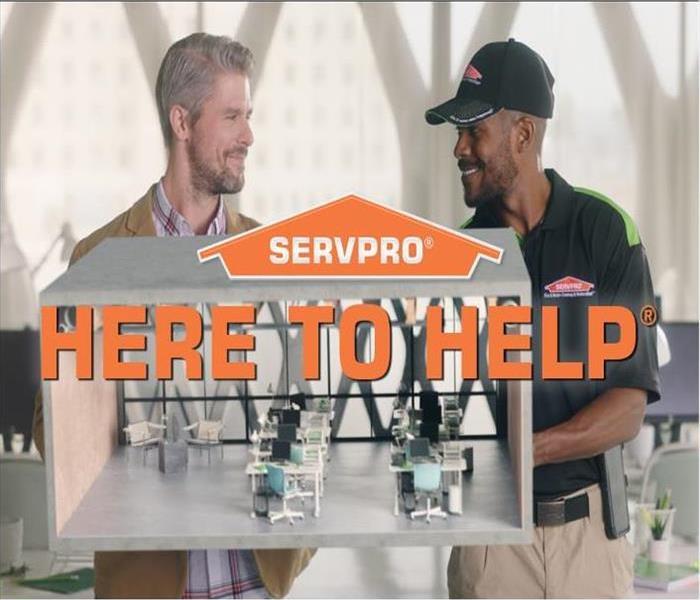
We at SERVPRO of Norwood / West Roxbury understand the severity of our current situation and the impact it has had to our lives. Our daily reality has been turned upside down and sideways. Parents and school administrations have united to ensure that our children remain safe and continue to learn outside of the classroom. The need for social distancing has forced communities, governments and businesses to make difficult, but necessary decisions. For businesses those decisions range from temporarily closing their doors to working virtually. However, there are essential businesses, like supermarkets, pharmacies, gas stations, where temporarily closing and working virtually are not options. It is paramount that employers in such businesses take the necessary steps to ensure both customer and employee safety. To help create safe environments OSHA has created guidelines for preparing workplaces for COVID-19. Along with information on COVID-19 itself and how an outbreak could affect the workplace OSHA has classified the levels of risk inherent to various jobs and the steps to take to protect your constituents. Click, here, to download a copy.
For more information on COVID-19 and how best to protect yourself and others around you visit the Centers for Disease Control website.
If your residential or commercial property needs preventative deep cleaning services, call the experts at SERVPRO of Norwood / West Roxbury today – (781) 769 - 9125
All of us here at SERVPRO of Norwood / West Roxbury want you and your loved ones to stay safe and know that we will make it through this together!
Viral Cleaning
3/20/2020 (Permalink)
All of us here at SERVPRO of Norwood / West Roxbury want you and your loved ones to stay safe and know that we will make it through this together! The easiest step we can all take at home and in the workplace is to properly sanitize the area. Did you know that while everything can be cleaned, the same does not hold true for disinfecting?
Cleaning/Sanitizing/Disinfecting
It is important to understand the different levels of cleaning that may or may not be possible for each surface. All surfaces can be cleaned, many surfaces can be sanitized, and some surfaces can be disinfected.
The three main levels of microbe control are:
- General surface cleaning – physically removes visible dirt, organic matter, viruses, fungi, and bacteria. General surface cleaning is accomplished with water, detergent, and physical scrubbing of the surface. The guiding principle is to remove microbes if possible, rather than kill them (with a sanitizer or disinfectant). In addition, thoroughly cleaning a surface can reduce the need to disinfect because without the nutrients and moisture needed to survive and multiply, most microbes cannot live on a clean and dry surface for very long.
- Sanitizing – reduces but does not necessarily eliminate all the bacteria on a treated surface. Sanitizers do not have claims for viruses or fungi. To be a registered sanitizer, the test results for a product must show a reduction of at least a. 99.9% in the number of each type of bacteria tested on non-food-contact surfaces. Examples of non-food-contact sanitizers include carpet sanitizers, air sanitizers, laundry additives, and in-tank toilet bowl sanitizers.
- Disinfecting – works by using chemicals to kill germs on surfaces. This process does not necessarily clean dirty surfaces or remove germs.v Disinfecting destroys or irreversibly inactivates infectious or other undesirable microbes, but not necessarily the spores of bacteria and fungi. The number of microbes killed during a disinfecting process will vary, depending on the specific chemical and how it is used.
For more information on COVID-19 and how best to protect yourself and others around you visit the Centers for Disease Control website.
Please be safe and vigilant in your cleaning efforts. Should you have any doubts regarding the safety of your residential or commercial property needs expert preventative deep cleaning services, call the experts at SERVPRO of Norwood / West Roxbury today – (781) 769 - 9125
Here To Help
3/19/2020 (Permalink)
These are difficult times we find ourselves in. The impacts to our clients and communities are unprecedented! The best course of action for us all to take is to be as informed as we can at this time. We at SERVPRO of Framingham plan on doing our part to keep our clients and communities informed.
According to the CDC, at this time, "The best way to prevent illness is to avoid being exposed to this virus." The CDC recommends the following steps to take to protect yourself;
- Wash your hands often with soap and water for at least 20 seconds especially after you have been in a public place, or after blowing your nose, coughing, or sneezing.
- If soap and water are not readily available, use a hand sanitizer that contains at least 60% alcohol. Cover all surfaces of your hands and rub them together until they feel dry.
- Avoid touching your eyes, nose, and mouth with unwashed hands.
For more information on COVID-19 and how best to protect yourself and others around you visit the Centers for Disease Control website.
All of us here at SERVPRO of Norwood / West Roxbury want you and your loved ones to stay safe and know that we will make it through this together!
Document Restoration
2/13/2020 (Permalink)
When fire damages your Dedham, MA commercial or residential property not only will the structure need remediation but so will the contents. That includes documents such as financial statements, books and photos. These items are not always lost, we can help. Document Restoration is another service SERVPRO of Norwood West Roxbury can provide.
The SERVPRO® Document Restoration Facility Offers:
- Innovation: we use the latest vacuum freeze-drying method, as well as gamma irradiation technology for sterilizing
- Secure: managed by HIPPA Master-certified technicians, under 24/7 surveillance
- Digital: we use a computerized inventory system for digitizing your documents
- Flexible capacity - we can accommodate large commercial losses or small residential jobs
- Full Service: we offer a range of services including drying, cleaning/disinfecting, re-jacketing, digitizing, and deodorization
When your commercial or residential property suffers fire damage call the experts at SERVPRO Norwood West Roxbury, 781-769-9125. We will make it, "Like it never even happened."
Yes Hardwood Flooring Can Be Dried
2/6/2020 (Permalink)
Hardwood floors used to be one of the hardest types of floor covering to dry once wet. The moisture would get trapped between the layers and under the hardwood boards, felt paper and sub-floor. Not too long ago the normal practice was to remove the hardwood floors.
SERVPRO of Foxborough has been very successful in drying sand-on-site hardwood floors with the use of the Dri-Eaz Rescue Mat System in conjunction with dehumidification. This system goes directly on the floors and pulls the moisture up from between the boards.
“The Dri-Eaz Rescue Mat System is used along with the Dri-Eaz DriForce high pressure blower to deliver effective drying to the full depth of water damaged wood floors, even to the sub-flooring. This system utilizes sturdy, self-sealing mats and the Dri-Force air mover to draw evaporated moisture from deep inside the material thru the surface, replacing it with drier air.” (source: Dri-Eaz Rescue Mat Manual)
The key to successful hardwood floor drying is to start the drying process as quickly as possible. This allows the moisture to be removed before the hardwood floors start to cup, crown or buckle. Even if you do notice slight cupping or buckling the rescue mat system may still be able to dry the floors and cause them to settle back down.
If the hardwood floors of your Walpole, MA home suffers water damage call the experts at SERVPRO of Foxborough, (781) 769-9125. We will make it, "Like it never even happened"
When You Call, We Respond
2/6/2020 (Permalink)
Damage of any kind to your Medfield, MA business; especially fire or water damage, can be stressful for owners, property managers, employees and tenants. Property damage, equipment damage, document loss and temporary business closure are just some of the concerns you may experience. Timely response and thorough mitigation can alleviate these concerns.
The first 24 hours can make the difference between restoring versus replacing your business property and belongings. SERVPRO of Norwood West Roxbury 1-4-8 Service Response Guidelines can prevent Fire/Water damage from creating long term problems.
1 - Within 1 hour from notice of loss, a SERVPRO of Norwood West Roxbury Professional contacts you to arrange for services.
4 - Within 4 hours of loss notification, a member of our Disaster Remediation Team will be on-site to start mitigation services.
8 - Within 8 business hours of on-site arrival, a verbal briefing of the scope is communicated to the appropriate person.
**Exceptions may apply under certain conditions, such as a local catastrophic event or storm situation.
If disaster strikes your commercial property call SERVPRO of Norwood West Roxbury today - 781-769-9125
Selling Your Home, Call Us
2/6/2020 (Permalink)
Are you selling your Dedham, MA home? Do you have realtors and inspectors coming in and checking things out?
We get calls from homeowners all the time that have had inspections done and realize they have a few things to take care of. Many times the caller doesn't know how to take care of these things, and that's when they call the professional staff at SERVPRO to get the job done!
SERVPRO of Norwood West Roxbury can help with things you may not have even thought about.
- Carpet cleaning
- General cleaning
- Mold inspections
Selling your home can be stressful, and our staff here at SERVPRO of Norwood West Roxbury want to set your mind at east. Let us help you with a few less things to worry about. Give us a call at 781-769-9125 and let us worry about it for you!
Is Your Shower Moldy
1/30/2020 (Permalink)
Finding mold in your shower can be upsetting. Moisture of any kind is a food source for mold, so it goes without reason that in most homes bathrooms and basements are where mold infestation begins. The good news is that you do not have to live with a moldy shower. In some cases, if the affected area is small, you can attempt mold cleanup yourself! To help, here are guidelines to follow for removing black mold from your shower.
Stay Safe
Safety should alway be your first priority when you decide to tackle removing mold in your West Roxbury, MA home. Wearing rubber gloves and old clothes is important. Also, proper ventilation is a must. Open a window and turn on the ceiling fan to keep the bathroom ventilated. When you are finished with the cleanup, take off your gloves and clothes and bag them. This will help to prevent the spreading any mold spores throughout other areas of your home. Throwing them away is the safest bet, but if you would like, washing your closes in a washing machine, with hot water should clean them.
Create a Cleaning Solution
There are plenty of cleaning solution options to choose from. You can buy mold removal cleaning products online or at your local hardware store. If you are concerned with using harsh chemicals in your home, white vinegar is an effective and non-toxic choice. Alternatively, you can also combine a gallon of water with a cup of Borax which is a powder laundry detergent easily found at most supermarkets. A bleach solution is an option too, but that can be dangerous and should only be used as a last resort.
Use the Solution
Pour the cleaning solution into a common household spray bottle. Spray the solution over the entire affected area and make sure to spray slightly beyond the visible infestation. Try to saturate the moldy area but not so much that any puddles are created. At this point you should be able to wipe away the mold and the cleaner using a cloth. If mold remains, try using a scrub brush to remove the remaining mold. If mold is stuck in the caulking or grout the best tool to use to remove the mold is an old toothbrush.
By following the above suggestions you can limit the mold damage and should be able to safely remove most mold infestations. However, if the problem persists or if the damage is significant, contact your local mold remediation and cleanup experts here at SERVPRO of Norwood West Roxbury. We will make it, "Like it never even happened."
#1. Opt for Flood Insurance
7/10/2019 (Permalink)
Hurricane Season has sprung! And it is also time for you to spring for Flood Insurance. You’ll be happy to make this wise investment, as we know that Flood Insurance is just a drop in the bucket compared to the money spent on Flood Damage.
Despite the size of your business or property and more so of where it is located, you could still be vulnerable to major water damage. Here are three quick tips for business and property owners to mitigate their risk.
Say Yes to Flood Insurance. More than 20% of flood claims occur outside the high-risk flood zones, according to the Federal Emergency Management Agency.
Understand the policy and your risks
Once you decide to obtain flood insurance, it’s important to understand what exactly you’re signing up for. As a first step, taking a look at the policy and understand what is covered and what is not.
Call SERVPRO of Norwood / West Roxbury. The longer you wait, the more likely there will be damage.
And certainly, don’t wait for insurance adjusters to arrive. Call SERVPRO of Norwood/West Roxbury, 7 days a week, 24 hours a day. We’ll take the proper and immediate action to restore your property “Like it never even happened.”
Blackstone Acquires Majority Stake in SERVPRO
6/18/2019 (Permalink)
Blackstone Group (BX +1.8%) emerges as the winner in an auction for SERVPRO Industries, and is close to acquiring the company for more than $1B including debt, the Wall Street Journal reports, citing people familiar with the matter.
SERVPRO, of Gallatin, Tenn., operates a network of more than 1,700 franchisees that specialize in fire, water, mold and other cleanup services for residential and commercial customers. The closely held company was founded in 1967 by Doris Isaacson and her late husband, Ted Isaacson, as a painting business and is currently run by their eldest child, Susan Steen.
Blackstone's long-dated private-equity fund, which can hold companies for up to 20 years, will execute the acquisition of the closely held company, which operates more than 1,700 franchisees specializing in fire, water, mold, and other cleaning services for residential and commercial companies.
Part of the rationale behind the deal is that Blackstone, which owns 232m square feet of office space and 300,000 residential units and homes, can become a major SERVPRO customer.
Coastal Flooding On The Rise
5/28/2019 (Permalink)
Many homeowners dream of waterfront property, the smell of salty sea air and to be greeted by the ocean when the wake up every morning. As idyllic as it may sound there is another side to living on the coast. During 2018 coastal communities experienced record number of high tide flooding. Sidewalks and streets were frequently flooded mainly due to El Nino conditions. The projected increase in high tide flooding in 2018 may be as much as 60 percent higher across U.S. coastlines as compared to typical flooding about 20 years ago, according to NOAA scientists. These predictions are part of NOAA’s 2017 State of High Tide Flooding and 2018 Outlook, a report produced by NOAA’s Center for Operational Oceanographic Products and Services every year since 2014.
The report finds that during the 2017 meteorological year (May 2017-April 2018), the U.S. average number of high tide flooding days was the highest measured at 98 NOAA tide gauges. More than a quarter of the coastal locations tied or broke their individual records for high tide flood days.
The top five cities that saw the highest number of flood days across the U.S. and broke records include Boston; Atlantic City, New Jersey; Sandy Hook, New Jersey; Sabine Pass, Texas; and Galveston, Texas. These cities faced the brunt of an active nor’easter and hurricane seasons and sea level rise, which has made these and other less extreme events more impactful.
SERVPRO of Norwood/West Roxbury specializes in Water Remediation, if you ever experience a flood or water damage call us 24/7 (781) 769-9125
Tornadoes Strike Even in Massachusetts
5/23/2019 (Permalink)
National Weather Service is warning of intense weather headed to Massachusetts,which could mean severe thunderstorms or even tornadoes.
In Boston, temperatures are expected to climbas high as the mid-80s on afternoon in late May and as a storm system makes its way across the state, the highest risk of extreme weather is expected to kick in at around 5 or 6 p.m., according to NWS meteorologist Lenore Correia. Short-lived but powerful storms, isolated thunderstorms and powerful winds, and hail sized up to an inch or two inches are more likely out in the west and northwestern parts of the state, the Weather Service says, but still possible closer to the city. The conditions may also be right for tornadoes to form.
“There’s a cold front approaching the area and we’re going to have a storm that will form along that boundary,”Correia says. “Really warm temperatures will help that instability.”
She says that the risk of tornadoes remains pretty remote, but it’s worth being alert regardless, especially if you commute by car or haveplans to be outside.
Safety in the Home
4/26/2019 (Permalink)
Keep your family safe from fire. Be aware of the hazards in your home. And, be sure to have an escape plan. Pull together everyone in your household and make a plan. Walk through your home and inspect all possible exits and escape routes
Burn awareness Most “fire-related injuries” are burns. Make sure kids stay more than 3 feet away from the stove. Most “fire-related injuries” are burns. In fact, approximately every 60 seconds someone in the U.S. sustains a burn injury serious enough to require treatment.*
Dryers and washing machines The leading cause of home clothes dryer and washer fires is failure to clean them.
- Clothes dryers accounted for 92% of the fires; washing machines 4%, and washer and dryer combinations accounted for 5%.
- The leading factor contributing to the ignition of home fires involving clothes dryers was failure to clean, accounting for one-third (33%) of dryer fires.
- A mechanical or electrical failure or malfunction was involved in the vast majority of home fires involving washing machines.
- Fires involving clothes dryers usually started with the ignition of something that was being dried or was a byproduct (such as lint) of drying, while washing machine fires usually involved the ignition of some part of the appliance.
Escape planning Learn the steps to create and practice a home fire escape plan. Fire can spread rapidly through your home, leaving you as little as one or two minutes to escape safely once the smoke alarm sounds. A closed door may slow the spread of smoke, heat and fire. Install smoke alarms in every sleeping room and outside each separate sleeping area. Install alarms on every level of the home. Pull together everyone in your household and make a plan. Walk through your home and inspect all possible exits and escape routes. Households with children should consider drawing a floor plan of your home, marking two ways out of each room, including windows and doors.
Gasoline & propane safety Always handle gasoline in the home or propane-powered equipment cautiously. Handle any propane-powered equipment cautiously and always follow the manufacturer's instructions.
- Cylinder tanks for equipment such as stoves and ovens must be located outside of the home.
- Keep gasoline out of children's sight and reach. Children should never handle gasoline.
- If fire does start while handling gasoline, do not attempt to extinguish the fire or stop the flow of gasoline. Leave the area immediately, and call for help.
- Do not use or store gasoline near possible ignition sources (i.e., electrical devices, oil- or gas-fired appliances, or any other device that contains a pilot flame or a spark).
Hoarding and fire safety Many fire departments are experiencing serious fires, injuries, and deaths as the result of compulsive hoarding behavior. The excessive accumulation of materials in homes poses a significant threat to firefighters fighting fires and responding to other emergencies in these homes and to residents and neighbors.
Commercial Fire Alarm Systems
3/22/2019 (Permalink)
Commercial properties are held to a high level of maintenance to ensure safety of all occupants. These buildings include:
- Office Buildings – including serviced offices.
- Industrial Buildings – warehouses, distribution centers and garages.
- Retail/Restaurants – includes shopping centers, leisure facilities and pubs.
- Other non-residential properties such as entertainment venues, hotels, nursing homes, medical and self-storage complexes, as well as many more
Legal requirements for commercial fire alarm systems
As you can imagine, there is a lot more legislation concerning the installation, placement, testing and maintenance to regulate fire alarms in commercial premises than in residential buildings. British Standards provide guidelines that should be complied with and failure to do so is seen as a breach of a responsibility towards safety and can be punishable by law.
Fire alarms systems play such a key safety role in commercial buildings and there are a lot of lives potentially at steak. If the fire alarm systems are not sufficient then harsh penalties can be given, including hefty fines and in the case of extreme negligence, this can even result in imprisonment if lives are lost as a result of an ineffective approach to fire safety.
In addition if a fire does occur on a commercial property, insurance policies may be voided if it can be proved that the fire alarm and smoke detectors were ineffective. Be sure to test your alarms!!
SERVice Above The Rest!
3/20/2019 (Permalink)
Effective training is the best way to help ensure your customers receive the service they deserve. We are trained to IICRC standards in Fire and Water Cleanup and Restoration. In addition, continuing education classes are available to Franchise Professionals and Insurance Clients at our state of the art IICRC Approved Training Facility.
Vendor Qualification Compliance and Professionalism
If you call SERVPRO, we will use only qualified vendors to service your customer. That commitment resulted in:
- A National Call Center to achieve prompt handling of the claim.
- Implementation of best practices and job process programs.
- National Accounts qualification criteria and annual compliance checks.
- Crew and vehicle standards.
- Insurance requirements.
- File documentation requirements.
- Quality assurance program.
Serving Adjusters and Their Clients
SERVPRO of Norwood/West Roxbury's job is to reassure the customer, perform quality service and to report to you quickly. We know your job is to interpret the policy and adjust the claim... and not to deal with problems from vendors! Working together we strive to save you time so you can focus on priority files, while having complete control of every loss you are assigned. 24-hour emergency response, damage mitigation, loss assessment, and an electronic file are available to you within hours. SERVPRO of Norwood/West Roxbury's documented, measured performance increases value to you and your shareholders, managers and customers.
Hard-earned results have made SERVPRO leaders in the fire and water cleanup and restoration industry. The SERVPRO System is geared to achieve customer satisfaction and mitigation results, adding to your company’s competitive advantage.
Why SERVPRO is the Restoration Company To Call
3/20/2019 (Permalink)
SERVPRO of Norwood/West Roxbury understands your situation. As an agent or adjuster, you have a responsibility to keep claims costs down while still providing the best services possible for your customers.
We are uniquely qualified to help. Our results create a measurable difference, giving you many competitive advantages.
Emergency Response to Claims
Restoring property is our first priority. Your customer will appreciate the immediate response and you will know everything is being done to limit the damage.
Pretesting Reduces Claims Expense
Restoring property is less expensive than replacing property. Claims Professionals know the rule is, "Restore whenever possible, replace only when necessary." SERVPRO of Newton/Wellesley makes sure pretesting is completed on every loss to determine restorability.
Claims Inventory Service
We can provide an itemized loss inventory. You will receive an Excel formatted report and pictures of important items.
Electronic Claims Information
Our Claims Information Center provides fast, accurate information you need to make sound decisions, including:
- A Complete Electronic Job File.
- First Notice of Loss.
- Detailed Estimate.
- Digital Loss Photos.
- Scanned Forms and Paperwork.
- All delivered by email or hard copy.
- On-line Access to All Files.
- New Assignments.
- Pending Jobs.
- Completed Jobs.
- Informative Reports to Improve Results
- Performance Comparison to Industry Standard.
Home Fire Sprinklers can Dramatically Reduce Heat, Flames, and Smoke
2/11/2019 (Permalink)
When properly installed and maintained, fire sprinklers help save lives.
Fire sprinklers have been around for more than a century, protecting commercial and industrial properties and public buildings. What many people don't realize is that the same life-saving technology is also available for homes, where roughly 80 percent of all civilian fire deaths occur.
The National Fire Protection Association’s (NFPA) Fire Sprinkler Initiative outlines proven, effective ways that home fire sprinkler advocates can communicate the impact of sprinklers to their decision makers. NFPA’s Fire Sprinkler Initiative highlights key research underscoring how fire sprinklers can reduce the risk of death or injury from fire. According to NFPA's "U.S. Experience with Sprinklers" report:
- the civilian death rate was 81 percent lower in homes with fire sprinklers than in homes without them
- the average firefighter injury rate was nearly 80 percent lower when fire sprinklers were present during fires
- when sprinklers were present, fires were kept to the room of origin 97 percent of the time
- the home fire death rate was 90 percent lower when fire sprinklers and hardwired smoke alarms were present. By comparison, this death rate is only 18 percent lower when battery-powered smoke alarms are present but automatic extinguishing systems weren't
SERVPRO - The Most Trusted Restoration Company with over 50 years of Expertise
2/1/2019 (Permalink)
Ted and Doris Isaacson launched SERVPRO in 1967 as a painting business in Sacramento, Calif. With a background in cleaning and restoration, however, Ted and Doris soon transformed the company into a franchisor of cleanup and restoration specialists.
After selling its first Franchise in 1969, SERVPRO continued to grow, acquiring the Bristol-Myers Domesticare Division and its 175 Franchises in 1979.
SERVPRO relocated the corporate headquarters from Sacramento to Gallatin, TN, in 1988 in a strategic move to place itself within 600 miles of 50% of the U.S. population.
At the time of the relocation, the SERVPRO System consisted of 647 Franchises.
SERVPRO Corporate quickly became a key contributor in its community, and in 1991 the Nashville Business Journal named SERVPRO the Small Business of the Year. In the meantime the company continued its impressive growth, selling the 1,000th Franchise in 2000. Learn more about our Awards and Recognition.
In 2005, SERVPRO moved to a 140,000 square-foot, state-of-the-art facility in Gallatin to provide more room for expansion.
With a proud history, a successful present and a bright future, SERVPRO will press on toward becoming the premier cleaning and restoration company in the world.
SERVPRO FRAMINGHAM NEWTON/WELLESLEY ACQUIRES NEW LOCATION IN WESTWOOD!
1/18/2019 (Permalink)
SERVPRO of Framingham, Newton/Wellesley has expanded resources available to you by acquiring SERVPRO of Norwood/West Roxbury. These combined franchises will now service towns as far west as Hopkinton and as far east towards the Dedham/Norwood region.
Dave Kurzontkowski, Licensed Contractor and former Insurance Agent and his wife Jill, purchased SERVPRO of Framingham in 2009 and subsequently SERVPRO of Newton Wellesley in 2015.
Dave and his team have earned an impeccable reputation in the area because of their excellent work ethic, congeniality and professionalism. This dedicated SERVPRO team is able to ease the stress and anxiety of customers experiencing difficult situations. A resident of Hopkinton commented after using SERVPRO of Framingham, Newton/Wellesley and Norwood/West Roxbury services, “I was truly impressed by their utmost professionalism, courtesy, and competency, and thoroughly cleaned up nicely after each job.“
The new location of SERVPRO of Norwood/WestRoxury, covers the towns of Norwood, Westwood, Dedham and West Roxbury.
SERVPRO has earned the title of trusted leader in the restoration industry with highly trained technicians committed to responding faster than any competitor to any size disaster, big or small. Offering 24-hour emergency service and providing the training and expertise to handle your immediate cleaning needs as well as the long term commitment to restore your property to a condition equivalent to “Like it never even happened.”®
Strategically located to be faster to getting to you when your need is greatest, SERVPRO also follows up with highly trained restoration technicians in advanced restoration, remodeling and renovation including custom carpentry.
SERVPRO Norwood/West Roxbury now offers Remodeling Services
1/17/2019 (Permalink)
It is hard to put into words what the reality is like when a homeowner or business owner experiences emotional devastation due to destruction of property by fire, invasive mold or flooding. Whether it happens to your home, the safe place that is the source of protection for your family or if it happens to the place that is the source of your livelihood, you are left feeling helpless and vulnerable. This unexpected trauma reaches you in stages, first you are in shock, second you attempt to make sense of the situation and think about possible solutions, and thirdly you call someone to assist you in the process of recovery. Making the right call to the right service that will see you through from start to finish without abandonment at any point in the process is critical to your future happiness and security. SERVPRO Norwood/West Roxburyis that service. If you call SERVPRO you will have made your first step toward complete recovery.
SERVPRO is now a one stop service, a company that offers restoration, renovation and complete rebuilding to reverse your devastating loss and to do so “Like it never even happened.” ®. When your needs are greatest, you want the most expertise full service company available locally and that is SERVPRO Norwood/West Roxbury.
There are additional benefits in choosing SERVPRO. One being that 95% of our work is dealing with renovations that entails insurance adjusters, insurance companies, and insurance agents.We welcome being the middleman because then we can ensure a smooth and continuous transition from the first moment of loss to the application of finishing touches. SERVPRO owner Dave Kurzontkowski is a Licensed Contractor, a former Insurance Agent, and an extremely knowledgeable restoration and renovation expert.
Our team of technicians, designers and construction crew are focused on every detail and will work with you, walking you through the entire collaborative process. Our quality craftsmanship and mastery will be displayed in your end product of a beautifully restored home or business so that you will feel “Like it never even happened.” ®
What To Do After A Flood
1/10/2019 (Permalink)
Floods can be caused by a variety of things and you will want to implement these practices to ensure the safety of you and your home, as well as having the best outcome with your insurance.
Avoid Risks
If you had to evacuate, make sure it is safe before you return. Check for any warping, cracked foundations, or other structural damage before entering the home. You may also want to speak to your utility companies to be sure it is safe from things such as electric or gas.
Health
The water that is now in your home could be contaminated by sewage. It is recommended that you wear waist high waders or waterproof boots that come waist high. Also, dispose of any food that comes in contact with the water.
Take Pictures
Before doing anything to your home after a flood be sure to take photos or videos of your home to prove the damage to your insurance company.
Contact your insurance provider
Make sure you have your insurance company's phone number in case you experience a flood. Let your insurance representative know the extent of the damage to your home and of any repairs you wish to make.
Clean Up
This is where SERVPRO steps in. We will help remove water from your house and afterwards mitigate mold so that there are no long lasting negative effect on you or your house.
What You Need To Know About Ice Dams
12/18/2018 (Permalink)
What is an ice dam?
An ice dam is a ridge of ice that forms at the edge of a roof and prevents melting snow (water) from draining off the roof. The water that backs up behind the dam can leak into a home and cause damage to walls, ceilings, insulation, and other areas. The image included in this blog entry shows a cross section of a home with an ice dam.
What causes ice dams?
There is a complex interaction among the amount of heat loss from a house, snow cover, and outside temperatures that leads to ice dam formation. For ice dams to form there must be snow on the roof, and, at the same time, higher portions of the roof's outside surface must be above 32°F while lower surfaces are below 32°F. For a portion of the roof to be below 32°F, outside temperatures must also be below 32°F. When we say temperatures above or below 32°F, we are talking about average temperature over sustained periods of time.
The snow on a roof surface that is above 32°F will melt. As water flows down the roof it reaches the portion of the roof that is below 32°F and freezes. Voila! - an ice dam.
The dam grows as it is fed by the melting snow above it, but it will limit itself to the portions of the roof that are on the average below 32°F. So the water above backs up behind the ice dam and remains a liquid. This water finds cracks and openings in the exterior roof covering and flows into the attic space. From the attic it could flow into exterior walls or through the ceiling insulation and stain the ceiling finish.
Remember: Nonuniform roof surface temperatures lead to ice dams.
How To Know If You Have Frozen Pipes
12/18/2018 (Permalink)
The winter months bring certain property maintenance concerns that we all need to be aware of. When the temperatures drop, one major issue that could come up is a frozen water pipe.
4 Signs of Frozen Pipes
There are a few clues which can help you determine if you have frozen pipes at your property:
- The Temperature Is Right- Pipes will not freeze if it is not cold enough outside for them to do so. Water does not freeze when it is 60 degrees Fahrenheit outside, and neither do pipes. When the temperature falls to 32 degrees Fahrenheit or lower, you should begin to take precautions to prevent vulnerable pipes from freezing.
- There Is Frost on the Pipe- For pipes that can actively be seen, such as those under sinks, you may be able to see frost that has accumulated on the exterior of the pipe. This can serve as a warning sign that the pipe is frozen before you ever try to turn on the faucet.
- No Water Is Coming Out of the Faucet- Is there a lack of running water. If you or a tenant turn on a kitchen or bathroom faucet and only a slight trickle of water or no water at all comes out, the water pipe leading to the faucet may be frozen.
- Strange Smells- Is there an odd smell coming from a faucet or drain. If the pipe is partially or completely blocked, the only way the odor can escape is back up in the direction of your property.
Holiday Safety
12/11/2018 (Permalink)
According to the National Fire Protection Agency U.S. fire departments responded to an estimated annual average of 200 Christmas tree related home fires during the holiday season. In total, the average annual property damage is over $14 million dollars! While such fires are uncommon they are more likely to result in civilian death. A death occurs in 3% of reported Christmas tree fires. By comparison a fatality occurs in only ½% of all other reported home fires. The reason for this discrepancy, Christmas tree fires usually star overnight when trees are left lit. Remember to turn your tree lights off before going to bed and if your tree is natural make sure to water it regularly and dispose of it shortly after the holidays.
We at SERVPRO Norwood / West Roxbury wish you and yours a happy and safe holiday season!
Holiday Fire Hazards
12/11/2018 (Permalink)
The more holiday lights the better, right? Weather we are talking about strands of our favorite Christmas lights or holiday scented candles, one quarter of reported Christmas tree fires the result of electrical problems or heat sources too close to the tree (according to the NFPA). Be sure not to overload outlets with multiple strands of lights and make sure that the electrical wiring is up to current electrical code standards. Also, check the wiring to ensure that there are no frays or loose connections.
If candles are the way you light up your holidays then follow these two important safety tips. Do not leave candles lit when going to bed or if no one is home. Additionally, keep them a safe distance from anything flammable.
We at SERVPRO Norwood / West Roxbury wish you and yours a happy and safe holiday season!
How To Prevent A Dryer Fire
12/11/2018 (Permalink)
Very few people realize the danger of clothes dryer fires. However, according to the U.S. Consumer Product Safety Commission, there are an estimated annual 15,500 fires, 10 deaths and 10 injuries due to clothes dryer fires. Several hundred people a year are also subjected to carbon monoxide poisoning from improper dryer vent setups. The financial costs come to nearly $100,000,000 per year. In some cases faulty appliances are to blame, but many fires can be prevented with proper dryer venting. Lint accumulation and reduced airflow feed on each other to provide conditions ripe for a fire. Lint is a highly combustible material, which, interestingly enough, is one of the ingredients in a recipe for home-made fire starters. A number of dryer vent problems contribute to this.
Here are several important steps you can take to keep this from happening to you
Clean your lint screen.Always clean your lint screen right before you push the start button for EVERY LOAD! Even if there is just a small amount of lint on the screen, clean it anyway. This is a good habit to get into.
Check your vent hose.Make sure your vent hose is in good shape. If you have the white plastic vent hose, replace it now! It is not safe and has been outlawed. Use the aluminum type vent hose and make sure the length is as short as possible and not crushed or kinked.
Clean your vent line regularly.It's very important that the vent line (from the wall behind the dryer to the outside flap) is not restricted or clogged up with lint. This greatly increases your chance of a dryer fire. If you are unable to clean out this line yourself, call a professional. Many Chimney Sweep companies offer this service.
Keep the area around the dryer clean.In the event that your dryer does have a lint fire, don't give it more fuel to destroy your home. Make sure there are no articles of clothing, boxes, cleaning supplies, or anything else behind or around the dryer. You should also keep things off the top of the dryer.
Clean the lint out of the inside of the dryer regularly.Your dryer needs to be opened up and vacuumed out periodically. Most dryers today are not easily accessible for the homeowner. Unless you know how to take your dryer apart and put it back together, you'll need a technician to do this. Any time you have your dryer repaired, ask the technician to vacuum it out for you. He should be doing this anyway as part of the service.
Make sure your gas line is in good shape.If you have a gas dryer you should check your gas line. If it looks old or questionable, you should replace it. Make sure when you push your dryer back into position, you don't kink the line.
Chemicals Released During Fires
10/12/2018 (Permalink)
Some of the biggest issues associated with fire damage do not come directly from the flames. The heat and water vapor from combustion can cause severe damage. There is also the smoke and soot from the fire that can cause lasting problems to your home. They contain toxic chemicals and also have a smell that lasts.
Plastics and other synthetic materials can leave behind harmful chemicals that are dangerous to inhale. Wood smoke is usually the largest contributor to smoke in the building. It contains methane, carbon monoxide, benzene, sulfur dioxide, formaldehyde, formic acid, acetic acid, and traces of heavy metals. This combination of chemicals is quite hazardous and can cause major problems for anyone who inhales or comes in contact with the smoke or residue left behind. The smoke and soot can cover almost every surface in the house even in places that were not directly adjacent to the fire, traveling either through air vents or wall cavities.
Removing smoke and sot requires the proper machinery and expertise. Here at SERVPRO of Norwood/West Roxbury we have all of the machinery and expertise you would need. Our certified professionals have been working with people in need of help for years.
It may seem like life will never be the same following a disastrous fire. With the help of our technicians we can get you back on track. Let us make it "Like it never even happened."
Flooded Basements
9/25/2018 (Permalink)
Has your basement suffered water damage as a result of the recent storms? When basements flood the water must be removed immediately before damaging the structure of the property. The MegaX Flood Removal Extractor is the perfect tool for excessive water removal. The unit’s two inch intake valve allows for maximum water extraction. The MegaX has dual motors that offer unparalleled vacuuming performance and an auto discharge of 46 gallons per minute! Not only is the MegaX powerfully fast it is also unbelievably quiet too which allows for water removal in areas where noise is not an option. Call our disaster recovery team today to learn more about the MegaX Flood Removal Extractor and how we can properly remediate water damage in your residential or commercial property.
Larg Loss
6/21/2018 (Permalink)
Most commercial property owners have a facilities management team in-house. Some larger organizations may even have disaster remediation equipment, pumps, air movers, dehumidifiers to name a few, on site as well. When disaster strikes they are equipped to respond in a timely fashion. What happens when the disaster exceeds the capabilities of those internal resources? That is when you call us, SERVPRO Norwood West Roxbury. We have access to both the certified technicians and state-of-the-art equipment to handle any size disaster. Our Emergency Team is on call 24 hours a day which makes us faster to any size disaster. Any building, any disaster – we have everything needed to make it "Like it never even happened." all under one roof! Call our Emergency Response Team today.
Norwood – 781-769-9125
West Roxbury – 617-323-3677
What Is Mold?
6/5/2018 (Permalink)
What is mold? Mold is a fungus that grows in the form of multicellular filaments called hyphae.. This means that, like you and I, mold is a living organism. Mold spores are microscopic in size and, believe it or not, they exist naturally everywhere. Removing all traces of mold from a home or business is impossible. In actuality, mold testing is not done to determine if mold exists, but rather, to determine if elevated levels of mold exists. Proper mold testing consists of comparing indoor air quality to the air quality of the surrounding external environment.
Three conditions must exist for mold to cultivate. The first would be the availability of food. Any organic, carbon based, porous material is the only source of food mold spores require. The second would be having an appropriate temperature. Contrary to popular belief, mold can grow in any temperature above freezing, for example have you ever found moldy food in your refrigerator? The ideal temperature for mold to grow is in between 59° F – 86° F. Lastly having a considerable amount of moisture is a condition necessary that supports mold. It does not take long either; when all three conditions exist mold infestation can begin in less than 48 hours! The good news is that eliminating any one of these three conditions will ensure be mold free environment.
The not-so-good news is unfortunately, ninety percent of building materials used can serve as food for mold. Temperatures in New England during late spring and summer months are perfect for mold growth. Lastly, leaky roofs, improper bathroom ventilation, or poorly installed finished basements are just a few of the many issues that will cause the increased levels of moisture needed to stimulate mold growth. We cannot change the materials used to build our homes or the temperatures outside but we can control moisture. The good news is as humans we actually prefer humidity levels that are well below the critical relative humidity necessary for mold growth. That means, in most situations, the simple purchase of a dehumidifier is all the protection needed to mitigate mold growth.
But, what happens when disaster strikes and a simple dehumidifier is not enough? Up next – Why Call SERVPRO.
SERVPRO Mold Remediation
6/5/2018 (Permalink)
When approaching mold clean up a lot of people wonder which method is best, “Dry Blast” vs “Sand Blast”, The answer is neither , the reality in today’s world is this is unnecessary because; dry ice is costly, it only removes surface mold, and porous materials require a deep cleaning. SERVPRO technicians use anti-fungal and anti-microbial treatments that kill mold colonies and help prevent new colonies from forming
When tackling mold we make it a priority to set up containment. All remediation companies will set up containment, but when and how is the issue. We set up containment prior to applying the “eyeball test”. Which is as follows
- The “Eyeball Test” – Assessing the Environment
- Has there been a previous water damage
- Do you smell musty odors of mold
- Do you see areas of mold contamination
- Our competitors cut 4 x 8 holes in the wall from the ground up
- We cut a 2 x 4 in the center of the wall
Got Mold?
6/5/2018 (Permalink)
Do you think that you may have mold in your home or place of business? While mold spores exist naturally everywhere high levels in contained spaces can cause serious health issues. Mold spores are airborne particles which can be eliminated by creating a negative air chamber. One piece of equipment that we often use is the DefenderAir HEPA 500 is ideal for handling indoor air-quality needs on every restoration job. This unit address these air-quality issues quickly and effectively, helping you to maintain a clean indoor environment. The DefendAir has an efficiency rating of 99.97% against 0.3-micron oily aerosol particles and meets first-pass filtration requirements for even the most sensitive jobs. If you think that you may have an infestation of mold give our Disaster Recovery Team a call today!
Are You Ready For Disaster To Strike
6/5/2018 (Permalink)

How many of you here have insurance? How many of you have insurance for your business in the form of a disaster recovery plan? The Emergency Ready Profile, or the ERP, is a FREE, no-strings-attached centralized repository for critical facilities information. A well rounded business contingency plan is comprised of three components: incident response, disaster recovery and business continuity. The ERP encompasses two of those components, incident response and disaster recovery and grants us insight to the potential size and scope of a project prior to arriving on sight. The benefits of an ERP are a decrease in both response and recovery time – saving our customers money! Moreover, SERVPRO has partnered with the Red Cross and their Read Rating Program; a comprehensive assessment will help you to put all of your preparedness 'ducks' in a row. The information contained in our ERP can be used to create your baseline assessment. You never know when disaster will strike. Call us for you FREE consultation today!
Recognizing Mold
6/5/2018 (Permalink)
How to Recognize Mold:
- Sight – They usually appear as distinctly colored woolly mats (e.g., mildew is black and is one of the most common molds in a household).
- Smell – They often produce a foul odor, such as a musty, earthy smell.
The key to mold prevention is moisture control. Mold will not grow if moisture is absent.
- Remove excess standing moisture with a wet-dry vacuum and remove the any excess humidity with a dehumidifier
- Use fans to assist in the drying process.
- Clean wet materials and surfaces with detergent and water.
- Discard all water damaged materials and all materials visibly contaminated with mold.
- Remove and discard all porous materials that have been wet for more than 48 hours such as:
- Carpeting and carpet padding
- Upholstery, wallpaper, drywall
- Floor and ceiling tiles, insulation materials
- Clothing
Water Main Runoff
6/5/2018 (Permalink)

What would you do if a water main burst and covered over 30,000 square feet of your warehouse with almost an inch of water? You would want someone to arrive onsite fast and remediate the entire problem, not just the visible water, but also the excess moisture that could ruin a product line with mold and mildew. That is exactly what happened to a local sporting apparel manufacturer. From Air Movers to Dehumidifiers, Generators to Power Distribution Boxes we have access to a wide array of water remediation equipment and the certified technicians to get the COMPLETE job done right! We began the drying process in the middle of the week and completed it by the very next weekend. All of our equipment was removed over that weekend and the warehouse space was ready to receive deliveries that very next Monday morning. How are we able to accomplish this, we offer our commercial clients flat rate pricing which allows our technicians to take whatever steps necessary to expedite the drying process with minimal disruption to business operations. Does your commercial property need remediation services? Call our disaster recovery team today!
Are You Ready For Disaster To Strike
6/5/2018 (Permalink)

How many of you here have insurance? How many of you have insurance for your business in the form of a disaster recovery plan? The Emergency Ready Profile, or the ERP, is a FREE, no-strings-attached centralized repository for critical facilities information. A well rounded business contingency plan is comprised of three components: incident response, disaster recovery and business continuity. The ERP encompasses two of those components, incident response and disaster recovery and grants us insight to the potential size and scope of a project prior to arriving on sight. The benefits of an ERP are a decrease in both response and recovery time – saving our customers money! Moreover, SERVPRO has partnered with the Red Cross and their Read Rating Program; a comprehensive assessment will help you to put all of your preparedness 'ducks' in a row. The information contained in our ERP can be used to create your baseline assessment. You never know when disaster will strike. Call us for you FREE consultation today!
Large Water Loss
6/5/2018 (Permalink)
April showers bring May flowers. They also bring flooded basements. When basements flood the water must be removed immediately before damaging the structure of the property. The MegaX Flood Removal Extractor is the perfect tool for excessive water removal. The unit’s two inch intake valve allows for maximum water extraction. The MegaX has dual motors that offer unparalleled vacuuming performance and an auto discharge of 46 gallons per minute! Not only is the MegaX powerfully fast it is also unbelievably quiet too which allows for water removal in areas where noise is not an option. Call our disaster recovery team today to learn more about the MegaX Flood Removal Extractor and how we can properly remediate water damage in your residential or commercial property.
Structural Drying In Tight Spaces
6/5/2018 (Permalink)
Drying a structure requires more than simply removing the visible water. Elevated levels of moisture in the air can lead to mold infestation. Circulating air reduces escalated moisture levels. The Air Max is unlike traditional, “whistle”, air movers. This rugged unit has 3 airflow positions – horizontal, vertical, and side allowing for maximum air flow and the most complete structural drying possible. Combined with its vented bottom housing, the trying capacity of the Air Max is unparalleled! In addition, its small footprint allows us to install the Air Max virtually anywhere and the non-marking, anti-skid rubber feet help us to leave no trace left behind. Call our disaster recovery team today to learn more about the Air Max and how we can properly remediate water damage in your residential or commercial property.
Water Damage From Rain
6/5/2018 (Permalink)
April showers bring May Flowers. Unfortunately, those same showers also may bring flooded basements. Immediate action is crucial when dealing with water damage. Luckily, SERVPRO franchises are strategically located to allow our technicians to arrive faster to any size disaster. As a leader in the water remediation industry our technicians receive advanced structural drying training and IICRC certification. Furthermore, we document our entire drying process in order to validate that all moisture, visible and hidden, has been removed and that the structure is completely dry. Generally basements are areas of high moisture, as such any amount of additional standing water exponentially increases the risk of mold infestation. Do not let water wreak havoc to your home or place of business. Call our Disaster Recovery Team today!
Norwood: 781-769-9125
West Roxbury:617-323-3667
Warm Weather Alert
1/10/2018 (Permalink)
WARM WEATHER ADVISORY
The deep freeze is over and the temperature outside is on the rise. On Friday we will see temperatures in the mid 50's here in the Greater Boston Area! Great news, right? Wrong! With temperatures rising so fast that means that all of the snow and ice that has accumulated over the past two weeks will melt equally as fast. As water tables rise the excess water will have no place to go causing basements to flood. If ice dams have formed on your roof, as the snow melts, water will back up behind the dam and may find cracks and openings in the exterior roof covering. Before you know it, water is wreaking havoc in your home.
If disaster strikes your home or commercial property call our Disaster Recovery Team. We will make it Like it never even happened.
Norwood - 781-769-9125
West Roxbury - 617-323-367
Weather Alert
1/2/2018 (Permalink)
Winter Weather Alert
The temperatures outside in New England are devastating. Now it looks like we may add snow and strong winds to the mix! The Eastern Seaboard will likely experience 4-8 inches of snow and strong winds this Thursday (Jan 4, 2018) the magnitude of both those impacts is still a bit uncertain at this time.
Timing
Thursday-Thursday night
- The powerful storm will be centered well off the Northeast coast. Given its large circulation and strong intensity, the low will likely produce at least some snowfall, possibly heavy, in parts of the Northeast region.
- Snowfall may cover much of New England during the day.
- Due to the strong winds this will be a fast moving storm. The peak snowfall intensity will likely only last for about 6 hours, between noon and 6 p.m.
- Increasing winds are likely along much of the Northeast coast. Wind gusts stronger than 50 mph are possible along the immediate coasts of New England Thursday night.
Snow Potential
- The best chance for significant accumulating snow along the U.S. coast is in eastern New England. This snow may be heavy and accompanied by strong winds.
- Again, exact amounts will depend on the track of the low in relation to the East Coast.
- Some locations may experience heavy snow that may change to freezing rain in Thursday night into Friday.
Odor Remediation - Deodorization Procedures
12/6/2017 (Permalink)
Successful deodorization requires neutralization all odor particles. Deodorization is an integral part of restoration and requires professionals trained in all facets of restoration and odor neutralization procedures. Deodorization would be simple if all odors came from one source and one deodorization method could eliminate all of them. Unfortunately, all odors do not come from one source. Restoration professionals deal with some unique odor problems— things you have never heard of or dealt with before. The odor control technician needs to employ multiple methods of deodorization to deal with the many, various odors.
There are four basic deodorization procedures which must be followed.
- Remove the source of the odor.
- Clean surfaces with odor-causing residues on them.
- Recreate the conditions that caused odor penetration.
- Seal surfaces exposed to malodors.
Remove the Odor Source
Simply attempting to deodorize the source with a masking agent will help to cover up any unwanted odors, however, that is all masking agents will do. For example, if the source of odor is a dead animal in a crawl space, you would not think of leaving the animal in place and trying to deodorize by spraying, fogging, or cleaning. In the same way, in a building that is damaged by a fire, you should remove charred structural materials before deodorizing. Debris that is contaminated with smoke residues can continue to give off smoke odors or soils if not removed. The universal first step in deodorization is to identify the source of the odor and remove the source. Taking this initial step will help lessen the amount of odor in the building. Other procedures will be needed, of course, to get rid of all the odors.
Clean Surfaces
Clean surfaces that have odor-causing residues on them. Small particles of odor-producing residue will continue to generate odors if not cleaned effectively. For example, in a grease fire you may need to clean significant concentrations of residue from the stove, countertops, vent hood, vent filter, cabinets, walls, ceilings, etc., to stop odor problems. Check all rooms— not just the kitchen —
to see how far odors have penetrated. Sometimes the entire structure and its contents may need to be cleaned to remove smoke odors.
Recreate the Conditions
No, we are not attempting to "recreate" the conditions that caused the unwanted odor. What we are referring to is the importance of how the neutralizing agent is applied. In other words, to be effective, deodorizers must be applied to the affected surface in a manner similar to the way the odor-causing substances penetrated that surface. For example, if smoke created the problem, a deodorizing “smoke” or fog will be most effective in following odors to their source. If urine contaminated an area, then “flood” affected areas with deodorizers (sanitizers, neutralizers, and digesters).
Also, odors can be distributed in more than one way. For example, decaying flesh produces fumes and gases, which are distributed on air currents to surfaces not in direct contact with the source. This situation may require multiple methods of deodorization. Directly saturate any areas that were physically contacted by the source. Fog other areas to seek out odor vapors that have penetrated surfaces.
Seal Surfaces
The final step of the deodorization process is to properly seal the surfaces that have been exposed to malodors. This step is not required in all circumstances, but may be called for in severe situations. If odor removal would be too expensive or impractical, sealing might eliminate the problem. Two common sealing situations are painting walls and sealing inaccessible duct surfaces in air handling systems.
Next I will touch on the many types of neutralizing agents and the different effects each have on malodors.
Odor Neutralization Agents And Techniques
12/6/2017 (Permalink)
As we have discussed previously there are many kinds and types of malodors. As such, there are many types of neutralizing agents and techniques to use to counteract malodors – each of which affect malodors in different ways.
Here is a list of various deodorants and deodorizing actions;
- Masking agents
- Pairing agents
- Filtration agents
- Disinfectants and sanitizers
- Enzymes
- Air purification
- Oxidation
Masking Agents
Masking agents are not a primary deodorizer for a real odor situation because they do not eliminate odors. Instead, masking agents cover malodors with a more pleasant odor. Usually masking agents are packed in a time-release form, such as beads, wicks, gels, blocks, or solid cakes, so they generate pleasant-smelling vapors for long periods of time. This slow release of deodorant vapors makes masking agents a good weapon against imaginary odors.
Pairing Agents
Pairing agents are chemicals that combine with (or pair with) odor particles. Most deodorants used for fire restoration contain both masking agents and pairing agents. Two different types of pairing agents affect odor particles in different ways:
- Humectant — A highly absorptive material that combines with airborne odor particles and causes them to precipitate onto surfaces where they can be cleaned up. Wet fogging uses this process.
- Counteractant — A neutralizer that combines chemically with odor particles and changes the chemical properties of the odor molecule or destroys odor-causing bacteria. Thermal fogging works in this manner.
Filtration Agents
Filtration agents collect odors in one of two ways - Absorption or Adsorption.
- Absorption agents primarily absorb moisture and odors into the deodorizing agent. This absorbing action occurs when baking soda is placed in a refrigerator to pick up odors. One type of absorption agent is a powder composed of highly absorptive compounds, inert fillers, and perfume. These powders are not very effective because they mostly absorb humidity and oils and do not attack the real odor problem. They are sprinkled on carpets, but can build up in carpets and damage fibers.
- Adsorption agents work by capturing odor gases from the air and holding them on the surface of the agent. These processes are used to filter odor gases from air passing by or through the filtration agent. Activated charcoal is a type of adsorption agent often used in air filtration systems.
Disinfectants and Sanitizers
Growing bacteria and fungi create odors by producing gases. Disinfecting or killing these odor- causing organisms is a form of deodorization. Some chemicals are classified as disinfectants or sanitizers. In the restoration industry these terms have specific technical meanings:
- Disinfectants are stronger than sanitizers.
- The suffix – "stat" means “to control or limit.” A fungistat controls the growth of fungi such as molds.
- The suffix – "cide" means “to kill.” A fungicide stops the growth of fungi, killing the organism.
Some common disinfectants are pine oil, alcohol, bleach, phenolic disinfectants, and quaternary ammonia solutions. These agents are usually combined with a pleasant fragrance. The disinfectants kill the odor causing bacteria and fungi and the fragrance handles the psychological odors.
Enzyme Digesters
Enzyme digesters work effectively on organic or protein materials. Unlike chemical deodorizers, enzymes break down organic odor molecules into substances without odor. The enzyme deodorizer breaks down odor molecules into carbon dioxide (CO2), water (H2O), and water soluble by-products, and these substances dissipate rapidly into the air. The odor is “eradicated.” Enzymes also break down insoluble protein molecules into simple, soluble substances, which can be absorbed by the bacteria and digested.
Air Purification
Purifying the air is a means of removing odors from indoor air.
- Electronic filters use an electrically charged grid to kill airborne microorganisms as they pass through the filter.
- Air scrubbers pull air through charcoal filters, capturing odors onto a filter and recirculating the filtered air back into the indoor environment.
- Ventilation fans exchange indoor and outdoor air, exhausting odors outside and drawing fresh air indoors from outside.
Oxidation
Oxidation occurs when a substance combines with oxygen. Ozone generators produce ozone gas (O3), which permanently destroys odor through an oxidation process. Ozone gas is an unstable oxygen molecule composed of three oxygen atoms. When this unstable molecule comes in contact with an odor particle, the extra oxygen atom combines with the odor particle and oxidizes it. There are, unfortunately, safety concerns to consider prior to performing any oxidation procedure. Like most “chemical” products, ozone can be hazardous, but if used properly this method of deodorization is as safe as other available methods. Safety precautions must be taken when deodorizing with ozone. Use activated oxygen only in unoccupied areas. Ozone is toxic when high concentrations are inhaled, so remove all people and pets from the areas to be ozoned. Ozone Warning signs should be placed at all entries prior to performing activated oxygen procedures. Only certified technicians should enter the oxidized area until it has been determined to be safe by the technician.
Next I will share with you the various types of equipment our technicians have at their disposal.
Odor Neutralization Equipment
12/6/2017 (Permalink)
Effective deodorization often requires a combination of multiple deodorization techniques. The same deodorizing product or the same deodorizing process will not solve all odor problems. Some odors will require fogging, some direct spraying, some activated oxygen, etc. The deodorization technician uses a variety of equipment, depending on the odor situation.
Highlighted below are the various equipment at our technician’s disposal along with a brief description of how and why our technicians would use them.
Pressure Sprayer / Electric Sprayer
Hand pump-up sprayers or powered sprayers can dispense chemicals at about 50 psi (pounds per square inch) of pressure. They are used to spray applications directly onto surfaces being deodorized. The most common applications for direct spraying in smoke deodorization are on heavily charred structural components or on fabrics and carpets. Since direct spraying wets the surface being treated, only use this method in situations where discoloration is unlikely or of no consequence.
Ventilation Box Fan
Ventilation box fans generate airflow of great velocity, from 3,000 to 5,000 cubic feet of air per minute (cfm). Moving large volumes of air is useful for ventilating odors, fumes, and vapors from a structure. Box fans perform various deodorizing functions. When odors are heavy in a structure, a restorer may use the box fans to flush as much of the odors from the building as possible. After this initial ventilation, the restorer will use other methods to deal with remaining odors. Box fans are commonly used to ventilate a structure after thermal fogging. The air in a structure which has been thermal fogged for deodorization should be exchanged to ensure all vapors and residues of the deodorizing product are removed. Air is exchanged by ventilating indoor air to the outside and drawing outside air into the structure. The box fans help exchange outdoor air for indoor air.
Fogging Equipment
Fogging is a common deodorization process. A deodorizing product is dispensed as extremely small particles in a mist. The fogging process produces particles small enough to penetrate surfaces where odor particles are giving off odor. There are two distinctly different fogging procedures – Dry and Wet Fogging.
Dry Fogging — the Thermal Fogger
Thermal foggers vaporize solvent-based or petroleum-based deodorizers, generating a “smoke” or fog consisting of very small particles. The droplets generated by the thermal fogger range in size from as small as one-half micron to larger particles up to 25 microns, approximating the size of odor molecules. The droplets make a smoke, physically similar to the smoke produced in a fire, enabling the deodorizer to interact more effectively with odor-causing residues. Thermal fogging products are a blend of strong fragrances, odor counteractants, and solvents. They counteract odor-causing residues and eliminate odors rather than just masking them.
Wet Fogging — the ULV Fogger
ULV stands for Ultra Low Volume. The ULV fogger atomizes liquid deodorizing agents, primarily water-based agents, producing a fine mist. These foggers generate deodorant particles of approximately 10 to 60 microns in size, small enough to penetrate into most areas where odor-causing residues accumulate. The ULV fogger dispenses water-based deodorizing products and so is referred to as “wet” fogging and would be used to neutralize “wet” malodors like pet urine.
Oxidation Equipment
Sometimes odor molecules are eliminated by combining them with oxygen molecules. Oxidizing is the process of a substance combining with oxygen. There are two distinctly different oxidizing machines at our technicians’ disposal – An Ozone generator and a Photocatalytic oxidizer.
Ozone Machine
The ozone machine generates ozone, or unstable oxygen molecules (containing three oxygen atoms). Ozone is also known as activated oxygen because it chemically reacts with odor-causing molecules to oxidize residues (become combined chemically with the extra oxygen molecules) and remove the odors. The portable ozone machine eliminates a variety of odors caused by animals, cigarette smoke, mold and mildew, or fire and water damages. Ozone can be toxic to. All people, pets, and live plants should vacate the environment during ozoning. {NOTE: I will share ozone safety procedures in my next blog, “Safety during Deodorization Procedures”}
Photocatalytic Oxidizer
This machine is called a photocatalytic oxidizer. Inside the machine is an Ultraviolet (UV) bulb coated with titanium dioxide. The machine produces Hydroxyl Radicals. A radical is a group of atoms, and a Hydroxyl Radical is a group with an oxygen atom and hydrogen atom (the symbol is *OH).
The photocatalytic oxidizer machine oxidizes odors like ozone, but the process is safer for occupied structures. Deodorizing with the photocatalytic oxidizer does not fill a room like ozone machines do. Deodorization takes place inside the machine.
Air Scrubber
An air scrubber can remove airborne particles, as well as odors and gases, from the air. The device draws dirty indoor air into the machine, then pulls the air through a series of filters, capturing particles, gases, and odors on the filters, and then exhausts clean air back into the environment. The machine holds different types of filters:
- HEPA filters capture tiny, extremely small particles—as small as .3 microns.
- The activated carbon and potassium permanganate filter removes a wide range of gases and odors by attracting odor molecules to the filter through adsorption.
Injection
Neutralizing agents are injected into a material using a syringe and a needle or a pump and needle. The injection technique is used when the affected area is small or the surface area is delicate. Also, when the surface material cannot be removed for proper application of neutralizing agents the injection technique may be utilized. An example of when the injection method might be considered is when the procedure of detaching carpet from the tack strip and rolling the carpet back is not practical.
In many deodorizing situations our technicians use multiple procedures to produce the desired results. Combining multiple techniques can produce effective deodorization, but you do not always need to use multiple techniques. As previously mentioned the universal first step of any odor situation is to remove the source causing the odor. The second basic step is to clean the area of residues. After completing these first steps, our technician may find that the malodor has been properly neutralized and that no additional steps need to be performed. Regardless of the severity of the situation, our clients may rest assured that all necessary steps, and only those steps that are necessary, will be taken to ensure proper malodor neutralization.
Next I touch on important odor remediation safety equipment and procedures.
Deodorization Safety Procedures
12/6/2017 (Permalink)
Safety during Deodorization Procedures
The cleaning and restoration industry is always concerned about safety and health hazards. OSHA—the Occupational Safety and Health Administration—regulates safety in the workplace. Our technicians are OSHA 10 certified. That means that they are trained in the recognition, avoidance, abatement and prevention of safety and health hazards on the job site. There are two methods of deodorization, thermal fogging and ozone, which bring with them significant safety issues. Both methods work by putting substances into the air that could be irritating to humans if breathed. Fortunately, when proper precautions have been taken, deodorizing with either method can be performed safely and effectively.
Safety with Thermal Fogging
Thermal fogging usually dispenses solvent-based deodorants. Heating and combusting the deodorizing product breaks it down into extremely small particles. Safety precautions are needed to prevent an incident. One potential hazard is the flammable nature of deodorizing products used for thermal fogging. Another risk may be physical reactions of people exposed to the fog.
Our technicians post "Thermal Fogging In Progress" signs or warning notices in easy-to-see areas at all points of entry. The sign may state a time limit for people to wait before re-entering the building or treated area. Our technicians will notify the local fire department and the security monitoring company (if the building has a security system) of the thermal fogging operation. The notification will avoid false alarm calls, because the thermal fog looks like smoke, and uninformed third parties may report the smoke to authorities.
Setup Procedures for Safety
SERVPRO technicians complete several setup tasks before starting the thermal fogging procedure. Setup involves extinguishing pilot lights on appliances such as wood stoves, gas logs, fireplaces, gas ranges, water heaters, and furnaces. The fogging agent can reach a flammable point when exposed to an open flame. We will also disconnect any electrical device that could cause a spark. All people and pets must be vacated from the area to be fogged. Our technicians wear personal protective equipment, including a respirator with organic vapor cartridges, goggles, and chemical resistant gloves. Upon completion the treated area will be thoroughly ventilated to remove odors and fumes before people and pets will be allowed back into occupants the treated area. This can be done by opening doors and windows and setting up exhaust fans and/or high velocity air movers to turn over the air in the treated area. Occupants should not re-enter the building until they are given clearance by our project manager.
Safety Precautions for Ozone
Ozone is a toxic gas and therefore it can be hazardous, but when used properly and following all safety precautions this method of deodorization is as safe as other available methods. Ozone will only be applied in unoccupied areas. All people and pets must be vacated from the areas to be ozoned. Ozone Warning signs will be posted at all entries prior to performing ozone deodorizing procedures. Technicians working around ozone wear personal protective equipment including goggles, chemical resistant gloves, and a NIOSH-approved respirator with an organic vapor cartridge. The treated area must be properly ventilated after ozoning is completed. Unlike thermal fogging Ozone dissipates completely within minutes and leaves no residue. Ventilate the treated area for at least 30 minutes after ozoning completion to address any lingering ozone. It is safe to re-enter treated areas 1 (one) hour after the ozone generation has stopped.
5 Guiding Principles Of Drying
12/6/2017 (Permalink)
The IICRC (Institute of Inspection, Cleaning and Restoration Certification) is an independent, certification body that sets and promotes high standards and ethics within the inspection, cleaning, restoration and installation industry. It is regarded as the international industry standard to be used by restoration companies. One of the standards they have set, which has been accredited by ANSI (American National Standards Institute), is the S500 Water Damage Restoration Standard. This standard identifies five guiding principles for remediation companies to follow when drying and restoring wet building materials and its contents. These principles are:
- Safety of workers and occupants
- Documentation of conditions and work procedures
- Mitigation
- Drying
- Cleaning and repair
I will go into more detail and provide some examples later, but for now let me briefly describe the five principles.
Principle 1—Safety First
Safety is everyone’s responsibility on a water damage work site. A primary concern in water damage safety is protecting our technicians. In addition, our technicians make sure they inform and protect occupants from whatever safety issues may arise during a project. Observing appropriate safety procedures ensures that both our technicians and clients remain healthy and safe while in unhealthy or unsafe environments.
Principle 2—Documentation
Our technicians inspect the areas where water has intruded to identify the extent to which water has migrated through materials and how much damage has occurred. They talk with building occupants about their observations to help further define the nature of the water damage. The information gathered in this initial inspection is documented and used to plan the needed emergency procedures.
During the process of drying a building, our technicians conduct ongoing inspections. They inspect and measure moisture conditions inside the building and in materials affected by the water. Information gathered during these ongoing inspections is documented and used to determine whether wet materials are drying properly.
When the structure and contents are considered dry again, our technicians conduct a final inspection. This information is documented to show the building materials and contents have been restored to acceptable conditions. Not only do our technicians document the conditions of the building, but also the work procedures they followed to address those conditions.
Principle 3—Mitigation
The major concern with any wet building is to prevent damages caused by water and moisture from becoming worse. Effective mitigation of a water intrusion will reduce the amount of damage a property suffers and thus also reduce the cost of restoring the property to its condition before the loss. Mitigation is important because it helps our clients recover more quickly from the water loss event.
The goal of mitigation is to control the moisture and contamination. Our technicians will check for the source of moisture problems in the building. This source of moisture or water must be stopped before any drying of the building can be successful. While the building owner is ultimately responsible for correcting the route cause of the water damage, we offer subcontracting services to help make the remediation process as uncomplicated and trouble free as possible for our clients.
Mitigation also controls any microbiological contamination resulting from the moisture. Contaminants are contained to prevent their spread from affected areas of a building to the uncontaminated areas.
Principle 4—Drying Buildings and Contents
Our goal is to reduce the time that building materials and contents are excessively wet. The more quickly items are returned to a dry condition, the less damage they will suffer. The drying process involves some basic procedures:
Remove excess water. Removing the excess or bulk water is an important procedure in drying a building. Water can be removed from a building in two ways—extraction and evaporation. Extraction is the more effective way for removing enough water to speed the process of drying. Every gallon removed by extracting means much less time will be required to remove water with drying equipment.
Enhance evaporation of moisture. Restorers set up drying equipment to remove moisture through evaporation and dehumidification. Air movement speeds the evaporation of moisture from wet materials.
Remove water vapor by dehumidification. Dry air acts like a sponge to absorb moisture from wet surfaces. Wet, humid air is processed through dehumidifiers to remove water vapor and produce dry air. Air movers circulate the dry air from the dehumidifiers across the wet surfaces to speed up evaporation.
Control temperature to enhance moisture removal. Our technicians will control the temperature of air conditions in order to increase the rate of evaporation. They also maintain certain temperature levels to increase the operating efficiency of dehumidifiers.
Principle 5—Cleaning and Repair
Once our technician's inspection confirms moisture content of the structure and contents has reached the drying goals, the drying services are done. The structure and its contents are now ready for restoration services to begin. We have a full stable of vetted, bonded and insured professionals that can perform the restoration process for our clients.
The bottom line with any water damage scenario is simple, the key to preventing further water damage—respond quickly and we are faster to any size disaster.
Before I discuss each principle in greater detail I will explain how we "Respond to The Loss".
Ice Dams
12/6/2017 (Permalink)
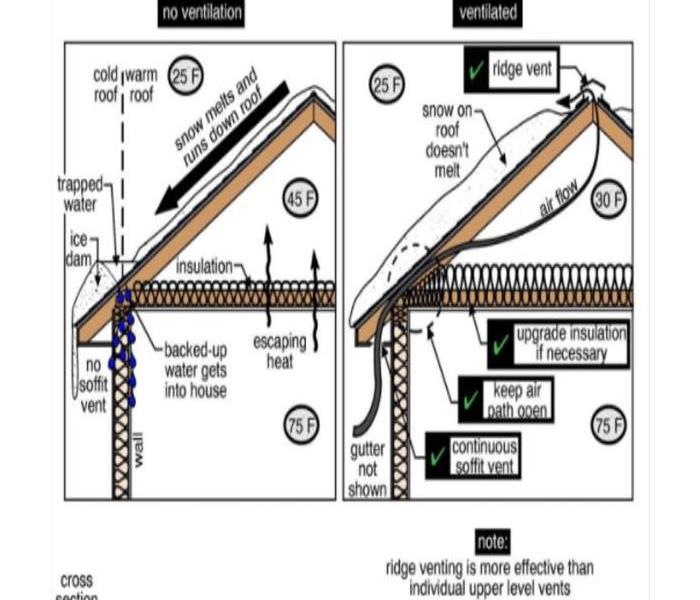
What is an ice dam?An ice dam is a ridge of ice that forms at the edge of a roof and prevents melting snow (water) from draining off the roof. The water that backs up behind the dam can leak into a home and cause damage to walls, ceilings, insulation, and other areas. The image included in this blog entry shows a cross section of a home with an ice dam.
What causes ice dams?There is a complex interaction among the amount of heat loss from a house, snow cover, and outside temperatures that leads to ice dam formation. For ice dams to form there must be snow on the roof, and, at the same time, higher portions of the roof's outside surface must be above 32°F while lower surfaces are below 32°F. For a portion of the roof to be below 32°F, outside temperatures must also be below 32°F. When we say temperatures above or below 32°F, we are talking about average temperature over sustained periods of time.
The snow on a roof surface that is above 32°F will melt. As water flows down the roof it reaches the portion of the roof that is below 32°F and freezes. Voila! - an ice dam.
The dam grows as it is fed by the melting snow above it, but it will limit itself to the portions of the roof that are on the average below 32°F. So the water above backs up behind the ice dam and remains a liquid. This water finds cracks and openings in the exterior roof covering and flows into the attic space. From the attic it could flow into exterior walls or through the ceiling insulation and stain the ceiling finish.
Remember: Nonuniform roof surface temperatures lead to ice dams.
The Science Of Drying
9/21/2017 (Permalink)
 IICRC
IICRC
Quite frequently we are asked how do we know how long it will take to dry a structure after it has sustained water damage. Our clients want to know that there is scientific research to back this up our estimates and that we are not simply pulling numbers out of thin air. The reality is that, yes, there is extensive and well-documented scientific research ranging over many years related to drying technology of various products. That research, and the subsequent industry guidelines which we follow, is conducted and produced by the Institute of Inspection, Cleaning and Restoration Certification (IICRC).
The IICRC was formed in 1972 as an independent, certification body that sets and promotes high standards and ethics within the inspection, cleaning, restoration and installation industry. The IICRC is regarded as the international industry standard to be used by restoration companies. All of our technicians are IICRC certified. When you hire us to do a job you can rest assured that our work will be completed in accordance with the industry’s “standard of care”.
So how do we determine what equipment to use and how long the drying process will take? Structural drying is a process that utilizes evaporation, the process by which water changes from its liquid phase to its gaseous phase. Evaporation is influenced by several factors:
- The level of moisture (i.e. relative humidity) in the air
- Water vapor pressure differential between the surface of the wet material and the surrounding environment
- Temperature of the wet material
- Air movement across the surface of the wet material
- Access to surfaces of wet materials
The application of air movement at the surface of wet materials is a critical component to the drying process. Evaporation is a surface phenomenon, and surfaces are measured in area (e.g. square feet). Therefore using linear feet of wall as the primary criterion for establishing air movement requirements is illogical.
- Drying is the process of removing excess moisture both at the surface and from within the materials and assemblies.
- The conditions conducive to effectively and efficiently drying at the surface of some materials and assemblies differ from the conditions conducive to effectively and efficiently moving excess moisture within the materials or assemblies.
- Rapid air movement across wet surfaces of materials or assemblies is a critical component of effectively and efficiently drying the surface of those materials and assemblies.
- Rapid air movement across the surface of materials becomes less important relative to vapor pressure as the focus of removing surface moisture gives way to reducing moisture content in low evaporation materials.
- Using the same criteria to establish air movement during the constant and the falling rate drying of materials and assemblies does not consider changing conditions.
- The linear foot formula for air movement of a room fails to consistently account for the actual surface area of wet materials and assemblies in different classes of water intrusion.
Humidity, airflow and temperature influence the movement of moisture within a material as well as the evaporation rate from the surface of material. These properties greatly impact the overall drying time for a project.
It is important to quickly control the moisture in the air and use sufficient airflow to dry the surfaces of materials to reduce water activity thus lowering the potential for microbial growth (mold). To ensure rapid, cost effective drying without secondary damage specific types and quantities of airmovers are recommended, depending on the type, porosity, location and square footage of the surface being dried. … The minimum quantity of airmovers recommended for various flooring surfaces are as follows:
- Non-porous and semi-porous flooring – at least one airmover per 400- 500 square feet is recommended. Give consideration to closets or small storage areas where airflow may be restricted.
- Direct-glue carpet installations – in installations where disengagement normally would damage or destroy carpet or cushion, at least one airmover is recommended per 300 square feet of carpet area, or one per room if smaller than 300 square feet. Give consideration to closets or small storage areas where airflow may be restricted.
- Stretch-in carpet – a minimum of one airmover is recommended per 300 square feet of carpet surface area, or one per room if smaller than 300 square feet. Give consideration to closets or small storage areas where airflow may be restricted.
As you can see there is a significant knowledge base which we pull from to ensure that we completely remove all excess moisture, both the visible standing water and the subsequent elevated levels of humidity, during our structural drying projects. If you would like to learn more about the science of structural drying and why we do what we do visit www.IICRC.org
National Preparedness Month
9/14/2017 (Permalink)
September is National Preparedness Month. The best way to survive a disaster is to have a plan in place prior to such an event happening. These past couples of weeks have put on display the importance of knowing what to do should disaster strike. Fires, floods, earthquakes, tornadoes, hurricanes and blizzards all can put you and your family at risk. Nowadays we take for granted the ability to communicate with our loved ones at anytime and from anywhere. As we have learned, communication channels can be brought down. If disaster strikes would you be able to communicate with all the members of your household? More importantly would they know how to reach each other and where to meet up?
The following is an outline, published by the Department of Homeland Security on their website, which can be used to guide you and your family as you created your own plan.
Planning starts with three easy steps:
- COLLECT. Create a paper copy of the contact information for your family and other important people/offices, such as medical facilities, doctors, schools, or service providers.
- SHARE. Make sure everyone carries a copy in his or her backpack, purse, or wallet. If you complete your Family Emergency Communication Plan online at ready.gov/make-a-plan, you can print it onto a wallet-sized card. You should also post a copy in a central location in your home, such as your refrigerator or family bulletin board.
- PRACTICE. Have regular household meetings to review and practice your plan.
To view the complete outline visit our blog, SERVPROnorwoodwestroxbury.blogspot.com
National Preparedness Month
9/14/2017 (Permalink)
September is National Preparedness Month. The best way to survive a disaster is to have a plan in place prior to such an event happening. These past couples of weeks have put on display the importance of knowing what to do should disaster strike. Fires, floods, earthquakes, tornadoes, hurricanes and blizzards all can put you and your family at risk. Nowadays we take for granted the ability to communicate with our loved ones at anytime and from anywhere. As we have learned, communication channels can be brought down. If disaster strikes would you be able to communicate with all the members of your household? More importantly would they know how to reach each other and where to meet up?
The following is an outline, published by the Department of Homeland Security on their website, which can be used to guide you and your family as you created your own plan.
Planning starts with three easy steps:
- COLLECT. Create a paper copy of the contact information for your family and other important people/offices, such as medical facilities, doctors, schools, or service providers.
- SHARE. Make sure everyone carries a copy in his or her backpack, purse, or wallet. If you complete your Family Emergency Communication Plan online at ready.gov/make-a-plan, you can print it onto a wallet-sized card. You should also post a copy in a central location in your home, such as your refrigerator or family bulletin board.
- PRACTICE. Have regular household meetings to review and practice your plan.
To view the complete outline visit our blog, SERVPROnorwoodwestroxbury.blogspot.com
3 Categories of Water Damage
5/16/2017 (Permalink)
According to IICRC Standard and Reference Guide for Professional Water Damage Restoration (IICRC S500), there are three categories of water that cause damage in buildings. They are summarized as follows:
Category 1 Water – That which is clean at the releasing source and does not pose a hazard if consumed by humans. Category 1 water may become progressively contaminated as it mixes with soils on or within floor coverings or building assemblies (walls, decking, subflooring). Time and temperature, which promote the growth and amplification of microorganisms in water can cause Category 1 water to degrade. Examples: burst water pipes, failed supply lines on appliances, vertically falling rainwater.
Category 2 Water – That which begins with some degree of contamination and could cause sickness or discomfort if consumed by humans. As with Category 1 water, time and temperature can cause Category 2 water to become progressively more contaminated.
Category 3 Water – That which is highly contaminated and could cause death or serious illness if consumed by humans. Examples: sewage, rising flood water from rivers and streams, ground surface water flowing horizontally into homes. There are two ways in which water enters a building as a result of wind storm damage:
Do You Have Mold?
5/10/2017 (Permalink)
Do you think that you may have mold in your home or place of business? While mold spores exist naturally everywhere high levels in contained spaces can cause serious health issues. Mold spores are airborne particles which can be eliminated by creating a negative air chamber. One piece of equipment that we often use is the DefenderAir HEPA 500 is ideal for handling indoor air-quality needs on every restoration job. This unit address these air-quality issues quickly and effectively, helping you to maintain a clean indoor environment. The DefendAir has an efficiency rating of 99.97% against 0.3-micron oily aerosol particles and meets first-pass filtration requirements for even the most sensitive jobs. If you think that you may have an infestation of mold give our Disaster Recovery Team a call today!
What Are the Potential Health Effects of Mold
5/10/2017 (Permalink)
According the CDC mold exposure does not always present a health problem indoors. However some people are sensitive to molds. These people may experience symptoms such as nasal stuffiness, eye irritation, wheezing, or skin irritation when exposed to molds. Some people may have more severe reactions to molds. Severe reactions may occur among workers exposed to large amounts of molds in occupational settings, such as farmers working around moldy hay. Severe reactions may include fever and shortness of breath. Immunocompromised persons and persons with chronic lung diseases like COPD are at increased risk for opportunistic infections and may develop fungal infections in their lungs.
In 2004 the Institute of Medicine (IOM) found there was sufficient evidence to link indoor exposure to mold with upper respiratory tract symptoms, cough, and wheeze in otherwise healthy people; with asthma symptoms in people with asthma; and with hypersensitivity pneumonitis in individuals susceptible to that immune-mediated condition. The IOM also found limited or suggestive evidence linking indoor mold exposure and respiratory illness in otherwise healthy children.
Water Main Run Off
4/26/2017 (Permalink)
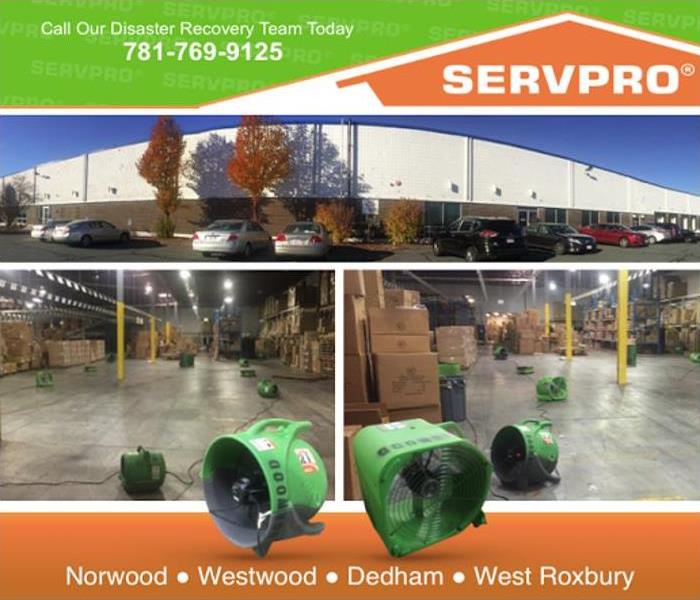
What would you do if a water main burst and covered over 30,000 square feet of your warehouse with almost an inch of water? You would want someone to arrive onsite fast and remediate the entire problem, not just the visible water, but also the excess moisture that could ruin a product line with mold and mildew. That is exactly what happened to a local sporting apparel manufacturer. From Air Movers to Dehumidifiers, Generators to Power Distribution Boxes we have access to a wide array of water remediation equipment and the certified technicians to get the COMPLETE job done right! We began the drying process in the middle of the week and completed it by the very next weekend. All of our equipment was removed over that weekend and the warehouse space was ready to receive deliveries that very next Monday morning. How are we able to accomplish this, we offer our commercial clients flat rate pricing which allows our technicians to take whatever steps necessary to expedite the drying process with minimal disruption to business operations. Does your commercial property need remediation services? Call our disaster recovery team today!
Mold Removal
4/13/2017 (Permalink)
When approaching mold clean up a lot of people wonder which method is best, “Dry Blast” vs “Sand Blast”, The answer is neither , the reality in today’s world is this is unnecessary because; dry ice is costly, it only removes surface mold, and porous materials require a deep cleaning. SERVPRO technicians use anti-fungal and anti-microbial treatments that kill mold colonies and help prevent new colonies from forming
When tackling mold we make it a priority to set up containment. All remediation companies will set up containment, but when and how is the issue. We set up containment prior to applying the “eyeball test”. Which is as follows
- The “Eyeball Test” – Assessing the Environment
- Has there been a previous water damage
- Do you smell musty odors of mold
- Do you see areas of mold contamination
- Our competitors cut 4 x 8 holes in the wall from the ground up
- We cut a 2 x 4 in the center of the wall
What is Mold?
4/12/2017 (Permalink)
What is mold? Mold is a fungus that grows in the form of multicellular filaments called hyphae.. This means that, like you and I, mold is a living organism. Mold spores are microscopic in size and, believe it or not, they exist naturally everywhere. Removing all traces of mold from a home or business is impossible. In actuality, mold testing is not done to determine if mold exists, but rather, to determine if elevated levels of mold exists. Proper mold testing consists of comparing indoor air quality to the air quality of the surrounding external environment.
Three conditions must exist for mold to cultivate. The first would be the availability of food. Any organic, carbon based, porous material is the only source of food mold spores require. The second would be having an appropriate temperature. Contrary to popular belief, mold can grow in any temperature above freezing, for example have you ever found moldy food in your refrigerator? The ideal temperature for mold to grow is in between 59° F – 86° F. Lastly having a considerable amount of moisture is a condition necessary that supports mold. It does not take long either; when all three conditions exist mold infestation can begin in less than 48 hours! The good news is that eliminating any one of these three conditions will ensure be mold free environment.
The not-so-good news is unfortunately, ninety percent of building materials used can serve as food for mold. Temperatures in New England during late spring and summer months are perfect for mold growth. Lastly, leaky roofs, improper bathroom ventilation, or poorly installed finished basements are just a few of the many issues that will cause the increased levels of moisture needed to stimulate mold growth. We cannot change the materials used to build our homes or the temperatures outside but we can control moisture. The good news is as humans we actually prefer humidity levels that are well below the critical relative humidity necessary for mold growth. That means, in most situations, the simple purchase of a dehumidifier is all the protection needed to mitigate mold growth.
But, what happens when disaster strikes and a simple dehumidifier is not enough? Up next – Why Call SERVPRO.
April Showers
4/5/2017 (Permalink)
April showers bring May Flowers. Unfortunately, those same showers also may bring flooded basements. Immediate action is crucial when dealing with water damage. Luckily, SERVPRO franchises are strategically located to allow our technicians to arrive faster to any size disaster. As a leader in the water remediation industry our technicians receive advanced structural drying training and IICRC certification. Furthermore, we document our entire drying process in order to validate that all moisture, visible and hidden, has been removed and that the structure is completely dry. Generally basements are areas of high moisture, as such any amount of additional standing water exponentially increases the risk of mold infestation. Do not let water wreak havoc to your home or place of business. Call our Disaster Recovery Team today!
The Air Max
3/29/2017 (Permalink)
Drying a structure requires more than simply removing the visible water. Elevated levels of moisture in the air can lead to mold infestation. Circulating air reduces escalated moisture levels. The Air Max is unlike traditional, “whistle”, air movers. This rugged unit has 3 airflow positions – horizontal, vertical, and side allowing for maximum air flow and the most complete structural drying possible. Combined with its vented bottom housing, the trying capacity of the Air Max is unparalleled! In addition, its small footprint allows us to install the Air Max virtually anywhere and the non-marking, anti-skid rubber feet help us to leave no trace left behind. Call our disaster recovery team today to learn more about the Air Max and how we can properly remediate water damage in your residential or commercial property.
The Mega X
3/29/2017 (Permalink)
April showers bring May flowers. They also bring flooded basements. When basements flood the water must be removed immediately before damaging the structure of the property. The MegaX Flood Removal Extractor is the perfect tool for excessive water removal. The unit’s two inch intake valve allows for maximum water extraction. The MegaX has dual motors that offer unparalleled vacuuming performance and an auto discharge of 46 gallons per minute! Not only is the MegaX powerfully fast it is also unbelievably quiet too which allows for water removal in areas where noise is not an option. Call our disaster recovery team today to learn more about the MegaX Flood Removal Extractor and how we can properly remediate water damage in your residential or commercial property.
Biohazard Remediation
3/29/2017 (Permalink)
The decontamination of a home or business due to trauma, sewage backups, chemical spills, hoarding or other biohazards can be both dangerous and emotional. Exposure to biological and chemical contaminants can pose serious health consequences. The failure to properly remove such substances can contribute to unhealthy and dangerous environments to work or live in. Our certified technicians are trained to safely remove biohazards and properly dispose of them in accordance with OSHA and health regulations. They are equipped with the necessary safety apparatus and cleaning products to transform unhealthy environments back into clean, safe homes and offices.
Call our disaster recovery team today to learn more about our biohazard remediation services and how we can help to make your residential or commercial property safe to live and work in.
Cleaning Services
3/29/2017 (Permalink)
You know SERVPRO as a leader in Fire and Water cleanup and restoration, but are you familiar with our professional cleaning services? Life happens. Homes and places of business get dirty even when disaster does not happen. We have access to specialized products, both traditional and green options, and the expertise to provide a deeper clean than your basic cleaning service. We offer a wide array of professional cleaning services such as carpet and upholstery, ceiling, floors and walls, drapes and blinds as well as odor and garbage removal. Whatever your cleaning needs are we offer services to meet those needs.
Call our disaster recovery team today to learn more about our residential and commercial property cleaning services and how we can help to make it “Like it never even happened.”
April School Vacation
3/29/2017 (Permalink)
It is hard to believe that April school vacation is only one month away! Will spring time be in full effect or will there still be snow on the ground, only time will tell. Regardless, finding ways to keep your little ones entertained can be challenging. Let SERVPRO® of Norwood and West Roxbury help! We have partnered with Monster Mini Golf of Norwood to offer two, $25 gift certificates just in time for school vacation. Simply download a copy of our latest word search form, fill it out and submit it to us by Friday, April 7th. We will announce the winners on the following Tuesday, April 11th. Simply click the image below to download the word search form. Visit the Monster Mini Golf Norwood website, monsterminigolf.com, to see all that they have to offer.
2017 Scholarship
3/29/2017 (Permalink)
It is our pleasure to announce to you that we will once again be offering the SERVPRO of Norwood and West Roxbury (SNWR) Scholarship Award. We have made some significant changes this year. Most notably; unlike last year in which we offered one scholarship to the school districts we serve this year we will be offering one scholarship to EACH district! The 2017 SNWR Scholarship Award details are as follows:
- The 2017 SNWR Scholarship Award is a onetime payment in the amount of five hundred dollars ($500)
- The winner of the award will be announced on Friday, June 2nd 2017
- The Scholarship will be administered by SERVPRO of Norwood and West Roxbury
- A selection committee, comprised of the owner, Michael Callahan, myself and three other volunteers, will be formed to review all completed applications
- The criteria for the award are as follows:
- Applicants must be a member of the Dedham high school graduating class of 2017
- Applicants must have legal residence in Dedham
- Applicants will need to submit a complete the application form process by Friday, April 21st 2017
- Applicants must have averaged a 2.5 GPA or better for the last four (4) reporting terms (second semester sophomore year to first semester senior year)
Are You "Ready For Whatever Happens?"
3/23/2017 (Permalink)
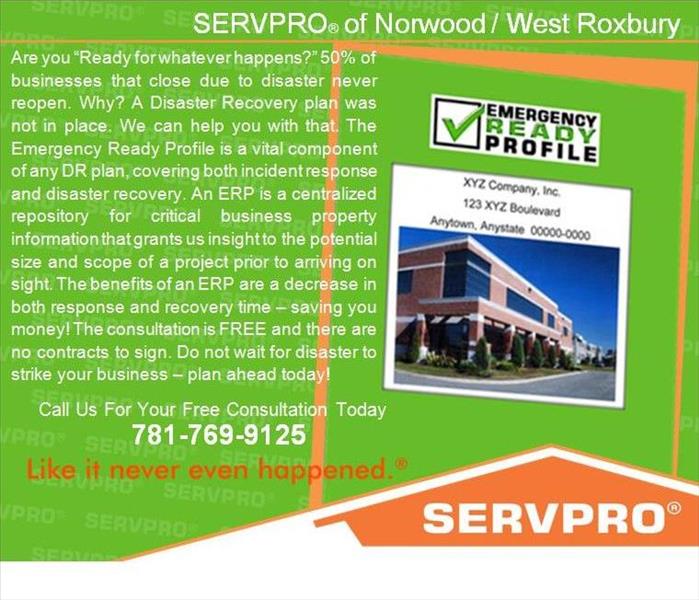
How many of you here have insurance? How many of you have insurance for your business in the form of a disaster recovery plan? The Emergency Ready Profile, or the ERP, is a FREE, no-strings-attached centralized repository for critical facilities information. A well rounded business contingency plan is comprised of three components: incident response, disaster recovery and business continuity. The ERP encompasses two of those components, incident response and disaster recovery and grants us insight to the potential size and scope of a project prior to arriving on sight. The benefits of an ERP are a decrease in both response and recovery time – saving our customers money! Moreover, SERVPRO has partnered with the Red Cross and their Read Rating Program; a comprehensive assessment will help you to put all of your preparedness 'ducks' in a row. The information contained in our ERP can be used to create your baseline assessment. You never know when disaster will strike. Call us for you FREE consultation today!
Why SERVPRO
3/22/2017 (Permalink)
For homeowners, property managers, businesses owners, and insurance providers alike SERVPRO® of Norwood and West Roxbury is the area's premier disaster cleanup and restoration authority that delivers a wide array of high caliber remediation services. How do we accomplish that you may ask, by empowering our certified technicians to offer personalized solutions to our customers so that they may realize accelerated recovery times. This is facilitated through the high level of professional development and training of our technicians because only SERVPRO® franchisees have access to the extensive SERVPRO® network, its professionals and equipment allowing us to arrive faster to any size disaster as well as offer continued support after the job is done.
Helping the Neponset Valley community to make it "Like it never even happened" since 2011.
Looking to sell your home?
3/22/2017 (Permalink)
We are in the midst of a very hot sellers market. The majority of properties are receiving multiple bids after their first showing. But what if the home is not Open House ready? We at SERVPRO® of Norwood and West Roxbury can help with that. We offer a wide array of professional cleaning services such as carpet & upholstery, ceiling, floors & walls, drapes & blinds as well as odor & garbage removal. Are you a commercial real estate brokerage with REOs in foreclosure? Perhaps the foreclosure process began in late fall and the bank did not take ownership in time to properly winterize the property bringing about frozen pipes that burst and flooded the home. Maybe the property sat vacant for a long period of time resulting in mold, animal or pest infestation issues that are in need of remediation. Whatever the case may be we have the solution to help you get the greatest return on your investment!
The SERVPRO Difference
3/17/2017 (Permalink)
Professionalism what does that mean to you? We at SERVPRO of Norwood and West Roxbury would like to tell you what it means to us. Our technicians go through an extensive vetting and training process. Every technician must pass a 7 year background check which includes a CORI check. Not only are they certified in Fire, Water, Mold and Bio Hazard remediation but they are also OSHA 10 certified which means they are trained in recognition, avoidance, abatement and prevention of safety and health hazards on the job site. Our equipment is meticulously maintained and regularly upgraded with the latest in remediation technology. All of this allows us to offer the best and most professional remediation experience to our clients. Disaster remediation does not need to be disastrous. Call us and we will make it made it "Like it never even happened.”
Rain, Rain Go Away
1/18/2017 (Permalink)
There is good news in the weather forecast for those of you that do not like to shovel their driveways, no snow! There is rain, however, and cold weather - that means ice! Be sure to grab your ice melt at your local hardware store while supplies last and be careful in the evenings on your commute home as the chance for black ice will be great. As always, for the latest weather forecasts visit The Weather Channel's website.
October's Winner
10/5/2016 (Permalink)
Are you receiving our Newsletter? In the latest issue we announced October's office breakfast winner, rang in Breast Cancer Awareness month with "7 Things You Should Know About Getting A Mammogram" from the American Cancer Society and showcased one of our commercial dehumidifiers. Click here to view our current Newsletter and to sign up to receive it automatically.
National Preparedness Month
9/7/2016 (Permalink)
September is recognized as National Preparedness Month (NPM) which serves as a reminder that we all must take action to prepare, now and throughout the year, for the types of emergencies that could affect us where we live, work, and also where we visit. Does your family have an Emergency Communicaiton Plan? Visit ready.gov by clicking the image below to learn how to design your family's plan.
Helping Kids Deal With Bullies
8/18/2016 (Permalink)
Everyone at SERVPRO® of Norwood and West Roxbury would like to help you and your family prepare for the upcoming school year. During the month of August we will be focusing on Back 2 School tips. The American Academy of Pediatrics offers tips for kids from how to make the first day easier to what to do when your child is bullied. Visit HealthyChildren.org for complete details.
Back 2 School Tips for Parents
8/11/2016 (Permalink)
Everyone at SERVPRO® Norwood and West Roxbury would like to help you and your family prepare for the upcoming school year. During the month of August we will be focusing on Back 2 School tips. Starting the new school year can be a time of great excitement... and anxiety. Help calm your child's fears (and your own) with these teacher-approved tips provided by PBS Parents.
Back 2 School
8/3/2016 (Permalink)
Are you receiving our Newsletter automatically? If not, you are not receiving our latest promotions, gaining critical industry updates, learning about local business events or receiving our helpful tips. In this edition we announced our August Bobble Head winner, gave our first back to school tip of the month and highlighted the Injectidry HP-Plus!
Click here to view our current Newsletter and sign up for automatic delivery!
Fore
7/13/2016 (Permalink)
Are you receiving our eNewsletter? If not you are missing out on learning about upcoming events, fire safety tips and our new performance air movers! Click here to view our current eNewsletter and join our mailing list.
Happy 4th of July
6/29/2016 (Permalink)
From all of us at SERVPRO® of Norwood and West Roxbury we would like to wish you and yours a safe and enjoyable Holiday Weekend!
-Enjoy!
2016 SERVPRO NORWOOD WEST ROXBURY SCHOLARSHIP
6/8/2016 (Permalink)
CONGRATULATIONS!
Last year we announced the creation of the SERVPRO® of Norwood and West Roxbury Scholarship Award. This scholarship was in the amount of one thousand dollars ($1,000) and was open to students graduating this year in the towns of West Roxbury, Dedham, and Westwood. The purpose of this award is to recognize a student who exhibits excellence in academics, civic engagement and community service. Thank you to all those who applied!
This year we would like to congratulate Hanna from Westwood for winning our award!
May Is National Electrical Safety Month!
5/18/2016 (Permalink)
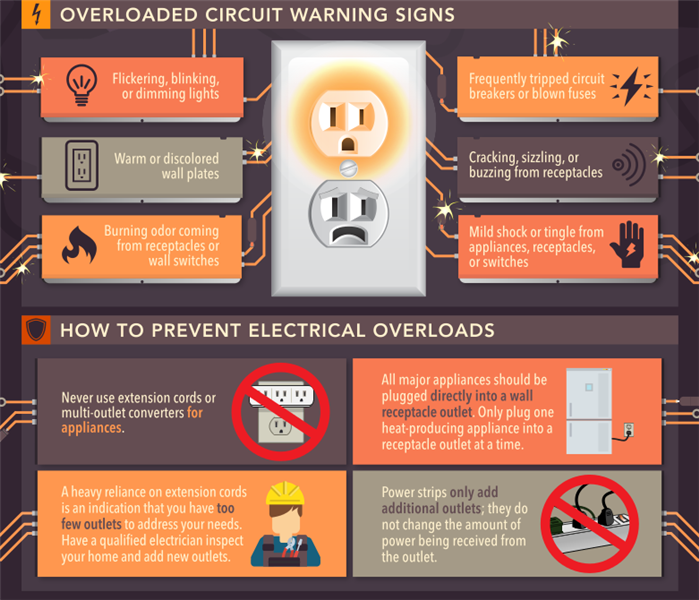 Don't Overload Your Home
Don't Overload Your Home
According to the National Fire Protection Association, 47,700 home fires in the U.S. are caused by electrical failures or malfunctions each year. These fires result in 418 deaths, 1,570 injuries, and $1.4 billion in property damage. Overloaded electrical circuits are a major cause of residential fires. Help lower your risk of electrical fires by not overloading your electrical system. Visit the the Electrical Safety Foundation International website, ESFI, to learn more about electrical safety in your home.
Newsletter
4/5/2016 (Permalink)
 Previous Bobble Head winner - Christine from Patterson Insurance
Previous Bobble Head winner - Christine from Patterson Insurance
Check out our latest Newsletter. We announced our April Bobble Head winner and reminded everyone that the deadline to enter our latest word search campaign is this Friday, April 8th. Also, commercial property owners we given an outline of the benefits on our ERP program!
Are you not receiving our Newsletter automatically? If so, you are not receiving our latest promotions, gaining critical industry updates or learning about local business events in our community. Click here to view our current Newsletter and sign up for automatic delivery!
Happy New Year!
12/30/2015 (Permalink)
Wishing you and yours a very happy, safe, and prosperous New Year!
Best Wishes,
Michael Callahan
Winter Advisory
12/23/2015 (Permalink)
 Do Not Let This Happen To YOU!
Do Not Let This Happen To YOU!
Water actually begins to expand once the temperature drops to 37ºF, putting strain on pipes and increasing the risk of rupture! Now is the time to ensure proper insulation of any exposed pipes. Additionally, it is always a good idea to shut off any external water sources. We hope you will not be impacted by the winter weather this year, but in case disaster strikes, the EPA has developed a quick reference guide to help you prepare for the removal of flood water. Click the link, SERVPRO of Norwood and West Roxbury, to visit our franchise company page and download the fact sheet.
We are here to help too! Our certified technicians are available 24 hours a day. Give us a call and we will make it like it never even happened.
 From immediate response to emotional support, trust in the expertise of these specialists to begin the journey of rebuilding dreams
From immediate response to emotional support, trust in the expertise of these specialists to begin the journey of rebuilding dreams





 24/7 Emergency Service
24/7 Emergency Service





































































































































































































